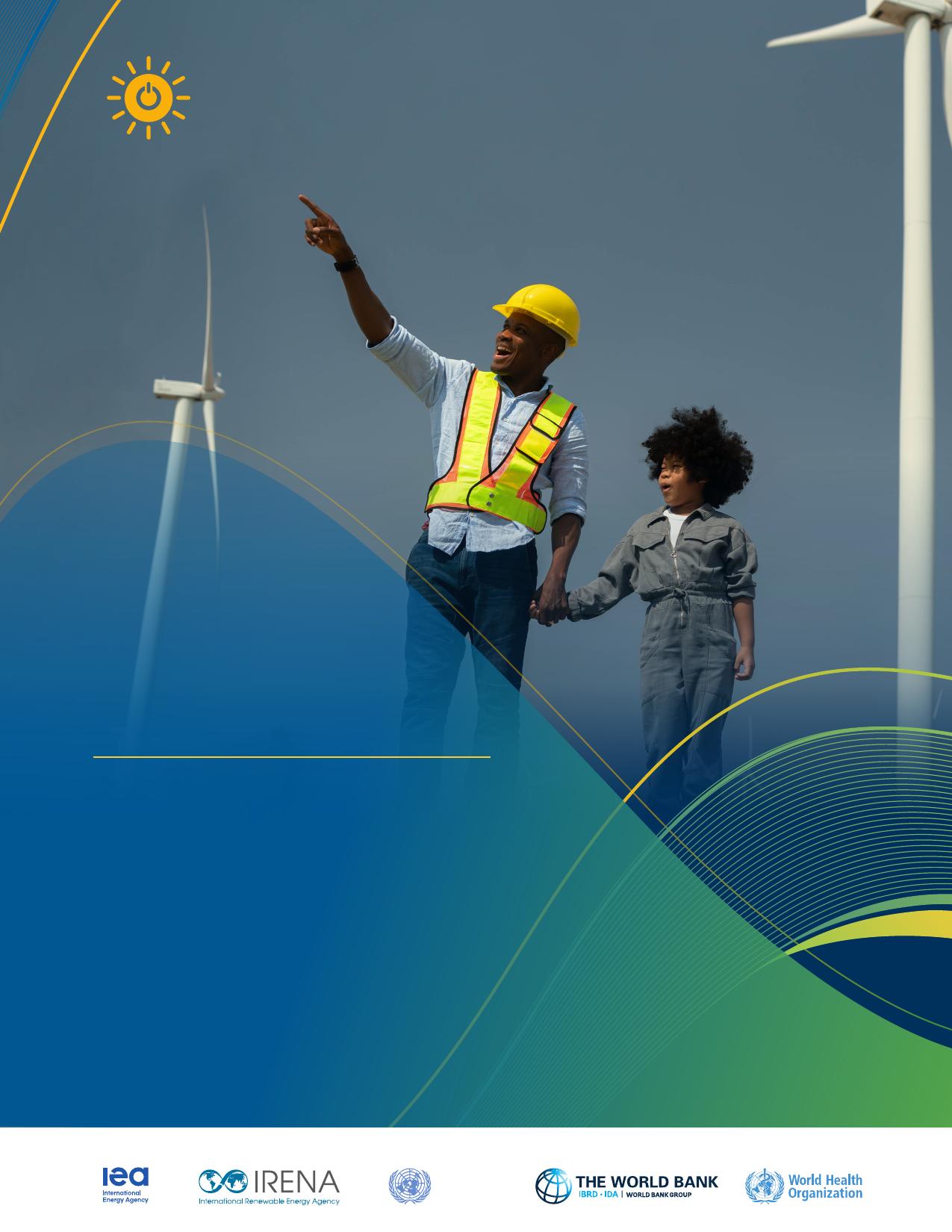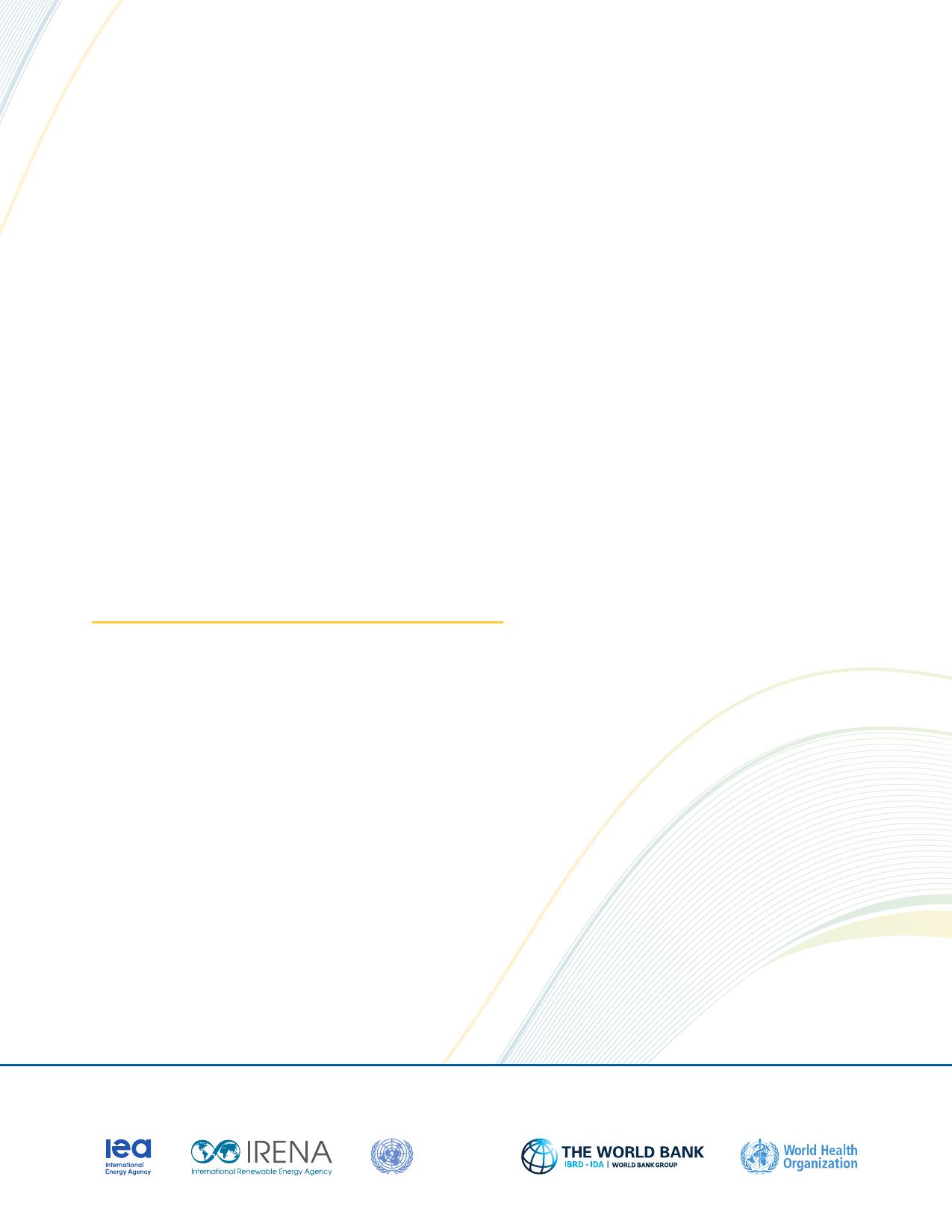THEENERGYPROGRESSREPORTTRACKINGSDG72023AjointreportofthecustodianagenciesUnitedNationsStatisticsDivision©2023InternationalBankforReconstructionandDevelopment/TheWorldBank1818HStreetNW,Washington,DC20433Telephone:202-4731000Internet:www.worldbank.orgThisworkisajointproductofthestaffofthefivecustodianagencies,namelytheWorldBank,theInternationalEnergyAgency,theInternationalRenewableEnergyAgency,theUnitedNations,andtheWorldHealthOrganization,withexternalcontributions.Thefindings,interpretations,andconclusionsexpressedinthisworkdonotnecessarilyreflecttheviewsofthecustodianagencies,theirrespectiveBoardofExecutiveDirectors(orequivalent),membersorthegovernmentstheyrepresent.Thecollaboratingorganizationsdonotguaranteetheaccuracy,completeness,orcurrencyofthedataincludedinthisworkanddoesnotassumeresponsibilityforanyerrors,omissions,ordiscrepanciesintheinformation,orliabilitywithrespecttotheuseoforfailuretousetheinformation,methods,processes,orconclusionssetforth.Theboundaries,colors,denominations,andotherinformationshownonanymapinthisworkdonotimplyanyjudgmentonthepartofthecustodianagenciesconcerningthelegalstatusoforsovereigntyoveranyterritoryortheendorsementoracceptanceofsuchboundaries.Nothinghereinshallconstituteorbeconstruedorconsideredtobealimitationuponorwaiveroftheprivilegesandimmunitiesofthecollaboratingorganizations,allofwhicharespecificallyreserved.RightsandPermissionsThisworkisavailableundertheCreativeCommonsAttribution--NonCommercial3.0IGOlicense(CCBY-NC3.0IGO)https://creativecommons.org/licenses/by-nc/3.0/igo/.UndertheCreativeCommons--NonCommerciallicense,youarefreetocopy,distribute,andadaptthiswork,fornoncommercialpurposesonly,underthefollowingconditions:Attribution—Pleasecitetheworkasfollows:IEA,IRENA,UNSD,WorldBank,WHO.2023.TrackingSDG7:TheEnergyProgressReport.WorldBank,WashingtonDC.©WorldBank.License:CreativeCommonsAttribution—NonCommercial3.0IGO(CCBY-NC3.0IGO).Noncommercial—Youmaynotusethisworkforcommercialpurposes.Translations—Ifyoucreateatranslationofthiswork,pleaseaddthefollowingdisclaimeralongwiththeattribution:ThisisanunofficialtranslationoftheworkfromtheEnglishlanguage.ThetranslationwasnotcreatedbyIEA,IRENA,UNSD,WorldBankorWHO,andIEA,IRENA,UNSD,WorldBankorWHOshallnotbeliableforanycontentorerrorinthistranslation.Adaptations—Ifyoucreateanadaptationofthiswork,pleaseaddthefollowingdisclaimeralongwiththeattribution:ThisisanadaptationofanoriginalworkbyIEA,IRENA,UNSD,WorldBankandWHO.ViewsandopinionsexpressedintheadaptationarethesoleresponsibilityoftheauthororauthorsoftheadaptationandarenotendorsedbyIEA,IRENA,UNSD,WorldBankandWHO.Third-partycontent—TheWorldBankdoesnotnecessarilyowneachcomponentofthecontentcontainedwithinthework.TheWorldBankthereforedoesnotwarrantthattheuseofanythirdparty-ownedindividualcomponentorpartcontainedintheworkwillnotinfringeontherightsofthosethirdparties.Theriskofclaimsresultingfromsuchinfringementrestssolelywithyou.Ifyouwishtore-useacomponentofthework,itisyourresponsibilitytodeterminewhetherpermissionisneededforthatre-useandtoobtainpermissionfromthecopyrightowner.Examplesofcomponentscaninclude,butarenotlimitedto,chapters,tables,figures,orimages.Anyqueriesonrightsandlicenses,includingsubsidiaryrights,exceptasindicatedbelow,shouldbeaddressedtoWorldBankPublications,TheWorldBankGroup,1818HStreetNW,Washington,DC20433,USA;fax:202-522-2625;e-mail:pubrights@worldbank.org.UseofthefollowingchaptersinthereportotherthanaspermittedundertheCCBY-NC3.0IGOlicenserequirespermissionfromeachoftherelevantcopyrightownersotherthantheWorldBank:ExecutiveSummary–©IEA,IRENA,UN,WorldBankandWHO,2023.Contactpubrights@worldbank.orgforpermissiontouseit.Accesstoelectricity-©WorldBank,2023.Contactpubrights@worldbank.orgforpermissiontouseitAccesstocleanfuelsandtechnologiesforcooking–©WHO,2023.Contactpermissions@who.intforpermissiontouseit.RenewableEnergy–©IEA,IRENAandUN,2023.ContactRights@iea.org;publications@irena.organdpermissions@un.orgforpermissiontouseit.EnergyEfficiency–©IEAandUN,2023.ContactRights@iea.organdpermissions@un.orgforpermissiontouseit.InternationalPublicFinancialFlows-©IRENA,2023.Contactpublications@irena.orgforpermissiontouseit.OutlookforSDG7–©IEAandIRENA,2023.ContactRights@iea.organdpublications@irena.orgforpermissiontouseit.TrackingSDG7progressacrosstargets:indicatorsanddata–©IEA,IRENA,UN,WorldBankandWHO,2023.Contactpubrights@worldbank.orgforpermissiontouseit.Reportdesignedby:DuinaReyesCoverphoto:GettyImages/Me3645StudioAjointreportofthecustodianagenciesUnitedNationsStatisticsDivisionTHEENERGYPROGRESSREPORTTRACKINGSDG72023Acknowledgments2EXECUTIVESUMMARY6CHAPTER132ACCESSTOELECTRICITYCHAPTER266ACCESSTOCLEANFUELSANDTECHNOLOGIESFORCOOKINGCHAPTER398RENEWABLESCHAPTER4132ENERGYEFFICIENCYCHAPTER5160INTERNATIONALPUBLICFINANCIALFLOWSTODEVELOPINGCOUNTRIESINSUPPORTOFCLEANENERGYCHAPTER6194THEOUTLOOKFORSDG7CHAPTER7222TRACKINGPROGRESSTOWARDSDG7ACROSSTARGETS:INDICATORSANDDATATABLEOFCONTENTS2TrackingSDG7:TheEnergyProgressReport2023ACKNOWLEDGMENTSPartnershipTheEnergyProgressReportisaproductofclosecollaborationamongthefiveSDG7custodianagenciesdeliveredthroughaspeciallyconstitutedSteeringGroup:•InternationalEnergyAgency(IEA)•InternationalRenewableEnergyAgency(IRENA)•UnitedNationsStatisticsDivision(UNSD)•WorldBank•WorldHealthOrganization(WHO)TheSteeringGroupwassupportedbytheSDG7TechnicalAdvisoryGroup,composedasfollows.•AfricanDevelopmentBank(AfDB)•CleanCookingAlliance•Denmark(MinistryofForeignAffairs)•ENERGIA•EuropeanCommission•FIAFoundation•FoodandAgriculturalOrganization(FAO)•Germany(FederalMinistryforEconomicCooperationandDevelopment)•Hivos•InternationalInstituteforAppliedSystemsAnalysis•InternationalLabourOrganization(ILO)•IslamicDevelopmentBank•Kenya(MinistryofEnergyandPetroleum)•LatinAmericanEnergyOrganization(OLADE)•Norway(MinistryofForeignAffairs)•Pakistan(MinistryofForeignAffairs)•RenewableEnergyPolicyNetworkforthe21stCentury(REN21)3Acknowledgments•SustainableEnergyforAll(SEforALL)•TERISchoolofAdvancedStudies•TheNetherlands(MinistryofForeignAffairs)•TheUnitedNationsOfficeoftheHighRepresentativefortheLeastDevelopedCountries,LandlockedDevelopingCountriesandSmallIslandDevelopingStates(UN-OHRLLS)•UAE(MinistryofForeignAffairs)•UnitedNationsAssociationofChina•UnitedNationsChildren'sFund(UNICEF)•UnitedNationsDepartmentofEconomicsandSocialAffairs(UNDESA)•UnitedNationsDevelopmentProgramme(UNDP)•UnitedNationsEconomicCommissionforAfrica(UNECA)•UnitedNationsEconomicCommissionforAsiaandthePacific(ESCAP)•UnitedNationsEconomicCommissionforLatinAmericaandtheCaribbean(ECLAC)•UnitedNationsEconomicCommissionforWesternAsia(ESCWA)•UnitedNationsEconomicProgrammeforEurope(UNECE)•UnitedNationsEnvironmentProgramme(UNEP)•UnitedNationsFrameworkConventiononClimateChange(UNFCCC)•UnitedNationsHumanSettlementsProgramme(UN-Habitat)•UnitedNationsIndustrialDevelopmentOrganization(UNIDO)•UnitedNationsInstituteforTrainingandResearch(UNITAR)•ViennaUniversityofTechnologyThefinancialandtechnicalsupportoftheEnergySectorManagementAssistanceProgram(ESMAP)isgratefullyacknowledged.ApartnershipbetweentheWorldBankand24entities,ESMAPhelpslow-andmiddle-incomecountriesreducepovertyandboostgrowththroughsustainableenergy.ESMAP’sanalyticalandadvisoryservicesarefullyintegratedwithintheWorldBank’scountryfinancingandpolicydialogueintheenergysector.4TrackingSDG7:TheEnergyProgressReport2023AuthorshipTheSteeringGroup’sworkforthe2023editionofthereportwaschairedbytheWorldHealthOrganization(WHO)andmadepossiblebyagreementamongtheseniormanagementofthememberagencies.FatihBirol(IEA),FrancescoLaCamera(IRENA),StefanSchweinfest(UNSD),DemetriosPapathanasiou(WorldBank),MariaNeira(WHO),andGabrielaElizondoAzuela(ESMAP)oversawthedevelopmentoftheEnergyProgressReportincollaborationwithMinoruTakada(UNDESA).Thetechnicalco-leadershipoftheprojectbythecustodianagencieswastheresponsibilityofLauraCozzi(IEA),RabiaFerroukhi(IRENA),LeonardoSouza(UNSD),ElisaPortale(WorldBank),andHeatherAdair-Rohani(WHO).•ThechapteronaccesstoelectricitywaspreparedbytheWorldBank(JiyunParkandClaraGaleazzi),withcontributionsfromIRENA(GerardoEscamillaandDivyamNagpal),theGlobalOff-GridLightingAssociation(OliverReynoldsandSusieWheeldon),andtheUnitedNationsHighCommissionerforRefugees(FrancescaColoniandTheresaBeltramo).•ThechapteroncleancookingwaspreparedbytheWHO(HeatherAdair-Rohani,AlinaCherkas,RyanneFujita-Conrads,JosselynMothe,Tzu-WeiJoyTseng,KarinTroncosoTorrez,andKendraWilliams),withsubstantialcontributionsfromOliverStoner(UniversityofGlasgow).•ThechapteronrenewableenergywaspreparedbytheIEA(FrancoisBriens,RobertaQuadrelli,PouyaTaghavi,JeremyMoorhouse,andYannickMonschauer)andIRENA(MirjamReiner,GerardoEscamilla,DialaHawila,HannahGuinto,FaranRana,andDivyamNagpal),withsubstantialcontributionsfromUNSD(LeonardoSouzaandAgnieszkaKoscielniak).•ThechapteronenergyefficiencywaspreparedbytheIEA(YannickMonschauer,EmiBertoli,PaulineHenriot,VidaRozite,NicholasHowarth,KevinLane,RobertaQuadrelli,andPouyaTaghavi),withcontributionsfromUNSD(LeonardoSouzaandAgnieszkaKoscielniak).•ThechapteronfinancialflowswaspreparedbytheIRENA(GerardoEscamilla,MirjamReiner,DialaHawila,FaranRana,andHannahGuinto).•TheOutlookchapterwaspreparedbytheIEA(DanielWetzel,GianlucaTonolo,YannickMonschauer,CarloStarace,andNouhounDiarra),withIRENA(RicardoGorini,NicholasWagner,MirjamReiner,HannahGuinto,andJinleiFeng).•ThechapteronindicatorsanddatawasjointlypreparedbythecustodianagenciesunderthecoordinationofWHO(JosselynMothe,AlinaCherkas,andHeatherAdair-Rohani).5AcknowledgmentsDataSourcesThereportdrawsontwometadatabasesofglobalhouseholdsurveys—theGlobalElectrificationDatabasemanagedbytheWorldBankandtheGlobalHouseholdEnergyDatabaseandrelatedestimatesmanagedbyWHO.EnergybalancestatisticsandindicatorsforrenewableenergyandenergyefficiencywerepreparedbyIEA(RobertaQuadrelliandPouyaTaghavi,withsupportfromAlexandreBizeulandJuhaKoykka)andUNSD(LeonardoSouza,AgnieszkaKoscielniak,andCostanzaGiovannelli).TheindicatoroninternationalfinancialflowstodevelopingcountrieswaspreparedbyIRENA(GerardoEscamilla)basedontheIRENAPublicInvestmentsDatabaseandtheOECD/DACCreditorReportingSystem.Dataongrossdomesticproductandvalue-addedweredrawnchieflyfromtheWorldDevelopmentIndicatorsoftheWorldBank.PopulationdataarefromtheUnitedNationsPopulationDivision.ReviewandConsultationThepublicconsultationandpeerreviewprocesswascoordinatedbyWHO.CommentswereprovidedbyEconomicCommissionforLatinAmericaandtheCaribbean(ECLAC),EuropeanUnion(EU),SustainableEnergyforAll(SEforALL),SwedishInternationalDevelopmentCooperationAgency(SIDA),UnitedNationsIndustrialDevelopmentOrganization(UNIDO),UnitedNationsInstituteforTrainingandResearch(UNITAR),andUnitedNationsInternationalChildren'sEmergencyFund(UNICEF).TheIEA’sinternalreviewprocesswasledbyLauraCozziwithcontributionsfromYannickMonschauer,DanielWetzel,FrancoisBriens,PouyaTaghavi,RobertaQuadrelli,andGianlucaTonolo.IRENA’sinternalreviewprocesswasledbyRabiaFerroukhi,withcontributionsfromUteCollier,DivyamNagpal,MirjamReiner,andGerardoEscamilla.TheUNSD’sinternalreviewprocesswasledbyLeonardoSouza,withcontributionsfromAgnieszkaKoscielniak.TheWorldBank’sinternalpeerreviewprocesswasledbyDemetriosPapathanasiou,withcontributionsfromGabrielaElizondoAzuela,DanaRysankova,SandeepKohil,JanFriedrichKappen,AlishaNoellaPinto,CarlosAndresGuadarramaGandara,ChiedzaPortiaMazaiwana,ChristophedeGouvello,DolfJeanGielen,HenrikRytterJensen,JohannaChristineGalan,RalucaGeorgianaGolumbeanu,SharmilaBellur,andTarekKeskes.OutreachThecommunicationsprocesswasledbyPaulSafar(WHO)incoordinationwiththecustodianagencies’communicationfocalpoints:GraceGordonandMerveErdem(IEA),NandaFebrianiMoenandar(IRENA),LucieCecileBlyth(WB),and,onbehalfofUNSD:FrancyneHarrigan,MartinaDonlon(UNDGC),andPragatiPascale(UNDESA).Theonlineplatform(http://trackingSDG7.esmap.org)wasdevelopedbyDerilinx,Inc.Thereportwasedited,designed,andtypesetbyDuinaReyesandStevenKennedy.EXECUTIVESUMMARYPhoto:©UnsplashbyAboodiVesakaranEXECUTIVESUMMARY7OVERVIEWSinceitsinceptionin2018,TrackingSDG7:TheEnergyProgressReporthasbecometheglobalreferencepointforinformationontherealizationofSDG7.ItisproducedannuallybyfiveofthecustodianagenciesresponsiblefortrackingglobalprogresstowardSustainableDevelopmentGoal7(SDG7),whichisto“ensureaccesstoaffordable,reliable,sustainable,andmodernenergyforall.”ThecustodiansdevelopingthereportaretheInternationalEnergyAgency(IEA),theInternationalRenewableEnergyAgency(IRENA),theUnitedNationsStatisticsDivision(UNSD),theWorldBank,andtheWorldHealthOrganization(WHO).Thereportofferstheinternationalcommunityaglobalsummaryofprogressonenergyaccess,energyefficiency,renewableenergy,cleancooking,andinternationalcooperationtoadvanceSDG7.ItpresentsupdatedstatisticsforeachoftheindicatorsandprovidespolicyinsightsonpriorityareasandactionsneededtospurfurtherprogressonSDG7,aswellasrelatedSDGs.FigureES.1offersanupdatedsnapshotoftheprimaryindicatorsforthemostrecentyear.Despitesomeprogressacrosstheindicators,thecurrentpaceisnotadequatetoachieveanyofthe2030targets.Asinpreviousyears,ratesofprogressvarysignificantlyacrossregions,withsomeregionsmakingsubstantialgainsandsomeslowingtheirprogressorevenmovingbackward.AmongthemajoreconomicfactorsimpedingtherealizationofSDG7globallyaretheuncertainmacroeconomicoutlook,highlevelsofinflation,currencyfluctuations,debtdistressinagrowingnumberofcountries,lackoffinancing,supplychainbottlenecks,tighterfiscalcircumstances,andsoaringpricesformaterials.TheeffectsoftheCOVID-19pandemicandthesteadyriseinenergypricessincesummer2021areexpectedtobeafurtherdragonprogress,particularlyinthemostvulnerablecountriesandthosethatwerealreadylaggingbehind.Althoughcertainpolicyresponsestotheglobalenergycrisisappearlikelytoimprovetheoutlookforrenewablesandenergyefficiency,othernecessarypolicyactions,aswellasfinancialflows,continuetolag.Thisparticularlyconcernslackinguniversalaccesstoelectricityandcleancookingindevelopingeconomies,withprojectionsindicatingthatSDG7willnotbereachedby2030.Thisyearmarksthemid-pointoftheimplementationoftheUN2030AgendaforSustainableDevelopment.ThepictureonprogresssincetheadoptionoftheAgendain2015ismixed.Target7.1onensuringuniversalaccesstoaffordable,reliable,andmodernenergyservicesisofftrack,withanestimated675millionpeoplestillwithoutaccesstoelectricityand2.3billionwithoutaccesstocleancookingin2021.Currenttrendssuggestthattheworld’sshotonthetargetwillfallverywideofthemarkin2030.Theuptakeofrenewableenergy(target7.2)hasgrownsince2010,buteffortsmustbescaleduptosubstantiallyincreasetheshareofrenewablesintotalfinalenergyconsumption.Likewise,despitesteadyprogress,therateofimprovementinenergyefficiency(target7.3)isnotontracktodoubleby2030,withthecurrenttrendof1.8percentfallingshortofthetargetedincreaseof2.6percenteachyearbetween2010-2030.Tomakeupforthelackofprogress,improvementswouldneedtoacceleratefurtherfromnowto2030.Finally,progressontarget7.a—toincreaseinternationalpublicfinancialflowssupportingcleanenergyindevelopingcountries—begantodeclineevenbeforetheonsetoftheCOVID-19pandemic,withfinancialresourcesmorethanathirdlowersince2020thantheaverageofthepreviousdecade(2010–19).Asfinancialflowshavecontractedforthethirdyearinarow,theyhavebecomeincreasinglyconcentratedinasmallnumberofcountries.ThedecreasingtrendininternationalpublicfinancialflowsmaydelayachievementofSDG7,especiallyfortheleast-developedcountries(LDCs),landlockeddevelopingcountries,andsmallislanddevelopingstates.8TrackingSDG7:TheEnergyProgressReport202316%shareoftotalfinalenergyconsumptionfromrenewables19.1%shareoftotalfinalenergyconsumptionfromrenewables(2020)2.9billionpeoplewithoutaccesstocleancooking2.3billionpeoplewithoutaccesstocleancooking(2021)5.53MJ/USDprimaryenergyintensity4.63MJ/USDprimaryenergyintensity(2020)peoplewithoutaccesstoelectricitybillion1.1peoplewithoutaccesstoelectricity(2021)million67511.9USDbillioninternationalfinancialflowstodevelopingcountriesinsupportofcleanenergy10.8USDbillioninternationalfinancialflowstodevelopingcountriesinsupportofcleanenergy(2021)INDICATOR2010LATESTYEAR7.1.2Proportionofpopulationwithprimaryrelianceoncleanfuelsandtechnologyforcooking7.2.1Renewableenergyshareintotalfinalenergyconsumption7.3.1EnergyintensitymeasuredasaratioofprimaryenergyandGDP7.a.1Internationalfinancialflowstodevelopingcountriesinsupportofcleanenergyresearchanddevelopmentandrenewableenergyproduction,includinginhybridsystems7.1.1ProportionofpopulationwithaccesstoelectricityFIGUREES.1•PrimaryindicatorsofglobalprogresstowardtheSDG7targets9ExecutiveSummaryACCESSTOELECTRICITY(SDGINDICATOR7.1.1)Recentprogressisnotontracktoreachuniversalaccessby2030.Globally,accesstoelectricitygrewbyanannualaverageof0.7percentagepointsbetween2010and2021,risingfrom84percentoftheworld’spopulationto91percent.Thenumberofpeoplewithoutelectricityalmosthalvedduringtheperiod,from1.1billionin2010to675millionin2021.Thepaceofannualgrowthslowedduring2019–21to0.6percentagepoints.Tobridgethegap,especiallyforpeoplelivinginpoorandremoteregions,theannualrateofgrowthinaccessmustbe1percentagepointperyearfrom2021onward—almosttwicethecurrentpace.Ifnoadditionaleffortsandmeasuresareputinplace,some660millionpeople,mostlyinSub-SaharanAfrica,wouldstillbeunservedin2030(IEA2022a).Policiesforenergyaccessshoulddemonstratepoliticalcommitmentandmaximizethesocioeconomicbenefitsofaccess,keepingthemostvulnerablepopulationsattheforefrontofeffortstoclosetheaccessgap.CLEANCOOKINGSOLUTIONS(SDGINDICATOR7.1.2)Theglobalpopulationlackingaccesstocleancookingfellfrom2.9billionin2010to2.3billionin2021,butthegoalofuniversalaccessby2030remainselusive:some1.9billionpeoplewouldstillbewithoutaccesstocleancookingin2030.Ifcurrenttrendscontinue,almostsixoutoftenpeoplewithoutaccesstocleancookingin2030wouldresideinSub-SaharanAfrica.WiththeongoingimpactofCOVID-19andsoaringenergyprices,theIEAestimatesthat100millionpeoplewhorecentlytransitionedtocleancookingmayreverttousingtraditionalbiomass(IEA2022a).EasternAsiaandLatinAmericaandtheCaribbeanweretheonlyregionstosustainprogressinaccesstocleancookingbetween2019and2021(ESMAP2022).Unlesseffortsarerapidlyscaleduptoday,pollutingcookingfuelsandtechnologieswillcontinuetoclaimmillionsofliveseachyearwhileperpetuatinggenderinequity,deforestation,andclimatedamage.Integratingcleancookingintobroaderenergyplanning,improvingaffordability,anddevisingbetterdeliverymechanismsaresomeofthekeypolicyleverstodrivecleancooking.Ifsucheffortsarepairedwithsustainedfinancingatanadequatelevel,theworldcangetbackontracktomakingcleancookingarealityforall.RENEWABLEENERGY(SDGINDICATOR7.2.1)Universalaccesstoaffordable,reliable,sustainable,andmodernenergydependsonfasterdeploymentofrenewableenergyinelectricity,heat,andtransport.Butunlessthepacequickens,theshareofrenewableenergyintotalfinalenergyconsumption(TFEC)willremainsluggish.In2020,theshareofrenewableenergyinTFECstoodatjust19.1percent(or12.5percentiftraditionaluseofbiomassisexcluded),notmuchmorethanthe16percentadecadeearlier.Iftheworldistobeontracktolimitthetemperaturerisetolessthan1.5°Cthroughoutthecentury,theshareofrenewablesmustreach33–38percentby2030(Inthepowersector,renewableswouldneedtoaccountfor60-65percentofelectricitygeneration.).Muchgreatereffortisneededtoincreasetheuseofrenewablesintransportandheating,bothdirectly(throughtheuseofbioenergy,solarthermalandgeothermal,andambientheat)andindirectly(throughelectrification),whileprogressingonenergyconservation.Enhancingrenewables-basedelectricitysupplyindevelopingcountriesdeservesparticularattention.Positively,developingcountriessawarecord-breakingrenewablecapacitygrowthin2021(+9.8percentyear-on-year),withcumulativeinstallationsreaching268wattspercapita.Yetthisgrowthisunevenlydistributed,andfurtheractionisrequiredintheleastdevelopedcountries.10TrackingSDG7:TheEnergyProgressReport2023ENERGYEFFICIENCY(SDGINDICATOR7.3.1)SDGtarget7.3callsfordoublingtheglobalrateofimprovementinenergyintensityovertheaveragerateduring1990–2010—whichmeansimprovingenergyintensityby2.6percentperyearbetween2010and2030.1Yetprogressbetween2010and2020averagedonly1.8percent.Tomakeupforlostground,improvementinenergyintensitymustnowexceed3.4percentgloballyfrom2020to2030—twicetherateachievedinthepastdecade.Anevengreaterimprovementwouldbeneededtobeontracktolimittheend-of-centurytemperaturerisetolessthan1.5°C.Theneededimprovementswillrequiremoreaggressiveefficiencymandates—includingbansonthesaleofthemostinefficientequipment—andcodesrequiringthatnewbuildingsmeetnet-zerostandards.INTERNATIONALPUBLICFINANCIALFLOWS(SDGINDICATOR7.A.1)InternationalpublicfinancialflowsinsupportofcleanenergyindevelopingcountriesbegantodropbeforetheonsetoftheCOVID-19pandemicandcontinuedtofallthrough2021.In2021,theseflowsamountedtoUSD10.8billion,an11percentdropfrom2020,35percentlessthanthe2010–19averageandonlyabout40percentofthe2017peakofUSD26.4billion.Commitmentsremainheavilyconcentratedinahandfulofcountries.Itisexpectedthatthedownwardtrendinpublicinvestmentscontinuedin2022.Datareleasedin2022and2023willprovideaclearerpictureoftheeffectsonpublicfinancialflowsoftheenergycrisisinEuropesparkedbythewarinUkraine.Whilethereisnoquantitativetargetforthisindicator,IEAandIRENAscenariosestimatethatstayinginlinewithinternationalclimateandenergygoalsrequiresannualinvestmentsinrenewableelectricitygenerationandrelatedinfrastructureofUSD1.4–1.7trillionthrough2030.Investmentswillbeneedednotonlyintechnologies,butalsoinpolicyinterventionsandinternationalcooperation.Althoughtheprivatesectorfinancesmostrenewableenergyinvestments,thepublicsectorremainsacriticalsourceoffinance,particularlyformanydevelopingcountries.Overall,redirectinginvestmentsfromfossilfuels,increasingaidcommitments,introducingstructuralreformsininternationalpublicfinance,innovatingfundingmechanisms,andimprovingthetransparencyofcommitmentreportingareallnecessarysteps.AsthepathtorealizingSDG7andrelatedSDGsby2030narrows,theSDG7custodianagenciesalsoemphasizetheneedforstrongerandmoretangiblecommitmentstoclosethegapsinaccesstoelectricityandcleancookingfuelsandtechnologies;theneedforafundamentaltransformationoftheglobalenergysystemasapreconditionforsustainabledevelopmentandglobalenergysecurity;andtheimportanceofinternationalcooperationandfinancingtodeliveronthevastpromiseoftheenergytransition.ContinuedimprovementsondataandthetrackingofglobalSDG7targetswillbecriticaltoensureevidenced-baseddecisionandpolicymaking.Thecustodianswillfurtherenhancetheglobaldashboardnowfreelyaccessibleonlineandcontinuetorefinethisannualreport,whichhasstrengthenedinstitutional,organizational,andsectoralcollaboration.2Resultsemergingfromthejointworkofthecustodianshaveincludedjointpublications(includinganalyticalguidebooks),capacity-buildingactions,andcoordinateddisseminationefforts.1EnergyintensityistheratioofthetotalenergysupplytotheannualGDPcreated—inessence,theenergyusedperunitofwealthcreated.2Theglobaldashboardisavailableonlinehere:https://trackingsdg7.esmap.org/11ExecutiveSummaryThecustodianagenciesfurtherurgetheinternationalcommunityandpolicymakerstosafeguardthegainsmadetowardachievingSDG7;toadvancestructuralreformstoovercomeobstaclestoactiononaffordable,reliable,sustainable,andmodernenergyforall;andtomaintainastrategicfocusonthevulnerablecountriesneedingthemostsupport.TheremainderofthissummaryisdevotedtothemajorSDG7targetareas:accesstoelectricity,accesstocleanfuelsandtechnologiesforcooking,renewableenergy,energyefficiency,andinternationalpublicfinancialflowstodevelopingcountriesinsupportofcleanenergy.12TrackingSDG7:TheEnergyProgressReport2023ACCESSTOELECTRICITY3Theannualchangeinaccessiscalculatedasthedifferencebetweentheaccessrateinyear2andtherateinyear1,dividedbythenumberofyears:(AccessRateYear2–AccessRateYear1)/(Year2–Year1).4Theprojectedaccessrateof92percentin2030wascalculatedbasedontheUNpopulationdatabaseandIEAWorldEnergyOutlook(2022).Accesstoelectricityisexpectedtoimprovethrough2030,afterthedifficulteconomicconditionscreatedbytheCOVID-19pandemicandthewarinUkrainehavestabilized.However,variationsacrosscountrieswillpersist,andmanycountrieswillnotreachuniversalaccessby2030unlessmuchmoreisdone.Eventhen,progressmaybelimitedforcountrieswithweakenergyaccess–relatedinstitutionsandpolicies.Theoutlookisbetterforcountrieswithstronginstitutionalandpolicysupportforaccess,mostofwhichhavealreadymadehistoricprogressinbringingthebenefitsofelectricitytotheirpopulation.AccordingtoIEA’sNetZeroby2050Scenario,annualinvestmentofUSD30billionwillberequiredtoachieveuniversalaccesstoelectricityby2030.Globally,accesstoelectricity(SDG7.1.1)grewonaverageby0.7percentagepointseachyearbetween2010and2021,risingfrom84percentoftheworld’spopulationto91percentandraisingthenumberofpeoplewithanelectricityconnectionbymorethanabillion.Overthepastdecade,accessimprovedsteadily,reducingthenumberofpeoplewithoutaccessfrom1.1billionin2010downto675millionin2021,despiteagrowingpopulation.Therecentslowdowningrowthisleavingthepoorestandhardest-to-reachpeoplewithoutaccess.In2019–21,thenumberofpeoplewithaccessincreasedby114millionperyear,fewerthanthe129millionwhohadaccesseachyearbetween2010and2019.3Toreachuniversalaccessby2030,theworldwillhavetoscaleupannualgrowthinelectrificationto1percentagepointperyearfrom2021onwardthroughinvestmentsandpolicysupport,insteadofthe0.6percentagepointpacerecordedbetween2019and2021.Ifnoadditionaleffortsandmeasuresareputinplace,some660millionpeople—560millioninSub-SaharanAfricaand70millioninDevelopingAsia—willremainunservedin2030(IEA2022a).4BecauseofthecontinuednegativeimpactsofCOVID-19ontheglobalandnationaleconomies,compoundedbythewarinUkraineandtherelatedenergycrisis,urgentactionsmustbetakentopreventsetbacksinaccess.Globally,thenumberofunservedpeoplefellsteadilybetween2010and2021.However,thetrenddiffersacrossregions(figureES.2).Fifty-onecountriesinthedevelopingworldhaveachieveduniversalaccess,17oftheminLatinAmericaandtheCaribbean.Another95countries,concentratedinSub-SaharanAfrica,werestillshortofthetargetin2021,despiteprogressinaboutone-quarterofthem—includinghalfofthe20countrieswiththelargestaccessdeficits(definedasthepopulationlackingaccesstoelectricity).InSub-SaharanAfrica,thenumberofpeoplewithoutaccesswasroughlythesamein2021asin2010.MostofthedeclineintheunservedpopulationcameinAsia.ThenumberofpeoplewithoutaccessplummetedinCentralandSouthernAsia,fallingfrom414millionin2010to24millionin2021,withmuchoftheimprovementoccurringinBangladesh,India,andotherpopulouscountries.ThenumberwithoutaccesstoelectricityinEasternandSouth-easternAsiadeclinedfrom90millionto35millionduringthesameperiod.InNorthernAfricaandWesternAsia,theunservedpopulationdecreasedlessmarkedly—fallingfrom37millionin2010to30millionin2021.13ExecutiveSummaryFIGUREES.2•Shareofglobalpopulationwithaccesstoelectricityin2021IBRD47236MAY2023Populationwithaccesstoelectricity(%):Under10%10%to49.9%50%to99.9%100%NotapplicapleTop20access-deficitcountriesSource:WorldBank2023.Disclaimer:ThismapwasproducedbytheGeospatialOperationsSupportTeamoftheWorldBankbasedontheCartographyUnitoftheWorldBank.Theboundaries,colors,denominations,andotherinformationshowndonotimplyanyjudgmentonthepartofthecustodianagenciesconcerningthelegalstatusoforsovereigntyoveranyterritoryortheendorsementoracceptanceofsuchboundaries.In2021,the20countrieswiththelargestaccessdeficitsaccountedfor75percentoftheworld’speoplelackingelectricityaccess(figureES.3).ThecountrieswiththelargestnumberswithoutaccesswereNigeria(86million),theDemocraticRepublicofCongo(76million),andEthiopia(55million).In2021,thesetopthreecountriesarethesameasinthepreviouseditionofthisreport.IndiaandSouthSudandroppedoutofthetop20,andZambiaandMalijoinedit.IncreasesinelectrificationdidnotkeepupwithpopulationgrowthintheDemocraticRepublicofCongobetween2019and2021.Asaresult,theaccessdeficitthereincreasedbyabout2millionpeople.Incontrast,thenumberofpeoplewithoutaccessinNigeriaandEthiopiadecreasedby2millioneachyearbetween2019and2021,althoughthosecountriesarestillinthetop3intermsofunservedpopulation.Duringthesameperiod,asinEthiopia,Kenyaincreaseditsaccessratebymorethan3percentagepoints,anditsunservedpopulationdeclinedbyabout2millionayear.14TrackingSDG7:TheEnergyProgressReport2023FIGUREES.3•The20countrieswiththelargestaccessdeficitsin2021byregionandincomelevelsLowincomeEasternAsiaandSouth-easternAsiaDemocraticPeople'sRepublicofKorea12NorthernAfricaandWesternAsiaSudan17Sub-SaharanAfricaDemocraticRepublicoftheCongo76Ethiopia55Uganda25Mozambique22Niger21Madagascar19BurkinaFaso18Malawi17Chad15Burundi11Zambia10Mali10LowermiddleincomeCentralAsiaandSouthernAsiaPakistan12EasternAsiaandSouth-easternAsiaMyanmar15Sub-SaharanAfricaNigeria86UnitedRepublicofTanzania36Angola18Kenya12LowincomeLowermiddleincome75percent(509million)oftheglobalpopulationwithoutaccessSource:WorldBank2023.Differencesarealsoseeninurbanversusruralaccesstoelectricity.In2021,98percentofthoselivinginurbanareasoftheworldhadaccesstoelectricity,contrastedwithjust85percentinruralareas.Between2019and2021,however,thepaceofelectrificationwasrapidinruralareas,wherethenumberofpeoplewithaccessgrewby33millionayear,significantlyoutpacingpopulationgrowth.ThistrendwasdrivenbyCentralandSouthernAsia.InSub-SaharanAfrica,bycontrast,ruralelectrificationprogresslaggedbehindpopulationgrowth,withmorethan80percentofthe524millionpeopleinruralareaslivingwithoutaccesstoelectricityin2021.Meanwhile,annualgrowthinthenumberofconnectedruraldwellersslowedinEasternandSouth-easternAsia,aresultofasteadydeclineintheoverallruralpopulation.InNorthernAfricaandWesternAsia,expansionofruralaccesskeptpacewithpopulationgrowth.Narrowingthegapbetweenruralandurbanaccessrequiresabetterunderstandingofelectricityendusesandgreatermobilizationofpublicfinancingtomakeelectricitymoreaffordableandelectricityinfrastructuremoreresilient.15ExecutiveSummaryComparedwiththeglobalaverage,theLDCssawarelativelyrapidincreaseinelectrification,connectingabout32millionpeopleayearin2019–21andbringingtherateofaccessup3percentagepointsfrom53percentin2019to56percentin2021,stillleaving481millionLDCresidentswithoutaccess.Agapofmorethan30percentagepointspersistsinaccessratesbetweenLDCsandtheglobalaverage.Incountriesmarkedbyfragility,conflict,andviolence,accessincreasedfrom55percentto58percent,leaving421millionpeoplestillunservedin2021.5Atthecurrentpaceofelectrification,mostpeoplewithoutaccessby2030willliveinLDCsandcountriesaffectedbyfragility,conflict,andviolence.Dedicatedfinancialandregulatorysupportshouldbestrengthenedtoincreaseelectrificationinthesesettings.Stand-aloneoff-gridsolutionsholdpotentialforclosingtheaccessgapinremoteandruralareasofSub-SaharanAfrica,whereweakutilitycreditworthinessandotherchallenges,suchastheabsenceofinfrastructureandlowpopulationdensities,haveimpededprogressingridelectrification(ESMAP2022a).InthefaceoftheCOVID-19pandemic,mini-gridsystemscontinuedtoexpandaccessbetween2019and2021throughsupportfrompolicymakers,privateinvestors,andendusers(IRENA2022).Thenumberofpeopleconnectedtomini-gridspoweredbysolar,hydro,andbiogastechnologiesreached11millionin2021.6Solarmini-grids,whichservedaboutathirdofthoseconnected,havebecometheleast-costwayofbringingreliableelectricitytocommunitieslivingfarfromthegridorexperiencingregularpowercuts(ESMAP2022b).Evenso,thenumberwithaccesstostand-aloneoff-gridsolarsolutionsdroppedfrom107millionin2019to101millionin2021.7Toclosetheaccessgapby2030,however,off-gridrenewableelectrificationwillhavetobescaleduprapidlythroughdedicatedpoliciesandstrongfinancialschemes.Specificpoliciestoexpandinfrastructure,upgradetechnology,andachievemodernandsustainableenergyservicetargetsunderagivenregulatoryframeworkvarybycountry,butallcountriesneedtoestablishanenablingenvironmentthatde-risksinvestments,supportsinnovation,promotestransparencyandaccountability,andoffersbenefitstolocaleconomies.Technologicalinnovationanddigitalizationoffertheprospectofreducingcosts,providingefficienciesacrossthevaluechain,andimprovingaccountability(thusencouragingtherequiredinvestmentandspurringlargecross-sectoraleffects).Publicfinancingwillcontinuetoplayanimportantroleinensuringaffordableaccessforallandsupportingthedevelopmentofenablingenvironmentsthroughinvestmentsinskillsandcapacitybuilding,planning,andmarketlinkagesforproductiveusesofelectricity.5ThelistofcountriesaffectedbyviolentconflictisbasedontheWorldBankclassification.ThelistisupdatedannuallyandthisreportreferstothelistpublishedinJuly2022:https://thedocs.worldbank.org/en/doc/69b1d088e3c48ebe2cdf451e30284f04-0090082022/original/FCSList-FY23.pdf6AccordingtoESMAP(2022b),48millionpeoplewereconnectedtoaround21,500mini-gridspoweredbysolarphotovoltaic(PV),followedbyhydroandfossilfuelsin2021.7Thefigureof101millionpeoplewithcurrentaccessiscalculatedbasedonsalesfromGOGLAanditsaffiliates,whichincludeGOGLAmembers,companieswithVerasol-certifiedproducts,andcompaniesworkingwiththeLowEnergyInclusiveAppliancesprogram.16TrackingSDG7:TheEnergyProgressReport2023ACCESSTOCLEANFUELSANDTECHNOLOGIESFORCOOKING8Cleanfuelsandtechnologiesincludestovespoweredbyelectricity,liquefiedpetroleumgas(LPG),naturalgas,biogas,solar,andalcohol.CleanfuelsandtechnologiesareasdefinedbythenormativetechnicalrecommendationsintheWHOGuidelinesforIndoorAirQuality:HouseholdFuelCombustion(WHO2014).Theworldisnotontracktoachieveuniversalaccesstocleancookingby2030.Eventhoughanestimated71percentoftheglobalpopulationhadaccesstocleancookingfuelsandtechnologiesin2021—anincreaseof2percentagepointssince2020and14pointssince20008—2.3billionoftheworld’speoplestillusepollutingfuelsandtechnologiesfortheircooking.Thiscontinuestoputhouseholdmembers,particularlywomenandchildren,atgreaterriskofchronicdiseases,whilealsocontributingtoclimatechange,perpetuatinggenderinequity,andcompromisingactionsforsustainabledevelopment.Effortstoacceleratetheachievementofuniversalaccesstocleancookingby2030areurgentlyneeded.Sustaineddevelopmentaidandfinancinginlow-andmiddle-incomecountrieswillbenecessarytoensureuniversalaccesstocleancookingfuelsandtechnologies,alongsidealong-termtransitionfromLPGtoelectricitythatwillrequiresubstantialinvestmentsininfrastructureandchangesincookingpractices.Onaglobalscale,thenumberofpeoplewithaccesstocleancookinghasrisenconsistentlyoverthelasttwodecades.Thetotalnumberofpeoplelackingaccesstocleancooking—ameasureofthenumberexposedtothedamaginghealthandsocioeconomiceffectsofpollutingfuelsandtechnologies—begantofallsubstantiallyonlyafter2010,droppingfromitshistoriclevelofaround3billionpeopleinthatyearto2.3billionpeoplein2021.Thehealthconsequencesofhouseholdairpollutionarestarkandtragic.Theuseofinefficientstovespairedwithsolidfuelsandkerosenereleasesairpollutionthatputshouseholdmembers,particularlywomenandchildren,atgreaterriskofchronicdisease.AccordingtoWHO(2022),3.2milliondeathsareattributabletohouseholdairpollutioncreatedthroughtheuseofpollutingfuelsandtechnologiesforcooking,including240,000pneumoniadeathsinchildrenundertheageoffive(WHO2021).Failuretoreachthetargetofuniversalaccesstocleancookingfuelsandtechnologieswillcontinuetoclaimmillionsofliveseachyear.Thelackofaccesstocleanfuelsandmodernenergysystemsforcookinghasimpactsbeyondhealth,preventingmanyfromlivinglifetothefullest.Thedrudgeryposedbyrelianceoninefficientstovesandfuels(whichmustoftenbeforaged)fallsdisproportionatelyonwomenandchildren,particularlygirls.Improvementintheglobalaccessratehasbeendrivenbyprogressinthemostpopulouslow-andmiddle-incomecountries.RapidprogressinChina,India,Indonesia,Brazil,andPakistan,wherethecombinedaccessraterosefrom49percentin2010to77percentin2021,standsinsharpcontrasttotheminimalprogressinothercountries(48percentin2010to52percentin2021).Largeregionalvariabilityexists(figureES.4),asgoodprogressinthelargestcountriesmayobscurethelackofprogressinagreatmanysmallercountries.Indiaaloneaccountsforthelargestshareoftheaccessdeficit,with505millionpeoplelackingaccess,followedbyChinaat296million.17ExecutiveSummaryFIGUREES.4•Shareofpopulationwithaccesstocleancookingfuelsandtechnologies,2021(percent)IBRD47237MAY2023Populationwithaccesstocleancookingfuelsandtechnologies(%):0%–25%25%–50%50%–75%75%–99%100%NotapplicableSource:WHO2023;Stonerandothers2021.Disclaimer:ThismapwasproducedbytheGeospatialOperationsSupportTeamoftheWorldBankbasedontheCartographyUnitoftheWorldBank.Theboundaries,colors,denominations,andotherinformationshowndonotimplyanyjudgmentonthepartofthecustodianagenciesconcerningthelegalstatusoforsovereigntyoveranyterritoryortheendorsementoracceptanceofsuchboundaries.In2000,fourintenpeoplelackingaccesstocleancookinglivedinCentralAsiaandSouthernAsia;anotherfourinEasternAsiaandSouth-easternAsia;andtwoinSub-SaharanAfrica.By2021,fourintenpeoplewithoutaccesslivedinSub-SaharanAfrica,astheaccessdeficitshrankinthetwoAsianregionsandgrewsharplyinSub-SaharanAfrica.Ifcurrenttrendscontinue,almostsixintenpeoplewithoutaccesswillresideinSub-SaharanAfricaby2030.Thenumberofpeoplewithoutaccessinthatregionisgrowingatarateofalmost20millionpeopleperyearasgainsinaccessfailtokeeppacewithpopulationgrowth.ThegrowingaccessdeficitinSub-SaharanAfricacouldundermineincreasingtrendsinglobalaccess.Largeurban-ruraldiscrepanciesinaccesstocleancookingfuelsandtechnologiesarefoundworldwide.Urbanareasenjoygreateraccesstocleancookingthanruralareas,butthegapisnarrowing.Thepercentageofpeoplewithaccessinurbanareasroseonlyslightlyinthepastdecade—from82percentin2010to86percentin2021,owingtoahigherbaseline.Overthesameperiod,thepercentagewithaccessinruralareasrosefrom31percentto51percent.Between2000and2010,thedifferenceinaccesstocleancookingbetweenurbanandruralareasstoodataround50percentagepoints.By2021thegaphadfallento35percentagepoints;itisexpectedtonarrowto23percentagepointsin2030ifcurrenttrendscontinue.Thereisanongoingshiftinthefuelmix.Unprocessedbiomass,oncethemostcommonlyusedfuelinlow-andmiddle-incomecountries,wasovertakenbygasinaround2010withtherapidgrowthofLPGprogramsinIndia,Indonesia,andPeru,amongothercountries.However,inruralareas,biomasswasstilltheprincipalcookingfuelof49percentofpeople(1.5billion)in2021,morethananyothertypeoffuel.Useofunprocessedbiomassmaybedecreasinginbothurbanandruralareas,butprimaryrelianceoncharcoalpersistsandisincreasinginsomeareas,particularlyurbanareasofSub-SaharanAfrica,whereitwasusedby30percentofpeopleor140millionpeoplein2021.18TrackingSDG7:TheEnergyProgressReport2023Inruralareas(andoverall),theshareofpeoplewhousegasastheirprimaryfuelisrisingmorequicklythanthosewhouseelectricity,whereastheuseofelectricityisrisingmorequicklyinurbanareas.Amonglow-andmiddle-incomecountries,theuseofelectricityishighestinEasternandSouth-easternAsia,at24percent.Givencurrenttrends,thepledgemadeattheUN’s2021High-levelDialogueonEnergytoensurethatanadditional1billionpeoplewouldgainaccesstocleancookingsolutionsby2025willnotbereached.9Only39ofthe128countriesstilllackinguniversalaccesstocleancookinghavesetcleancookingtargets,andlessthanhalfofthoseaimtoachieveuniversalaccessby2030(IEA2022a).CurrentpolicyambitionsarethereforefarfromthetargetsofSDG7.Focusingonthenearterm,thenumberofpeoplewithaccesstocleancookingisexpectedtoincreasebyonly510millionpeoplefrom2021to2025.TheexpectedaccessdeficitislargelyconcentratedinSub-SaharanAfrica,wherealmost60percentofthepopulationisprojectedtostilllackaccesstocleancookingin2030.BecauseoftheongoingimpactoftheCOVID-19pandemicandsoaringenergyprices,100millionpeoplewhorecentlytransitionedtocleancookingareexpectedtoreverttousingcheapertraditionalbiomass(IEA2022a).Between2019and2021,EasternAsiaandLatinAmericaandtheCaribbeanweretheonlyregionstosustainprogressinaccesstocleancooking(ESMAP2022a).Consideringthesignificantbenefitsofcleancookingforthehealthofpeopleandtheplanet,itshouldbeatthetopofthesustainabledevelopmentagenda.Withoutimmediateandsustainedpoliticalaction,theworldwillarriveat2030with1.9billionpeoplestillusingpollutingstoveandfuelcombinationsformostoftheircooking,harmingtheenvironment,impedingeconomicdevelopment,andcompromisinghumanhealth,particularlyamongwomenandchildren.Scalingupcleancookingstillfacessupply-sidechallenges,includingalackofresourcesandinfrastructure,while,onthedemandside,costremainsadeterrentandbehavioralinertiapersists.However,thereareknownsolutions,andagrowingnumberofcountriesareexploitingthem.Thetimeisripetotakeactiontokeeptheuniversaltargetinreach.9PledgemadeduringtheHigh-levelDialogueonEnergyin2021,aspartoftheGlobalRoadmapforAcceleratedSDG7ActioninSupportofthe2030AgendaforSustainableDevelopmentandtheParisAgreementonClimateChange(UnitedNations2021).19ExecutiveSummaryRENEWABLEENERGY10In2020,thethreecategoriesaccountedfor22percent,29percent,and49percentofTFEC,respectively.SDGtarget7.2for2030is“increasingsubstantiallytheshareofrenewableenergyintheglobalenergymix.”In2020,theTFECdeclinedby4.7percentyear-on-yearastheCOVID-19pandemicandpolicyresponsesdisruptedsocialandeconomicactivitiesworldwide.Inthiscontextofdecliningenergydemand,renewableenergyconsumption,includingtraditionaluseofbiomass,continuedtoprogressatamodestpace,growing2.6percentyear-on-yearglobally,andincreasingitsshareofTFECto19.1percent.Yetthecurrenttrendisneitherinlinewiththeambitionofthetargetnorwithinternationallyagreedclimateobjectives,andtheuptakeofrenewableenergymustbeaccelerated.TheshareofrenewablesourcesinTFEChasremainedrelativelysteadygloballyoverthepastthreedecades,withaslowupwardtrendinrecentyears(+3percentagepointsoverthepasttenyears),owingmostlytotheaccelerateddeploymentofrenewableelectricitytechnologies.In2020,toslowthespreadofthepandemic,governmentsacrosstheworldimposedrestrictionsonmostsocialandeconomicactivities,curtailingtransport,industrialproductionandservices,andcausingasignificantdipinenergydemand.Atthesametime,globalrenewableenergyconsumptionexpandedto68.6exajoules(EJ)in2020,pushingtheshareofrenewablesinTFECto19.1percent,upfrom17.7percentin2019(figureES.5).FIGUREES.5•Renewableenergyconsumptionandshareintotalfinalenergyconsumption,bytechnology,1990-20205%10%15%20%25%30%0.51.01.52.02.53.0ExajoulesTraditionaluseofbiomassModernbioenergyHydropowerWindSolarPVOtherrenewables%ofrenewables%ofmodernrenewables0%3%6%9%12%15%18%21%0102030405060701990199119921993199419951996199719981999200020012002200320042005200620072008200920102011201220132014201520162017201820192020ExajoulesSource:IEA(2022c),UNSD(2022).Ensuringaccesstoaffordable,reliable,sustainableandmodernenergyforallimpliesasubstantialincreaseintheshareofrenewableenergysourcesnotonlyinthegenerationofelectricity,butalsointransportandheat.1020TrackingSDG7:TheEnergyProgressReport2023Theshareofrenewablesinfinalconsumptionisgreatestforelectricity,risingfrom26.2percentin2019to28.3percentin2020.Renewableelectricityaccountsforathirdofglobalrenewableenergyconsumption,includingtraditionalusesofbiomass,andhalfofmodernuses.Italsoaccountsforabout90percentoftheyear-on-yearincreaseintheshareofrenewablesintheenergymix,drivenbycontinuousexpansionofcapacityinwindandsolarPV.Heatisthelargestenergyend-useworldwide,accountingforhalfofglobalfinalenergyconsumption(175EJ).Thesectorremainsheavilydependentonfossilfuels,whichmeetmorethanthree-quartersofglobalheatdemand.Renewablesourcesaccountedforjust24percentoftheenergyusedforheat,andmorethanhalfofthatisrepresentedbytraditionalusesofbiomass,whichincreased1percentin2020inresponsetohigherpricesformodernformsofrenewableenergy.Despiteitsdominantshareinfinalenergyconsumption,theheatsectorhasreceivedlimitedpolicyattentionandsupportuntilveryrecently.Thetransportsectoristheend-usesectorwiththelowestrenewableenergypenetration,atonly4percentoffinalenergyconsumptionin2020andonly9percentofworldwideconsumptionofmodernformsofrenewableenergy.Liquidbiofuelsrepresented90percentoftherenewableenergyconsumedfortransport,withmostoftheremaindercomingfromrenewableelectricityforvehiclesandtrains,whichexpandedby0.02EJyear-on-yearin2020.Afractionofthisgrowthisattributabletothegrowingnumberofelectricvehiclesontheroad—from7.1millionin2019to11.3millionin2020,whiletheelectricitythatpowersthesevehiclescomesincreasinglyfromrenewablesources.Theagri-foodsectoralsohassubstantiallinkageswithrenewableenergy.About30percentoftheworld’senergyisconsumedwithinagri-foodsystems,fromproductiontofoodconsumption.11Themajorityofthatenergyisfossilfuel–based(IRENAandFAO2022).Ajointapproachtotherenewableenergytransitionandthetransformationofagri-foodsystemsisnecessarytomeettheirdemandforelectricity,heating,cooling,processing,andtransportwhileadvancingtheSDGsandtheParisAgreementonClimateChange(IRENAandFAO2022).Therearestrongregionaldisparitiesintheshareofrenewablesintheenergymix(figureES.6).In2020,almosthalfoftheglobalyear-on-yearincreaseinmodernrenewableenergyconsumptioncamefromEasternAsia,owingprimarilytothedeploymentofwind,hydropowerandsolarPV.Europeaccountedformorethanaquarteroftheyear-on-yeargrowthinmodernrenewableenergyuse,duetofavorableconditionsforhydropowerandtheexpansionofwindandsolarPVcapacity.TheshareofrenewablesinTFECgrewfastestinLatinAmericaandinEurope(respectively+2.8and+1.5percentagepointsin2020),supportedinbothcasesbysignificantdeclinesinTFEC(-7.7percentand-5.5percent,respectively—thelargestdeclinesafterNorthernAmerica).Modernuseofbioenergydeclined8percentyear-on-yearinNorthAmerica,owingpartlytoreducedconsumptionbythepulpandpaperindustryandintheresidentialheatingsectorduetoamildwinterin2019–2020.WhiletraditionaluseofbiomasscontinuedtodeclineinEasternandSouth-easternAsia,thiswasoffsetbyincreasingconsumptioninSub-SaharanAfrica,partlydrivenbypopulationgrowth.11Theenergyusedinagri-foodsystemsincludesdirectenergyforprimaryproductionaswellassharesoftheenergydemandsforfertilizermanufacturing,foodprocessing,storage,andotherinputs.21ExecutiveSummaryFIGUREES.6•Renewableenergyconsumptionandshareintotalfinalenergyconsumption,byregion,1990and20200%10%20%30%40%50%60%70%80%90%024681012141618199020201990202019902020199020201990202019902020199020201990202019902020EasternAsiaandSouth-easternAsiaSub-SaharanAfricaCentralAsiaandSouthernAsiaEuropeNorthernAmericaLatinAmericaandtheCaribbeanWesternAsiaNorthernAfricaOceaniaExajoulesTideGeothermalSolarthermalSolarPVWindModernbioenergyTraditionaluseofbiomassHydropower%ofrenewables(incl.traditionaluseofbiomass)inTFEC%ofmodernrenewables(excl.traditionaluseofbiomass)inTFEC-2.0-1.00.01.02.03.04.05.0-400-20002004006008001,000EasternAsiaandSouth-easternAsiaEuropeCentralAsiaandSouthernAsiaLatinAmericaandtheCaribbeanSub-SaharanAfricaWesternAsiaNorthernAmericaNorthernAfricaOceaniaPercentagepointchangeExajoules2015–20TideGeothermalSolarthermalSolarPVWindModernbioenergyTraditionalbiomassHydropowerChangeintheshareofrenewables(incl.TUoB)inTFEC(rightaxis)ChangeintheshareofmodernrenewablesinTFEC(rightaxis)2020year-on-yearchange-2.0-1.00.01.02.03.04.05.06.0-2,000-1,00001,0002,0003,0004,0005,0006,000EasternAsiaandSouth-easternAsiaEuropeCentralAsiaandSouthernAsiaLatinAmericaandtheCaribbeanSub-SaharanAfricaWesternAsiaNorthernAmericaNorthernAfricaOceaniaPercentagepointchangeExajoulesSource:IEA(2022c),UNSD(2022).ProgressonSDGindicator7.b.1,whichtracksrenewables-basedgeneratingcapacityindevelopingcountries,hasbeenontherisesince2007,whentheshareofrenewables-basedcapacitystoodat24.8percent.In2021,thatsharereachedarecordhighof38percent,with268wattspercapitaofcumulativerenewablecapacityinstalled(figureES.7),closetotheworldaverageof38.3percent.Additionsofrenewables-basedcapacityindevelopingcountriespeakedin2020,with186GWadded,beforecontractingto174GWin2021.FigureES.7•Growthinrenewableenergy-generatingcapacitypercapitabytechnologyacrossregions,2010–21101641542682449.8%9.6%4.6%CAGR8.8%05010015020025030020002002200420062008201020122014201620182020WattspercapitaRenewablehydropowerSolarenergyWindenergyBioenergyGeothermalenergyMarineenergy20%25%30%202530ulesSource:IRENA(2022a).Note:CAGR=compoundannualgrowthrate.22TrackingSDG7:TheEnergyProgressReport2023Butthepositiveglobalandregionaltrendshidethefactthatthecountriesmostinneedofsupportarebeingleftbehind,evenwithinthebroadercategoryofdevelopingcountries.Closingthegapinthedeploymentofrenewables-basedgeneratingcapacitywillrequiretailoredpoliciesandinvestmentstoensurethattheenergytransitionisjustandsustainableinthelongterm.MoreneedstobedonetomeettheSDGtarget7.b:to“expandinfrastructureandupgradetechnologyforsupplyingmodernandsustainableenergyservicesforallindevelopingcountries,inparticularleastdevelopedcountries,smallislanddevelopingstatesandlandlockeddevelopingcountries,inaccordancewiththeirrespectiveprogrammesofsupport.”Theambitiousdeploymentofrenewables-basedgeneratingcapacityacrossregionsiscrucialtoavoidlockinginunsustainableandpollutingenergychoicesandinvestingscarcefiscalresourcesinassetsthatarelikelytobecomestranded.Long-termcommitmentstorenewableenergyfrompolicymakers—supportedbywell-designedtargets,comprehensiveplans,andtimelinesfortheshort,medium,andlongterm—areneededtosetcleardirectionsaroundwhichstakeholderscanplantheiractivities.Themoredetailed,specific,andcrediblethetarget,themoreitcancatalyzepublicandprivateinvestmentsandsupport.Renewableenergytargetsalsoneedtobeambitiousenoughtobreakfreeofhistoricaltrendsandalignrenewableenergydeploymentwithinternationalclimateambitions.Thetargetsthenneedtobeimplementedthrougharangeofinstruments,includingregulations,fiscalincentives,andbehavioralmeasures.Thesepoliciestosupporttheramp-upofrenewableenergymustbeunderpinnedbystructuralchanges,ascountriesendeavortotransformentireenergysystemsthroughtheuseofsustainablesourcesofenergytopowereconomiesandimprovelivesandlivelihoods.23ExecutiveSummaryENERGYEFFICIENCY12The2.6percentratewascalculatedbasedonagoalofdoublingtheglobalrateofimprovementinenergyintensitybetween2010and2030overtheaveragerateachievedduring1990–2010.Progressonenergyefficiencyismeasuredbytrackingtheyear-on-yearpercentagechangein“energyintensity”—theenergyusedperunitofeconomicoutput.Initially,theUnitedNationsrecommendedanannualimprovementrateof2.6percentbetween2010and2030toachievethetarget,butglobalprogresshasbeenslowerthanthatinallyearsexcept2015.12For2020,infact,theannualimprovementinenergyintensitywasjust0.6percent,thelowestfiguresince2010,mainlyaffectedbytheCOVID-19pandemicrestrictions.Thepoorshowingtodatemeansthatglobalenergyintensitymustnowimprovefrom2020to2030atanannualrateofnolessthan3.4percent(up0.2percentfromlastyear'srecommendation)toreachSDGtarget7.3and4.2percenttoreachtheInternationalEnergyAgency’s(IEA’s)NetZeroEmissionsby2050Scenario(IEA2021a).Globally,energyintensityhasimprovedgraduallysince1990(figureES.8).Butitimprovedonly0.6percentin2020,to4.63MJ/USD(2017PPP[purchasingpowerparity]),inthecontextoftheCOVID-19crisis,asGDPandtotalenergysupplyfellby3.2and3.8percent,respectively(IEA2021b).TheCOVID-19crisisworsenedanalreadyundesirabletrend,withthe2020resultwellbelowtheaverageannualgrowthof1.2percentrecordedduring1990-2010,and1.8percentachievedbetween2010and2020.HistoricalGDPandenergyintensitydatasuggestthatlargedeclinesinGDP,suchasthoseoccurringin2020,tendtobefollowedbydeclinesinfutureenergyintensityimprovementrates(IEA2020a).FigureES.8•Globalprimaryenergyintensityanditsannualchange,1990–2020-1.2%-1.8%-2.6%-1.5%-1.0%-0.5%0.0%45678-3%-2%-1%0%1%1990199119921993199419951996199719981999200020012002200320042005200620072008200920102011201220132014201520162017201820192020MJ/USD(2017)PPPAnnualchange(%)Annualchange(leftaxis)PeriodaverageGlobalprimaryenergyintensity(rightaxis)Source:IEA,UNSD,andWorldBank.TheenergydataforthefiguresinthissectioncomefromajointdatasetbuiltbytheInternationalEnergyAgency(https://www.iea.org/data-and-statistics/)andtheUnitedNationsStatisticsDivision(https://unstats.un.org/unsd/energystats/).GDPdataaresourcedfromtheWorldBank’sWorldDevelopmentIndicatorsdatabase(http://datatopics.worldbank.org/world-development-indicators/).MJ=megajoule;PPP=purchasingpowerparity.Attheregionallevel,LatinAmericaandtheCaribbean,WesternAsiaandNorthernAfrica,andSub-SaharanAfricarecordedthesmallestaveragegainsinenergyintensityimprovementovertheperiod2010–20(1percentperyear24TrackingSDG7:TheEnergyProgressReport2023orless).However,trendsdifferedacrosstheseregions.InLatinAmericaandtheCaribbean,totalenergysupplydecreasedslightly,andGDPgrowthwasamongthelowestworldwide.Theregionalsoconsumestheleastenergyintheworld,at3.3MJ/USD(2017PPP)(figureES.9).Ontheotherhand,totalenergysupplyandGDPinWesternAsiaandNorthernAfrica,andinSub-SaharanAfrica,grewatrateshigherthantheglobalaverage.13Threeregions—EasternAsiaandSouth-easternAsia,LatinAmericaandtheCaribbean,WesternAsiaandNorthernAfrica—sawenergyefficiencyimprovementsdoublein2010–20comparedwith1990-2010.FIGUREES.9•Primaryenergyintensityataregionallevel,2010and202002468LatinAmericaandtheCaribbeanNorthernAmericaandEuropeOceaniaWesternAsiaandNorthernAfricaCentralAsiaandSouthernAsiaEasternAsiaandSouth-easternAsiaSub-SaharanAfricaMJ/USD(2017)PPP2010Primaryenergyintensity2020Primaryenergyintensity2010Globalprimaryenergyintensity2020Globalprimaryenergyintensity-6%-4%-2%0%2%4%6%8%TurkeyChinaIndiaIranNigeriaSaudiArabiaIndonesiaThailandKoreaCanadaRussiaBrazilAustraliaMexicoUnitedStatesGermanyFranceItalyJapanUnitedKingdomCompoundannualgrowthrate(%)TotalenergysupplyGDPPrimaryenergyintensitySDG7.3target(PEI)Globalaverage(PEI)13Sub-SaharanAfricaishighlyenergyintensive,at6.3MJ/USD(2017PPP).ThefigureforWesternAsiaandNorthernAfricawas4.3MJ/USD(2017PPP).14Themeasuresforenergyintensityusedforindividualsectors(e.g.,infigureES.10)differfromthoseappliedtoglobalprimaryenergyintensity.Energyintensityforfreighttransport,forexample,isdefinedasfinalenergyusepermetricton-kilometer.Forpassengertransport,itisfinalenergyuseperpassenger-kilometer.Forresidentialuse,itisfinalenergyusepersquaremeteroffloorarea.Intheservice,industry,andagriculturesectors,energyintensityisdefinedasfinalenergyuseperunitofgrossvalue-added(USD2017PPP).Inthelongerterm,itwouldbedesirabletodevelopmorerefinedsectoralandend-use-levelindicatorstoexamineenergyintensitybyindustry(e.g.,cement,steel)orenduse(e.g.,heating,cooling).Doingsowillnotbepossiblewithoutmoredisaggregateddataandstatisticalcollaborationwithrelevantenergy-consumingsectors.Source:IEA,UN,andWorldBank(seenotetofigureES.8).MJ=megajoule;PPP=purchasingpowerparity.Improvingenergyintensityinthetop20energy-consumingcountriesiscentraltomeetingSDGtarget7.3,inviewofthefactthattheyaccountforapproximatelythree-quartersofglobalGDPandenergyconsumption.Overtheperiod2010–20,14ofthe20achievedfasterimprovementsinenergyintensitythaninthepreviousdecade,althoughonlyfive(China,theUnitedKingdom,Indonesia,Japan,andGermany)exceededthelevelof2.6percentoriginallythoughttobesufficienttoachieveSDG7.3.Inaddition,intensityimprovementdoubledinsixcountriesin2010–20comparedwith1990–2010;theseareMexico,France,Indonesia,Japan,Türkiye,andItaly.Thatthesegroupsofhighachieversincludebothdevelopedeconomiesandmajordevelopingeconomiesshowsthatallcountriescandoubletheirenergyefficiencyimprovementrates,despitedifferencesintheirstartingimprovementlevels.Inthecontextofend-usetrends,avarietyofmetricscanbeusedtoexamineenergyintensityacrosskeysectors,suchasindustry,transport,buildings,andagriculture.14Overtheperiod2010–20,energyintensityimprovedatanacceleratedrateacrossallsectors,exceptresidentialbuildings(figureES.10).25ExecutiveSummaryFigureES.10•Compoundannualgrowthrateofenergyintensitybysector,2000–10and2010–20-3.5%-3.0%-2.5%-2.0%-1.5%-1.0%-0.5%0.0%0.5%1.0%ResidentialIndustryAgricultureServicesPassengertransportFreighttransportCompoundannualgrowthrate(%)2010–202000–1030%35%40%45%50%1990199119921993199419951996199719981999200020012002200320042005200620072008200920102011201220132014201520162017201820192020Generationefficiency(%)OilCoalNaturalgasAllfossilfuelgenerationSources:IEA,UNSD,andWorldBank(seenotetofigureES.8).Note:Themeasuresforenergyintensityusedhereforindividualsectorsdifferfromthoseappliedtoglobalprimaryenergyintensity(seefootnote12).Chemicals,nonmetallicminerals,andmetalsloweredtheirenergyintensityatanannualaveragerateof1–2percentover2010–20;less-intensivemanufacturingdidsoby2–4percentperyearoverthesameperiod(IEA2022b).Energyintensityfellthefastestinfreighttransport,at2.2percentannually,adropmuchsteeperthanthe0.4percentannualdecreaseobservedbetween2000and2010.Intheservicessector,energyintensityimprovedby1.8percentannuallybetween2010and2020.Italsoimprovedsignificantlyforagriculture—from0.7percentayearin2000–10to1.6percentbetween2010and2020duetothesector’seconomicoutputoutpacinggrowthinenergydemand.Abackwardtrendwasobservedintheresidentialsector,whichaccountsfornearlyathirdofglobalenergyconsumption.Energyintensityimprovementsinthesectorfellfrom1.9percentinthefirstdecadeofthenewcenturyto1.1percentannuallybetween2010and2020.Thetechnologyandresourcesneededtodoubleenergyefficiencyby2030areallavailable,includingdigitalization,whichisalreadyreshapingtheenergylandscapeandfacilitatingprogresstowardimprovedenergyefficiency.Wide-scaledatacollection,analysis,andapplicationcanhelpdirectenergyefficiencymeasurestowheretheycanhavethegreatestimpact.Morerefinedsectoralandend-use-levelindicatorswouldmakeitpossibletoexamineenergyintensitybyindustry(e.g.,cement,steel)orenduse(e.g.,heating,cooling).Butdevelopingthoseindicatorswillnotbepossiblewithoutmoredisaggregateddataandstatisticalcollaborationwithenergy-consumingsectors.Forthetimebeing,theslowpaceofimprovementinenergyefficiencyisamajormissedopportunityfortheglobalcommunity.MakingenergyefficiencyapriorityinpoliciesandinvestmentsoverthecomingyearscanhelpachieveSDGtarget7.3,promoteeconomicdevelopment,improvehealthandwell-being,andensureuniversalaccesstocleanenergy.26TrackingSDG7:TheEnergyProgressReport2023INTERNATIONALPUBLICFINANCIALFLOWSTODEVELOPINGCOUNTRIESINSUPPORTOFCLEANENERGY15Internationalpublicfinancialflowsincludeofficialdevelopmentassistanceandotherofficialflowsthataretransferredinternationallytoothercountries.Referredtoasflows,commitments,orfinancinginthissummary,theyarereportedwhencommitted,notwhendisbursed.Sixty-eightinstitutionsordonorsmadecommitmentsthrough236agenciesduringtheyearsbetween2000and21.Unlessstatedotherwise,allcommitmentamountsareexpressedinUSdollarsin2020constantpricesandexchangerates.Constantamountsareadjustedforchangesintheinflationrateinthecountryinwhichthecommitmentwasmade,aswellaschangesinexchangeratesbetweentheprovider’scurrencyandtheUSdollaroverthesameperiod.InternationalpublicfinancialflowssupportingcleanenergyindevelopingcountriesbegandroppingbeforetheCOVID-19pandemicandcontinuedthrough2021.Whilethereisnoquantitativetargetforsuchflowsunderindicator7.a.1,theirdwindlingmaydelayachievementofSDG7,especiallyforLDCs,landlockeddevelopingcountries,andsmallislanddevelopingstates.Internationalpublicflowsmustincreasesubstantiallyandbetargetedatcountriesmostinneedoffinancialaid.15Thevolumeofpublicinternationalfinancialflowstodevelopingcountriesinsupportofcleanenergyresearchanddevelopmentandrenewableenergyproduction(togetherreferredtoasrenewables)decreasedover2020–2021.In2021,theseflowstotaledUSD10.8billion,down11percentfrom2020(figureES.11).The2021figurewasequaltothatof2012andamongthelowestlevelsrecordedoverthepast10years.Itis35percentlowerthantheaverageofUSD16.7billionfor2010–19andonly40percentofthe2017peakofUSD26.4billion.FIGUREES.11•Annualinternationalpublicfinancialflowstowardrenewablesindevelopingcountries,bytechnology,2000-21101520mmitments(USDbillion)USD15.8USD6.22.6times1.52.01.43.12.22.23.34.32.98.311.912.610.814.216.612.621.926.415.814.012.210.80510152025302000200120022003200420052006200720082009201020112012201320142015201620172018201920202021Commitments(USDbillion)SolarenergyWindenergyGeothermalenergyMultiple/otherrenewablesHydropowerSource:IRENAandOECD2023.Note:Multiple/otherrenewablesincludecommitmentswhosedescriptionsareunclearinthefinancialdatabases;commitmentsthattargetmorethanonetechnologywithnodetailsspecifyingthefinancialbreakdownforeach;bioenergycommitments,whicharealmostnegligible;multipurposefinancialinstrumentssuchasgreenbondsandinvestmentfunds;andcommitmentstargetingabroadrangeoftechnologies.Examplesofthelatterincluderenewableenergyandelectrificationprograms,technicalassistance,energyefficiencyprograms,andotherinfrastructuresupportingrenewableenergy.27ExecutiveSummaryFigureES.12revealsthatcommitmentscontinuedtoshiftfromhydropowertosolarenergyin2021.Solarattractedthelargestshareofflows(43percent),followedbymultiple/otherrenewables(33percent)andhydropower(16percent);windandgeothermalenergyreceivedlessthan10percentoftotalflows.Since2018,anincreasingshareofcommitmentshasfallenintothemultiple/otherrenewablescategory,whichincludesenergyfunds,greenbonds,andothergovernment-ledprogramstosupportrenewables,energyefficiency,andelectricityaccess.Thiscategoryisgrowinginimportance,asinterestgrowsinfundingmechanismsthattargetmultipleenergytechnologiesatonce.FIGUREES.12•Shareofannualpublicflowsbytechnology,2010-2111.211.710.313.615.712.720.424.714.210.917.218.36.615.319.412.727.014.410.28.828.430.016.928.935.125.447.439.124.419.655%0%20%40%60%80%100%$0$10$20$30$40$502010201120122013201420152016201720182019Shareofflowstorenewables(%)Commitments(USDbillion)RenewablesNon-renewablesSharetorenewables55%54%36%53%41%40%17%47%28%21%20%16%4%9%27%14%19%17%49%17%24%20%28%43%11%6%10%13%9%5%8%6%11%6%6%7%4%8%9%5%5%7%24%27%28%21%19%25%24%24%36%45%46%33%0%20%40%60%80%100%201020112012201320142015201620172018201920202021Shareofcommitmentamounts(%)SolarenergyWindenergyGeothermalenergyMultiple/otherrenewablesHydropower16“NorthernAmericaandEurope”isincludedasaregionforthefirsttimethisyear.ItcapturesflowstoeightcountriesinEurope(Albania,Belarus,BosniaandHerzegovina,Kosovo,Montenegro,NorthMacedonia,Moldova,Serbia,andUkraine).NodatawereincludedforNorthernAmerica.TheregionisneverthelessreferredtoasNorthernAmericaandEurope,followingtheUnitedNations’M49regionalclassification.“Unspecifiedcountries”referstocommitmentstomultiplecountriesorcommitmentsnotdirectedtoaspecificregion.Regionalbondsandfundsandumbrellaloansformultipleprojectsusuallyfallintothiscategory.Source:IRENAandOECD2023.Note:Multiple/otherrenewablesaredefinedinthenotetofigureES.11.Whileinternationalpublicflowsdecreasedoverall,severalregionssawincreasesin2021.FlowstoNorthernAmericaandEuroperose81percent(USD180million);flowstoSub-SaharanAfricarose45percent(USD1,213million);flowstoEasternAsiaandSouth-easternAsiarose23percent(USD251million);andflowsto“unspecifiedcountries”rose4percent(USD21million).16Meanwhile,flowstootherregionsdeclined:LatinAmericaandtheCaribbeanexperiencedthelargestdropininternationalpublicfinance,withadecreaseof62percent(USD2,295million;WesternAsiaandNorthernAfricafellbyabout59percent(USD582million);Oceaniafell42percent(USD9million);andCentralAsiaandSouthernAsiafell8percent(USD232million).Althoughthedistributionofflowshaswidenedovertheyears,internationalpublicfinancialflowsremainhighlyconcentratedamongasmallgroupofcountries,with23countriesreceiving80percentofallcommitmentsin2020.In2021,thenumberofcountriesreceivingmostofthecommitmentswasevensmaller,withonly19countriesreceivingthebulkofflows.For2020–2021,Indiawasthetoprecipientofforthepasttwoyears(USD2.9billion,with66percentforsolarenergy);followedbyPakistan(USD1.7billion,with82percentforhydropower);Brazil(USD1.4billionforinfrastructure);andMexico(almostUSD900million,mainlyforsolarenergyandmodernizinghydropowerplants).28TrackingSDG7:TheEnergyProgressReport2023Historically,theworld’s46LDCshavereceivedasmallshareofinternationalpublicflows,asillustratedinfigureES.13.FlowstoLDCsdecreasedinthepasttwoyears,droppingtoUSD1.6billionin2020andUSD2billionin2021.FIGUREES.13•InternationalpublicfinancialflowstoLDCsandnon-LDCsforrenewables,2010-210204060801000510152025201020112012201320142015201620172018201920202021ShareofcommitmentstoLDCs(%)Commitments(USDbillion)CommitmentstoLDCsNonLDCShareofCommitmentstoLDCs13%13%18%1.53.74.90.82.54.13.04.53.12.91.62.0thCumulativecommitmentSolarenergyWindenergyGeothermalenergyMultiple/otherrenewablesHydropowerSource:IRENAandOECD2023.Note:LDCs=leastdevelopedcountries.Giventheimportanceofoff-gridrenewableenergysolutionsinclosingtheenergyaccessgap,itisencouragingthatflowsforthesesolutionsreachedarecordUSD558millionin2021(IRENAandCPI2023).Althoughtheseinvestmentsstillrepresentasmallportionoftheoverallfinancingofenergyaccessandrenewables,theyareacrucial,andcost-effective,partoftheefforttoclosetheaccessdeficit.In2021,thecombinedpublicandprivateflowstorenewableenergyreachedanestimatedUSD430billion(IRENAandCPI2023).Evenso,thecurrentlevelofinvestmentfallsfarshortoftheinvestmentsrequiredtolimittheriseintheaverageglobaltemperatureto1.5°Cbytheendofthecenturywhileclosingtheenergygapandadvancingdevelopmentimperatives.Tomeetthe1.5°Cgoal,atleastUSD1.3trillionayearincurrentpricesmustbedirectedtorenewablepowerandthedirectuseofrenewablesbetween2021and2030,andatleastUSD2trillionayearisneededforbroaderpowersectorinvestments,includingpowergridsandflexibility(IRENA2022;IEA2022a).Redirectinginvestmentsfromfossilfuels,increasingofficialdevelopmentassistance,innovatingfundingmechanisms,harmonizingthereportingofcommitments,andintroducingstructuralreformsininternationalpublicfinancewillalsobenecessarystepstoelicitgreatervolumesofinternationalpublicfinancialflowsandtomakethemostofthem.Takingthesestepswillrequirestrongpoliticalwillandcollaborationamongglobalstakeholders.Happily,momentumisbuildingforreform,asevidencedbytheBridgetownInitiativeheadedbyBarbados(UN2023).29ExecutiveSummaryTRACKINGPROGRESSACROSSTARGETS:INDICATORSANDDATAMonitoringprogresstowardtheSDG7goalsdependsonarobustframeworkofindicatorsbackedbystatisticaldata.Sincethiseffortbeganbackin2013,improvementsinreporting,advancesincountries’statisticalcapacities,andenhancedmodelshaveraisedthequality,reliability,andconsistencyofdata.Thecustodianagenciesandinternationalcommunityhavespurredeffortstofurtherimprovedatacollection,analysis,andreporting.Thedefinitionof232initialindicators(sinceexpandedto248)wasanimportantstep(UNSTATSn.d.).Theseindicatorshaveresultedinacommonlanguageandframework,aligningtheeffortsofgovernments,civilsociety,andtheprivatesectortowardsharedgoals.Thesestatisticaltoolsandmethodsmakeitpossibletotracknational,regional,andglobalprogressbasedoncollaborationbetweennationalstatisticalofficesandinternationalandregionalorganizationsusingoptimizedandstandardizeddata-collectionresources.Forexample,householdsurveyscanbedesignedtosupporttrackingacrossSDG7targetsandevenotherSDGtargets,suchashealth,airpollution,andqualityoflife.Nonetheless,examinationofeachSDG7indicatorrevealstheneedforadditionalinformation.Thecustodianagenciesemphasizetheneedtostrengthenresourcesforenhancednationaldatacollectionwithincurrentandplannedinternationalprogramsonenergytransitions.Domesticstatisticalcapacities,too,mustbereinforced.Tothisend,theWorldBankandtheWHOhavepreparedaguidebooktointegrateenergyaccessquestionsintoexistingnationalhouseholdsurveys(WorldBankandWHO2021).Thecustodialagenciesresponsibleforthisreportalsohostwebinarsforstatisticalagencies,producestatisticalguidanceandreportsondatacollection,andregularlyconsultwithnationalstatisticalofficesabouttheestimatestheyprovide.ContinuingeffortsbytheWorldBank,WHO,andothercustodianstomainstreamenergyaccessquestionsintonationalhouseholdsurveysareanimportantformofsupportforthoseoffices.30TrackingSDG7:TheEnergyProgressReport2023ReferencesIEA(InternationalEnergyAgency).2021a.NetZeroby2050:ARoadmapfortheGlobalEnergySector.Paris:IEA.https://www.iea.org/reports/net-zero-by-2050.IEA.2021b.EnergyEfficiency2021.Paris:IEA.https://www.iea.org/reports/energy-efficiency-2021.IEA.2021c.AchievementsofEnergyEfficiencyApplianceandEquipmentStandardsandLabellingProgrammes:AGlobalAssessmentin2021.Paris:IEA.https://www.iea.org/reports/achievements-of-energy-efficiency-appliance-and-equipment-standards-and-labeling-programmes.IEA.2022a.WorldEnergyOutlook2022.Paris:IEA.https://www.iea.org/reports/world-energy-outlook-2022.IEA.2022b.EnergyEfficiencyMarketReport2022.Paris:IEA.IEA.2022c.WorldEnergyBalances.Paris:IEAESMAP(EnergySectorManagementAssistanceProgram).2022a.RegulatoryIndicatorsforSustainableEnergy(RISE)2022:BuildingResilience.Washington,DC:WorldBankGroup.https://esmap.org/RISE_2022_report.ESMAP.2022b.MiniGridsforHalfaBillionPeople:MarketOutlookandHandbookforDecisionMakers.Washington,DC:WorldBank.https://www.esmap.org/Mini_Grids_for_Half_a_Billion_People_The_Report.IRENA(InternationalRenewableEnergyAgency).2022.Off-gridRenewableEnergyStatistics2022.AbuDhabi:IRENA.https://www.irena.org/Publications/2022/Dec/Off-grid-renewable-energy-statistics-2022.IRENAandCPI(ClimatePolicyInitiative).2023.GlobalLandscapeofRenewableEnergyFinance.https://www.irena.org/Publications/2023/Feb/Global-landscape-of-renewable-energy-finance-2023.IRENA.2022a.RenewableEnergyStatistics.AbuDhabi:IRENA.https://www.irena.org/publications/2022/Jul/Renewable-Energy-Statistics-2022IRENAandFAO(FoodandAgricultureOrganization).2022.RenewableEnergyforAgri-foodSystems:TowardstheSustainableDevelopmentGoalandtheParisAgreement.https://www.irena.org/publications/2021/Nov/Renewable-Energy-for-Agri-food-Systems.UN(UnitedNations).2023.WithclocktickingfortheSDGs,UNChiefandBarbadosPrimeMinistercallforurgentactiontotransformbrokenglobalfinancialsystem.NewYork:UnitedNations.https://www.un.org/sustainabledevelopment/blog/2023/04/press-release-with-clock-ticking-for-the-sdgs-un-chief-and-barbados-prime-minister-call-for-urgent-action-to-transform-broken-global-financial-system/.UNSD(UnitedNationStatisticsDivision).2022.EnergyBalances.UNSTATS(UnitedNationsStatisticsDivision).n.d.“SDGIndicators:GlobalIndicatorFrameworkfortheSustainableDevelopmentGoalsandTargetsofthe2030AgendaforSustainableDevelopment.”DepartmentofEconomicandSocialAffairs,UnitedNations,NewYork.https://unstats.un.org/sdgs/indicators/indicators-list/.WorldBankandWHO(WorldHealthOrganization).2021.MeasuringEnergyAccess:AGuidetoCollectingDataUsing“TheCoreQuestionsonHouseholdEnergyUse”.Geneva.https://www.who.int/publications/i/item/WHO-HEP-ECH-AQH-2021.931ExecutiveSummaryWHO(WorldHealthOrganization).2021.GlobalHealthObservatory(database).Geneva:WorldHealthOrganization.https://www.who.int/data/gho/data/themes/topics/topic-details/GHO/household-air-pollution.WHO.2022.“FactSheets:HouseholdAirPollution.”Geneva:WorldHealthOrganization.https://www.who.int/news-room/fact-sheets/detail/household-air-pollution-and-health.Photo:©GettyimagesbyNattrassCHAPTER1ACCESSTOELECTRICITY33MainMessages•Globaltrend.Globally,accesstoelectricitygreweveryyearbetween2010and2021,risingfrom84percentoftheworld’spopulationto91percent,raisingthenumberofpeoplewithaccessbymorethanabillion.Thenumberwithoutelectricitydroppedbyalmosthalf,fromabout1.1billionin2010to675millionin2021.Thepaceofannualgrowthinaccesshasslowedsince2019,however.Severalfactorsmayaccountfortheslowdown,includingtheCOVID-19pandemic.Thecurrentpaceisnotfastenoughtoreachthelastmile.•Targetfor2030.Toreachuniversalaccessby2030,theworldwillhavetodrasticallyincreaseeffortstowardthetargetbyscalingupinvestmentsandpolicysupport.Tobridgethegap,theannualrateofgrowthinaccessmustbe1percentagepointperyearfrom2021onward—almosttwicethecurrentpaceof0.6percentagepointsin2019–21.Ifnoadditionalmeasuresaretaken,about660millionpeoplewillstillbeunservedin2030(IEA2022).Some75millionpeoplewereestimatedtohavelosttheabilitytopayforextendedelectricityservicesbecauseofthepandemicandtheenergycrisisassociatedwiththeconflictinUkraine(IEA2022).•Regionalhighlights.AccesstoelectricityremainsamajorbarriertosocioeconomicdevelopmentinSub-SaharanAfrica,wheremorethan80percentoftheglobalpopulationlackingaccesstoelectricitylivedin2021.Despitesteadyprogressintheaccessrateoverthepastdecade,thenumberofpeoplewithoutaccessintheregionremainedstagnantbecauseofpopulationgrowth,leaving567millionwithoutaccessin2021.Incontrast,CentralandSouthernAsia,LatinAmericaandtheCaribbean,andEasternandSouth-easternAsiaareontracktouniversalaccess,withaccessratesofmorethan98percent.Ofthese,CentralandSouthernAsiamadethefastestprogressinelectrificationbetween2019and2021.NorthernAfricaandWesternAsiashowedconsistentprogress—94percentofthepopulationintheregionenjoyedaccessin2021.TheaccessrateinOceaniahasremainedataround81percentsince2010.•Urban-ruraldivide.Electrificationgrewmorerapidlyinruralareas,wherethebulkofthepopulationwithoutaccesslives,thaninurbanareas.Butbecausetheaccessrateinruralareasimprovedfromaverylowlevel,thegapbetweenruralandurbanareasremainslarge.In2021,roughly8ofevery10peoplewithoutaccesswerelivinginruralcommunities,mostoftheminSub-SaharanAfrica.Tonarrowtheaccessgapbetweenurbanandruralareas,abetterunderstandingofelectricityendusesandagreatermobilizationofpublicfinancingareneededtoaddressaffordabilitychallengesandmakeelectricityinfrastructuremoreresilient.Moreover,bothgridandoff-gridelectrificationoptionsshouldbedeployedtoensurearapidexpansionofservicetoruralareas.Geographicinformationsystems(GIS)shouldbeconsideredtoidentifyareasindireneedofpolicysupportandinvestment.•Top20access-deficitcountries.Asof2021,the20countrieswiththelargestaccessdeficitsaccountedfor75percentoftheglobalpopulationwithoutaccess.ThecountrieswiththelargestnumberofpeoplewithoutaccesswereNigeria(86million),theDemocraticRepublicoftheCongo(76million),andEthiopia(55million).In2019–21,electrificationprogressintheDemocraticRepublicoftheCongotrailedpopulationgrowth;asaresult,thenumberofunservedpeopleinthecountryincreased.Onthecontrary,theprogressofelectrificationoutpacedpopulationgrowthinNigeriaandEthiopia.Amongaccess-deficitcountries,KenyaandEthiopiashowedthemostrapidimprovement,extendingelectrificationbymorethan3percentagepointseachyearbetween2019and2021.TrackingSDG7:TheEnergyProgressReport202334•Decentralizedrenewableenergy.Thenumberofpeopleservedbyrenewablemini-gridspoweredbysolar,hydro,andbiogastechnologieswas11milliongloballyin2021(IRENA2022).17Solarmini-grids,aviableoptionforlast-milecommunities,accountedforone-thirdofconnectionsin2021.Around101millionpeoplehadaccesstostand-aloneoff-gridsolarsolutionsin2021,adecreasefrom107millionin2019owingtoasignificantdropinsalesduringtheCOVID-19pandemic(GOGLA2022).18Off-gridrenewableenergysolutionscontinuetoplayakeyroleinexpandingelectricityaccessinmanycountriesinSub-SaharanAfrica.•InterlinkageswithotherSustainableDevelopmentGoals(SDGs).Universalaccesstoelectricityisnotastand-alonetarget.Particularlyinlow-incomecountries,electrificationcanhelpincreaseeducationalattainment,improvehealthcare,increasefoodsecurity,andcreatebusinessopportunitiesandjobs.Itisthereforeimperative,whenplanningmeasurestoaccelerateelectricityaccess,toconsiderinterlinkageswithotherSDGs,notablySDG1(poverty),SDG3(health),SDG4(education),SDG5(genderequality),andSDG17(climateaction).Tomaximizethechancesofsuccess,policymakersshouldworktobuildalegalandinstitutionalenvironmentthatisconducivetostrongutilities,thatattractsnewmini-gridandoff-gridbusinessmodels(tohelpclosetheaffordabilitygap),thatmobilizesadequateamountspublicandprivatesectorfinancing,andthatfocusesonpoorandfragileregionswhereprogresshasbeenslow.17AccordingtoESMAP(2022b),48millionpeoplewereconnectedtoabout21,500mini-gridsin2021,mostlyfirst-andsecond-generationsystems.Approximatelyhalfofinstalledmini-gridsarepoweredbysolarphotovoltaic(PV),followedbyhydroandfossilfuels.Meanwhile,theIRENAfigureincludesaccessunderTier1(accessthroughasmallPVmini-grid)orTier2orbetter(accessthroughalargePVmini-gridornon-PVmini-grid).18Thedataareasubsetofthemarket—thatis,aproxyforhigher-qualityproductsthatarequality-certifiedand/orassociatedwithGOGLAmembers.Thenumberofoff-gridusersisprobablymuchlarger.Forexample,OGSMarketTrendReports(LightingGlobal/ESMAPetal.2022)estimatesnearlyhalfabillion.Thistopicisexploredinmoredetailinthechapter.Chapter1•AccesstoElectricity35AreWeonTrack?19Therateofaccesstoelectricitygenerallymeanseitherhavingornothavinganelectricityconnection.20Anextendedbundleofelectricityservicesincludesfourlightbulbsoperatingforfourhoursperday,afanforsixhoursperday,aradioortelevi-sionforfourhoursperday,andarefrigerator.21Theprojectedaccessrateof92percentin2030wascalculatedbasedonUNpopulationdataandIEA(2022).22Theannualchangeinaccessiscalculatedasthedifferencebetweentheaccessrateinyear2andtherateinyear1,dividedbythenumberofyears:(AccessRateYear2–AccessRateYear1)/(Year2–Year1)In2021,91percentoftheglobalpopulationenjoyedaccesstoelectricity(figure1.1).19Overthepastdecade,accessimprovedsteadily,reducingthenumberofunelectrifiedpeoplefrom1.1billionin2010to675millionin2021,despiteagrowingpopulation.ButtheCOVID-19pandemicandassociatedenergycrisisareestimatedtohavecaused75millionpeopletohavelosttheabilitytopayforanextendedbundleofelectricityservices(IEA2022).20AgainstthebackdropofchallengingmacroeconomicconditionsinducedbytheCOVID-19pandemicandgeopoliticaldevelopments,andabsenturgentactionbynationalgovernmentsandtheinternationalcommunity,theshareoftheglobalpopulationprojectedtohaveaccesstoelectricityby2030willbe92percent,leavingsome660millionpeopleunserved,ofwhomapproximately85percentwillbeinSub-SaharanAfrica.21Figure1.1•Percentageofpopulationwithaccesstoelectricity0%100%78%84%91%92%100%Statusasofbaselineyear(2000)Progressbetween2000and2010Progressbetween2010and2021Projectedprogressupto2030Remaininggapto2030SDG7target0.50.70.61.00.000.250.500.751.002000–10Baseperiod2010–192019–212021–30Annualizedaveragechange(percentagepoints)Annualincreaseinaccessrequiredtoreachuniversalaccessby2030Source:WorldBank2023;IEA2022.Thepaceofgrowthinelectricityaccesshasbeenslowinrecentyears,themainresultbeingtoleavethepoorestandhardest-to-reachpeoplewithoutaccess.In2019–21,thenumberofpeoplewithaccessincreasedby114millionperyear,fewerthanthe129millionperyearobservedbetween2010and2019.Overall,accessgrew0.7percentagepointsperyearbetween2010and2019,decliningto0.6percentagepointsayearbetween2019and2021(figure1.2).22Toreachuniversalaccessby2030,theannualrateofgrowthinelectricityaccesswillhavetobe1percentagepointperyearfrom2021onward.TheaccelerationmustbeconcentratedinSub-SaharanAfrica,withprogressofmorethan5percentagepointsayearonaverageoverthenextnineyears.GiventhecontinuedimpactsofCOVID-19ontheglobalandnationaleconomies,whichhavebeencompoundedbythewarinUkraineandtherelatedenergycrisis,urgentactionsmustbetakentomaintainenergyaccessasakeypriorityandpreventsetbacks.TrackingSDG7:TheEnergyProgressReport202336Figure1.2•Averageannualincreaseinaccesstoelectricity,2000–210.50.70.61.00.000.250.500.751.002000–10Baseperiod2010–192019–212021–30Annualizedaveragechange(percentagepoints)Annualincreaseinaccessrequiredtoreachuniversalaccessby203023Inthischapter,theaccessdeficitisdefinedasthepopulationlackingaccesstoelectricity.Source:WorldBank2023.Since2010,51countrieshaveachieveduniversalaccess,17oftheminLatinAmericaandtheCaribbean(figure1.3).Another95countries,concentratedinSub-SaharanAfrica,werestillshortofthetargetin2021.Aboutone-quarterofthesecountries—whichincludeshalfofthe20countrieswiththelargestaccessdeficits23—advancedtheirelectrificationaccessbymorethan2percentagepointseachyear,whereasdecliningannualaccessgrowthappearedinsomeoftheremainingthree-quartersofthecountries.Toreversethesetrends,governmentsandinternationalorganizationsshouldprioritizeinformation-basedelectrificationplanning,mobilizecapital,anddeployimplementationprograms,focusingparticularlyoncountriesandareaswithverylowaccessratesandthosethathavemadeonlylimitedprogressinrecentyears.Chapter1•AccesstoElectricity37Figure1.3•Annualchangeinelectricityaccessratesinaccess-deficitcountries,2010–21IBRD47235MAY2023Annualchangeinelectricityaccessratesbetween2010and2021:AnnualaccessgrowthratefallingAnnualaccessgrowthratebetween0and2percentagepointsAnnualaccessgrowthrateabove2percentagepointsUniversalaccessacheivedbetween2010-21NotapplicapleTop20access-deficitcountriesSource:WorldBank2023.Disclaimer:ThismapwasproducedbytheGeospatialOperationsSupportTeamoftheWorldBankbasedontheCartographyUnitoftheWorldBank.Theboundaries,colors,denominations,andotherinformationshowndonotimplyanyjudgmentonthepartofthecustodianagenciesconcerningthelegalstatusoforsovereigntyoveranyterritoryortheendorsementoracceptanceofsuchboundaries.TrackingSDG7:TheEnergyProgressReport202338LookingBeyondtheMainIndicatorsELECTRICITYACCESSANDPOPULATIONGROWTHBetween2010and2021,theglobalrateofaccesstoelectricityincreasedfrom84percentto91percent(figure1.4).Overthepastdecade,theincreaseinthenumberofpeoplewithaccesstoelectricityoutpacedpopulationgrowth.However,comparedwiththeannualgrowthof0.7percentagepointsseenbetween2010and2021,progressdippedto0.6percentagepointsin2019–21.Thedipisnotsurprising:thehomestretchusuallyinvolvesconnectingpeoplelivinginthemostremoteandpoorestareas.Figure1.4•Globalelectricityaccessandpopulationgrowth,2010–215.85.96.16.26.36.46.66.76.97.07.17.21.11.11.11.01.01.00.90.80.80.80.70.784%85%85%86%86%87%88%89%90%90%90%91%0%10%20%30%40%50%60%70%80%90%100%012345678910201020112012201320142015201620172018201920202021ShareofpopulationwithaccesstoelectricityPopulation(billions)WithaccesstoelectricityWithoutaccesstoelectricityShareofpopulationwithaccesstoelectricity020040060080010001200201020112012201320142015201620172018201920202021Population(millions)Source:WorldBank2023.In2019–21,thepopulationwithaccesstoelectricityincreasedby114millionayearonaverage,whiletheworld’spopulationgrewby73million,helpingtoclosetheelectrificationgap(figure1.5).Electrificationeffortsinmostregionsoutperformedorkeptpacewithpopulationgrowth.MostoftheannualincreaseinaccesscamefromCentralandSouthernAsia,where54millionpeopleayeargainedaccessbetween2019and2021,outstrippingthepopulationincreaseof22million.SouthernAsiashowedthefastgrowthinelectricityaccessthankstogrowingeconomiesandurbanization.InSub-SaharanAfrica,electrificationlargelykeptupwithpopulationgrowthin2019–21.However,althoughthetrendresultedinamarginaldecreaseinthenumberofpeoplewithoutaccess,theregionstillhasthelargestaccessdeficitsintheworld.Becausesmallnationalpowersystemspredominateintheregion,regionalcooperationamongnationalelectricitycompaniesandregionalelectricitymarketsareimportanttomanagepricesandensuresecurityofelectricitysupply(ESMAP2022a).Chapter1•AccesstoElectricity39Figure1.5•Annualincreaseintotalpopulationandinpopulationwithaccesstoelectricitybetween2019and2021113.754.132.811.28.35.61.60.272.922.228.67.77.74.81.40.5020406080100120WorldCentralandSouthernAsiaSub-SaharanAfricaEasternandSouth-easternAsiaNorthernAfricaandWesternAsiaLatinAmericaandtheCaribbeanEuropeandNorthernAmericaOceaniaPopulation(millions)AnnualincreaseinpopulationwithaccessAnnualincreaseinpopulation12251123190201920212010SouthernAfricaEasternAfricaCentralAfricaWesternAfrica575(Total)567(Total)566(Total)1327210117910244127186Source:WorldBank2023.THEACCESSDEFICITSACROSSREGIONSANDMOREGlobally,thenumberofunservedpeoplefelleveryyearbetween2010and2021(figure1.6).However,thetrendisdifferentacrossregions.MostofthedeclinecameinAsia,whilethepacewassluggishinSub-SaharanAfrica,wherethenumberofpeoplewithoutaccessin2021wasroughlythesameasin2010.ThenumberofpeoplewithoutaccessplummetedinCentralandSouthernAsia,fallingfrom414millionin2010to24millionin2021,largelyduetoadeclineinthenumberoftheunservedinpopulouscountries,suchasBangladeshandIndiainSouthernAsia.ThenumberofpeoplewithoutaccesstoelectricityinEasternandSouth-easternAsiadeclinedfrom90millionto35millionfrom2010to2021.InNorthernAfricaandWesternAsia,theaccessdeficitdecreasedslowly:from37millionin2010to30millionin2021.Figure1.6•Numberofpeoplewithoutaccesstoelectricity,inselectedregions,2010–21(millionsofpeople)5.85.96.16.26.36.46.66.76.97.07.17.21.11.11.11.01.01.00.90.80.80.80.70.784%85%85%86%86%87%88%89%90%90%90%91%0%10%20%30%40%50%60%70%80%90%100%012345678910201020112012201320142015201620172018201920202021ShareofpopulationwithaccesstoelectricityPopulation(billions)WithaccesstoelectricityWithoutaccesstoelectricityShareofpopulationwithaccesstoelectricity020040060080010001200201020112012201320142015201620172018201920202021Population(millions)CentralandSouthernAsiaEasternandSouth-easternAsiaNorthernAfricaandWesternAsiaSub-SaharanAfricaRestoftheworldSource:WorldBank2023.TrackingSDG7:TheEnergyProgressReport202340Incontrast,theaccessdeficithasremainedlargeinSub-SaharanAfrica,whereabouthalfoftheregionalpopulationstilllackedaccessin2021.Asaresult,morethan80percentoftheworld’sunservedlivedinSub-SaharanAfricain2021.Thepatternoftheaccessdeficitsintheregionisfarfromuniform.InCentralandWesternAfrica,populationgrowthoutpacedimprovementsinelectrificationin2010–21,increasingtheaccessdeficit(figure1.7).Meanwhile,theaccessdeficithasfallensteadilyinEasternandSouthernAfrica.ButpoorreliabilityofelectricityservicesisasseriousaprobleminAfricaaslowratesofaccessandpercapitaconsumption.Fewutilitiesmeasuresservicequality.Therefore,thereisanurgentneedformeaningfulmonitoringandreportingofreliabilitystatisticsattheend-userlevel.Figure1.7•NumberofpeopleinSub-SaharanAfricawithoutaccesstoelectricity,bysubregion,2010,2019,and2021(millionsofpeople)32.811.28.35.61.60.222.228.67.77.74.81.40.502040WorldCentralandSouthernAsiaSub-SaharanAfricaEasternandSouth-easternAsiaNorthernAfricaandWesternAsiaLatinAmericaandtheCaribbeanEuropeandNorthernAmericaOceaniaPopulaAnnualincreaseinpopulationwithaccessAnnualincreaseinpopulation12251123190201920212010SouthernAfricaEasternAfricaCentralAfricaWesternAfrica575(Total)567(Total)566(Total)132721011791024412718624ThelistofcountriesaffectedbyviolentconflictisbasedontheWorldBankclassification.Thelistisupdatedannually.ThisreportreferstothelistpublishedinJuly2022:https://thedocs.worldbank.org/en/doc/69b1d088e3c48ebe2cdf451e30284f04-0090082022/original/FCSList-FY23.pdfSource:WorldBank2023.Comparedwiththeglobalaverage,LDCssawarelativelyrapidincreaseinelectrification,connectingabout32millionpeopleayearin2019–21andbringingtherateofaccessup3percentagepoints,from53percentin2019to56percentin2021(figure1.8).Nevertheless,awidegapofmorethan30percentagepointsinaccessratesbetweenLDCsandtheglobalaveragepersists,leaving481millionLDCresidentswithoutaccess.Incountriesmarkedbyfragility,conflict,andviolence(FCV),accessincreasedfrom55percentto58percent,leaving421millionpeoplestillunservedin2021.24Atthecurrentpaceofelectrification,mostpeoplewithoutelectricityaccessby2030willliveinLDCsandFCVs.Dedicatedfinancialandregulatorysupportshouldbestrengthenedtoincreaseelectrificationinthesesettings.Chapter1•AccesstoElectricity41Figure1.8•Increasesinglobalaccesstoelectricityinleast-developedandconflict-affectedcountries,2010,2019,and202196%97%98%0%10%20%30%40%50%60%70%80%90%100%05001,0001,5002,0002,5003,0003,5004,0004,5005,000201020192021ShareofpopulationwithaccesstoelectricityPopulation(millions)0.20.273%83%85%0%10%20%30%40%50%60%70%80%90%100%05001,0001,5002,0002,5003,0003,5004,0004,5005,000201020192021Population(millions)1.10.9Shareofpopulationwithaccesstoelectricity46%55%58%0%10%20%30%40%50%60%70%80%90%100%0100200300400500600700800900100011001200201020192021ShareofpopulationwithaccesstoelectricityPopulation(millions)WithaccesstoelectricityLeast-developedcountriesUrbanareasRuralareasAnnualincreaseinaccess(percentagepoints)WithoutaccesstoelectricityShareofpopulationwithaccesstoelectricityWithaccesstoelectricityAnnualincreaseinaccess(percentagepoints)WithoutaccesstoelectricityShareofpopulationwithaccesstoelectricityWithaccesstoelectricityAnnualincreaseinaccess(percentagepoints)WithoutaccesstoelectricityShareofpopulationwithaccesstoelectricity1.01.2419358425530578421Fragileandconflict-affectedcountries33%53%56%0%10%20%30%40%50%60%70%80%90%100%0100200300400500600700800900100011001200201020192021ShareofpopulationwithaccesstoelectricityPopulation(millions)WithaccesstoelectricityAnnualincreaseinaccess(percentagepoints)WithoutaccesstoelectricityShareofpopulationwithaccesstoelectricity2.21.62785556195664934813,4164,1574,3161451141032,3832,7922,859886586524Source:WorldBank2023.THEURBAN-RURALDIVIDEThediscrepancybetweenaccessratesinurbanandruralareashasbeennarrowing.In2019–21,thepaceofelectrificationwasrapidinruralareas,outpacingpopulationgrowth.Inurbanareas,bycontrast,itflattened,partlybecausemosturbanareashadalreadyachievedhigheraccess.Also,rapidurbanizationcoupledwithpopulationgrowthhasincreasedenergyconsumptionandoffsetaccessgains.Evenso,electrificationratesinruralareasstilltrailfarbehindthoseinurbanareas.In2021,theshareoftheworld’spopulationwithaccesstoelectricitywas85percentinruralareasand98percentinurbanareas(figure1.9).Narrowingthegapbetweenruralandurbanaccessrequiresabetterunderstandingofelectricityendusesandgreatermobilizationofpublicandprivatefinancingtomakeelectricitymoreaffordableandelectricityinfrastructuremoreresilient.Gridandoff-gridelectrificationoptionsshouldbedeployedtoensurearapidexpansionofserviceinruralareas.Inaddition,GIStechniquesmustbemorewidelyappliedtoidentifyruralareasindireneedofpolicysupportandinvestment.Figure1.9•Increasesinglobalaccesstoelectricityinurbanandruralareas,2010,2019,and202196%97%98%0%10%20%30%40%50%60%70%80%90%100%05001,0001,5002,0002,5003,0003,5004,0004,5005,000201020192021ShareofpopulationwithaccesstoelectricityPopulation(millions)0.20.273%83%85%0%10%20%30%40%50%60%70%80%90%100%05001,0001,5002,0002,5003,0003,5004,0004,5005,000201020192021Population(millions)1.10.9Shareofpopulationwithaccesstoelectricity46%55%58%0%10%20%30%40%50%60%70%80%90%100%0100200300400500600700800900100011001200201020192021ShareofpopulationwithaccesstoelectricityPopulation(millions)WithaccesstoelectricityLeast-developedcountriesUrbanareasRuralareasAnnualincreaseinaccess(percentagepoints)WithoutaccesstoelectricityShareofpopulationwithaccesstoelectricityWithaccesstoelectricityAnnualincreaseinaccess(percentagepoints)WithoutaccesstoelectricityShareofpopulationwithaccesstoelectricityWithaccesstoelectricityAnnualincreaseinaccess(percentagepoints)WithoutaccesstoelectricityShareofpopulationwithaccesstoelectricity1.01.2419358425530578421Fragileandconflict-affectedcountries33%53%56%0%10%20%30%40%50%60%70%80%90%100%0100200300400500600700800900100011001200201020192021ShareofpopulationwithaccesstoelectricityPopulation(millions)WithaccesstoelectricityAnnualincreaseinaccess(percentagepoints)WithoutaccesstoelectricityShareofpopulationwithaccesstoelectricity2.21.62785556195664934813,4164,1574,3161451141032,3832,7922,859886586524Source:WorldBank2023.TrackingSDG7:TheEnergyProgressReport202342Duringthisperiod,thenumberofpeoplewithaccesstoelectricitygrewby33millionayearinruralareas,significantlyoutpacingpopulationgrowth(figure1.10).ThistrendwasdrivenbyCentralandSouthernAsia.Incontrast,ruralelectrificationprogresslaggedbehindpopulationgrowthinSub-SaharanAfrica.Morethan80percentofthe524millionruraldwellerswithoutaccessin2021wereinSub-SaharanAfrica.Inthesameperiod,annualgrowthinthenumberofruralresidentsservedslowedinEasternandSouth-easternAsia,astheruralpopulationshrank.InNorthernAfricaandWesternAsia,electrificationprogressinruralareaskeptpacewithpopulationgrowth.Inurbanareas,80millionpeopleayeargainedaccesstoelectricityovertheperiod.Owingtorapidurbanizationandpopulationgrowth,however,morethanhalfofSub-SaharanAfrica’surbanpopulationlivedininformalsettlements,wherereliableaccesstoelectricityismuchlowerthaninotherurbanareas(UN2022).25Figure1.10•Annualincreaseintotalpopulationandpopulationwithaccesstoelectricityinurbanandruralareas,globallyandbyregion,2019–2119351750102030405060708090UrbanRuralAverageannualincreaseinnumberofpeoplewithaccesstoelectricityAverageannualincreaseinpopulation80337420102030405060708090UrbanRuralPopulation(millions)Population(millions)Population(millions)Population(millions)Population(millions)23-1323-16-20-100102030405060708090UrbanRural221118160102030405060708090UrbanRural62620102030405060708090UrbanRural020406080100120140160201020112012201320142015201620172018201920202021Populationwithoutaccess(millions)Populationwithoutaccess(millions)UrbanWorldCentralandSouthernAsiaEasternandSouth-easternAsiaNorthernAfricaandWesternAsiaSub-SaharanAfricaRural01002003004005006007008009001000201020112012201320142015201620172018201920202021CentralandSouthernAsiaEasternandSouth-easternAsiaNorthernAfricaandWesternAsiaSub-SaharanAfricaRestoftheworld25AccordingtothemetadataforSDGindicator11.1.1(“proportionofurbanlivinginslums,informalsettlementsorinadequatehousing”)informalsettlementsarerecognizedassynonymouswithslums,withaparticularfocusontheformalstatusofland,structure,andservices.Theyaredefinedbythreemaincriteria,including(1)inhabitantswhoseclaimtolandorhousingisinsecure,(2)neighborhoodsthatlack(orarecutofffrom)formalbasicservices;and(3)housingthatdoesnotcomplywithcurrentplanningandbuildingregulations.Source:WorldBank2023.Between2010and2021,thenumberofunservedpeopleinCentralandSouthernAsiaplungedfrom31milliontoabout1millionpeopleinurbanareasandfrom383millionto23millioninruralareas.InEasternandSouth-easternAsia,thenumberofpeoplewithoutaccessinurbanandruralareasdroppedtoathirdoftheaccessdeficitsin2010,fallingto2millionand21million,respectively.InNorthernAfricaandWesternAsia,theurbanaccessdeficitremainedalmostthesame,whilethenumberofruralpopulationwithoutaccessdecreasedfrom33millionto25million.InSub-SaharanAfrica,theaccessdeficitdeclinedto93millioninurbansettingsbutincreasedto444millioninruralareas,withanannualincreaseof6million(figure1.11).CentralAfrica,inparticular,ledthesubstantialincreaseintheregion’sruralaccessdeficitovertheperiod.EasternAfricaaccountedforabouthalfoftheruralpopulationwithoutaccessinSub-SaharanAfricain2021.Chapter1•AccesstoElectricity43Figure1.11•Accessdeficitsinurbanandruralareas,globallyandinselectedregions,2010–21UrbanRuralAverageannualincreaseinnumberofpeoplewithaccesstoelectricityAverageannualincreaseinpopulationUrbanRural-13-16-20-10UrbanRuralUrbanRuralUrbanRural020406080100120140160201020112012201320142015201620172018201920202021Populationwithoutaccess(millions)Populationwithoutaccess(millions)UrbanRural01002003004005006007008009001000201020112012201320142015201620172018201920202021CentralandSouthernAsiaEasternandSouth-easternAsiaNorthernAfricaandWesternAsiaSub-SaharanAfricaRestoftheworld26IRENAassessesTier1(smallPVmini-gridaccess)andTier2accessorbetter(largePVmini-gridaccessandnon-PVmini-grids).GOGLAassessesaccesstoelectricityfromoff-gridsolarproducts,includingportablelanterns,multi-lightsystems,andsolarhomesystems.27AccordingtotheESMAP’smarketoutlookandhandbook"2022minigridsforhalfabillionpeople”,48millionpeoplewereconnectedtoabout21,500minigrids.Mostofthesesystemsarefirst-andsecond-generationmini-grids,andapproximatelyhalfofinstalledmini-gridsarepoweredbysolar,withhydroandfossilfuels.Source:WorldBank2023.ELECTRIFICATIONUSINGDECENTRALIZEDRENEWABLEENERGYTrackingprogressinaccesstoelectricityproducedusingdecentralizedrenewablesdependsonacomplexmixofelements,ofwhichmarketstructureandthemultiplicityofplayersinvaluechainsaretwo.Thissectionreviewstrendsinmini-gridsandstand-aloneoff-gridsolarsolutionsreportedbytheInternationalRenewableEnergyAgency(IRENA)andtheGlobalOff-GridLightingAssociation(GOGLA)respectively.26Stand-aloneoff-gridsolutionsarepromisingforclosingtheaccessgapinremoteandruralareasofSub-SaharanAfrica,whereweakutilitycreditworthinessandotherchallenges(suchastheabsenceofinfrastructureandlowpopulationdensities)haveimpededprogressingridelectrificationinruralandremoteareas(ESMAP2022a).However,toclosetheaccessgapby2030,off-gridrenewableelectrificationshouldberapidlyscaledupthroughdedicatedpoliciesandstrongpublicandprivatefinancialschemes.InthecontextofthechallengesoftheCOVID-19pandemic,mini-gridsupplycontinuedtoexpandaccessbetween2019and2021throughsupportfrompolicymakers,privateinvestors,andendusers(IRENA2022).Thenumberofpeopleconnectedtomini-gridspoweredbysolar,hydro,andbiogastechnologiesreached11millionin2021(figure1.12).27Inparticular,solarTier2+mini-gridshaveshownfastgrowthinrecentyears.Solarmini-gridsservedaboutathirdoftheconnectedandhavebecometheleast-costwayofbringingreliableelectricitytocommunitieslivingfarfromthegridorexperiencingregularpoweroutages(ESMAP2022b).Amongthe20countrieswiththehighestratesofaccesstomini-gridsupply,abouthalfwereinSub-SaharanAfrica.SeychellesandNepalservedmorethan5percentoftheirpopulationthroughmini-grids.TrackingSDG7:TheEnergyProgressReport202344Figure1.12•Increaseinnumberofpeoplewithaccesstomini-gridsupply(Tier1+)in2010–21and20countrieswiththehighestratesofaccesstomini-gridsupplyin202128Thefigureof101millioniscalculatedbasedonsalesbyGOGLAanditsaffiliates,whichincludeGOGLAmembers,companieswithVerasol-certifiedproducts,andcompaniesworkingwiththeLowEnergyInclusiveAppliances(LEIA)program.Forthesereasons,theimpactfigurecapturesonlyapercentageofthecustomersreachedwithoff-gridsolartechnologies.ESMAPreports490millionoff-gridsolarusers(LightingGlobal/ESMAPetal.2022),butthequalityofmanyofthesystemsisunknown.29Tier1andTier2donotaddupexactlytothetotalof101millionpeoplewithaccesstoquality-verifiedoff-gridsolarproductsbecausecalculationofthetotalreflectsthe“partial”or“full”householdaspectsofTier1basedontheestimatorcreatedbySEforALL.Forexample,whensomeproducts,suchassolarlanternsormulti-lightkits,donotcreatefullTier1access,stackingofseveralproductsisconsideredinthecurrenttotalofpeoplewithaccess.024681012201020112012201320142015201620172018201920202021Millionsofpeopleconnectedtomini-gridsupplyConnectedtosolarmini-grids(Tier1)Connectedtosolarmini-grids(Tier2+)Connectedtomini-hydro(Tier2+)Connectedtobiogasmini-grids(Tier2+)0%1%2%3%4%5%6%7%8%9%10%SeychellesNepalSierraLeoneAfghanistanFijiLiberiaEritreaMaliGuinea-BissauBhutanCameroonVenezuelaTajikistanAlgeriaBeninPakistanMaldivesKenyaSolomonIslandsVietNamShareofpeopleconnectedtomini-gridsupply37566163595523611131410020304050607080201620172018201920202021Population(millions)Tier1Tier2Source:IRENA2022.Note:MoreinformationontheTierclassificationcanbefoundinthelastsectionofthischapter.Thenumberofpeoplewithaccesstostand-aloneoff-gridsolarsolutionsdroppedfrom107millionin2019to101millionin2021,asthesectorwashitbytheCOVID-19pandemic(GOGLA2022).28Thedecreaseinsalesin2020wassignificantcomparedwith2019sales,whichrepresentedapeak.Thecountrieswiththelargestnumberofpeopleconnectedtooff-gridsolarproductswereKenya(23million),India(15million),andEthiopia(7million).Between2019and2021,accesstoTier2solutionsgrewconsistentlyfrom11millionto14million,whereasTier1accessdecreasedfrom63millionto55million(figure1.13).29Since2021,thesectorhasbeguntorecoverfromtheCOVIDcrisis,witha10percentincreaseinsalesofsolarenergykitsanda7percentincreaseinmarketturnover.Still,significanteffortsarerequiredtorecoverthepre-COVIDlevelandreachuniversalaccessby2030(box1.1).Chapter1•AccesstoElectricity45Figure1.13•Peopleconnectedtooff-gridsolarproductsbyaccesstier,2016–210201020112012201320142015201620172018201920202021Connectedtosolarmini-grids(Tier1)Connectedtosolarmini-grids(Tier2+)Connectedtomini-hydro(Tier2+)Connectedtobiogasmini-grids(Tier2+)SolomonIslandsVietNam37566163595523611131410020304050607080201620172018201920202021Population(millions)Tier1Tier2Source:GOGLA2022.Note:TierclassificationisdefinedasTier1(partialTier1orfullTier1basedonthesystemsizeandcapacityofeachproduct)andTier2andabove(atleast20Wp,coupledwithhigh-efficiencyappliancesorabove50Wpevenusingconventionalappliances).MoreinformationcanbefoundintheMethodologysectionofthischapter.TrackingSDG7:TheEnergyProgressReport202346Box1.1•Energyaccessbeyondthepandemic:FindingsfromtheOff-GridSolarMarketTrendsReportThe2022Off-GridSolarMarketTrendsReportwasproducedbyLightingGlobal/ESMAP,GOGLA,EfficiencyforAccess,andOpenCapitalAdvisors.Thisboxexploresthekeyfindingsfromthereport.Inatrajectorytoachieveuniversalaccesstoelectricityby2030,therecentfindingsofthereportindicatethatoff-gridsolartechnologiesareexpectedtobethemostcost-effectiveandfeasiblesolutionfor55percentofnewhouseholdconnectionsoverthenextfiveyears.WhiletheeconomicdisruptionsinducedbytheCOVID-19pandemicledtoadeclineof22percentinthesalesofoff-gridsolarproductsduring2019–20,thesectorhassincedemonstratedresilienceandnascentrecovery,thoughsalesremainbelowpre-COVIDlevels.Thenumberofpeopleaccessingsolarenergykitsgrewfrom420millionpeoplein2019tomorethan490millionbytheendof2021,withmorepeoplegainingthehigherTier2levelofaccess.aPayAsYouGo(PAYG),abusinessmodelthatallowscustomerstopayfortheirsysteminsmallerincrementsoverseveralmonths,canhelpbyloweringtheup-frontcostofowningasolarhomesystem,butthismaybeinsufficienttoclosetheaffordabilitygap.Accordingtothereport,evenifPAYGwereuniversallyavailable,anestimated177–277millionpeoplecurrentlywithoutaccesswouldbeunabletoaffordaTier1systembecauseofhigherpricesandlowerincome,inpartasaresultoftheeconomicrepercussionsofthecurrentenergycrisisinthewakeofthepandemic.Businessesinthesectorcreatehundredsofthousandsofjobs,morethanhalfofwhicharecreatedinruralareaswithintheoff-gridsolarindustry,boostingincomesinregionswithrelativelyfewemploymentopportunities.Manyjobsarefilledbymembersoftheburgeoningyouthpopulation,whoseopportunitiesareparticularlylimited.Governments,investors,anddevelopmentpartnersareincreasinglyrecognizingthepotentialofoff-gridsolarsolutionstopowerpublicinstitutions,includingruralschoolsandhealthclinics.Inaddition,off-gridsolarlightingsystemsandpackagesdesignedtoencourageproductiveusesofelectricityarepoweringmorethan10millionmicro-andsmallenterprisesaroundtheworld.Thereisalsoasubstantialopportunitytoleveragesolarenergyforproductiveusesintheagriculturesector.Expandingaccesstotechnologieslikesolarwaterpumpingorsolar-poweredcoldstorageholdsthepromisetoquicklyimprovethelivelihoodsofsome22millionsmallholderfarmersacrossSub-SaharanAfricaandIndia.Accordingtothereport,inordertoachieveSDG7,1.1billionpeoplearoundtheworldwillhavetobeservedwithoff-gridsolarproductsatTier1andaboveby2030.Thiswouldinclude(i)186millioncustomersofweakgridswhowillneedoff-gridsolarsystemsasabackup;(ii)493millioncurrentoff-gridsolaruserswhoareexpectedtocontinuereplacingandupgradingtheirsystems;and(iii)464millionpeopleconnectingtooff-gridsolarforthefirsttime.Toachievethisgoal,anestimatedUSD23.3billioninpublicandprivatefundingwillberequired.Basedonhistoricalsalesandinvestmenttrends,however,theoff-gridsectorisprojectedtoraiseonlyUSD7.8billionininvestmentsbetweennowand2030.Moreover,currentfundingishighlyconcentratedinmaturemarkets;onlyafractionofprivateinvestmentisdirectedtowardnascentandemergingmarkets,wherethevastmajorityofunconnectedhouseholdsarelocated.Tounlockthesector’sfullpotential,bridgetheaffordabilitygap,andmakeproductsaccessibletohouseholdsinhard-to-reachareas,increasesinbothpublicandprivatefundingwillbeneeded.Source:LightingGlobal/ESMAPandothers(2022).aTheestimateof490millionwithaccessisbasedonsalesofthebroaderindustry,notjustsalesofGOGLAaffiliates.Theestimateincludessalesofcomponent-basedsolutions.Chapter1•AccesstoElectricity47COUNTRYTRENDSIn2021,the20countrieswiththelargestaccessdeficitsaccountedfor75percentoftheworld’speoplelackingaccesstoelectricity.ThecountrieswiththelargestnumberswithoutaccesswereNigeria(86million),theDemocraticRepublicoftheCongo(76million),andEthiopia(55million)(figure1.14).In2021,thetopthreecountrieswerethesameasinthepreviouseditionofthisreport.IndiaandSouthSudandroppedoutofthetop20,andZambiaandMalijoinedit.IncreasesinelectrificationdidnotkeepupwithpopulationgrowthintheDemocraticRepublicoftheCongobetween2019and2021.Asaresult,theaccessdeficitincreasedbyabout2millionpeopleannually.Incontrast,thenumberofpeoplewithoutaccessinNigeriaandEthiopiafellby2millioneachyearbetween2019and2021,althoughthosecountriesarestillamongthetop3intermsofunservedpopulation.Duringthesameperiod,KenyaandEthiopiaincreasedtheiraccessratesbymorethan3percentagepoints.Consequently,asinEthiopia,thenumberofunservedpeopledeclinedbyabout2millionayearinKenyain2019–21.Figure1.14•Shareandabsolutesizeofpopulationwithoutaccesstoelectricityinthetop20access-deficitcountriesandtherestoftheworld,20210%10%20%30%40%50%60%70%80%90%100%0316091121152182213244274305335366397425456486517547578609639670700731762ShareofpopulationwithoutaccesstoelectricityPopulationwithoutaccess(millions)LowincomeLower-middleincomeRestofworldBurundiChadMalawiNigerBurkinaFasoDemocraticRepublicoftheCongoMadagascarUgandaMozambiqueZambiaAngolaEthiopiaDemocraticPeople'sRepublicofKoreaNigeriaSudanMyanmarKenyaPakistanRestofworldTanzaniaMaliNigeria:86millionDemocraticRepublicoftheCongo:76millionEthiopia:55millionUnitedRepublicofTanzania:36millionUganda:25millionMozambique:22millionNiger:21millionMadagascar:19millionBurkinaFaso:18millionAngola:18millionSudan:17millionMalawi:17millionChad:15millionMyanmar:15millionKenya:12millionDemocraticPeople'sRepublicofKorea:12millionPakistan:12millionBurundi:11millionZambia:10millionMali:10millionRestofworld:166millionSource:WorldBank2023.ThelowestaccessrateswereinBurundi(10percent)andSouthSudan(8percent)(figure1.15),wherethepaceofelectrificationwasslowoverthepastdecade.TheelectricityinfrastructureinSouthSudanhasbeenunderdevelopedduetodecadesofconflictandinsecurity.Burundihadthelargeaccessgapbetweenurban(63percent)andruralareas(2percent);thus,thecountryshouldprioritizeruralelectrificationtohelpthepoorandthemostvulnerablecommunitiesimprovetheirlivelihoods.Incontrast,Guinea-Bissau,Tanzania,andUgandaexpandedelectrificationbyapproximately3percentagepointsayearbetween2010and2021,althoughoverallaccessratesremainedlow.TrackingSDG7:TheEnergyProgressReport202348Figure1.15•Accesstoelectricityincountrieswiththelowestratesofelectrification,2021101115175211876864221918362510763020406080SouthSudanBurundiChadMalawiCentralAfricanRepublicNigerBurkinaFasoDemocraticRepublicoftheCongoPapuaNewGuineaSierraLeoneLiberiaMozambiqueMadagascarGuinea-BissauBeninUnitedRepublicofTanzaniaUgandaZambiaGuineaHaitiWorldaverage810111416191921212730313536424345474747910204060801000.60.40.40.50.50.50.50.70.11.52.21.12.12.70.72.53.02.21.70.90.701234Accessdeficit,2021(millions)Accessrate,2021(percent)Annualizedincreaseinaccess,2010–21(percentagepoints)Source:WorldBank2023.Timor-LesteandKenyaincreasedtheiraccessratesfast—byaround5percentagepointsayearsince2010—thankstonotableimprovementsinruralelectrification.Thesecountrieshavebuiltstrongaccessstrategiestailoredtotheircountrycontexts(figure1.16).Forexample,Kenyadevelopedregulatoryandpolicyframeworksforgridandoff-gridsolarexpansionandextendedthemintoseveralunderservedcountriesinpartnershipwiththeprivatesector(ESMAP2022a).Despitethefast-growingtrends,thecountriesshouldcontinuouslytakeactiontoaddressaconcerningchallengeofimprovingthereliabilityandqualityofelectricityaccess.Chapter1•AccesstoElectricity49Figure1.16•Accesstoelectricityincountrieswiththelargestincreasesinaccess,2010–21Source:WorldBank2023.121320.270.212510.015536100.117430204060Timor-LesteKenyaAfghanistanCambodiaBangladeshSolomonIslandsRwandaEswatiniLesothoUgandaLaoPeople'sDemocraticRepublicGuinea-BissauKiribatiEthiopiaUnitedRepublicofTanzaniaBhutanMaliVanuatuSudanTogoWorldaverageAccessdeficit,2021(millions)100779883997649835045100369354431005370625691020406080100Accessrate,2021(percent)5.65.25.04.74.03.73.53.43.03.02.72.72.72.62.52.42.42.42.32.30.70.05.010.0Annualizedincreaseinaccess2010–21(percentagepoints)TrackingSDG7:TheEnergyProgressReport202350PolicyInsights:TheInterlinkagesBetweenSDG7andOtherSDGsPoliciesforenergyaccessshoulddemonstratepoliticalcommitmentandmaximizethesocioeconomicbenefitsofaccess,keepingthemostvulnerablepopulationsattheforefrontofeffortstoclosetheaccessgap.AnnualinvestmentofUSD30billionisrequiredtoachieveuniversalaccesstoelectricityby2030,accordingtoIEA’sNetZeroby2050Scenario(IEA2022).Expandingblendedfinanceandestablishingpartnershipsofhumanitarian,development,government,andprivateactorsthroughimpactinvestingandrisk-mitigationinstrumentscanattractnewcapital,increasefundingfromexistinginvestors,andimprovethetermsofbothequityanddebtfinancing(Prasadandothers2022;Gibsonandothers2022).Governmentsshouldstrivetoimprovethelegalandinstitutionalenvironmentsoastoimprovethefinancialviabilityofutilitiestoexpandon-gridaccessandattractprivatesectorinvestmentsincleanenergygeneration.Asupportiveclimateandtherightpolicieswouldalsoservetoexpandmini-gridandoff-gridelectrificationtomeetenergyaccessgoals.Intheearlystagesofelectrification,forexample,PAYGenergyserviceprovidersthatprovidelease-to-own,usage-basedpaymentserviceshavebenefitedinsomecountriesfromlow-costpublicfinancing.Arrangingpublic-privatepartnershipsandprojectfinancewithlongrepaymentperiodsandflexiblepaymentschedules,especiallywheninterestratesarehigh,wouldprovideamajorboosttoutilities,mini-gridoperators,off-gridcompanies,andotherenergyserviceproviders(ESMAP2022b).Coordinationeffortsshouldfocusonstrengtheningandsupportingpartnershipsbetweenlocalandregionalstakeholders,thegoalbeingtoimprovelocalconditionsandleadtomoresustainableandrobustregionaleffects.Collaborationamongregulators,utilities,mini-gridoperators,off-gridcompanies,communityleaders,andnongovernmentalorganizationsallowsstakeholderstoshareexperiences;poolresources,knowledge,andcapacitybuilding;andsetsharedstandards.Suchcollaborationcanimprovethesecurityofsupply,thebroaderdiffusionoftechnologicalinnovation,andthesustainabilityofnewbusinessmodels,ultimatelyleadingtoharmonizationofstandardsandpracticesandmoreaffordableenergyservices(AfricanDevelopmentBank2022).Affordable,reliable,modernenergyisaprerequisitefortheattainmentofotherSDGs.Atthesametime,itcompetesforattentionwithotherSDGs.ThissectionexploreshowenergyaccessisinterlinkedwithseveralSDGs,notablySDG1(zeropoverty);SDG3(goodhealthandwell-being);SDG4(high-qualityeducation);SDG5(genderequality);SDG8(decentworkandeconomicgrowth);SDG9(industry,innovation,andinfrastructure),andSDG13(climateaction).Improvementstoenergyaccesstakeplacewithintheframeworkofthe2015ParisAgreementonclimatechange,whichcommitstheworldtoholdingthelong-termmeanglobaltemperaturetonomorethan2°Cabovepre-industriallevelsandreachingnet-zeroemissionsby2050.Chapter1•AccesstoElectricity51INCREASINGACCESSTOCLIMATE-RESILIENTENERGY:INTERLINKAGESBETWEENSDG7ANDSDG13(CLIMATEACTION)Expandingaccesstoaffordable,cleanenergyandmeetingclimatechangeobligationsareinterdependent.Achievingthesetwogoalsischallenging,however,especiallyfortheleast-developedcountries,whichmustbuildcleanerandmoreresilientenergysystemsasaprerequisitetomeetinternationalclimatechangepledges.Tomanagethetrade-offs,policymakersmustdeveloppracticalclimateadaptationstrategiesandplansforenergyinfrastructurethatareconnectedtodiverseclimatejusticeconsiderations.Theparticipationofpublicandprivateinvestorswillbeneededtosupportinitiativesinpursuitofbothgoals.Electricityexpansionthroughmini-gridsorstand-alonesystemscouldhelpdevelopingcountriestoaddresselectricityaccesschallengesinaclimate-friendlymannerandsustainlivelihoods.Likeothertypesofinfrastructure,however,modernelectricalcapacity(grid,off-grid,andmini-grid)isvulnerabletoclimatechangetovaryingextents(IEA2021).Thesevulnerabilitiesimperilthegainsinaccesstoaffordable,reliable,modernenergyachievedoverthepastdecades(WMO2022).Adaptingtoclimatechangecanalsoincreasedemandforenergy(Ruijven,deCian,andWing2019).Satisfyingthatdemandwithrenewableenergywillrequiretightintegrationofrenewablesintheadaptationagenda(IRENA2021).Inthequestforaffordableandcleanenergyaccess,therefore,integrated-leastcostplanningisimportanttomeetconsumers’needsforreliableandefficientenergyservices.Governmentscanandshouldbuildanenablingenvironmenttoattractandmanageprivatecapitalintocleanon-gridelectrification,whilesimultaneouslyleveragingpublicfundstoencourageprivatesectorinvestmentindecentralizedelectricityaccess.Integratingclimatechangeconsiderationsintonationalaccesspolicies,strategies,andplanningsupportstheconcurrentgoalofstrengtheningresilienceandadaptivecapacitytoclimate-relatedhazardsandnaturaldisasters.Accountingforthedetrimentaleffectsofclimatechangeonenergyaccess—by,forinstance,makinginfrastructuremoreresilient,diversifyingenergysources,anddevelopingadequateinsurancemechanisms—canhelpcommunities,utilities,andcountriesenableadaptationaction(UnitedNationsClimateChangeSecretariat2017).Acquiringhigh-resolutionclimate,energysystem,andsocioeconomicdataremainsachallenge,especiallyinAfrica,asdoesdevelopingthecapacityofprivateandpublicstakeholderstoapplythedatatoenergyaccessandbusinessplanning,financing,andrelatedpolicymaking(UN2021a).Local,national,andregionalstakeholdersmustimprovetheirabilitytoacquiredata,manageit(includingbyaddressingdataprivacy,ownershipandsharingbetweenentities),andtouseittoexpandclimate-resilientenergyaccess.TrackingSDG7:TheEnergyProgressReport202352INCREASINGACCESSTOENERGYATSCHOOLSANDHEALTHFACILITIES:INTERLINKAGESBETWEENSDG7ANDSDGS4(HIGH-QUALITYEDUCATION)AND3(GOODHEALTHANDWELL-BEING)Increasingaccesstohigh-qualityeducationiscrucialforreducingpoverty.Accesstoenergyfacilitateslighting,heating,cooling,cooking,andaccesstoinformationalandcommunicationtechnologies,allofwhichcanimprovelearning(UN2019,2021).Modernanddependableaccesstoenergyinschoolscanattractnewteachersandincreaseteacherretention,facilitateschooladministration,andincreaseaccesstoteachingresourcesandclassroommaterials.Accesstoelectricityathomecanfreestudentsofthetime-consumingtaskofcollectingfuel;improvehealthandeducationoutcomes;andallowstudentstostudyafterdark,therebyincreasingattendance,performance,literacy,andschoolcompletionrates.TheCOVID-19pandemicexposedtheshortcomingsofalackofenergyandinternetinschoolsandhomes,whichpreventedmillionsofchildrenfromcontinuingoraccessingeducation,adverselyaffectingtheirlearningandputtingthematriskofnotreturning(UNESCO2020).In2020,only47percentoflower-secondaryschoolsinSub-SaharanAfricahadaccesstoelectricity;globally,lessthanhalfthepopulationhadaccesstotheinternet(UNESCO2022).In2021,ratesofelectricityaccessinprimaryschoolswereaslowas4percentinChad,9percentinNepal,and10percentinNiger(UNESCO2022).Technologyshouldbeharnessedtoaddresseducationalchallengesthroughout-of-the-boxprograms,assomecountriesarealreadydoing.InSierraLeone,forexample,SMSDictionaryallowsstudentswithaccesstoelectricitybutnottheinternettochargetheirphonesandlearnnewwords(Sengeh2022).Radioinstruction—firstrolledoutduringthe2014Ebolacrisis—helpedkeepchildreninschoolsduringtheCOVID-19pandemic(Behsudi2021).SierraLeoneisalsousingtablets—whichcanbechargedwiththesamemini-gridandoff-gridsolutionsthatprovidepowertocell-phones—totrackbudgets,grades,andotheradministrativepriorities(MinistryofBasicandSecondaryEducationofSierraLeone2022).Acceleratingfinancingforaffordablemini-gridandstand-alonesystems,includingbatterystoragetechnologies,isanimportantsteptowardprovidingeducationthathasimplicationsformanyotherSDGs.Usinginnovativesolutionstoincreaseenergyaccessinschoolsshouldbepartofanintegratedstrategytomakeeducationaccessibleandinclusiveforall,includingpreviouslymarginalizedgroups,suchaspregnantstudents,ruralstudents,andpersonswithdisabilities.Inturn,investmentineducationwillbeneededtoequipthenextgenerationoftechleaderswiththenecessaryskillstoperformthiswork.Greenskillsandotherfacetsofenergyeducationareimportantinpreparingagenerationofyoungpeopletocompletetheenergytransition.Reliableelectricityisalsoneededtopowerlife-savingmedicalandemergencyoperations.Unreliablesuppliescompromisemedicalequipmentandinstruments,waterforsanitization,coldchainimmunizationsystems,andotherfundamentalamenities.Arecentstudypresenteddataonelectrificationofhealthcarefacilitiesandkeypriorityactionsforgovernmentsanddevelopmentpartners(box1.2).Chapter1•AccesstoElectricity53Box1.2•Acceleratingaccesstoelectricitybyhealth-carefacilitiesReliableelectricityaccessiscrucialforeffectivedeliveryofhealthcare.In2023,theWorldHealthOrganization,theWorldBank,theInternationalRenewableEnergyAgency,andSustainableEnergyforAllpublishedEnergizingHealth:AcceleratingElectricityAccessinHealth-CareFacilities.ThereportdiscussestheoverlapsbetweenthesetwocrucialSDGs,assummarizedhere.Electricityaccessisessentialtopoweringbasicservicesinhealth-carefacilities—amongthemlighting,cleanwatersupply,childbirthandneo-natalcare,immunization,storage,andpowerformedicalequipment.Unfortunately,thisaspectofhealthinfrastructureisoftenneglected,leadingtoinadequateaccesstoelectricity,especiallyinlow-andlower-middle-incomecountries(figureB1.2.1).FigureB1.2.1•Percentageofhealth-carefacilitiesreportingunreliableelectricityaccessinnationalsurveys,2015–22Source:WorldHealthOrganization0-19.9Proportionofhealth-carefacilities(%):20.0-39.940.0-59.960.0-79.980.0-100.0DatanotavailableornotnationalNotapplicableIBRD47199APRIL2023ThismapwasproducedbytheCartographyUnitoftheWorldBankGroup.Theboundaries,colors,denominationsandanyotherinformationshownonthismapdonotimply,onthepartoftheWorldBankGroup,anyjudgmentonthelegalstatusofanyterritory,oranyendorsementoracceptanceofsuchboundaries.Source:WorldHealthOrganization2023.Note:ThisfigureisextractedfromthereportEnergizingHealth:AcceleratingElectricityAccessinHealth-CareFacilities.Inlow-andlower-middle-incomecountriesofSouthAsiaandSub-SaharanAfrica,approximately12percentand15percentofhealth-carefacilities,respectively,havenoaccesstoelectricity.OnlyhalfofSub-SaharanAfrica’shospitalshavereliableaccess.Thesedatatranslatetosome25,000healthfacilitieswithnopowerand68,000withunreliablepower.Overall,itisestimatedthatthehealth-carefacilitiesofnearly1billionpeopleinlow-andlower-middle-incomecountrieslackreliableaccesstoelectricity(figureB1.2.2).Theurban-ruraldivideissharp.Forexample,lessthan5percentofruralfacilitiesinSenegalhavereliableaccess,comparedwithalmost55percentofurbanfacilities.Source:WorldHealthOrganization0-19.9Proportionofhealth-carefacilities(%):20.0-39.940.0-59.960.0-79.980.0-100.0DatanotavailableornotnationalNotapplicableIBRD47199APRIL2023ThismapwasproducedbytheCartographyUnitoftheWorldBankGroup.Theboundaries,colors,denominationsandanyotherinformationshownonthismapdonotimply,onthepartoftheWorldBankGroup,anyjudgmentonthelegalstatusofanyterritory,oranyendorsementoracceptanceofsuchboundaries.Source:WorldHealthOrganization0-19.9Proportionofhealth-carefacilities(%):20.0-39.940.0-59.960.0-79.980.0-100.0DatanotavailableornotnationalNotapplicableIBRD47199APRIL2023ThismapwasproducedbytheCartographyUnitoftheWorldBankGroup.Theboundaries,colors,denominationsandanyotherinformationshownonthismapdonotimply,onthepartoftheWorldBankGroup,anyjudgmentonthelegalstatusofanyterritory,oranyendorsementoracceptanceofsuchboundaries.TrackingSDG7:TheEnergyProgressReport202354TheWorldBank’sanalysisshowsthat64percentofhealth-carefacilitiesin63low-andmiddle-incomecountriesrequireimmediateintervention,andUSD4.9billionisurgentlyneededtobringthesefacilitiesuptoaminimallevelofreliableelectrification.Furthercomprehensiveenergyneedsassessmentsinhealthservicesarecruciallyneeded.FigureB1.2.2•Estimatedpopulationservedbyhealth-carefacilitieswithnoelectricityaccessorwithunreliableelectricity,disaggregatedbyregion500millionSub-SaharanAfrica912millionPopulationwithnoorunreliableaccessPopulationwithnoorunreliableaccess,million10008006004002000LatinAmericaandtheCaribbean(noaccess)LatinAmericaandtheCaribbean(unreliable)SouthAsia(noaccess)MiddleEastandNorthAfrica(noaccess)Sub-SaharanAfrica(unreliable)Sub-SaharanAfrica(noaccess)171million22million9million4million237million470million912million1681millionSouthAsia335millionMiddleEastandNorthAfrica35millionLatinAmericaandtheCaribbean2010201020102010201020102010201020192019201920192019201920192019202120212021202120212021202120210102030405060708090100RISE2022ElectricityAccessIndicatorScore(outof100)1.Electrificationplanning4.Frameworkforminigrids3.Frameworkforgridelectrification2.Scopeofofficiallyapprovedelectrificationplan5.Frameworkforoff-gridsystems6.Consumeraffordabilityofelectricity7.Utilitytransparencyandmonitoring8.UtilitycreditworthinessSource:WorldHealthOrganization2023.Note:ThisfigureisextractedfromthereportEnergizingHealth:AcceleratingElectricityAccessinHealth-CareFacilities.Decentralizedrenewableenergysolutions,suchassolarphotovoltaics,arecost-effective,clean,andrapidlydeployable,makingthemagoodsolutionforelectrifyinghealth-carefacilitieswithoutwaitingforarrivalofthegrid.Poweringhealth-carefacilitiesthroughrenewablesalsohelpsbuildclimateresilience.Buildingthecapacityoflocalstakeholders,localskills,andlocalmarketsaroundtheneedsofenergyinhealthisessential.The“installandforget”approachtoelectrificationmustbetransformedinto“installandmaintain,”withaccountabilitymechanismsandlong-termoperationandmaintenance,wastemanagement,andreplacementofbatteriesandsparepartsallincludedinbudgetplanning.Boththelackofelectricityandunreliablesupplyaremajorbarrierstowiderhealth-carecoverage.Reliableelectrificationmustbeconsideredaprioritybecausehealthisapublicgoodandahumanright.Tomakegoodonthatright,technicalassistance,developmentfinancing,andinvestmentsfromgovernments,donors,anddevelopmentpartnersmustbeincreasedthroughcooperationthatavoidsduplicateeffortsandintegratesspecializedhealthknowledge,medicaldevicesandappliances,andenergysystemsatthecountrylevel.Source:WHO2023.Chapter1•AccesstoElectricity55INCREASINGACCESSTOENERGYWHILELEAVINGNOONEBEHIND:INTERLINKAGESBETWEENSDG7,SDG5(GENDEREQUALITY),ANDFRAGILITY,CONFLICT,ANDVIOLENCEAccesstoelectricityisstronglyassociatedwithwomen’seconomicempowermentandgenderequality,justasgender-sensitiveelectrificationpoliciesandregulationsaremorelikelytosucceed.Agender-sensitiveapproachtoelectrification,withwomeninvolvedinpolicymaking,couldhelpincreasewomen’sparticipationinbusinessactivitiesintheenergysector,despitesocialandotherbarriers,whilealsodrivingmoreinclusivesolutionsforelectricityaccess.InSub-SaharanAfrica,severalcountrieshaveadoptedgender-responsiveenergypolicyframeworksforelectrificationexpansion(ESMAP2022a).Becausegender-disaggregateddataandinformationarelimited,strengtheninggender-inclusiveenergypoliciesandpromotingwomen’sentrepreneurshipwilldependonstrongereffortsbypolicymakersandpractitionerstodevelopgenderstatistics.Fragilityandenergypovertyarecloselyinterlinked.Instabilityandconflictinhibitthedevelopmentofinfrastructureandinvestmentforelectrification,andtheelectricityaccessgapexacerbatesexistingvulnerabilities.PeoplelivinginFCVsettingsoralongthe“lastmile”facespecialbarrierstoenergysupplyandhigheraccesscosts.30Forciblydisplacedpersonsoftenexperienceminimalaccesstoelectricity,andwhentheydo,theymustoftenusesourcesofelectricitythatarecostly,inefficient,unsafe,andharmfultotheenvironment.Logisticalandtechnicalchallengesmakeitdifficulttoprovideenergyaccessindisplacementsettings,increasingprojectrisksanddiminishingpotentialreturns(WorldBank2022).Campsandsettlementsforforciblydisplacedpersonsareamongtheareasthatarehardesttoreachwithelectricitybecausetheirresidentsarepoor,thesettingsareoftenremote,andthehighupfrontcapitalcostsofenergyaretypicallyhardtojustifyforsettlementsthatareintendedtobetemporary.Asaresult,mostwatersystems,health-carefacilities,andschoolsservingforciblydisplacedpersonsandtheirhostcommunitieslackaccesstoreliableandmodernenergy.Solarizationeffortsareongoingin46percentofwaterpumpingstationsindisplacementsettings,37percentofhealth-carefacilities,and13percentofschools;mostoftheremainderstilldependonunreliable,fossilfuel–poweredenergy,orhavenopoweratall(UNHCR2022).InvestinginsolarandotherrenewablesolutionsintheseareasisparamounttoadvancingprogressonSDG7.Tosustainablyaddressthevulnerabilitiesofforciblydisplacedpersonsandtheirimpactsonlocalcommunities,energyaccessprojectsindisplacementsettingstypicallyneedtobeaddresseddifferentlyfromstandarddevelopmentinitiatives(WorldBank2022).Evidenced-basedleast-costprograms—includingprogramssupportingthedeploymentofmini-gridandoff-gridtechnologies—shouldrecognizevulnerablepopulations,ratherthanemergencyaidprograms,astheprimaryagentsofdecision-making,keepingpeopleatthecenterofattention.Improvementsmightincludelinkingenergyaccesstoprogramincentives,integratingvulnerablepopulationsinfundingwindows,andsupportingtechnologiesandskilldevelopmentthataddresstheparticularaccesschallengesofvulnerablepopulations.Focusingenergyaccesseffortsandfinancingonpeoplesufferingfromfragility,conflict,andviolence(beforeorafterdisplacement)andonwomenandgirlshasbeenshowntohavemultipliereffectsonpovertyreduction,educationalattainment,inequality,andtheattainmentofotherSDGs(UNHCR2020).Nationalaccessandinfrastructureplans,regulatoryframeworks,andeffortstostrengthentheenablingenvironmentaroundaccessshouldintegratethesepopulationsintothebroaderenergyaccessstrategyinaninclusive,effective,andsustainablemanner(UNHCRn.d.).30Astaggering90percentofdisplacedpeoplelackaccesstosustainable,reliable,affordableenergy.Thislackofaccessaffectsallareasoflifeinrefugeecamps,includingeducation,healthcare,hygiene,andsafety(UNHCR2022).Thisfigurereflectsonlydisplacedpeoplelivingincamps,ratherthanothersettings.TrackingSDG7:TheEnergyProgressReport202356INCREASINGACCESSTOENERGYBYSTIMULATINGMARKETSANDIMPROVINGREGULATORYFRAMEWORKS:INTERLINKAGESBETWEENSDG7ANDSDG8(DECENTWORKANDECONOMICGROWTH)ANDSDG9(INDUSTRY,INNOVATION,ANDINFRASTRUCTURE)COVID-19broughtnewchallengestotheadvancementofallSDGs;italsocreatedopportunitiestorecalibratespending,re-focusedattentiononnewpriorities,andhighlightedpossibleconnectionsamongthegoals(Shulla2021).InSeptember2021,forthefirsttimein40years,theUNsecretary-generalconvenedtheHigh-LevelDialogueonEnergy,thistimewiththeobjectiveofpromotinganacceleratedimplementationofSDG7,othertargetsofthe2030AgendaforSustainableDevelopment,andtheParisAgreement(UN2021).TheDialogueissuedrecommendationstomakeuniversalaccesstoelectricityapolitical,economic,andenvironmentalpriority,alignedwithaninclusiveCOVID-19recovery,by(i)reinforcingenablingpolicyandregulatoryframeworksand(ii)catalyzing,harnessing,andredirectingenergy-accessfinancingasneededtodeliveruniversalenergyaccessby2030(UNn.d).Manydevelopingeconomiesarehobbledbyscarcefinancing,inadequateriskmitigationresources,financiallynonviableutilities,lowcapacityincriticalagencies,andtheabsenceoflocalfinancialinstitutionswithaccess-relatedexpertise—allofwhichcompromisethebankabilityofaccessprojects.Specificpoliciestoexpandinfrastructure,upgradetechnology,andachievemodernandsustainableenergyservicetargetsunderagivenregulatoryframeworkarecountrydependent,butallcountriesneedtoestablishconditionsthatsupportnewandinnovativewaystopromotetransparency,ensureaccountability,andde-riskinvestments.Thevitalityofsmallandmedium-sizeenterprises,inparticular,dependsonclosingthegapbetweencommitmentsanddisbursements,reducinginefficientsubsidies,andidentifyingpredictable,practicablemethodsofleveragingpublicresources.Regulatoryandpolicyframeworksforelectricityaccessshouldbedesignedtosupportinnovationsinenergytechnologyandtoleveragefinancing—bothfortheultimatepurposeofprovidingaffordableandreliableelectricityandmaximizingeconomicgrowth.TheWorldBank’sRegulatoryIndicatorsforSustainableEnergy(RISE)measurethepolicyandregulatoryenvironmentforpublicandprivateinvestmentintherealmofsustainableenergy.ThemostrecentRISEsurveyresults(ESMAP2022a)provideperformancescoresonaccesstoelectricityintheaftermathoftheCOVID-19pandemic(box1.3).Goodregulatoryandpolicyframeworkswillencourageproductiveusesofelectricity,whichgenerateincomeandemploymentinlocalcommunitiesandthushelpfightpoverty.Integratedaccessplanning,withspecialattentiontotheexpansionofmini-gridandoff-gridsystems,isapreconditionforsuchframeworks.Inadditiontopromotingproductiveusesatthelocallevel,regulatoryandpolicyframeworksinformedbyintegratedplanningcanmeettheenergydemandsofindustry(especiallysmallandmedium-sizedenterprises),attractprivateinvestmentintheenergysector,andmultiplytheeffectsofthesectorontherestoftheeconomy.Forexample,anongoingefforttomainstreammini-gridtariffsettlementtoolsandmethodologiesacrossAfricanregulatorscouldbroadendeploymentofmini-gridsacrosstheregion,buoyingeconomicactivitiesthatdependonaccesstomodernandreliableenergy(AfricanForumforUtilityRegulators2021).ToexploittheinterlinkageswithSDGs8and9thepolicyandregulatoryenvironmentforenergyaccessmustintegrateincentivesforcross-sectoralcollaboration.Supportingtechnologicalinnovationanddigitalizationcouldreducecosts,provideefficienciesacrossthevaluechain,andimprovecollectionandaccountability,encouraginginvestmentsthatwidenopportunitiestoclosetheenergyaccessgapwhilehavinglargecross-sectoraleffects.Twoexamples:Technologyplatformsthatconnectdeveloperswithinvestorsandsuppliersinlarge-scalemini-gridtenderscanbringmini-gridprojectstofruition(ESMAP2022b).Andusingmachinelearningandartificialintelligenceforloadmanagement,planning,andupkeepcanminimizecostsandfreeresourcestoexpandandimprovegridandotherenergyservices.Governmentsshouldconsiderthedeploymentofdigitaltechnologiesandtheinteroperabilityofcomponentswhenstrengtheningandupdatingnationalinstitutionalnetworksandlegalframeworksthatguidestandardsandregulationsforenergyproductsandservices.Chapter1•AccesstoElectricity57Box1.3•ProgressontheenergyaccesspillaroftheRegulatoryIndicatorsforSustainableEnergy(RISE)2022TheRegulatoryIndicatorsforSustainableEnergy(RISE),compiledbytheEnergySectorManagementAssistanceProgram(ESMAP),trackselectricityaccesspoliciesacross54access-deficitcountries.RISEuses“trafficlight”colorstorepresentthelower,middle,andupperthirdofaccessscores,normalizedtoatheoreticalminimumof0andamaximumof100.ThelatestRISEresults(ESMAP2022a)showthatalthoughtheglobaleconomyslowedin2019–21,manygovernmentscontinuedtoadvanceintheiraccess-relatedregulations.In2021,aquarteroftheaccess-deficitcountriesenteredthegreenzoneintheiroverallaccessscores,andabouthalfwereintheyellowzone.Theresultsarebasedoneightindicatorsthatcaptureacomprehensivepictureofregulatoryincentivesformini-gridsandoff-gridsystems,includingapproachestotargetinglow-incomehouseholds(figureB1.3.1).Thesteadyoverallimprovementwasprimarilyduetochangesinthefollowingindicators:electrificationplanning,frameworksformini-gridsandoff-gridsystems,andutilitytransparencyandmonitoring(Indicators1,4,5,and7).NigeriaandEthiopia,twoofthelargestaccess-deficitcountries(alongwiththeDemocraticRepublicoftheCongo),madenotableprogressinpolicyandregulatorymeasuresandreachedthegreenzoneintheiroverallelectricityaccessscores.FurtheranalysisillustratesthestrongcorrelationbetweenRISEscoresandinvestmentmobilizationatthenationallevel(IRENA2023)(figureB1.3.2).FigureB1.3.1•Electricityaccess:ProgressbyRISEindicators,2010,2019,and2021500millionSub-SaharanAfrica912millionPopulationwithnoorunreliableaccessPopulationwithnoorunreliableaccess,million10008006004002000LatinAmericaandtheCaribbean(noaccess)LatinAmericaandtheCaribbean(unreliable)SouthAsia(noaccess)MiddleEastandNorthAfrica(noaccess)Sub-SaharanAfrica(unreliable)Sub-SaharanAfrica(noaccess)171million22million9million4million237million470million912million1681millionSouthAsia335millionMiddleEastandNorthAfrica35millionLatinAmericaandtheCaribbean2010201020102010201020102010201020192019201920192019201920192019202120212021202120212021202120210102030405060708090100RISE2022ElectricityAccessIndicatorScore(outof100)1.Electrificationplanning4.Frameworkforminigrids3.Frameworkforgridelectrification2.Scopeofofficiallyapprovedelectrificationplan5.Frameworkforoff-gridsystems6.Consumeraffordabilityofelectricity7.Utilitytransparencyandmonitoring8.UtilitycreditworthinessSource:ESMAP2022a.Note:Amongtheindicators,utilitycreditworthiness(Indicator8)reflectsonlyresultscalculatedfromthefinancialstatementsofdistributionutilities,whereastheconsumeraffordabilityscore(Indicator6)considersbothquantitativefindingsandpolicies.Theotherindicatorsmeasureonlypolicyframeworksorplans.TrackingSDG7:TheEnergyProgressReport202358FigureB1.3.2•InvestmentwithrespecttoRISEscoresandpopulationsservedbyoff-gridrenewablesinaccess-deficitcountriesinSub-SaharanAfrica,2010–21$0$50$100$150$200$250$300$350$4001002030405060708090100USDmillion(constant2020)Risescore-ElectricityAccessNigeriaKenyaUnitedRepublicofTanzaniaUgandaMozambiqueGhanaMadagascarEthiopiaFundingforscaling-upaccessforsuchfacilitiesPlansforfosteringelectrificationofpublicinstitutionsMechanismforfinancialsupporttominigridandoff-gridserviceprovidersMechanismforfinancialsupporttogridserviceprovidersMechanismforminigridandoff-gridend-usersMechanismforgridend-usersLatinAmerica&Caribbean20%20%30%30%7%24%24%10%10%EastAsia&Pacific24%SouthAsia19%19%25%19%19%Sub-SaharanAfrica18%14%23%14%18%13%Source:IRENA2023.Note:Bubblesizerepresentsthepopulation(households)servedbyoff-gridrenewableenergy.Mostoff-gridrenewableinvestmentinNigeriaisforcommercialandindustrialpurposes;thatinvestmentisnotreflectedinthegraph.The2022editionoftheRISEindicatorsincludesastand-alone“COVID-19module”thatmonitorselectricityaccesspoliciesandmechanismsforendusers,suppliers,andpublicinstitutionsduringthepandemic.Financialsupportforelectricityconsumptionthroughgrid,mini-grid,andoff-gridsystemswasobservedacrossallregions,butSub-SaharanAfricaexperiencedthestrongestsupportresponse(figureB1.3.3).Additionally,althoughthepandemicleftsomeinSub-SaharanAfricaunabletopayforbasicelectricityservices,consumeraffordabilityincreasedattheregionallevelin2021accordingtotheconsumeraffordabilityindicatoroftheRISEsurvey.LatinAmericaandtheCaribbeanexperiencedthesamechange(ESMAP2022a).FigureB1.3.3•TheRISECOVID-19module:Shareofcountrieswithsupportivemechanisms,plans,andfundingforaccesstoelectricityaftertheoutbreakofthepandemic$0$50$100$150$200$250$300$350$4001002030405060708090100USDmillion(constant2020)Risescore-ElectricityAccessNigeriaKenyaUnitedRepublicofTanzaniaUgandaMozambiqueGhanaMadagascarEthiopiaFundingforscaling-upaccessforsuchfacilitiesPlansforfosteringelectrificationofpublicinstitutionsMechanismforfinancialsupporttominigridandoff-gridserviceprovidersMechanismforfinancialsupporttogridserviceprovidersMechanismforminigridandoff-gridend-usersMechanismforgridend-usersLatinAmerica&Caribbean20%20%30%30%7%24%24%10%10%EastAsia&Pacific24%SouthAsia19%19%25%19%19%Sub-SaharanAfrica18%14%23%14%18%13%Source:ESMAP2022a.Chapter1•AccesstoElectricity59MethodologicalNotes31ThemodeldrawsonthemodelingofsolidfueluseforhouseholdcookingpresentedinBonjourandothers(2013).Thesubsectionsthatfollowexpandonseveralmethodologicalmattersraisedorimpliedinthetext.THEWORLDBANK’SGLOBALELECTRIFICATIONDATABASETheWorldBank’sGlobalElectrificationDatabasecompilesnationallyrepresentativehouseholdsurveydataandcensusdatafortheperiod1990–2021.ItincorporatesdatafromtheSocio-EconomicDatabaseforLatinAmericaandtheCaribbean,theMiddleEastandNorthAfricaPovertyDatabase,andtheEuropeandCentralAsiaPovertyDatabase,allofwhicharebasedonsimilarsurveys.ThedatabasereliesontheBank’sMulti-TierFramework,whichclassifiesaccessalongatieredspectrum,fromTier0(noaccess)toTier5(thehighestlevelofaccess).Atthetimeofthisanalysis,thedatabasecontained1,375surveysfrom149countriesin1990–2021.Amultilevel,nonparametricmodelisappliedtoextrapolatedataformissingyears(describedbelow).ThemodelingapproachoriginallydevelopedbytheWorldHealthOrganization(WHO)toestimatecleanfuelusagewasadaptedtoprojectelectricityaccessandfillinmissingdatapoints.31Wheredatawereavailable,accessestimateswereweightedbypopulation.Multilevel,nonparametricmodelingtakesintoaccountthehierarchicalstructureofdata(countryandregionallevels),usingtheregionalclassificationoftheUnitedNations.Themodelwasappliedinallcountrieswithatleastonedatapoint.Inordertouseasmuchrealdataaspossible,resultsbasedonsurveydatawerereportedintheiroriginalformforallyearsavailable.Thestatisticalmodelwasusedtofillindataforyearsinwhichdataweremissingandtoconductglobalandregionalanalyses.Intheabsenceofsurveydataforagivenyear,informationfromregionaltrendswasused.Thedifferencebetweenrealdatapointsandestimatedvaluesisclearlyidentifiedinthedatabase.Countriesclassifiedashigh-incomeareassumedtohaveelectrificationratesof100percentfortheyearsthecountriesbelongtothecategory.For1990–2010,thestatisticalmodelwasgenerallybasedoninsufficientdatapointsoroutdatedhouseholdsurveys.Toavoidhavingelectrificationtrendsinthisperiodovershadoweffortssince2010,themodelwasruntwice,oncewithsurveydataandassumptionsfor1990–2021(formodelestimatesfor1990–2021)andoncewithsurveydataandassumptionsfor2010–21(formodelestimatesfor2010–21).Thefirstrunextrapolateselectrificationtrendsfor1990–2021,giventheavailabledatapoints.Thesecondconsidersonlyrealdatacollectedsince2010andestimatesthehistoricalevolutioninthemostrecentyears.Theoutputsfromthetwomodelrunswerethencombinedtogenerateafinalvalueforaccesstoelectricity.Ifsurveydatawereavailable,theoriginalobservationremainedinthefinaldatabase.Otherwise,thelargervaluegeneratedbythemodelrunswaschosenasthefinaldatapoint.UndertheWHOmethodologyadaptedforthepurposeofassessingaccess,regionaltrendsaffecttheestimationofyearlyvaluesincountrieswithmissingdatapointsincertainyears.Dependingontheregionaltrendandhowmanyyearshavepassedsincethelastavailableyearofdataforacertaincountry,themodelcaninterpolateunrealisticaccessratesof100percent.Toavoidreportingunrealisticrates,thecountry’slatestsurveydataareextended.Inthisversionofthereport,thiswasdoneinAfghanistan,Nepal,andNigeria.TrackingSDG7:TheEnergyProgressReport202360COMPARISONBETWEENDEMAND-SIDEDATAANDSUPPLY-SIDEDATAWhiletheWorldBank’sGlobalElectrificationDatabasecollectsdatamainlyfromhouseholdsurveysandcensuses,theIEA’sEnergyAccessDatabasedrawsfromgovernmentreportsofhouseholdelectrification(usuallybasedonconnectionsreportedbyutilities).IEAconsidersahouseholdtohaveaccessifitreceivesenoughelectricitytopowerabasicbundleofenergyservices.Thetwoapproachessometimesyielddifferentestimates.Estimatesbasedonhouseholdsurveysaremoderatelyhigherthanestimatesbasedonenergysectordatabecausetheycaptureawiderrangeofphenomena,includingoff-gridaccess,“informal”connections(connectionsnotmadebyorknowntotheutility),andself-supplysystems.Comparisonofthetwodatasetsinthepreviouseditionofthisreport(updatedinthisedition)highlightstheirrespectivestrengths.Householdsurveys,whicharetypicallyconductedbynationalstatisticalagencies,offertwoadvantagesformeasuringelectrification.First,thankstoeffortstoharmonizequestionnairedesigns,electrificationquestionsarelargelystandardizedacrosscountrysurveys.Althoughnotallsurveysrevealdetailedinformationontheformsofaccess,questionnairedesignscaptureemergingphenomena,suchasoff-gridsolaraccess.Second,datafromsurveysconveyuser-centricperspectivesonelectrification.Surveydatacaptureallformsofelectricityaccess,paintingamorecompletepictureofaccessthanmaybepossiblefromdatasuppliedbyserviceproviders.Butgreaterinvestmentindatacollectionandcapacitybuildingisneededtogenerateacomprehensiveandaccuratesurvey-basedunderstandingofelectricityaccess.Governmentdataonelectrificationreportedbynationalministriesofenergyaresupply-sidedataonutilityconnections.Theyoffertwoprincipaladvantagesovernationalsurveys.First,administrativedataareoftenavailableonanannualbasisandmaythereforebemoreuptodatethansurveys,whichareconductedeverytwotothreeyears.(Moreover,since2010,onlyabout20percentofcountrieshavepublishedorupdatedtheirelectricitydataatintervalsoftwotothreeyearsintimeforglobaldatacollection.)Second,administrativedataarenotsubjecttothechallengesthatcanarisewhenconductingfieldsurveys.Householdsurveys(particularlythoseimplementedinremoteandruralareas)maysufferfromsamplingerrorsthatmayleadtounderestimationoftheaccessdeficit.MEASURINGACCESSTOELECTRICITYPROVIDEDTHROUGHOFF-GRIDSOLARSOURCESTheratesandlevelsofaccesstooff-gridsolarenergysharedinthischapterarebasedondatasharedbyaffiliatesinthebi-annualdatacollectionundertakenbyGOGLA,LightingGlobal,andEfficiencyforAccess.Eligibleoff-gridsolarlightingproductsincludedintheaffiliatedatacollectionaredefinedassystemsthatincludeasolarpanel,abattery,andatleastonelightpoint.Everysixmonths,affiliatecompaniesfilloutaquestionnaireontheirproductsalesbycountry,systemtype/size,andbusinessmodel;theyalsoshareproductspecificationsandcapacities.Althoughcompaniesareultimatelyresponsiblefortheaccuracyoftheself-reporteddatasubmitted,thedataarecheckedforqualitybyanindependentconsultancy(Berenschot),aswellasbyGOGLA,LightingGlobal,andtheEnergySavingsTrust.Manufacturersanddistributorsofoff-gridsolarproductsreporttheirsales,buttheresultssharedinpublicreportscoveronlyproductssoldbymanufacturersofoff-gridsolarproducts.Thisistoavoiddoublecountingsalesreportedbybothmanufacturersanddistributors.Theproductsalesreportedbymanufacturersincludebothbusiness-to-businesstransactions(e.g.,salestodistributors,governments,andnongovernmentalorganizations)aswelldirectbusinesssalestocustomers.ThelatestMarketTrendsReport(LightingGlobal/ESMAPandothers2022)estimatesthatsalesofChapter1•AccesstoElectricity61GOGLAaffiliatecompaniesrepresent28percentofthetotaloff-gridsolarmarket,althoughestimatesofpercentagesbycountry,aswellasbysystemsizeandbusinessmodel,varysignificantly.Inadditiontousingstandardizedimpactmetrics32createdbytheGOGLAImpactWorkingGroup,additionalstepsaretakentocalculatetiersofenergyaccess:Tier1.ToestimateTier1energyaccess,a“SEforALLfactor”isappliedtothesalesnumbers.33Thatfactorestimatestheservice-levelimpactofsmallertechnologies.ThistoolreviewsthesystemsizeandcapacityofeachproductandestimateswhetherithashelpedtounlockeitherpartialorfullTier1access.ItthencalculatesthetotalnumberofpeoplewhohaveachievedeitherpartialorfullTier1access.Tier2.Productsthathaveacapacityofmorethan50wattspeak,orthataremorethan20wattspeakandcomepackagedwithatelevision,aredeemedtoprovideTier2energyaccess.ThisapproachisdesignedtoalignproductspecificationsorenergyservicewiththerequirementsforTier2accessoftheMulti-TierFramework.ProductsthathaveenabledahouseholdtoachieveTier2accessarenotincludedinthefinalTier1estimates.MEASURINGACCESSTOELECTRICITYPROVIDEDTHROUGHMINI-GRIDSOURCESIRENAcollectsoff-gridcapacityandgenerationdatafromavarietyofsources.TheseincludeIRENAquestionnaires;nationalandinternationaldatabases;andunofficialsources,suchasprojectreports,newsarticles,academicstudies,andwebsites.Forsomecountries,IRENAalsoestimatesoff-gridsolarPVcapacity,basedonsolarpanelimportstatisticsobtainedfromtheUnitedNations’COMTRADEDatabase.Theagency’s2022decentralizedenergydatabasecontainsglobaldataonoff-gridrenewableenergyinAfrica,Asia,SouthAmerica,CentralAmericaandtheCaribbean,andOceania.Itsdatabasecoversoff-gridrenewablepowercapacity(inmegawatts),biogasproduction(incubicmeters),andenergyaccess(innumbersofinhabitants).Thischapterusesenergyaccessdataestimatedforpeoplewithaccesstohydropower,solarmini-grids(Tiers1and2),andbiogas.IRENApublishesoff-gridstatisticsbytheendofDecembereachyear.DetailsonthemethodologyusedinthisreportaresetforthinIRENA(2018).32TheGlobalImpactMetricsareavailableonlinehere:https://www.gogla.org/impact/gogla-impact-metrics.33WhereaproductprovidespartialTier1accessamethodologydevisedbySEforALLcanbeappliedtocalculatehowseveralproductscanbecombinedtoreachTier1equivalency.Themethodologywasdesignedtoaccountfor“energystacking”andsotopreventTier1accessfrombeingunderrepresentedincalculations.TrackingSDG7:TheEnergyProgressReport202362ReferencesAfricanDevelopmentBank.2022.“ElectricityRegulatoryIndexforAfrica(ERI)2022.”Abidjan:AfricanDevelopmentBank.https://africa-energy-portal.org/sites/default/files/2022-12/ERI%202022%20-%20Key%20Highlights%20Presentation.pdf.AfricanForumforUtilityRegulators.2021.“MainstreamingMini-GridTariffSettlementToolsandMethodologiesacrossSub-SaharanAfricaRegulators.”Nairobi:AfricanForumforUtilityRegulators.https://afurnet.org/mini-grid-project/.Behsudi,Adam.2021.“RadicalInclusion.”FinanceandDevelopment,InternationalMonetaryFund,Washington,DC.https://www.imf.org/external/pubs/ft/fandd/2021/03/david-sengeh-of-sierra-leone-on-digital-education-and-economy-trenches.htm.Bonjour,S.,H.Adair-Rohani,J.Wolf,N.G.Bruce,S.Mehta,A.Prüss-Ustün,M.Lahiff,E.A.Rehfuess,V.Mishra,andK.R.Smith.2013.“SolidFuelUseforHouseholdCooking:CountryandRegionalEstimatesfor1980–2010.”EnvironmentalHealthPerspectives121(7).https://ehp.niehs.nih.gov/doi/10.1289/ehp.1205987ESMAP(EnergySectorManagementAssistanceProgram).2022a.RegulatoryIndicatorsforSustainableEnergy:BuildingResilience.Washington,DC:WorldBank.https://rise.esmap.org/data/files/reports/2022/RISE%202022%20Report%20Building%20Resilience.pdf.ESMAP.2022b.MiniGridsforHalfaBillionPeople:MarketOutlookandHandbookforDecisionMakers.Washington,DC:WorldBank.https://www.esmap.org/Mini_Grids_for_Half_a_Billion_People_The_Report.Gibson,Mark,AdamOstaszewski,CristinaSimonetti-Techert,andArielleBen-Hur.2022.BlendedFinanceSolutionsforCleanEnergyinHumanitarianandDisplacementSettings.Norway:NorwegianRefugeeCouncil.https://www.nrc.no/globalassets/pdf/reports/blended-finance-solutions-for-clean-energy/blended-finance-solutions-for-clean-energy-in-humanitarian-and-displacement-settings.pdf.GOGLA(GlobalOff-GridLightingAssociation).2022.Off-GridSolarDatabase.Amsterdam:GOGLA.IEA(InternationalEnergyAgency).2019.AfricaEnergyOutlook2019.Paris:IEA.https://www.iea.org/reports/africa-energy-outlook-2019.https://www.iea.org/reports/africa-energy-outlook-2019.IEA.2021.ClimateResilience.Paris:IEA.https://www.iea.org/reports/climate-resilience.IEA.2022.WorldEnergyOutlook2022.Paris:IEA.https://iea.blob.core.windows.net/assets/830fe099-5530-48f2-a7c1-11f35d510983/WorldEnergyOutlook2022.pdf.https://iea.blob.core.windows.net/assets/830fe099-5530-48f2-a7c1-11f35d510983/WorldEnergyOutlook2022.pdf.IRENA(InternationalRenewableEnergyAgency).2018.MeasurementandEstimationofOff-GridSolar,HydroandBiogasEnergy.AbuDhabi:IRENA.https://www.irena.org/-/media/Files/IRENA/Agency/Publication/2018/Dec/IRENA_Statistics_Measuring_offgrid_energy_2018.pdf.IRENA.2021.BracingforClimateImpact:RenewablesasaClimateChangeAdaptationStrategy.AbuDhabi:IRENA.https://www.irena.org/publications/2021/Aug/Bracing-for-climate-impact-2021https://www.irena.org/publications/2021/Aug/Bracing-for-climate-impact-2021.Chapter1•AccesstoElectricity63IRENA.2022.Off-gridRenewableEnergyStatistics2022.AbuDhabi:IRENA.https://mc-cd8320d4-36a1-40ac-83cc-3389-cdn-endpoint.azureedge.net/-/media/Files/IRENA/Agency/Publication/2022/Dec/IRENA_Off-grid_Renewable_Energy_Statistics_2022.pdf?rev=f5e766b46ab742f2b6f34312e3036382.IRENAandClimatePolicyInitiative.2023.GlobalLandscapeofRenewableEnergyFinance2023.AbuDhabi:IRENA.https://www.irena.org/Publications/2023/Feb/Global-landscape-of-renewable-energy-finance-2023https://www.irena.org/Publications/2023/Feb/Global-landscape-of-renewable-energy-finance-2023LightingGlobal/ESMAP,GOGLA,EfficiencyForAccess,andOpenCapitalAdvisors.2022.Off-GridSolarMarketTrendsReport2022:Outlook.Washington,DC:WorldBank.https://documents1.worldbank.org/curated/en/099355110142233755/pdf/P17515005a7f550f1090130cf1b9f2b671e.pdf.MinistryofBasicandSeniorSecondaryEducationofSierraLeone.2022.“MBSSEtoProvideTabletstoWesternAreaTraditionalLeadersforEducationMonitoring.”August1.https://mbsse.gov.sl/mbsse-to-provide-tablets-to-western-area-traditional-leaders-for-education-monitoring/.Prasad,Ananthakrishnan,ElenaLoukoianova,AlanXiaochenFeng,andWilliamOman.2022.“MobilizingPrivateClimateFinancinginEmergingMarketandDevelopingEconomies.”IMFStaffClimateNote2022/007.Washington,DC:InternationalMonetaryFund.https://www.imf.org/en/Publications/staff-climate-notes/Issues/2022/07/26/Mobilizing-Private-Climate-Financing-in-Emerging-Market-and-Developing-Economies-520585.Pueyo,Ana,andMarMaestre.2019.“LinkingEnergyAccess,GenderandPoverty:AReviewoftheLiteratureonProductiveUsesofEnergy.”EnergyResearch&SocialScience53(July):170–81.https://doi.org/10.1016/j.erss.2019.02.019.Ruijven,BasJ.van,EnricaDeCian,andIanSueWing.2019.“AmplificationofFutureEnergyDemandGrowthDuetoClimateChange.”NatureCommunications10(1):2762.https://doi.org/10.1038/s41467-019-10399-3.Sengeh,DavidMoinina.2022.“ImprovingEducationviaEdTechinSierraLeone.”WorldBankBlogs,January25.https://blogs.worldbank.org/nasikiliza/improving-education-edtech-sierra-leone.Shulla,Kalterina.2021.“TheCOVID-19PandemicandtheAchievementoftheSDGs.”PresentedattheUnitedNationsVirtualInter-AgencyExpertGroupMeetingonImplementationoftheThirdUnitedNationsDecadefortheEradicationofPoverty(2018–2027),“AcceleratingGlobalActionsforaWorldwithoutPoverty,”May24–27.https://www.un.org/development/desa/dspd/wp-content/uploads/sites/22/2021/05/Shulla_paper1.pdf.UN(UnitedNations).2019.“PolicyBrief4:EnergyandSDG4:(QualityEducation).”NewYork:UnitedNations.https://sdgs.un.org/sites/default/files/2021-05/POLICY%20BRIEF%204%20-%20ENERGY%20AND%20SDG%204%20QUALITY%20EDUCATION.pdf.UN.2021a.ThemeReportonEnergyAccess:TowardstheAchievementofSDG7andNet-ZeroEmissions.NewYork:UnitedNations.https://www.un.org/sites/un2.un.org/files/2021-twg_1-062321.pdf.UN.2021b.“GlobalRoadmapforAcceleratedSDG7ActioninSupportofthe2030AgendaforSustainableDevelopmentandtheParisAgreementonClimateChange.”SummaryoftheHigh-LevelDialogueonEnergybytheUNSecretary-General.https://www.un.org/sites/un2.un.org/files/hlde_outcome_-_sdg7_global_roadmap.pdf.UN.2022.“TheSustainableDevelopmentGoalsReport.”NewYork:UnitedNations.https://unstats.un.org/sdgs/report/2022/The-Sustainable-Development-Goals-Report-2022.pdf.TrackingSDG7:TheEnergyProgressReport202364UNESCO(UnitedNationsEducational,Scientific,andCulturalOrganization).2020.“COVID-19EducationResponse:HowManyStudentsAreatRiskofNotReturningtoSchool?”AdvocacyPaper.Paris:UNESCO,Paris.https://unesdoc.unesco.org/ark:/48223/pf0000373992.UNESCO.2022.“SustainableDevelopmentGoal4(SDG4)IndicatorDatabase.”Paris:UNESCOInstituteforStatistics.http://sdg4-data.uis.unesco.org/.UNFCCC(UnitedNationsFrameworkConventiononClimateChange).2022.“COP27ReachesBreakthroughAgreementonNew‘LossandDamage’FundforVulnerableCountries.”Pressrelease,UnitedNationsClimateChange,November20.https://unfccc.int/news/cop27-reaches-breakthrough-agreement-on-new-loss-and-damage-fund-for-vulnerable-countries.UNHCR(UnitedNationsRefugeeAgency).2022.“GlobalStrategyforSustainableEnergy2019–2025.”Geneva:UNHCR.https://www.unhcr.org/partners/projects/5db16a4a4/global-strategy-sustainable-energy-2019-2025.html#:~:text=The%20UNHCR%20Global%20Strategy%20for,response%20is%20also%20environmentally%20sustainable.UNHCR.N.d.“CleanEnergyChallenge.”Geneva:UNHCR.https://www.unhcr.org/clean-energy-challenge.html?query=electricity.Viguié,V.,S.Juhel,T.Ben-Ari,M.Colombert,J.D.Ford,L.G.Giraudet,andD.Reckien.2021.“WhenAdaptationIncreasesEnergyDemand:ASystematicMapoftheLiterature.”EnvironmentalResearchLetters16(3):33004.https://doi.org/10.1088/1748-9326/abc044.WMO(WorldMeteorologicalOrganization).2022.2022StateofClimateServices:Energy.Reportno.WMO-1301.Geneva:WMO.https://library.wmo.int/doc_num.php?explnum_id=11340.WorldBank.2022.LeavingNoOneBehind:RethinkingEnergyAccessProgramsinDisplacementSettings(English).Washington,DC:WorldBankGroup.http://documents.worldbank.org/curated/en/099530012072237207/P17514905315bf0a40b3d4071242447e86c.WorldBank.2023.WorldBankGlobalElectrificationDatabase.Washington,DC:WorldBank.WorldHealthOrganization.2023.EnergizingHealth:AcceleratingElectricityAccessinHealth-CareFacilities.Geneva:WorldHealthOrganization.https://www.who.int/publications/i/item/9789240066984.Photo:©AdobeStockbyJoshuaResnickCHAPTER2ACCESSTOCLEANFUELSANDTECHNOLOGIESFORCOOKING67MainMessages34Throughoutthechapter,parentheticalfiguresappearingafterestimatesare95percentuncertaintyintervals,asdefinedinthemethodologysectionattheendofthechapter.Cleanfuelsandtechnologiesincludestovespoweredbyelectricity,liquefiedpetroleumgas(LPG),naturalgas,biogas,solar,andalcohol.CleanfuelsandtechnologiesareasdefinedbythenormativetechnicalrecommendationsintheWHOGuidelinesforIndoorAirQuality:HouseholdFuelCombustion(WHO2014).•Globaltrend.In2021,71percent(67–75)oftheglobalpopulationhadaccesstocleancookingfuelsandtechnologies,anincreaseof14pointssince2010.34Despitetheprogress,some2.3billionpeople(2.0–2.6)stillusepollutingfuelsandtechnologiesformostoftheircooking.•Targetfor2030.Effortstoacceleratetheachievementofuniversalaccesstocleancookingby2030areurgentlyneeded.Currenttrendssuggestthatonly77(73-80)percentoftheworld’speopleareexpectedtohaveaccesstocleancookingfuelsandtechnologiesby2030,leavingsome1.9billioncontinuingtorelyontraditionalandinefficientstovespairedwithsolidfuels(wood,charcoal,coal,cropwaste)andkeroseneforcooking.Lookingbeyond2030andaccountingforpopulationgrowth,thecurrentbusiness-as-usualtrajectoryshowsthat,by2050,2.3billionpeoplein91low-andmiddle-incomecountrieswillstilllackaccesstocleancooking.Amongthe91are45outofthe47countriesofSub-SaharanAfrica.Ifcurrenttrendscontinue,around6outof10peoplewithoutcleancookingaccesswillresideinSub-SaharanAfricain2030,withlittleornoimprovementexpectedby2050.•Regionalhighlights.TheaccessdeficithasdecreasedconsistentlyinEasternAsiaandSouth-easternAsiasince2000,andinCentralAsiaandSouthernAsiasince2010.However,inSub-SaharanAfrica,therehasbeenaclearupwardtrendinthedeficit,asaccesstocleancookinghasfailedtokeeppacewithgrowingpopulations.There,ithasmorethandoubledsince1990andhasincreasedby60percentsince2000,reachingatotalof0.9billionpeople(0.9–1.0)in2021.Withoutnewpoliciesorurgentinterventions,theaccessdeficitinSub-SaharanAfricaisoncoursetoreach1.1billionpeoplein2030,withnosignsofslowingthereafter.•Urban-ruraldivide.Urbanareascontinuetohavegreateraccesstocleancookingthanruralareas,butthedivideisnarrowingovertime.Overthelast10years,accessacceleratedinruralareasanddeceleratedinurbanareas.Thepercentageofpeoplewithaccessinurbanareasroseonlyslightlyfrom82percent(78–84)in2010to86percent(83–89)in2021.Meanwhile,overthesameperiod,thepercentageinruralareasrosefrom31percent(27–35)to51percent(46–56),fivetimestheimprovementseeninurbanareasoverthesameperiod.Iftheurbantrendscontinuetodecelerate,thepercentageofthepopulationwithaccesstocleancookinginurbanareasisoncoursetostallandpossiblytobegindroppingassoonas2025.•The20countrieswiththelargestaccessdeficits.The20countrieswiththelargestaccessdeficitsaccountedfor78percentoftheglobalpopulationlackingaccesstocleancooking,including10countriesinSub-SaharanAfrica,wheremorethan600millionpeoplestilllackedaccesstocleancookingfuelsandtechnologiesin2021.In16ofthe20countries,lessthanhalfofthepopulationhadaccesstocleancookingfuelsandtechnologies.Moreover,inseven(allinSub-SaharanAfrica),lessthan10percentofthepopulationhadaccess.TrackingSDG7:TheEnergyProgressReport202368•The20countrieswiththelowestaccessrates.Almostallofthe20countrieswiththelowestratesofaccesstocleancooking,withtheexceptionofRwanda,haveshownlittleornoprogressinincreasingtheiraccessratesbetween2017and2021(withanincreaseoflessthan0.4percentagepoints).NineteenofthesecountriesareinAfricaandareamongtheleast-developedcountries,withHaititheonlynon-Africancountryamongthem.•Globalandregionalfueltrends.Inlow-andmiddle-incomecountriesin2021,gaseousfuels(liquefiedpetroleumgas[LPG],naturalgas,biogas)wereusedby55percent(49–60)ofpeople(3.6billion)astheirmainenergysourceforcooking.Unprocessedbiomass(wood,cropwaste,dung)wasthemainfuelof29percent(24–34)ofpeople(1.9billion);electricity,of10percent(7–14)ofpeople(660million);andcharcoal,of4percent(3–4)ofpeople(240million).Only1percentofpeoplestillusedcoalandkeroseneastheirmainfuelsin2021.•Cleancookingasacost-effectivemeasuretotackleclimatechange.CleancookingcanandshouldbeanintegralpartofstrategiesforachievingthetargetsspecifiedinNationallyDeterminedContributions(NDCs)undertheParisAgreementonclimatechangeandadvancingtowardthegoalofnetzeroemissionsby2050andachievingSustainableDevelopmentGoals7,9,and13.Newevidenceontheclimate,health,andsocialbenefitsoftransitioningtocleancookingstrengthenstheargumentforuniversalcleancookingasawaytoacceleratetheenergytransition.•Energycompactsdrivingpolicyactionandcommitmentsforcleancooking.Energycompactsthatleadtonationalcleancookingstrategiesandcommitmentsareanimportantvehicleforcountriestoacceleratethetransitiontocleancooking.Numerousstateandnon-stateactors,suchascompanies,regionalandlocalgovernments,andnongovernmentalorganizationshavejoinedinthecommitmenttoaccelerateaccesstocleancooking.Ifrealized,nationaltargetstoaccelerateaccesstocleancooking,asspelledoutinNDCsandenergycompacts,havethepotentialtoimprovehumanhealth,livelihoods,theclimate,andthenaturalenvironmentatlarge.Promotingtheuseofarangeofcleanercookingfueloptionssuchaselectricity,LPG,ethanol,andbiogasshouldthusbeupheldasanimportantimplementableactionforcountriestousetoadvancedevelopmentoutcomes,preservenature,andmitigateandadapttotheeffectsofclimatechange.Chapter2•AccesstoCleanFuelsandTechnologiesforCooking69AreWeonTrack?35Becauseofthedata-drivennatureoftheanalysisandlimitationsinthedata,thischapterexaminescookingfuelratherthancookstoveandfuelcombinations.Themethodologysectionattheendofthechapterprovidesadditionaldetails.Populationestimatesarefrom2021.Populationdatafromthe2018revisionofWorldUrbanizationProspectswereusedtoderivethepopulation-weightedregionalandglobalaggregates.Low-andmiddle-incomecountrieswithoutdatawereexcludedfromallaggregatecalculations;high-incomecountrieswereexcludedfromaggregatecalculationforspecificfuels.Theworldisnotontracktoachieveuniversalaccesstocleancookingby2030.In2021,only71percent(67–75)oftheglobalpopulationhadaccesstocleancookingfuelsandtechnologies,thelattercomprisingstovespoweredbyelectricity,LPG,naturalgas,biogas,solarenergy,andalcohol.However,thisleaves2.3billionpeople(2.0–2.6)stillrelyingprimarilyonpollutingfuelsandtechnologies,suchassimplestovespairedwithcharcoal,coal,cropwaste,dung,kerosene,orwood.35Therehasbeensomeprogressintheglobalaccessrateoverthepasttwodecades,asseeninfigure2.1.Yetifcurrenttrendscontinue,onlyanestimated77percent(73–80)oftheglobalpopulationwillhaveaccesstocleancookingfuelsandtechnologiesby2030,fallingfarshortofthe2030targetofuniversalaccessandleaving1.9billionpeopletosufferthedamagingeffectsofpollutingcookingfuelsandtechnologiesonhumanhealth,livelihoodsandtheenvironment.Figure2.1•Percentageoftheglobalpopulationwithaccesstocleancookingfuelsandtechnologies,2000–210%25%50%75%100%20002005201020152020Populationwithaccesstocleanfuelsandtechnologiesforcooking(SDG7.1.2)57%71%00.511.522.533.5Before20212021-20302031-20402041-2050>2050a.Population(billions)CentralAsiaandSouthernAsiaEasternAsiaandSouth-easternAsiaLatinAmericaandtheCaribbeanNorthernAmericaandEuropeOceaniaexcludingAustraliaandNewZealandSub-SaharanAfricaWesternAsiaandNorthernAfrica0.512.92.20.10102030405060708090100Before20212021-20302031-20402041-2050>2050b.Numberofcountries2686291Source:WHO2023.Note:Dashedlinesare95%uncertaintyintervals.Globally,thenumberofpeoplewithoutaccesstocleancookingcontinuestodecreaseeachyear.However,largeregionalvariabilityexists(figures2.2and2.3).Infact,thenumberofpeoplewithoutaccessinSub-SaharanAfricaisgrowingatarateofalmost20millionpeopleperyearasgainsintheshareofpeoplewithaccessfailtokeeppacewithpopulationgrowth,tothedetrimentofthealmost1billionpeoplealreadysufferingthenegativeeffectsofpollutingcookingintheregion.ThegrowingaccessdeficitinSub-SaharanAfrica,ifnotreversed,coulddampenorunderminecurrentincreasingtrendsinglobalaccess.TrackingSDG7:TheEnergyProgressReport202370Figure2.2•Shareofpopulationwithaccesstocleancookingfuelsandtechnologies,2021(percent)IBRD47237MAY2023Populationwithaccesstocleancookingfuelsandtechnologies(%):0%–25%25%–50%50%–75%75%–99%100%Notapplicable36Duetotheinherentuncertaintyininputsurveydataandmodelledestimates,forSDG7.1.2monitoring,countriesareassumedtohaveuniversalaccessifmodelledestimatesindicatethat95percentormoreprimarilyrelyoncleanfuelsandtechnologyforcooking.Source:WHO2023.Disclaimer:ThismapwasproducedbytheGeospatialOperationsSupportTeamoftheWorldBankbasedontheCartographyUnitoftheWorldBank.Theboundaries,colors,denominations,andotherinformationshowndonotimplyanyjudgmentonthepartofthecustodianagenciesconcerningthelegalstatusoforsovereigntyoveranyterritoryortheendorsementoracceptanceofsuchboundaries.Withoutmuchstrongerefforts,thegreatmajorityoflow-andmiddle-incomecountrieswillmissthe2030universalaccesstargetandbeyond(figure2.3).Eightcountrieswithatotalpopulationof500millionin2021areexpectedtoachieveuniversalaccess36intheperiod2021–30.Afurthersixcountrieswithacombinedpopulationof2.9billionareontracktotransitiontouniversalcleancookingbetween2031and2040.However,justtwocountriesareontracktocrossthisthresholdbetween2041and2050.Mostalarmingly,80countrieswithatotalpopulationof2billionarenotexpectedtoreacheven90percentcleancookingcoverageby2050.Chapter2•AccesstoCleanFuelsandTechnologiesforCooking71Figure2.3•TotalpopulationandnumberofLMICsexpectedtoachieveuniversalaccesstocleancooking,basedoncurrenttrendsbyregion00.511.522.533.5Before20212021-20302031-20402041-2050>2050a.Population(billions)CentralAsiaandSouthernAsiaEasternAsiaandSouth-easternAsiaLatinAmericaandtheCaribbeanNorthernAmericaandEuropeOceaniaexcludingAustraliaandNewZealandSub-SaharanAfricaWesternAsiaandNorthernAfrica0.512.92.20.10102030405060708090100Before20212021-20302031-20402041-2050>2050b.Numberofcountries2686291Source:WHO2023.Anaccelerationofprogressisthereforeurgentlyneedediftheworldistoachieveuniversalaccessby2030.In41countries,predominantlyinSub-SaharanAfrica,additionalincreasesof8–11percentagepointsperyearabovethecurrenttrendsareneededtoreach100percentaccessfrom2021to2030(figure2.4).Furthermore,withoutanadditional1–3percentagepointincreaseinaccessperyear,82countrieswillnotreachuniversalaccesstocleancookingby2050,with45ofthesecountriesinSub-SaharanAfrica.Figure2.4•Additionalannualrateofincreaseinaccesstocleancookingfrom2021to2030inaccess-deficitcountriesneededtouniversalcleancookingby203005101520253001234567891011NumberofcountriesAccelarationinannualaccessrateneeded(percentagepointsperyear)24129126926663416CentralAsiaandSouthernAsiaEasternAsiaandSouth-easternAsiaLatinAmericaandtheCaribbeanNorthernAmericaandEuropeOceaniaexcludingAustraliaandNewZealandSub-SaharanAfricaWesternAsiaandNorthernAfrica607080901005000600070008000withaccesstocleanfuelsrcooking(%)n(millions)Source:WHO2023.Note:Additionalincreasesareroundedtothenearestpercentagepoint.Withcurrenttrends,thenumberofpeoplewithaccesstocleancookingwillincreaseby510millionpeoplefrom2021to2025.Thisdemonstratestheconsiderableandurgentneedtoscaleupactiontoensureanadditional1billionpeopleobtainaccesstocleancookingsolutionsby2025,aspledgedbytheGlobalRoadmapforAcceleratedSDG7ActioninSupportofthe2030AgendaforSustainableDevelopmentandinefforttoachievetheParisAgreementonClimateChange.TrackingSDG7:TheEnergyProgressReport202372LookingBeyondtheMainIndicatorsACCESSANDPOPULATIONTheglobalrateofaccesstocleanfuelsandtechnologiesforcookingreached71percent(67–75)in2021.Figure2.5showsagradualincreaseintheaccessrateoverthepasttwodecades,withatotalincreaseofaround22percentagepointssince2000.Figure2.5•Changeintheabsolutenumberofpeople(leftaxis,bars)andpercentageoftheglobalpopulation(rightaxis,line)withaccesstocleancooking,2000–21051015202501234567891011NumberofcountriesAccelarationinannualaccessrateneeded(percentagepointsperyear)241291269663416CentralAsiaandSouthernAsiaEasternAsiaandSouth-easternAsiaLatinAmericaandtheCaribbeanNorthernAmericaandEuropeOceaniaexcludingAustraliaandNewZealandSub-SaharanAfricaWesternAsiaandNorthernAfrica010203040506070809010001000200030004000500060007000800020002005201020152020Percentageofglobalpopulationwithaccesstocleanfuelsandtechnologiesforcooking(%)Population(millions)PopulationwithoutaccesstocleanfuelsandtechnologiesforcookingPopulationwithaccesstocleanfuelsandtechnologiesforcookingSource:WHO2023.Improvementintheglobalaccessratehasbeenpredominantlydrivenbyprogressinthemostpopulouslow-andmiddle-incomecountries.Figure2.6illustratesaclearcontrastbetweentheprogressinChina,India,Indonesia,Brazil,andPakistan,wherethecombinedaccessraterosefrom49percentin2010to77percentin2021,andtheminimalprogressinotherLMIC(48percentin2010to52percentin2021.Thisisastarkreminderthatgoodprogressinthelargestcountriesmayobscurethelackofprogressinagreatmanysmallercountries.Chapter2•AccesstoCleanFuelsandTechnologiesforCooking73Figure2.6•Percentageofpopulationwithaccesstocleancookingglobally,infivemostpopulousLMICs,andallotherLMICs,2000-210%25%50%75%100%20002005201020152020Percentageofthepopulationwithaccesstocleanfuelsandtechnologiesforcooking57%71%48%77%49%52%Globalaverage5mostpopulousLMICsRemainingLMICs03006009001200150450850105020002005201020152020AustraliaandNewZealandCentralAsiaandSouthernAsiaEasternAsiaandSouth-easternAsiaLatinAmerica&theCaribbeanNorthernAmericaandEuropeOceaniaexcludingAustraliaandNewZealandSub-SaharanAfricaWesternAsiaandNorthernAfricaPopulationwithoutaccesstocleanfuelsandtechnologies(millions)Source:WHO2023.LMICs=low-andmiddle-incomecountries.THEACCESSDEFICITOnaglobalscale,thenumberofpeoplewithaccesstocleancookinghasrisenconsistentlyoverthelasttwodecades(figure2.5).However,thetotalnumberofpeoplelackingaccesstocleancooking—ameasureofthenumberexposedtothedamaginghealthandsocioeconomiceffectsofpollutingfuelsandtechnologies,referredtohereasthe“accessdeficit”—begantofallsubstantiallyonlyafter2010,droppingfromitshistoriclevelofaround3billionpeopleto2.3billionpeople(2.0–2.6)in2021.Reductionsinthetotalnumberofpeoplelackingaccesshavebeenslowedbybothpopulationgrowthandanunevengeographicdistributionofprogress.Figure2.7showshowthedeficithasdecreasedconsistentlyinEasternAsiaandSouth-easternAsiasince2000,andinCentralAsiaandSouthernAsiasince2010.Alarmingly,however,theaccessdeficitinSub-SaharanAfricahasmorethandoubledsince1990,aspopulationgrowthhasoutpacedlimitedprogressinthepercentageofthepopulationwithaccesstocleancooking.Thedeficithasgrown60percentsince2000,reachingatotalof0.9billionpeople(0.9–1.0)in2021.Withoutnewpoliciesorinterventions,thedeficitisontracktoreach1.1billionpeopleby2030,withnosignofabatementthereafter.TrackingSDG7:TheEnergyProgressReport202374Figure2.7•Numberofpeoplewithoutaccesstocleanfuelsandtechnologies,byregion,2000–2103006009001200150450850105020002005201020152020AustraliaandNewZealandCentralAsiaandSouthernAsiaEasternAsiaandSouth-easternAsiaLatinAmerica&theCaribbeanNorthernAmericaandEuropeOceaniaexcludingAustraliaandNewZealandSub-SaharanAfricaWesternAsiaandNorthernAfricaPopulationwithoutaccesstocleanfuelsandtechnologies(millions)Source:WHO2023;Stonerandothers2021.Figure2.8illustratesthechangingregionalcompositionoftheglobalpopulationlackingaccesstocleanfuelsforcookingbetween2010and2021.In2000,fourintenpeoplelackingaccesstocleancookinglivedinCentralAsiaandSouthernAsia;fourinteninEasternAsiaandSouth-easternAsian;andtwointeninSub-SaharanAfrica.By2021,fourintenpeoplewithoutaccesslivedinSub-SaharanAfricaasaresultofdecreasesintheaccessdeficitinthetwoAsianregionsandastarkincreaseinthedeficitinSub-SaharanAfrica.Ifcurrenttrendscontinue,almostsixintenpeoplewithoutaccesswillresideinSub-SaharanAfricaby2030.Figure2.8•Proportionofthetotalglobalaccess-deficitinthethreelargestaccess-deficitregionsandtherestoftheworld,2000,2010and20215052961751281070200400600IndiaChinaNigeriaBangladeshPakistanAccessdeficit(millions)6379132448020406080Accessrate(%)3.91.92.01.51.6-4-3-2-101234Annualizedincrease(pp)36%38%19%7%38%32%25%5%200020102021CentralAsiaandSouthernAsiaEasternAsiaandSouth-easternAsiaSub-SaharanAfricaRestoftheworldCentralAsiaandSouthernAsiaEasternAsiaandSouth-easternAsiaSub-SaharanAfricaRestoftheworldCentralAsiaandSouthernAsiaEasternAsiaandSouth-easternAsiaSub-SaharanAfricaRestoftheworld32%19%41%8%Source:WHO2023;Stonerandothers2021.Chapter2•AccesstoCleanFuelsandTechnologiesforCooking75ANALYSISOFTHETOP20ACCESS-DEFICITCOUNTRIESMorethanthree-quarters(78percent)oftheworld’speoplelackingaccesstocleancookingarefoundinthe20countriesshowninfigure2.9.Indiaaloneaccountsforthelargestshareoftheaccessdeficit,with505millionpeoplelackingaccess,followedbyChinaat296million.Insevenofthetwentycountries,lessthan10percentofthepopulationhasaccesstocleanfuelsandtechnologies;thesevenareDemocraticRepublicoftheCongo,Ethiopia,Madagascar,Mozambique,Niger,Uganda,andtheUnitedRepublicofTanzania.Sixteenofthetwentycountrieshaveaccessratesbelow50percent.Figure2.9•The20countrieswiththelargestaccessdeficitbyabsolutepopulation(green),2017-2021average50529617512810710383585752454235323027252323220200400600IndiaChinaNigeriaBangladeshPakistanEthiopiaDemocraticRepublicoftheCongoPhilippinesUnitedRepublicofTanzaniaIndonesiaUgandaKenyaMyanmarRussianFederationMozambiqueMadagascarAfghanistanDemocraticPeople'sRepublicofKoreaNigerGhanaAccessdeficit(millions)637913244865466811203678513312328020406080Accessrate(%)3.91.92.01.51.60.60.10.90.63.00.02.14.0-2.30.30.11.30.60.21.5-4-3-2-101234Annualizedincrease(pp)36%38%19%7%38%32%25%5%200020102021CentralAsiaandSouthernAsiaEasternAsiaandSouth-easternAsiaSub-SaharanAfricaRestoftheworldCentralAsiaandSouthernAsiaEasternAsiaandSouth-easternAsiaSub-SaharanAfricaRestoftheworldCentralAsiaandSouthernAsiaEasternAsiaandSouth-easternAsiaSub-SaharanAfricaRestoftheworld32%19%41%8%Source:WHO2023..pp=percentagepoint.AlthoughIndiahasthelargestpopulationwithoutaccesstocleancooking,therateofaccessinthecountryincreasedby3.9percentagepointsperyearonaveragebetween2017and2021(figure2.10).Cambodiahadthehighestrateofincrease,at4.4percentagepointsperyear,followedbyMyanmarat4percentagepoints.Othercountrieswithannualgainsofatleast2percentagepointswereIndia,Indonesia,Sudan,Tonga,Kenya,Nigeria,andVietNam.TrackingSDG7:TheEnergyProgressReport202376Figure2.10•The20countrieswiththelargestannualincreasesinthepercentageofpeoplewithaccesstocleanfuelsandtechnologies(blue),2017–21average11355055218042175829601416107212822180200400600100300500CambodiaMyanmarIndiaIndonesiaSudanTongaKenyaNigeriaVietNamChinaFijiEswatiniCongoGeorgiaPeruPakistanMongoliaBangladeshGhanaCôted'IvoireAccessdeficit(millions)3536638158822013927948553287824850242829020406080100Accessrate(%)4.44.03.93.02.42.12.12.02.01.91.91.71.71.71.61.61.51.51.51.5012345Annualizedincrease(pp)13.311.54.945.37.84.819.513.21.926.619.32.222.50.215.112.310.782.611.229.8020406080SouthSudanBurundiLiberiaUgandaSierraLeoneCentralAfricanRepublicMaliGuineaGuinea-BissauMadagascarMalawiGambiaNigerSaoTomeandPrincipeSomaliaRwandaHaitiDemocraticRepublicoftheCongoBeninMozambiqueAccessdeficit(millions)0.10.50.81.01.01.11.21.21.31.42.02.13.03.43.53.64.54.85.05.20123456Accessrate(%)0.000.000.00-0.03-0.030.030.030.000.030.05-0.05-0.100.200.250.280.900.080.08-0.080.25-0.200.20.40.60.81Annualizedincrease(pp)Source:WHO2023.pp=percentagepoint.Nearlyallofthe20countrieswiththelowestaccessratesshowedlittleornosignofimprovement(figure2.11).Inalmostallofthesecountries,theaverageannualincreaseinaccessbetween2017and2021wasbelow0.4percentagepointsperyear;accessdecreasedinsomecountries.OnlyRwandahadaslightlyhigheraverageincreaseof0.9percentagepointsperyear.AllofthesecountriesexceptHaitiareinSub-SaharanAfrica.Thesecountriesalsohavesomeoftheleastfinancingdedicatedtocleancooking(SEforALL2021).Chapter2•AccesstoCleanFuelsandTechnologiesforCooking77Figure2.11•The20countrieswiththelowestratesofaccesstocleanfuelsandtechnologies(orange),2017-2021average10721282218PakistanMongoliaBangladeshGhanaCôted'Ivoire48502428291.61.51.51.51.513.311.54.945.37.84.819.513.21.926.619.32.222.50.215.112.310.782.611.229.8020406080SouthSudanBurundiLiberiaUgandaSierraLeoneCentralAfricanRepublicMaliGuineaGuinea-BissauMadagascarMalawiGambiaNigerSaoTomeandPrincipeSomaliaRwandaHaitiDemocraticRepublicoftheCongoBeninMozambiqueAccessdeficit(millions)0.10.50.81.01.01.11.21.21.31.42.02.13.03.43.53.64.54.85.05.20123456Accessrate(%)0.000.000.00-0.03-0.030.030.030.000.030.05-0.05-0.100.200.250.280.900.080.08-0.080.25-0.200.20.40.60.81Annualizedincrease(pp)Source:WHO2023.pp=percentagepoint.URBAN-RURALDIVIDEUrbanareashavegreateraccesstocleancookingthanruralareas,butthegapisnarrowing.Thepercentageofpeoplewithaccessinurbanareasroseonlyslightlyinthepastdecade—from82percent(78–84)in2010to86percent(83–89)in2021(figure2.12).Overthesameperiod,thepercentageinruralareasrosefrom31percent(27–35)to51percent(46–56).Between2000and2010,bycontrast,thedifferenceinaccesstocleancookingbetweenurbanandruralareasstoodsteadilyataround50percentagepoints.By2021thegaphadsincefallento35percentagepoints(29–41)andisexpectedtonarrowfurtherstillto23percentagepointsin2030ifcurrenttrendscontinue.TrackingSDG7:TheEnergyProgressReport202378Figure2.12•Percentageofpeoplewithaccesstocleancookinginurbanareas,ruralareas,andoverall(solidlines),anddiscrepancyinaccessbetweenurbanandruralareas(dashedline)1020304050607080901000020507510020002005201020152020Discrepancybetweenurbanandruralareasinaccesstocleancooking(percentagepoints)ShareofthepopulationwithaccesstocleanfuelsandtechnologiesUrbanRuralOverall020406020002005201020152020Gapbetweenurbanandruralareasinaccesstocleancooking(pp)AustraliaandNewZealandCentralAsiaandSouhernAsiaEasternAsiaandSouth-easternAsiaLatinAmericaandtheCarribeanNorthernAmericaandEuropeOceaniaexcludingAustraliaandNewZealandSub-SaharanAfricaWesternAsiaandNorthernAfricaSource:WHO2023.ThediscrepancyinaccessbetweenurbanandruralareasishighestinCentralAsiaandSouthernAsia(figure2.13),at40percentagepoints(29–52).ThegapisnarrowinginallregionsexceptSub-SaharanAfrica,whereitisincreasingsharply.Figure2.13•Discrepancyinaccessbetweenurbanandruralareas,byregion1020304050607080901000020507510020002005201020152020Discrepancybetweenurbanandruralareasinaccesstocleancooking(percentagepoints)ShareofthepopulationwithaccesstocleanfuelsandtechnologiesUrbanRuralOverall020406020002005201020152020Gapbetweenurbanandruralareasinaccesstocleancooking(pp)AustraliaandNewZealandCentralAsiaandSouhernAsiaEasternAsiaandSouth-easternAsiaLatinAmericaandtheCarribeanNorthernAmericaandEuropeOceaniaexcludingAustraliaandNewZealandSub-SaharanAfricaWesternAsiaandNorthernAfricaSource:WHO2023.pp=percentagepoint.Chapter2•AccesstoCleanFuelsandTechnologiesforCooking79From2010to2021,accesstocleancookingimprovedatanannualrateof2.0(1.3–2.6)percentagepointsperyearinruralareasand0.5percentagepointsperyear(0.0–0.9)inurbanareas.TheregionswiththefastestprogressinruralareaswereCentralAsiaandSouthernAsia,withanannualincreaseof3.3(2.0–4.3)percentagepointssince2010,andEasternandSouth-easternAsia,3.4(1.4–4.9)percentagepoints.InSub-SaharanAfrica,theaccessrateinruralareaswasstagnant,withannualizedincreasesofjust0.1percentagepointoverthisperiod.Globally,progressinruralareashasacceleratedsharplyinruralareassince2000,thoughtherehasbeenaslightdecelerationsince2017.Inurbanareas,progresshassteadilydeceleratedformorethan10years.Ifthesetrendscontinue,therateofaccesstocleancookinginurbanareasisoncoursetostallandpossiblybegindecliningasearlyas2025.CHANGESINTHEFUELMIXTakingadeeperlookatthespecificfuelsandtechnologiesbeingusedin2021,gaseousfuels(LPG,naturalgas,biogas37)werethemainenergysourceforcookingof55percent(49–60)ofpeople(3.6billion)(figures2.14and2.15);electricitywasthemanfuelforof10percent(7–14)ofpeople(660million).Unprocessedbiomass(wood,cropwaste,dung),apollutingalternative,wasthemainfuelfor29percent(24–34)ofpeople(1.9billion);charcoalof4percent(3–4)(240million).Only1percentofpeopleusedcoalastheirmainfuel;asimilarpercentageusedkerosene.Unprocessedbiomass,oncethemostcommonlyusedfuelinlow-andmiddle-incomecountries,wasovertakenbygasaround2010owingtotherapidgrowthofLPGprogramsinIndia,Indonesia,andPeru,amongothercountries.However,inruralareas,biomasswasstilltheprincipalcookingfuelof49percent(44–54)ofpeople(1.5billion)in2021,morethananyothertypeoffuel.Useofunprocessedbiomassmaybedecreasinginbothurbanandruralareas,butprimaryrelianceoncharcoalpersistsandisincreasinginsomeareas,particularlyurbanareasofSub-SaharanAfrica,whereitwasusedby30percent(27–34)ofpeople(140million)in2021.Thepercentageofpeoplewhousegasastheirprimaryfuelisrisingmorequicklythanthosewhouseelectricityinruralareas.Whereastheuseofelectricityisrisingmorequicklyinurbanareas.Amonglow-andmiddle-incomecountries,theuseofelectricityishighestinEasternAsiaandSouth-eastern,at24percent(15-34)ofpeopleorabout500millionpeoplelivinginlow-andmiddle-incomecountriesoftheseregionsin2021.Figure2.14•Percentageofpeopleusingeachcookingfueltypeinlow-andmiddle-incomecountries,forurbanareas,ruralareasandoverall02040608020002005201020152020UrbanBiomassCharcoalCoalKerosenePercentageofthepopulationmainlyusingeachfueltypeGasElectricityBiomassCharcoalCoalKeroseneGasElectricityBiomassCharcoalCoalKeroseneGasElectricity02040608020002005201020152020Rural02040608010010010020002005201020152020Overall44%36%3%43%43%5%200020102021203029%4%1%55%10%20%5%1%1%13%37Gaseousfuels(orgas)referstoLPG,naturalgas,andbiogastogether,asmanyinputsurveysdonotdifferentiateamongthethree.Source:WHO2023.TrackingSDG7:TheEnergyProgressReport202380Progressinthepercentageofpeopleusingcleanfuelsandtechnologiesforcookinghasbeenaccompaniedbysteepdeclinesintheuseofunprocessedcoalandkerosene.In2000,coalwasmainlyusedby10percent(6-15)ofthepopulation(480millionpeople)inlow-andmiddle-incomecountries,theoverwhelmingmajorityofwhom(450million)livedinEasternAsiaandSouth-easternAsia(24percent[13–38]ofthepopulationinthisregion).In2000,kerosenewasthemaincookingfuelof5percent(4–7)ofthepopulationinlow-andmiddle-incomecountries(260millionpeople),including18percent(14–22)ofthose(48million)inurbanareasofSub-SaharanAfricaand26percent(15–39)ofthoseinurbanareasofOceania(excludingAustraliaandNewZealand).In2021,theuseofkeroseneorcoalasthemainfuelforcookingfelltoacombined2percentofthepopulationinLMICs.Figure2.15•ComparisonofthepercentageofpeopleinLMICsusingvariousfueltypesin2000,2010and2021,withprojectionfor203002040608020002005201020152020UrbanBiomassCharcoalCoalKerosenePercentageofthepopulationmainlyusingeachfueltypeGasElectricityBiomassCharcoalCoalKeroseneGasElectricityBiomassCharcoalCoalKeroseneGasElectricity02040608020002005201020152020Rural02040608010010010020002005201020152020Overall44%2%10%5%36%3%43%3%4%2%43%5%BiomassCharcoalCoalKeroseneGasElectricityBiomassCharcoalCoalKeroseneGasElectricityBiomassCharcoalCoalKeroseneGasElectricityBiomassCharcoalCoalKeroseneGasElectricity200020102021203029%4%1%1%55%10%20%5%1%1%60%13%010203040506070809010020102011201220132014PercentofhouseholdsusingfirewoodforcookingUseoffirewoodinruralareasofElSalvadorbyincomegroups(EHPM,2014)LowestincomeLowerincomeMiddleincomeUppermiddleincomeHighestincomeSource:WHO2023.Ifcurrenttrendscontinuethroughto2030,60percentofthepopulationinlow-andmiddle-incomecountrieswillmainlyusegas;20percentunprocessedbiomass;12percentelectricity;5percentcharcoal;1percentkerosene;and1percentcoal.Gaseousfuels,ratherthanelectricity,willaccountformostofthegrowthintheshareofthepopulationusingcleanfuelsandtechnologiespredominantly.Fuelstacking(thesimultaneoususeofseveraldifferentfuelsandstoves)remainsextremelycommon,butthestatisticspresentedhereaddressonlytheprimarycookingfuel,assurveydatatypicallydonotaccountforotherfuelsused.Thenumberofpeoplerelyingexclusivelyoncleanfuelsisthereforelikelytobemuchsmallerthanimpliedbythenumberscitedhere.Analysisofallcookingfuelsusedwillbepossiblewithgreateradoptionofsurveyquestionsthatcaptureallfuelsandtechnologiesusedforcooking(WorldBankandWHO2021).Chapter2•AccesstoCleanFuelsandTechnologiesforCooking81PolicyInsightsCleancookingisakeyelementofsustainabledevelopment.Scalingitupsaveslives,enhanceswell-being,andprotectstheclimate,buttheworldisfallingbehindinattainingthegoalofuniversalaccessby2030.Puttingtheworldbackontracktowardthegoalwillrequireanimmediateboostincross-sectoralcollaborationandaction.Theneedisurgentforpublic,privateandnongovernmentalactorsworkinginhealth,energy,environment,finance,andsocialdevelopmenttocometogethertoelevatepoliticalcommitment,dramaticallyincreaseinvestment,andstepupcross-sectoralcoordination.Advancingthetransitiontocleanfuelsandtechnologiesisaguaranteedwin-winforhumanhealthandwell-beingandprotectionofthenaturalenvironmentandtheclimate.Thegreatertheinvestment,thequickerthewin.CLEANCOOKING:ANESSENTIALINGREDIENTFORIMPROVINGLIVESANDGENDEREQUITYEnsuringhealthylivesandpromotingwell-beingforallatallages(SDG3)requirenotonlyactionsthataddresswell-knownhealthriskfactorssuchasactiveandpassivetobaccosmoking,harmfuluseofalcohol,unhealthydiet,andinsufficientphysicalactivity,butalsootheractionsthatprotectpeoplefrombreathingpollutedairintheirhomes.In2021,almostone-third(29percent)oftheworld’spopulationstilllackedaccesstocleanfuelsandtechnologiesforcooking.Suchenergypovertyputsthehealthandwell-beingofthepoorestpopulationsatrisk,whilealsocontributingtoclimatechange,perpetuatinggenderinequity,andcompromisingeffortsforsustainabledevelopment.Thehealthconsequencesthatresultfromhouseholdairpollutionarestarkandtragic.Theuseofinefficientstovespairedwithsolidfuelsandkerosenereleaseshigh-levelsofairpollutionthatputshouseholdmembers,particularlywomenandchildren,atgreaterriskofacuteandchronicdisease.Thelatestestimatesfor2019fromtheWorldHealthOrganizationshowthat3.2milliondeathsareattributabletohouseholdairpollutioneachyear(WHO2022).About240000deathsinchildrenundertheageoffiveareduetohouseholdairpollution(WHO2021a).Morethanthree-quartersofthedeathsattributedtohouseholdairpollutionarefromnoncommunicablediseaseslikeischemicheartdisease,stroke,chronicobstructivepulmonarydisease,andlungcancer.Failuretoreachthetargetofuniversalaccesstocleancookingfuelsandtechnologieswillcontinuetoclaimmillionsofliveseachyear.Thelackofaccesstocleanfuelsandmodernenergysystemsforcookingimpactsbeyondhealth,preventingmanyfromlivinglifetothefullest.Thedrudgeryposedbyrelianceoninefficientstovesandfuelsoftenfallsdisproportionatelyonwomenandchildren,particularlygirls.Thetimelossfromcollectingfuelsandpreparingmealsusinginefficientmethodskeepsthemfromothersocialandproductiveactivitieslikeschoolingorincome-generation,thushinderingthequestforqualityeducationandgenderequalityforall(SDGs4and5).Suchtasksalsoputthematriskofviolence.Giventhatcurrentestimatesconsideronlytheimpactoffuelsusedforcooking(WHO2016),theglobalhealthtollofenergypovertyinhouseholdswouldlikelybeevengreateriftheuseofpollutingfuelsanddevicesforlightingandheatingwerealsoaccountedfor.Householdenergyisanimportantsourceofambient(outdoor)airpollution(SDG11);insomecommunitiesitaccountsforoverhalfofambientairpollution(WHO2016;WHO2021).TrackingSDG7:TheEnergyProgressReport202382EMPOWERINGWOMENENTREPRENEURSINCLEANCOOKING:ADVANCINGBOTHGENDEREQUITYANDACCESSTOENERGYEmpowermentandmentorshipprogramsforwomenentrepreneursinthecleancookingvaluechainhaveproveneffectiveinpromotingamoregender-inclusiveworkforce.Betterrepresentationofwomeninenergysectorpolicy-anddecision-makingandmoreactiveparticipationofwomenentrepreneursinthecleancookingvaluechainareimportantwaystoadvancegenderequityandensurethateffortstoexpandaccessmeettheneedsofcookstoveusers(CleanCookingAlliance2023).Forexample,inNepal,whereatransitiontoe-cookingisunderway,alackofavailabilityofafter-salesserviceswasbecomingachallenge.Toaddressthisgap,theWomen’sNetworkforEnergyandEnvironment,withthesupportoftheGenderandEnergyInnovationFacility,trainedwomenwhoownedorworkedinelectricalappliancestorestoprovidemaintenanceandrepairservicesforelectricstoves.Suchinnovationpromotescleancooking,andwomen’sparticipationintheenergyvaluechain,allthewhileprovidingwomenwithadditionalincomeandcustomersaplacetogoforappliancerepair(ENERGIA2022).THEURGENTNEEDFORCLEANCOOKINGTOCOMBATCLIMATECHANGEThelackofwidespreadaccesstocleanfuelsandtechnologiesforcookinghasbeenshownnotonlytoimperilhealthandexacerbategenderinequality,butalsotodamagetheglobe’sfragileclimatethroughdeforestationfromunsustainablewoodharvestingandburningofpollutingfuelsininefficientstoves.Thesepracticesgenerategreenhousegasesandclimatepollutantssuchasblackcarbon,whichisthesecond-largestcontributortoclimatechangeaftercarbondioxide(CO2)(Bondandothers2013).38Householdfuelcombustionproducesabouthalfoftheglobalemissionsofblackcarbon(WHO2016;Floessandothers2023)andisresponsibleformanyoftheclimatechangeimpactsseentoday—disruptingregionalenvironmentalsystems(suchastheArcticandthehighmountainglaciersoftheHimalayas)thatarecriticaltohumanwelfare,wildlifehabitats,andsurroundingecosystems.CLEANENERGYFORCOOKING:APATHWAYTOCLIMATEANDHEALTHCO-BENEFITSExpandingaccesstocleanenergyforcookingcanimmediatelybegintomitigatethesedamages,offeringanunparalleledopportunityforclimateandhealthco-benefits.Blackcarbon’sshortlifespanintheatmosphere(ontheorderofdaystoweeks)meansthatreducingitsemissionscanslowwarmingimmediately.ReplacingbiomasswithelectricityandLPGcanthusbringlargebenefitstobothhumanhealthandtheclimatebyreducinggreenhousegasemissionsaswellasblackcarbon(Floessandothers2023)(box2.1).Theavoidedemissionsofmethane,blackcarbon,carbonmonoxideandotherclimateforcingpollutantsreleasedduringtheinefficientcombustionofbiomass(orothersolidfuels)intraditionalstovesishigherthantheadditionalemissionsthatmayresultfromusingamixofLPGandelectricity,evenafterconsideringthetotalenergyvaluechainfromproductiontouse.Thiswouldbetrueevenwithoutaccountingfortheavoidedblackcarbonemissionsandtheimpactoftheuseofbiomassonforests(IEA2022a).Alternativecleanfuelssuchasbiogascouldfacilitatetransitionstocleanfuelsinruralareaswhilemitigatingtheimpactofothersourcesofclimatepollutantssuchasagriculturalwaste.Forexample,theWestandCentralAfricaAllianceforBiodigesterPromotionwasestablishedtostrengthendeploymentofbiodigestersacrosseightcountries,buildingontheexperienceoftheAfricaBiogasPartnershipProgram.In2021,acrossselectedcountriesinSub-SaharanAfrica,householdbiodigesteradoptionincreasedtomorethan27000systems—a10percentincreasefrom2020(SNV2022).38Blackcarbonisoneofthemostpotentshort-livedclimatepollutants.Itabsorbssunlightandheatstheatmosphere.Ithasalsobeenassociatedwithcardiovasculardamageandprematuremortality.Chapter2•AccesstoCleanFuelsandTechnologiesforCooking83Box2.1•CleanhouseholdenergyasakeyclimatechangemitigationstrategyTransitioningfrombiomasstoLPGandelectricityforhouseholdenergyisanetwinfortheclimate,evenafterconsideringtheentireenergylife-cycle(Floessandothers2023).Theanalysiswasconductedin77countrieswhereatleast1millionpeopleusepollutingsolidfuelsand/orkeroseneforcooking.Comparedwitha“businessasusual”scenario,transitioningtoallLPG,amixofLPGandelectricity,orallelectricityreducedemissionsofgreenhousegasesby17percent,31percent,and47percent,respectively,andeliminatednearlyallblackcarbonemissionsfromhouseholdcooking.Thecleancookingscenariosyieldedanaverage5mKreductioninglobaltemperatureby2040anda6Mt(99percent)decreaseinannualemissionsofPM2.5by2040.Anotheranalysisfoundsimilarresults,showingthattransitionstouniversalaccesstocleancookingby2030whileleadingtoaslightincreaseinCO2emissions,overallledtonetbenefitsforclimate.Duetotheavoidedmethaneandnitrousoxideemissionsfromtraditionalbiomassuse,thisanalysisestimatedthatsuchatransitionwouldresultinasavingsof870MtCO2-equivalents(IEA2022a).Suchanalysesaddtotheevidencebaseonthepotentialforcleanhouseholdenergysolutionstocontributesignificantlytoclimatechangemitigation.Findingsonthecostsandpotentialimpactsofeffortstopromotecleanhouseholdenergycanbeusednotonlytoincreaseawarenessandcommitmenttoachievingcleanhouseholdenergytransitionsbutalsotodriveincreasedinvestment.Themountingevidenceontheclimate,health,andsocialco-benefitsofcleanhouseholdenergytransitionshighlightstheimportanceofincludingcommitmentstowideraccessinNationallyDeterminedContributionsasakeystrategyforslowingclimatechangeandadvancingtowardthegoalofnet-zeroemissionsby2050.KEEPINGPACEWITHURBANIZATIONWhilethenarrowingoftheurban-ruraldisparityinaccesstocleancookingseeninmostregionsisencouraging,39urbanareas’projectedstalledprogressinthenexttwoyearsisimportanttonote.Historically,householdsinruralareastendtorelyonsolidfuelssuchascharcoalandbiomassbecauseoftheircheapercost,theiravailability,andtherelativeinaccessibilityofcleaneralternatives.Ontheotherhand,urbanareasoftenhaveinfrastructureinplace,suchaspavedroadsandelectricitygrids,thatcanfacilitatetransportationanddistributionofcleanerenergyfuelsandappliances.However,withtherapidpaceofurbanpopulationgrowthinmanypartsoftheworld,supplyingcleanenergyservicesisaloomingchallengeforcities,particularlyinslumsandinformalsettlementsthatareoftencharacterizedbypovertyandconcentrateddeprivation(UNHabitat2022).Toavoidsuchanunhealthytransition,recommendationsareneededforpoliciestodealeffectivelywithintra-urbaninequitiesandtheconstraintsoftheurbanpoorinaccessingcleanfuelsandtechnologies.Suchpolicyinsightscantheninformgovernmentsandotherstakeholdersonhowbesttoinvestincleancookingaccessintheseimpoverishedareassothatpoorandvulnerablepopulationsarenotforgotten.39ThegapisnarrowinginallregionsexceptSub-SaharanAfrica,whereitisincreasingsharply.TrackingSDG7:TheEnergyProgressReport202384ENSURINGCLEANCOOKINGASPARTOFBROADERENERGYPLANNINGUniversalizingaccesstocleancookingwillrequiretheinclusionofcleancookingwithinbroaderenergyplanningefforts.Integratedenergyplanningisapromisingapproachthattakesaholisticlookatacountry’senergysystemwhenplanningforhouseholdandinstitutionalaccesstoelectricityandcleancooking(SEforALL2023).Awell-craftedintegratedenergyplancanunlockactionablemarketintelligencefortheprivatesector,policymakers,andfundersbyidentifyingprioritygeographicareasforexpandingenergyaccessandtheleast-costtechnologytobedeployed.Havingsuchdatamaximizesefficiencyinbuildinginfrastructuretoprovideserviceswheretheyaremostneeded.Thenewdata-drivenNigeriaIntegratedEnergyPlanningTool,developedunderthisframework,ispoweredbyextensivegeospatialmodelingandlayersofdata.Coveringelectrification,cleancooking,andproductiveusesofelectricity,itprovidesactionableintelligenceforthegovernment,donors,investors,andprivatesectorstakeholderstoplananddelivertheleast-costaccesstoelectricityandcleancooking(SEforALL2021).BUILDINGCOMMITMENTSFORACTIONTHROUGHNATIONALLYDETERMINEDCONTRIBUTIONSANDENERGYCOMPACTSNationallyDeterminedContributions(NDCs)undertheParisAgreementonclimatechangeandnationalcleancookingstrategiesandcommitments,includingenergycompacts,canserveasopportunitiesorvehiclestopairpoliticalandfinancialcommitmentsforscalingupactiononcleancooking.AsofOctober2021,67countriesincludedcleancooking-andotherhouseholdenergy-relatedgoalsintheirNDCs(CleanCookingAlliance2021).EnergycompactshavebeenmobilizedsincetheUnitedNations(UN)High-LevelDialogueonEnergyinSeptember2021asapolicyinstrumenttoaccelerateactionsoncleancookingandotherenergygoals.Ethiopia,Honduras,Kenya,Madagascar,Malawi,Nepal,Nigeria,Rwanda,SierraLeone,andZambiahaveallpledgedintheirenergycompactstoaccelerateaccesstocleancookingthrough2030andbeyond.Notonlylow-andmiddle-incomecountriesarecommitted.NetherlandsandtheUnitedArabEmirateshavealsopledgedintheircompactstosupportcleancookingefforts(UnitedNations2023).TheNetherlandshasrecognizedthatcleancookingisakeysolutiontoreducingcarbonemissionsandpledgeditssupportforincreasedactiontoachieveuniversalaccessthroughmulti-stakeholderpartnerships,innovativebusinessmodels,andfinancingstrategiessuchascarboncreditmarketstoprovideaffordablecleancookingoptionstomillionsoftheworld’spoorestandmostvulnerable(UnitedNations2023).However,whilethecommitmentsarenotable,mostoftheaccesstargetsspecifiedinthesecompactsarebelowwhatwouldberequiredtoachievetheSDG7.1.2targetofuniversalaccesstocleancookingby2030(IEA2022a).Nonetheless,countriespairingpoliticalandfinancialcommitmentstocleancookinghavebeenabletoshowsignificantprogressintheshortterm.ThisincludesKenya,whichhasbeennotablyactiveinitspoliticalcommitmentsandsocialenterpriseefforts(box2.2).Othernon-stateactors,suchascompanies,regionalandlocalgovernments,andnongovernmentalorganizations,havealsojoinedinthecommitmenttoaccelerateaccesstocleancooking.Forexample,theCleanCookingAlliancehaslaunchedamultilateralenergycompactthataimstocatalyzecommitmentandinvestmentforcleancooking;thecompacthasbeenendorsedbymorethan60governmentsandorganizationsaroundtheworld(CleanCookingAlliance2023;UnitedNations2023).Ifrealized,nationaltargetstoaccelerateaccesstocleancooking,asspelledoutinNDCsandenergycompacts,havethepotentialtoimprovehumanhealth,livelihoods,theclimate,andthenaturalenvironmentatlarge.PromotingtheChapter2•AccesstoCleanFuelsandTechnologiesforCooking85useofarangeofcleanercookingfueloptionssuchaselectricity,LPG,ethanol,andbiogasshouldthusbeupheldasanimportantimplementableactionforcountriestousetoadvancedevelopmentoutcomes,preservenature,andmitigateandadapttotheeffectsofclimatechange.TACKLINGAFFORDABILITYTOENHANCETHEADEQUACYOFPOLICIESSubsidiescanhelpbridgetheaffordabilitygapbyreducingtheupfrontandrecurringcostsofcleancookingsystems;theyhavebeeninstrumentalinexpandingLPGuseinmultipleLatinAmericancountries(MECS2020)(box2.3).ThroughtheIndiangovernment’sPradhanMantriUjjwalaYojanainitiative,launchedin2016,hundredsofmillionsofdollarshavebeenallocatedtoexpandLPGcoveragetoover50millionlow-incomehouseholdsthroughtargetedLPGsubsidies,accompaniedbytheestablishmentofthousandsofnewLPGdistributorstomeetgrowthindemand(WHO2018;Singh,Pachauri,andZerriffi2017;MinistryofPetroleumandNaturalGas2016).China’scoal-to-electricityprogram,inwhichabanonhouseholdcoalusewasimplementedalongsidesubsidiesfornewtechnologies,demonstratespolicymechanismsthatjointlyconsidercleanfueladoptionanddisincentivesfortheuseofpollutingfuel(Barrington-Leighandothers2019).Thelatterisanessentialcomponentofthecleanenergytransitionprocessthatisoftenoverlooked,butequallycriticaltoreduceairpollutionandreapbenefitstohealthandtheclimate.Box2.2•Kenya:ChampioningcleancookingOverthelastdecade,Kenya’srateofaccesstocleancookingtechnologiesroseby15percentagepoints,from9percentin2012to24percentin2021.Theincreasetranslatesintocloseto10millionpeoplegainingaccess.Kenyahasbeenactiveonthecleancookingfrontatalllevels,frommuchneededpoliticalsupportbythegovernmentandpoliticalleaders—includingFirstLadyRachelRuto(Nation2022)—toencouragingprivateenterprisesthatbringhigh-quality,energy-efficient,andaffordablestovesandfuelstothemostvulnerableandunderservedpopulations(MECS2021).AlthoughtherehavebeensetbacksinaccesstocleancookingasaresultoftheCOVID-19pandemic,numerouscountries,Kenyaamongthem,remaincommittedtoacceleratingactiononcleancooking,asrecentlyevidencedbytheircommitmentsinenergycompacts(UnitedNations2023).Kenyahaspledgedinitsenergycompacttouniversalizehouseholduseofcleancookingtechnologiesandfuelsby2028throughactionssuchascommunicationstrategies,targetedsubsidies,andconsumerfinancing.Kenya’scleancookingcommitmentgoesbeyondjustuniversalaccessforhouseholds.Thecountryadditionallypledgesinthecompacttotransitionallpublicinstitutionsfromtheuseofbiomasscookingfuelsby2025.Allmicro,small,andmedium-sizedenterprisesinthecookingandhospitalitysectorswillsimilarlyconverttocleancookingsolutionsby2028.KenyahassetabudgetofUSD605815000toachievethesegoals.Kenya'stargettoreachuniversalcleancookingby2028alignswiththecountry’sannouncementtodevelopaNationaleCookingStrategy,oneofthefirstelectriccookingstrategiesofitskindinAfrica.Thestrategywillencouragetheuseofelectriccookingappliancesthroughmediacampaigns,cookingclasses,anddemonstrations.KenyaPowerandLightingCompanyhasalsobeguntoexploreon-billrepaymentforelectriccookingdevicestoencouragehouseholdstoswitch(IEA2022a).Kenya’sambitiouscompact,politicalengagement,andeCookingstrategysetanexcellentexampleofaholisticapproachtoscalingupcleancookingtoadvancenationalagendasinhealth,development,andtheenvironment.TrackingSDG7:TheEnergyProgressReport202386Box2.3•Affordability:LearningfromtheLatinAmericancleancookingtransitionOverthelastthreedecades,low-andmiddle-incomecountriesintheAmericashavemadesubstantialprogressinscalingupcleancooking.Almost90percentofthepopulationintheAmericasnowrelychieflyoncleanfuelsandtechnologiesforcooking.Householdsinurbanareasreportalmostexclusiveuse,with97percentofurbanhouseholdsmainlyusingcleanfuelsandtechnologiesforcooking(97percentoftheurbanpopulationand74percentoftheruralpopulation).Asaregionandwithsome75millioninmainly10countrieslackingaccesstocleancooking,theAmericasisonitswaytoacompleteregionaltransitiontocleancooking.Understandingthefactorsthathaveenabledthesuccessfultransitionofamajorityofthepopulationoverthepast30yearscanprovidevaluablelessonsforotherlow-andmiddle-incomecountriesworkingtowardtheeliminationofpollutingcookingpractices.Affordabilityofbothstovesandrecurringfuelscostsisoneofthegreatestbarriersforlow-incomehouseholdsconsideringcleancookingsolutions.Householdsoftenfacehardchoiceswhenitcomestospendinglimitedresourcesand,inmanycases,cleancookingisoftennotprioritized.However,governmentscantakestepstotackletheaffordabilitybarrier.InthecaseofLatinAmerica,themostcommonstephasbeenend-usersubsidies.End-usersubsidiesforcookingstovesandfuelshavebeenusedinmanyLatinAmericancountriessincethe1970s,withvariationsinpricepointanddeliverymechanism.Muchcanbelearnedfromthehistoricalrecord.Bolivia,Ecuador,andElSalvadoreachhasaruralpopulationofabout30percent.AllthreecountrieshaveprovidedsubstantialsubsidiesforLPGfuelforcooking.Thesubsidiescover60–95percentofthecostofLPG(Gouldandothers2018;OLADE2013).InElSalvador,a65percentuniversalLPGsubsidywasputinplacein1974;itwasreplacedin2011withatargetedsubsidyofone25-poundLPGcylinderpermonthperfamily,coveringalmost70percentofthepopulation(Calvo-Gonzalez,Cunha,andTrezzi2015).Accesstocleanfuelsreached93percentin2021,muchhigherthanneighboringCentralAmericancountrieswithoutanLPGsubsidy:Guatemala,48percent;Honduras,50percent;Nicaragua,57percent;andMexico,85percent.Largelyasaresultofsubsidypolicies,95percentofEcuador’spopulationusesLPGforcooking;Bolivia’sfigureis82percent.Incomparison,PeruandParaguay,neighboringcountrieswithhigherGDPpercapitaandsimilarorhigherratesofurbanization,standat76percentand66percent,respectively.Implementingthesubsidieswasnotwithoutchallenges.Eachcountryfaceddifferentimplementationissues.InBolivia,forexample,thelackofinfrastructuretomaintainareliabledistributionofLPGtoremoteandpoorlyconnectedareaspresentedproblems.InElSalvador,the2011shiftofthesubsidyfromuniversaltotargetedhadanalmostimmediateimpactonfuel-usepatterns,withmanyhouseholdsrevertingbacktopollutingcookingstovesandfuels(figureB.2.3.1).Inlightofthis,thegovernmentquicklyadaptedthepolicytobemoretargetedbyincomegroup,resultinginanimmediateshiftbacktoLPGusageamongthepoorestpopulations.Likewise,inEcuador,becauseofthehighcostsofimportedLPG,thegovernmentinvestedinaprogramtosubstitutelocalrenewableelectricityforLPGin2014(Gouldandothers2018).MassiveprotestsmadeitimpossibletoremovetheLPGsubsidy,however,andmosthouseholdsstillcookwithLPG.Thesecountriesprovidelessonsontheuseofend-usersubsidiestosupportthetransitiontocleancooking:•Insomecountries,thesustainedpracticeofcleancookingishighlydependentonsubsidiesandverysensitivetochangesinpolicyandprice.Chapter2•AccesstoCleanFuelsandTechnologiesforCooking87•Urbanizationisadriverofchange,buttheurban-ruralgapinaccesstocleanfuelsforcookingisalsosensitivetofuelsubsidypolicies.•Low-incomecountriesmayneedsustainedandfocuseddevelopmentaidtoovercomeinfrastructureandresourceconstraints,particularlyinthemostremoteareas.•TransitioningfromLPGtoelectricityiscomplex,requiringinvestmentininfrastructureandchangesincookingpractices.FigureB.2.3.1•UseoffirewoodinruralareasofElSalvadorbywealth44%2%10%5%36%3%43%3%4%2%43%5%BiomassCharcoalCoalKeroseneGasElectricityBiomassCharcoalCoalKeroseneGasElectricityBiomassCharcoalCoalKeroseneGasElectricityBiomassCharcoalCoalKeroseneGasElectricity200020102021203029%4%1%1%55%10%20%5%1%1%60%13%010203040506070809010020102011201220132014PercentofhouseholdsusingfirewoodforcookingUseoffirewoodinruralareasofElSalvadorbyincomegroups(EHPM,2014)LowestincomeLowerincomeMiddleincomeUppermiddleincomeHighestincomeSource:EncuestadeHogaresdePropósitosMúltiples(EHPM2014).Scalingupinvestmentincleancookingisaninvestmentinsocialgoods.Thetimingismorecriticalthaneverforpolicymakersandfunderstoredoubleeffortstounlockfinancesforcleancooking.Itisalsoimportanttounderstandlessonslearnedfrompastpolicies,suchasthosehighlightedintheWorldBank’sRegulatoryIndicatorsforSustainableDevelopmentreport(ESMAP2022)andWHO’sHouseholdEnergyPolicyRepository(WHO2021c).4040TheRegulatoryIndicatorsforSustainableEnergy(RISE)assessescountries’nationalpoliciesandregulatoryframeworksforsustainableenergyaccordingtoasetofstandardindicators.Theseresourcescanserveasausefulknowledgebasetodrawvaluablelessonsandsparkdiscussionsonwhatpolicymechanismsaremostlikelytobesuccessfulandwhichmightbeimplementedatscale.WHO’sCleanHouseholdEnergyPolicyRepositorycompilesnational,regional,andlocalpoliciesoncleanhouseholdenergythatincludefinancialmeasures(suchastaxes,subsides,orvoucherprograms),regulatoryinstruments(suchaslimitsorbansonspecificfuelsortechnologies),tradepolicies,directinvestments,codesandstandards,andinformationcampaigns.TrackingSDG7:TheEnergyProgressReport202388PATHFORPROGRESSFORSCALINGUPCLEANCOOKING:URGENTACTIONREQUIREDFORUNIVERSALACCESSBY2030Thereareencouragingsignsthateffortstoscaleupcleancookingaccessaremovingforwardinsomeplaces.Transitioningtocleancookingisacceleratingincertaincountries—China,Ghana,Kenya,andIndiachiefamongthem—thathavemadegoodprogressinrecentyearsthroughincreasedpoliticalsupportandadvocacy,matchedbyadequatefinancialcommitmentsandactionsontheground.Whiletherehasbeensomeprogressoverthepasttwodecadesinexpandingaccesstocleanfuelsandtechnologiesforcooking,thereisanurgentneedtofurtherscaleupambitionandactiontoachieveuniversalaccesstocleancookingby2030.Enhancedinnovationindeliverymechanismspairedwithlarge-scalepublicinvestmenttocrowdinprivateinvestmentisneededtolowerthecostofcleancookingneededtoaccelerateprogress.Furthermore,cleancookingneedstoremainhighonglobalpoliticalagendas.WiththeupcomingvoluntaryreviewofSDG7includingcleancookingattheHigh-LevelPoliticalForumaswellastheSDGSummitandClimateAmbitionSummitinSeptember2023,globalleadersandgovernmentswillhavetheopportunitytodemonstratetheircommitmentstocleancookingtoachievevarioushealth,climateandothercross-cuttinggoals.41IEAintroducedtheAnnouncedPledgesScenarioin2021.Itaimstoshowtowhatextenttheannouncedambitionsandtargets,includingthemostrecentones,areonthepathtodeliveremissionsreductionsrequiredtoachievenetzeroemissionsby2050(IEA2022b).ComparedtotheStatedPoliciesScenario,itincludesannouncementsonpledgesandtargets,regardlessofwhetherthesehavebeenanchoredinlegislationorinNationallyDeterminedContributions.42ThepledgewasmadeduringtheHigh-levelDialogueonEnergyin2021,aspartoftheGlobalRoadmapforAcceleratedSDG7ActioninSupportofthe2030AgendaforSustainableDevelopmentandtheParisAgreementonClimateChange(UnitedNations2021).Outlook1.9BILLIONPEOPLEWILLSTILLLACKCLEANCOOKINGIN2030Regardlessofwhetheroneconsidersthecurrentrateofprogressinenergyaccess,currentpolicies,orpledgedpolicies,theworldisfaroffpacetoachievetheuniversaltargettocleancookingby2030.Basedoncurrenttrends,WHOestimatesthat1.9billionpeoplewillstilllackaccesstocleancookingby2030.TheInternationalEnergyAgency’s(IEA)StatedPoliciesScenarioyieldssimilarfigures,evenafteraccountingforthepositiveimpactsofpoliciesalreadyinplace(IEA2022b).UnderIEA’sAnnouncedPledgesScenario,41whichassumesthatallaspirationaltargetsannouncedbygovernmentsaremetinfullandontime,theoutlookislessgrimbutstilloff-track,withanestimated0.7billionpeoplestillrelyingontraditionalstovesandfuelsin2030.Givencurrenttrends,thepledgemadeattheUN’s2021High-levelDialogueonEnergytoensurethatanadditional1billionpeoplewouldgainaccesstocleancookingsolutionsby2025willnotbereached.42Thenumberofpeoplewithaccesstocleancookingwillincreasebyonly510millionfrom2021to2025.TheexpectedaccessdeficitislargelyconcentratedinSub-SaharanAfrica,wherealmost60percentofthepopulationisprojectedtostilllackaccesstocleancookingin2030.Chapter2•AccesstoCleanFuelsandTechnologiesforCooking89COVID-19ANDSOARINGENERGYPRICESTHREATENCLEANCOOKINGACCESSFORMILLIONSTheIEAestimatesthatthecombinationoftheCOVID-19pandemicandcurrentsoaringenergypriceswillputbasicelectricityoutofreachforalmost75millionpeople(IEA2022a).Thesameaffordabilityissuesareexpectedtohaveanevenmoredramaticimpactonthecleancookingtransition,with100millionpeoplewhorecentlytransitionedtocleancookingexpectedtoreverttousingtraditionalbiomassduetoaffordabilityissues.Between2019and2021,EasternAsiaandLatinAmericaandtheCaribbeanweretheonlyregionstosustainprogressinaccesstocleancooking(ESMAP2022).Thegoalofachievinguniversalaccesstoelectricityandcleancookingwillrequireamassiveincreaseingovernmentaleffortstoregainthemomentum.Yetonly39ofthe128countriescurrentlylackinguniversalaccesstocleancookinghavesetcleancookingtargets,andlessthanhalfofthoseaimtoachieveuniversalaccessby2030(IEA2022a).ThecurrentpolicyambitionsarethereforefarfromthetargetsofSDG7.ItisnecessarytoimproveimplementationandraisethelevelofambitioninmanycountriestobridgethegapbetweenthecurrentsituationandtheSDG7targets.CLEANCOOKING–ANIMPORTANTELEMENTONTHEPATHWAYTONETZEROCleancookingisapotentwaytofightclimatechange.Theunsustainableharvestingoffuelwoodandhigh-levelsofemissions(particularlyblackcarbonfrominefficienthouseholdenergyuse)havedetrimentaleffectsontheclimate,thusjeopardizingthefutureofhumanityandtheplanet.Climatechangeisexpectedtocauseapproximately250000additionaldeathseachyearfrom2030to2050owingtomalnutrition,malaria,diarrheaandheatstressalone(WHO2021b).Thepathwaytoarrestingtheriseintheworld’saveragetemperatureto+1.5°Cthereforerequiresimmediateactionsfromtheentireenergysector,andcleancookingcanplayanimportantrole.Accountingfortheemissionsofthefullenergylifecycle(i.e.bothupstreamandend-useemissions),shiftinghouseholdsentirelytoLPGcouldcurbshort-livedclimatepollutantsemissionalmostentirely(Floessandothers2023).Butforthattohappen,underIEA’sNetZeroEmissionsby2050Scenario(IEA2022b),therateofimprovementinaccesstocleancookingwillhavetorisedramaticallyfromanannualincreaseof1.7percentagepointsbetween2015and2019,to2.7percentagepoints,nearlydoublethecurrentrateofprogress.Lookingatregionaltrendsiscritical,asaccessratesvarygreatly.Whilelow-andmiddle-incomecountriesinAsiawillhavetoimprovetheirrateby1.5times,improvementsinSub-SaharanAfricawillhavetoincreasebyamagnitudeof15times(IEA2022a).CREATINGAVOICEFORCLEANCOOKINGINTHECOMMUNITYThebenefitsofcleancookingneedtobebetterunderstood.Frompolicymakerstothestoveuser,understandingthebenefitsandadvantagesofcleancookingisanimportantelementneededtodriveasustainedtransitiontocleancooking.Variouseffortsareunderwaytostrengthenandcoordinatepositivemessagesabouttheenvironmental,climate,andhealthbenefitsofcleancookingtoabroadsetofstakeholders.Forexample,inBangladesh,messagesregardingthehealthbenefitsofcleancookingweremainstreamedintocookingTVshowstobetterreachyoungeraudiences(CleanCookingAlliance2023).SimilareffortsarebeingusedinGhanatointegratethehealthandenvironmentalimpactsoftraditionalandcleancookingintotheschoolcurriculum.EnhancedmessagingviasocialmediaandlocaladvertisingisusedinKenyaandNepal,amongotherplaces,tobroadentheuptakeofcleancookingsolutions.Goodcommunicationaboutthebenefitsofcleancookingisanessentialcomplementtoanypolicyorprogram.TrackingSDG7:TheEnergyProgressReport202390COSTINGTHECLEANCOOKINGTRANSITIONAccordingtotheWorldBank,thehealthcostsalonefromlackofcleancookingareestimatedatUSD1.4trillionperyear(ESMAP2020).Womenareparticularlyaffected,andtheirlossofproductivityamountstoUSD0.8trillioneveryyear.Whenaddingenvironmentalcosts,thepricetagcomestoUSD2.4trillionayear,fargreaterthanthecostoftransitioningtouniversalmodernenergycookingservices(USD148–156billionannuallyoverthenext10years,foratotalofUSD1.5trillion).Greatereffortsshouldbemadetocalculatewithprecisionthenegativeexternalitiesoffailingtouniversalizeaccesstocleancookingintermsofproductivetimelost,missedopportunitiesforschooling,andenvironmentaldamage.Giventhedirecteffectofpollutingfuelsandtechnologiesonclimatechangefundingcouldbeleveragedtofillatleastpartofthegap(UNDESA2018).NEEDFORACTIONFORHEALTHIERLIVESANDENVIRONMENTThebenefitsofcleancookingarefartoohightodelayanyfurther.Billionsoftheworld’speoplearesufferingfromtheadversehealth,environmental,andeconomiceffectsofpollutingcookingpractices.Thehumanityfacesunprecedentedchallengeswithtripleplanetary-crisisofpollutionincludinghouseholdairpollution,biodiversitylossandclimatechange.Cleancookinghasbeenprovinganeffectiveentry-pointtotackleandhelpmitigatetheimpacts,fromeconomiclossestodeteriorationoflifeonourplanet.Thecostwillcontinuetomountunlesspoliticalandfinancialcommitmentsrisetomeetthechallenge.Themomenttoactisnow.Chapter2•AccesstoCleanFuelsandTechnologiesforCooking91MethodologicalNotesDATASOURCESTheWHOHouseholdEnergyDatabasecontainsnationallyrepresentativehouseholdsurveydata(WHO2018).Regularlyupdated,itreliesonseveralsources(table2.1)andservesasthebasisforallmodellingeffortsinthisreport.Thedatabasecontainsmorethan1,500surveysconductedin171countries(includinghigh-incomecountries)between1960and2022.Aquarterofthesurveyscovertheyears2013to2018;250newsurveyscover2016to2022.Modelledestimatesareprovidedonlyifthereisunderlyingsurveydataoncookingfuels,sotherearenoestimatesforLebanon,LibyaandBulgaria.PopulationdataarefromUnitedNations(2018).Table2.1•OverviewofdatasourcesforcleanfuelsandtechnologyNAMEENTITYNUMBEROFCOUNTRIESDISTRIBUTIONOFDATASOURCES(INPERCENT)QUESTIONCensusNationalstatisticalagencies10818.4Whatisthemainsourceofcookingfuelinyourhousehold?DemographicandHealthSurvey(DHS)FundedbyUSAID;implementedbyICFInternational8117.2Whattypeoffueldoesyourhouseholdmainlyuseforcooking?LivingStandardsMeasurementSurvey(LSMS),incomeexpendituresurveys,andothernationalsurveysNationalstatisticalagencies,supportedbytheWorldBank263.00Whichisthemainsourceofenergyforcooking?MultipleIndicatorClusterSurveys(MICS)UNICEF8010.90Whattypeoffueldoesyourhouseholdmainlyuseforcooking?StudyonGlobalAGEingandAdultHealth(SAGE)WHO60.40NAWorldHealthSurveyWHO503.80NANationalsurveys10735.80NAOther7910.30NATrackingSDG7:TheEnergyProgressReport202392MODELAshouseholdsurveysareconductedirregularlyandreportedheterogeneously,theWHOGlobalHouseholdEnergyModel(developedincollaborationwiththeUniversityofGlasgow)isusedtoestimatetrendsinhouseholduseofsixfueltypes:•unprocessedbiomass(e.g.,wood)•charcoal•coal•kerosene•gaseousfuels(e.g.,LPG)•electricityTrendsintheproportionofthepopulationusingeachfueltypeareestimatedusingaBayesianhierarchicalmodel,withurbanandruraldisaggregation,drawingoncountrysurveydata.Smoothtimefunctionsweretheonlycovariate.Estimatesfortotalpollutingfueluse(unprocessedbiomass,charcoal,coal,andkerosene)andtotalcleanfueluse(gaseousfuels,electricity,andanaggregationofothercleanfuels,suchasalcohol)areproducedbyaggregatingestimatesofrelevantfueltypes.Estimatesproducedbythemodelautomaticallyrespecttheconstraintthatthetotalfueluseequals100percent.GHEMisimplementedusingtheRprogramminglanguageandtheNIMBLEsoftwarepackageforBayesianmodellingwithMarkovchainMonteCarlo(MCMC).Summariescanbeobtainedtoprovidebothpointestimates(e.g.,means)andmeasuresofuncertainty(e.g.,95percentcredibleand95percentpredictionintervals).TheGHEMisappliedtotheWHOhouseholdenergydatabasetoproduceacomprehensivesetofestimates,togetherwithassociatedmeasuresofuncertainty,oftheuseoffourspecificpollutingfuelsandtwospecificcleanfuelsforcooking,bycountry,foreachyearfrom1990to2019.FurtherdetailsonthemodelingmethodologyandvalidationcanbefoundinStonerandothers(2020),andmoredetailedanalysisofindividualfuelusecanbefoundinStonerandothers(2021).Onlysurveyswithlessthan15percentofthepopulationreporting“missing”,“nocooking,”and“otherfuels”wereincludedintheanalysis.Surveyswerealsodiscardedifthesumofallmutuallyexclusivecategoriesreportedwasnotwithin98–102percent.Fuelusevalueswereuniformlyscaled(divided)bythesumofallmutuallyexclusivecategories,excluding“missing,”“nocooking,”and“otherfuels.”CountriesclassifiedbytheWorldBankashigh-income(58countries)inthe2021fiscalyearwereassumedtohavetransitionedtocleanhouseholdenergy.Theyarethereforereportedashaving>95percentaccesstocleanfuelandtechnologies;nofuel-specificestimateswerereportedforhigh-incomecountries.Inaddition,noestimateswerereportedforlow-andmiddle-incomecountrieswithoutdatasuitableformodeling(Bulgaria,Lebanon,andLibya).Modeledspecific-fuelestimateswerereportedfor130low-andmiddle-incomecountriesplus3countrieswithnoWorldBankincomeclassification(Venezuela,NiueandCookIslands);estimatesofoverallcleanfuelusewerereportedfor191countries.Chapter2•AccesstoCleanFuelsandTechnologiesforCooking93UNCERTAINTYINTERVALSManyofthepointestimatesweprovidehereareaccompaniedby95percentuncertaintyintervals,whichimplya95percentchancethatthetruevaluelieswithinthegivenrange.Smallannualchangesinthepointestimatemaybestatisticalnoisearisingfromeitherthemodelingprocessorsurveyvariabilityandmaythereforenotreflectarealvariationinthenumbersrelyingondifferentfuelsbetweenyears.Theuncertaintyintervalsshouldthereforebeconsideredwhenassessingchangesintheaccessrate,orintheuseofspecificfuels,betweenyears.Moreover,forsomecountriesalackofrecentsurveydata(e.g.,inthelast10years)naturallyleadstoverywideuncertaintyintervalsassociatedwithestimatesfor2021andprecedingyears.Forcountrieswithverywideuncertaintyintervals,pointestimatesshouldbetreatedwithsomecaution.GLOBALANDREGIONALAGGREGATIONSPopulationdatafromtheUnitedNationsPopulationDivision(UnitedNations2018)wereusedtoderivethepopulation-weightedregionalandglobalaggregates.Low-andmiddle-incomecountrieswithoutdatawereexcludedfromallaggregatecalculations;high-incomecountrieswereexcludedfromaggregatecalculationforspecificfuels.Theaggregationmethodsusedensurethatuncertaintyinthepercentageofpeopleandabsolutenumberofpeopleusingdifferentfuelsforcookinginindividualcountriespropagateintotheuncertaintyintervalsaccompanyingglobalandregionalestimates.ANNUALIZEDGROWTHRATESTheannualizedincreaseintheaccessrateiscalculatedasthedifferencebetweentheaccessrateinyear2andthatinyear1,dividedbythenumberofyearstoannualizethevalue:(AccessRateYear2–AccessRateYear1)/(Year2–Year1)Thisapproachtakespopulationgrowthintoaccountbyworkingwiththefinalnationalaccessrate.PROJECTIONSProjectedaccessrates,accessdeficits,andfuelusecanbeestimatedusingtheGHEM,whereuncertaintyincreasesthefurtherintothefutureestimatesarecalculated,reflectinghowcountrytrendsmayshiftbasedonhowunsettledtheywereduringthedataperiod.Projectionsinthischapterarehypotheticalscenariosinwhichnonewpoliciesorinterventions(positiveorotherwise)takeplace.Assuch,theyareusefulasbaselinescenariosforcomparingtheeffectofinterventions.Thescenariosarecalculatedbyextrapolatingcurrenttrendsintothefuture.Theestimatedyeareachcountrywillachieve95percentaccesstocleanfuelsandtechnologiesistakenfromtheseprojections.TrackingSDG7:TheEnergyProgressReport202394ReferencesBarrington-Leigh,C.,J.Baumgartner,E.Carter,B.E.Robinson,S.Tao,andY,Zhang.2019).“AnEvaluationofAirQuality,HomeHeatingandWell-BeingunderBeijing’sProgrammetoEliminateHouseholdCoalUse.NatureEnergy4(5),416–423.https://doi.org/10.1038/s41560-019-0386-2.Bond,T.C.,S.J.Doherty,D.W.Fahey,P.M.Forster,andmanyothers.2013.“BoundingtheRoleofBlackCarbonintheClimateSystem:AScientificAssessment.”JournalofGeophysicalResearch:Atmospheres118(11),5380–5552.https://doi.org/10.1002/jgrd.50171.Bonjour,S.,H.Adair-Rohani,J.Wolf,N.G.Bruce,S.Mehta,A.Prüss-Ustün,M.Lahiff,E.A.Rehfuess,V.Mishra,andK.R.Smith.2013.“SolidFuelUseforHouseholdCooking:CountryandRegionalEstimatesfor1980–2010.”EnvironmentalHealthPerspectives121(7).https://ehp.niehs.nih.gov/doi/10.1289/ehp.1205987.Calvo-Gonzalez,O.,B.Cunha,andR.Trezzi.2015.“WhenWinnersFeelLikeLosers:EvidencefromanEnergySubsidyReform.WorldBankEconomicReview31(2),329–350.https://doi.org/10.1093/wber/lhv058.CleanCookingAlliance.2021.“CleanCookingCriticaltoAchievingCOP26ClimateGoals.”WashingtonDC:CleanCookingAlliance.https://cleancooking.org/reports-and-tools/clean-cooking-critical-to-achieving-cop26-climate-goals/.CleanCookingAlliance.2022.“AcceleratingCleanCookingasaNature-BasedClimateSolution.”WashingtonDC:CleanCookingAlliance.https://cleancooking.org/reports-and-tools/accelerating-clean-cooking-as-a-nature-based-climate-solution/.CleanCookingAlliance.2023.2022AnnualReport.WashingtonDC:CleanCookingAlliance.https://cleancooking.org/wp-content/uploads/2023/03/CCA-2022-Annual-Report.pdf.Das,I.,J.J.Lewis,R.Ludolph,M.Bertram,H.Adair-Rohani,andM.Jeuland.2021.TheBenefitsofActiontoReduceHouseholdAirPollution(BAR-HAP)Model:ANewDecisionSupportTool.PLoSONE16(1),e0245729.https://doi.org/10.1371/journal.pone.0245729.ENERGIA.2022.“CreatingFemale-LedOne-StopCleanCookingShopsinNepal.”September20.https://www.energia.org/creating-female-led-one-stop-clean-cooking-shops-in-nepal/.ESMAP(EnergySectorManagementAssistanceProgram).2020.TheStateofAccesstoModernEnergyCookingServices.Volume2executivesummary(English).Washington,DC:WorldBankGroup.https://www.worldbank.org/en/topic/energy/publication/the-state-of-access-to-modern-energy-cooking-services.ESMAP.2022.RegulatoryIndicatorsforSustainableEnergy(RISE)2022:BuildingResilience.Washington,DC:WorldBankGroup.https://esmap.org/RISE_2022_report.Floess,E.,A.Grieshop,E.Puzzolo,D.Pope,N.Leach,C.J.Smith,A.Gill-Wiehl,K.Landesman,andR.Bailis.2023.“ScalingUpGasandElectricCookinginLow-andMiddle-IncomeCountries:ClimateThreatorMitigationStrategywithCo-benefits?”EnvironmentalResearchLetters18(3),034010.https://doi.org/10.1088/1748-9326/acb501.Gould,C.F.,S.Schlesinger,A.O.Toasa,M.Thurber,W.F.Waters,J.P.Graham,andD.W.Jack.2018.“GovernmentPolicy,CleanFuelAccess,andPersistentFuelStackinginEcuador.”EnergyforSustainableDevelopment46,111–122.https://doi.org/10.1016/j.esd.2018.05.009.Chapter2•AccesstoCleanFuelsandTechnologiesforCooking95IEA(InternationalEnergyAgency).2022a.WorldEnergyOutlook2022.Paris:InternationalEnergyAgency.https://www.iea.org/reports/world-energy-outlook-2022.IEA.2022b.GlobalEnergyandClimateModel:Documentation.RevisedDecember.Paris:InternationalEnergyAgency.https://www.iea.org/reports/global-energy-and-climate-model.MECS(ModernEnergyCookingServices).2020.“InsightsfromLatinAmerica:UnderstandingSwiftCleanFuelCookingTransitionsinLatinAmerica.2020.”Blog.https://mecs.org.uk/blog/insights-from-latin-america-understanding-swift-clean-fuel-cooking-transitions-in-latin-america/.MECS.2021.“PioneeringAdvancesintheAffordabilityandUsabilityofElectricPressureCookersforUnderservedMarkets:BURNManufacturing,Kenya.”https://mecs.org.uk/blog/pioneering-advances-in-the-affordability-and-usability-of-electric-pressure-cookers-for-underserved-markets-burn-manufacturing-kenya/.NationAfrica.2022.“FirstLadyRachelRuto:MyCommitmenttoCleanCookingMethods.”YouTube,December8.https://www.youtube.com/watch?v=lK8sm4LYPW4.Pradhanmantriujjwalayojana(प्रधानमंत्रीउज्ज्वलायोजना).2016.Website.https://popbox.co.in/pmujjwalayojana/.SEforALL(SustainableEnergyforAll).2021.“NigeriaIntegratedEnergyPlanningTool.”Website.https://nigeria-iep.sdg7energyplanning.org/.SEforALL.2023.“UniversalIntegratedEnergyPlans.”Website.https://www.seforall.org/universal-integrated-energy-plans.Singh,D.,S.Pachauri,andH.Zerriffi.2017.“EnvironmentalPayoffsofLPGCookinginIndia.”EnvironmentalResearchLetters12(11),115003.https://doi.org/10.1088/1748-9326/aa909d.SNV.2022.“NewReportSawHouseholdBio-DigesterInstallationIncreasein2021.”https://snv.org/update/new-report-saw-household-bio-digester-installation-increase-2021.Stoner,O.,G.Shaddick,T.Economou,S.Gumy,J.Lewis,I.Lucio,G.Ruggeri,andH.Adair-Rohani.2020.“GlobalHouseholdEnergyModel:AMultivariateHierarchicalApproachtoEstimatingTrendsintheUseofPollutingandCleanFuelsforCooking.”JournaloftheRoyalStatisticalSocietySeriesC:AppliedStatistics69(4),815–839.https://doi.org/10.1111/rssc.12428.Stoner,O.,Lewis,J.,Martínez,I.L.etal.Householdcookingfuelestimatesatglobalandcountrylevelfor1990to2030.NatureCommunications12,5793(2021).https://doi.org/10.1038/s41467-021-26036-x.UNHabitat.2022.WorldCitiesReport2022:EnvisagingtheFutureofCities.Nairobi.UnitedNations.2018.WorldUrbanizationProspects:2018Revision.UNDepartmentofEconomicandSocialAffairs.https://population.un.org/wup/.UnitedNations.2021.“GlobalRoadmapforAcceleratedSDG7ActioninSupportofthe2030AgendaforSustainableDevelopmentandtheParisAgreementonClimateChange.”UNSecretary-General’ssummaryoftheHigh-LevelDialogueonEnergy,September24.NewYork.https://www.un.org/sites/un2.un.org/files/2021/11/hlde_outcome_-_sdg7_global_roadmap.pdf.UnitedNations.2023a.EnergyCompactsRegistry.UnitedNations.https://www.un.org/en/energycompacts/page/registry.UnitedNationsDepartmentforEconomicandSocialAffairs.2018.PolicyBriefsinSupportoftheFirstSDG7ReviewattheUNHighLevelPoliticalForum2018.NewYork:UnitedNations.https://sdgs.un.org/documents/policy-briefs-support-first-sdg7-review-23238.TrackingSDG7:TheEnergyProgressReport202396WorldBankandWHO2021.MeasuringEnergyAccess:AGuidetoCollectingDataUsing‘TheCoreQuestionsonHouseholdEnergyUse’.Washington,DC:WorldBank.(WHO/HEP/ECH/AQH/2021.9).https://www.who.int/publications/i/item/WHO-HEP-ECH-AQH-2021.9.WHO(WorldHealthOrganization).2016.BurningOpportunity:CleanHouseholdEnergyforHealth,SustainableDevelopment,andWellbeingofWomenAndChildren.Geneva:WorldHealthOrganization.https://apps.who.int/iris/handle/10665/204717.WHO.2021.WHOGlobalAirQualityGuidelines:ParticulateMatter(PM2.5andPM10),Ozone,NitrogenDioxide,SulfurDioxideandCarbonMonoxide.Geneva:WorldHealthOrganization.https://apps.who.int/iris/handle/10665/345329.WHO.2021a.GlobalHealthObservatory(database).Geneva:WorldHealthOrganization.https://www.who.int/data/gho/data/themes/topics/topic-details/GHO/household-air-pollution.WHO.2021b.“FactSheets:ClimateChangeandHealth.”Geneva:WorldHealthOrganization.https://www.who.int/news-room/fact-sheets/detail/climate-change-and-health.WHO.2021c.WHOhouseholdenergypolicyrepository:acompilationofpoliciespromotingaccesstocleanenergyforhouseholdcooking,heatingandlighting.Geneva:WorldHealthOrganization.https://apps.who.int/iris/handle/10665/351522.WHO.2022.“FactSheets:HouseholdAirPollution.”Geneva:WorldHealthOrganization.https://www.who.int/news-room/fact-sheets/detail/household-air-pollution-and-health.CHAPTER3RENEWABLESPhoto:©UnsplashbyKarstenWurth99MainMessages43Thiscalculationfortheheatsectordoesnotincluderenewableelectricityusedforheatingorambientheatharnessedbyheatpumps.Thisexclusionreflectslimiteddataavailabilityataglobalscaleandthedifficultyofquantifyingtheportionofelectricityconsumptiondevotedtoheating.•Globaltrend.In2020,renewableenergyconsumption,includingtraditionalusesofbiomass,continuedtogrowat2.6percentyear-on-yearglobally,despiteaturbulentyearduetotheCovid-19pandemic.Thisgrowthwasdrivenlargelybyincreasesinrenewablepowergeneration,notablyduetorecordadditionsofsolarPVandwindcapacity.ReducedenergyconsumptionduringtheCovid-19pandemicmade2020astatisticalanomaly,causingtheshareofrenewablesintotalfinalenergyconsumption(TFEC),thecentralmetricforSDG7.2,toincreasebyanunprecedented1.4percentagepointsto19.1percent.43However,thisnotableincreaseisnotexpectedtorepeatitselfin2021,asTFECisanticipatedtoreboundclosetopre-pandemiclevelswiththerecoveryofeconomicactivityandrestrictionsofmovementsbeingliftedinmostcountries.Whenlookingonlyatmodernusesofrenewables,theirshareofTFECstoodat12.5percentin2020,only3.8percentagepointsmorethanadecadeearlier,astheincreaseinTFECexceededthoseinmodernusesofrenewableenergyconsumption,underscoringtheimportanceofenergyefficiency(SDG7.3)andenergyconservationactions.•Targetfor2030.WhilenoquantitativemilestonehasbeensetforSDGtarget7.2whichcallsfor“increasingsubstantiallytheshareofrenewableenergyintheglobalenergymix”,custodianagenciesindicatethatcurrenttrendsareneitherinlinewiththetarget’sambitionnorwithinternationallyagreed-uponclimateobjectives.Tomeettheseobjectives,theshareofmodernusesofrenewablesinTFECwouldneedtoalmosttripleto33-38percentby2030dependingondifferentpathwayassumptions.Reachingtheselevelsrequiressustainingtheacceleratedrenewablesdeploymentseenintheelectricitygenerationsectorandconsiderablysteppinguptheshareofrenewablesinheatingandtransport,alongsidesubstantialprogressinenergyconservation.•Electricity.Renewableelectricityusegrewmorethan7percentyear-on-yearin2020,withtheshareofrenewablesinglobalelectricityconsumptionincreasingfrom26.3percentin2019to28.2percent.Thisisthelargestannualprogressrecordedoverthepastthreedecades.Greaterrelianceonrenewableelectricitycombinedwiththestabilizationofglobalelectricitydemandin2020allowednonrenewableelectricityconsumptiontodrop2.8percentyear-on-year.Hydropowerremainsbyfarthelargestsourceofrenewableelectricityglobally,followedbywindandsolarphotovoltaic(PV).YetthedeploymentofbothwindandsolarPVisaccelerating;theyrecordedthelargestabsoluteannualgrowthin2020,andtogetherrepresenttwo-thirdsoftheglobalincreaseinrenewableelectricityconsumptionobservedsince2015.•Heat.Renewableenergyconsumedforheatingincreased0.9percentto42exajoules(EJ)in2020.Unfortunately,traditionalusesofbiomassrepresentedalmost60percentofthisgrowthincreasingthescaleofnegativehealth,socialandenvironmentalimpactsofthelackofaccesstocleancooking.ThiswasmainlycausedbytheCovid-19pandemicthatdisruptedcleancookingfueldeliveriesandimposedworkingrestrictionsreducingconsumerabilitytoaffordmodernfuels,pushingmanybacktothetraditionalusesofbiomass.ThetraditionalTrackingSDG7:TheEnergyProgressReport2023100useofbiomassstillaccountedfornearly14percent(24EJ)ofglobalheatingneedsin2020.In2020,theshareofmodernusesofrenewablesintheglobalenergyconsumedforheatingreachedjust10.4percent,only1.2percentagepointshigherthanin2015.Themost-energy-intensiveindustries,suchassteel,cement,chemicals,andaluminum,stillrelyheavilyonfossilfuelsforhigh-temperatureheat.Processesbasedonrenewable-derivedalternativeslikehydrogenarebeingexplored.Yetthepenetrationofrenewableenergyremainschallengingintheseenergy-intensivesectors,anditisthereforecrucialtoreducethematerialintensityofindustry,notablyconstruction,toachieveagreatershareofrenewablesinheat.•Transport.Thetransportsector,affectedasitwasbypolicyresponsestothepandemic,sawa14percent(-16.6EJ)declineinglobalfinalenergyconsumptionin2020.Biofuelfortransportdeclinedinlockstepwithoilconsumption,leadingtothelargestreductionamongstrenewableenergysourcesbetween2020and2019,atanestimated4percent(-0.16EJ).Thiswasthefirstreductioninannualproductionintwodecades.Biofuels—primarilycrop-basedethanolandbiodiesel—stillsupplied90percentofrenewableenergyusedfortransport.Theremainderwasmostlyfromrenewableelectricity,withitsshareintheTFECfortransportincreasingto0.4percent(0.41EJ)owingtorisingsalesofelectricvehiclesandalargershareofrenewablesinelectricityusedfortransport.Thisbringsthetotalshareofrenewableenergyto4percent(upfrom3.6percentin2019)forthissector,only0.9percentagepointhigherthanin2015.•Regionalhighlights.In2020,almosthalfoftheglobalyear-on-yearincreaseinmodernusesofrenewableenergyconsumptionwasinEasternAsia—ledbyChina—wherewind,hydropower,andsolarPVdominatedgrowth.Europeaccountedformorethanone-quarterofthisincreaseinmodernusesofrenewableenergyconsumption,owingtofavorableconditionsforhydropowerandthegrowthofwindandsolarPVcapacity.TheshareofrenewablesinTFECincreasedinallregionsin2020,andgrewthefastestinLatinAmericaandEurope,supportedinbothcasesbysignificantdeclinesinTFEC.Sub-SaharanAfricaaccountsforthelargestshareofrenewablesinitsenergysupplyat71percent,duetothepredominanceoftraditionalusesofbiomassforheatingandcookinginthisregion.Meanwhile,LatinAmericaandtheCaribbeanhasthelargestshareofmodernusesofrenewablesinTFECat29%,owingtohydropowergenerationandtheconsumptionofbioenergyinindustrialprocessesandbiofuelsfortransportinthisregion.•Top20energy-consumingcountries.Amongthetop20energy-consumingcountries,BrazilandCanadacontinuedtohavethelargestsharesofmodernusesofrenewablesin2020,owingtotheirheavyrelianceonhydropowerforelectricityandbioenergyforheatandtransport.ExceptTürkiye,allcountriessawanincreaseintheshareofmodernusesofrenewablesintheirTFECin2020,withIndonesiaachievingthelargestyear-on-yeargrowth,followedbyBrazilandtheUnitedKingdom.Between2010and2020,thissharehaddeclinedin3ofthe20countries(Nigeria,Pakistan,andTürkiye),despitegrowingconsumptionofmodernusesofrenewableenergyinallofthem.Inthesameperiod,theconsumptionofnonrenewableenergyincreasedin11ofthesecountries.Thishighlightstheimportanceofcontainingoverallenergyconsumptionandexpeditingtheshiftawayfromfossilfuelstoachievegreatersharesofrenewablesintheenergymix.•Installedrenewableenergy-generatingcapacityindevelopingcountries.44Arecord268wattspercapitaofrenewablecapacitywereinstalledin2021,representingayear-on-yeargrowthrateof9.8percent.Despitethispromisingtrend,moreneedstobedonetowardindicator,7.B.1,to“expandinfrastructureandupgradetechnologyforsupplyingmodernandsustainableenergyservicesforallindevelopingcountries,inparticularleastdevelopedcountries,smallislanddevelopingstatesandlandlockeddevelopingcountries,inaccordancewiththeirrespectiveprogrammesofsupport.”Thisisespeciallycrucialbecausethepositiveglobalandregionaltrendsmasktherealitythatcountriesinthegreatestneedofsupportarebeingleftbehind,evenamongdevelopingnations.Onlyfourdevelopingcountrieshavemorethan1,000wattspercapita,andtheyarethesameaslast44Seechapter7foralistofthedevelopingcountriesconsideredunderthisindicator.Chapter3•Renewables101year:Bhutan,Paraguay,theLaoPeople’sDemocraticRepublic[PDR],andUruguay.Whilerenewablescapacitypercapitaregisteredhighgrowthinthedevelopingworld(atacompoundannualgrowthrate[CAGR]of9.6percentover2016–21),growthwaslowerforsmallislanddevelopingstates(8.5percent),least-developedcountries(5.5percent),andlandlockeddevelopingcountries(3.8percent).ThistrendunderscorestheurgentneedforgreaterpolicysupportandinvestmenttoensurethatalldevelopingcountrieshavethecapabilitiestocontributetoglobalclimatechangemitigationeffortsandmeetSDG7.•Recenttrends.EconomicrecoverypackagesinthewakeoftheCovid-19pandemic,aswellastheglobalenergycrisissparkedbythewarintheUkraineledmanycountriestostrengthenpolicysupportforrenewablesin2022.Inaddition,highfossilfuelpricesworldwidehavemadesolarPVandwindgenerationmorecompetitiveagainstotherfuels,despiteinflation,risinginterestratesandcomponentshortagescontributingtorenewableprojectpricesalsobeingontherise.In2022,295GWrenewablegenerationcapacitywasaddedglobally,withrenewablesaccountingfor83%ofallnewpowercapacityadded.GettingrenewabledeploymentontracktoreachSDGindicators7.2.1and7.B.1,aswellasachievetheambitionsoftheParisAgreement,willrequireambitioustargets,strongerandsustainedpolicysupportforrenewablesandenergyconservationinallsectors,greatermobilizationofpublicandprivatecapital,asoutlinedinchapters5and6,andholisticandconcertedpolicystrategiestodiversifyandstrengthenrenewabletechnologysupplychainswhichremainhighlyconcentratedinjustasmallnumberofcountries.TrackingSDG7:TheEnergyProgressReport2023102AreWeonTrack?45Theterm“traditionalusesofbiomass”referstotheuseoflocalsolidbiofuels(wood,charcoal,agriculturalresidues,andanimaldung),whichareburnedusingbasicmethods,suchastraditionalopencookstovesandfireplaces.Thelowconversionefficiencyofsuchmethodscanresultinadverseenvironmentaleffects,aswellasindoorpollutioncausinghealthhazards.Theenergyconsumedinsuchpractices,whicharestillwidelyusedinhouseholdsinpartsofthedevelopingworld,isdifficulttoestimateduetotheirinformalandnoncommercialnature.Forpurposesofthisreport,“traditionalusesofbiomass”refertotheresidentialconsumptionofprimarysolidbiofuelsandcharcoalinnon-OECDcountries.AlthoughbiomassoflowconversionefficiencyisusedinOECDcountriesaswell—forexample,infireplacesburningsplitlogs—suchuseisnotcoveredbythephrase.Modernusesofbioenergy—alongwithsolarPV,solarthermal,geothermal,wind,hydropower,andtidalenergy—isoneofthe“modernusesofrenewable”sourcesanalyzedinthisreport.46Thedatainthisreportreflectrevisionsfromlastyear’sedition.Traditionalusesofbiomassforheatwererevisedupwardby0.13EJ(+0.5percent)globallyfor2019,withthemajorityofthechangeaccountedforbyVietnam(+0.10EJ,+597percent)andIndonesia(+0.05EJ,+8percent),andtoalesserextentbyUganda(-0.06EJ,-11percent).Globalmodernusesofbiomasswererevisedupwardby0.12EJ(+0.6percent),withUganda(+0.17EJ,+102percent)andPoland(+0.12EJ,+40percent)accountingforthelargestupwardrevisionandSouthAfrica(-0.06EJ,-53percent)andtheUnitedKingdom(-0.05EJ,-16percent)seeingthelargestdownwardchanges.Globalsolarthermalheatconsumptionwasalsorevisedslightlyupward(+0.013EJ,+0.9percentfortheyear2019),primarilyduetochangesinChina.TheregionalgroupingsdiscussedinthissectionfollowtheUnitedNations’M49regionalclassification(https://unstats.un.org/unsd/methodology/m49/https://unstats.un.org/unsd/methodology/m49/).Globally,theshareofrenewablesourcesinTFECremainedrelativelysteadyoverthepastthreedecades,withaslowupwardtrendinrecentyears(+3percentagepointsoverthepast10years),owingmostlytotheaccelerateddeploymentofrenewableelectricitytechnologies.In2020,governmentsworldwideimposedrestrictionsonmostsocialandeconomicactivitiestoslowthespreadofthepandemic.Thiscurtailedtransport,industrialproduction,andservices,andpromptedasignificantenergydemandshock,withglobalTFECdropping4.7percentyear-on-year.Atthesametime,globalrenewableenergyconsumption,includingtraditionalusesofbiomass,45grew2.6percentfromtheyearbeforeto68.6EJ.Thisincreasedrenewables’shareto19.1percentofTFECin2020,or1.4percentagepointshigherthanthepreviousyear(figure3.1).46Figure3.1•RenewableenergyconsumptionandshareinTFECbytechnology,1990–20200%5%10%15%20%25%30%0.0-0.5-1.00.51.01.52.02.53.020102011201220132014201520162017201820192020ExajoulesHydropowerTraditionalbiomassModernbioenergyWindSolarPVOtherrenewablesShareoftraditionaluseofbiomass(rightaxis)Shareofmodernrenewables(rightaxis)TraditionaluseofbiomassModernbioenergyHydropowerWindSolarPVOtherrenewables%ofrenewables%ofmodernrenewables0%3%6%9%12%15%18%21%0102030405060701990199119921993199419951996199719981999200020012002200320042005200620072008200920102011201220132014201520162017201820192020ExajoulesSources:InternationalEnergyAgencyandUnitedNationsStatisticsDivision.PV=photovoltaic;TFEC=totalfinalenergyconsumption.Chapter3•Renewables103From2019to2020,wind,solarPV,andhydropowermadethelargestcontributionstothegrowthofrenewableenergyuse,followedbytraditionalusesofbiomassandgeothermalenergy(figure3.2).Figure3.2•IncreaseinrenewableenergyconsumptionbytechnologyandshareofmodernusesofrenewableenergyandtraditionalusesofbiomassinTFEC,2010–200%5%10%15%20%25%30%0.0-0.5-1.00.51.01.52.02.53.020102011201220132014201520162017201820192020ExajoulesHydropowerTraditionalbiomassModernbioenergyWindSolarPVOtherrenewablesShareoftraditionaluseofbiomass(rightaxis)Shareofmodernrenewables(rightaxis)TraditionaluseofbiomassModernbioenergyHydropowerWindSolarPVOtherrenewables%ofrenewables%ofmodernrenewablesSources:InternationalEnergyAgencyandUnitedNationsStatisticsDivision.Note:In2020,modernusesofbioenergyconsumptionremainedstableasdecliningconsumptionintheresidentialandtransportsectorsoffsetincreasingconsumptionintheelectricityandindustrysectors.PV=photovoltaic.Since1990,globalrenewableenergyconsumptiongrewalmost80percent,butthisincreasecorrespondsonlytoaquarteroftheincreaseinTFECoverthesameperiod.TheshareofrenewableenergyinTFEChasremainedrelativelysteadyasaresult(figure3.3).Twotrendshavecoexistedduringthepastdecadeandahalf:theshareofmodernusesofrenewables—thatis,excludingtraditionalusesofbiomass—inTFECincreasedfrom8.7percentin2010to12.5percentin2020,withthestrongestgrowthinthepowersector,whereastraditionalusesofbiomassdeclined7percentfromtheirhighestpointin2006,althoughstabilizingsince2016.AchievingSDG7andprovidingaccesstoaffordable,reliable,andsustainableenergyforallrequiresconsiderableandsustainedaccelerationintheuptakeofmodernusesofrenewables,inthetransitiontomoreefficientusesofbiomassandsubstantialprogressinenergyconservation.Figure3.3•ImpactofincreaseinTFEConthegrowthofrenewables’shareinTFECglobally,1990–20200%5%10%15%20%25%30%35%ShareofrrenewablesinTFECin1990GrowthinrenewableenergyconsumptionGrowthinTFECShareofrenewablesinTFECin2020Sources:InternationalEnergyAgencyandUnitedNationsStatisticsDivision.TFEC=totalfinalenergyconsumption.TrackingSDG7:TheEnergyProgressReport2023104Overthepastdecade,modernusesofbioenergyusesawthelargestabsoluteincrease,accountingforalmostone-thirdoftheincreaseinmodernusesofrenewableenergyconsumption,andfollowedbyhydropower,wind,andsolarPV.Inthatperiod,solarPVandwindgrewthefastest,withaverageannualgrowthratesof39percentand17percent,respectively.Overall,bioenergy,includingtraditionaluseofbiomass,remainedthelargestrenewablesourceofenergy.Itaccountedfor13percentofglobalfinalenergyconsumptionandrepresentedtwo-thirdsofrenewables’portionin2020,followedbyhydropower,wind,andsolarPV.Indevelopingcountries,theshareofinstalledrenewableenergy–generatingcapacityinelectricityhascontinuedtogrowoverthepast10years.ItgrewatanincreasingCAGRof8.8percentin2010–15to9.6percentbetween2015and2020,withgrowthbeingconsistent,at9.8percent,in2021(asshowninfigure3.4).Thisgrowthismainlydrivenbytheincreasingaffordabilityofsolarandwindenergy,whichhavebecomelessexpensivethanthecheapestnewfossilfuelalternative(IRENA2022a).Figure3.4•Installedrenewableenergy–generatingcapacityindevelopingcountries,2000–21;andCAGRforselectedperiods101641542682449.8%9.6%4.6%CAGR8.8%05010015020025030020002002200420062008201020122014201620182020WattspercapitaRenewablehydropowerSolarenergyWindenergyBioenergyGeothermalenergyMarineenergy0%5%10%15%20%25%30%0510152025301990199119921993199419951996199719981999200020012002200320042005200620072008200920102011201220132014201520162017201820192020ExajoulesHydropowerWindSolarPVModernbioenergyOtherrenewablesShareofrenewables(rightaxis)Sources:InternationalRenewableEnergyAgency.CAGR=compoundannualgrowthrate.Chapter3•Renewables105LookingBeyondtheMainIndicatorsEnsuringaccesstoaffordable,reliable,sustainable,andmodernenergyforallimpliesasubstantialincreaseintheshareofrenewableenergyinallthreemainend-usecategories:electricity,transport,andheat,whichaccounted,respectively,for22percent,29percent,and49percentofTFECin2020(figure3.5).Electricityhashadthelargestandmostdynamicshareofrenewablesinfinalconsumption,increasingfrom26.2percentin2019to28.3percentin2020.Renewableelectricityaccountsforone-thirdofglobalrenewableenergyconsumption(halfofmodernusesofrenewableenergyconsumption)andalmostnine-tenthsofitsyear-on-yearincrease.Therapidincreaseinrenewables’shareintheelectricitysectorispartlydrivenbycontinuousadditionofnewcapacity,mostofitwindandsolarPV.In2020,thistrendwasalsosupportedbya0.2percentdeclineinfinalelectricityconsumption.Intheheatsector,renewablesourcesaccountedfor24percentoftheenergyconsumed.Morethanhalfofthatcorrespondstotraditionalusesofbiomass,whichincreased1percentin2020.Excludingtraditionalusesofbiomass,theconsumptionofmodernusesofrenewablesforheatincreased0.9percentyear-on-year,whereasglobalheatdemandsawamodestdecrease(-0.6percentyear-on-year),owingtoreducedeconomicactivity.Thisallowednonrenewableenergyusedforheattodeclineby1percentin2020.Includingrenewableelectricityuse,thetransportsectorrepresentsonly9percentofglobalmodernusesofrenewableenergyconsumption.Itistheend-usesectorwiththelowestrenewableenergypenetration,atonly4percentoffinalenergyconsumptionin2020.Biofuelssupplythelargemajority(90percent)ofrenewableenergyconsumptionintransport,whereasrenewableelectricityuseisslowlyemerging,owingtotheuptakeofelectricrailtransportandelectricvehicles.Figure3.5•Renewableenergyconsumptionandsharebyenduse,1990–20200%5%10%15%20%25%30%35%ShareofrrenewablesinTFECin1990GrowthinrenewableenergyconsumptionGrowthinTFECShareofrenewablesinTFECin20200%5%10%15%20%25%30%1990199219941996199820002002200420062008201020122014201620182020ExajoulesShareofrenewableenergybyenduseShareofTUoBinheatShareofrenewablesinheatShareofrenewablesintransportShareofrenewablesinelectricity01020304050607080901001990199219941996199820002002200420062008201020122014201620182020Heat,traditionaluseofbiomassHeat,buildingsandother(modern)Heat,industryElectricity(excl.fortransport)TransportSources:InternationalEnergyAgencyandUnitedNationsStatisticsDivision.Note:Electricityusedfortransportisincludedundertransport.TUoB=traditionaluseofbiomass.TrackingSDG7:TheEnergyProgressReport2023106Strongdisparitiesexistacrossregions.Sub-SaharanAfricahasthelargestshareofrenewablesourcesinitsenergysupply,withtraditionalusesofbiomassrepresentingmorethan60percentofthetotalenergyconsumedinthisregion(figure3.6).Meanwhile,LatinAmericaandtheCaribbeanhasthelargestshareofmodernusesofrenewablesinTFEC(29percentofTFECin2020),owingtothesignificantuseofhydropowerinelectricitygenerationandtheconsumptionofbioenergyforindustrialprocesses(especiallyinthesugarandethanolindustry)andbiofuelsfortransport.Figure3.6•RenewableenergyconsumptionandshareinTFECbyregion,1990and20200%10%20%30%40%50%60%70%80%90%024681012141618199020201990202019902020199020201990202019902020199020201990202019902020EasternAsiaandSouth-easternAsiaSub-SaharanAfricaCentralAsiaandSouthernAsiaEuropeNorthernAmericaLatinAmericaandtheCaribbeanWesternAsiaNorthernAfricaOceaniaExajoulesTideGeothermalSolarthermalSolarPVWindModernbioenergyTraditionaluseofbiomassHydropower%ofrenewables(incl.traditionaluseofbiomass)inTFEC%ofmodernrenewables(excl.traditionaluseofbiomass)inTFEC-2.0-1.00.01.02.03.04.05.0-400-20002004006008001,000EasternAsiaandSouth-easternAsiaEuropeCentralAsiaandSouthernAsiaLatinAmericaandtheCaribbeanSub-SaharanAfricaWesternAsiaNorthernAmericaNorthernAfricaOceaniaPercentagepointchangeExajoules2015–20TideGeothermalSolarthermalSolarPVWindModernbioenergyTraditionalbiomassHydropowerChangeintheshareofrenewables(incl.TUoB)inTFEC(rightaxis)ChangeintheshareofmodernrenewablesinTFEC(rightaxis)2020year-on-yearchange-2.0-1.00.01.02.03.04.05.06.0-2,000-1,00001,0002,0003,0004,0005,0006,000EasternAsiaandSouth-easternAsiaEuropeCentralAsiaandSouthernAsiaLatinAmericaandtheCaribbeanSub-SaharanAfricaWesternAsiaNorthernAmericaNorthernAfricaOceaniaPercentagepointchangeExajoulesSources:InternationalEnergyAgencyandUnitedNationsStatisticsDivision.PV=photovoltaic;TFEC=totalfinalenergyconsumption.In2020,almosthalfoftheglobalyear-on-yearincreaseinmodernusesofrenewableenergyconsumptionwasaccountedforbyEasternAsia,dueprimarilytothedeploymentofwind,hydropower,andsolarPV,aswellas,toalowerextent,geothermal(figure3.7).Europeaccountedformorethanone-quarterofthisyear-on-yeargrowth,owingtofavorableconditionsforhydropowerandtheexpansionofwindandsolarPVcapacity.TheshareofrenewablesinTFECgrewthefastestinLatinAmericaandEurope(respectively+2.8and+1.5percentagepointsin2020),supportedinbothcasesbysignificantdeclinesinTFEC(-7.7percentand-5.5percent,respectively—thelargestdeclinesafterNorthernAmerica).Consumptionofmodernusesofbioenergydeclined8percentyear-on-yearinNorthernAmerica(dueinparttoreducedactivity,and,henceconsumption,inthepulpandpaperindustry,andlowerdemandintheresidentialsectoramidamildwinterin2019–20).WhiletraditionalusesofbiomasscontinuedtodeclineinEasternandSouth-easternAsia,thistrendwasoffsetbyincreasingconsumptioninSub-SaharanAfrica,inpartdrivenbypopulationgrowth.Chapter3•Renewables107Figure3.7•ChangeinrenewableenergyconsumptionandtheshareofrenewablesinTFECbyregion,2015–20;andyear-on-yearchange,2020South-easternAsiaAfricaSouthernAsiaAmericatheCaribbeanTideGeothermalSolarthermalSolarPVWindModernbioenergyTraditionaluseofbiomassHydropower%ofrenewables(incl.traditionaluseofbiomass)inTFEC%ofmodernrenewables(excl.traditionaluseofbiomass)inTFEC-2.0-1.00.01.02.03.04.05.0-400-20002004006008001,000EasternAsiaandSouth-easternAsiaEuropeCentralAsiaandSouthernAsiaLatinAmericaandtheCaribbeanSub-SaharanAfricaWesternAsiaNorthernAmericaNorthernAfricaOceaniaPercentagepointchangeExajoules2015–20TideGeothermalSolarthermalSolarPVWindModernbioenergyTraditionalbiomassHydropowerChangeintheshareofrenewables(incl.TUoB)inTFEC(rightaxis)ChangeintheshareofmodernrenewablesinTFEC(rightaxis)2020year-on-yearchange-2.0-1.00.01.02.03.04.05.06.0-2,000-1,00001,0002,0003,0004,0005,0006,000EasternAsiaandSouth-easternAsiaEuropeCentralAsiaandSouthernAsiaLatinAmericaandtheCaribbeanSub-SaharanAfricaWesternAsiaNorthernAmericaNorthernAfricaOceaniaPercentagepointchangeExajoulesSources:InternationalEnergyAgencyandUnitedNationsStatisticsDivision.PV=photovoltaic;TFEC=totalfinalenergyconsumption;TUoB=traditionaluseofbiomass.Theshareofrenewablesourcesinnationalenergyconsumptionvarieswidelydependingonresourceavailability,policysupport,andthetotalenergydemandduetoconsumptionpatternsandenergyefficiencyperformance.Amongthetop20energy-consumingcountries,BrazilandCanadastillhadthelargestsharesofmodernusesofrenewablesin2020(respectively46percentand24percentofTFEC),owingtoheavyrelianceonhydroforelectricity,biofuelsfortransport,andbiomassforheating—especiallyinindustry(figure3.8).Chinaaloneaccountedformorethanone-fifthoftheglobalmodernusesofrenewableenergyconsumption,yetthisrepresentedjust11percentofitsTFEC.Between2010and2020,theshareofmodernusesofrenewablesinTFECgrewthefastestintheUnitedKingdomandGermany,duetoadeclineinenergydemand(inpartduetotheimpactoftheCOVID-19crisis)combinedwiththedevelopmentofwind,bioenergy,andsolarPV.TheywerefollowedbyIndonesia,whichsawrapiddeploymentofbiofuels,andChina,whichsawlargehydropowerdevelopmentsandthegrowthofsolarPV,geothermal,andsolarthermal.TrackingSDG7:TheEnergyProgressReport2023108Figure3.8•Renewableenergyconsumption,2020;andshareofmodernusesofrenewablesinTFEC,2010and2020,forthetop20energy-consumingcountries0%10%20%30%40%50%60%024681012BrazilCanadaItalyGermanyIndiaFranceTürkiyeUKIndonesiaMexicoUSChinaAustraliaJapanPakistanNigeriaRussiaKoreaIranSaudiArabiaExajoulesHydroModernbioenergyWindSolarPVSolarthermalGeothermalTideTraditionalbiomass%ofmodernrenewablesinTFEC2020(rightaxis)%ofmodernrenewablesinTFEC2010(rightaxis)ChangeinmodernrenewableenergyconsumtionChangeintraditionaluseofbiomassChangeinnonrenewableenergyconsumptionY-o-ygrowthinmodernrenewableenergyconsumption(rightaxis)Y-o-ygrowthinnonrenewableenergyconsumtion(rightaxis)-50%-40%-30%-20%-10%0%10%20%30%-5-4-3-2-10123MexicoItalyUKFranceCanadaIndonesiaNigeriaUSAIndiaSaudiArabiaBrazilJapanGermanyRussiaAustraliaKoreaIranPakistanChinaTürkiyeExajoules47Energysufficiencycorrespondstotheactionsoftailoringandscalingenergy-relatedinfrastructure,technologychoices,socialorganizations,lifestyles,andbehaviorstofundamentalneeds,whileselectivelyavoidingnonessentialenergy-intensiveservicesandconsumptions,inordertoallowaffordableaccesstoenergyforeveryone’sneedsandfairaccesstoenergywants,whilekeepingtheimpactsofenergyusewithinenvironmentallimits.Sufficiencyismeantnotonlyasreducingconsumption(conservation)butalsotheoperatingprincipleoflimitingdamagewhilealsosupportinghumanandecologicalwell-being(DarbyandFawcett2018;Marignac2019).Energyefficiencyandsufficiencyaretwocomplementarydimensionsofenergyconservation.Whileenergyefficiencyactionsaimatreducingtheenergyconsumption–energyservicedemandratio,energysufficiencyaimsatcontainingenergyservicesdemandthroughfrugalityandalternativechoicesofsatisfierstomeethumanneeds.Sources:InternationalEnergyAgencyandUnitedNationsStatisticsDivision.PV=photovoltaic;TFEC=totalfinalenergyconsumption.In2020,mostcountriessawadecliningenergydemandresultingfromdisruptionofsocialandeconomicactivitiesduetoCOVID-19policyresponses.Eighteenofthetop20energyconsumers(exceptChinaandTürkiye)recordedalowerTFECin2020thanin2019(figure3.9).Indonesiarecordedthelargestyear-on-yeargrowthintheshareofmodernusesofrenewables(+3.3percentagepoints)in2020,followedbyBrazil(+2.4percentagepoints),andtheUnitedKingdom(+2.1percentagepoints).ThisgrowthinIndonesiaresultedfromgreaterbioenergyconsumptionintransportandindustrycombinedwitha7percentyear-on-yeardeclineinTFEC,whereasBrazil’sachievementcamemostlyfromincreasedbioenergyuseinindustry.GrowthintheUnitedKingdomresultedmostlyfromthedeploymentofwindpower,whileTFECwasdownmorethan8percentyear-on-year.Alltop20energy-consumingcountries(exceptTürkiye)hadincreasedsharesofmodernusesofrenewablesintheirTFECin2020.Between2010and2020,thissharedeclinedin3ofthe20countries(Nigeria,Pakistan,andTürkiye)despitegrowingconsumptionofmodernusesofrenewableenergyinallofthem.Inthesameperiod,theconsumptionofnonrenewableenergyincreasedin11ofthem.Thishighlightstheimportanceofcontainingtheoverallenergyconsumptionthroughbothenergyefficiencyandsufficiency,47andexpeditingthemoveawayfromfossilfuelstoachievegreatersharesofrenewablesintheenergymix.Chapter3•Renewables109Figure3.9•Annualchangeinrenewableandnonrenewableenergyconsumptioninthetop20energy-consumingcountries,2020ChangeinmodernrenewableenergyconsumtionChangeintraditionaluseofbiomassChangeinnonrenewableenergyconsumptionY-o-ygrowthinmodernrenewableenergyconsumption(rightaxis)Y-o-ygrowthinnonrenewableenergyconsumtion(rightaxis)-50%-40%-30%-20%-10%0%10%20%30%-5-4-3-2-10123MexicoItalyUKFranceCanadaIndonesiaNigeriaUSAIndiaSaudiArabiaBrazilJapanGermanyRussiaAustraliaKoreaIranPakistanChinaTürkiyeExajoules48Amongthelargestfactorsdrivingthistrendistherapidlygrowinguseofelectricityforspacecooling,withairconditionersandelectriccoolingfansaccountingforabout10percentoftheglobalelectricityconsumptionin2018(IEA2018).Sources:InternationalEnergyAgencyandUnitedNationsStatisticsDivision.Y-o-y=year-on-year.ELECTRICITYElectricityaccountedfor22percentofTFECgloballyin2020andisthefastest-growingenduse.Electricityconsumptiondoubledoverthepast23years,increasing27percentsince2010.48Yet,globalannualelectricityconsumptionremainedsteadyat80EJin2020.Globalrenewableelectricityconsumptionincreasedmorethan7percent(+1.5EJ)year-on-yearin2020,whereasnonrenewableelectricityconsumptiondeclined2.8percent(-1.6EJ).Theshareofrenewablesinelectricitygenerationconsequentlyincreasedby1.9percentagepointsto28.2percentin2020—thelargestannualgrowthandthelargestshareamongallenduses(figure3.10).Figure3.10•Globalrenewableelectricityconsumptionbytechnology,1990–2020101641542682449.8%9.6%4.6%CAGR8.8%05010015020025030020002002200420062008201020122014201620182020WattspercapitaRenewablehydropowerSolarenergyWindenergyBioenergyGeothermalenergyMarineenergy0%5%10%15%20%25%30%0510152025301990199119921993199419951996199719981999200020012002200320042005200620072008200920102011201220132014201520162017201820192020ExajoulesHydropowerWindSolarPVModernbioenergyOtherrenewablesShareofrenewables(rightaxis)Sources:InternationalEnergyAgencyandUnitedNationsStatisticsDivision.PV=photovoltaic.TrackingSDG7:TheEnergyProgressReport2023110Wind,solarPV,andhydropoweraccountedfor,respectively,36percent,29percent,and28percentoftheannualincreaseinrenewablepowergenerationin2020.Themajorityoftheremaininggrowthwasaccountedforbybioenergy.Hydropowerremainedthelargestrenewablesourceofelectricitygloballyandforeachregion,accountingfor59percentofrenewablepowergenerationand17percentoftotalelectricitygeneration.LatinAmericaandtheCaribbeanhadthelargestshareofrenewablesourcesinpowergeneration,withhydropoweralonerepresenting45percentoftheregionalelectricitygenerationin2020.Thatyear,renewables’shareofelectricitygenerationgrewthefastestinEurope,increasingbymorethan4percentagepointsyear-on-yeartoaccountfornearly36percentofthetotalgeneration.Thiswasmostlydrivenbyfavorablehydrologicalconditionsforhydropower,rapidgrowthofnewwindand,toalesserextent,solarPVcapacity,aswellasa3percentdeclineinannualelectricitydemand.Thankstorapidlydecliningcostsandpolicysupport,windandsolarPVtogetheraccountedformorethan60percentoftheincreaseinrenewableelectricityconsumptionoverthepastdecadeglobally.Thisshareexceeds80percentinEurope,NorthernAmerica,andOceania(figure3.11).However,soaringpricesofenergyandmaterialsandshortagesofcriticalminerals,semiconductorsandothercomponentsareposingpotentialroadblockstothescaleupofrenewableelectricitydevelopmentinthefuture(Box3.1).Figure3.11•Renewableelectricityconsumptionandshareofrenewablesinelectricitybyregion,2010and20200%10%20%30%40%50%60%70%80%90%0123456789201020202010202020102020201020202010202020102020201020202010202020102020EasternAsiaandSouth-easternAsiaEuropeNorthernAmericaLatinAmericaandtheCaribbeanCentralAsiaandSouthernAsiaWesternAsiaSub-SaharanAfricaOceaniaNorthernAfricaExajoulesHydropowerModernbioenergyWindSolarPVOtherrenewablesShareofrenewablesinelectricity(rightaxis)0%10%20%30%40%50%60%70%80%90%0123456789BrazilCanadaGermanyUKItalyTürkiyePakistanChinaNigeriaFranceAustraliaIndiaMexicoRussiaJapanUSIndonesiaKoreaIranSaudiArabiaExajoulesSources:InternationalEnergyAgencyandUnitedNationsStatisticsDivision.PV=photovoltaic.Chapter3•Renewables111Box3.1•Buildingresilientsupplychains:ThecaseofwindandsolarphotovoltaicMeetinginternationalenergyandclimategoalsrequiressolarphotovoltaic(PV)andwindcapacitiestogrowonanunprecedentedscaleinthecomingdecades.TheInternationalEnergyAgency’s(IEA’s)RoadmaptoNetZeroEmissionsby2050,forinstance,depictsmorethanaquadruplingofglobalannualsolarPVandwindcapacityadditionsto,respectively,630gigawattsand390gigawattsby2030(IEA2021).YettheeconomicimpactsoftheCOVID-19pandemicandthewarinUkrainehavehighlightedthevulnerabilityofglobalenergyandtechnologysupplychains.Soaringpricesofenergyandmaterialsandshortagesofcriticalminerals,semiconductors,andothercomponentsareincreasinguncertaintyforinvestorsandposingpotentialroadblocksfortheenergytransition.Betweenthefirsthalfof2020andthatof2022,risingmaterialcostscontributedtoa25percentriseonaverageinPVmodules’prices,anduptoa20percentincreaseinthepricesofwindturbinesoutsideChina,afteryearsofsustaineddecline(IEA2023).Highlevelsofconcentrationmakesupplychainsvulnerabletoincidents,betheyrelatedtoanindividualcountry’spolicychoices,naturaldisasters,technicalfailures,orcompanydecisions.Currently,renewableenergytechnologysupplychains,especiallythoseformanufacturingsolarPVandwindtechnologies,aswellasthematerialstheyrelyon,remainheavilyconcentratedgeographically.Forinstance,China’sshareofallthemanufacturingstagesofsolarpanels(suchaspolysilicon,ingots,wafers,cells,andmodules)exceeds80percent—morethandoubleitsshareofglobalPVdemand(figureB3.1.1)(IEA2022b).Manufacturingofwindturbinesisalsolargelyconcentratedgeographically,withChinaaloneaccountingfor60percentofglobalmanufacturingcapacity,andEuropehavingaleadingroleinmarketsoutsideChina.Thetop15windturbinemanufacturersaccountedforalmost90percentofthetotalcapacitydeployedin2021(IEA2023).FigureB3.1.1•SolarPVmanufacturingcapacitybycountryandregion,2021-20%-10%0%10%20%30%40%50%60%-0.4-0.20.00.20.40.60.81.01.2TürkiyeNigeriaChinaIranSaudiArabiaIndonesiaPakistanRussiaKoreaAustraliaUSJapanCanadaIndiaFranceItalyGermanyBrazilMexicoUKExajoulesChangeinrenewableelectricityconsumptionChangeinnonrenewableelectricityconsumptiony-o-ygrowthinrenewableelectricityconsumption(rightaxis)y-o-ygrowthinnonrenewableelectricityconsumption(rightaxis)0%20%40%60%80%100%DemandModulesCellsWafersPolysiliconChinaEuropeNorthAmericaAsiaPacific(excl.China)IndiaRestoftheworldSource:IEA2022b.APAC=Asia-PacificregionexcludingIndia;NAM=NorthAmerica;RoW=restoftheworld.Strengtheninganddiversifyingsupplychainsforbothmaterialsandmanufacturingwillbecriticaltoreduceriskexposureandbuildresilienceintosupplychainsandensuresecurityofsupply.Formanycountries,diversificationcanalsoenhancelocalvaluecreationandcontributetorealizingtheobjectivesunderthe2030Agenda.Industrialpoliciescanfacilitatewiderjobcreationbeyondthoseininstallationandoperationbysupportingeffortstoleverageandfurtherbuildlocalcapabilitiesacrosssolarandwindsupplychains(IRENA2017,2018).Thisisespeciallyimportantfordevelopingcountriesastheyseektomovefrombeingexportersofrawmaterialstoproducinghigher-valueproducts.TrackingSDG7:TheEnergyProgressReport2023112Thetop20energy-consumingcountriesshowcontrastingtrendsintermsoftheshareofrenewablesinelectricitygeneration,whichvariesfromalmost0percenttoover80percent.BrazilandCanadaarebyfarthecountrieswiththelargestshares,owingtolargehydropowercapacities(figure3.12).WindandsolarPVtogether(i.e.,nondispatchablerenewables)constitutethelargestrenewableelectricitysourcesinGermany,Japan,Mexico,theRepublicofKorea,theUnitedKingdom,andtheUnitedStates.Theircombinedshareinrenewablepowergenerationrangedbetween45percentand74percentinthesecountries.TheshareofrenewablesinelectricityconsumptiongrewthefastestintheUnitedKingdom,Germany,Mexico,andFrance,with6.4,4.2,4,and3.7percentagepointincreases,respectively.Ineachofthesecountries,thisgrowthwassupportedbyayear-on-yeardeclineofmorethan3percentintotalelectricitydemand.Governmentscanleveragecomprehensiveriskassessmentsofsupplychainsandidentifycompetitiveadvantagesinordertomobilizeinvestmentforkeysupplychainsegments,forinstance,throughfinancingandfiscalincentivesandderiskinginstruments.Furthermore,theyneedtosupportthedevelopmentofworkforceskillsinanticipationoffutureneeds.Inaddition,countriescansupportinnovationsinproductdesignthatreduceanddiversifymaterialinputs,especiallyforcriticalmaterialssuchascopperandsilver,andmakeequipmentmoredurable,reusable,andrecyclable.Recyclingprovidesanopportunitytosecureareliablesecondarysourceofmaterials,whilehelpingavoidnegativeenvironmental,social,andhealthimpactsassociatedwithrawmaterialmining.Specificattentionshouldbepaidtorawmaterialrequirementsforrenewabletechnologies.Miningprojectscanfaceleadtimesofmorethan10yearsfromwhentheirdevelopmentbeginstowhentheyachievethefirstproduction.Thisincreasestheriskofcriticalmineralsupplybecomingamajorbottleneckinrenewableenergysupplychains.Reducingpermittingtime,withoutcompromisingonenvironmentalstandards,oronengagementwithlocalcommunities,canhelpensurethatminingcapacitywillbescaledupinlinewiththerequirementsoftheenergytransition.Consideringthatthenaturalendowmentformineralsdiffersacrosscountries,internationalcooperationandstrategicpartnershipsremaincrucial.Atthesametime,environmentalandsocialrisksalongsupplychainsneedtobeconsideredandaddressed.Internationalcooperationonthedevelopmentofclearandstringentenvironmentalandsocialsustainabilitystandardswillbekeytoensureworkerprotection,socialinclusion,adhesiontolaborrights,aswellastheadoptionoflow-carbonandmaterial-andenergy-efficientmanufacturingpracticesinfacilities.Consideringthatbulkandcriticalmaterialproductionisoneofthemost-emission-intensivestagesofsupplychains,policiesshouldalsofocusonexpandingleadmarketsfornear-zeroemissionmaterialsandincreasingminimumrecycledcontentrequirements,traceabilitystandards,andgovernanceregulations.Chapter3•Renewables113Figure3.12•Renewableenergyconsumptioninelectricityinthetop20finalenergyconsumersbysourceandcountry,2020HydropowerModernbioenergyWindSolarPVOtherrenewablesShareofrenewablesinelectricity(rightaxis)0%10%20%30%40%50%60%70%80%90%0123456789BrazilCanadaGermanyUKItalyTürkiyePakistanChinaNigeriaFranceAustraliaIndiaMexicoRussiaJapanUSIndonesiaKoreaIranSaudiArabiaExajoulesShareofrenewables(rightaxis)HydropowerModernbioenergyWindSolarPVOtherrenewablesSources:InternationalEnergyAgencyandUnitedNationsStatisticsDivision.PV=photovoltaic.Between2019and2020,Chinaaccountedfor39percentoftheglobalannualincreaseinrenewableelectricitygeneration,withwindandsolarPVtogetheraccountingformorethanhalfofthenationalgrowth.TheUnitedStates,theRussianFederation,Germany,andtheUnitedKingdomwerethenextlargestcontributorstothisgrowth,togethercontributingone-quarterofit.In2020,Chinawasalsoresponsibleforthelargestabsoluteincreaseinnonrenewableelectricityconsumption,followedbyTürkiye,theIslamicRepublicofIran,SaudiArabia,andNigeria,whiletheothertop20finalenergyconsumercountrieswitnessedadeclineinnonrenewableelectricityconsumptionthatyear(figure3.13).Figure3.13•Year-on-yearchangeinrenewableandnonrenewableelectricityconsumptionforthetop20finalenergyusersbycountry,2020-20%-10%0%10%20%30%40%50%60%-0.4-0.20.00.20.40.60.81.01.2TürkiyeNigeriaChinaIranSaudiArabiaIndonesiaPakistanRussiaKoreaAustraliaUSJapanCanadaIndiaFranceItalyGermanyBrazilMexicoUKExajoulesChangeinrenewableelectricityconsumptionChangeinnonrenewableelectricityconsumptiony-o-ygrowthinrenewableelectricityconsumption(rightaxis)y-o-ygrowthinnonrenewableelectricityconsumption(rightaxis)80%100%Sources:InternationalEnergyAgencyandUnitedNationsStatisticsDivision.EJ=exajoule;y-o-y=year-on-year.TrackingSDG7:TheEnergyProgressReport2023114Installedrenewableenergy-generatingcapacityindevelopingcountries(inwattspercapita)Renewableelectricitygenerationisbecomingincreasinglyimportantindevelopingcountries49aselectricitydemandrisesduetopopulationgrowth,changinglifestyles,anddevelopmentpatterns.Reflectingthis,SDG7includesatargetto“expandinfrastructureandupgradetechnologyforsupplyingmodernandsustainableenergyservicesforallindevelopingcountries,inparticularleast-developedcountries,smallislanddevelopingstatesandlandlockeddevelopingcountries,inaccordancewiththeirrespectiveprogrammesofsupport”by2030.ProgresstowardSDGindicator7.B.1,whichmeasurestheincreaseinrenewableenergy–generatingcapacity(inwattspercapita)indevelopingcountries,istrackedinthischapterforthethirdyear.Theshareofinstalledrenewableenergy–generatingcapacityindevelopingcountrieshasbeenontherisesince2007,whenitstoodat24.8percent.In2021,theshareofrenewablesreacheditspeak,at38percent,with268wattspercapitaofinstalledrenewablecapacity(seefigure3.14).Thisisclosetotheworldaverageof38.3percentandthe38.8percentofdevelopedcountries.Although2020sawarecordforrenewableenergy–generatingabsolutecapacityadditions,with186gigawatts(GW)addedindevelopingcountries,the174GWofrenewablepoweraddedinthesecountriesin2021representsa6percentcontractionfromthepreviousyear.ThiscouldbeattributedtothesevereimpactsoftheCOVID-19pandemiconmanycountries,whichmayhavedivertedpublicfundsandattentionawayfromrenewablepowerinstallationsin2021,aswellasfromsupplychaindisruptionsandfinancingchallengesinacontextofrisingcommodityprices.Moredetailedanalysiswouldbeneededtodeterminethespecificfactorsbehindthisdecline.Figure3.14•Annualgrowthofrenewableenergy–generatingcapacityindevelopingcountries,andshareofrenewables,2000–210%5%10%15%20%25%30%35%40%0100200300400500600700800Shareofrenewables(%)WattspercapitaRenewablesNonrenewables70638.0%23727.2%24.8%29.3%268438135525285446741514796607238101268100200300400500600WattspercapitaCAGR14.6%4.6%7.4%7.5%1.9%4.8%10.2%200020022004200620082010201220142016201820202001200320052007200920112013201520172019202149Seechapter7foralistofthedevelopingcountriesconsideredinthisindicator.Source:InternationalRenewableEnergyAgency.Additionstorenewableenergy–generatingcapacityhavebeengrowingatasteadypaceoverthepasttwodecadesandhaveconsistentlyoutpacedpopulationgrowthindevelopingcountries.Inthefirstdecadeofthe21stcentury,theCAGRofrenewablecapacitywas4.6percentpercapita.Thisfigurewassurpassedbyan8.6percentCAGRduring2010–15;then,in2015–20,theCAGRincreasedfurther,to9.6percent.In2021,thegrowthratecontinuedtoaccelerate,reaching9.8percent(figure3.15),whereasadditionofnonrenewablecapacitydecreasedby2percentbetween2020and2021,from77.1GWto75.7GW.Thistrendofdecreasingnonrenewableadditionsbeganin2016afterreachinganall-timehighof137.7GWin2015.Chapter3•Renewables115Figure3.15•Growthinrenewableenergy–generatingcapacitypercapitabytechnologyacrossregions,2010–2113552528544674151479660722438101268010020030040050060020102020201020202010202020102020201020202010202020102020EasternandSoutheasternAsiaLatinAmericaandtheCaribbeanWesternAsiaandNorthernAfricaCentralandSouthernAsiaOceaniaSub-SaharanAfricaDevelopingcountriesWattspercapitaRenewablehydropowerGeothermalenergyMarineenergySolarenergyWindenergyBioenergyCAGR14.6%4.6%7.4%7.5%1.9%4.8%10.2%Source:InternationalRenewableEnergyAgency.CAGR=compoundannualgrowthrate.Overthepastdecade,growthinrenewableenergy–generatingcapacityvariedacrossregions.ThegreatestcapacitygrowthwasseeninEasternandSouth-easternAsia,from135to525wattspercapitabetween2010and2021,primarilyduetoadditionsofwindandsolarpower.LaoPDR,China,andKoreashowedthemostgrowthintheregion.InLatinAmericaandtheCaribbean,capacityincreasedby57percent,from285to446wattspercapita,primarilyduetowindenergy(35percent),solarenergy(28percent),andhydropower(27percent).Uruguay,Chile,andPanamarecordedthelargestincreaseinrenewables-fueledcapacitypercapitainthisregion.Solarandwindpowerledtoadoublingofpercapitarenewableenergy–generatingcapacityinWesternAsiaandNorthernAfrica,andCentralandSouthernAsiain2010–21,withBhutan,Türkiye,andtheUnitedArabEmiratesinthelead.ThelowestrenewablecapacitypercapitawasrecordedinSub-SaharanAfrica,whichwillrequirespecificsupport.Meanwhile,growthratesacrosscountrygroupsrevealconcerningdisparities,withsmallislanddevelopingstates(SIDS),least-developedcountries(LDCs),andlandlockeddevelopingcountries(LLDCs)laggingevenbehindotherdevelopingcountries(figure3.16).Atcurrentannualgrowthrates,LDCswouldneedalmost40years,LLDCswouldneed25years,andSIDSwouldneed13yearstoreachalevelofdeploymentsimilartotheaveragelevelsindevelopingcountriesin2021.Closingthegeographicgapinthedeploymentofrenewables-basedgeneratingcapacitywillrequiretailoredpoliciesandinvestmentmeasurestoensureajustandsustainableenergytransitioninthelongterm.Theambitiousdeploymentofrenewableenergy–generatingcapacityacrossregionsiscrucialtoavoidlockinginunsustainableandpollutingenergychoicesandtopreventthecreationofstrandedassets.TrackingSDG7:TheEnergyProgressReport2023116Figure3.16•Renewableenergy–generatingcapacitypercapitabycountrygroup,2000–21268103903905010015020025030020002002200420062008201020122014201620182020WattspercapitaLDCsLLDCsSIDSDeveloping0%2%4%6%8%10%12%14%16%18%20%0510152025303540451990199520002005201020152020ExajoulesExajoulesTraditionalusesofbiomassModernbioenergySolarthermalGeothermalShareoftraditionaluseofbiomassinheat(rightaxis)Shareofdirectuseofmodernrenewablesinheat(rightaxis)05101520253035200020102020200020102020200020102020IndustryBuildingsOtherUnspecified50Therapidspreadofheatpumpsoverthepastdecadeismakingambientheatanincreasinglyimportantheatsource,althoughitsimportancegloballyisdifficulttoestimatebecausedataareunavailableforsomemarkets.Becauseofscarcedata,thisreportdoesnotaccountforit,althoughambientheat(inexcessofanynonrenewableelectricityusedtorunthepumps)canbecreditedasarenewablesource,andelectricheatpumpsareexpectedtoplayakeyroleindecarbonizingtheheatsector.Source:InternationalRenewableEnergyAgency.SIDS=smallislanddevelopingstate;LDC=least-developedcountry;LLDC=landlockeddevelopingcountry.HEATHeatisthelargestenergyenduseworldwide,accountingforhalfofglobalfinalenergyconsumption(175EJ).In2020,totalenergyconsumptionforheatdeclinedbyanestimated0.6percentcomparedwith2019.Theheatingsectorremainsheavilyreliantonfossilfuels,consideringthree-quartersofglobalheatdemandismetwithcoal,gas,andoil.Meanwhile,traditionalusesofbiomassgrew1percentin2020,accountingforalmost14percent(24EJ)oftheglobalenergyconsumptionforheat.Excludingtraditionalusesofbiomass,aswellasambientheatharnessedbyheatpumps50(forwhichdataarescarce),directrenewableheatconsumptionincreased0.9percentyear-on-yeartojustover18EJin2019.Thisrepresented10.4percentofthetotalenergyconsumedforheat,only2percentagepointshigherthantenyearsearlier(figure3.17).Despiteitsdominantshareinthefinalenergyconsumption,theheatsectorreceivedlimitedpolicyattentionandsupportuntilrecently.In2022,renewableheatreceivedseveralsupportingpolicyupdatesbasedonenergysecurityconsiderations;however,progresstowardSDGtarget7.1(ensuringuniversalaccesstoaffordable,reliable,andmodernenergyservices—forinstance,forcookingandspaceandwaterheating)andSDGtarget7.2requiresgreaterambitionandstrongerpolicysupport.Suchsupportincludessignificantimprovementsinsufficiency,energyefficiencyandconservation,andmaterialefficiency(especiallyforenergy-intensivematerials,suchascementandsteel,whichcomefromhard-to-decarbonizesectors)alongwithrapiddeploymentofrenewableheattechnologiestotransitionawayfromfossilfuelsandinefficientandunsustainableusesofbiomass.Chapter3•Renewables117Figure3.17•Renewableheatconsumptionbysourceandsector,1990–20200%2%4%6%8%10%12%14%16%18%20%0510152025303540451990199520002005201020152020ExajoulesExajoulesTraditionalusesofbiomassModernbioenergySolarthermalGeothermalShareoftraditionaluseofbiomassinheat(rightaxis)Shareofdirectuseofmodernrenewablesinheat(rightaxis)05101520253035200020102020200020102020200020102020IndustryBuildingsOtherUnspecified51Renewablesalsocontributetoheatsupplyindirectlythroughrenewableelectricityusedforheatinganddistrictheatnetworks.Accountingfortheseindirectuses,andexcludingambientheatharnessedbyair-sourceheatpumps,renewableelectricityisactuallythesecond-largestmodernusesofrenewableheatsourceafterbioenergy,andthefastest-growingsource.Itaccountedforalmosthalfoftheincreaseinthetotal(directandindirect)modernusesofrenewableenergyconsumptionforheatingin2018,owingtotheincreaseinrenewables’penetrationinthepowersectoralongwithheatelectrificationthroughtheuseofelectricheatpumpsandboilers.Thebuildingssectorisresponsibleforthemajorityofelectricityconsumptionforheating.52PVthermalsystemscombinePVcellswiththermalcollectors,whichallowthemtoconvertsolarradiationintobothusablethermalandelectricalenergy.Sources:InternationalEnergyAgencyandUnitedNationsStatisticsDivision.Note:Indirectconsumptionofrenewableheatthroughrenewableelectricityisnotrepresentedinthisfigure.Bioenergyaccountsforabout86percent(15.6EJ)ofdirect51modernusesofrenewablesforheatglobally.Itaccountsforaboutone-tenthoftheenergyconsumedforheatinindustryandone-twentiethinthebuildingssector.Industryisresponsiblefortwo-thirdsofmodernusesofbioenergy,withthemajorityconcentratedinsubsectorsproducingbiomassresidueson-site,suchaswood,andpulpandpaperindustries,aswellasthesugarandethanolindustries.In2020,modernusesofbioenergyconsumptionforheatgrew1.8percentyear-on-yearinindustrywhiledropping2.5percentinthebuildingssector.ThegrowthinconsumptionwasmostlyduetoincreasinguseofbioenergyinBrazilandIndia’ssugarandethanolindustries,whilethedeclinewasduepartlytomildwinterconditionsinlargeheatingmarkets.Theincreaseduseofbioenergyrequirespayingspecificattentiontopotentialtrade-offsandsynergiesamongstfood-energysystemsasdiscussedinbox3.2.Globalsolarthermalconsumptionremainedrelativelysteadyin2020comparedwith2019,accountingfor7.7percent(1.4EJ)ofmodernusesofrenewablesforheat;yetitstillmetlessthan1percentofthetotalfinalheatdemand.Chinacontinuedtodominatesolarthermaldevelopments,accountingfor73percentoftheglobalsolarthermalcapacityinoperationand71percentofnewlyinstalledcapacityin2020(IEA-SHC2021).However,theglobalmarketforsolarthermaldeclinedfurtherin2020,partlyduetoCOVID-19lockdownmeasuresdisruptingconstructionandinstallationactivities,butalsoduetolimitedpolicysupportandtheincreasinginterestofpolicymakersinend-useelectrification—whichmeantthatsmall-scalesolarwaterheatingsystemsfacecompetitionfromnotonlyheatpumpsbutalsorooftopPVsystemsinsomekeymarkets(IEA-SHC2020).Fromthisperspective,hybridphotovoltaic-thermal(PVT)systemsofferenormouspotential.52TheglobalmarketforPVTsystemsgrewrapidly,at13percent,in2021,reachingover0.75GWofthermalcapacityand0.25GWofelectricitycapacity(IEA-SHC2022).AlthoughdomesticsolarwaterTrackingSDG7:TheEnergyProgressReport2023118Box3.2•Agri-foodandrenewableenergy:LinkagesbetweenSDG7andSDG2Energyandfoodsystemsaredeeplyentwined.About30percentoftheworld’senergyisconsumedwithinagri-foodsystems—fromproductiontofoodconsumption—themajorityofwhicharefossilfuel–based(FAO2011).aEnergy-relatedgreenhousegasemissionsinagri-foodsystemsaloneareestimatedat1.6metricgigatonsofcarbondioxideequivalentperyear,or12percentofthetotalfromtheagriculturesectorin2018,andthenumberisgrowing(Tubielloandothers2021).On-farmenergyuseisasignificantcomponentofagriculturalproductivity(Flamminiandothers2022).Overthepasttwodecades,on-farmenergyconsumptioninEuropeandtheAmericasremainedstable,despitegrowthinproduction—thankstoincreasedefficienciesandagronomicprogress.Meanwhile,on-farmenergyusegrewsignificantlyinAsiaowingtoincreasedmechanizationofagriculturewithirrigationpumps,farmmachinery,andinputssuchaschemicalfertilizers;Asia’sshareaccountedforoverhalftheglobaltotalin2018.Meanwhile,theAfricancontinent,wherefooddemandcontinuestogrow,hasseenonlymarginalgrowthofon-farmenergyuse,whichrepresentedabout4percentoftheglobaltotal(IRENAandFAO2022).Thedisparityinenergyusearoundtheworldsuggestsuntappedpotentialtoincreaseproductivity,strengthensupplychains,reducefoodandincomelosses,andimprovefoodsecurity.Continuingtomeetenergyneedsinagriculturethroughfossilfuelsacrosscontinentsposessignificantchallengesintermsofaccessibility,affordability,lackofresiliencetosupplyandpriceshocks,andenvironmentalimpacts,particularlyclimatechange.Ajointapproachtotheenergytransitionandthetransformationofagri-foodsystemsisnecessarytomeetcurrentandfuturedemandinthesesectors,whileadvancingtheSustainableDevelopmentGoalsandtheParisAgreementonClimateChange.Renewableenergysolutionscanplayanimportantroleinmeetingenergyneedsforelectricity,heating,andtransportinagri-foodsystems.Fromprimaryproductiontoprocessing,storage,andconsumption,variousrenewableenergyapplicationsarenowbeingdeployedtodisplacetheuseoffossilfuels.Solarirrigation,amongthemostmatureapplications,isbeingadoptedtoimproveaccesstowater,thusenablingmultiplecroppingcycles,raisingincomes,andincreasingresiliencetochangingrainfallpatterns.InIndia,nearlyhalfofthefarmersusingsolarpumpsreportedanincreaseof50percentormoreintheirannualincomescomparedwithrain-fedirrigation(GOGLA2019).Meanwhile,inRwanda,smallholderfarmersadoptingsolarirrigationpumpsimprovedtheiryieldsbyaboutathird(Energy4Impact2021).Thetotalinstalledcapacityofsolarpumpsgrewfrom20megawattsin2012to670megawattsin2021.ThemajorityofthiscapacityisinAsia,ledbyirrigationprograms(IRENA2022d).Renewables-basedagro-processingsystemsareofferinganincreasinglycost-effectivealternativetofossilfuels—onethatleadstocostreduction,encourageslocalvalueaddition,andreducesfoodlosses.Insomeregions,upto21percentoffoodislostbeforereachingthemarket(FAO2019).Alongsideprocessing(e.g.,drying),coldstorageandrefrigerationareanecessitytoincreaseshelflife;cutlosses;andmaintainthequalityofproductsfromcrops,livestock,andfisheries.Improvingaccesstorefrigerationcouldpreventthespoilageofuptoaquarteroftheperishablefoodscurrentlyproducedincountrieswithless-developedcoldstorageinfrastructure(Langeandothers2016).Further,globalcoldchains,whichinvolveportableorstationarycoldstoragefromproductionuntilretail,alreadyaccountforabout5percentoffood-systemgreenhousegasemissions—afigureexpectedtorise,makingarenewables-basedtransitionanecessity(Tubielloandothers2021).Integratedfood–energysystemswillbekeytoscaleupbioenergyusewhilemanagingpotentialtrade-offsbetweenclimate-safeenergytransitionsandfoodsecurity.Forinstance,theInternationalRenewableEnergyAgency’s(IRENA’s)1.5°CPathwayprojectsthattheshareofmodernusesofbiomassintotalfinalenergyconsumptionneedstoincreaseto18percent(from3percentin2018)tomeetthedemandinthetransport,industry,andbuildingssectors(IRENA2022c).Feedstockproductionfromagricultureandforestryresidues,aswellasorganicwaste,needstobescaledtomeetthebioenergydemand.Furtheropportunitiesalsoexistwiththecolocationoffoodandenergycrops,aswellChapter3•Renewables119aswithphotovoltaics(i.e.,agri-voltaics),tohelpreconcilepotentiallycompetinglandusesasrenewableenergydeploymentaccelerates.Increasingrenewables’useinagri-foodsystemsrequirescoordinatedactionacrossarangeofareas,includingimprovingthedataandinformationbase,facilitatingaccesstofinancingforinvestors(farmersandenterprises),mainstreamingcross-sectorintegrationandsystemicthinkinginpolicyandplanningefforts,prioritizinglow-risk,high-impactactionsinthenearterm(includingrenewableenergyapplicationsaimingatreducingfoodlosses),andpromotinginnovationinthedevelopmentoftechnologiesandenergy-efficientappliances(e.g.,agro-processingequipment)(IRENAandFAO2022).a.Theenergyusedinagri-foodsystemsincludesdirectenergyforprimaryproductionaswellassharesoftheenergydemandsforfertilizermanufacturing,foodprocessing,storage,andotherinputs.heatersstillrepresentthelargemajorityofinstallations,thereisalsogrowinginterestinlarge-scalesolarthermalsystemsforindustrialapplicationsorconnectedtodistrictheatingnetworks,whichcontinuetodevelopasanichemarketwhilesignificantpotentialremainsuntapped.Solarthermalcoolingoffersgreatpotentialtodecarbonizespacecooling,especiallysincethegreatestdemandcoincideswiththehighestsolarpotential,reducingtheloadofelectricairconditionersatpeaktimesduringsummermonths.However,technologydeploymentiscurrentlyverylimited.Globalgeothermalheatconsumptiongrewalmost11percentin2020andrepresented5.9percent(1.1EJ)ofmodernusesofrenewablesforheat.ThisgrowthwasdrivenalmostexclusivelybyChina.About60percentofgeothermalheatisharnessedbyground-sourceheatpumpsworldwide(LundandToth2020).Thelargemajorityofapplicationsconcernthebuildingssector,withbathing,swimming,andspaceheating(primarilyviadistrictheating)beingthemostprevalentendusesglobally.Chinaisresponsibleformorethanfour-fifthsoftheglobalgeothermalheatconsumption,followedbyTürkiyeandtheUnitedStates,whichtogetheraccountforalmostone-tenth.TraditionalusesofbiomassareprimarilyconcentratedinSub-SaharanAfricaandAsia(figure3.18).TheseusesarethemostcommoninNigeria,followedbyIndia,China,Ethiopia,Pakistan,theDemocraticRepublicofCongo,andUganda,and,together,thesecountriesaccountfortwo-thirdsoftheglobalconsumption.Eventhoughtraditionalusesofbiomassshowedaslightlydecliningtrendsince2006,theirlevelsin2020werestillsimilartothosein1990onaglobalscale.Contrastedtrendsareobservedacrossregionsandcountriesoverthepastdecade,withespeciallysignificantdeclinesinEasternAsia(especiallyinChina),aswellasinIndonesiaandVietnam.Thesedeclineswerepartlycompensatedbystrongpopulation-drivenincreasesinSub-SaharanAfrica(especiallyinNigeria,Ethiopia,Uganda,andtheDemocraticRepublicofCongo)aswellasinPakistan.TrackingSDG7:TheEnergyProgressReport2023120Figure3.18•Renewablesconsumptioninheatbyregion,1990and20200%10%20%30%40%50%60%70%80%024681012141619902020199020201990202019902020199020201990202019902020Sub-SaharanAfricaCentralAsiaandSouthernAsiaEasternAsiaandSouth-easternAsiaNorthAmericaandEuropeLatinAmericaandtheCaribbeanWesternAsiaandNorthernAfricaOceaniaExajoulesModernbioenergySolarthermalGeothermalTraditionalusesofbiomass%ofdirectmodernrenewablesinheat(rightaxis)%oftraditionalbiomassinheat(rightaxis)0%10%20%30%40%50%60%70%80%90%100%012345678910BrazilIndiaMexicoFranceItalySpainGermanyCanadaIndonesiaUSTürkiyePakistanNigeriaUKChinaJapanKoreaRussiaIranSaudiArabiaExajoulesModernbioenergySolarthermalGeothermalTraditionalusesofbiomassShareofrenewablesinheat(rightaxis)Shareofmodernrenewablesinheat(rightaxis)Sources:InternationalEnergyAgencyandUnitedNationsStatisticsDivision.Note:Indirectconsumptionofrenewableenergythroughelectricityforheatisnotincludedinthisfigure.Between2010and2020,ChinaandIndiatogetherrepresentedmorethantwo-thirdsoftheglobalincreaseinmodernusesofrenewablesconsumedforheat.TogetherwiththeUnitedStatesandBrazil,theywereresponsiblefor45percentoftheglobalheatdemandandaccountedforhalfofglobalmodernusesofrenewableheatconsumptionin2020(figure3.19).Thisresultsfromlargeconsumptionofbioenergyinthe“pulpandpaper”industryandforresidentialheatingintheUnitedStates,extensiveuseofbagasseintheBrazilianandIndiansugarandethanolindustry,andnotabledeploymentofsolarthermalwaterheatersandgeothermalheatinChina.Europeisresponsibleforanotherquarterofglobalmodernusesofrenewableheatconsumption,owingtothedeploymentofresidentialwoodandpelletstovesandboilers(e.g.,inFrance,Germany,Italy)andtheuseofbiomassindistrictheating(e.g.,theNordicandBalticcountries,Germany,France,Austria).Further,renewableheatconsumptionwassupportedindirectlybythegrowingconsumptionofrenewableelectricitythroughelectricheatersandheatpumps,aswellastheharnessingofambientheatwithheatpumpsinChina,theUnitedStates,andtheEuropeanUnion–albeitthelaterisnotquantifiedinthisreport(IEA2022a).Figure3.19•Renewableheatconsumptionandshareofrenewablesintotalheatconsumptionamongthetop20energy-consumingcountries,20200%10%20%30%40%50%60%70%80%024681012141619902020199020201990202019902020199020201990202019902020Sub-SaharanAfricaCentralAsiaandSouthernAsiaEasternAsiaandSouth-easternAsiaNorthAmericaandEuropeLatinAmericaandtheCaribbeanWesternAsiaandNorthernAfricaOceaniaExajoulesModernbioenergySolarthermalGeothermalTraditionalusesofbiomass%ofdirectmodernrenewablesinheat(rightaxis)%oftraditionalbiomassinheat(rightaxis)0%10%20%30%40%50%60%70%80%90%100%012345678910BrazilIndiaMexicoFranceItalySpainGermanyCanadaIndonesiaUSTürkiyePakistanNigeriaUKChinaJapanKoreaRussiaIranSaudiArabiaExajoulesModernbioenergySolarthermalGeothermalTraditionalusesofbiomassShareofrenewablesinheat(rightaxis)Shareofmodernrenewablesinheat(rightaxis)Sources:InternationalEnergyAgencyandUnitedNationsStatisticsDivision.Note:Indirectconsumptionofrenewableenergythroughelectricityforheatisnotincludedinthisfigure.Chapter3•Renewables121TRANSPORTGlobalfinalenergyconsumedfortransportdeclinedby14percent(-16.6EJ)in2020.ThisresultedfromCOVID-19policyresponsescurtailingeconomicactivityanddisruptingtransportinmostregionsoftheworld.Meanwhile,biofueldemandfortransportdeclinedlessseverely,withanestimated4percentdropinconsumption(-0.16EJ)in2020comparedwith2019.Therearethreereasonsbehindthisrelativeresilienceofbiofueldemand.First,biofuelscontinuedtomeetanincreasingshareoftheenergydemand,climbingfrom3.3percentto3.6percentofthefinalenergyconsumedfortransport.Second,insomelargebiofuelmarkets,transportdemanddeclinedlessthantheglobalaverage.Forinstance,Brazil’stransportdemanddeclinedbyonly7percent,leadingtoalessseverepercentagedropinbiofueldemand.Inaddition,biodieselblendedwithdieselfuelsactuallygrew6percentglobally,offsettingmoreseveredropsinethanoldemand.Yet,2020sawthefirstreductioninannualbiofuelproductionintwodecades.Thebiggestyear-on-yeardeclinesinoutputwereforUSandBrazilianethanolandEuropeanbiodiesel.Still,liquidbiofuels,mainlycrop-basedethanolandbiodieselblendedwithfossiltransportfuels,represented90percentoftherenewableenergyconsumedfortransport.Themajorityoftheremaindercamefromrenewableelectricityusedinvehiclesandtrains,whichgrewby0.02EJyear-on-yearin2020,thesecond-largestexpansionsince1990.Partofthisgrowthwasduetoanexpandingelectricvehiclefleet.Thenumberofelectricvehiclesontheroadgrewfrom7.1millionin2019to11.3millionin2020.Theelectricitypoweringthesevehiclesisalsoincreasinglycomingfromrenewablesources.Renewables’shareoftotalelectricityusedfortransportclimbedfrom20percentin2010to28percentin2020.Theincreasinguseofrenewableelectricityintransportcombinedwithanoveralldeclineinfossilfueldemandfortransportledtothesecond-largestannualincreaseintherenewablefuelshareintransportsince1990,reaching4percentin2020,upfrom3.6percentin2019(figure3.20).Figure3.20•Globalrenewablefuelshareintransportandtotalsforrenewableelectricityandbiofuels,1990–202032%1.60%1%2%3%4%5%012345199019911992199319941995199619971998199920002001200220032004200520062007200820092010201120122013201420152016201720182019ExajoulesRenewableelectricityBiofuelsShareofrenewableenergy(right-axis)%RESTSources:InternationalEnergyAgencyandUnitedNationsStatisticsDivision.RES-T=Renewableenergyusedfortransport.TrackingSDG7:TheEnergyProgressReport2023122Overthepastdecade,theamountofrenewableenergyusedfortransporthasgrownbytwo-thirds.Thegrowthhasbeensupportedbycountry-levelpoliciestoexpandbiofuels,electrifytransport,andincreaserenewableelectricitygeneration.Biofuelpolicieshavedriventhelargestgrowthinrenewableenergy,whilerenewableelectricityhasplayedasmaller,butgrowing,role.Butdespitemanysuccessesatthecountrylevel,thesepolicieshaveonlymarginallykeptaheadofthegrowingfossilfueldemand,leadingtoonlyasmallincreaseintherenewablesshare(1.5percentagepointsinthepasttenyears).Fromaregionalandcountryperspective,theUnitedStates,Brazil,andEuropeaccountforalmost80percentoftherenewableenergyusedintransport.However,otherregions,too,areseeingincreasingshares(figure3.21).IntheUnitedStatesandBrazil,biofuels—primarilycrop-basedethanolandbiodiesel—provide99percentoftherenewableenergyusedintransport.Bycontrast,inEurope,renewableelectricityrepresents20percentoftherenewableenergyconsumedintransport.Meanwhile,inChina,renewableenergyintransportgrewalmost80percentbetween2015and2020,withrenewableelectricityaccountingfortwo-thirdsofthisgrowth.Renewableelectricityrepresentedmorethanhalfofallrenewableenergyusedintransportinthiscountryin2020—thankstoincreasingsharesofrenewablesinpowergenerationandelectrificationoftransporteffortsinparallelwithonlymodestbiofuelpolicysupport.In2020,Chinahad48percentofthegloballight-dutyelectricvehiclefleet,asidefromover500,000electricbuses.InIndia,biofuelsupportpolicieshavemorethandoubledrenewableenergyuseintransportsince2015.Expandingtheshareofrenewablesourcesintheenergyusedfortransportwillrequireacombinationofpoliciesthatsupportbiofuels,whileensuringthatfeedstocksuppliesmeetthemoststringentsustainabilitycriteria:transportelectrificationandrenewableelectricitygeneration,aswellasactivemobility,transitefficiency(efficiencybydesign),andthephaseoutoffossilfuelsfortransport.Thesepoliciesmustbesteadilystrengthenedwheretheyarealreadyinplaceandintroducedwheretheyarenotyet.Figure3.21•Renewableenergyshareintransportandtotalrenewableenergyforselectedcountries,2010,2015,and20200%4%8%12%16%20%24%28%32%0.00.20.40.60.81.01.21.41.6200920142019200920142019200920142019200920142019200920142019200920142019USBrazilEuropeChinaIndiaRestoftheworldExajoulesBiofuelsRenewableelectricityRenewableshare(rightaxis)0%1%2%3%4%5%012345199019911992199319941995199619971998199920002001200220032004200520062007200820092010201120122013201420152016201720182019ExajoulesRenewableelectricityBiofuelsShareofrenewableenergy(right-axis)%RESTSource:InternationalEnergyAgencyandUnitedNationsStatisticsDivision.Acrossallcountriesandregions,theUnitedStates,Brazil,Europe,China,andIndiatogetherconstitutean86percentshareoftransportrenewableenergyconsumptiondrivenbypolicysupportforbiofuelsandelectrification.In2020,Brazil,Sweden,Albania,Norway,Indonesia,andFinlandrecordedthelargestsharesofrenewablesintransportenergyconsumption,allabove10percent(figure3.22).Chapter3•Renewables123Figure3.22•Toptencountriesbyrenewableenergyshareintransport,20200%5%10%15%20%25%04080120160200SwedenAlbaniaNorwayFinlandArgentinaThailandAustriaIndonesiaFrance0%5%10%15%20%25%02004006008001000BrazilBiofuelsRenewableelectricityRenewableshare(rightaxis)PetajoulesPetajoules53ThesectionisbasedonIRENA’sreportRenewableEnergyTargetsin2022:AGuidetoDesign.Formoredetails,pleaserefertothefullreport(IRENA2022b).Sources:InternationalEnergyAgencyandUnitedNationsStatisticsDivision.PolicyInsightsDespitesignificantprogressonSDG7overthepastdecade,thefindingsinthischapterunderscoretheneedforgreaterambitiontoachievethisgoal,whichinturnwillenableandinfluencetherealizationofmostotherSDGs,includingSDG13onclimatetargets,SDG3onhealththroughpollutionreduction,andSDG8ondecentworkandeconomicgrowth,amongothers.Tothisend,long-termcommitments,supportedbywell-designedtargets,comprehensiveplans,andtimelines,areneededtosetcleardirectionsandexpectationsforstakeholderstoaligntheiractivities.Themoredetailed,specific,andcredibleatargetis,themorelikelyitcancatalyzepublicandprivateinvestments.TargetsalsoneedtobeambitiousenoughtostepupfromhistoricaltrendsandalignrenewableenergydeploymentwithSDGsandinternationalclimateambitions.Thissectionprovidesanoverviewofkeyconsiderationsforcountriesastheydesigntheirrenewableenergytargets.53Designelementsofrenewableenergytargets.Whiledesigningrenewableenergytargets,decisionsneedtobemaderegardingtheirstatisticalbases;scopeandcoverageintermsofsectorsandenduses;indicators;technologyspecificity;andimplementationmodalities(figure3.23).Thestatisticalbasisrelatestowhethertargetsaredeterminedasashareofamixrelativetoabaseline,thatis,percentage-basedtargets(e.g.,shareofenergysupply,electricitygenerationmix,percentageofvehicles)orafixedabsoluteamount(e.g.,capacityadded,numberofsolarwaterheatersinstalled).Althoughtargetsexpressedasashareofamixmayprovidemoreclarityonhowambitiousclimategoalsare,sincetheyimplyphasingout(oroptingoutof)fossilfuel–basedenergyandsystems,theycanbedifficulttoimplementandmonitorformultiplereasons.Onesuchreasonisthatboththerenewableenergydeployedandthetotalenergydemand/supplychangeovertime.TargetsexpressedasabsoluteamountscanprovideclearercommitmentfrompolicymakersandmorecertaintyformarketTrackingSDG7:TheEnergyProgressReport2023124participantsandinvestorsastheystipulateaspecificquantitythatmustbeinstalledorproducedbyaspecifiedtime.Theyarealsoeasiertomonitorthanpercentage-basedtargets.Scopeandcoveragerelatetowhetheratargetcoverstheentireenergysectororspecificenduses.Whiletheformerprovidesacomprehensiveviewofthetarget’simpactwithregardtoclimategoalsandenergysecurity,thelattermayprovideaclearersignalforthedevelopmentoflocalsupplychainsforspecifictechnologies.Manycountrieshaveusedacombinationofboth.Targetscanbesetbasedonarangeofindicatorsthatvaryintermsofscopeandcoverage.Forpercentage-basedtargetscoveringtheentireenergysector,theirapplicabilitytotheTFECortotalenergysupplyneedstobedecided.Forpercentage-basedtargetsinthepowersector,adecisionisneededonwhethertheyrepresentashareofthegenerationorinstalledcapacity.Inenduses,adecisionisneededonwhetherpercentage-basedtargetsrepresentashareofthetotalnumberofsystemsaddedby/afteragivenyear(e.g.,bansonthesalesofcombustionenginevehiclesintheEuropeanUnionandthestateofCaliforniaby2035correspondtoatargetof100percentofvehiclesaddedafter2035tobeelectric)orashareofthetotalinusebyagivenyear(e.g.,Paris’sbanonallcombustionenginevehiclesby2030correspondsto100percentofvehiclesontheroadbeingelectric).Technologyspecificityrelatestowhetheratargetshouldbetechnologyneutralortechnologyspecific.Whiletechnology-neutraltargetscanbestrategicintheearlystagesofrenewableenergydevelopment,sincetheyallowmarketstoidentifythemostcost-effectivetechnologies,technology-specifictargetscanenablefurtherdiversificationoftheenergymix,withbenefitssuchasresilientsystemsandfewerintegrationissues.Theycanalsoenablethedevelopmentoflocalvaluechainsforselectedtechnologies.Thiscan,forinstance,helpinaddressingtheriskthatpower-gridinvestments,includingauxiliaryservices,storage,andflexibilitymeasures,maynotbeidentifiedearlyenoughincurrentelectricitymarkets,theimportanceofwhichisfurtherexplainedinbox4.3.Modalitiesfortargetimplementationrelatetowhetheratargetismandatoryoraspirational,andshorttomediumtermorlongterm.Theydeterminetheprocessforreviewingandrevisingatarget.Chapter3•Renewables125Figure3.23•KeydecisionsforsettingrenewableenergytargetsRenewableenergytargetAbsoluteamountShareofamixStatisticalbasisGreenhydrogenSystemsGeneration(GWh)Capacity(GW)GreenhydrogenFuelsSystems(EVs.FCVs.,SWHs)Capacity(%)(%)ofthepowerGeneration(%)Finalconsumption(%)Primarysupply(%)IndicatorTonnesElectrolysercapacityTotalAddedTotalAddedTotalAddedHydrogen/gas(%)Biofuelblending(%)Totalsystemsinstalled(%)Systemsadded(%)Capacityadded(%)Capacityinstalled(%)IndicatorSpecificNeutralTechnologyBindingAspirationalModalityforimplementationLongtermShorttermBiofuelmandateMandateRPS/RPOLawRegional/blockFrequencyofrevisionsMonitoringprogressEndusesElectricityWholeeconomyScopeEndusesElectricitySource:IRENA2022bEV=electricvehicle;FCV=fuelcellvehicle;GWh=gigawatt-hour;SWH=solarwaterheater.TrackingSDG7:TheEnergyProgressReport2023126Targetdesignshouldbeginwithconsideringhowthetarget(s)willservethedesiredpolicygoal(s).PossibleobjectivesmayincludegreenhousegasemissionsreductioninlinewithSDG13onclimate;pollutionreductioninlinewithSDG3onhealth;energyaccess,reliability,andaffordabilityinlinewithSDG7;jobcreationandeconomicgrowthinlinewithSDG8;andothersocioeconomicdevelopmentandenvironmentalgoalssetoutintheUN2030agenda.Reductionsofemissionsandenergyimports.Targetsmaybeexpressedasashareoftheenergymix,coveringtheentireenergysector,inordertoaddressthephasingout(oroptingoutof)offossilfuel–basedenergyandsystems.Thisapproachcanprovidegreaterclarityonthelevelofambitionrelatedtotheclimategoalsandthereductionofenergyimports(forcountriesthatarefossilfuelimporters).Targetsthatreducethesupplyoffossilfuelsintheirrawform(definedasashareoftheprimaryenergysupply)havegreaterpotentialtoreduceenergyimportsandemissionsacrosstheentireprocessofenergyconversiontoconsumption,includinginefficiencies.However,usingprimaryenergyasastatisticalbasisforsettingarenewableenergytargetposesaproblemrelatedtothemethodologyusedtocalculatetheprimaryenergyequivalentsofrenewables.Toovercomethis,theycanbetranslatedintotargetsassharesinthefinalenergyconsumption.Oncetheoveralltargetfortheenergysectorhasbeendefinedandalignedwithwideremissionsreductionandenergyimportminimizationgoals,atargetcanbebrokendownintothedifferentsectorsandenduses,suchasthepower,transport,andheatingandcoolingsectors,takingintoaccountelectrificationplans.Forexample,Portugal’stargetofa47percentshareofrenewablesinitsfinalconsumptionby2030translatesintoashareof20percentrenewablesintransport,38percentinheatingandcooling,and80percentinelectricity.Whensettingsuchtargets,energydemandmustbepredictedtakingintoconsiderationtraditionalvariablesthatinfluenceforecasts(e.g.,population,economy,climateandweather,lifestylesandculturalchoices),inadditiontomanycomponentsoftheenergytransition,suchasenergyefficiencytargetsandmeasuresandincreasedelectrificationofenduses,amongotherfactors.Inthepowersector,targetsexpressedasrenewables’shareinelectricitygenerationaremoreeffectivethantargetsexpressedasrenewables’shareininstalledcapacityforachievingemissionsreductionsorfossilfuelsavings.Thisisbecauseprogressmonitoringexcludesprojectsthatsitidleorgetcurtailed.Forenduses,regardingsystemssuchaselectricvehiclesorsolarwaterheaters,forinstance,targetsintheformofashareofthetotalnumberofsystemsinusebyagivenyear(forinstance,Xpercentofvehiclesonroadmustbeelectricvehicles)canhelpachieveclimateandpollutiongoals,andenergysecuritywhenfossilfuelsareimported;yettargetsexpressedastotalnumberofsystems(e.g.,Paris’sbanonallcombustion-enginecarsby2030)canbemoreeffective,sincetheycanrequirethephaseoutoffossilfuelalternatives(e.g.,allcombustion-enginecars).Universalenergyaccessandcleancooking.Accesstargetsexpressedaspercentagesofpopulationwithaccesstoelectricityandcleancookingareindependentofdemographicchanges.Additionally,separatetargetsspecifictoelectrificationandcleancookingarerequired,whichhavetobetranslatedintoanabsolutecapacityorabsolutenumberofsystemstodeploy.Electricityaccesstargetsexpressedasinstalledrenewablecapacity(includingoff-gridtechnologies)areeasiertoplan,monitor,andachieve.However,itisdifficulttoassesshoweffectivethesetargetsareindeterminingwhethersystemsarebeingusedandmaintained.Output-basedtargets(e.g.,renewables-basedgigawatt-hoursofelectricityrepresentingapercentageofthetotalelectricitygeneration)focusonproductionandtechnologyutilization.Forrenewables-basedcleancooking,targetsframedasthetotalnumberofsystemstodeploy(e.g.,totalnumberofbiodigestersintroduced)byagivendeadlineareeasiertodefine,monitor,andimplementthanpercentage-basedtargets.Chapter3•Renewables127Developmentoflocalindustriesforenergytransition–relatedtechnologies.Translatingpercentage-basedtargetsintoabsolute-amounttargetscanprovidefurtherclaritytomarketparticipantsandinvestorsandplaysaroleinthedevelopmentoflocalindustriesforthesetechnologies.Examplesofsuchtargetsincludespecificcapacitiesthatmustbeinstalled(e.g.,megawattsofpowerornumberofsolarwaterheaters)orproduced(e.g.,megawatt-hoursgenerated).Inparticular,technology-specifictargetscanbeinstrumentalindevelopingorenhancinglocalvaluechainsforthesetechnologiesaswellasleveraginglocalcapacities.Thiswasevidentincountriesthatpursuedtechnology-specifictargets,suchasMoroccoandSouthAfrica,where,furtherbolsteredbypoliciestoaidlocalindustries,thesolarandwindsectorsflourishedacrossdifferentpartsofthevaluechain,leadingtoanincreaseinjobsandincome.Overall,whensettingnationalclimatetargets,policymakersmustaccountforthefollowingconsiderations.•First,abalancedcombinationoflong-termtargets,furthersegmentedintoaseriesofshort-tomedium-termtargets,isidealforachievingacombinationofpolicyobjectives(inthepresenceofarobustpolicyframeworktosupportthetargets).Long-termtargetsprovideanindicationofacountry’soverallcommitmentsandprovideakeysignaltodevelopers,investors,serviceproviders,andmanufacturersregardingthelong-termtrajectoryinamarket.Short-tomedium-termtargetsprovideadditionalcredibilityaswellasapathwaytoachievinglong-termobjectives.Theyalsocreateasenseofurgencyandmotivatestakeholderstoact.Theyenablemoreeffectiveimplementationandrapidlearningfromthepolicyprocessandcancoincidewithinvestmentandelectoralcycles.Inthecaseoffive-yearplans(e.g.,China’s),theirperiodicnatureprovidesahighlevelofflexibilityandadjustment.Settingshort-tomedium-termtargetsbybackcastingalong-termtrajectorycanreconcileshort-termgoalswithlong-termobjectives.•Second,forthesetargetstobeeffective,theyshouldbeimplementedtogetherwithpolicyinstrumentsthatareincorporatedintolegislationand/orinstitutionalmandatesforgovernmentagencies,corporateinstitutions,andotherstakeholders.•Finally,akeyprincipleforeffectiverenewableenergytargetsistolinkthemcloselytotheregularmonitoringofmarketconditionssoastomakethemmoreambitiousinlinewithchangesinpolicyobjectivesandprioritiesthatcallforgreaterambition,marketdynamics,lowerrenewableenergycosts,andlearningcurves.TrackingSDG7:TheEnergyProgressReport2023128MethodologicalNotesDEFINITIONSRenewableenergysources.Totalrenewableenergyfromhydropower,wind,solarphotovoltaic,solarthermal,geothermal,tide/wave/ocean,renewablemunicipalwaste,solidbiofuels,liquidbiofuels,andbiogases.Renewableenergyconsumption.Finalconsumptionofdirectrenewablesalongwiththeamountofelectricityandheatconsumptionestimatedfromrenewableenergysources.Ambientheatharnessedbyheatpumpsisnotaccountedforinthisreport,duetolimiteddataavailability.Directrenewables.Bioenergy,anddirectusesofsolarthermalandgeothermalenergy.Totalfinalenergyconsumption.Thesumofthefinalenergyconsumptioninthetransport,industry,andothersectors(equivalenttothetotalfinalconsumptionminusnonenergyuse).Totalfinalconsumptionexcludesenergytransformedintootherformsofenergy(e.g.,naturalgasusedtogenerateelectricity),aswellasenergyusedbyenergyindustries.Traditionalusesofbiomass.BiomassusesareconsideredtraditionalwhenbiomassisconsumedintheresidentialsectorincountriesoutsidetheOrganisationforEconomicCo-operationandDevelopment.InternationalEnergyAgencystatisticsdividetraditionalusesofbiomassintoprimarysolidbiomass,charcoalandunspecifiedprimarybiomass,andwaste.Traditionalconsumption/useofbiomassisa“conventionalproxy”becauseitisestimatedratherthanmeasureddirectly.Modernusesofrenewableenergyconsumption.Totalrenewableenergyconsumptionminustraditionalconsumption/useofbiomass.METHODOLOGYFORTHEMAININDICATORTheindicatorusedinthisreporttotrackSDGtarget7.2istheshareofrenewableenergyintotalfinalenergyconsumption(TFEC).DatafromtheInternationalEnergyAgencyandtheUnitedNationsStatisticsDivisionenergybalancesareusedtocalculatetheindicatorbasedonthisformula:Thevariablesarederivedfromenergybalanceflows:TFECistotalfinalenergyconsumptionasdefinedintable3.1,ELEisgrosselectricityproduction,andHEATisgrossheatproduction,whilethesubscriptRESindicatesrenewableenergysources.ThedenominatoristheTFECofallenergyproducts(asdefinedintable3.1).Thenumerator,renewablefinalenergyconsumption,isaseriesofcalculationsshowingthesumofthedirectconsumptionofrenewableenergysourcesandthefinalconsumptionofelectricityandheatestimatedtohavecomefromrenewablesources.Todeterminefinalrenewableenergyconsumption,theconsumptionofelectricityandheatdeemedtocomefromrenewablesourcesisassignedbasedonrenewables’shareingrossproduction.Chapter3•Renewables129METHODOLOGYFORADDITIONALMETRICSBEYONDTHEMAININDICATORRenewableenergyisconsumedinmainlythreesectors:electricity,heat,andtransport.Consumptioniscalculatedbasedontheenergybalanceanddefinedasfollows:Electricityreferstotheamountofelectricityconsumedbyendusers.Electricityusedintransportisexcludedfromthisaggregation.Electricityusedtoproduceheatisalsoexcluded,becauseofficialdataatthefinalenergyservicelevelareunavailable.Heatreferstotheamountofenergyconsumedforheatinginindustryandothersectors,aswellasotherusesnotinelectricityandtransport,suchasfuelusedtopumpwater.Electricityusedforheatisnotincludedinthisaggregate,duetothescarcityofofficialdataatthefinalenergyservicelevel.Theheatcategoryhereisnotequivalenttothefinalenergyend-useservice.Itisalsoimportanttonotethatinthischapter,inthecontextofan“enduse,”heatdoesnotrefertothesamequantityastheenergyproduct,“heat,”intheenergybalanceusedintheaboveformula.Transportreferstotheamountofenergyconsumedinthetransportsector.Themajorityoftheelectricityusedintransportisconsumedintherailandroadsectors,and,insomecases,inpipelinetransport.Therenewableelectricityconsumedinthetransportsectorisestimatedbymultiplyingtheannualsharesofrenewablesourcesingrossnationalelectricityproductionbytheamountofelectricityusednationallyinthesector.METHODOLOGYFORINDICATORSDG7.B.1Indicator7.B.1measurestheinstalledrenewableenergy–generatingcapacityindevelopingcountries(inwattspercapita).Itiscomputedbydividingthemaximumyear-endinstalledcapacityofrenewableelectricity–generatingpowerplantsbythecountry’smidyearpopulation.DatafromtheInternationalRenewableEnergyAgency(IRENA)areusedtocalculatethisindicator.IRENA’selectricitycapacitydatabasecontainsinformationoninstalledelectricity-generatingcapacity,measuredinmegawatts.Thedatasetcoversallcountriesandareasfromtheyear2000,recordswhethercapacityison-gridoroff-grid,andisdividedinto36renewableenergytypes,whichtogetherconstitutethesixmainsourcesofrenewableelectricity.Forthepopulationpartofthisindicator,IRENAusespopulationdatafromtheUnitedNationsWorldPopulationProspects(UN2021).MoredetailsonthemethodologyusedinthischaptercanbefoundintheSDGindicatorsmetadatarepository(https://unstats.un.org/sdgs/metadata/files/Metadata-07-0b-01.pdf).TrackingSDG7:TheEnergyProgressReport2023130ReferencesDarby,S.,andT.Fawcett.2018.EnergySufficiency—AnIntroduction:AConceptPaperforECEEE.Stockholm:ECEEE.https://www.energysufficiency.org/static/media/uploads/site-8/library/papers/sufficiency-introduction-final-oct2018.pdf.Energy4Impact2021.SolarIrrigationRwanda–DevelopinganewMarketforsmallholderfarmers.https://energy4impact.org/news/solar-irrigation-rwanda-%E2%80%93-developing-new-market-smallholder-farmers.FAO2011.Energy-SmartFoodforPeopleandClimate-IssuePaper,Rome,https://www.fao.org/publications/card/en/c/322a07bf-b2e2-5b6a-8e1a-dbbff237a135/.FAO2019.TheStateofFoodandAgriculture.Movingforwardonfoodlossandwastereduction.www.fao.org/3/ca6030en/ca6030en.pdf.Flamminiandothers2022.EmissionsofGreenhouseGasesfromEnergyUseinAgriculture,ForestryandFisheries:1970–2019.EarthSystemScienceData,14(2),811–821.GOGLA2019.Howsolarwaterpumpsarepushingsustainableirrigation.www.gogla.org/about-us/blogs/how-solar-water-pumps-are-pushing-sustainable-irrigation.IEA(InternationalEnergyAgency).2018.TheFutureofCooling:OpportunitiesforEnergy-EfficientAirConditioning,TechnologyReport.Paris:IEA.https://www.iea.org/reports/the-future-of-cooling.IEA.2021.NetZeroby2050.Paris:IEA.https://www.iea.org/reports/net-zero-by-2050.IEA.2022a.Renewables2022—AnalysisandForecastto2027.Paris:IEA.https://iea.blob.core.windows.net/assets/ada7af90-e280-46c4-a577-df2e4fb44254/Renewables2022.pdf.IEA.2022b.SolarPVGlobalSupplyChains.Paris:IEA.https://www.iea.org/reports/solar-pv-global-supply-chains.IEA.2023.EnergyTechnologyPerspectives2023.Paris:IEA.https://www.iea.org/reports/energy-technology-perspectives-2023.IEA-SHC(InternationalEnergyAgency–SolarHeatingandCoolingProgramme).2020.SolarHeatWorldwide2020.Gleisdorf:IEA-SHC,AEE—InstituteforSustainableTechnologies.IEA-SHC.2021.SolarHeatWorldwide2021.Gleisdorf:IEA-SHC,AEE—InstituteforSustainableTechnologies.IEA-SHC.2022.SolarHeatWorldwide2022.Gleisdorf:IEA-SHC,AEE—InstituteforSustainableTechnologies.IRENA(InternationalRenewableEnergyAgency).2017.RenewableEnergyBenefits:LeveragingLocalCapacityforSolarPV.AbuDhabi:IRENA.https://www.irena.org/publications/2017/Jun/Renewable-Energy-Benefits-Leveraging-Local-Capacity-for-Solar-PV.IRENA.2018.RenewableEnergyBenefits:LeveragingLocalCapacityforOffshoreWind.AbuDhabi:IRENA.https://www.irena.org/publications/2018/May/Leveraging-Local-Capacity-for-Offshore-Wind.IRENA.2022a.RenewablePowerGenerationCostsin2021.AbuDhabi:IRENA.Chapter3•Renewables131IRENA.2022b.RenewableEnergyTargetsin2022:AGuidetoDesign.AbuDhabi:IRENA.https://www.irena.org/Publications/2022/Nov/Renewable-energy-targets-in-2022.IRENA.2022c.WorldEnergyTransitionsOutlook2022:1.5°CPathway.https://www.irena.org/-/media/Files/IRENA/Agency/Publication/2022/Mar/IRENA_World_Energy_Transitions_Outlook_2022.pdf?rev=353818def8b34effa24658f475799464.IRENA.2022d.Off-gridRenewableEnergyStatistics2022.https://www.irena.org/Publications/2022/Dec/Off-grid-renewable-energy-statistics-2022.IRENAandFAO2022.RenewableEnergyforAgri-foodSystems:TowardstheSustainableDevelopmentGoalandtheParisAgreement.https://www.irena.org/publications/2021/Nov/Renewable-Energy-for-Agri-food-Systems.Langeandothers2016.Promotingfoodsecurityandsafetyviacoldchains:Technologyoptions,coolingneedsandenergyrequirements.DeutscheGesellschaftfürInternationaleZusammenarbeit.https://energypedia.info/wiki/File:GIZ_(2016)_-_Promoting_Food_Security_and_Safety_via_Cold_Chains.pdf.Lund,J.W.,andA.N.Toth.2020.DirectUtilizationofGeothermalEnergy2020WorldwideReview.ProceedingsoftheWorldGeothermalCongress2020.https://www.geothermal-energy.org/pdf/IGAstandard/WGC/2020/01018.pdf.Marignac,Y.2019.EnergySufficiencyasPartofClimateAction.PublicationofClimateRecon2050project.https://climatedialogue.eu/sites/default/files/2019-12/CR2050_TD3_Technical_note_Sufficiency_20191218.pdf.Tubielloandothers.2021.Greenhousegasemissionsfromfoodsystems:Buildingtheevidencebase.EnvironmentalResearchLetters,16(6).https://iopscience.iop.org/article/10.1088/1748-9326/ac018e.UN(UnitedNations).2021.UnitedNationsWorldPopulationProspects.NewYork:UnitedNations.CHAPTER4ENERGYEFFICIENCYPhoto:©UnsplashbyChuttersnap133MainMessages54Hereafterreferredtoas“energyintensity.”Seenotetofigure4.8forthedefinitionofenergyintensitybysector.•Globaltrend.Primaryenergyintensity54—definedasthepercentagedecreaseintheratiooftotalenergysupplyperunitofgrossdomesticproduct(GDP)—improvedataconsistentlyhigherrateoverthepastdecade(2010–20)thanitdidintheprevioustwo(1990–2010).However,therateofimprovementdeclinedto0.6percentin2020,largelybecauseofCovid-19–inducedlockdownsandtravelrestrictions,andtheradicalshiftsintheglobaleconomythataccompaniedtheinitiallockdownsinthatyear.Thismakes2020theworstyearforenergyintensityimprovementsincetheglobalfinancialcrisis,withworldwideenergyintensitydecliningto4.63megajoules(MJ)per2017USdollar.Thepandemicmakesitdifficulttodrawfirmconclusionsregardingwhethertheslowdownin2020reflectswiderchangesinthepaceofstructuralenergyefficiencyimprovements.However,thelowenergypricesseenduringthepandemichavequicklyfaded,replacedbyrecordhighenergyprices,promptingarenewedfocusonimprovingenergyefficiency,shieldingconsumersandindustry,andimprovingenergysecurityandsustainability.•2030target.Thedecade2010–20sawstrongerenergyintensityimprovementsonaverage,yettheseremainedbelowthetargetsetundertheUnitedNationsSustainableDevelopmentGoals(SDGs),ofachieving,onaverage,adoublingoftheglobalenergyefficiencyimprovementratebetween2010and2030,comparedwiththe1990–2010level.Globally,energyintensityimprovedat1.8percentannuallybetween2010and2020,surpassingthe1.2percentrateseenbetween1990and2010,althoughitremainswellbelowtheSDGtarget7.3of2.6percentonaveragerequiredovertheentireSDGtimehorizon(2010–30).Estimatesfor2021pointtocontinuedlowprogressinintensityimprovementduetotheCOVID-19crisis,althoughearlyestimatesfor2022suggestareboundtohigherlevelsofimprovement,aidedbyrenewedpolicysupportandurgencyinthewakeoftheenergycrisis.Futureannualimprovementswouldneedtoincreasetoover3.4percentperyeartomakeupforlostgroundandmeetSDGtarget7.3.•Regionalhighlights.EasternandSouth-easternAsiacameclosetotheinitialtargetof2.6percentimprovementsannually,reaching2.3percentonaveragebetween2010and2020.Thiswasdrivenbyrobusteffortstophaseoutolder,inefficientindustrialcapacity,improvetheenergyefficiencyofbuildingsandindustry,andshiftincreasinglytowardindustriesthatarelessenergyintensive.AverageannualimprovementratesinNorthernAmericaandEurope(2.0percent),CentralAsiaandSouthernAsia(2.0percent),andOceania(1.8percent)werealsoabovetheglobalaverageandhistoricaltrends.ThelowestimprovementrateswereachievedinWesternAsiaandNorthernAfrica(0.7percent),followedbyLatinAmericaandtheCaribbean(1.0percent)andSub-SaharanAfrica(1.0percent).Dataonabsoluteenergyintensityrevealwideregionaldifferences,especiallyinregionswithlowaccesslevels,andwherehouseholdsmustrelyonthetraditionaluseofbioenergyforcooking.Forexample,energyintensityinSub-SaharanAfricaisclosetodoublethatinLatinAmericaandtheCaribbean.ThishighlightsthestronginterlinkagebetweenuniversalaccesstocleancookingandreachingSDGtarget7.3.Inasimilarmanner,increasingrenewables’sharesinelectricitygenerationimprovessupplyefficiencybyeliminatinglossesincurredintheconversionofprimary(nonrenewable)fuelsintoelectricity.ThisrelationshiphighlightsthesynergiesbetweenSDGtargets7.2and7.3.TrackingSDG7:TheEnergyProgressReport2023134•Trendsinthetop20energy-consumingcountries.Comparingtheperiods2000–10and2010–20,theannualrateofenergyintensityimprovementincreasedin14ofthe20countrieswiththelargesttotalenergysupplyintheworld.However,lessthanhalfofthetopenergy-consumingcountrieshadimprovementrateshigherthantheglobalaverage.EnergyintensitycontinuedtoimprovethefastestintheUnitedKingdomandChina,atanannualaverageof3.5percentand3.3percent,respectively,between2010and2020,followedbyIndonesia,at3.1percent.EnergyintensityalsocontinuedtoimproveatratesbeyondSDGtarget7.3inJapanandGermany(at2.9and2.7percent,respectively).In2020,theCOVID-19pandemicslowedenergyintensityimprovementsacross12ofthetop20energy-consumingcountries,includingroutineleadersinefficiency,suchasChinaandIndonesia.•End-usetrends.Energyintensityimprovedfasteracrossallsectors,excepttheresidentialbuildingssector,in2010–20comparedwiththepreviousdecade.Intensityimprovementwasthefastestinthefreighttransportsector,at2.2percentayear,followedbypassengertransport,at1.9percent.Notableprogresscanalsobeseeninindustry(1.6percent),whichspansarangeofenergy-intensiveeconomicactivities.Thisisamajorenhancementsincesectoralenergyintensityhaddeterioratedintheprecedingperiod.Sectoralimprovementrateswerethelowestintheresidentialsector,whereenergyintensityimprovementslowedfrom1.9percentinthepreviousperiodto1.2percentannuallybetween2011and2020.•Policiesandinvestmentinefficiency.Theyear2020sawonlyaslightdeclineinoverallenergyefficiencyinvestments(atnearlyUSD380billion)despitetheCOVID-19crisis,eventhoughtrendsdifferedwidelyacrosssectorsandregions.Europe,China,andNorthernAmericaaccountedfornearly80percentofthespending.Moreover,inrecentyears,energyefficiencyincentives,regulations,andinformationcampaignshavereceivedmajorsupportfromcleanenergyrecoveryspendingandenergycrisispackages.OverUSD250billionofgovernmentspendinghasbeenallocatedtoefficiencyinbuildingsandindustry,andanadditionalUSD180billionhasbeenallocatedtolow-carbonvehiclesbetween2020andDecember2022.Itisimportanttocontinuallyupdateenergyefficiencystandardsandlabels,buildingcodes,andenergyefficiencyobligation(EEO)schemestoreflectthelatesttechnologyandmarkettrends.Chapter4•EnergyEfficiency135AreWeonTrack?55Revisionsofunderlyingstatisticaldataandmethodologicalimprovementsexplaintheslightchangesingrowthratesinthebaseperiod(1990–2010)frompreviouseditions.SDGtarget7.3ofimprovingenergyintensityby2.6percentperyearin2010–30remainsthesame,however.56TheNetZeroEmissionsby2050Scenariomapsoutapathtostabilizetheglobalaveragetemperatureriseto1.5°C,alongsideuniversalaccesstomodernenergyby2030.57ThemajorityoftheenergydatainthischaptercomesfromajointdatasetbuiltbytheInternationalEnergyAgency(https://www.iea.org/data-and-statistics/)andtheUnitedNationsStatisticsDivision(https://unstats.un.org/unsd/energystats/).GDPdataaresourcedfromtheWorldBank’sWorldDevelopmentIndicatorsdatabase(http://datatopics.worldbank.org/world-development-indicators/).SDG7commitstheworldtoensureuniversalaccesstoaffordable,reliable,sustainable,andmodernenergy.Underthisgoal,target7.3callsforglobaladvancesinenergyefficiencybydoublingtheglobalrateofenergyintensityimprovementrelativetotheaveragerateovertheperiod1990–2010—whichmeantimprovingenergyintensityby2.6percentperyearin2010–30.55Energyefficiencyimprovementandenergywastagereductionalsoplayapartinthepaceandcostofprogressonuniversalaccesstoenergyandrenewableenergy.EnergyintensityistheratioofthetotalenergysupplytotheannualGDPcreated—inessence,theenergyusedperunitofwealthcreated.Wecanusethismeasureofenergyintensitytoobservehowenergyuserisesorfalls,whilealsolookingforthe(socialandeconomic)developmentfactorsthatmayaffectthecorrespondingrates,alongwithotherfactors,suchasweatherandbehaviorchange.Ingeneral,energyintensitydeclinesasenergyefficiencyimproves.ProgresstowardSDGtarget7.3ismeasuredbytrackingtheyear-on-yearpercentagechangeinenergyintensity.Initially,theUnitedNationsrecommendedanannualimprovementrateof2.6percentbetween2010and2030toachievethetarget,althoughglobalprogresshasbeenslowerthanthatinallyearsexcept2015.Thismeansthatenergyintensitynowneedstoimproveatnolessthan3.4percentgloballyfrom2020to2030.Inotherwords,energyintensityneedstoimproveatalmosttwicetherateinthepastdecade(whichwasitselfalmost50percentfasterthanbetween1990and2010).Anevengreaterimprovement,at4.2percent,isneededtoreachtheInternationalEnergyAgency’s(IEA’s)NetZeroEmissionsby2050Scenario(NZE)56(figure4.1).Globally,energyintensityhasimprovedgraduallysince199057(figure4.2).Recentnumbersshowthatglobalenergyintensityimprovedonly0.6percentin2020,to4.63MJ/USD(2017PPP[purchasingpowerparity]),inthecontextoftheCOVID-19crisis.Thiswasthelowestrateofimprovementsincetheglobalfinancialcrisis.Moreover,historicalGDPandenergyintensitydatasuggestthatlargedeclinesinGDP,suchasthoseoccurringin2020,tendtobefollowedbydeclinesinfutureenergyintensityimprovementrates(IEA2020).Forexample,GDPwasincreasingatover5percentperyeargloballyin2006and2007;itfellto3percentin2008andthentozeroin2009.Energyintensitydatashowcorrespondingdeclinesinenergyintensityimprovementratesnotonlyin2008and2009butalso2010,whenglobalGDPgrowthreturnedtoprecrisislevelsofabout5percent.Thisisconsistentwiththelowexpectedenergyefficiencyimprovementfor2021.TrackingSDG7:TheEnergyProgressReport2023136Figure4.1•Growthofprimaryenergyintensitybyperiodandtargetrate,1990–2030-1.2%-1.8%-2.6%-4.2%-0.8%-4.5%-4.0%-3.5%-3.0%-2.5%-2.0%-1.5%-1.0%-0.5%0.0%1990–2010Baseperiod2010–202020–30Targetrate2020–2030IEANet-zeroscenarioSources:IEA,UN,andWorldBank(seefootnote4).Figure4.2•Globalprimaryenergyintensityanditsannualchange,1990–2020-1.2%-1.8%-2.6%-4.2%-0.8%-3.5%-3.0%-2.5%-2.0%-1.5%-1.0%-0.5%0.0%45678-3%-2%-1%0%1%1990199119921993199419951996199719981999200020012002200320042005200620072008200920102011201220132014201520162017201820192020MJ/USD(2017)PPPAnnualchange(%)Annualchange(leftaxis)PeriodaverageGlobalprimaryenergyintensity(rightaxis)Sources:IEA,UN,andWorldBank(seefootnote4).MJ=megajoule;PPP=purchasingpowerparity.Chapter4•EnergyEfficiency137LookingBeyondtheMainIndicators58“Totalprimaryenergysupply”hasbeenrenamed“Totalenergysupply”inaccordancewiththeInternationalRecommendationsforEnergyStatistics(UN2018).COMPONENTTRENDSBetween2019and2020,forthefirsttimesincetheglobalfinancialcrisisin2009,bothGDPandtotalenergysupplydecreased,by3.2and3.8percent,respectively.Meanwhile,GDPdecliningslightlylessthanenergysupply,resultinginasmallimprovementinenergyintensity.However,thisimprovementwasthesmallestsince2010,andintheaftermathoftheglobalfinancialcrisis.Thistrendisduetoenergy-intensiveindustry’slargershareofenergydemandandslowerefficiencyprogress,especiallyinthebuildingsandindustrialsectors(IEA2021d).Overthelongerterm,theimpactofenergyintensityimprovementisrevealedbytrendsinitsunderlyingcomponents(figure4.3,left).Between1990and2020,globalGDPincreasedbyafactorof2.4,whereasglobaltotalenergysupply58grew60percent,signalingtrendsinthedecouplingofenergyusefromeconomicgrowth.Thisresultedinaconsistentimprovementinglobalenergyintensity,whichfellbymorethanathirdbetween1990and2020.However,therehasbeenadeclineinenergyintensityimprovementsmorerecently.Between2010and2015,energyintensityimprovedby10.2percent,butitgrewmuchslower,at6.8percent,between2015and2020(figure4.3,right).Recenttrendsinenergyefficiencyarediscussedinbox4.1.Figure4.3•Trendsintheunderlyingcomponentsofglobalprimaryenergyintensity,1990–2020;andgrowthratesofGDP,totalenergysupply,andprimaryenergyintensity,2010–2050100150200250300Index(1990=100)19901992199419961998200020022004200620082010201220142016201820203.4%2.0%1.2%0.6%-2.1%-1.4%-3.0%-2.0%-1.0%0.0%1.0%2.0%3.0%4.0%2010–152015–20GDPTotalenergysupplyPrimaryenergyintensity-1.9%-1.7%-1.9%-3.1%-2.3%-1.5%-1.0%-1.6%-0.6%-0.5%-2.0%-4%-3%-2%-1%0%Sources:IEA,UN,andWorldBank(seefootnote6).GDP=grossdomesticproduct.TrackingSDG7:TheEnergyProgressReport2023138Box4.1•RecentenergyefficiencytrendsTheCOVID-19pandemicandthentheenergycrisisfollowingRussia’sinvasionofUkrainehavedisruptedenergyandeconomictrendsinrecentyears.Theyear2020wasoneoftheworstintermsofadvancementinenergyefficiency.Energyintensityimprovedbyamere0.6percentowingtolowenergydemandandprices,technicalefficiencysluggishimprovementsintechnicalefficiency,andashiftineconomicactivityawayfromlessenergy-intensiveservices,suchashospitalityandtourism.Initialestimatesfor2021suggestevenlessimprovementofenergyefficiency,at0.5percent,althoughtheremayhavebeenaturningpointin2022,withinitialestimatessuggestingprogressatabout2percent.FigureB4.1.1•Growthrateofglobalprimaryenergyintensity,2012–2250100150200250300Index(1990=100)19901992199419961998200020022004200620082010201220142016201820203.4%2.0%1.2%0.6%-2.1%-1.4%-3.0%-2.0%-1.0%0.0%1.0%2.0%3.0%4.0%2010–152015–20GDPTotalenergysupplyPrimaryenergyintensity-1.9%-1.7%-1.9%-3.1%-2.3%-1.5%-1.0%-1.6%-0.6%-0.5%-2.0%-5%-4%-3%-2%-1%0%20122013201420152016201720182019202020212022Sources:IEA,UN,andWorldBank(seefootnote4);IEA2022c.FigureB4.1.2•ChangeinenergydemandanddemanddriversinIEAcountries,2000–20-20%-15%-10%-5%0%5%10%15%20%25%200020012002200320042005200620072008200920102011201220132014201520162017201820192020TotalfinalenergyconsumptionActivityEfficiencyStructure0%1%2%3%4%5%6%mpoundannualgrowthrate(%)Sources:IEA,UN,andWorldBank(seefootnote4);IEA2022c.Note:Changeintotalfinalenergyconsumptionistheneteffectofchangesinactivity,efficiency,andstructureacrossbuildings,transport,andindustry.Forexample,inresidentialbuildings,activityreferstopopulation,structurereferstopercapitafloorarea,andefficiencyreferstoenergyuseperfloorarea.Chapter4•EnergyEfficiency139REGIONALTRENDSTheCOVID-19crisissignificantlyaffectedbothenergyconsumptionandGDPinallregions.Asageneraltrend,GDPdeclinedinallregionsin2020.Thiswasfollowedbyareboundin2021,withregionalvariationsdependingonthetimingandlengthofpandemic-relatedrestrictions.In2020,theseshiftsbroughtaboutsignificantswingsinenergyintensity,asenergyconsumptioninEasternAsia,South-easternAsia,Sub-SaharanAfrica,andOceaniacontinuedtorise,puttingupwardpressureonenergyintensity.AndwhileenergyconsumptiondeclinedinLatinAmerica,thedeclineinGDPwasgreater,alsoleadingtoaslowdowninenergyintensityimprovements.InNorthernAmericaandNorthernAfrica,energyintensityimprovedgenerally(thatis,itdecreased),althoughatlowerratesthaninthepreviousyears.InEurope,energyintensityworsenedslightly(thatis,increased),whileremainingstableinWesternAsiaandNorthernAfrica,andinCentralAsiaandSouthernAsia.Energyintensityhasimprovedacrosstheworldsince2010,butsignificantdifferencesintrendsareobservedacrossregions(figure4.4).EconomiesinCentral,Southern,Eastern,andSouth-easternAsiahaveseenarapidincreaseineconomicactivity,andtheassociatedincreaseintotalenergysupplyhasbeenmitigatedinpartbysignificantimprovementsinenergyefficiency,whichhaveputdownwardpressureontheglobalaverage.Overthesameperiod,economiesinNorthernAmericaandEuropeexperiencedaslightdecreaseintheirtotalenergyconsumption,whichreflectsslowereconomicgrowthandadecouplingoftheeconomyfromenergyusage.Thislasttrendwasenabledbyacontinuedshifttowardindustrialactivitiesconsuminglessenergyandthegreaterenergyefficiencythatistypicallyobservedwhenmaturepoliciesareinplace,especiallyinbuildings(NorthernAmerica)andindustry(Europe).Intheseeconomies,energyintensityimprovedatratesslightlyaboveglobaltrends,leadingtoabsoluteenergyintensitylevelsslightlybelowtheglobalaverage(figure4.5).SimilartrendsandabsoluteenergyintensitylevelshavebeenobservedforOceania,wheretotalenergysupplyincreasedmodestly,whereasGDPgrewfasterthaninNorthernAmericaandEurope.LatinAmericaandtheCaribbean,WesternAsiaandNorthernAfrica,andSub-SaharanAfricarecordedthesmallestaveragegainsinenergyintensityimprovementovertheperiod2010–20(1percentperyearorless).However,trendsdifferedacrosstheseregions.InLatinAmericaandtheCaribbean,totalenergysupplydecreasedslightly,andGDPgrowthwasamongthelowestworldwide.Theregionisalsothelessenergy-intensiveintheworld,at3.3MJ/USD(2017PPP)(figure4.5).Ontheotherhand,inWesternAsiaandNorthernAfrica,andSub-SaharanAfrica,totalenergysupplyandGDPgrewatrateshigherthantheglobalaverage.Inabsoluteterms,economicoutputinSub-SaharanAfricaishighlyenergyintensive,at6.3MJ/USD(2017PPP).ThefigureforWesternAsiaandNorthernAfricawas4.3MJ/USD(2017PPP)(figure4.5).However,earlyestimatessuggestthat2022couldbeaturningpointforenergyefficiency.Theenergycrisisprovedastrongreminderoftheimportanceofenergyefficiencyforenergysecurityaswellasenergyandcarbondioxideemissionssavings.Priceincreasesalsoincreasedthevalueofenergyefficiency,anddiminishedpaybacktimes.Thisledtoacceleratedenergyefficiencyinvestments,arisingwaveofenergyawarenesscampaigns,strengtheningofbuildingcodes,andincreasedelectrificationoftransportandheating(IEA2022b).Improvementinenergyefficiencyisthereforeexpectedtorebound,at2percent.However,thisisstillslowerthanwhatisneededtoreachSDG7targets.Sustainedeffortisneededtoacceleratethattrend.TrackingSDG7:TheEnergyProgressReport2023140Threeregions(EasternAsiaandSouth-easternAsia,LatinAmericaandtheCaribbean,WesternAsiaandNorthernAfrica)sawenergyefficiencyimprovementsdoublein2010–20comparedwiththosein1990-2010.However,theabsolutelevelremainedrelativelylow,at0.7and1percent,respectively,forthelasttworegions.Figure4.4•Growthrateoftotalenergysupply,GDP,andprimaryenergyintensityataregionallevel,2010–20-20%-15%-10%200020012002200320042005200620072008200920102011201220132014201520162017201820192020TotalfinalenergyconsumptionActivityEfficiencyStructure-4%-3%-2%-1%0%1%2%3%4%5%6%EasternAsiaandSouth-easternAsiaNorthernAmericaandEuropeCentralAsiaandSouthernAsiaOceaniaWorldLatinAmericaandtheCaribbeanSub-SaharanAfricaWesternAsiaandNorthernAfricaCompoundannualgrowthrate(%)TotalenergysupplyGDPPrimaryenergyintensitySDG7.3target(Primaryenergyintensity)Sources:IEA,UN,andWorldBank(seefootnote4).GDP=grossdomesticproduct;SDG=SustainableDevelopmentGoal.Figure4.5•Primaryenergyintensityataregionallevel,2010and202002468LatinAmericaandtheCaribbeanNorthernAmericaandEuropeOceaniaWesternAsiaandNorthernAfricaCentralAsiaandSouthernAsiaEasternAsiaandSouth-easternAsiaSub-SaharanAfricaMJ/USD(2017)PPP2010Primaryenergyintensity2020Primaryenergyintensity2010Globalprimaryenergyintensity2020Globalprimaryenergyintensity2%4%6%8%lgrowthrate(%)Sources:IEA,UN,andWorldBank(seefootnote4).MJ=megajoule;PPP=purchasingpowerparity.Chapter4•EnergyEfficiency141MAJORCOUNTRYTRENDSImprovingenergyintensityinthetop20energy-consumingcountriesiscentraltorealizingSDGtarget7.3,consideringthesecountriesaccountforapproximatelythree-quartersoftheglobalGDPandenergyconsumption.Overtheperiod2010–20,14ofthese20countriesachievedfasterenergyintensityimprovementsthanthepreviousdecade,althoughonlyfive(China,theUnitedKingdom,Indonesia,Japan,andGermany)exceededthelevelof2.6percentrequiredbySDG7.3(figure4.6).Inaddition,intensityimprovementdoubledinsixcountriesin2010–20comparedwith1990–2010.TheseareMexico,France,Indonesia,Japan,Turkey,andItaly.Thislistincludesbothdevelopedeconomiesandmajoremergingeconomies,showingthatallcountriescandoubletheirenergyefficiencyimprovementrates,despitedifferencesintheirstartingimprovementlevels.However,inmorethanhalfofthese20countries,theCOVID-19crisisreversedthetrend,withenergyintensityworsening.Foraquarterofthem,includingcountrieslikeChinaandtheUnitedKingdom,whichhadsignificantlydecreasedtheirenergyintensityoverthedecade,2020turnedouttobetheworstyearforenergyefficiency.Figure4.6•Primaryenergyintensity,2010and2020;andaverageimprovementinannualenergyintensity,1990–2010and2010–20,inthetop20energy-consumingcountrieswiththelargesttotalenergysupply0246810IranRussiaCanadaNigeriaChinaSaudiArabiaKoreaThailandAustraliaUnitedStatesIndiaBrazilMexicoFranceJapanIndonesiaGermanyTurkeyItalyUnitedKingdomGlobalEnergyintensity(MJ/GDPUSD2017PPP)-5%-4%-3%-2%-1%0%1%2%3%4%Averageannualchangeinenergyintensityimprovement2020Primaryenergyintensity2010-20201990-20102010PrimaryenergyintensitySources:IEA,UN,andWorldBank(seefootnote4).Note:Countriesalongthey-axisareorderedbytotalenergysupply.Theaverageannualchangeinenergyintensityimprovementisbasedonacompoundannualgrowthrate.GDP=grossdomesticproduct;MJ=megajoule;PPP=purchasingpowerparity.TrackingSDG7:TheEnergyProgressReport2023142Inabsoluteterms,theenergyintensityof8ofthetop20energy-consumingcountrieshasremainedabovetheglobalaverageoverthepastdecade(figure4.6).Twoofthese,theIslamicRepublicofIranandRussia,arealsoamongthe25countrieswiththehighestenergyintensitiesworldwide.Countrieswhereprogresshasbeentheslowestincludethosewhereenergy-intensivefossilfuelextractionrepresentsamajorshareofGDP.TheseincludetheIslamicRepublicofIran,Brazil,Nigeria,SaudiArabia,theRussianFederation,andCanada.Inthisrespect,arelativelyhighlevelofenergyintensityreflectsachallengeaswellasanopportunityforstrategiestodiversifytomoreknowledge-basedorservice-orientedeconomies.Theannualrateofchangeinenergyintensitythereforerepresentsanimportantindicatorandapotentialpolicytargettotrackbothdiversificationandenergyefficiencygoals.Ontheotherhand,certaincountrieshavemadeprogressbydiminishingenergyintensityfurtherbelowtheglobalaverage,includingAustralia,India,Indonesia,Japan,andtheUnitedKingdom.WhileChinastillremainsabovetheglobalaverageinenergyintensity,ithasdiminishedsignificantlyoverthepastdecade.Figure4.7•Growthrateoftotalenergysupply,GDP,andprimaryenergyintensityinthe20countrieswiththelargesttotalenergysupply,2010–2002468LatinAmericaandtheCaribbeanNorthernAmericaandEuropeOceaniaWesternAsiaandNorthernAfricaCentralAsiaandSouthernAsiaEasternAsiaandSouth-easternAsiaSub-SaharanAfricaMJ/USD(2017)PPP2010Primaryenergyintensity2020Primaryenergyintensity2010Globalprimaryenergyintensity2020Globalprimaryenergyintensity-6%-4%-2%0%2%4%6%8%TurkeyChinaIndiaIranNigeriaSaudiArabiaIndonesiaThailandKoreaCanadaRussiaBrazilAustraliaMexicoUnitedStatesGermanyFranceItalyJapanUnitedKingdomCompoundannualgrowthrate(%)TotalenergysupplyGDPPrimaryenergyintensitySDG7.3target(PEI)Globalaverage(PEI)Sources:IEA,UN,andWorldBank(seefootnote4).Note:Countriesalongthex-axisareorderedbytotalenergysupply.GDP=grossdomesticproduct;PEI=primaryenergyintensity;SDG=SustainableDevelopmentGoal.Between2010and2020,theeconomiesoftheUnitedStates,theUnitedKingdom,Japan,Germany,andFranceexpandedastheirenergyusedeclined(figure4.7).Thesetrendssuggestthateconomicgrowthisbeingdecoupledfromenergyuse.Theeconomiesofthesecountrieshavestrong,decade-longrecordsofpolicyactiononenergyefficiencyandhaveeconomicstructurescharacterizedbyhigh-value,service-relatedactivitiesthatconsumelessenergy.Meanwhile,incountriestotheleftintheabovechart,suchasChina,India,theIslamicRepublicofIran,Nigeria,SaudiArabia,andIndonesia,highergrowthratesofenergydemandaregenerallyexpectedasnewinfrastructurerequiringenergy-intensiveindustrialproducts,suchassteelandcement,isbeingbuilt.Manypeoplemayalsobegainingaccesstomodernenergyservicesforthefirsttime,whichalsoresultsinhigherenergydemandinthebuildingsandtransportsectors.Chapter4•EnergyEfficiency143In2020,GDPfellbyapproximately3percentgloballyandenergyconsumptiondeclinedby4percentduetothetemporaryeffectsofCOVID-19.Thiswasfollowedby6percentglobalGDPgrowthand5percentgrowthinenergydemandin2021.Thismeansparticularcaremustbetakenwhileinterpretingresultsthatuse2020asthelatestyearofcomparisonforenergyconsumption,consideringitwasanexceptionalyear.END-USETRENDSAvarietyofmetrics(asdiscussedinthenotetofigure4.8)canbeusedtoexamineenergyintensityacrosskeysectors,suchasindustry,transport,buildings,andagriculture.Overtheperiod2010–20,energyintensityimprovedatanacceleratedrateacrossallsectors,excepttheresidentialbuildingssector(figure4.8).Intheindustrysector,whichcompriseshighlyenergy-intensiveeconomicactivities,forexample,cement,iron,andsteelmanufacture,energyintensityimprovedby1.6percentperyear,onaverage,duringthe2010s.Energyintensityimprovedatanannualaveragerateof1–2percentover2010–20forchemicals,nonmetallicminerals,andmetals.Inmanufacturingconsuminglessenergy,annualefficiencyimprovementsaveragedat2–4percentperyearoverthesameperiod(IEA2022b).Thiswasamajorimprovementsincesectoralenergyintensityhaddeterioratedintheprecedingperiod.TheprogresswaslargelydrivenbyemergingAsianeconomies,suchasChinaandIndia,through,forexample,moreefficientmanufacturingprocesses(IEA2017).Furthermore,theframeworkformandatoryenergyefficiencypoliciestendstobemoredevelopedintheindustrysectorthananyothersectoraroundtheworld(IEA2018).Industrialenergyconsumptiondeclined3percentin2020duetotheCOVID-19crisis.Thisdeclinewashowevercushionedbytherisingshareofenergy-intensiveactivitiesinChina,whichnavigatedtheyearwithfewerrestrictions.Thisincreaseinenergy-intensiveactivitiesalsoaccountsforenergyintensitydeterioratingintheindustryforthefirsttimesincetheglobalfinancialcrisis.Between2010and2020,energyintensitydeclinedthefastestinthefreighttransportsector,at2.2percentannually.Thisdeclineissteeperthanthe0.4percentannualdecreaseobservedin2000–10.Energyintensityforpassengertransportalsoimprovedslightlyfaster(at1.9percentayear)inthepastdecadethanintheearlierone(1.8percent).In2020,thelargestdeclineinenergyconsumptionwasinthetransportsector(falling14%).Loweroccupancyratesinplanes,trains,andpublictransportresultedinlessefficientuseofenergyinthesector.Salesofnewcarsalsofell,resultinginanoverallvehiclestockthatwasolderandlessefficient.However,electriccarsalesperformedwellin2020,with3millioncarssold.Thisaccountedfor5percentofglobalcarsales.Toputthisincontext,however,salesofsportutilityvehicles(SUVs)constitutedabout40percentofallpassengercarsalesin2019,upfromjust20percent10yearsearlier.Suchvehiclesaretypicallyheavierandlessefficient,consumingapproximately20percentmoreenergythanmedium-sizedvehicles(IEA2021b).Morebroadly,electricvehiclessawadecadeofrapidgrowth,whichisexpectedtocontinueinthe2020s,thankstosupportivepolicyframeworks,financialincentives,reducingcost,andexpandingcharginginfrastructure.Basedoncurrenttrendsandpolicies,thenumberofelectriccars,vans,heavytrucks,andbusesontheroadissettoreach145millionworldwideby2030(IEA2021h).Theresidentialsector,whichaccountsfornearlyathirdoftheglobalenergyconsumption,sawaslowdowninenergyintensityimprovements,from1.9percentinthefirstdecadeofthenewcenturyto1.1percentannuallybetween2010and2020.ThesectoralfinalenergydemandwastheleastaffectedbytheCOVID-19restrictionsin2020.Itdecreasedbyjust0.3percent,withaslightincreaseinfloorarea,1.3percent,andenergyintensityimprovingatapacecomparabletothatinpreviousyears.TrackingSDG7:TheEnergyProgressReport2023144Intheservicessector,energyintensityimprovedby1.8percentannuallybetween2010and2020,asignificantimprovementfromthe0.4percentrateinthepreviousdecade.ThesectorwasdeeplyaffectedbytheCOVID-19crisis,withenergyconsumptiondown6percentandenergyintensitydown3.1percent.Energyintensityalsoimprovedsignificantlyforagriculture—from0.7percentayearin2000–10to1.6percentbetween2010and2020.Thisresultedfromthesector’seconomicoutputoutpacingthegrowthinenergydemand.Figure4.8•Compoundannualgrowthrateofenergyintensitybysector,2000–10and2010–20-3.5%-3.0%-2.5%-2.0%-1.5%-1.0%-0.5%0.0%0.5%1.0%ResidentialIndustryAgricultureServicesPassengertransportFreighttransportCompoundannualgrowthrate(%)2010–202000–1030%35%40%45%50%1990199119921993199419951996199719981999200020012002200320042005200620072008200920102011201220132014201520162017201820192020Generationefficiency(%)OilCoalNaturalgasAllfossilfuelgenerationSources:IEA,UN,andWorldBank(seefootnote4).Note:Themeasuresforenergyintensityusedheredifferfromthoseappliedtoglobalprimaryenergyintensity.Here,energyintensityforfreighttransportisdefinedasthefinalenergyusepertonne-kilometer.Forpassengertransport,itisdefinedasthefinalenergyuseperpassenger-kilometer.Forresidentialuse,itisdefinedasthefinalenergyusepersquaremeteroffloorarea.Intheservice,industry,andagriculturesectors,energyintensityisdefinedasthefinalenergyuseperunitofgrossvalue-added(USD2017PPP).Inthelongerterm,itwouldbedesirabletodevelopmorerefinedsectoralandend-use-levelindicatorsthatmakeitpossibletoexamineenergyintensitybyindustry(e.g.,cement,steel)orenduse(e.g.,heating,cooling).Doingsowillnotbepossiblewithoutmoredisaggregateddataandstatisticalcollaborationwithrelevantenergy-consumingsectors.Chapter4•EnergyEfficiency145Box4.2•ExpandingthescopeandscaleofefficiencyThescopeandscaleofenergyefficiencyarebeingdrivenbyamoresystemicthinking,useofdigitalization,andmoreintegratedpolicymaking.Thereisagrowingnecessityforenergyefficiencygiventhemountingpressurestodecarbonizeandelectrifyinconjunctionwithemergingdisruptionsincleantechnologysupplychainsandcriticalmineralsupplyrisks(IEA2023).Systemefficiency,encompassingcircularityandefficientuseofresources,canunlockenergyefficiencypotentialacrosstheentireenergyvaluechainandcanreduceenergyconsumptioninallsectors.Systematicreviewsofgreenhousegasemissionsandresourceflowsindicatethatmaterialhandlinganduseaccountfor70percentofgreenhousegasesemitted(CGRi2021).Drivingdownemissionsrequiresexpandingtheboundariesofenergyefficiencybeyondreducingtheenergyrequirementsofendusessuchasbuildings,appliances,industrialplants,andvehicles.Circularitycandramaticallyimprovetheefficiencyofsystemsthroughclosingresourceloops,slowingresourceloopsorflows,andnarrowingresourceflowstoreduceenvironmentalandclimatepressures,aswellasrisksofrawmaterialshockstoeconomies(OECD2022).Systemwideefficiencyisthereforecrucialtoenablecost-effectivedecarbonizationpathways.Takingamoresystemicapproach—enabledbydigitalization—isalreadyshowingsignificantimprovementsandpotentialacrossarangeofendusesandsectors.Inthiscontext,extendingproductpoliciestocoverrelevantenergy-consumingsystemshasthepotentialtoreduceannualglobalconsumptionby9percent(17exajoules)(4EIEA2022b).InEuropealone,sensorsanddataanalyticsforoptimizingmotor-drivensystemscouldbringadditionalelectricitysavingsof50–100terawatt-hoursperyearby2030(4EIEA2022a).Further,theadoptionofenergymanagementsystemshasbeenshowntocutenergyusageinindustriesandbusinessesbyupto30percent(UNIDOn.d.).Buildingsanalyticsandautomationcancutenergyusebyone-quarter(ACEEE2017),andsmartstreetlightingcanreduceenergydemandbyupto80percent(IEA2021g).Behavioralinterventionstosupportenergyefficiencycanalsobeboostedbyadigitalinclusivesystemicapproach.Behavioralinterventionsaimtotriggersociallydesirablebehaviors—byremovingbarrierstosuchbehaviorsorcreatingdisincentivestosociallydamagingbehaviors.Digitaldevicescansimplifyenergysavingactionsandremoveunnecessarybarriersthroughautomationandclearprompts(IEA2021i).Successfulbehavioralinterventionstobolsterenergyefficiencyhavefacilitatedconservationbyusingtechniquessuchasfeedbackmechanisms,whichtrackhouseholds’energyconsumptionpatterns,ortargetedprompts,whichalertconsumerstopayparticularattentiontotheirenergyusageatpeaktimes.Feedbackmechanismsshowconsumershowtheirenergyconsumptionpatternsevolvethroughoutthedayandacrossseasons.Consumerscanbegivenreal-timefeedbackviain-homedisplays,mobileapplications,orwebportalsreceivingdatafromsmartmeteringsystems.A2015impactassessmentbytheSmartMeteringEarlyLearningProjectobservedthatconsumerswithsmartmetersandin-homedisplaysused1.5percentlessnaturalgasand2.2percentlesselectricityin2011comparedwiththoseequippedwithconventionalmeters(UKDepartmentofEnergyandClimateChange2015).However,thisisonlyscratchingthesurfaceofwhatdigitallypoweredefficiencycando.Smarterelectricitysystemscanimprovetheproductivityofrenewableenergygeneration,reducetransmissionanddistributionlosses,andextendassetlifetime,andtheycanincreasesystems’efficiency,throughmakingelectricitydemandmoreflexible.Smartercitiescanplanandorchestratesystemstoreduceenergydemandacrossbuildings,transport,andservices.Moreover,digitaltechnologiesthatallowforgreatervisibilityofenergyandresourceusageandbettermanagementcanhelpdeliverefficiencyacrossresourceextraction,materialproduction,andcomponentandtechnologymanufacturingsoastoenableuseatdifferentstages,includingend-of-life.Digitaltechnologiescanbeusedtomakedata-drivendecisionsandoptimizetheperformanceofsystemsandprocesses,asidefromcreatingandcapturingvaluethroughoutthelifecycleofassets(OECD2022).TheyhelpreducetheneedformaterialsandTrackingSDG7:TheEnergyProgressReport2023146criticalmineralsthroughresource-efficientmanufacturingandproductdesign,improvetheproductivityofassets,extendproducts’andassets’life,andenhanceresourcerecoveryandmaterialreuse.Forexample,therecoveryofwasteheatgeneratedbydatacenters,wastewatertreatment,industries,andcommercialsectorcaninsomecasesbeconnectedtodistrictheatingsystemsthroughacirculareconomyapproach.Recentresearchindicatesthatcirculareconomyapproachescouldreduceglobalgreenhousegasemissionsby39percentandcutvirginresourceuseby28percent(CGRi2021).Leveragingtheseenergyefficiencyopportunitiesrequiresnewapproachestomoreintegratedpolicies.However,hereagain,digitalizationcanprovidepartofthesolution.Accesstounprecedentedvolumesofdata,whichwerepreviouslyunobservableorwereonlyobservableandcollectedatprohibitivecosts,enablespolicymakerstobetterunderstandandmanageresourcesandwaste,andthiscanbecombinedwithadvancedanalyticstohelprethinkthedesignandoperationofproductionandconsumptionsystems,andenergyandtransportationsystems.TRENDSINEFFICIENCYOFELECTRICITYSUPPLYTherateofimprovementinglobalenergyintensityisinfluencednotonlybyimprovementsinend-useefficiencybutalsobychangesintheefficiencyofelectricitysupply.Thesechangesincludereductionsintransmissionanddistributionlossesduetoamodernizedsupplyinfrastructureandimprovementsintheefficiencyoffossilfuelgeneration.Aftershowingflatratesofimprovementduringthe1990s,theefficiencyoffossilfuel–basedelectricitygenerationimprovedsteadilybetween2000and2020(figure4.9).Efficiencyimprovementsinnaturalgas–basedelectricitygenerationbalancedoutslowerimprovementsintheefficiencyofcoal-andoil-basedelectricitygeneration.Anotherfactoraffectingtheefficiencyofglobalelectricitysupplyistheshareofrenewableenergysourcesinthemix.Statistically,mostrenewableenergytechnologiesaretreatedasbeing100percentefficient,eventhoughminorlossesdooccurintheconversionofresourcessuchassunlightandwindintoelectricity.Thus,morerenewableenergyintheelectricitymixgenerallybooststheefficiencyofelectricitysupply.Figure4.9•Trendsintheefficiencyofglobalfossilfuel–basedelectricitygeneration,1990–2020-3.5%-3.0%-2.5%-2.0%-1.5%-1.0%-0.5%0.0%0.5%1.0%ResidentialIndustryAgricultureServicesPassengertransportFreighttransportCompoundannualgrowthrate(%)2010–202000–1030%35%40%45%50%1990199119921993199419951996199719981999200020012002200320042005200620072008200920102011201220132014201520162017201820192020Generationefficiency(%)OilCoalNaturalgasAllfossilfuelgenerationSources:InternationalEnergyAgency;andUnitedNationsStatisticsDivision.Chapter4•EnergyEfficiency147ENERGYEFFICIENCYINVESTMENTSIn2020,overallenergyefficiencyinvestmentsdeclinedonlyslightly(atnearlyUSD380billion)despitetheCOVID-19crisis(figure4.10).However,trendsdifferedwidelyacrosssectorsandregions,withEurope,China,andNorthernAmericaaccountingfornearly80percentofthespending.Unprecedentedgrowthinthebuildingssector,concentratedinEurope,outweighedasubstantialdecreaseintransportefficiencyinvestments,whereasspendingintheindustrysectorremainedlargelyunchanged.Investmentinenergyefficiencymeasuresinbuildingsaccountedfortwo-thirdsofthetotalefficiencyspendingin2020.Thiswaspossibleduetothescale-upoftheefficiencypoliciesimplementedbeforetheCOVID-19crisisandtheearlyeffectsofeconomicrecoverymeasures(IEA2021c).Thecurrentenergycrisisthenledtoacceleratedenergyefficiencyinvestments,withgovernments,industry,andhouseholdsinvestingUSD560billionin2022.Thisisanewrecord,yetitislittlemorethanone-thirdofthemorethanUSD1.5trillioninyearlyaverageinvestmentsrequiredbetween2026and2030toachievetheIEANetZeroEmissionsby2050Scenario.Energyefficiency–relatedspendingconstitutestwo-thirdsofallcleanenergyandenergyrecoveryspending,withUSD1.0trillionmobilizedbetween2020and2022.However,thereexistsaregionalimbalanceingovernment-approvedenergyefficiencyspending,withthemajoritycomingfromdevelopedeconomies.Governmentselsewherehaveconsiderablepotentialtouserecoverypackagestoboostspending,whichwouldcreatejobsandpromoteeconomicgrowth(IEA2022b).Figure4.10•Energyefficiencyinvestmentbysector,2015–22;andbyscenario,2026–30025050075020152016201720182019202020212022E2021USDbillionIndustry(energyefficiency)Industry(electrification)Buildings(energyefficiency)Buildings(electrification)Transport(energyefficiency)Transport(electrification)02505007501,0001,2501,5001,7502026–30STEPS2026–30NZE10%20%30%40%50%60%70%80%90%Energyconsumptioncovered(%)Source:IEA2022c.NZE=NetZeroEmissionsby2050Scenario;STEPS=StatedPoliciesScenario.TrackingSDG7:TheEnergyProgressReport2023148PolicyRecommendationsandConclusions59MoreinformationandexamplescanbefoundinIEA’sGlobalPoliciesDatabase(IEA2022b),theWorldBank’sRegulatoryIndicatorsforSustainableEnergy(RISE)(WorldBank2021),andtheGlobalStatusReportofRenewableEnergyPolicyNetworkforthe21stCentury(REN212019).Continuedshortfallsinenergyintensityimprovement,especiallyin2020and2021,implythatstrengthenedgovernmentpoliciesonenergyefficiencyareneededtomeetSDGtarget7.3by2030.Energyintensityisexpectedtoimproveatafasterpacein2022,butnotonparwiththeratenowrequiredtoreachSDG7.Thecurrentenergycrisiswasastrongreminderthatinadditiontohelpingreachthetarget,well-designedandwell-implementedenergyefficiencypoliciescandeliverarangeofbenefitsbeyondenergyandemissionssavings.Theseincludebetterenergysecurity,reducedexposuretoglobalshiftsinenergyprices,reducedenergybillsforhouseholdsandbusinesses,newjobsinenergyefficiencyretrofits,andimprovedhealthowingtobetterairquality,Strongpolicyactionisalsovitaltosignalinvestorsthatenergyefficiencyisalong-termpriority.ThiswillhelptocreatemorecertaintyforinvestorsandcatalyzethetransformativeinvestmentsrequiredtoreturntheworldtoapathtomeetSDGtarget7.3.ENERGYEFFICIENCYPOLICYGovernmentalpolicytoolstoimproveenergyefficiencycanbegroupedinthreemaincategories(figure4.11):(i)regulatoryinstrumentsmandatinghigherefficiencylevelsinbuildings,appliances,vehicles,andindustry;(ii)fiscalorfinancialincentivestoencourageinstallationofenergy-efficientequipmentandretrofits;and(iii)informationprogramstohelpenergyusersmakeinformeddecisions.Thefollowingsectiondescribessomeoptionsandpolicies.59Figure4.11•PolicypackageapproachtostrengtheningenergyefficiencySource:IEA2022e.Chapter4•EnergyEfficiency149StandardsandlabelsMorethanahundredcountriesnowhavemandatoryperformancestandardsand/orlabelsrelatedtotheenergyefficiencyofkeyendusessuchasairconditioners,refrigeration,lighting,industrialmotors,andpassengercars(IEA2021c).Additionalorexpandedstandardsandlabelingschemesareunderdevelopmentinmorethan20countries,mainlyinAsiaandEastandSouthernAfrica.Regularlyadjustingambitionlevelstoreflectthelatesttechnologicalprogress,performancestandards,andlabelscanaddsubstantialreductionsinenergyconsumption.Thishasbeendemonstratedbywell-establishedprogramsoverrecentdecades,whichdeliveredannualsavingsofabout15percent(IEA2021a).However,policiesarestilllackinginmanymarketsseeingrapidgrowthintheownershipofappliances,industrialequipment,andvehicles.Morebroadly,performancestandardsandlabelsapplytomorethanahundredtypesofappliancesandequipmentinthecommercial,industrial,andresidentialsectors.However,policycoverageisoftenlow.Forexample,only40–50countrieshaveimplementedminimumperformancestandardsforwashingmachines,dishwashers,orTVs.Asaresult,expandingprogramsincountrieswherepoliciespresentlycoveronlyalimitednumberofproductsofferssignificantscopeforfurtherefficiencygains.Performancestandardsandlabelsnowcoverahighpercentageofkeyenergy-consumingendusesinEuropeandNorthernAmerica,whichadoptedthemearly.Globally,suchpoliciesaremostusedforappliances.Forexample,minimumenergyperformancestandardscurrentlyapplytomorethan80percentoftheglobalenergyuseforairconditionersandrefrigerators;thisisincomparisonwithlessthanhalfoftheenergyuseforindustrialmotorsandroadtransport(figure4.12).Figure4.12•Globalenergyusecoverageofmandatoryenergyefficiencystandardsforkeyenduses,2000,2010,and2022025050075020152016201720182019202020212022E2021USDbillionIndustry(energyefficiency)Industry(electrification)Buildings(energyefficiency)Buildings(electrification)Transport(energyefficiency)Transport(electrification)02505007501,0001,2501,5001,7502026–30STEPS2026–30NZE0%10%20%30%40%50%60%70%80%90%SpacecoolingRefrigerationLightingDisplaytechnologiesWetappliancesIndustrialmotorsRoadtransportEnergyconsumptioncovered(%)200020102022Source:IEAanalysisforIEA(2022bbasedonCLASP(2021)andothersources.Note:Coverageforspacecooling,refrigeration,andlightingisshownforresidentialsectors.TrackingSDG7:TheEnergyProgressReport2023150Thereisalsosignificantvariationinthestrengthofprogramsacrosscountries.Significantscopeexistsforenhancedinternationalcooperationinthisareatohelpgovernmentsintroducenewstandards,learnfromothers’experience,andadoptbestpractices.IEApublishedseveralpolicytoolkitssummarizingthemaintoolspolicymakerscanusetoenhanceenergyefficiencyacrossvarioussectors(IEA2022d).BuildingcodesEnergycodesaddressacriticalpartofimprovingtheenergyperformanceofbuildings.Theysettheminimumenergystandardsfornewbuildingsandcanalsotriggerrequirementsformajorrefurbishmentsorrenovationstomeetaspectsofexistingbuildingcodes.Buildingenergycodestypicallyaddressoperationalenergyusebyfocusingonenvelopeperformancestandards,includingforwalls,windows,androofs,aswellasmajorend-useenergyservicesequipment,suchasheating,cooling,lighting,andventilation(IEA2022b).Thirty-oneemerginganddevelopingcountriesareactivelydevelopingnewbuildingcodes.Thisisinadditiontothe80countriesthatalreadyhavefullyoperationalbuildingcodes(ofwhich69havemandatoryrequirements,and11useperformancestandardssuchasvoluntary,modelcodes,orcity-basedstandards).Thismeansthetotalnumberofcountrieswithbuildingcodeswillsoonbe111.Approximately85countrieshavenoknownbuildingcodesinplaceorunderdevelopment.EnergyefficiencyobligationschemesEEOschemesarecommonlyusedmarket-basedprogramsthatareemployedbypolicymakerstospecifyanoutcome,forexample,energysavingsorcost-effectivenesstobedeliveredbyautilityoranothermarketparticipant(e.g.,anenergyservicescompany).Auctionprograms,whicharerelatedbutlesscommonlyusedmarketmechanisms,allowmarketactorstobidforfundstodeliverspecificenergysavings.Asof2022,thereare48EEOprogramsin23jurisdictions.IntheEuropeanUnion,16countriesareoperatingEEOs,andintheUnitedStatesalone,24stateshaveEEOs,calledEnergyEfficiencyResourceStandards.AnewEEOwaslaunchedinHungaryin2021,whereasnoEEOsarebeingdevelopedinKorea,andBosniaandHerzegovina.OftheEEOsinforce,thevastmajorityencompassesmultiplesectors.Only4percentofEEOstargettheresidentialsectorand2percentareaimedexclusivelyfortheindustrialsector.BehaviorandawarenesscampaignsThe2022energycrisisalsosawanewwaveofbehaviorandawarenesscampaignstohelpconsumersreduceenergyexpenditureandsupportenergysecurity,especiallyinEurope.Forexample,theEUSaveEnergyCommunicationoutlinedtheEuropeanCommission’stwo-prongedapproachofpromotingmid-tolong-termefficiencyimprovementswhileachievingimmediateenergysavingsthroughbehavioralchanges.Thisisreflectedinmanynationalstrategies,includingDenmark’s“Sammensparervipåenergien”(Togetherwesaveenergy)campaignandGermany’s“80MillionengemeinsamfürEnergiewechsel”(80milliontogetherforenergysaving),whichalsoprovidecitizenswithinformationtocarryouthomeenergyretrofits.InJapan,TokyoElectricPowerCompanylaunchedPowerSavingChallenge2022,whichawardedpointsforsavingpower,whichcouldbeexchangedforgoodsusingonlineretailerssuchasAmazon.Chapter4•EnergyEfficiency151Box4.3•RecoveryspendingandenergyefficiencyBetween2020andApril2022,governmentsworldwidehelpedmobilizeapproximatelyUSD1trillionforenergyefficiency–relatedactions.Ofthis,USD270billionwasdirectpublicspendingbygovernments,whichisprojectedtomobilizeafurtherUSD740billionofprivateandotherpublicspending(IEA2022c).Thisamountstotwo-thirdsofthetotalcleanenergyrecoveryspending.Themajorshareofenergyefficiency–relatedspendingtargetedtransport,especiallyrailandurbantransit,andbuildings.FigureB4.3.1•Totalenergyefficiency–relatedgovernmentcleanenergyrecoveryspendingfrom2020,announcedasofApril20220%20%40%60%80%100%2021STEPSAPS20502050UnabatedfossilfuelsNuclearHydroOtherrenewablesOtherlowemissionsBatteriesDemandresponse020406080100120HeatpumpsandappliancesFreight(trucksandshipping)WalkwaysandbikelanesEnergy-efficientnewbuildingsAircraftVehiclecharginginfrastructureOtherenergy-efficiencyIndustrialenergy-efficiencyLow-carbonandefficientvehiclesUrbantransitBuildingretrofitsRailUSDbillionSource:IEA2022c.Atleast16high-profilenationalplansaredrivingthisprogressonefficiency.Forinstance,theenergyefficiencyprovisionsoftheUSInflationReductionActareestimatedataboutUSD95billion.ThisincludesUSD20billionofcleantransportationtaxcreditsforelectricvehicles,investmentinzero-emissionsvehiclesfortheUSPostalService,publicservices,andzero-emissionsequipmentforportinfrastructure.AboutUSD53billionhasbeenearmarkedforenergyefficiencyinbuildings,includingtaxcreditsforresidentialelectrificationandenergy-efficientappliances.AnotherUSD16billionistargetedtowardthemanufacturingsector,includinggrantsandloansforelectricvehicleproduction,andtaxcreditsforothercleanmanufacturing.EnergysavingsisalsooneofthecentralpillarsoftheEuropeanREPowerEUplan.TheplanforeseesanincreaseinEU-wideenergysavingsfrom9percentto13percentofthetargetundertheEnergyEfficiencyDirective,withthegoalofdoublingthedeploymentrateofheatpumpstoabout10millioncumulativeunitsover2023–27andacceleratingelectrification,especiallyinindustry.InJapan,theGreenTransformationPlanstrengthenedbuildingcodesandannualenergyreportingsystemsforlarge-scaleconsumers,includingfordemandresponsemeasures.Throughathree-yearefficiencyinvestmentplan,itwillalsoprovidesubsidiesofJPY500billionforreplacingoldfacilitiesinfactoriesandbuildings.Theproduction-linkedincentiveinIndiaaimsatenhancingthecompetitivenessofthecountry’smanufacturers,helpingthemattractinvestmentsincutting-edgetechnology,createefficienciesandeconomiesofscaleandenhanceexports.Amongothers,ittargetstheautomobileindustry,specificallytoencouragethemanufacturingofelectricandhydrogen-basedvehicles.TrackingSDG7:TheEnergyProgressReport2023152CampaignshavealsobeenusedtogreateffectoutsideofEuropetotacklepastandcurrentenergycrises.InresponsetoahydroelectricitysupplycrisisinBrazilduring2021,thegovernmentlaunchedanawarenesscampaignalongsidefinancialincentivestoreduceenergyuseatpeakhours.InKorea,followinglarge-scaleblackoutsin2011,awarenesscampaignsusedsocialmediaandpopularculturechannels,aswellasconventionalmediaandpublicadvertisements.Theenergycrisishasalsoseenasignificantincreaseinsupporttoconsumerstoswitchtopublictransport.Forexample,Luxembourghasimplementedoneoftheworld’smostgenerouspublictransportprograms,makingbus,tram,andfunicularsecond-classticketsfreeofchargeinLuxembourgCityandthroughoutthecountry.POLICIESTODRIVEDIGITALLYENABLEDSYSTEMWIDEEFFICIENCYDigitalizationistransformingtheenergysectorandpromisestoaccelerateprogresstowardSDGtarget7.3.Withproliferationofdigitaldevicesandlow-costsensors,awealthofgranularandcontinuouslyupdateddataisnowavailabletooptimizeenergysupplyanduse.Overthepastfiveyears,therehasbeena33percentincreaseperyearinthedeploymentofenergy-relatedconnecteddeviceswithautomatedcontrols,thegrowthbeingforappliances,devices,andsensorsinend-userspremisesalone.Deploymentisexpectedtoreach13billionin2023,upfrom11billiontheyearbefore(4EEDNA2021).Meanwhile,globalsmartmeterdeploymentreached1,134millionunits,anditcouldbeat1,598millionunitsin2030(IEA2022b).Grids,appliances,smartcharging,anddistributedgenerationarealsobeingincreasinglyautomated.Approximately319milliondistributionsensorsarecurrentlydeployedglobally,andgridoperatorsaresteadilyincreasingtheirinvestmentsindigitalgrids.Digitalizationhelpsdirectenergyefficiencymeasuressotheyhavethegreatesteffectandyieldthegreatestbenefits.Forexample,energymanagementsystemsandrelatedtechnologiescansignificantlyreduceenergyconsumptioninthebuildingssector.Inthiscontext,smartenergymanagementbytheUSGeneralServicesAdministration,includingdigitallyenhancedenergyefficiencyanddemandresponsemanagement,couldcuttheoperatingcostsofbuildingsby20percent(ACEEE2019).TheIEA4ETechnologyCollaborationProgrammeestimatesthatsmarthometechnologiescanhelpdecreasehouseholdenergyuseby20–30percent(4E2018).Digitalizationalsoofferssystem-widebenefits,includingincreasedreliabilityandresilience,improvedoperationalefficiency,costreductions,andinvestmentoptimization.Thisenablescustomerstoparticipatemoreactively,includinginvoluntarypeakreductionschemes.Inaddition,digitalizationcanfostereconomicandsocialdevelopment.Forinstance,digitallyenabledmobilecommunicationtechnologycanplayacrucialroleinbringingdecentralizedcleanenergysolutionstovulnerableurbanormarginalizedcommunitiesviainnovativebusinessmodels.Thesemodels,enabledbysmartmetersandtwo-waydigitalcommunication,havehelpedcustomersinurban,peri-urban,andruralareasindevelopingcountriestoinstallefficienttechnologiesintheirdwellingsbyallowingthemtopaybackthecostsininstalments.AcrossAfrica,5millionpeoplegainedaccesstoelectricitythroughpay-as-you-gosolarhomeelectricitysystemsin2018alone(IEA2019).Digitalizationcanalsohelpmonitorandraiseawarenessonenergyuse.Thiscanresultinactionstoincreaseenergysavingsandreducebills,whichareofrelevanceinanumberofregions,includingSub-SaharanAfrica.Digitalizationisalsocriticalforaccommodatinggrowingsharesofvariableanddistributedrenewables.AccordingtoIEA’sNetZeroEmissionsby2050Scenario,electricitynetworkswillneedfourtimesmoreflexibilityby2050toaccommodateincreasingsharesofvariablerenewableresources(wind,solar)(IEA2022f).Agrowingshareoftheflexibilitywillbeaddedbydistributedresourcesanddemandresponse(figure4.13).Chapter4•EnergyEfficiency153Figure4.13•Electricitysystemflexibilitybysourceandscenario,2021and20500%20%40%60%80%100%2021STEPSAPS20502050UnabatedfossilfuelsNuclearHydroOtherrenewablesOtherlowemissionsBatteriesDemandresponse020406080100120USDbillionSource:IEA2022g.Note:STEPSshowsthetrajectoryimpliedbytoday’spolicysettings.APSassumesthatallaspirationaltargetsannouncedbygovernmentsaremetontimeandinfull,includingtheirlong‐termnet-zeroandenergy-accessgoals.Unabatedfossilfuelsincludeunabatedcoalandgas,andoil.Otherrenewablesincludebioenergy,geothermal,andsolarthermal.Otherlow-emissionssourcesincludehydrogenandammonia,andfossilfuelswithcarboncapture,utilization,andstorage.APS=AnnouncedPledgesScenario;STEPS=StatedPoliciesScenario.Totakefulladvantageoftheopportunitiesofferedbydigitalization,nationalandsubnationalgovernmentsshouldconsiderdevelopingpoliciestoapplydigitaltechnologiescomprehensivelytoimproveefficiencyandproducepositivesocialandeconomicoutcomesacrosssectorsandsystems.Theyshould,forexample:•Leveragedigitaltoolstoimproveenergyefficiencythroughbehavioralchange.Forinstance,providingconsumerswithreal-timeenergyuse–relatedfeedbackhelpsthemreducetheirconsumption.Thiscanoftenbeviaconnecteddigitaldevices,includingsmartmeters,toalertconsumerstotheirconsumptionpatternsor,incaseswheretheyaresubjecttotime-of-userates,tovariationsinenergyprices.Homeenergyreportsareanexampleofafeedbackmechanismthatcanhelpreduceresidentialelectricityconsumptionby2.2percentandnaturalgasconsumptionbyupto1.6percent(IEA2021i).Japanworkedwithmajorutilitiestosendcustomizedenergyusereportsto300,000households,resultingina2percentsustaineddecreaseinenergyconsumption.(UsersTCPandIEA2020).Smarttechnologiessuchasconnectedthermostatsalsoaddcost-effectiveenergysavings.Casestudiesshowthattheinstallationofathermostatalonecangenerate10percentsavingsonheatingandspacecoolingcosts(USDoEn.d.).•Leveragedigitaltoolstoincreaseenergysavingsatpeaktimes.Severaldemandresponseprogramswerelaunchedorexpandedlastyear(IEA2022e).Forinstance,theUKNationalGridESOlaunchedanewprogram,DemandFlexibilityService,inNovembertodelivermorethan2gigawattsofdemandresponsewhenneeded.•Buildcapacitytousedigitaltools.Arangeofactorscanprovidecapacitybuildingtomeetdifferingneeds.TheWorldBankhassetuptheUtilityKnowledgeExchangePlatformtoprovideinsightsandpeer-to-peerlearningopportunitiesforutilitiesindevelopingcountries.InIndia,theIndiaSmartGridForumpublishedasmartgridhandbookforregulatorsandpolicymakerswiththesupportofShaktiSustainableEnergyFoundation.Thiswasinresponsetoaneedtoraiseawarenessaboutandbuildacommonunderstandingofsmartgrids.•Chartthestepsneededtomakeprogressonstandardizationandembeddedinteroperability.Theyshouldsystematicallyaddressbarrierstodataaccess,sharing,anduse,andensurerobustdataprotectionandcyberresiliencemechanismsfortheentireenergyvaluechain.Inthiscontext,in2021,theUnitedKingdomadoptedacomprehensiveenergysystemdigitalizationstrategyandactionplan(UKBEIS2021).TrackingSDG7:TheEnergyProgressReport2023154•Createinnovativeapproachestomoreintegratedpolicies.Thesewouldalsoleveragedataandanalyticstobetterdesign,implement,andmonitorenergyefficiencypolicies(IEA2021f).In2022,theEuropeanUnionpresenteditsactionplanondigitalizationinenergysystemstoincreasetheefficientuseofenergyresources.Theplanincludedmeasurestoincreaseconsumers’controlovertheirenergyuseandensureefficiencyandcircularityoftheinformationandcommunicationtechnologysector(EC2022),whilestrengtheningcybersecurity.InitiativessuchasIEA’sDigitalDemand-DrivenElectricityNetworks(3DEN)aredevelopingrecommendationsforhowtoacceleratetheuptakeofdigitaltechnologiesfordemand-sideflexibilityandenergyefficiency.3DENoutputsincludetworeports:•Areporttitled“SmartGridsinEmergingMarketsandDevelopingEconomies,”whichisexpectedtobepublishedinJune2023andwillfocusonthenear-termchallengesthatdigitalizationcanhelpmitigateandhowshort-tomedium-terminvestmentsinphysicalanddigitalinfrastructurecanbringmultiplebenefits,suchasgridresilienceandimprovedfinancialstanding.•Areporttitled“GridsoftheFuture,”whichisexpectedtobepublishedinQ42023andfocusesonthetransformationalrolethatdigitalizationcanplayinsupportingnet-zerotransitionsandachievinghigherpowersystemefficiency.OutlookTherateofenergyintensityimprovementcontinuestoremainbelowtheannual2.6percentinitiallyprojectedasaprerequisiteforreachingSDGtarget7.3.TheCOVID-19crisisonlyworsenedanalreadyconcerningtrend,withenergyintensityimprovingbyonly0.6percentin2020,comparedwithaverageannualgrowthof1.2percentover2015–20,and1.8percentbetween2010and2015.Todoubletheglobalrateofenergyintensityimprovementby2030(i.e.,SDGtarget7.3),energyintensitymustimproveatanaverageof3.4percentperyearthrough2030tomakeupforslowprogressinthepast.Thisratewouldneedtobeevenhigher(consistentlyover4.2percentfortherestofthisdecade)toputtheworldontracktoreachnet-zeroemissionsfromtheenergysectorby2050,asenvisionedinIEA’sNetZeroEmissionsby2050Scenario(IEA2021d).Estimatesfor2021pointtosustainedslowimprovementofenergyintensityastheeffectsoftheCOVID-19crisiscontinue.However,earlyestimatesfor2022suggestthattheimprovementratewillreturntotheaverageofthepreviousdecade,astheenergycrisisputsmorepressureonenergyconsumption.Theenergycrisisledtoaswiftincreaseinenergyefficiency–relatedinvestments,withUSD560billioninvestedinenergyefficiencybygovernments,industry,andhouseholdsin2022,whichisanewrecord(IEA2022b).Nevertheless,energyefficiencypoliciesandinvestmentsincost-effectiveenergyefficiencymeasuresmustbescaledupsignificantlytomitigatetheconsequencesoftheenergycrisis,aswellasbringSDGtarget7.3withinreach.Giventhemultiplebenefitsofenergyefficiency,itisanobviouschoiceforgovernmentsupport,andthishasbeenreflectedinarangeofrecentstimuluspackagesthroughouttheworld.Energyefficiency–relatedspendingconstitutesapproximatelytwo-thirdsofthetotalUSD1trillionmobilizedbygovernmentswiththeirrecoverymeasuresbetween2020and2022(IEA2022b).Chapter4•EnergyEfficiency155Oneofthebenefitsofenergyefficiencyisthatimprovedefficiencyatscalewouldbepivotalinachievingaffordableandsustainableenergyaccessforall.Continuedlowlevelsofintensityimprovement,thesignificantpotentialopportunitiesforinvestmentandeconomicrecovery,andthepressingneedforexpandedaccessunderlinetheurgencyofgovernmentactionstofosterannualintensityimprovementofatleast3.4percent.AsunderlinedbytherecommendationsoftheUnitedNations’High-LevelDialogueonEnergy,efficiencymeasuresandstrategiesneedtoaddressthemainbarrierstotheadoptionofsuchmeasuresandpromotestructuralandbehavioralchangetosupporttheachievementofSDGtarget7.3(UN2021).Manynationalandsubnationalgovernmentsalreadyhavepoliciestoreachtheirenergyefficiencygoals.Successfulpoliciesofvarioustypesareinforcearoundtheworld,includingenergyefficiencystandards,financialincentives,market-basedmechanisms,capacity-buildinginitiatives,andregulatorymeasures.Alloftheseencourageinvestmentinenergyefficiencyandcatalyzeenergymarketsinfavorofcleaner,moreefficientoperations.IEApublishedseveralpolicytoolkitssummarizingthemaintoolstouseacrossvarioussectors(IEA2022d).Digitalizationhasalsobeenanemergingtrendreshapingtheenergylandscapeandfacilitatingprogresstowardimprovedenergyefficiency.Wide-scaledatacollection,analysis,andapplicationcanhelpdirectenergyefficiencymeasurestowheretheycanbethemostimpactful.Thiswillinturnoffersignificantopportunitiestoimproveenergyefficiencyoutcomes.Digitalizationcanalsosupportdeepdecarbonizationbyhelpingleveragepowersystemflexibilityandwidenenergyaccess,thankstoinnovativebusinessmodels.Thetechnologyandresourcestodoubleenergyefficiencyimprovementby2030areallavailable.Giventhat,thecurrentlowimprovementratesandlowinvestmentspointtoamajormissedopportunityfortheglobalcommunity.MakingenergyefficiencyapriorityinpoliciesandinvestmentsoverthecomingyearscanhelpachieveSDGtarget7.3,promoteeconomicdevelopment,improvehealthandwell-being,andensureuniversalaccesstocleanandefficientenergy.TrackingSDG7:TheEnergyProgressReport2023156MethodologicalNotesTotalenergysupply(TES)(MJ)Thisrepresentstheamountofenergyavailableinthenationalterritoryduringthereferenceperiod.Itiscalculatedasfollows:TES=Primaryenergyproduction+Importofprimaryandsecondaryenergy–Exportofprimaryandsecondaryenergy–International(aviationandmarine)bunkers–Stockchanges(DefinitionconsistentwithInternationalRecommendationsforEnergyStatistics).Datasources:EnergybalancesfromtheInternationalEnergyAgency(IEA),supplementedbyUnitedNationsStatisticsDivision(UNSD)forcountriesnotcoveredbyIEAasof2017GDPinUSD2017PPPThissumisderivedbyaddingthegrossvalueaddedbyallresidentproducersinaneconomyandanyproducttaxes,thensubtractingfromtheresultanysubsidiesnotincludedinproducts’value.Itiscalculatedwithoutmakingdeductionsforthedepreciationoffabricatedassetsorforthedepletionanddegradationofnaturalresources.GDPismeasuredinconstantUSD2017PPP.Datasource:WDIdatabase:http://datatopics.worldbank.org/world-development-indicators/PrimaryenergyintensityinMJ/USD(2017PPP)PrimaryenergyintensityinMJ/USD(2017PPP)𝑃𝑃𝑃𝑃𝑃𝑃𝑃𝑃𝑃𝑃𝑃𝑃𝑃𝑃𝑒𝑒𝑒𝑒𝑒𝑒𝑒𝑒𝑒𝑒𝑒𝑒𝑖𝑖𝑖𝑖𝑖𝑖𝑖𝑖𝑖𝑖𝑖𝑖𝑖𝑖𝑖𝑖𝑖𝑖=𝑇𝑇𝑇𝑇𝑇𝑇(𝑀𝑀𝑀𝑀)𝐺𝐺𝐺𝐺𝐺𝐺(𝑈𝑈𝑈𝑈𝑈𝑈2017𝑃𝑃𝑃𝑃𝑃𝑃)TheratioofTEStoGDPismeasuredinMJperUSD(2017PPP).Energyintensityindicateshowmuchenergyisusedtoproduceoneunitofeconomicoutput.Alowerratioindicatesthatlessenergyisusedtoproduceoneunitofeconomicoutput.Energyintensityisanimperfectindicator,sincechanges,especiallythoseinthestructureofeconomicactivity,areaffectedbyfactorsotherthanenergyefficiency.Averageannualrateofimprovementinenergyintensity(%)Calculatedusingcompoundannualgrowthrate(CAGR):𝐶𝐶𝐶𝐶𝐶𝐶𝐶𝐶=?𝐸𝐸𝐸𝐸!"𝐸𝐸𝐸𝐸!#A#(!"%!#)−1(%)Where:𝐸𝐸𝐸𝐸!"isenergyintensityinyeart1and𝐸𝐸𝐸𝐸!#isenergyintensityinyeart2.Negativevaluesrepresentdecreases(orimprovements)inenergyintensity(lessenergyisusedtoproduceoneunitofeconomicoutputorperunitofactivity),whereaspositivevaluesindicateincreasesinenergyintensity(moreenergyisusedtoproduceoneunitofeconomicoutputorperunitofactivity).Totalfinalenergyconsumption(TFEC)inMJSumoftheenergyconsumedbydifferentend-usesectors,excludingnonenergyusesoffuels.TFECisbrokendownintoenergydemandinthefollowingsectors:industry,transport,residential,services,agriculture,andothers.Itexcludesinternationalmarineandaviationbunkers,exceptattheworldlevel,whereitisincludedinthetransportsector.Datasources:EnergybalancesfromIEA,supplementedbyUNSDforcountriesnotcoveredbyIEAasof2017Value-addedin2017USDPPPValue-addedisthenetoutputofasectorafteraddingalloutputsandsubtractingintermediateinputs.Itiscalculatedwithoutmakingdeductionsforthedepreciationoffabricatedassetsorthedepletionanddegradationofnaturalresources.Theindustrialoriginofvalue-addedisdeterminedbytheInternationalStandardIndustrialClassification,revision3.Datasource:WDIdatabaseIndustrialenergyintensityinMJ/USD(2017PPP)𝐼𝐼𝐼𝐼𝐼𝐼𝐼𝐼𝐼𝐼𝐼𝐼𝐼𝐼𝐼𝐼𝐼𝐼𝐼𝐼𝑒𝑒𝑒𝑒𝑒𝑒𝑒𝑒𝑒𝑒𝑒𝑒𝑖𝑖𝑖𝑖𝑖𝑖𝑖𝑖𝑖𝑖𝑖𝑖𝑖𝑖𝑖𝑖𝑖𝑖=𝐼𝐼𝐼𝐼𝐼𝐼𝐼𝐼𝐼𝐼𝐼𝐼𝐼𝐼𝐼𝐼𝐼𝐼𝐼𝐼𝑇𝑇𝑇𝑇𝑇𝑇𝑇𝑇(𝑀𝑀𝑀𝑀)𝐼𝐼𝐼𝐼𝐼𝐼𝐼𝐼𝐼𝐼𝐼𝐼𝐼𝐼𝐼𝐼𝐼𝐼𝐼𝐼𝑣𝑣𝑣𝑣𝑣𝑣𝑣𝑣𝑣𝑣−𝑎𝑎𝑎𝑎𝑎𝑎𝑎𝑎𝑎𝑎(𝑈𝑈𝑈𝑈𝑈𝑈2017𝑃𝑃𝑃𝑃𝑃𝑃)RatioofindustrialTFECtoindustrialvalue-added.ItismeasuredinMJperUSD(2017PPP).Datasources:EnergybalancesfromIEAandvalue-addedfromWDIServicesenergyintensityinMJ/USD(2017PPP)𝑆𝑆𝑆𝑆𝑆𝑆𝑆𝑆𝑆𝑆𝑆𝑆𝑆𝑆𝑆𝑆𝑒𝑒𝑒𝑒𝑒𝑒𝑒𝑒𝑒𝑒𝑒𝑒𝑖𝑖𝑖𝑖𝑖𝑖𝑖𝑖𝑖𝑖𝑖𝑖𝑖𝑖𝑖𝑖𝑖𝑖=𝑆𝑆𝑆𝑆𝑆𝑆𝑆𝑆𝑆𝑆𝑆𝑆𝑆𝑆𝑆𝑆𝑇𝑇𝑇𝑇𝑇𝑇𝑇𝑇(𝑀𝑀𝑀𝑀)𝑆𝑆𝑆𝑆𝑆𝑆𝑆𝑆𝑆𝑆𝑆𝑆𝑆𝑆𝑆𝑆𝑣𝑣𝑣𝑣𝑣𝑣𝑣𝑣𝑣𝑣−𝑎𝑎𝑎𝑎𝑎𝑎𝑎𝑎𝑎𝑎(𝑈𝑈𝑈𝑈𝑈𝑈2017𝑃𝑃𝑃𝑃𝑃𝑃)RatioofservicesTFECandservicesvalue-added.ItismeasuredinMJperUSD(2017PPP).Datasources:EnergybalancesfromIEAandvalue-addedfromWDIAgricultureenergyintensityinMJ/USD(2017PPP)𝐴𝐴𝐴𝐴𝐴𝐴𝐴𝐴𝐴𝐴𝐴𝐴𝐴𝐴𝐴𝐴𝐴𝐴𝐴𝐴𝐴𝐴𝑒𝑒𝑒𝑒𝑒𝑒𝑒𝑒𝑒𝑒𝑒𝑒𝑖𝑖𝑖𝑖𝑖𝑖𝑖𝑖𝑖𝑖𝑖𝑖𝑖𝑖𝑖𝑖𝑖𝑖=𝐴𝐴𝐴𝐴𝐴𝐴𝐴𝐴𝐴𝐴𝐴𝐴𝐴𝐴𝐴𝐴𝐴𝐴𝐴𝐴𝐴𝐴𝑇𝑇𝑇𝑇𝑇𝑇𝑇𝑇(𝑀𝑀𝑀𝑀)𝐴𝐴𝐴𝐴𝐴𝐴𝐴𝐴𝐴𝐴𝐴𝐴𝐴𝐴𝐴𝐴𝐴𝐴𝐴𝐴𝐴𝐴𝑣𝑣𝑣𝑣𝑣𝑣𝑣𝑣𝑣𝑣−𝑎𝑎𝑎𝑎𝑎𝑎𝑎𝑎𝑎𝑎(𝑈𝑈𝑈𝑈𝑈𝑈2017𝑃𝑃𝑃𝑃𝑃𝑃)TheratioofTEStoGDPismeasuredinMJperUSD(2017PPP).Energyintensityindicateshowmuchenergyisusedtoproduceoneunitofeconomicoutput.Alowerratioindicatesthatlessenergyisusedtoproduceoneunitofeconomicoutput.Energyintensityisanimperfectindicator,sincechanges,especiallythoseinthestructureofeconomicactivity,areaffectedbyfactorsotherthanenergyefficiency.Averageannualrateofimprovementinenergyintensity(%)Calculatedusingcompoundannualgrowthrate(CAGR):PrimaryenergyintensityinMJ/USD(2017PPP)𝑃𝑃𝑃𝑃𝑃𝑃𝑃𝑃𝑃𝑃𝑃𝑃𝑃𝑃𝑒𝑒𝑒𝑒𝑒𝑒𝑒𝑒𝑒𝑒𝑒𝑒𝑖𝑖𝑖𝑖𝑖𝑖𝑖𝑖𝑖𝑖𝑖𝑖𝑖𝑖𝑖𝑖𝑖𝑖=𝑇𝑇𝑇𝑇𝑇𝑇(𝑀𝑀𝑀𝑀)𝐺𝐺𝐺𝐺𝐺𝐺(𝑈𝑈𝑈𝑈𝑈𝑈2017𝑃𝑃𝑃𝑃𝑃𝑃)TheratioofTEStoGDPismeasuredinMJperUSD(2017PPP).Energyintensityindicateshowmuchenergyisusedtoproduceoneunitofeconomicoutput.Alowerratioindicatesthatlessenergyisusedtoproduceoneunitofeconomicoutput.Energyintensityisanimperfectindicator,sincechanges,especiallythoseinthestructureofeconomicactivity,areaffectedbyfactorsotherthanenergyefficiency.Averageannualrateofimprovementinenergyintensity(%)Calculatedusingcompoundannualgrowthrate(CAGR):𝐶𝐶𝐶𝐶𝐶𝐶𝐶𝐶=?𝐸𝐸𝐸𝐸!"𝐸𝐸𝐸𝐸!#A#(!"%!#)−1(%)Where:𝐸𝐸𝐸𝐸!"isenergyintensityinyeart1and𝐸𝐸𝐸𝐸!#isenergyintensityinyeart2.Negativevaluesrepresentdecreases(orimprovements)inenergyintensity(lessenergyisusedtoproduceoneunitofeconomicoutputorperunitofactivity),whereaspositivevaluesindicateincreasesinenergyintensity(moreenergyisusedtoproduceoneunitofeconomicoutputorperunitofactivity).Totalfinalenergyconsumption(TFEC)inMJSumoftheenergyconsumedbydifferentend-usesectors,excludingnonenergyusesoffuels.TFECisbrokendownintoenergydemandinthefollowingsectors:industry,transport,residential,services,agriculture,andothers.Itexcludesinternationalmarineandaviationbunkers,exceptattheworldlevel,whereitisincludedinthetransportsector.Datasources:EnergybalancesfromIEA,supplementedbyUNSDforcountriesnotcoveredbyIEAasof2017Value-addedin2017USDPPPValue-addedisthenetoutputofasectorafteraddingalloutputsandsubtractingintermediateinputs.Itiscalculatedwithoutmakingdeductionsforthedepreciationoffabricatedassetsorthedepletionanddegradationofnaturalresources.Theindustrialoriginofvalue-addedisdeterminedbytheInternationalStandardIndustrialClassification,revision3.Datasource:WDIdatabaseIndustrialenergyintensityinMJ/USD(2017PPP)𝐼𝐼𝐼𝐼𝐼𝐼𝐼𝐼𝐼𝐼𝐼𝐼𝐼𝐼𝐼𝐼𝐼𝐼𝐼𝐼𝑒𝑒𝑒𝑒𝑒𝑒𝑒𝑒𝑒𝑒𝑒𝑒𝑖𝑖𝑖𝑖𝑖𝑖𝑖𝑖𝑖𝑖𝑖𝑖𝑖𝑖𝑖𝑖𝑖𝑖=𝐼𝐼𝐼𝐼𝐼𝐼𝐼𝐼𝐼𝐼𝐼𝐼𝐼𝐼𝐼𝐼𝐼𝐼𝐼𝐼𝑇𝑇𝑇𝑇𝑇𝑇𝑇𝑇(𝑀𝑀𝑀𝑀)𝐼𝐼𝐼𝐼𝐼𝐼𝐼𝐼𝐼𝐼𝐼𝐼𝐼𝐼𝐼𝐼𝐼𝐼𝐼𝐼𝑣𝑣𝑣𝑣𝑣𝑣𝑣𝑣𝑣𝑣−𝑎𝑎𝑎𝑎𝑎𝑎𝑎𝑎𝑎𝑎(𝑈𝑈𝑈𝑈𝑈𝑈2017𝑃𝑃𝑃𝑃𝑃𝑃)RatioofindustrialTFECtoindustrialvalue-added.ItismeasuredinMJperUSD(2017PPP).Datasources:EnergybalancesfromIEAandvalue-addedfromWDIServicesenergyintensityinMJ/USD(2017PPP)𝑆𝑆𝑆𝑆𝑆𝑆𝑆𝑆𝑆𝑆𝑆𝑆𝑆𝑆𝑆𝑆𝑒𝑒𝑒𝑒𝑒𝑒𝑒𝑒𝑒𝑒𝑒𝑒𝑖𝑖𝑖𝑖𝑖𝑖𝑖𝑖𝑖𝑖𝑖𝑖𝑖𝑖𝑖𝑖𝑖𝑖=𝑆𝑆𝑆𝑆𝑆𝑆𝑆𝑆𝑆𝑆𝑆𝑆𝑆𝑆𝑆𝑆𝑇𝑇𝑇𝑇𝑇𝑇𝑇𝑇(𝑀𝑀𝑀𝑀)𝑆𝑆𝑆𝑆𝑆𝑆𝑆𝑆𝑆𝑆𝑆𝑆𝑆𝑆𝑆𝑆𝑣𝑣𝑣𝑣𝑣𝑣𝑣𝑣𝑣𝑣−𝑎𝑎𝑎𝑎𝑎𝑎𝑎𝑎𝑎𝑎(𝑈𝑈𝑈𝑈𝑈𝑈2017𝑃𝑃𝑃𝑃𝑃𝑃)RatioofservicesTFECandservicesvalue-added.ItismeasuredinMJperUSD(2017PPP).Datasources:EnergybalancesfromIEAandvalue-addedfromWDIAgricultureenergy𝐴𝐴𝐴𝐴𝐴𝐴𝐴𝐴𝐴𝐴𝐴𝐴𝐴𝐴𝐴𝐴𝐴𝐴𝐴𝐴𝐴𝐴𝑒𝑒𝑒𝑒𝑒𝑒𝑒𝑒𝑒𝑒𝑒𝑒𝑖𝑖𝑖𝑖𝑖𝑖𝑖𝑖𝑖𝑖𝑖𝑖𝑖𝑖𝑖𝑖𝑖𝑖=𝐴𝐴𝐴𝐴𝐴𝐴𝐴𝐴𝐴𝐴𝐴𝐴𝐴𝐴𝐴𝐴𝐴𝐴𝐴𝐴𝐴𝐴𝑇𝑇𝑇𝑇𝑇𝑇𝑇𝑇(𝑀𝑀𝑀𝑀)Where:EIt2isenergyintensityinyeart1andEIt1isenergyintensityinyeart2.Negativevaluesrepresentdecreases(orimprovements)inenergyintensity(lessenergyisusedtoproduceoneunitofeconomicoutputorperunitofactivity),whereaspositivevaluesindicateincreasesinenergyintensity(moreenergyisusedtoproduceoneunitofeconomicoutputorperunitofactivity).Totalfinalenergyconsumption(TFEC)inMJSumoftheenergyconsumedbydifferentend-usesectors,excludingnonenergyusesoffuels.TFECisbrokendownintoenergydemandinthefollowingsectors:industry,transport,residential,services,agriculture,andothers.Itexcludesinternationalmarineandaviationbunkers,exceptattheworldlevel,whereitisincludedinthetransportsector.Datasources:EnergybalancesfromIEA,supplementedbyUNSDforcountriesnotcoveredbyIEAasof2017Value-addedin2017USDPPPValue-addedisthenetoutputofasectorafteraddingalloutputsandsubtractingintermediateinputs.Itiscalculatedwithoutmakingdeductionsforthedepreciationoffabricatedassetsorthedepletionanddegradationofnaturalresources.Theindustrialoriginofvalue-addedisdeterminedbytheInternationalStandardIndustrialClassification,revision3.Datasource:WDIdatabaseChapter4•EnergyEfficiency157IndustrialenergyintensityinMJ/USD(2017PPP)23asof2017Value-addedin2017USDPPPValue-addedisthenetoutputofasectorafteraddingalloutputsandsubtractingintermediateinputs.Itiscalculatedwithoutmakingdeductionsforthedepreciationoffabricatedassetsorthedepletionanddegradationofnaturalresources.Theindustrialoriginofvalue-addedisdeterminedbytheInternationalStandardIndustrialClassification,revision3.Datasource:WDIdatabaseIndustrialenergyintensityinMJ/USD(2017PPP)𝐼𝐼𝐼𝐼𝐼𝐼𝐼𝐼𝐼𝐼𝐼𝐼𝐼𝐼𝐼𝐼𝐼𝐼𝐼𝐼𝑒𝑒𝑒𝑒𝑒𝑒𝑒𝑒𝑒𝑒𝑒𝑒𝑖𝑖𝑖𝑖𝑖𝑖𝑖𝑖𝑖𝑖𝑖𝑖𝑖𝑖𝑖𝑖𝑖𝑖=𝐼𝐼𝐼𝐼𝐼𝐼𝐼𝐼𝐼𝐼𝐼𝐼𝐼𝐼𝐼𝐼𝐼𝐼𝐼𝐼𝑇𝑇𝑇𝑇𝑇𝑇𝑇𝑇(𝑀𝑀𝑀𝑀)𝐼𝐼𝐼𝐼𝐼𝐼𝐼𝐼𝐼𝐼𝐼𝐼𝐼𝐼𝐼𝐼𝐼𝐼𝐼𝐼𝑣𝑣𝑣𝑣𝑣𝑣𝑣𝑣𝑣𝑣−𝑎𝑎𝑎𝑎𝑎𝑎𝑎𝑎𝑎𝑎(𝑈𝑈𝑈𝑈𝑈𝑈2017𝑃𝑃𝑃𝑃𝑃𝑃)RatioofindustrialTFECtoindustrialvalue-added.ItismeasuredinMJperUSD(2017PPP).Datasources:EnergybalancesfromIEAandvalue-addedfromWDIServicesenergyintensityinMJ/USD(2017PPP)𝑆𝑆𝑆𝑆𝑆𝑆𝑆𝑆𝑆𝑆𝑆𝑆𝑆𝑆𝑆𝑆𝑒𝑒𝑒𝑒𝑒𝑒𝑒𝑒𝑒𝑒𝑒𝑒𝑖𝑖𝑖𝑖𝑖𝑖𝑖𝑖𝑖𝑖𝑖𝑖𝑖𝑖𝑖𝑖𝑖𝑖=𝑆𝑆𝑆𝑆𝑆𝑆𝑆𝑆𝑆𝑆𝑆𝑆𝑆𝑆𝑆𝑆𝑇𝑇𝑇𝑇𝑇𝑇𝑇𝑇(𝑀𝑀𝑀𝑀)𝑆𝑆𝑆𝑆𝑆𝑆𝑆𝑆𝑆𝑆𝑆𝑆𝑆𝑆𝑆𝑆𝑣𝑣𝑣𝑣𝑣𝑣𝑣𝑣𝑣𝑣−𝑎𝑎𝑎𝑎𝑎𝑎𝑎𝑎𝑎𝑎(𝑈𝑈𝑈𝑈𝑈𝑈2017𝑃𝑃𝑃𝑃𝑃𝑃)RatioofservicesTFECandservicesvalue-added.ItismeasuredinMJperUSD(2017PPP).Datasources:EnergybalancesfromIEAandvalue-addedfromWDIAgricultureenergyintensityinMJ/USD(2017PPP)𝐴𝐴𝐴𝐴𝐴𝐴𝐴𝐴𝐴𝐴𝐴𝐴𝐴𝐴𝐴𝐴𝐴𝐴𝐴𝐴𝐴𝐴𝑒𝑒𝑒𝑒𝑒𝑒𝑒𝑒𝑒𝑒𝑒𝑒𝑖𝑖𝑖𝑖𝑖𝑖𝑖𝑖𝑖𝑖𝑖𝑖𝑖𝑖𝑖𝑖𝑖𝑖=𝐴𝐴𝐴𝐴𝐴𝐴𝐴𝐴𝐴𝐴𝐴𝐴𝐴𝐴𝐴𝐴𝐴𝐴𝐴𝐴𝐴𝐴𝑇𝑇𝑇𝑇𝑇𝑇𝑇𝑇(𝑀𝑀𝑀𝑀)𝐴𝐴𝐴𝐴𝐴𝐴𝐴𝐴𝐴𝐴𝐴𝐴𝐴𝐴𝐴𝐴𝐴𝐴𝐴𝐴𝐴𝐴𝑣𝑣𝑣𝑣𝑣𝑣𝑣𝑣𝑣𝑣−𝑎𝑎𝑎𝑎𝑎𝑎𝑎𝑎𝑎𝑎(𝑈𝑈𝑈𝑈𝑈𝑈2017𝑃𝑃𝑃𝑃𝑃𝑃)RatioofagricultureTFECtoagriculturevalue-added.ItismeasuredinMJperUSD(2017PPP).Datasources:EnergybalancesfromIEAandvalue-addedfromWDIRatioofindustrialTFECtoindustrialvalue-added.ItismeasuredinMJperUSD(2017PPP).Datasources:EnergybalancesfromIEAandvalue-addedfromWDIServicesenergyintensityinMJ/USD(2017PPP)23Datasources:EnergybalancesfromIEA,supplementedbyUNSDforcountriesnotcoveredbyIEAasof2017Value-addedin2017USDPPPValue-addedisthenetoutputofasectorafteraddingalloutputsandsubtractingintermediateinputs.Itiscalculatedwithoutmakingdeductionsforthedepreciationoffabricatedassetsorthedepletionanddegradationofnaturalresources.Theindustrialoriginofvalue-addedisdeterminedbytheInternationalStandardIndustrialClassification,revision3.Datasource:WDIdatabaseIndustrialenergyintensityinMJ/USD(2017PPP)𝐼𝐼𝐼𝐼𝐼𝐼𝐼𝐼𝐼𝐼𝐼𝐼𝐼𝐼𝐼𝐼𝐼𝐼𝐼𝐼𝑒𝑒𝑒𝑒𝑒𝑒𝑒𝑒𝑒𝑒𝑒𝑒𝑖𝑖𝑖𝑖𝑖𝑖𝑖𝑖𝑖𝑖𝑖𝑖𝑖𝑖𝑖𝑖𝑖𝑖=𝐼𝐼𝐼𝐼𝐼𝐼𝐼𝐼𝐼𝐼𝐼𝐼𝐼𝐼𝐼𝐼𝐼𝐼𝐼𝐼𝑇𝑇𝑇𝑇𝑇𝑇𝑇𝑇(𝑀𝑀𝑀𝑀)𝐼𝐼𝐼𝐼𝐼𝐼𝐼𝐼𝐼𝐼𝐼𝐼𝐼𝐼𝐼𝐼𝐼𝐼𝐼𝐼𝑣𝑣𝑣𝑣𝑣𝑣𝑣𝑣𝑣𝑣−𝑎𝑎𝑎𝑎𝑎𝑎𝑎𝑎𝑎𝑎(𝑈𝑈𝑈𝑈𝑈𝑈2017𝑃𝑃𝑃𝑃𝑃𝑃)RatioofindustrialTFECtoindustrialvalue-added.ItismeasuredinMJperUSD(2017PPP).Datasources:EnergybalancesfromIEAandvalue-addedfromWDIServicesenergyintensityinMJ/USD(2017PPP)𝑆𝑆𝑆𝑆𝑆𝑆𝑆𝑆𝑆𝑆𝑆𝑆𝑆𝑆𝑆𝑆𝑒𝑒𝑒𝑒𝑒𝑒𝑒𝑒𝑒𝑒𝑒𝑒𝑖𝑖𝑖𝑖𝑖𝑖𝑖𝑖𝑖𝑖𝑖𝑖𝑖𝑖𝑖𝑖𝑖𝑖=𝑆𝑆𝑆𝑆𝑆𝑆𝑆𝑆𝑆𝑆𝑆𝑆𝑆𝑆𝑆𝑆𝑇𝑇𝑇𝑇𝑇𝑇𝑇𝑇(𝑀𝑀𝑀𝑀)𝑆𝑆𝑆𝑆𝑆𝑆𝑆𝑆𝑆𝑆𝑆𝑆𝑆𝑆𝑆𝑆𝑣𝑣𝑣𝑣𝑣𝑣𝑣𝑣𝑣𝑣−𝑎𝑎𝑎𝑎𝑎𝑎𝑎𝑎𝑎𝑎(𝑈𝑈𝑈𝑈𝑈𝑈2017𝑃𝑃𝑃𝑃𝑃𝑃)RatioofservicesTFECandservicesvalue-added.ItismeasuredinMJperUSD(2017PPP).Datasources:EnergybalancesfromIEAandvalue-addedfromWDIAgricultureenergyintensityinMJ/USD(2017PPP)𝐴𝐴𝐴𝐴𝐴𝐴𝐴𝐴𝐴𝐴𝐴𝐴𝐴𝐴𝐴𝐴𝐴𝐴𝐴𝐴𝐴𝐴𝑒𝑒𝑒𝑒𝑒𝑒𝑒𝑒𝑒𝑒𝑒𝑒𝑖𝑖𝑖𝑖𝑖𝑖𝑖𝑖𝑖𝑖𝑖𝑖𝑖𝑖𝑖𝑖𝑖𝑖=𝐴𝐴𝐴𝐴𝐴𝐴𝐴𝐴𝐴𝐴𝐴𝐴𝐴𝐴𝐴𝐴𝐴𝐴𝐴𝐴𝐴𝐴𝑇𝑇𝑇𝑇𝑇𝑇𝑇𝑇(𝑀𝑀𝑀𝑀)𝐴𝐴𝐴𝐴𝐴𝐴𝐴𝐴𝐴𝐴𝐴𝐴𝐴𝐴𝐴𝐴𝐴𝐴𝐴𝐴𝐴𝐴𝑣𝑣𝑣𝑣𝑣𝑣𝑣𝑣𝑣𝑣−𝑎𝑎𝑎𝑎𝑎𝑎𝑎𝑎𝑎𝑎(𝑈𝑈𝑈𝑈𝑈𝑈2017𝑃𝑃𝑃𝑃𝑃𝑃)RatioofagricultureTFECtoagriculturevalue-added.ItismeasuredinMJperUSD(2017PPP).Datasources:EnergybalancesfromIEAandvalue-addedfromWDIRatioofservicesTFECandservicesvalue-added.ItismeasuredinMJperUSD(2017PPP).Datasources:EnergybalancesfromIEAandvalue-addedfromWDIAgricultureenergyintensityinMJ/USD(2017PPP)23Datasources:EnergybalancesfromIEA,supplementedbyUNSDforcountriesnotcoveredbyIEAasof2017Value-addedin2017USDPPPValue-addedisthenetoutputofasectorafteraddingalloutputsandsubtractingintermediateinputs.Itiscalculatedwithoutmakingdeductionsforthedepreciationoffabricatedassetsorthedepletionanddegradationofnaturalresources.Theindustrialoriginofvalue-addedisdeterminedbytheInternationalStandardIndustrialClassification,revision3.Datasource:WDIdatabaseIndustrialenergyintensityinMJ/USD(2017PPP)𝐼𝐼𝐼𝐼𝐼𝐼𝐼𝐼𝐼𝐼𝐼𝐼𝐼𝐼𝐼𝐼𝐼𝐼𝐼𝐼𝑒𝑒𝑒𝑒𝑒𝑒𝑒𝑒𝑒𝑒𝑒𝑒𝑖𝑖𝑖𝑖𝑖𝑖𝑖𝑖𝑖𝑖𝑖𝑖𝑖𝑖𝑖𝑖𝑖𝑖=𝐼𝐼𝐼𝐼𝐼𝐼𝐼𝐼𝐼𝐼𝐼𝐼𝐼𝐼𝐼𝐼𝐼𝐼𝐼𝐼𝑇𝑇𝑇𝑇𝑇𝑇𝑇𝑇(𝑀𝑀𝑀𝑀)𝐼𝐼𝐼𝐼𝐼𝐼𝐼𝐼𝐼𝐼𝐼𝐼𝐼𝐼𝐼𝐼𝐼𝐼𝐼𝐼𝑣𝑣𝑣𝑣𝑣𝑣𝑣𝑣𝑣𝑣−𝑎𝑎𝑎𝑎𝑎𝑎𝑎𝑎𝑎𝑎(𝑈𝑈𝑈𝑈𝑈𝑈2017𝑃𝑃𝑃𝑃𝑃𝑃)RatioofindustrialTFECtoindustrialvalue-added.ItismeasuredinMJperUSD(2017PPP).Datasources:EnergybalancesfromIEAandvalue-addedfromWDIServicesenergyintensityinMJ/USD(2017PPP)𝑆𝑆𝑆𝑆𝑆𝑆𝑆𝑆𝑆𝑆𝑆𝑆𝑆𝑆𝑆𝑆𝑒𝑒𝑒𝑒𝑒𝑒𝑒𝑒𝑒𝑒𝑒𝑒𝑖𝑖𝑖𝑖𝑖𝑖𝑖𝑖𝑖𝑖𝑖𝑖𝑖𝑖𝑖𝑖𝑖𝑖=𝑆𝑆𝑆𝑆𝑆𝑆𝑆𝑆𝑆𝑆𝑆𝑆𝑆𝑆𝑆𝑆𝑇𝑇𝑇𝑇𝑇𝑇𝑇𝑇(𝑀𝑀𝑀𝑀)𝑆𝑆𝑆𝑆𝑆𝑆𝑆𝑆𝑆𝑆𝑆𝑆𝑆𝑆𝑆𝑆𝑣𝑣𝑣𝑣𝑣𝑣𝑣𝑣𝑣𝑣−𝑎𝑎𝑎𝑎𝑎𝑎𝑎𝑎𝑎𝑎(𝑈𝑈𝑈𝑈𝑈𝑈2017𝑃𝑃𝑃𝑃𝑃𝑃)RatioofservicesTFECandservicesvalue-added.ItismeasuredinMJperUSD(2017PPP).Datasources:EnergybalancesfromIEAandvalue-addedfromWDIAgricultureenergyintensityinMJ/USD(2017PPP)𝐴𝐴𝐴𝐴𝐴𝐴𝐴𝐴𝐴𝐴𝐴𝐴𝐴𝐴𝐴𝐴𝐴𝐴𝐴𝐴𝐴𝐴𝑒𝑒𝑒𝑒𝑒𝑒𝑒𝑒𝑒𝑒𝑒𝑒𝑖𝑖𝑖𝑖𝑖𝑖𝑖𝑖𝑖𝑖𝑖𝑖𝑖𝑖𝑖𝑖𝑖𝑖=𝐴𝐴𝐴𝐴𝐴𝐴𝐴𝐴𝐴𝐴𝐴𝐴𝐴𝐴𝐴𝐴𝐴𝐴𝐴𝐴𝐴𝐴𝑇𝑇𝑇𝑇𝑇𝑇𝑇𝑇(𝑀𝑀𝑀𝑀)𝐴𝐴𝐴𝐴𝐴𝐴𝐴𝐴𝐴𝐴𝐴𝐴𝐴𝐴𝐴𝐴𝐴𝐴𝐴𝐴𝐴𝐴𝑣𝑣𝑣𝑣𝑣𝑣𝑣𝑣𝑣𝑣−𝑎𝑎𝑎𝑎𝑎𝑎𝑎𝑎𝑎𝑎(𝑈𝑈𝑈𝑈𝑈𝑈2017𝑃𝑃𝑃𝑃𝑃𝑃)RatioofagricultureTFECtoagriculturevalue-added.ItismeasuredinMJperUSD(2017PPP).Datasources:EnergybalancesfromIEAandvalue-addedfromWDIRatioofagricultureTFECtoagriculturevalue-added.ItismeasuredinMJperUSD(2017PPP).Datasources:EnergybalancesfromIEAandvalue-addedfromWDIPassengertransportenergyintensityinMJ/passenger-kilometerPassengertransportenergyintensityinMJ/passenger-kilometer𝑃𝑃𝑃𝑃𝑃𝑃𝑃𝑃𝑃𝑃𝑃𝑃𝑃𝑃𝑃𝑃𝑃𝑃𝑡𝑡𝑡𝑡𝑡𝑡𝑡𝑡𝑡𝑡𝑡𝑡𝑡𝑡𝑡𝑡𝑡𝑡𝑒𝑒𝑒𝑒𝑒𝑒𝑒𝑒𝑒𝑒𝑒𝑒𝑖𝑖𝑖𝑖𝑖𝑖𝑖𝑖𝑖𝑖𝑖𝑖𝑖𝑖𝑖𝑖𝑖𝑖=PassengertransportTFEC(MJ)Passenger-kilometersRatioofpassengertransportfinalenergyconsumptiontopassengertransportactivity.ItismeasuredinMJperpassenger-kilometer.Datasource:IEAMobilityModelFreighttransportenergyintensityinMJ/tonne-kilometer𝐹𝐹𝐹𝐹𝐹𝐹𝐹𝐹𝐹𝐹ℎ𝑡𝑡𝑡𝑡𝑡𝑡𝑡𝑡𝑡𝑡𝑡𝑡𝑡𝑡𝑡𝑡𝑡𝑡𝑡𝑡𝑒𝑒𝑒𝑒𝑒𝑒𝑒𝑒𝑒𝑒𝑒𝑒𝑖𝑖𝑖𝑖𝑖𝑖𝑖𝑖𝑖𝑖𝑖𝑖𝑖𝑖𝑖𝑖𝑖𝑖=FreighttransportTFEC(MJ)Tonne-kilometersRatiooffreighttransportfinalenergyconsumptiontofreighttransportactivity.ItismeasuredinMJpertonne-kilometerDatasource:IEAMobilityModelResidentialenergyintensityinMJ/unitoffloorarea𝑅𝑅𝑅𝑅𝑅𝑅𝑅𝑅𝑅𝑅𝑅𝑅𝑅𝑅𝑅𝑅𝑅𝑅𝑅𝑅𝑅𝑅𝑒𝑒𝑒𝑒𝑒𝑒𝑒𝑒𝑒𝑒𝑒𝑒𝑖𝑖𝑖𝑖𝑖𝑖𝑖𝑖𝑖𝑖𝑖𝑖𝑖𝑖𝑖𝑖𝑖𝑖=ResidentialTFEC(MJ)𝑅𝑅𝑅𝑅𝑅𝑅𝑅𝑅𝑅𝑅𝑅𝑅𝑅𝑅𝑅𝑅𝑅𝑅𝑅𝑅𝑅𝑅𝑓𝑓𝑓𝑓𝑓𝑓𝑓𝑓𝑓𝑓𝑎𝑎𝑎𝑎𝑎𝑎𝑎𝑎(𝑚𝑚")RatioofresidentialTFECtosquaremetersofresidentialbuildingfloorarea.Datasource:IEAMobilityModelFossilfuel–basedelectricitygenerationefficiency(%)𝐺𝐺𝐺𝐺𝐺𝐺𝐺𝐺𝐺𝐺𝐺𝐺𝐺𝐺𝐺𝐺𝐺𝐺𝐺𝐺𝑒𝑒𝑒𝑒𝑒𝑒𝑒𝑒𝑒𝑒𝑒𝑒𝑒𝑒𝑒𝑒𝑒𝑒𝑒𝑒=𝐸𝐸𝐸𝐸𝐸𝐸𝐸𝐸𝐸𝐸𝐸𝐸𝐸𝐸𝐸𝐸𝐸𝐸𝐸𝐸𝐸𝐸𝑜𝑜𝑜𝑜𝑜𝑜𝑜𝑜𝑜𝑜𝑜𝑜𝑓𝑓𝑓𝑓𝑓𝑓𝑓𝑓𝑐𝑐𝑐𝑐𝑐𝑐𝑐𝑐,𝑜𝑜𝑜𝑜𝑜𝑜,𝑎𝑎𝑎𝑎𝑎𝑎𝑛𝑛𝑛𝑛𝑛𝑛𝑛𝑛𝑛𝑛𝑛𝑛𝑛𝑛𝑔𝑔𝑔𝑔𝑔𝑔𝐶𝐶𝐶𝐶𝐶𝐶𝐶𝐶,𝑜𝑜𝑜𝑜𝑜𝑜,𝑎𝑎𝑎𝑎𝑎𝑎𝑛𝑛𝑛𝑛𝑛𝑛𝑛𝑛𝑛𝑛𝑛𝑛𝑛𝑛𝑔𝑔𝑔𝑔𝑔𝑔𝑖𝑖𝑖𝑖𝑖𝑖𝑖𝑖𝑖𝑖(%)Ratiooffossilfuel–based(coal,oil,andgas)powergenerationandfossilfuel–basedTESinputtopowergeneration.Datasource:IEAEnergyBalancesPowertransmissionanddistributionlosses(%)𝑃𝑃𝑃𝑃𝑃𝑃𝑃𝑃𝑃𝑃𝑡𝑡𝑡𝑡𝑡𝑡𝑡𝑡𝑡𝑡𝑡𝑡𝑡𝑡𝑡𝑡𝑡𝑡𝑡𝑡𝑡𝑡𝑡𝑡𝑎𝑎𝑎𝑎𝑎𝑎𝑑𝑑𝑑𝑑𝑑𝑑𝑑𝑑𝑑𝑑𝑑𝑑𝑑𝑑𝑑𝑑𝑑𝑑𝑑𝑑𝑑𝑑𝑑𝑑𝑙𝑙𝑙𝑙𝑙𝑙𝑠𝑠𝑒𝑒𝑒𝑒=𝐸𝐸𝐸𝐸𝐸𝐸𝐸𝐸𝐸𝐸𝐸𝐸𝐸𝐸𝐸𝐸𝐸𝐸𝐸𝐸𝐸𝐸𝑙𝑙𝑙𝑙𝑙𝑙𝑙𝑙𝑙𝑙𝑙𝑙(𝐸𝐸𝐸𝐸𝐸𝐸𝐸𝐸𝐸𝐸𝐸𝐸𝐸𝐸𝐸𝐸𝐸𝐸𝐸𝐸𝐸𝐸𝑜𝑜𝑜𝑜𝑜𝑜𝑜𝑜𝑜𝑜𝑜𝑜𝑚𝑚𝑚𝑚𝑚𝑚𝑚𝑚+𝐸𝐸𝐸𝐸𝐸𝐸𝐸𝐸𝐸𝐸𝐸𝐸𝐸𝐸𝐸𝐸𝐸𝐸𝐸𝐸𝐸𝐸𝑜𝑜𝑜𝑜𝑜𝑜𝑜𝑜𝑜𝑜𝑜𝑜𝐶𝐶𝐶𝐶𝐶𝐶+𝐸𝐸𝐸𝐸𝐸𝐸𝐸𝐸𝐸𝐸𝐸𝐸𝐸𝐸𝐸𝐸𝐸𝐸𝐸𝐸𝐸𝐸𝑖𝑖𝑖𝑖𝑖𝑖𝑖𝑖𝑖𝑖𝑖𝑖𝑖𝑖)(%)Where:Electricitylossesareelectricitytransmissionanddistributionlosses,Electricityoutputmainiselectricityoutputduetotheprimaryactivityofproducerelectricityplants,andElectricityoutputCHPiselectricityoutputfromcombinedheatandpowerplants(CHPs).Datasource:IEAEnergyBalancesRatioofpassengertransportfinalenergyconsumptiontopassengertransportactivity.ItismeasuredinMJperpassenger-kilometer.Datasource:IEAMobilityModelFreighttransportenergyintensityinMJ/tonne-kilometerPassengertransportenergyintensityinMJ/passenger-kilometer𝑃𝑃𝑃𝑃𝑃𝑃𝑃𝑃𝑃𝑃𝑃𝑃𝑃𝑃𝑃𝑃𝑃𝑃𝑡𝑡𝑡𝑡𝑡𝑡𝑡𝑡𝑡𝑡𝑡𝑡𝑡𝑡𝑡𝑡𝑡𝑡𝑒𝑒𝑒𝑒𝑒𝑒𝑒𝑒𝑒𝑒𝑒𝑒𝑖𝑖𝑖𝑖𝑖𝑖𝑖𝑖𝑖𝑖𝑖𝑖𝑖𝑖𝑖𝑖𝑖𝑖=PassengertransportTFEC(MJ)Passenger-kilometersRatioofpassengertransportfinalenergyconsumptiontopassengertransportactivity.ItismeasuredinMJperpassenger-kilometer.Datasource:IEAMobilityModelFreighttransportenergyintensityinMJ/tonne-kilometer𝐹𝐹𝐹𝐹𝐹𝐹𝐹𝐹𝐹𝐹ℎ𝑡𝑡𝑡𝑡𝑡𝑡𝑡𝑡𝑡𝑡𝑡𝑡𝑡𝑡𝑡𝑡𝑡𝑡𝑡𝑡𝑒𝑒𝑒𝑒𝑒𝑒𝑒𝑒𝑒𝑒𝑒𝑒𝑖𝑖𝑖𝑖𝑖𝑖𝑖𝑖𝑖𝑖𝑖𝑖𝑖𝑖𝑖𝑖𝑖𝑖=FreighttransportTFEC(MJ)Tonne-kilometersRatiooffreighttransportfinalenergyconsumptiontofreighttransportactivity.ItismeasuredinMJpertonne-kilometerDatasource:IEAMobilityModelResidentialenergyintensityinMJ/unitoffloorarea𝑅𝑅𝑅𝑅𝑅𝑅𝑅𝑅𝑅𝑅𝑅𝑅𝑅𝑅𝑅𝑅𝑅𝑅𝑅𝑅𝑅𝑅𝑒𝑒𝑒𝑒𝑒𝑒𝑒𝑒𝑒𝑒𝑒𝑒𝑖𝑖𝑖𝑖𝑖𝑖𝑖𝑖𝑖𝑖𝑖𝑖𝑖𝑖𝑖𝑖𝑖𝑖=ResidentialTFEC(MJ)𝑅𝑅𝑅𝑅𝑅𝑅𝑅𝑅𝑅𝑅𝑅𝑅𝑅𝑅𝑅𝑅𝑅𝑅𝑅𝑅𝑅𝑅𝑓𝑓𝑓𝑓𝑓𝑓𝑓𝑓𝑓𝑓𝑎𝑎𝑎𝑎𝑎𝑎𝑎𝑎(𝑚𝑚")RatioofresidentialTFECtosquaremetersofresidentialbuildingfloorarea.Datasource:IEAMobilityModelFossilfuel–basedelectricitygenerationefficiency(%)𝐺𝐺𝐺𝐺𝐺𝐺𝐺𝐺𝐺𝐺𝐺𝐺𝐺𝐺𝐺𝐺𝐺𝐺𝐺𝐺𝑒𝑒𝑒𝑒𝑒𝑒𝑒𝑒𝑒𝑒𝑒𝑒𝑒𝑒𝑒𝑒𝑒𝑒𝑒𝑒=𝐸𝐸𝐸𝐸𝐸𝐸𝐸𝐸𝐸𝐸𝐸𝐸𝐸𝐸𝐸𝐸𝐸𝐸𝐸𝐸𝐸𝐸𝑜𝑜𝑜𝑜𝑜𝑜𝑜𝑜𝑜𝑜𝑜𝑜𝑓𝑓𝑓𝑓𝑓𝑓𝑓𝑓𝑐𝑐𝑐𝑐𝑐𝑐𝑐𝑐,𝑜𝑜𝑜𝑜𝑜𝑜,𝑎𝑎𝑎𝑎𝑎𝑎𝑛𝑛𝑛𝑛𝑛𝑛𝑛𝑛𝑛𝑛𝑛𝑛𝑛𝑛𝑔𝑔𝑔𝑔𝑔𝑔𝐶𝐶𝐶𝐶𝐶𝐶𝐶𝐶,𝑜𝑜𝑜𝑜𝑜𝑜,𝑎𝑎𝑎𝑎𝑎𝑎𝑛𝑛𝑛𝑛𝑛𝑛𝑛𝑛𝑛𝑛𝑛𝑛𝑛𝑛𝑔𝑔𝑔𝑔𝑔𝑔𝑖𝑖𝑖𝑖𝑖𝑖𝑖𝑖𝑖𝑖(%)Ratiooffossilfuel–based(coal,oil,andgas)powergenerationandfossilfuel–basedTESinputtopowergeneration.Datasource:IEAEnergyBalancesPowertransmissionanddistributionlosses(%)𝑃𝑃𝑃𝑃𝑃𝑃𝑃𝑃𝑃𝑃𝑡𝑡𝑡𝑡𝑡𝑡𝑡𝑡𝑡𝑡𝑡𝑡𝑡𝑡𝑡𝑡𝑡𝑡𝑡𝑡𝑡𝑡𝑡𝑡𝑎𝑎𝑎𝑎𝑎𝑎𝑑𝑑𝑑𝑑𝑑𝑑𝑑𝑑𝑑𝑑𝑑𝑑𝑑𝑑𝑑𝑑𝑑𝑑𝑑𝑑𝑑𝑑𝑑𝑑𝑙𝑙𝑙𝑙𝑙𝑙𝑠𝑠𝑒𝑒𝑒𝑒=𝐸𝐸𝐸𝐸𝐸𝐸𝐸𝐸𝐸𝐸𝐸𝐸𝐸𝐸𝐸𝐸𝐸𝐸𝐸𝐸𝐸𝐸𝑙𝑙𝑙𝑙𝑙𝑙𝑙𝑙𝑙𝑙𝑙𝑙(𝐸𝐸𝐸𝐸𝐸𝐸𝐸𝐸𝐸𝐸𝐸𝐸𝐸𝐸𝐸𝐸𝐸𝐸𝐸𝐸𝐸𝐸𝑜𝑜𝑜𝑜𝑜𝑜𝑜𝑜𝑜𝑜𝑜𝑜𝑚𝑚𝑚𝑚𝑚𝑚𝑚𝑚+𝐸𝐸𝐸𝐸𝐸𝐸𝐸𝐸𝐸𝐸𝐸𝐸𝐸𝐸𝐸𝐸𝐸𝐸𝐸𝐸𝐸𝐸𝑜𝑜𝑜𝑜𝑜𝑜𝑜𝑜𝑜𝑜𝑜𝑜𝐶𝐶𝐶𝐶𝐶𝐶+𝐸𝐸𝐸𝐸𝐸𝐸𝐸𝐸𝐸𝐸𝐸𝐸𝐸𝐸𝐸𝐸𝐸𝐸𝐸𝐸𝐸𝐸𝑖𝑖𝑖𝑖𝑖𝑖𝑖𝑖𝑖𝑖𝑖𝑖𝑖𝑖)(%)Where:Electricitylossesareelectricitytransmissionanddistributionlosses,Electricityoutputmainiselectricityoutputduetotheprimaryactivityofproducerelectricityplants,andElectricityoutputCHPiselectricityoutputfromcombinedheatandpowerplants(CHPs).Datasource:IEAEnergyBalancesRatiooffreighttransportfinalenergyconsumptiontofreighttransportactivity.ItismeasuredinMJpertonne-kilometerDatasource:IEAMobilityModelResidentialenergyintensityinMJ/unitoffloorareaPassengertransportenergyintensityinMJ/passenger-kilometer𝑃𝑃𝑃𝑃𝑃𝑃𝑃𝑃𝑃𝑃𝑃𝑃𝑃𝑃𝑃𝑃𝑃𝑃𝑡𝑡𝑡𝑡𝑡𝑡𝑡𝑡𝑡𝑡𝑡𝑡𝑡𝑡𝑡𝑡𝑡𝑡𝑒𝑒𝑒𝑒𝑒𝑒𝑒𝑒𝑒𝑒𝑒𝑒𝑖𝑖𝑖𝑖𝑖𝑖𝑖𝑖𝑖𝑖𝑖𝑖𝑖𝑖𝑖𝑖𝑖𝑖=PassengertransportTFEC(MJ)Passenger-kilometersRatioofpassengertransportfinalenergyconsumptiontopassengertransportactivity.ItismeasuredinMJperpassenger-kilometer.Datasource:IEAMobilityModelFreighttransportenergyintensityinMJ/tonne-kilometer𝐹𝐹𝐹𝐹𝐹𝐹𝐹𝐹𝐹𝐹ℎ𝑡𝑡𝑡𝑡𝑡𝑡𝑡𝑡𝑡𝑡𝑡𝑡𝑡𝑡𝑡𝑡𝑡𝑡𝑡𝑡𝑒𝑒𝑒𝑒𝑒𝑒𝑒𝑒𝑒𝑒𝑒𝑒𝑖𝑖𝑖𝑖𝑖𝑖𝑖𝑖𝑖𝑖𝑖𝑖𝑖𝑖𝑖𝑖𝑖𝑖=FreighttransportTFEC(MJ)Tonne-kilometersRatiooffreighttransportfinalenergyconsumptiontofreighttransportactivity.ItismeasuredinMJpertonne-kilometerDatasource:IEAMobilityModelResidentialenergyintensityinMJ/unitoffloorarea𝑅𝑅𝑅𝑅𝑅𝑅𝑅𝑅𝑅𝑅𝑅𝑅𝑅𝑅𝑅𝑅𝑅𝑅𝑅𝑅𝑅𝑅𝑒𝑒𝑒𝑒𝑒𝑒𝑒𝑒𝑒𝑒𝑒𝑒𝑖𝑖𝑖𝑖𝑖𝑖𝑖𝑖𝑖𝑖𝑖𝑖𝑖𝑖𝑖𝑖𝑖𝑖=ResidentialTFEC(MJ)𝑅𝑅𝑅𝑅𝑅𝑅𝑅𝑅𝑅𝑅𝑅𝑅𝑅𝑅𝑅𝑅𝑅𝑅𝑅𝑅𝑅𝑅𝑓𝑓𝑓𝑓𝑓𝑓𝑓𝑓𝑓𝑓𝑎𝑎𝑎𝑎𝑎𝑎𝑎𝑎(𝑚𝑚")RatioofresidentialTFECtosquaremetersofresidentialbuildingfloorarea.Datasource:IEAMobilityModelFossilfuel–basedelectricitygenerationefficiency(%)𝐺𝐺𝐺𝐺𝐺𝐺𝐺𝐺𝐺𝐺𝐺𝐺𝐺𝐺𝐺𝐺𝐺𝐺𝐺𝐺𝑒𝑒𝑒𝑒𝑒𝑒𝑒𝑒𝑒𝑒𝑒𝑒𝑒𝑒𝑒𝑒𝑒𝑒𝑒𝑒=𝐸𝐸𝐸𝐸𝐸𝐸𝐸𝐸𝐸𝐸𝐸𝐸𝐸𝐸𝐸𝐸𝐸𝐸𝐸𝐸𝐸𝐸𝑜𝑜𝑜𝑜𝑜𝑜𝑜𝑜𝑜𝑜𝑜𝑜𝑓𝑓𝑓𝑓𝑓𝑓𝑓𝑓𝑐𝑐𝑐𝑐𝑐𝑐𝑐𝑐,𝑜𝑜𝑜𝑜𝑜𝑜,𝑎𝑎𝑎𝑎𝑎𝑎𝑛𝑛𝑛𝑛𝑛𝑛𝑛𝑛𝑛𝑛𝑛𝑛𝑛𝑛𝑔𝑔𝑔𝑔𝑔𝑔𝐶𝐶𝐶𝐶𝐶𝐶𝐶𝐶,𝑜𝑜𝑜𝑜𝑜𝑜,𝑎𝑎𝑎𝑎𝑎𝑎𝑛𝑛𝑛𝑛𝑛𝑛𝑛𝑛𝑛𝑛𝑛𝑛𝑛𝑛𝑔𝑔𝑔𝑔𝑔𝑔𝑖𝑖𝑖𝑖𝑖𝑖𝑖𝑖𝑖𝑖(%)Ratiooffossilfuel–based(coal,oil,andgas)powergenerationandfossilfuel–basedTESinputtopowergeneration.Datasource:IEAEnergyBalancesPowertransmissionanddistributionlosses(%)𝑃𝑃𝑃𝑃𝑃𝑃𝑃𝑃𝑃𝑃𝑡𝑡𝑡𝑡𝑡𝑡𝑡𝑡𝑡𝑡𝑡𝑡𝑡𝑡𝑡𝑡𝑡𝑡𝑡𝑡𝑡𝑡𝑡𝑡𝑎𝑎𝑎𝑎𝑎𝑎𝑑𝑑𝑑𝑑𝑑𝑑𝑑𝑑𝑑𝑑𝑑𝑑𝑑𝑑𝑑𝑑𝑑𝑑𝑑𝑑𝑑𝑑𝑑𝑑𝑙𝑙𝑙𝑙𝑙𝑙𝑠𝑠𝑒𝑒𝑒𝑒=𝐸𝐸𝐸𝐸𝐸𝐸𝐸𝐸𝐸𝐸𝐸𝐸𝐸𝐸𝐸𝐸𝐸𝐸𝐸𝐸𝐸𝐸𝑙𝑙𝑙𝑙𝑙𝑙𝑙𝑙𝑙𝑙𝑙𝑙(𝐸𝐸𝐸𝐸𝐸𝐸𝐸𝐸𝐸𝐸𝐸𝐸𝐸𝐸𝐸𝐸𝐸𝐸𝐸𝐸𝐸𝐸𝑜𝑜𝑜𝑜𝑜𝑜𝑜𝑜𝑜𝑜𝑜𝑜𝑚𝑚𝑚𝑚𝑚𝑚𝑚𝑚+𝐸𝐸𝐸𝐸𝐸𝐸𝐸𝐸𝐸𝐸𝐸𝐸𝐸𝐸𝐸𝐸𝐸𝐸𝐸𝐸𝐸𝐸𝑜𝑜𝑜𝑜𝑜𝑜𝑜𝑜𝑜𝑜𝑜𝑜𝐶𝐶𝐶𝐶𝐶𝐶+𝐸𝐸𝐸𝐸𝐸𝐸𝐸𝐸𝐸𝐸𝐸𝐸𝐸𝐸𝐸𝐸𝐸𝐸𝐸𝐸𝐸𝐸𝑖𝑖𝑖𝑖𝑖𝑖𝑖𝑖𝑖𝑖𝑖𝑖𝑖𝑖)(%)Where:Electricitylossesareelectricitytransmissionanddistributionlosses,Electricityoutputmainiselectricityoutputduetotheprimaryactivityofproducerelectricityplants,andElectricityoutputCHPiselectricityoutputfromcombinedheatandpowerplants(CHPs).Datasource:IEAEnergyBalancesRatioofresidentialTFECtosquaremetersofresidentialbuildingfloorarea.Datasource:IEAMobilityModelFossilfuel–basedelectricitygenerationefficiency(%)PassengertransportenergyintensityinMJ/passenger-kilometer𝑃𝑃𝑃𝑃𝑃𝑃𝑃𝑃𝑃𝑃𝑃𝑃𝑃𝑃𝑃𝑃𝑃𝑃𝑡𝑡𝑡𝑡𝑡𝑡𝑡𝑡𝑡𝑡𝑡𝑡𝑡𝑡𝑡𝑡𝑡𝑡𝑒𝑒𝑒𝑒𝑒𝑒𝑒𝑒𝑒𝑒𝑒𝑒𝑖𝑖𝑖𝑖𝑖𝑖𝑖𝑖𝑖𝑖𝑖𝑖𝑖𝑖𝑖𝑖𝑖𝑖=PassengertransportTFEC(MJ)Passenger-kilometersRatioofpassengertransportfinalenergyconsumptiontopassengertransportactivity.ItismeasuredinMJperpassenger-kilometer.Datasource:IEAMobilityModelFreighttransportenergyintensityinMJ/tonne-kilometer𝐹𝐹𝐹𝐹𝐹𝐹𝐹𝐹𝐹𝐹ℎ𝑡𝑡𝑡𝑡𝑡𝑡𝑡𝑡𝑡𝑡𝑡𝑡𝑡𝑡𝑡𝑡𝑡𝑡𝑡𝑡𝑒𝑒𝑒𝑒𝑒𝑒𝑒𝑒𝑒𝑒𝑒𝑒𝑖𝑖𝑖𝑖𝑖𝑖𝑖𝑖𝑖𝑖𝑖𝑖𝑖𝑖𝑖𝑖𝑖𝑖=FreighttransportTFEC(MJ)Tonne-kilometersRatiooffreighttransportfinalenergyconsumptiontofreighttransportactivity.ItismeasuredinMJpertonne-kilometerDatasource:IEAMobilityModelResidentialenergyintensityinMJ/unitoffloorarea𝑅𝑅𝑅𝑅𝑅𝑅𝑅𝑅𝑅𝑅𝑅𝑅𝑅𝑅𝑅𝑅𝑅𝑅𝑅𝑅𝑅𝑅𝑒𝑒𝑒𝑒𝑒𝑒𝑒𝑒𝑒𝑒𝑒𝑒𝑖𝑖𝑖𝑖𝑖𝑖𝑖𝑖𝑖𝑖𝑖𝑖𝑖𝑖𝑖𝑖𝑖𝑖=ResidentialTFEC(MJ)𝑅𝑅𝑅𝑅𝑅𝑅𝑅𝑅𝑅𝑅𝑅𝑅𝑅𝑅𝑅𝑅𝑅𝑅𝑅𝑅𝑅𝑅𝑓𝑓𝑓𝑓𝑓𝑓𝑓𝑓𝑓𝑓𝑎𝑎𝑎𝑎𝑎𝑎𝑎𝑎(𝑚𝑚")RatioofresidentialTFECtosquaremetersofresidentialbuildingfloorarea.Datasource:IEAMobilityModelFossilfuel–basedelectricitygenerationefficiency(%)𝐺𝐺𝐺𝐺𝐺𝐺𝐺𝐺𝐺𝐺𝐺𝐺𝐺𝐺𝐺𝐺𝐺𝐺𝐺𝐺𝑒𝑒𝑒𝑒𝑒𝑒𝑒𝑒𝑒𝑒𝑒𝑒𝑒𝑒𝑒𝑒𝑒𝑒𝑒𝑒=𝐸𝐸𝐸𝐸𝐸𝐸𝐸𝐸𝐸𝐸𝐸𝐸𝐸𝐸𝐸𝐸𝐸𝐸𝐸𝐸𝐸𝐸𝑜𝑜𝑜𝑜𝑜𝑜𝑜𝑜𝑜𝑜𝑜𝑜𝑓𝑓𝑓𝑓𝑓𝑓𝑓𝑓𝑐𝑐𝑐𝑐𝑐𝑐𝑐𝑐,𝑜𝑜𝑜𝑜𝑜𝑜,𝑎𝑎𝑎𝑎𝑎𝑎𝑛𝑛𝑛𝑛𝑛𝑛𝑛𝑛𝑛𝑛𝑛𝑛𝑛𝑛𝑔𝑔𝑔𝑔𝑔𝑔𝐶𝐶𝐶𝐶𝐶𝐶𝐶𝐶,𝑜𝑜𝑜𝑜𝑜𝑜,𝑎𝑎𝑎𝑎𝑎𝑎𝑛𝑛𝑛𝑛𝑛𝑛𝑛𝑛𝑛𝑛𝑛𝑛𝑛𝑛𝑔𝑔𝑔𝑔𝑔𝑔𝑖𝑖𝑖𝑖𝑖𝑖𝑖𝑖𝑖𝑖(%)Ratiooffossilfuel–based(coal,oil,andgas)powergenerationandfossilfuel–basedTESinputtopowergeneration.Datasource:IEAEnergyBalancesPowertransmissionanddistributionlosses(%)𝑃𝑃𝑃𝑃𝑃𝑃𝑃𝑃𝑃𝑃𝑡𝑡𝑡𝑡𝑡𝑡𝑡𝑡𝑡𝑡𝑡𝑡𝑡𝑡𝑡𝑡𝑡𝑡𝑡𝑡𝑡𝑡𝑡𝑡𝑎𝑎𝑎𝑎𝑎𝑎𝑑𝑑𝑑𝑑𝑑𝑑𝑑𝑑𝑑𝑑𝑑𝑑𝑑𝑑𝑑𝑑𝑑𝑑𝑑𝑑𝑑𝑑𝑑𝑑𝑙𝑙𝑙𝑙𝑙𝑙𝑠𝑠𝑒𝑒𝑒𝑒=𝐸𝐸𝐸𝐸𝐸𝐸𝐸𝐸𝐸𝐸𝐸𝐸𝐸𝐸𝐸𝐸𝐸𝐸𝐸𝐸𝐸𝐸𝑙𝑙𝑙𝑙𝑙𝑙𝑙𝑙𝑙𝑙𝑙𝑙(𝐸𝐸𝐸𝐸𝐸𝐸𝐸𝐸𝐸𝐸𝐸𝐸𝐸𝐸𝐸𝐸𝐸𝐸𝐸𝐸𝐸𝐸𝑜𝑜𝑜𝑜𝑜𝑜𝑜𝑜𝑜𝑜𝑜𝑜𝑚𝑚𝑚𝑚𝑚𝑚𝑚𝑚+𝐸𝐸𝐸𝐸𝐸𝐸𝐸𝐸𝐸𝐸𝐸𝐸𝐸𝐸𝐸𝐸𝐸𝐸𝐸𝐸𝐸𝐸𝑜𝑜𝑜𝑜𝑜𝑜𝑜𝑜𝑜𝑜𝑜𝑜𝐶𝐶𝐶𝐶𝐶𝐶+𝐸𝐸𝐸𝐸𝐸𝐸𝐸𝐸𝐸𝐸𝐸𝐸𝐸𝐸𝐸𝐸𝐸𝐸𝐸𝐸𝐸𝐸𝑖𝑖𝑖𝑖𝑖𝑖𝑖𝑖𝑖𝑖𝑖𝑖𝑖𝑖)(%)Where:Electricitylossesareelectricitytransmissionanddistributionlosses,Electricityoutputmainiselectricityoutputduetotheprimaryactivityofproducerelectricityplants,andElectricityoutputCHPiselectricityoutputfromcombinedheatandpowerplants(CHPs).Datasource:IEAEnergyBalances(%)Ratiooffossilfuel–based(coal,oil,andgas)powergenerationandfossilfuel–basedTESinputtopowergeneration.Datasource:IEAEnergyBalancesPowertransmissionanddistributionlosses(%)PassengertransportenergyintensityinMJ/passenger-kilometer𝑃𝑃𝑃𝑃𝑃𝑃𝑃𝑃𝑃𝑃𝑃𝑃𝑃𝑃𝑃𝑃𝑃𝑃𝑡𝑡𝑡𝑡𝑡𝑡𝑡𝑡𝑡𝑡𝑡𝑡𝑡𝑡𝑡𝑡𝑡𝑡𝑒𝑒𝑒𝑒𝑒𝑒𝑒𝑒𝑒𝑒𝑒𝑒𝑖𝑖𝑖𝑖𝑖𝑖𝑖𝑖𝑖𝑖𝑖𝑖𝑖𝑖𝑖𝑖𝑖𝑖=PassengertransportTFEC(MJ)Passenger-kilometersRatioofpassengertransportfinalenergyconsumptiontopassengertransportactivity.ItismeasuredinMJperpassenger-kilometer.Datasource:IEAMobilityModelFreighttransportenergyintensityinMJ/tonne-kilometer𝐹𝐹𝐹𝐹𝐹𝐹𝐹𝐹𝐹𝐹ℎ𝑡𝑡𝑡𝑡𝑡𝑡𝑡𝑡𝑡𝑡𝑡𝑡𝑡𝑡𝑡𝑡𝑡𝑡𝑡𝑡𝑒𝑒𝑒𝑒𝑒𝑒𝑒𝑒𝑒𝑒𝑒𝑒𝑖𝑖𝑖𝑖𝑖𝑖𝑖𝑖𝑖𝑖𝑖𝑖𝑖𝑖𝑖𝑖𝑖𝑖=FreighttransportTFEC(MJ)Tonne-kilometersRatiooffreighttransportfinalenergyconsumptiontofreighttransportactivity.ItismeasuredinMJpertonne-kilometerDatasource:IEAMobilityModelResidentialenergyintensityinMJ/unitoffloorarea𝑅𝑅𝑅𝑅𝑅𝑅𝑅𝑅𝑅𝑅𝑅𝑅𝑅𝑅𝑅𝑅𝑅𝑅𝑅𝑅𝑅𝑅𝑒𝑒𝑒𝑒𝑒𝑒𝑒𝑒𝑒𝑒𝑒𝑒𝑖𝑖𝑖𝑖𝑖𝑖𝑖𝑖𝑖𝑖𝑖𝑖𝑖𝑖𝑖𝑖𝑖𝑖=ResidentialTFEC(MJ)𝑅𝑅𝑅𝑅𝑅𝑅𝑅𝑅𝑅𝑅𝑅𝑅𝑅𝑅𝑅𝑅𝑅𝑅𝑅𝑅𝑅𝑅𝑓𝑓𝑓𝑓𝑓𝑓𝑓𝑓𝑓𝑓𝑎𝑎𝑎𝑎𝑎𝑎𝑎𝑎(𝑚𝑚")RatioofresidentialTFECtosquaremetersofresidentialbuildingfloorarea.Datasource:IEAMobilityModelFossilfuel–basedelectricitygenerationefficiency(%)𝐺𝐺𝐺𝐺𝐺𝐺𝐺𝐺𝐺𝐺𝐺𝐺𝐺𝐺𝐺𝐺𝐺𝐺𝐺𝐺𝑒𝑒𝑒𝑒𝑒𝑒𝑒𝑒𝑒𝑒𝑒𝑒𝑒𝑒𝑒𝑒𝑒𝑒𝑒𝑒=𝐸𝐸𝐸𝐸𝐸𝐸𝐸𝐸𝐸𝐸𝐸𝐸𝐸𝐸𝐸𝐸𝐸𝐸𝐸𝐸𝐸𝐸𝑜𝑜𝑜𝑜𝑜𝑜𝑜𝑜𝑜𝑜𝑜𝑜𝑓𝑓𝑓𝑓𝑓𝑓𝑓𝑓𝑐𝑐𝑐𝑐𝑐𝑐𝑐𝑐,𝑜𝑜𝑜𝑜𝑜𝑜,𝑎𝑎𝑎𝑎𝑎𝑎𝑛𝑛𝑛𝑛𝑛𝑛𝑛𝑛𝑛𝑛𝑛𝑛𝑛𝑛𝑔𝑔𝑔𝑔𝑔𝑔𝐶𝐶𝐶𝐶𝐶𝐶𝐶𝐶,𝑜𝑜𝑜𝑜𝑜𝑜,𝑎𝑎𝑎𝑎𝑎𝑎𝑛𝑛𝑛𝑛𝑛𝑛𝑛𝑛𝑛𝑛𝑛𝑛𝑛𝑛𝑔𝑔𝑔𝑔𝑔𝑔𝑖𝑖𝑖𝑖𝑖𝑖𝑖𝑖𝑖𝑖(%)Ratiooffossilfuel–based(coal,oil,andgas)powergenerationandfossilfuel–basedTESinputtopowergeneration.Datasource:IEAEnergyBalancesPowertransmissionanddistributionlosses(%)𝑃𝑃𝑃𝑃𝑃𝑃𝑃𝑃𝑃𝑃𝑡𝑡𝑡𝑡𝑡𝑡𝑡𝑡𝑡𝑡𝑡𝑡𝑡𝑡𝑡𝑡𝑡𝑡𝑡𝑡𝑡𝑡𝑡𝑡𝑎𝑎𝑎𝑎𝑎𝑎𝑑𝑑𝑑𝑑𝑑𝑑𝑑𝑑𝑑𝑑𝑑𝑑𝑑𝑑𝑑𝑑𝑑𝑑𝑑𝑑𝑑𝑑𝑑𝑑𝑙𝑙𝑙𝑙𝑙𝑙𝑠𝑠𝑒𝑒𝑒𝑒=𝐸𝐸𝐸𝐸𝐸𝐸𝐸𝐸𝐸𝐸𝐸𝐸𝐸𝐸𝐸𝐸𝐸𝐸𝐸𝐸𝐸𝐸𝑙𝑙𝑙𝑙𝑙𝑙𝑙𝑙𝑙𝑙𝑙𝑙(𝐸𝐸𝐸𝐸𝐸𝐸𝐸𝐸𝐸𝐸𝐸𝐸𝐸𝐸𝐸𝐸𝐸𝐸𝐸𝐸𝐸𝐸𝑜𝑜𝑜𝑜𝑜𝑜𝑜𝑜𝑜𝑜𝑜𝑜𝑚𝑚𝑚𝑚𝑚𝑚𝑚𝑚+𝐸𝐸𝐸𝐸𝐸𝐸𝐸𝐸𝐸𝐸𝐸𝐸𝐸𝐸𝐸𝐸𝐸𝐸𝐸𝐸𝐸𝐸𝑜𝑜𝑜𝑜𝑜𝑜𝑜𝑜𝑜𝑜𝑜𝑜𝐶𝐶𝐶𝐶𝐶𝐶+𝐸𝐸𝐸𝐸𝐸𝐸𝐸𝐸𝐸𝐸𝐸𝐸𝐸𝐸𝐸𝐸𝐸𝐸𝐸𝐸𝐸𝐸𝑖𝑖𝑖𝑖𝑖𝑖𝑖𝑖𝑖𝑖𝑖𝑖𝑖𝑖)(%)Where:Electricitylossesareelectricitytransmissionanddistributionlosses,Electricityoutputmainiselectricityoutputduetotheprimaryactivityofproducerelectricityplants,andElectricityoutputCHPiselectricityoutputfromcombinedheatandpowerplants(CHPs).Datasource:IEAEnergyBalances(%)Where:Electricitylossesareelectricitytransmissionanddistributionlosses,Electricityoutputmainiselectricityoutputduetotheprimaryactivityofproducerelectricityplants,andElectricityoutputCHPiselectricityoutputfromcombinedheatandpowerplants(CHPs).Datasource:IEAEnergyBalancesGDP=grossdomesticproduct;MJ=megajoule;PPP=purchasingpowerparity;USD=USdollars;WDI=WorldDevelopmentIndicators.TrackingSDG7:TheEnergyProgressReport2023158References4E(EnergyEfficientEnd-UseEquipmentTechnologyCollaborationProgramme).2018.IntelligentEfficiency:ACaseStudyofBarriersandSolutions—SmartHomes.Paris:InternationalEnergyAgency.https://www.iea-4e.org/wp-content/uploads/publications/2018/03/Case_Study_HEMS_Final_Report.pdf.4EEDNA.2021.“EDNATotalEnergyModel2.0.”IEA,Paris.https://www.iea-4e.org/edna/tem/.4EIEA(InternationalEnergyAgency).2022a.“DigitalTechnologiesforMotorSystems.”IEA,Paris.https://www.iea-4e.org/wp-content/uploads/2022/09/EMSA_Policy_Brief_4_20220915.pdf.4EIEA.2022b.“ProgressingEnergyEfficiencyPoliciesforSystems.”IEA,Paris.https://www.iea-4e.org/wp-content/uploads/publications/2022/07/4E-Progressing-Energy-Efficiency-Policies-for-Systems-v2.pdf.ACEEE(AmericanCouncilforanEnergy-EfficientEconomy).2017.SmartBuildings:UsingSmartTechnologytoSaveEnergyinExistingBuildings.Washington,DC:ACEEE.ACEEE.2019.“Grid-InteractiveEfficientBuildingUtilityPrograms:StateoftheMarket.”Whitepaper,ACEEE,Washington,DC.https://www.aceee.org/sites/default/files/pdfs/gebs-103019.pdf.CGRi(CircularityGapReportingInitiative).2021.TheCircularityGapReport2021.https://www.circularity-gap.world/2021.CLASP.2021.“CLASPPolicyResourceCenter.”CLASP,Washington,DC.https://cprc-clasp.ngo/.EC.2022.“Digitalisingtheenergysystem–EUactionplan.”EC,Brussels,October10,2022.https://ec.europa.eu/commission/presscorner/detail/en/ip_22_6228.IEA(InternationalEnergyAgency).2017.MarketReportSeries:EnergyEfficiency2017.Paris:IEA.https://www.iea.org/reports/energy-efficiency-2017.IEA.2018.EnergyEfficiency2018:AnalysisandOutlooksto2040.Paris:IEA.https://www.iea.org/reports/energy-efficiency-2018.IEA.2019AfricaEnergyOutlook2019:WorldEnergyOutlookSpecialReport.Paris:IEA.https://www.iea.org/reports/africa-energy-outlook-2019.IEA.2020EnergyEfficiency2020.Paris:IEA.https://www.iea.org/reports/energy-efficiency-2020.IEA.2021a.AchievementsofEnergyEfficiencyApplianceandEquipmentStandardsandLabellingProgrammes:AGlobalAssessmentin2021.Paris:IEA.https://www.iea.org/reports/achievements-of-energy-efficiency-appliance-and-equipment-standards-and-labeling-programmes.IEA.2021b.“CarbonEmissionsFellacrossAllSectorsin2020exceptforOne—SUVs.”IEA,Paris.https://www.iea.org/commentaries/carbon-emissions-fell-across-all-sectors-in-2020-except-for-one-suvs.IEA.2021c.EnergyEfficiencyMarketReport.Paris:IEA.IEA.2021d.NetZeroby2050:ARoadmapfortheGlobalEnergySector.Paris:IEA.IEA.2021f.BetterEnergyEfficiencyPolicywithDigitalTools.Paris:IEA.https://www.iea.org/articles/better-energy-efficiency-policy-with-digital-tools.Chapter4•EnergyEfficiency159IEA.2021g.EmpoweringCitiesforaNetZeroFuture.Paris:IEA.IEA.2021h.GlobalEVOutlook2021.Paris:IEA.https://www.iea.org/reports/global-ev-outlook-2021.IEA.2021i.ThePotentialofBehaviouralInterventionsforOptimisingEnergyUseatHome.Paris:IEA.https://www.iea.org/articles/the-potential-of-behavioural-interventions-for-optimising-energy-use-at-home.IEA.2022a.“PoliciesDatabase.”IEA,Paris.IEA.2022b.EnergyEfficiencyMarketReport2022.Paris:IEA.IEA.2022c.GovernmentEnergySpendingTracker.Paris:IEA.https://www.iea.org/reports/sustainable-recovery-tracker.IEA.2022d.TheValueofUrgentActiononEnergyEfficiency.Paris:IEA.https://www.iea.org/reports/the-value-of-urgent-action-on-energy-efficiency.IEA.2022e.TrackingCleanEnergyProgress—DemandResponse.Paris:IEA.IEA.2022f.WorldEnergyOutlook2022.Paris:IEA.https://www.iea.org/reports/world-energy-outlook-2022.IEA.2023.EnergyTechnologyPerspectives2023.Paris:IEA.https://www.iea.org/reports/energy-technology-perspectives-2023.OECD(OrganisationforEconomicCo-operationandDevelopment).2022.“DigitalisationfortheTransitiontoaResourceEfficientandCircularEconomy.”OECDEnvironmentWorkingPapers192,OECD,Paris.REN21(RenewableEnergyPolicyNetworkforthe21stCentury).2019.“PolicyLandscape.”InRenewables2019:GlobalStatusReport.Paris:REN21.https://www.ren21.net/gsr-2019/chapters/chapter_02/chapter_02/.SEPSE(SecretaríadePlanificacióndelSubsectorEnergía).2021.EstrategiaNacionaldeRedesEléctricasInteligentes:2021–2031.SanJose:SEPSE.https://sepse.go.cr/wp-content/uploads/2021/08/ENREI-FINAL.pdf.UKBEIS(DepartmentforBusiness,Energy&IndustrialStrategy).2021.“DigitalisingOurEnergySystemforNetZero:StrategyandActionPlan2021.”BEIS,London.https://www.gov.uk/government/publications/digitalising-our-energy-system-for-net-zero-strategy-and-action-plan.UN(UnitedNations).2018.InternationalRecommendationsforEnergyStatistics(IRES).NewYork:UN.https://unstats.un.org/unsd/energystats/methodology/documents/IRES-web.pdf.UN.2021.ThemeReportonEnergyTransition:TowardstheAchievementofSDG7andNet-ZeroEmissions.NewYork:UN.https://www.un.org/sites/un2.un.org/files/2021-twg_2-062321.pdf.UNIDOIndustrialDecarbonizationAccelerator.N.d.“EnergyManagementSystemsStarterKit.”https://www.industrialenergyaccelerator.org/decarb-solutions/energy-management-systems/.USDoE(DepartmentofEnergy).N.d.“EnergySaver—PorgramableThermostats.”https://www.energy.gov/energysaver/programmable-thermostats.UsersTCP(User-CentredEnergySystemsTechnologyCollaborationProgramme)andIEA.2020.BehaviouralInsightsforDemand-SideEnergyPolicyandProgrammes:AnEnvironmentScan.UsersTCP-IEATechnologyCollaborationProgramme.https://userstcp.org/wp-content/uploads/2020/11/Users-TCP-and-IEA-2020-BI-report.pdf.WorldBank.2021.RISE—RegulatoryIndicatorsforSustainableEnergy.Washington,DC:WorldBank.https://www.worldbank.org/en/topic/energy/publication/rise---regulatory-indicators-for-sustainable-energy.CHAPTER5INTERNATIONALPUBLICFINANCIALFLOWSTODEVELOPINGCOUNTRIESINSUPPORTOFCLEANENERGYPhoto:©GettyimagesbyAndreaMigliarini161MainMessages•Globaltrends.TrackingofSustainableDevelopmentGoal(SDG)indicator7.a.1revealsthatinternationalpublicfinancialflowsinsupportofcleanenergyindevelopingcountriesstarteddecreasingbeforetheCOVID-19pandemicandcontinuedtodosothrough2021.In2021,theseflowsamountedtoUSD10.8billion,an11.4percentdropfrom2020,35percentlessthanthe2010–19average,andonlyabout40percentofthe2017peakofUSD26.4billion.Thedownwardtrendinpublicinvestmentsisexpectedtohavecontinuedin2022;datareleasedin2023willprovideaclearerpictureoftheimpactsoftheenergycrisisinEuropesparkedbythewarinUkraineonpublicfinancialflows.ThedecreasingtrendininternationalpublicfinancialflowsmaydelayachievementofSDG7,especiallyforleast-developedcountries(LDCs),landlockeddevelopingcountries(LLDCs),andsmallislanddevelopingstates(SIDS).•Thetargetfor2030.Thereisnoquantitativetargetforinternationalpublicfinancialflowsunderindicator7.a.1,butthedecliningtrendinflowsindicatesthattheworldisnotontracktomeetthegoalofenhancinginternationalcooperationtofacilitateaccesstocleanenergyresearchandtechnologiesforcountriesinneed.GiventheroleoffinancingforprogresstowardSDG7(asoutlinedinchapter6,whichdiscussesinvestmentneedsinmoredetail),internationalpublicflowsmustincreasesubstantiallyandbetargetedtocountriesmostinneedoffinancialaid.Directinginternationalpublicflowstowardcleanenergysolutionshasbecomemoredifficultsince2020becauseofthereallocationofpublicresourcestorecoveryfromtheCOVID-19pandemic,especiallysincethewarinUkraine.•Technologyhighlights.Commitmentscontinuedtoshiftfromhydropowertosolarenergyin2021.Solarattractedthelargestshareofflows(43percent),followedbymultiple/otherrenewables(33percent)andhydropower(16percent);windandgeothermalenergyreceivedlessthan10percentoftotalflows.Since2018,anincreasingshareofcommitmentshasfallenintothemultiple/otherrenewablescategory,whichincludesenergyfunds,greenbonds,andothergovernment-ledprogramstosupportrenewables,energyefficiency,andelectricityaccess.Thiscategoryisgrowinginimportanceasinterestinfundingmechanismsthattargetmultipleenergytechnologiesatonceincreases.•Regionalhighlights.Internationalpublicflowsdeclinedby13percentin2020andbyanother11.4percentin2021,butseveralregionssawincreasesin2021.In2021,NorthernAmericaandEuropereceived81percentmorefundingthanin2020(anincreaseofUSD180million);flowstoSub-SaharanAfricarose45percent(anincreaseofUSD1,213million);andflowstoEasternAsiaandSouth-easternAsiaincreased23percent(anincreaseofUSD251million).Inotherregions,flowsdeclined.LatinAmericaandtheCaribbeanexperiencedthelargestdropininternationalpublicfinance,at62percent(adeclineofUSD2,295million).Flowsdeclinedbyabout59percent(USD582million)inWesternAsiaandNorthernAfrica,42percent(USD9million)inOceania,and8percent(USD232million)inCentralAsiaandSouthernAsia.TrackingSDG7:TheEnergyProgressReport2023162•Countryhighlightsandregionalpercapitaflowdistribution.Commitmentsarebecomingmarginallymorewidelydistributed,althoughtheyremainheavilyconcentrated.During2010–19,36countriesreceived80percentofallcommitments;overthelongerperiodof2010–21,thenumberincreasesslightlyto38,includingcommitmentstounspecifiedcountriesandsubregionswithoutallocations.60Theshareofcountriesthatreceivednocommitmentsfelltolessthan20percentin2021;overthepastdecade,onlythreecountriesreceivednointernationalcommitments.Flowstothecountriesmostinneed(LDCs,LLDCs,andSIDS)fellin2021,andthesecountrieshadlowerflowsinabsolutetermsthanothers.Theirpercapitaallocations,however,were1.85,2.39and3.23USDpercapita,alllargerthanthedevelopingcountryaverageof1.24USDpercapita.•Financinginstrumenthighlights.Theshareofdebtinstrumentsininternationalpublicfinancingsourcesdeclinedsteadilyafter2018;in2021,itstoodattwo-thirdsofflows,downfromnearly90percentin2018.Theshareofgrants,equity,andguaranteesincreased.Theincreaseingrantsisaboontorecipientcountries,astheseinstrumentsdonotcarrytheburdenoffuturerepayment.Atthesametime,theabsolutedeclineinloanflows—whichtypicallymakeupasubstantialportionofpublicfinancialflowsforprojects—makesithardertosecurefinanceforbothlarger,commerciallyviableprojectsandstart-upswithlimitedresources.60Suchinvestmentsaretermed“residual/unallocated”or“unspecifiedcountries”whentheyarenotspecificallydirectedtocountries.Whencommitmentsareresidual/unallocatedforaspecificregion,theyareconsideredaspartoftheregionaltotals.Whentheyaredirectedtounspecifiedcountries,thiscategoryistreatedseparatelyattheregionallevel.Chapter5•InternationalPublicFinancialFlowstoDevelopingCountriesinSupportofCleanEnergy163AreWeonTrack?61Internationalpublicfinancialflowsincludeofficialdevelopmentassistanceandotherofficialflowsthataretransferredinternationallytoothercountries.Theyarereferredtoasflows,commitments,andfinancinginthischapter.Theseflowsarereportedatthetimetheywereofficiallycommitted,notatthetimetheyweredisbursed.Sixty-eightinstitutionsordonorsmadecommitmentsduringthe2000–21,through236agencies.Formoreinformation,seethemethodologysectionofthischapter.62Unlessstatedotherwise,allcommitmentamountsareexpressedinUSdollars(USD)in2020constantpricesandexchangerates.ConstantamountsareadjustedforinflationratechangesincommitmentprovidercountriesaswellaschangesinexchangeratesbetweentheprovidercurrencyandtheUSDoverthesameperiod.Formoreinformation,seethemethodologysectionofthischapter.Thevolumeofpublicinternationalfinancialflowstodevelopingcountriesinsupportofcleanenergyresearchanddevelopmentandrenewableenergyproduction(togetherreferredtoasrenewablesthroughoutthischapter)decreasedin2020and2021.61In2021,theseflowstotalledUSD10.8billion,down11.4percentfrom2020(figure5.1).Thislevelmatchedtheinvestmentlevelsof2012,thelowestinvestmentlevelsrecordedoverthelast10years.Itis35percentlowerthantheaverageofUSD16.7billionfor2010–19andonlyabout40percentofthe2017peakofUSD26.4billion.62ThetrendofdecreasingfinancialflowstosupportcleanenergystartedbeforetheCOVID-19pandemicandcontinuedthrough2021.Figure5.1•Annualinternationalpublicfinancialflowstowardrenewablesindevelopingcountries,bytechnology,2000–210510152020052006200720082009201020112012201320142015201620172018201920202021Commitments(USDbillion)RenewablesHydropowerSolarenergyWindenergyGeothermalenergyMultiple/otherrenewablesUSD15.8USD6.22.6times1.52.01.43.12.22.23.34.32.98.311.912.610.814.216.612.621.926.415.814.012.210.80510152025302000200120022003200420052006200720082009201020112012201320142015201620172018201920202021Commitments(USDbillion)SolarenergyWindenergyGeothermalenergyMultiple/otherrenewablesHydropowerSource:IRENAandOECD2023.Note:The“multiple/otherrenewables”categoryisfurtherexplainedonpage5andinthemethodologysectionattheendofthischapter.Threemainfactorsaccountforthisdecline.First,flowsfromspecificdonorsarecyclicalandvariable.Second,largeshiftsinpublicfundstookplacebecauseoftheCOVID-19pandemic.Third,methodologicalfactors—suchaschangesinexchangeratesandprices,updatestothemethodologyusedtomeasuretheindicator,andchallengesinclassifyingcertaintechnologies—affectthevalueofcommitments.TrackingSDG7:TheEnergyProgressReport2023164Changeintheinvestmentlandscapeforhydropowerisoneofthedriversbehindthedeclineininternationalflowofpublicfinance.Historically,hydropowerinvestmentsmadeupaboutathirdofallpublicinvestments.ExceptforthreemajorcommitmentsfromChinain2017,thenumberofinvestmentsinhydropowerprojectshasbeendecliningsince2013.Overthepastdecade,excludingtheexceptionalflowsin2016and2017,annualcommitmentsforhydropowerinvestmentsrangedfromUSD10toUSD17billion.Publicinvestmentflowsfluctuatewidely,withhundredsofcommitments,includingmultibillion-dollarones,insomeyearsandfewerandsmallercommitmentsinothers.Forthisreason,afive-yearmovingaverageprovidesamoremeaningfulanalysisofthetrendovertime(figure5.2).Figure5.2•Five-yearmovingaverageofinternationalpublicfinancialflowstorenewableenergy,bytechnology,2010–210510152020052006200720082009201020112012201320142015201620172018201920202021Commitments(USDbillion)RenewablesHydropowerSolarenergyWindenergyGeothermalenergyMultiple/otherrenewablesUSD15.8USD6.22.6times1.52.01.43.12.22.23.34.32.98.311.912.610.814.212.615.814.012.210.80510152000200120022003200420052006200720082009201020112012201320142015201620172018201920202021Commitments(USDSolarenergyWindenergyGeothermalenergyMultiple/otherrenewablesHydropowerSource:IRENAandOECD2023.Themovingaverageforthefiveyearsendingin2021wasUSD15.8billion,2.6timeslargerthanthemovingaverageforthefiveyearsendingin2010ofUSD6.2billion.In2021,itdroppedby12percent,fromUSD18billionin2020.Thetrendtowardsmallerinvestmentspercommitmentisreflectedbythefive-yearmovingaverageofUSD8.5millionpercommitmentin2021,downfromUSD11.4millionin2020.Theaveragecommitmentin2021wasaslowasitwasin2008,duringtheglobalfinancialcrisis.Thedownwardtrendinpublicinvestmentsisexpectedtocontinuein2022.Thefive-yearmovingaveragein2022willnotincludetheall-timehighof2017,makingitunlikelythat2022flowswillequalorsurpasstheUSD26.4billionfive-yearaverageof2017.Flowsmightstilloutpaceexpectationsandshowresilienceagainstthedownwardtrend,however,revitalizingpublicinvestmentincountriesinneedoffinancialsupport.Asagrowingnumberofdonorcountriesandinstitutionsarecommittingtoendingsupportforfossilfuels,thereisachancefortheseresourcestobechannelledintoenhancedsupportforrenewableenergyindevelopingcountries(COP26Presidency2021).Chapter5•InternationalPublicFinancialFlowstoDevelopingCountriesinSupportofCleanEnergy165LookingBeyondtheMainIndicators63Inthischapter,thewordcountryreferstoaterritory,area,orotherunspecifiedlocationwithinthescopeofSDG7.a.1.64The“multiple/otherrenewables”categoryisfurtherexplainedinthemethodologysectionattheendofthischapter.Lookingatthe7.a.1indicatorinmultiplewayshelpsidentifythedirectionsofinternationalpublicflowsintermsoftechnologies,geographicalregions,countries,63andfinancialmechanisms,assummarizedbelow.TECHNOLOGYTRENDSInternationalpublicinvestorscategorizeinternationalpublicflowstocleanenergybythetypeofrenewableenergyinvolved:hydropower,solar,wind,geothermal,andmultiple/other(figure5.3).64Thecategorizationofmultiple/otherrenewablesismorecomplexbecauseofunclearcommitmentdescriptionsinfinancialdatabasesandalackofdetailonthefinancialbreakdownforeachtechnology.Thiscategoryalsoincludesbioenergycommitmentswhicharealmostnegligible;multipurposefinancialinstruments,suchasgreenbondsandinvestmentfunds;andcommitmentstargetingabroaderrangeoftechnologies,suchasrenewableenergyandelectrificationprograms,technicalassistanceactivities,energyefficiencyprograms,andotherinfrastructure-supportingrenewableenergy.Figure5.3•Shareofinternationalpublicfinancialflowstorenewableenergy,bytypeofenergy,2010–2117.218.319.427.014.428.430.028.935.125.447.439.124.455%60%80%100%$30$40$50owstorenewables(%)itments(USDbillion)55%54%36%53%41%40%17%47%28%21%20%16%4%9%27%14%19%17%49%17%24%20%28%43%11%6%10%13%9%5%8%6%11%6%6%7%4%8%9%5%5%7%24%27%28%21%19%25%24%24%36%45%46%33%0%20%40%60%80%100%201020112012201320142015201620172018201920202021Shareofcommitmentamounts(%)SolarenergyWindenergyGeothermalenergyMultiple/otherrenewablesHydropowerSource:IRENAandOECD2023.Themultiple/otherrenewablescategoryisgrowinginimportanceasthereisincreasinginterestinfundingmechanismsthattargetmultipleenergytechnologiesatonce.Financingincludingpublic,private,international,anddomesticflowsandissuancesofgreen,social,sustainable,andsustainability-linked(GSSS)bondsindevelopingcountriestripledTrackingSDG7:TheEnergyProgressReport2023166in2021,reachingUSD159billion(IRENAandCPI2023).65Lackofconsensusamonggovernments,internationalorganizations,andmultilateraldevelopmentbanksonhowtocategorizeclimatefinancialflowsbasedontechnologiesiscausingdivergingclassifications(ShishlovandCenskowky2022)andincreasingtheshareofflowsgroupedundermultiple/otherrenewables.Thismisalignmentofclassificationsmayexcludeflowsfromthisdatasetaltogetherandreducetheaccuracyofthistrackingexercise.(Thisissuewasbrieflydiscussedinthe2020editionofthisreport.)Theshiftfromhydropowertosolarenergycommitmentscontinuedin2021.Solarenergyattractedthelargestshareofflows(43percent),followedbyflowstomultiple/otherrenewables(33percent)andhydropower(16percent).Windandgeothermalenergyreceivedlessthan10percentofflows.Thedominanceofsolarpowerisalsoreflectedacrossthebroaderlandscapeofrenewableenergyinvestmentsglobally(publicandprivateinvestments,includingdomesticflowsacrossallcountries).In2021,solartechnologies(mainlyphotovoltaic[PV])accountedfor53percentofglobalinvestments,followedbywind(41percent),bioenergy(4percent),andhydropower(2percent)(IRENAandCPI2023).Substantialchangesinthedistributionofflowsin2016and2017reflectedabnormallylargecommitmentsandincreasesinthevolumeofinvestments.Since2018,therehavebeennolargesingle-projectcommitmentstoshiftthetechnologymixandskewtheflows.Trendssince2018thereforeprovideclearerinsightsintoannualinvestmentsacrosstechnologies:Flowstohydropowerdeclined,overtakenbycommitmentstosolarenergyandmultiple/otherrenewables.Thefive-yearaveragesarebellcurve–shaped,withdifferenttimehorizons.Windenergyandhydropowerwerethefirsttopeak,in2017,atUSD1.6billionandUSD7.1billion,respectively.Theyearafter,geothermalenergypeaked,atUSD1.2billion.In2020,solarenergyandmultiple/otherrenewablespeakedatUSD5billionandUSD5.8billion,respectively.Unlesslargecommitmentsmanifestinthecomingyears,thispatternwillcontinue,reflectedbylowerfive-yearaveragesforoverallandtechnology-specificflows.Some675millionpeoplestilllackelectricityaccessashighlightedinChapter1.Giventheimportanceofoff-gridrenewableenergysolutionsinclosingtheenergyaccessgap,itisencouragingtoseedonorsandotheractorsincreasingflowstothesesolutions.Althoughtheseinvestmentsstillrepresentasmallportionoftheoverallfinancingofenergyaccessandrenewables,theyareacrucial,andcost-effective,partofclosingtheaccessdeficit.Atthesametime,currentinvestmentlevelsfallfarshortoftheUSD15billionneededinthesectoreachyearbetween2021and2030(ESMAP2022;ESMAPandothers2022).Supportwillbeneededonthesupplysideforoff-gridsolarcompaniesandonthedemandsidetoenhanceaffordabilityforconsumers(mainlythroughpublicfunding).Box5.1providesanoverviewofinvestmenttrendsindevelopingcountriesintheoff-gridsector.65IRENAandCPI(2023)’sanalysisofthegloballandscapeofrenewableenergyfinancehasabroadercoveragethanthemainindicatorofinterestinthischapterunderSDG7.a.1.Itcoversrenewableenergyinvestmentsinbothdevelopedanddevelopingeconomiesandconsidersboth(i)publicandprivateinvestments,and(ii)domesticandinternationalflows.Internationalpublicfinancialflows(asanalyzedinthisreport)thereforemakeupasmall,althoughimportantportionofoverallfinancialactivityforrenewableenergyglobally.Chapter5•InternationalPublicFinancialFlowstoDevelopingCountriesinSupportofCleanEnergy167Box5.1•Off-gridrenewableenergyinvestmentsindevelopingcountries,2010–21DespitetheCOVID-19pandemicanditseconomicfallout,investmentsintheoff-gridrenewableenergysectorcontinuedtogrowinthelastthreeyears,bringingelectricitytomillionsofpeople.Annualinvestmentsinoff-gridrenewableenergyreachedarecordhighofUSD558millionin2021(WoodMackenzie2022).RecentgrowthhasbeendrivenbyinvestmentsinSub-SaharanAfrica,particularlyEastAfricaandmorerecentlyWestAfrica.Thescopeofinvestmentshasgraduallyexpandedfromresidentialtocommercialandindustrialapplications.FigureB5.1.1•Annualfinancialflowstorenewableenergy,byinstrument,2010–21492950612529250%25%50%201020212010-21Noinvestmentlessthan1USD1–2.5USD231102643314094384674385580100200300400500600201320142015201620172018201920202021DevelopmentFinanceInstitutionsPrivateequity,venturecapital,andinfrastructurefundsInstitutionalinvestorsIndividuals(includingcrowdfundingplatforms)GovernmentagenciesandintergovernmentalinstitutionsCorporationsandbusinessassociationsCommercialfinancialinstitutionsOther(includingnonprofit/impactfunding)UndisclosedCommitments(USDbillions)Source:AdaptedfromWoodMackenzie(2022a).Supportfrominternationalpublicfinancialinstitutionswasvitalforthesectorin2020–21,whentheshareofpublicfinancingclimbedfrom30percentin2015–19to44percent,aspublicfinancialinstitutionsprovidedUSD435billioninsupport.Developmentfinanceinstitutionsprovidedmuchofthiscapital.Theircommitmentsexceededthoseofprivateequity,venturecapitalists,andinfrastructurefunds,whichdominatedthesectorbeforethepandemic.Morethan80percentoftheinvestmentswereinternationalflows,highlightingtheimportanceofthissourceofpublicfinancingfortheoff-gridsector.Source:IRENAandCPI2023.TrackingSDG7:TheEnergyProgressReport2023168REGIONALTRENDSInternationalpublicflowsdecreasedby13percentin2020andfellanother11.4percentin2021.Severalregionssawincreasesin2021,however(figure5.4).Figure5.4•Annualinternationalpublicfinancialflowstorenewableenergy,byregion,2010–21Sub-SaharanAfricaLatinAmericaandtheCaribbeanCentralAsiaandSouthernAsiaWesternAsiaandNorthernAfricaEasternAsiaandSouth-easternAsiaUnspecifiedcountriesOceania1.93.01.95.22.95.34.27.64.44.52.73.94.91.83.43.36.62.25.74.82.22.23.71.40.82.83.22.02.02.43.85.42.92.63.02.92.11.41.61.02.71.43.43.12.31.91.01.12.90.52.21.90.83.33.42.50.91.11.20.50.51.00.91.20.91.00.70.50.60.50.611.912.610.814.216.612.621.926.415.814.012.210.8$0$5$10$15$20$25$30201020112012201320142015201620172018201920202021Commitments(USDbillion)NorthernAmericaandEurope0123456200420052006200720082009201020112012201320142015201620172018201920202021Averageforfiveyearsendinginyearshown(USDbillion)CentralAsiaandSouthernAsiaEasternAsiaandSouth-easternAsiaLatinAmericaandtheCaribbeanNorthernAmericaandEuropeOceaniaSub-SaharanAfricaUnspecifiedcountriesWesternAsiaandNorthernAfrica66“NorthernAmericaandEurope”isincludedasaregionforthefirsttimethisyear.ItcapturesflowstoeightcountriesinEurope(Albania,Belarus,BosniaandHerzegovina,Kosovo,Montenegro,NorthMacedonia,Moldova,Serbia,andUkraine).NodatawererecordedforNorthernAmerica.TheregionisneverthelessreferredtoasNorthernAmericaandEurope,followingtheUnitedNations’M49regionalclassification.67“Unspecifiedcountries”referstocommitmentstomultiplecountriesorcommitmentsnotdirectedtoaspecificregion.Regionalbondsandfundsandumbrellaloansformultipleprojectsusuallyfallintothiscategory.Source:IRENAandOECD2023.Regionalchangesfrom2020to2021.In2021,flowstoNorthernAmericaandEurope66rose81percent(USD180million);flowstoSub-SaharanAfricarose45percent(USD1,213million);flowstoEasternAsiaandSouth-easternAsiarose23percent(USD251million);andflowsto“unspecifiedcountries”67rose4percent(USD21million).Flowstootherregionsdeclined.LatinAmericaandtheCaribbeanexperiencedthelargestdropininternationalpublicfinance,withadecreaseof62percent(USD2,295million).FlowstoWesternAsiaandNorthernAfricafellbyabout59percent(USD582million),flowstoOceaniafell42percent(USD9million),andflowstoCentralAsiaandSouthernAsiafell8percent(USD232million).Chapter5•InternationalPublicFinancialFlowstoDevelopingCountriesinSupportofCleanEnergy169Givenannualfluctuations,five-yearaveragesprovideaclearerpictureofregionaltrends(figure5.5)Figure5.5•Five-yearmovingaverageofinternationalpublicfinancialflowstorenewableenergy,byregion,2004–21Sub-SaharanAfricaLatinAmericaandtheCaribbeanCentralAsiaandSouthernAsiaWesternAsiaandNorthernAfricaEasternAsiaandSouth-easternAsiaUnspecifiedcountriesOceania$0201020112012201320142015201620172018201920202021NorthernAmericaandEurope0123456200420052006200720082009201020112012201320142015201620172018201920202021Averageforfiveyearsendinginyearshown(USDbillion)CentralAsiaandSouthernAsiaEasternAsiaandSouth-easternAsiaLatinAmericaandtheCaribbeanNorthernAmericaandEuropeOceaniaSub-SaharanAfricaUnspecifiedcountriesWesternAsiaandNorthernAfricaSource:IRENAandOECD2023.Sub-SaharanAfricawasthetoprecipientin2021,withafive-yearaverageofUSD3.9billion(36percentofallcommitments).Annualcommitmentsdecreasedby1.2percentin2021,butthedecreasewassignificantlylessthaninotherregions.Thefive-yearaveragecommitmentstotheregionmorethandoubledbetween2010and2021,withhydropowerprojectsattractingsignificantinvestment,especiallyfromChina,andnotablecommitmentstosolarenergy.FundingforhydropowerprojectsinSub-SaharanAfricadroppedtolessthan10percentofflowsin2021,andmultiple/otherflowsreached45percent,revealingsignificantdiversificationofinvestments.About43percentof2021flows(USD1.7billion)wereintheformofgrants–whichdonotaddtotheexistingburdenofdebtfortheregion;standardloansrepresentedlessthan15percentofthetotal.Consideringthebroaderlandscapeofrenewableenergyinvestment(includingbothprivateanddomesticflowsacrossdevelopedanddevelopingeconomies),Sub-SaharanAfricaattractedlessthan1percentofoverallinvestmentsin2021,despiteitshighrenewableenergypotentialandunmetenergyneeds(IRENAandCPI2023).Thefive-yearaverageforCentralAsiaandSouthernAsiawasUSD2.8billionin2021,morethananyotherregionexceptSub-SaharanAfrica.Thefiguredippedforthefirsttimesince2010,droppingby5.9percent(fromUSD3.5billionin2020toUSD3.3billionin2021).Thesefive-yearaverageflowswerealmostfivetimesgreaterin2021thanin2010,thankstosteadyincreasesinfundingforsolarandwindenergyaswellasoccasionallargehydropowerprojects.Growthintheregionislargelydependentonstandardandconcessionalloans,withonlysomesmallequityinvestments,however.Themultimilliondollardebtagreementswithbanks,governments,andotherdevelopmentagenciescouldleadtodebtsustainabilityissues.Lookingatthebroaderrenewableenergyinvestment(includingbothprivateanddomesticflowsacrossdevelopedanddevelopingeconomies),CentralAsiaandSouthernAsiaattractedlessthan3.3percentofglobalinvestmentsin2021(IRENAandCPI2023).TrackingSDG7:TheEnergyProgressReport2023170LatinAmericaandtheCaribbeanreceivedcommitmentsofUSD1.4billionin2021(13percentofthetotal),itslowestinflowsince2009.Theregionexperiencedthelargestannualdecreaseofanyregioninthelastseveralyears.In2021,publicflowstotheregionwerearoundone-thirdofthehighof2020(USD3.7billion).In2020,LatinAmericaandtheCaribbeanwastheonlyregiontoexperienceanincreaseinflows,drivenbyaUSD400millioncreditlinetoParaguayandaUSD300millionCOVID-19recoverypackageforCostaRica.Thefive-yearaveragefortheregiondecreasedbyover23percent,fromUSD3.7billionin2020toUSD2.9billionin2021,indicatingthattheslowdownininvestmentisworsening.The108percentgrowthinthefive-yearaverageovertheperiodwasalsolowerthantheglobalaverageof157percent.Theregionsawlargeinvestmentsinrenewableenergyauctionsandhydropowerprojectsoverthepastdecade,butaglobalslowdownintheseprojectshasreducedtheinterestofinvestorsintargetingtheregion.Investorsprefertousestandardandconcessionalloansintheregion;provisionofgrants,equity,guarantees,andcreditlinesislimited.Zoomingouttothebroaderlandscapeofrenewableenergyinvestment(includingbothprivateanddomesticflowsacrossdevelopedanddevelopingeconomies),LatinAmericaandtheCaribbeanattracted5percentofglobalinvestmentsin2021(IRENAandCPI2023).In2021,WesternAsiaandNorthernAfrica,aregionthathasbeenexperiencingaslowdownininternationalpublicflowsoverthelastdecadereceivedUSD400millionincommitments,a59percentdeclinefromtheUSD983millionin2020.In2021,standardandconcessionalloanscomprisedthelargestsharesofflows.Theywenttosolarenergy(32percent)andmultiple/otherrenewables(67percent).Theseflowstooktheformofcreditlinestogovernments,combinedrenewableenergyinvestments,governmentsupportprograms,andunclassifiedorimproperlyclassifiedcommitments.Thefive-yearaverageconfirmsthistrend.Althoughaverageannualcommitmentsdoubledbetween2010and2021(lessthantheaverageincreaseof157percentacrossregions),therewasa26percentdecreaseinaveragecommitments(thelargestamongregions),whichfellfromUSD2.3billionin2020toUSD1.7billionin2021.Thisdecliningtrendcanbeattributedtoreducedcommitmentsfromtopinvestorsandthedeclineininterestinsolarenergyinvestments,whichdominatedbetween2014and2019.In2021,countriesinNorthernAmericaandEuropereceivedUSD400million,upfromUSD221millionin2020butdownfromtheall-timehighofUSD1.2billionin2019.Thefive-yearaveragedeclinedby1.5percent,fromUSD752millionin2020toUSD741millionin2021.Mostflowsweredirectedtomultiple/otherrenewablesandwindenergy,asthepotentialforrenewableenergyinthesecountrieslimitstheattractionofflowstoothertechnologies.Fundedprojectsincludedgovernmentprogramsfortechnologyscale-ups,governance,internationalcooperation,capacitybuilding,andmaintenanceoperations,aswellasretro-fittingprojectsandvariousumbrellaplanssupportingrenewables.Debtinstrumentsandequitywerethemainformsofinvestmentinthisregion.CommitmentstoEasternAsiaandSouth-easternAsiaroseslightlytoUSD1.3billion,in2021,upfromUSD1.1billionin2020andUSD912millionin2019.Thisregionreceived12percentofallinvestmentsin2021,thesameshareithasreceivedsince2010.Thefive-yearaveragetrenddeclinedby17percentin2021toUSD1.9million,downfromUSD2.2billionin2020.Ithasgrown121percentsince2010.Historically,theregionattractedflowstohydropowerprojects.Morerecently,flowsincludedmoreinvestmentsinsolar,wind,andgeothermalenergy.Theregion’slargehydropowerandgeothermalprojectscauseflowstovarywidelyfromyeartoyear.Standardandconcessionalloanscontinuetobethemostcommonformoffundingforthisregion.Chapter5•InternationalPublicFinancialFlowstoDevelopingCountriesinSupportofCleanEnergy171Reviewingthebroaderlandscapeofrenewableenergyinvestmentglobally(includingbothprivateanddomesticflowsacrossdevelopedanddevelopingeconomies),theregionattracted56percentofglobalinvestmentsin2021(IRENAandCPI2023).AtotalofUSD568millionwenttounspecifiedcountriesin2021,a4percentincreasefromthepreviousyearbutstilllowerthantheUSD609millionin2019.Becauseofthemulti-technology,regional,orglobalnatureoftheseflows,thiscategoryincludesalargerproportionofequityinvestments(18percentofflowsin2021and14percentsince2000).Thefive-yearaverageofannualcommitmentstounspecifiedcountrieshasbeensteady,ataroundUSD550million,since2017.Becauseoftheirunderlyingfinancialmechanisms(greenbonds,regionalfunds,andinternationalgrants),thesefundsareoftendirectedtomultipleregionsorcountries.Inrecentyears,someofthesecommitmentshavebeendirectedtoCOVID-19recoverypackagesforrenewablesandenergyefficiencyinmultiplecountries,aswellastechnicalassistanceandknowledgeproducts.Oceaniareceivedtheleastinvestmentofallregions,atjustUSD12millionin2021(0.5percentofthetotal),down42percentfromtheUSD21millionreceivedin2020.ItreceivedUSD135millionin2019.Thefive-yearaverageshowsanannualdecreaseof6.5percentincommitmentstotheregion.Historically,commitmentsweredirectedtosolarenergyandmultiple/otherrenewablesintheformoftechnicalassistanceandgovernmentsupportprogrammes.Oceaniastandsoutforthetypeoffinancialinstrumentsused,withalmosttwo-thirdsofhistoriccommitmentsintheformofgrants.Box5.2describesthesourcesofinternationalpublicflowsbycountryandinstrument,shareofflowsdirectedtowardstechnologies,aswellasrecipients’shareofflows.Box5.2•Internationalpublicflowstorenewables:Who’sfundingwhatandtowhom?Donors.Mostinternationalpublicflowstorenewablessince2000havecomefromChina,followedcloselybyGermany,theInternationalFinanceCorporation(IFC),EUinstitutions,theInternationalBankforReconstructionandDevelopment(IBRD),theUnitedStates,Japan,theAsianDevelopmentBank,andFrance.Together,thesenineinvestorsaccountforthree-fourthsofallfunding;another59institutionssuppliedtheremainingfunds.FigureB5.2.1showshowmuchmoneyisflowingfromdonors,byfinancialinstrument,typeofrenewableenergy,andregion.Thesizesofthechannelsareproportionaltotheflowamounts,shownasvaluesin2020USDbillions.Financialinstruments.Debtinstruments(includingstandardloans,concessionalloans,bonds,reimbursablegrants,andotherdebtsecurities)havebeentheprimaryfinancialinstrument.Debtfinanceisalsocommon,becauseinvestmentstendtobecapital-intensive,withafixedelementinthecostandrevenuestructureoftheunderlyingasset.Renewableenergyprojectsrequirehighinitialcapitalexpenditureandareoftenunderpinnedbylong-termpowerpurchaseagreementsorregulatedremuneration.Concernsaboutdebtsustainabilityhaveincreasedinmanycountries,particularlysinceCOVID-19.Grantsarethesecond-largestinstrument.Althoughtheymakeuplessthan10percentofflows,theyplayakeyroleinbothfundingprojectsandhelpingattractprivatecapital.Goingforward,grants;concessionaldebtfinancing(denominatedinlocalcurrencies);andotherinnovative,non-debtfundingmechanismscanhelpmeetthefundingneedsofcountrieswhileensuringthattheseflowsdonotincreasetheirdebtburden.TrackingSDG7:TheEnergyProgressReport2023172FigureB5.2.1•Internationalpublicflowstorenewablesbydonors,financialinstrument,technology,andrecipientregion,2000–21Debt:179.3Equity:8.5MezzanineFinance:0.5Grants:19.9GuaranteesandOther:2.3Hydropower:85.0Multiple/otherrenewables:58.0Solarenergy:43.2Windenergy:15.1Geothermalenergy:9.8Sub-SaharanAfrica:57.8CentralAsiaandSouthernAsia:38.8EasternAsiaandSouth-easternAsia:28.4LatinAmericaandtheCaribbean:45.1NorthernAmericaandEurope:6.6Unspecifiedcountries:6.1Oceania:1.2WesternAsiaandNorthernAfrica:26.9China:52.7IBRD:12.8IFC:14.7Japan:11.1Germany:17.5ADB:9.4France:9.3EUInstitutions:13.1UnitedStates:11.3Otherdonors:59.0Source:IRENAandOECD2023.Technologies.Hydropowerprojectsreceivedthehighestlevelofdebtfinancing,followedbymultiple/otherrenewablesandsolarenergy.Theydidsopartlybecauseoftheunderwritingprocessofmultilateraldevelopmentbanks,whichassessprojectrisksandprofitabilitybeforeapprovingloanssothatcommercialbankscanunderwritedevelopmentprojects,whichmustfollowspecificguidelines.Mostgrantswenttomultiple/otherrenewables,astheytargetedmulti-technologyfunds,programs,andgrantrequirements.Countriescanmeetgrantrequirementswithpolicyplansorprogramstorolloutmultiplerenewables.Recipients.Overthelasttwodecades,allregionsreceivedevenamountsofcommitments,exceptintheareaofhydropowerinvestment,whichismorepredominantforcountriesinSub-SaharanAfrica.Renewabletechnologychoicesforinvestmentwerealsodistributedequallyacrossregions,exceptforhydropower.ThedatahighlightthesignificantroleofChinaandothertopinvestorsinfinancingrenewableenergy,aswellasthedominanceofdebtasthepreferredfinancialinstrument.TotalUSD211billionChapter5•InternationalPublicFinancialFlowstoDevelopingCountriesinSupportofCleanEnergy173COUNTRYTRENDSDuring2010–19,36countriesreceived80percentofallcommitments.Over2010–21,thenumberwas38(figure5.7),includingcommitmentstounspecifiedcountriesandsubregionswithoutallocations.Theslightlyimproveddistributionisaresultofseveralfactors.First,fewerinvestmentsarenowallocatedtospecificcountries;signallingthatmorecommitmentsaredistributedtomultiplecountries.Second,expandingtheanalysistocoveralongerperiodflattensthevariabilityofflowsandrevealsamoreevendistribution.Third,althoughthenumberofdonorsinvestinginrenewablesdecreasedin2020–21,thetopinvestorsslightlyincreasedthenumberofrecipientstheysupport.Figure5.6•Internationalpublicfinancialflowstorenewableenergybytoprecipients,bytypeofenergy,2010–210204060801000510152025201020112012201320142015201620172018201920202021ShareofcommitmentstoLDCs(%)Commitments(USDbillion)CommitmentstoLDCsNonLDCShareofCommitmentstoLDCs13%13%18%1.53.74.90.82.54.13.04.53.12.91.62.017.211.27.97.77.57.26.76.26.15.55.34.84.84.84.64.54.44.13.73.43.23.02.52.52.52.42.22.22.22.12.11.91.81.81.81.81.71.701020304050607080901000246810121416182022IndiaPakistanNigeriaTürkiyeEthiopiaLaoPDRIndonesiaMoroccoUnspecifiedcountriesEgyptR/U:SSAArgentinaKenyaChinaBrazilChileEcuadorMexicoUgandaSouthAfricaZambiaVietNamVenezuela(BolivarianRepublicof)GuineaColombiaCostaRicaBangladeshCameroonUkraineBolivia(PlurinationalStateof)PeruJordanCambodiaNepaltheDemocraticRepublicofCongoR/U:LatAmHondurasKazakhstanCumulativecommitments(%)Commitments(USDbillion)CumulativecommitmentSolarenergyWindenergyGeothermalenergyMultiple/otherrenewablesHydropower68TheUNsystemdoesnotdefine“developingcountry.”ThischapterisbasedonalistofdevelopingcountriesthattheUNStatisticsDivisionusesforstatisticaluses(UNSD2022).Thisreportadaptsthatlisttoexcludecountriesthatarenottargetedbyinternationalaidandterritorialentitiesassociatedwithhigh-incomecountries.Source:IRENAandOECD2023.Note:R/U=residual/unallocatedofficialdevelopmentassistance;SSA=Sub-SaharanAfrica;LatAm=LatinAmericaandtheCaribbean;LaoPDR=theLaoPeople’sDemocraticRepublic"TOPRECEIVINGCOUNTRIESINRECENTYEARSAlthoughthedistributionofflowsiswiderwhenaveragedoverseveralyears,internationalpublicfinancialflowsremainhighlyconcentratedamongasmallgroupofcountries,with23countriesreceiving80percentofallcommitmentsin2020.In2021,thenumberofcountriesreceivingmostofthecommitmentswasevensmaller,withonly19countriesreceivingthebulkofflows.Indiawasthetoprecipientofinternationalflowsforthepasttwoyears,followedbyPakistan,Brazil,andMexico.68TrackingSDG7:TheEnergyProgressReport2023174IndiareceivedUSD2.9billionin2020–21,ormorethan8percentofallcommitmentsinthepasttwoyears.Itsconsistentpipelineofavastarrayofsmallerprojectsreducesthevolatilityofflowsfromoneyeartoanother.Indiahasbeenthetoprecipientfor6outof22years,morethananyothercountry.TheUnitedStates,theAsianDevelopmentBank(ADB),andGermanywerethetopdonors.Solarenergyreceivedmorethantwo-thirdsofinflows.During2020–21,90percentofflowsweredebt,ofwhich76percentwerestandardloans.Thisgrowingmarketforrenewablesattractslargevolumesofloansforprojectdevelopment,particularlyon-gridsolarPV(USD1,093million)andoff-gridsolarPV(USD616million).Pakistanwasthesecond-largestrecipient,withUSD1.7billionin2020–21.In2020,70percentofcommitmentstoPakistanwenttohydropower,whichincreasedto82percentin2021.Debtinstrumentsmadeupmorethan90percentofcommitmentsbetween2010and2021.Duringthisperiod,variousmultilateraldevelopmentbanks,includingtheIBRD,theADB,theAsianInfrastructureInvestmentBank(AIIB),andtheIslamicDevelopmentBank,werethetopprovidersoffunds.Brazilisnottypicallyatoprecipientofinternationalpublicfinancing,becauseitsowndevelopmentbank,BNDES,channelssignificantdomesticpublicflowstorenewableenergyprojects.Nonetheless,thecountryreceivedUSD1.4billionininternationalpublicfinancialflows,intheformofconcessionalloans,in2020–21.AsBrazil’sdevelopmentbankalreadyfundsmanyinfrastructuralprojects,themajorityofinternationalpublicflowssupportgovernmentprogramsorareusedtocapitalizeclimateactionfunds.Someinternationalpublicmoneydidflowtospecificprojects,suchastheCasablancaPVBifacialSolarPowerProjectandtheNeoenergiaGreenRenewableEnergyGenerationFrameworkLoan.During2020–21,theEuropeanInvestmentBank(EIB),Japan,andtheInter-AmericanInvestmentCorporation(IDBInvest)werethetopinternationaldonorsinBrazil.Mexicohasattractedincreasingflows(predominantlyloans)since2010.ManyfundnewsolarPVprojects,likelydrivenbythe2013energyreform,whichallowedmoreinternationaldevelopersintothecountry,andthesubsequentroundsofsuccessfulrenewableenergyauctions.Notableflowsduring2020–21includedaUSD241millionloanfromtheUSInternationalDevelopmentFinanceCorporationtofinancehalfofthecostof426MWofsolarPV,aUSD100millionconcessionalloanfromtheJapanInternationalCo-operationAgencytosupportasolarPVpowerplant,andaUSD226millionloanfromtheFrenchDevelopmentAgencyforthemodernizationandrehabilitationofhydropowerplants.ReachingthosefarthestbehindAnalyzingtheflowofinternationalpublicfinancetosupportrenewableenergyinthe46LDCs,32LLDCs,and40SIDS69yieldsinsightsintoflowstothepoorestcountries.70Historically,LDCsreceivedasmallshareofinternationalpublicflows(figure5.7).FlowstoLDCsdecreasedinthepasttwoyears,droppingtoUSD1.6billionin2020andUSD2billionin2021.69TheUnitedNations’M49regionalclassificationincludes53SIDS;thisreportexcludes13ofthemfromtheSDG7.a.1classification,asexplainedinthemethodologysectionattheendofthechapter.Theexclusionhasanegligibleeffectontheanalysis,asonlySaintKittsreceivedfinancialflows(totalingtoUSD19million,orlessthan0.6percentofallflowsreceivedbySIDSsince2000).70ThecountrycategoriesareregularlyupdatedinlinewiththeUnitedNations’latestM49classification.Therewerenochangesduring2022.Somecountriesappearinmorethanonecategory.Chapter5•InternationalPublicFinancialFlowstoDevelopingCountriesinSupportofCleanEnergy175Figure5.7•Internationalpublicfinancialflowstorenewableenergyinleast-developedandnon-least-developedcountries,2010–210204060801000510152025201020112012201320142015201620172018201920202021ShareofcommitmentstoLDCs(%)Commitments(USDbillion)CommitmentstoLDCsNonLDCShareofCommitmentstoLDCs13%13%18%1.53.74.90.82.54.13.04.53.12.91.62.0Source:IRENAandOECD2023.Forthefirsttime,all46LDCsreceivedinternationalpublicflowsin2020(although5ofthemdidnotreceiveanyflowsin2021).Theseflowshavebeenincreasinglyconcentratedinafewcountries,withtheLaoPeople’sDemocraticRepublic,Uganda,Zambia,Guinea,andEthiopiaattractinghalfoftheflowsin2021,despitebeinghometojust19percentofthepeoplelivinginLDCs.LLDCsandSIDSreceiveevenlessfinancialsupportthanLDCs(figure5.8).The32LLDCsfacetradeanddevelopmentchallengesbecauseoftheirlackofseaaccessandgeographicalremoteness.Therehasbeenadecliningtrendinstandardloans,from83percentin2015to19percentin2021,andaconcomitantriseinconcessionalloans,grants,andequityinvestments.TheshareofflowstoLLDCsincreasedslightlyin2020beforefallingto12percentin2021.AllLLDCsexceptBurundiandtheCentralAfricanRepublicreceivedcommitmentsin2020or2021.Figure5.8•Internationalpublicfinancialflowstoleast-developedcountries,landlockeddevelopingcountries,andsmallislanddevelopingstates,2010–2101234562010201120122013201420152016201720182.01.30.2201920202021LDCsLLDCsSIDS63%69%65%62%57%61%66%73%57%56%53%44%28%17%26%20%30%22%21%17%27%17%22%22%0.0%0.0%0.0%0.0%0.0%0.0%0.0%0.2%1.9%3.3%0.6%1.8%7%8%6%13%7%10%4%7%7%14%15%22%2%1%2%4%2%5%8%2%6%7%5%10%4%4%2%2%4%020406080100201020112012201320142015201620172018201920202021Commitments(USDbillion)Shareofflows(percentage)LoanConcessionalloanOtherdebtGrantsEquityGuaranteesandOtherMezzanineFinanceSource:IRENAandOECD2023.TrackingSDG7:TheEnergyProgressReport2023176The40SIDSaregeographicallyremote,dependheavilyonexternalmarkets,andareparticularlyvulnerabletoclimatechange.Historically,theyreceivedlessthan2percentofinternationalpubliccommitments.Thisshareincreasedslightlyto2.4percentin2020and2.5percentin2021.However,thisrelativeincreasehidesanabsolutedecreaseinflowsfromUSD338millionin2019toUSD300millionin2020andUSD198millionin2021.FlowstoSIDSreflectanevendistributiontothepopulation,with70percentofflowsgoingtocountrieswhere70percentofthepopulationlives.However,fourSIDS(Grenada,Seychelles,TrinidadandTobago,andFrenchPolynesia)havenotreceivedmorethanUSD10millionofinternationalpublicflowssincethestartofthemillennium.Positively,45percentofflowstoSIDSsince2000havebeenintheformofgrants.LDCs,LLDCs,andSIDSstrugglewithhighdebtburdens,whichlimittheircapacitytodevelopandmitigatethechallengesposedbyclimatechange(box5.3).DistributionoffinancialflowsamongcountriesFigure5.9showstheaveragedistributionofpercapitainternationalpublicfinancialflowsacrosscountriesbetween2010and2021.Thenumberofcountriesthatdidnotreceiveanycommitmentsdecreasedtolessthan20percentin2021.Overthepastdecade,onlythreecountriesreceivednointernationalpubliccommitments.MostcountriesreceivingmorethanUSD5percapitaareislandcountriesinOceania.Figure5.9•Averagepercapitainternationalpublicfinancialflowsforrenewableenergy,bycountry,2010–21IBRD47238MAY2023Averagecountrycommitmentpercapita(USD),2010-2021:Lessthan11–2.52.5–5Morethan5NoinvestmentNotapplicableSource:ThedataoninternationalpublicfinancialflowstodevelopingcountriessupportingcleanenergyunderlyingthismapweredrawnfromIRENAandOECD(2023).Disclaimer:ThismapwasproducedbytheGeospatialOperationsSupportTeamoftheWorldBankbasedontheCartographyUnitoftheWorldBank.Theboundaries,colors,denominations,andotherinformationshowndonotimplyanyjudgmentonthepartofthecustodianagenciesconcerningthelegalstatusoforsovereigntyoveranyterritoryortheendorsementoracceptanceofsuchboundaries.Chapter5•InternationalPublicFinancialFlowstoDevelopingCountriesinSupportofCleanEnergy177Box5.3•InternationalpublicfinancialflowstocountriesmostinneedandleastcapableofpayingbackdebtThecountriesmostinneedofinternationalfinancialflowsareLDCs,LLDCs,andSIDS.Theyneeddebt-freeinstrumentstoeasefinancialstress,especiallypost-COVID(Volzandothers2020).Theproportionofcountriesinorathighriskofdebtdistressmorethandoubledbetween2015and2022(figure5B.3.1).Withdebtrisksincreasinginlow-incomecountries,vulnerabilitieswillaffectbothdebtorsandcreditorsandtheoverallglobaleconomy.aFigure5B.3.1Percentofcountriesinorathighriskofdebtdistress,2009–2232mostclimate-vulnerablenations–indebtdistressorathighriskofit.Thisconcerns19ofthe35low-incomecountriesinSub-SaharanAfrica.Thecurrentmultilateralsystemhassofarnotbeenabletoproposecomprehensiveremedies.TheDebtServiceSuspensionInitiative(DSSI)hasprovedtoolimitedandunattractivetomanyindebtedcountries,whoalsofearsendingthewrongsignaltocreditorsbyrequestingdebtservicesuspension.Prudentialmeasuresfordebtmanagementshouldbeactivelypursued,therebymadesolutionstotherisingdebtvulnerabilitiesofAfricaandotherdevelopingcountries.Suchendeavourstowardsstructuraldebtmanagementreformsmustencompassallmajorcredits–thatis,notonlyParisClubmembersbutalsoChinaandprivatecreditors.Thisispossible,asillustratedbythedebtrestructuringeffortsinZambia,forinstance.EuropeandAfricashouldcooperateonidentifyinginnovativedebtsolutionswhilestimulatinginclusiveandsustainableinvestmentanddevelopmentendeavoursandjointlypromotingthemattheinternationallevel.Inparticular,theycould:Figure5.Proportionofcountriesindebtdistress,orathighriskofdebtdistressNote:PercentofDSSI(DebtServiceSuspensionInitiative)countrieswithLICDSAs(low-incomecountriesdebtsustainabilityanalyses).Source:IMF,basedonLICDSAdatabase.Source:IMF2022.Around80percentofdebtinlower-incomecountriesisdenominatedinforeigncurrencies,makingthesecountrieshighlyvulnerabletocurrencyandinternationaltradeshocks.Inmanycountries,expendituresfordebtservicingexceedexpendituresforhealth,education,andothersocialservices(UN2021).Middle-incomeeconomiesallocatedamedianof41percentoftheirgovernmentrevenuestodebtservicingin2021;low-incomeeconomiesspent28percentoftheirrevenuesonrepayingdebt(Steinhauser2022).SupportforincreasedpublicfinanceisparticularlyimportantforLDCsinSub-SaharanAfrica,whichareeligiblefordebt-freeassistancefromtheIMFandtheWorldBank.However,LDCshavehistoricallyreceivedmorethan80percentofflowsintheformofloansandconcessionalloans;only16percenthavebeeningrants.Theinternationalpublicfinancingarchitecturemustchangetoavoidstressinggovernmentsevenmorewithunsustainabledebt.a.TheWorldBankandIMFclassifylow-incomecountriesforfiscalyear2023ascountrieswithapercapitaGNIof$1,085orlessbasedontheWorldBankAtlasmethod.TheyincludeAfghanistan,BurkinaFaso,Burundi,theCentralAfricanRepublic,Chad,theDemocraticRepublicofCongo,Eritrea,Ethiopia,TheGambia,Guinea,Guinea-Bissau,theDemocraticPeople’sRepublicofKorea,Liberia,Madagascar,Malawi,Mali,Mozambique,Niger,Rwanda,SierraLeone,Somalia,SouthSudan,Sudan,theSyrianArabRepublic,Togo,Uganda,Yemen,andZambia.PercentageofcountriesTrackingSDG7:TheEnergyProgressReport2023178Thisyear’smethodologicalchangeforinclusionandexclusionofcountriesfromthelistofrecipientsyieldsamoreaccuratereflectionoftheinternationaldistributionofpublicflows,weightedbypopulationtocompareinvestmentsacrosscountries.71TheglobalaveragepercapitainvestmentwasUSD2.24during2010–21,avalueinlinewiththelasttwoeditionsofthisreport.Thesedistributionshighlightthefluctuatingnatureofinternationalpublicfinancialflows,asoneyearmaybringmillionstoaparticularcountryandthenextyearmaybringnone.Onlybyreviewingmultipleyearscanoneaccuratelyassessthedistributionsoftheseflows.Table5.1providesasummaryofthedecade-longflowdistributionacrosscountries,groupsofcountries,andgeographicalregions.Table5.1•DistributionofinternationalpublicfinancialflowsbycountrygroupUSDPERCAPITAPERCENTAGECHANGECOUNTRYGROUP2010–21202020212010–212020–21Allrecipients2.241.671.24–45–26CountrygroupingLDC3.001.501.85–38–23LLDC4.813.312.39–50–38SIDS4.494.943.23–28–53RegionSub-SaharanAfrica3.591.991.90–47–4LatinAmericaandtheCaribbean5.455.502.04–63–63CentralAsiaandSouthernAsia1.441.461.34–7–9WesternAsiaandNorthernAfrica4.212.090.83–80–60EasternAsiaandSouth-easternAsia0.840.450.50–40–11NorthernAmericaandEurope4.951.285.093298Oceania6.641.620.91–86–4471Seethemethodologysectionofthischapterformoreinformationabouttheinclusionandexclusionofcountriesfromthelistofrecipients.Source:IRENAandOECD2023.Onaverage,recipientsreceivedUSD2.24percapitaduring2010–21.Oceaniawasthetopregionalrecipient,atUSD6.64percapita.CentralAsiaandSouthernAsiareceivedUSD1.44percapitaandEasternAsiaandSouth-EasternAsiaUSD0.84percapita.Lookingattrendsinthedistributionofflowsbypopulation,acontinuationofthedecreasingtrendinflowscanbeobservedoverthepasttwoyears,withallrecipientcountriesreceivingonaverageUSD1.67andUSD1.24percapita,respectively,during2020and2021.Unfortunately,thecountriesmostinneed(LDCs,LLDCs,andSIDS)receivedsmallersharesofflowsin2021thanin2020.SIDSexperiencedthelargestdecreaseinpercapitaflows,receivingUSD3.23percapita,a53percentdropfromUSD4.94percapitain2020.LLDCsreceivedUSD2.39percapitain2021andLDCsUSD1.85percapita.Percapitaflowsdeclinedby38percentinLLDCsand23percentinLDCsin2002.Allthreecountrygroupsreceivedadistributionofflowsacrosspopulationsthatwasmoreeventhanotherregionsorthanthedevelopingcountriesaverage.Butinvestmentsarereachingfewerpeople,becauseofadecreaseinoverallflows;alargershareofcommitmentstargetingentireregions;and,toalesserdegree,anincreaseinregionalpopulations.Chapter5•InternationalPublicFinancialFlowstoDevelopingCountriesinSupportofCleanEnergy179INVESTMENTSBYFINANCINGINSTRUMENTSTheflowsofinternationalpublicfinancingtorecipientcountrieshavebeendecliningsince2019,withamixedimpact.Ontheonehand,theflowofgrantshasremainedstrong—aboontorecipientcountries,asgrantinstrumentsdonotcarrytheobligationoffuturerepayment.Ontheotherhand,anabsolutedeclineintotalflowspresentsaseriousconcernforcountriesthaturgentlyneedfundstobringrenewableenergyprojectsonline.Figure5.10showsthemaininstrumentsusedtofinanceinternationalpublicflows.Itshowsthatthemixoffinancialinstrumentssupportingrenewableenergyhasbeenevolvinginrecentyears.Theproportionofdebtinstrumentsfrompublicfinancingsourceshasdeclinedtotwo-thirdsofflowsin2021fromnearly90percentin2018.Atthesametime,theshareofgrants,equity,andguaranteeshasincreased.Figure5.10•Internationalpublicfinancialflowstorenewableenergy,byinstrument,2010–2101234562010201120122013201420152016201720182.01.30.2201920202021LDCsLLDCsSIDS63%69%65%62%57%61%66%73%57%56%53%44%28%17%26%20%30%22%21%17%27%17%22%22%0.0%0.0%0.0%0.0%0.0%0.0%0.0%0.2%1.9%3.3%0.6%1.8%7%8%6%13%7%10%4%7%7%14%15%22%2%1%2%4%2%5%8%2%6%7%5%10%4%4%2%2%4%020406080100201020112012201320142015201620172018201920202021Commitments(USDbillion)Shareofflows(percentage)LoanConcessionalloanOtherdebtGrantsEquityGuaranteesandOtherMezzanineFinanceSource:IRENAandOECD2023.In2021,standardloanstotalledUSD4.7billion,downfromUSD6.5billionin2020.Theyaccountedfor44percentofallflows,thesmallestsharerecordedduringthelastdecade,downfromanaverageof64percentbetween2010and2020.Thelargestloanin2021wasaUSD520millionloantofundtheBalakotHydropowerDevelopmentProjectinPakistan.Otherlargeloansfocusedonsolarenergyprojectsandprograms.Halfofallloanswenttosolarenergy,20percenttohydropower,13percenttomultiple/otherrenewables,10percenttowindenergy,and2percenttogeothermalenergy.Thedistributionfavoredsolarenergyoverhydropower.Chinadidnotfundanyhydropowerprojectsin2021.Thereareconcernsaboutusingloanstofundrenewablesinapost-pandemicrecovery,especiallyinLDCs,LLDCs,andSIDS,asoveruseofloanscouldpushthesecountriesfurtherintounsustainableexternaldebtsituations(IMF2022).ConcessionalloansreachedUSD2.3billionin2021,a15percentdecreasefromUSD2.7billionin2020;theseloansrepresented22percentofallflowsin2021.Thedistributionofconcessionalloanswassimilartothedistributionofstandardloans,with44percentgoingtosolarenergy,27percenttomultiple/otherrenewables,22percenttoTrackingSDG7:TheEnergyProgressReport2023180hydropower,andtheresttogeothermalandwindenergy.AmongthetopconcessionalloansareUSD369milliontofundsolarenergyaccessandlightinginEthiopia,USD226milliontomodernizeandrehabilitatehydropowerplantsinMexico,andUSD166millionforaGermany-Indiasolarpartnershipprogram.GrantsreachedUSD2.3billionin2021,up30percentfromUSD1.8billionin2020.Thisincreasewasgreaterthanthatofotherflows,raisingtheshareofgrantsfrom15percentofcommitmentsin2020to22percentin2021.Grantsduring2020–21wentprimarilytomultiple/otherrenewablesandsolarenergy.Thelargestgrantin2021wasUSD585millionfortheCommonProvisioningFund,acomponentoftheEuropeanFundforSustainableDevelopmentProgrammePlus(EFSD+).ItfundsactivitiesinSub-SaharanAfrica.ItwasfollowedbyUSD168millionofinvestmentsinregionalSub-SaharanAfricainfrastructure,aUSD142millionSomaliElectricitySectorRecoveryProject,andUSD120millionforacceleratingelectricityaccessinNiger.Grantsareessentialforcountriesinneedofpublicfinance,becausetheydonotaddtotheexistingburdenofdebt,helpproveprojectviability,andreducetheperceptionofriskforinternationalprivatefinanceactors(PolzinandSanders2020)andengagesmallerlocalprivateinvestorsincertaincontexts(Curtin,McInerney,andGallachóir2017).EquityreachedUSD1billionin2021,up46percentfromUSD564millionin2020;itrepresented10percentofallflowsin2021.In2021,halfofequityinvestmentwenttofundstargetingmultiplerenewableenergytechnologies,withtherestequallydistributedbetweensolarandhydropowerenergy.Equityissubdividedintotwomaininstruments:commonequityandsharesincollectiveinvestmentvehicles.Commonequityisnormallydirectedtospecificenergysources;sharesincollectiveinvestmentvehiclesnormallytargetmultiplerenewables.ThelargestinvestmentswereaUSD147millionstakeinKlinchenberg,avehicleforNorfund’sjointventurewithScatectodevelophydropowerinAfrica;USD83milliontotheUKClimateInvestments(UKCI)fund;andaUSD80millionstakeinFourthPartnerEnergyinIndia.GuaranteesandcreditlinesreachedlessthanUSD10millionin2021,a98percentdecreasefromUSD500millionin2020.Theyrepresentedanegligibleshareofflowsin2021.In2020,thecreditlinetopromotesustainableenergyinParaguaywasthemostprominentuseofthisfinancialinstrument.In2021,therewasonlyoneguarantee,worthUSD9.6million,foraloantoPunjabRenewableEnergySystemsinIndiafortheconstructionofsevenbiomassbriquettingplants.MezzaninefinancereachedUSD121millionin2021,a175percentincreasefromUSD44millionin2020.72Itrepresent-ed1percentofflowsin2021.Mezzaninefinanceallowsfortheconversionofdebtintoequityincertaincases.72Mezzaninefinanceincludesthreeinstruments:subordinatedloans,preferredequity,andotherhybridinstruments,includingconvertibledebtorequity.Incaseofdefault,subordinatedloansarerepaidonlyafterallseniorobligationshavebeensatisfied.Fortheincreasedrisk,mezzaninedebtholdersrequireahigherreturnfortheirinvestmentthansecuredormoreseniorlenders.Intheeventofadefault,preferredequityisrepaidafterallseniorobligationsandsubordinatedloanshavebeensatisfiedandbeforecommonequityholdersarepaid.Itisamoreexpensivesourceoffinancethanseniordebtbutalessexpensivesourcethanequity.Chapter5•InternationalPublicFinancialFlowstoDevelopingCountriesinSupportofCleanEnergy181PolicyInsightsInternationalpublicflowsdecreasedinthepastfewyears,jeopardizingeffortstoachieveSDG7andimplementthebroader2030SustainableDevelopmentAgenda(UnitedNations,2015).Notwithstandinginternationalinitiativestorevamptheseflows,theunderlyingissuesintheglobalpublicfinancelandscapearecomplexandrequireincreasedeffortstounderstandandaddressthem.Theinternationalpublicflowspresentedinthischapterrepresentjustafractionofthetotalglobalfinancialflowssupportingrenewables.Domesticpublicflows,domesticandinternationalprivateflows,andflowsdirectedtocountriesthatarenotincludedinthescopeofindicator7.a.1mustbeaddedtothefiguresdocumenthere.In2021,theseflowsforrenewablesreachedanestimatedUSD430billion(IRENAandCPI2023).Evenwiththeseflows,thecurrentpaceofinvestmentfallsfarshortoftheinvestmentsrequiredtolimittheglobaltemperatureincreaseto1.5°Cwhileclosingtheenergygapandadvancingdevelopmentimperatives.ScenariossuggestthatwemayneedinvestmentsofatleastaroundUSD1.3trillionayear(incurrentprices)mustbedirectedtorenewablepowerandthedirectuseofrenewablesbetween2021and2030,andatleastUSD2trillionayearisneededforbroaderpowersectorinvestments,includingpowergridsandflexibility(IRENA2022;IEA2022).Chapter6discussesinvestmentneedsacrossindicatorsinmoredetail.Thefollowingrecommendationsidentifyactionspolicymakerscouldconsidertonarrowthefinancinggapintheenergytransitioninawaythatreachesthosefarthestbehind.Enhanceinternationalcollaborationamongcountries,internationaldonors,andprivateinvestorstoaddresseconomicchallengesanddrivesystemicreforms.Theuncertainmacroeconomicoutlook,highinflationlevels,currencyfluctuations,andtighterfiscalcircumstancesaroundtheworldarestymyingtheenergytransition.Giventhehighupfrontcostofrenewableenergyprojects,highercostsofcapitalmayalsoslowthetransition,particularlyforlower-incomecountries,whichalreadyhavegrow-ingdebtvulnerabilitiesandlowsovereigncreditratings.Internationalcollaborationwillbekeytoachieveequita-ble,inclusive,andresilienteconomies;realizeSDG7;andhelpcountriesrecoverfromtheeconomicshocksoftheCOVID-19pandemic.Increasedonorflowstoregionsandcountrieswithvastuntappedpotentialandimmenseneeds,aswellasreevaluatetheirportfoliosanddisbursementprocesses.Thecontraction,forthethirdyearinarow,ofinternationalpublicflowstodevelopingcountriesinsupportofcleanenergyisconcerning,asisitsconcentrationinasmallnumberofcountries.Internationalpublicflowsin2021were35percentbelowthe2010–19average.In2000–21,three-quartersofinternationalflowswerefromnineinvestors(amixofcountriesandMDBs)andfewerthan40countriesoutof151received80%ofallcommitments.High-incomecountriesshouldhonorexistingODAobligations,significantlyincreasetheirinternationalpublicflows,andensurethattheseflowsarefairlydistributedtocountriesinneed.Thisalsomeansalargerpushforportfoliodiversificationwithmoregrants,mezzaninefinance,concessionaldebt,andexportcredits.CapitalizationofmultilateralandUN–linkedfundsorprogramsfrominternationalorganizationscouldimprovefundallocation.TrackingSDG7:TheEnergyProgressReport2023182Redirectfundsfromfossilfuelstorenewables.Abouthalfofallinternationalpublicflowsduring2010–19wenttononrenewabletechnologies,ashighlightedinlastyear’sreport.Donorsmustaccelerateswitchingtheirinvestmentsfromfossilfuelstorenewables.Astheurgencyofsuchatransitionbecomesmoreapparent,moreinvestors—publicandprivate—shouldpledgetostopfundingfossilfuels.Doingsoisurgentlyneededgiventheglobalreboundinfossilfuelssubsidiesin2021(IRENAandCPI2023).Onewaytoincreaseflowstorenewableswouldbetoredirectfossilfuelfunds,whilesimultaneouslyprovidingasafetynettoensureadequatestandardsoflivingforvulnerablepopulations.IRENA(2022)scenariossuggestthatalmostUSD1trillioninannualinvestmentsinfossilfuel–basedtechnologiescurrentlyplannedbygovernmentsshouldberedirectedtowardenergytransitiontechnologiesandinfrastructure.Transformlendingtodevelopingcountries,includingbyenhancingcollaborationthroughdevelopmentfinanceinstitutionsandmultilateraldevelopmentbanks,developinginnovativeproducts,andassessingriskappetites.Manydevelopingcountriesneedbothanincreaseinpublicfinanceforrenewablesandanincreasetheshareofnon-debtinstruments.Debtburdensarerising,leadingtodistressedsituationsinlow-incomecountries,stretchingmanytothebreakingpoint(seebox5.3).Thismakesnon-debtinstrumentsapreferredoptionforfundingrenewableenergyinfrastructureinsomecontextsastheymaycarrythebenefitofnotaddingtotheexistingdebt-burdenofcountries.Theinternationalpublicfinancingarchitecturemustthuschange.TheBridgetownInitiative,spearheadedbyBarbados,callsforprovidingemergencyliquidity,changingsometermsregardinghowfundingtodevelopingcountriesismadeandrepaid,andexpandingmultilaterallendingtogovernmentstoaddresssystemicchallengesthatareattheheartofthecrises.Awiderangeofotheroptionsincludesboostingmultilateraldevelopmentbanks’investingcapacity(Léautier2022)anddevelopinginnovativeframeworks,suchasliquidityfacilities,tomobilizecapitalandmitigaterisks(IRENAandCPI2023).Encouragegovernmentsandinternationaldonorstorethinkthewayrenewableenergyinvestmentriskisdefined,inordertoincreasethepoolofpublicfundsavailabletosupportrenewables.Privateinvestmentsaccountedforalmost70percentofglobalrenewableenergyinvestmentin2020,mostofitdirectedtorichereconomies.Thistrendreflectsthepreferenceofmainstreamprivatecapitalforlower-riskinvestmentsthatprioritizefinancialreturnsoversocial,environmental,andclimate-relatedgains.Asaresult,privatecapitaltendstogotocountrieswithlowerrealorperceivedrisksortofrontiermarketsonlyifrisk-mitigationfacilitiesareprovided.Thecurrentfinancingarchitectureneedsamorecomprehensivewaytodefinerisktoaccountforenvironmental,planetary,andsocialrisks.ItshouldincludetheriskofleavingalargepartofthepopulationoutoftheenergytransitionandlockedintounderdevelopmentandtheriskoffailingtomeettheSDGs(IRENAandCPI2023).Atthesametime,publicfundsshouldcontinuetobeusedtomobilizeprivatecapital,whenpossible.Nationalgovernmentscantakearangeofactionstoattractmoreprivatesectorinvestments,includingregulatoryinterventions,makingiteasiertodobusinessandensuringpolicyconsistencyinsupportofrenewables.EffortsliketheSustainableRenewablesRiskMitigationInitiativecanhelpmobilizemoreinvestmentsbyprovidingatoolkitthatshowscountrieshowtomethodicallyaddresscriticalrisksperceivedbytheprivatesectorwhileincreasingsocioeconomicbenefits.Chapter5•InternationalPublicFinancialFlowstoDevelopingCountriesinSupportofCleanEnergy183Encouragedonorstoassesshowtobestleveragelimitedpublicresources,reviewrisk-managementpractices,andintroduceinnovativefinancinginstruments.Publicfundsarelimited,sogovernmentshavebeenfocusingonwhatisavailableonde-riskingprojectsandimprovingtheirrisk-returnprofilestoattractprivatecapital.Amongrisk-mitigationinstruments,sovereignguaranteeshavedominated.Regulators,credit-ratingagencies,andinternationalinstitutionssuchastheIMFtreatsuchguaranteesascontingentliabilities,however,possiblyhamperingacountry’sabilitytotakeonadditionaldebtforcriticalinfrastructuredevelopmentandotherinvestments(IRENA2020a).Moreover,sovereigndebtisalreadystressedtothebreakingpointinmanydevelopingcountriesgrapplingwithhighinflationandcurrencyfluctuationsordevaluationsinthewakeoftheCOVID-19pandemic.Inthismacroeconomicenvironment,manycountriescannotaccessaffordablecapitalininternationalfinancialmarketsorprovidesovereignguaranteesasarisk-mitigationinstrument.Giventheurgentneedtostepupthepaceandgeographicspreadoftheenergytransition,andtocaptureitsfullpotentialinachievingsocio-economicdevelopmentgoals,moreinnovativeinstrumentssuchasblendedfinanceinstrumentsareneededthathelpunderinvestedcountriesreapthelong-termbenefitsoftheenergytransitionwithoutputtingtheirfiscallyconstrainedeconomiesatafurtherdisadvantage(IRENAandCPI2023).Usepublicflowstocontinuetoexpandbeyondprojectinvestments,withaviewtoincreasingtheireffectivenesstosupportajustenergytransition,includingclosingenergyaccessgaps.Priorityfocusareasshouldincludesupportingareassuchaseducation,awareness,andplanning,aswellasputtinginplaceapolicyframeworktoenabletheenergytransitionandclosetheenergyaccessgap.Mostassessmentsofinvestmentneedsfortheenergytransitionfocusonthefinancingoftechnologicalavenues,overlookingthefactthatpolicyinterventionsandframeworksalsorequirefunding.Aholisticframeworkencompassesnotonlydeploymentpoliciesthatincludedirectinvestmentsingovernment-ownedenergytransitionassetsorpoliciestoattractprivateinvestmentsbutalsopoliciesthatsupporttheintegrationofrenewablesintotheenergysystemandtheeconomyasawhole,includingcapacitybuilding,training,structuralchange,andjusttransitionpolicies.Governmentsneedfiscalspacetoenactsuchpolicies;internationalpublicflowsinsupportofthesepolicieswillbecrucial(IRENAandCPI2023).Developastandardizedandmoregranularsystemforreportingonandtrackingrenewableenergyinvestmentstobettertrackpublicinternationalflows,includingdisbursements.Onereasonbehindthegrowingshareofcommitmentsunderthemultiple/otherrenewablescategoryismethodological:unclearcommitmentdescriptionsinfinancialdatabasesandalackofdetailonthefinancialbreakdownforeachtechnology.Theprevalenceofmulti-technologycommitments,suchasgreenbondsandinvestmentfunds,andtechnical/policyassistanceactivitiesreducetheclassificationaccuracyoffinancialflowsfortheenergysector.Astandardizedsystemforreportingonandtrackingrenewableenergyinvestmentswouldhelpbettertrackcommitments.Suchasystemcouldincludecategoriesandsubcategoriesidentifyingrenewableenergytechnologies,energyaccessinitiatives(off-gridsolutionsforruralcommunities,mini-grids);projectcapacities(inenergyunits);andsocioeconomicimpacts.Suchasystemwouldrequirecollaborationbetweeninternationalorganizations,governments,privatesectordevelopers,andmultilateraldevelopmentbankstobuildguidelines,frameworks,andenergy-basedclassificationcriteria(NGFS,2019)Inmanycases,commitmentsdonottranslatetodisbursements(SEforALL,2020).Disbursementsaremoredifficulttotrackandcompareagainstcommitments,furthercomplicatinganalyses.TrackingSDG7:TheEnergyProgressReport2023184Internationalpublicfinancestakeholderscoulddoabetterjoboftrackingdisbursements,therebydeepeningtheunderstandingofgapsbetweencommitmentsanddisbursements.Detailedandtransparentdatashouldbecompiledandpublishedtofacilitatewell-informedfinancingdecisions,increasedonoraccountability,andhelpidentifyfundinggaps(MichaelowaandNamhata2022).Overall,achievingSDG7by2030willrequiresubstantialinvestmentsinrenewableenergy.Redirectinginvestmentsfromfossilfuels,increasingODAcommitments,innovatingfundingmechanisms,makingcommitmentreportingmoretransparentthroughrobustinternationalcollaboration,andintroducingstructuralreformsininternationalpublicfinanceareallnecessarysteps.Thiswillrequirestrongpoliticalwillandcollaborationamongglobalstakeholders.Withconsistentandconcertedeffort,wehavethetoolstoachievetheneededinvestmentsandmeettheSDG7targets.Chapter5•InternationalPublicFinancialFlowstoDevelopingCountriesinSupportofCleanEnergy185MethodologicalNotes73Findthedatahere:https://stats.oecd.org/Index.aspx?DataSetCode=crs1.DATASOURCESSDGindicator7.a.1reliesontwodatabasestotrackinternationalpublicfinancialflows:theCreditorReportingSystem(CRS)oftheOECD’sDevelopmentAssistanceCommittee(DAC)andIRENA’sRenewableEnergyPublicFinanceDatabase.TheCRSdatabaseincludesODAandotherofficialflowsprovidedbyinvestorstocountriesforrenewableenergy.73Theseflowsincludeofficialloans,grants,andequityinvestmentsthatDACcountriesreceivefromforeigngovernmentsandmultilateralagenciestosupportrenewableenergyresearchandproduction,includinghybridsystems.Investorsself-reportthesefigures,whichtheOECDconsolidatesandcategorizes.WeextractedthisdatafromtheOECD/DACCRSfrom2000onward;removedprivatedonorflows,mostlyfromphilanthropicorganizations;andfilteredittoincludecleanenergyinvestmentsperthefollowingcodes:•23210:Energygeneration,renewablesourcesfrommultipletechnologies,renewableenergygenerationprogramsthatcannotbeattributedtoasingletechnology(codes23220–23280below);fuelwood/charcoalproductionshouldbeincludedundercode31261•23220:Hydroelectricpowerplants,includingenergy-generatingriverbarges•23230:Solarenergyforcentralizedgrids•23231:Solarenergyforisolatedgridsandstandalonesystems•23232:Solarenergythermalapplications•23240:Windenergyforwaterliftingandelectricpowergeneration•23250:Marineenergy,includingoceanthermalenergyconversionandtidalandwavepower•23260:Geothermalenergyforgeneratingelectricpowerordirectlyasheatforagricultureorotherpurposes•23270:Biofuel-firedpowerplants,includingtheuseofsolidsandliquidsproducedfrombiomassfordirectpowergeneration.Alsoincludesbiogasesfromanaerobicfermentation(suchaslandfillgas,sewagesludgegas,fermentationofenergycropsandmanure)andthermalprocesses(alsoknownassyngas);waste-firedpowerplantsmakinguseofbiodegradablemunicipalwaste(householdwasteandwastefromcompaniesandpublicservicesthatresembleshouseholdwaste,collectedatinstallationsspecificallydesignedfortheirdisposalwithrecoveryofcombustibleliquids,gases,orheat).Seecode23360fornonrenewablewaste-firedpowerplants.•23410:Hybridenergyelectricpowerplants•23631:Electricpowertransmissionanddistribution(isolatedmini-grids).IRENA’sdatabaseincludesadditionalloans,grants,andequityinvestmentsreceivedbycountriesfromallforeigngovernments,multilateralagencies,anddevelopmentfinanceinstitutionsforcleanenergyresearchanddevelopmentandrenewableenergyproduction,includinginhybridsystems.ItcoversthesametechnologiesandactivitiesastheCRSbutexcludesallflowsextractedfromtheCRStoavoidduplicationofdata.TrackingSDG7:TheEnergyProgressReport2023186DEFLATIONOFNOMINALUSDPRICESTOCONSTANTPRICESANDEXCHANGERATESCommitmentsaremeasuredinmillionsofUSdollarsatconstantpricesandanexchangerateforabaseyear.Thebaseyearisupdatedannuallyandusuallyreflectsatwo-yearlaginthepublicationcycle(thatis,the2020cyclewillreport2018constantprices).Internationalfinanceflowsexpressedinnominaltermsaredeflatedtoremovetheeffectsofinflationandexchangeratechangessothatallflows,fromalldonorsandyears,areexpressedasthepurchasingpowerofaUSdollarinarecentyear(2020inthisreport).AcombinationoftheOECDDACdeflatorsforDACdonorsanddeflatorscalculatedbyIRENAforotherinternationaldonorsnotincludedintheCRSdatabaseisused.TheformulabelowconvertsthenominalinvestmentamountsincurrentUSDtoUSDatconstantpricesandexchangerates:wherenisthecurrentyear(nominal)andmtheconstantyear.TheOECDpublishesDACdeflatorsforeverydonor.(Formoreinformation,seehttps://www.oecd.org/dac/financing-sustainable-development/development-finance-standards/informationnoteonthedacdeflators.htm.)Insomecases,IRENAtracksflowsfromdonorsthatarenotidentifiedintheDAClistandthatdonothaveanallocatedDACdeflator.Whenthishappens,IRENAfollowsthesamemethodologyastheOECDtocalculatecountry-specificDACdeflators.REGIONALAGGREGATIONSANDCLASSIFICATIONSThisyear,thecountriesincludedinthisindicatorweremodifiedinordertotrackinternationalfinancialflowstocountriesinneedofinternationalfinancialassistance.TheUNsystemdoesnotdefinedevelopinganddevelopedcountries(orareas),butitsStatisticalDivisionpublishesalistofcountriesclassifiedas“developing”or“developed”forstatisticaluses.In2021,theUNdiscontinuedthisclassification,raisingquestionsabouthowtoassignthesecountriestodevelopmentgroupings.Theeightcountriesaddedstartinginthe2023editionrepresentedaroundUSD4.9billionofnewflowsoverthe2000–21period.The36countriesremovedrepresentedUSD404millionofflows,mostlyfromQatarandSaudiArabia.TheeightaddedcountrieswerehistoricallyexcludedfromthedevelopingcountrylistbutareidentifiedbytheOrganisationforEconomicCo-operationandDevelopment(OECD)asODArecipientsandthustrackedintheirinternationalpublicflows.Itmadesensetoincludethemforthisreason.Ofthecountriesremovedfromtheindicator,high-incomecountriesarenotgenerallytargetedbydonorsorinvestorsforinternationalaidpurposes,mainlybecausetheyhavebountifuldomesticresources.Asecondgroupnolongerincludedarecountriesassociatedwithhigh-incomecountries,asdefinedbytheWorldBankclassificationofcountriesbyincomelevels.Thisgroupincludesterritoriesofotherhigh-incomecountries(suchasAmericanSamoa)orareashighlyinfluencedbyanothercountry’scentralbudgetingandplanning(suchasFrenchGuiana).Chapter5•InternationalPublicFinancialFlowstoDevelopingCountriesinSupportofCleanEnergy187Table5.1Changestocountryclassificationforthe7.a.1indicatorCOUNTRIESADDEDIN2023(NEWRECIPIENTSOFOFFICIALDEVELOPMENTASSISTANCE)COUNTRIESREMOVEDIN2023(BECAUSEPRIORINCLUSIONWASEXCEPTIONAL)TERRITORIESNOLONGERINCLUDEDBECAUSEASSOCIATEDWITHHIGH-INCOMECOUNTRIESAlbania,Belarus,BosniaandHerzegovina,Montenegro,theRepublicofMoldova,NorthMacedonia,Serbia,Ukraine.Bahrain,BruneiDarussalam,Kuwait,Oman,Qatar,theRepublicofKorea,SaudiArabia,Singapore,theUnitedArabEmirates,WesternSahara.AmericanSamoa,Aruba,Bonaire,SintEustatiusandSaba,BritishIndianOceanTerritory,BritishVirginIslands,CaymanIslands,Curaçao,FalklandIslands(Malvinas),FrenchGuiana,FrenchSouthernandAntarcticTerritories,Guadeloupe,Guam,Martinique,Mayotte,NorthernMarianaIslands,Pitcairn,PuertoRico,Réunion,SaintBarthélemey,SaintKittsandNevis,SaintMartin(FrenchPart),SintMaarten(DutchPart),SouthGeorgiaandtheSouthSandwichIslands,TurksandCaicosIslands,UnitedStatesminoroutlyingislands,UnitedStatesVirginIslands.Thismodificationwasdrivenbythelackofformalityofthe“developingcountry”classification,personalizedappealsIRENAreceivedovertheyearsfromcountriesrequestingtheirexclusionfromthisindicator,andguidancebyothercustodianagencies.TheUnitedNationsintroducedadistinctionforthe“developing”classificationinthestandardcountryorareacodesforstatisticaluse(knownasM49)in1996.ItremoveditinDecember2021becauseithadbecomeoutdatedanddidnotreflecttherealityinmanycountries.TheUNStatisticalDivisionstillrefersto“developingcountries”intheSDGindicatorsbutnotesthat“theexactcompositionofthegroupmayvary,dependingonthemandate,membershiporanalyticalinterestofthecustodianagencyresponsiblefortheparticularindicatororuseotheravailablegroupingssuchasbyincome-level”(UNSD2022).Thedevelopingcountryclassificationwillcontinuetolosesignificancethroughthe2020sascountriesself-identifyasmoredevelopedandasktobetakenoutofthisclassification.Overthepastfewyears,IRENAreceivedrequestsbycountryofficialstoremovetheircountriesfromthe7.a.1indicator,mainlybecausethesecountriesdonotperceivethemselvesasneedinginternationalfinancialassistancetodeveloptheirrenewableenergysectors.AfterreviewingthissituationwithothercustodianagenciesofvariousSDGindicatorsthataredesignedfor“developingcountries”andtheUNStatisticsDivision,IRENAdecidedtomakethechangesshownabove.Wherecommitmentscouldnotbecategorizedunderspecificcountriesorterritories,theywereclassifiedas“Residual/unallocatedODA,”followedbythenameoftheregion.Wheretheregionwasunclear,thecommitmentwasclassifiedunder“Unspecifiedcountries.”(Lastyearthisgroupwasdescribedas“Unspecified,developingcountries.”).Intermsofdataaggregation,residualflowstospecificregionsareaggregatedunderthegeographicalregionaggregates.Residualflowsto“unspecifiedcountries”areaggregateddirectlyunderthetotals,ratherthanunderanyregion.Chapter7discussestheseclassifications.MEASUREMENTOFFINANCIALFLOWSTHROUGHCOMMITMENTSFinancialflowsarerecordedasdonors’commitments.Acommitmentisdefinedasafirmobligation,expressedinwriting,andbackedbythenecessaryfunds.Bilateralcommitmentsarerecordedasthefullnumberofexpectedtransfersfortheyearinwhichcommitmentsareannounced,irrespectiveofthetimerequiredforthecompletionofdisbursements,whichmayoccurovervariousweeks,months,oryears.Trackingfinancialcommitmentscanyieldquitedifferentresultsthanapproachesthatconsiderfinancialdisbursements.Althoughdisbursementinformationwouldprovideamoreaccuratepictureofactualfinancialflowstorenewableenergyeachyear,dataondisbursementsareoftenlimitedornotavailable.ThefocusoncommitmentsallowsforaTrackingSDG7:TheEnergyProgressReport2023188morecomprehensiveandgranularanalysisoffinancialflowsandensuresmethodologicalconsistencyacrossdifferentdatasources.Measuringcommitments,however,mayproducelargeannualfluctuationsinfinancialflowswhenlargeprojectsareapproved.Inaddition,financialcommitmentsmaynotalwaystranslateintodisbursements,ascontractsmaybevoided,cancelled,oraltered.Anychangesmustbereflectedinannualvalues.FINANCIALINSTRUMENTSThefinancialinstrumentsusedbypublicfinancialinstitutionswerecategorizedbasedontheOECDlistoffinancialtypesandtheIRENAclassificationsforconcessionalloansandcreditlines(table5.2).Thistaxonomyexcludesdebt-reliefmechanisms.Notalltheseinstrumentshavecommitmentsallocatedtothemyet.Table5.2InstrumentsusedtofinancerenewableenergyINSTRUMENTDESCRIPTIONDebtStandardloanLegaldebtobligationsassumedbytherecipientcomprisingtransfersincashorinkind(thecreditoralsoacknowledgesthenontradabilityofobligationsshouldanyclaimarisefromnonpayment).Aspaymentobligationsonastandardloanareseniorobligations(loansentitlecreditorstoreceivepaymentsagainsttheirclaimsbeforeanyoneelse),theyarereferredtoasseniorloans.Theseloanshavebetterlendingtermsthanthoseprovidedbyprivatefinancialinstitutions,includinglongerpaymentterms,lowerinterestrates,andlowornegligiblegrantelements.Theseloansarenotnecessarilymarket-rateloans.Incaseswherenoconcessionalinformationisavailable,theyarecategorizedasloans,notconcessionalloans.ConcessionalloanLoansthatmeetODAcriteriaofatleasta45percentgrantelementforLDCs,LLDCs,andSIDS;15percentforlower-middleincomecountries;and10percentforupper-middle-incomecountriesandmultilateraldevelopmentbankswithintheCRSdatabaseorwhenspecifiedas“concessional”bythepublicdonoritselfintheIRENAPublicInvestmentsdatabase.Concessionalloansalsoincurexternaldebtfromrecipientsafterreceivingtransfersincashorinkind,albeitatasignificantlylowerinterestratethandevelopedcountriescouldgetfromcommercialbanksorprivatefinanceinstitutions.BondsFixed-interestdebtinstrumentsissuedbygovernments,publicutilities,banks,orcompaniesthataretradableinfinancialmarkets.Asset-backedsecuritiesSecuritieswhosevalueandincomeisbackedbyapoolofunderlyingassets.ReimbursablegrantContributionprovidedtoarecipientinstitutionforinvestmentpurposeswiththeexpectationoflong-termreflowsatconditionsspecifiedinthefinancingagreement.Theproviderassumestheriskoftotalorpartialfailureoftheinvestment;itcanalsodecidewhentoreclaimitsinvestment.OtherdebtsecuritiesThesearefinancialinstrumentsthatrepresentadebtobligation,whichareneitherstandardloans,concessionalloans,bonds,norasset-backedsecurities.Theycanbeissuedbyvariousentities,includinggovernments,corporations,orfinancialinstitutions.Otherdebtsecuritiesmayincludeinstrumentssuchaspromissorynotes,commercialpaper,ormedium-termnotes.Thesesecuritiestypicallyhavevaryingmaturities,interestrates,andriskprofiles,andtheymaybetradedinsecondarymarkets,providingliquiditytoinvestors.Theyserveasanalternativemeansofraisingcapitalorfinancingprojects,offeringissuersandinvestorsadditionaloptionsfordiversifyingtheirportfoliosandmanagingrisk.GrantsStandardgrantTransfersincashorinkindthatcreatenolegaldebtfortherecipient.InterestsubsidyPaymenttosoftenthetermsofprivateexportcredits,loans,orcreditsbythebankingsector.CapitalsubscriptionondepositbasisPaymentstomultilateralagenciesintheformofnotesandsimilarinstruments,unconditionallycashableonsightbytherecipientinstitutions.CapitalsubscriptiononencashmentbasisPaymentstomultilateralagenciesintheformofnotesandsimilarinstruments,unconditionallycashableonsightbytherecipientinstitutions.Chapter5•InternationalPublicFinancialFlowstoDevelopingCountriesinSupportofCleanEnergy189MezzaninefinanceSubordinatedloanAloanthat,intheeventofdefault,willberepaidonlyafterallseniorobligationshavebeensatisfied.Inreturnforthisincreasedrisk,mezzaninedebtholdersreceiveahigherreturnfortheirinvestmentthansecuredormoreseniorlenders.PreferredequityEquitythat,intheeventofdefault,willberepaidonlyafterallseniorobligationsandsubordinatedloanshavebeensatisfiedbutbeforecommonequityholdersarepaid.Itisamoreexpensivesourceoffinancethanseniordebt,alessexpensivesourcethanequity.OtherhybridinstrumentsInstrumentsincludeconvertibledebtorequity.EquityCommonequityShareoftheownershipofacorporationthatgivestheownerclaimsontheresidualvalueofthecorporationafterthecorporationmeetscreditors’claims.SharesincollectiveinvestmentvehiclesCollectiveundertakingsthroughwhichinvestorspoolfundsforinvestmentinfinancialand/ornonfinancialassets.Thesevehiclesissueshares(forcorporatestructures)orunits(fortruststructures).ReinvestedearningsReinvestedearningsareapplicableonlytoforeigndirectinvestment(FDI).ReinvestedearningsonFDIconsistoftheretainedearningsofadirectforeigninvestmententerprisethataretreatedasiftheyweredistributedandremittedtoforeigndirectinvestorsproportionallytotheirownershipoftheequityoftheenterpriseandthenreinvestedbythemintheenterprise.GuaranteesGuarantees/insurancePromiseofindemnificationuptoaspecifiedamountinthecaseofdefaultornonperformanceofanasset(suchasafailuretomeetloanrepaymentsortoredeembondsorexpropriationofanequitystake).Guaranteestypicallycoverpoliticaland/orcommercial(credit,regulatory/contractual)risksthatinvestorsareunwillingorunabletobear.CreditlineArrangementbetweenabankandaborrowerestablishingamaximumloanbalancethatthebankwillpermittheclienttomaintain.Acreditlineguaranteesthatfundswillbeavailable,butnofinancialassetsexistuntilfundsareadvanced.CHANGESTOTHEDATASeveralrevisionsweremadetothisyear’spublicinvestmentsdatabase.Somecommitmentswerecancelled,somewerereclassifiedtodifferentyears,somerecipientcountrieswereremovedfromthedataset,andallfigureswereupdatedtoreflect2020pricesandexchangerates.Table5.3•Internationalpublicflowstorenewableenergybeforeandafterthe2023revisions,2000–19YEARBEFOREREVISION(2019USDMILLIONS)AFTERREVISION(2020USDMILLIONS)DIFFERENCE(2020USDMILLIONS)20001,4241,4694520011,6682,03837020021,3211,3816020033,0973,102520042,1162,1665020051,9612,21825720063,2383,3278920074,2724,3497720082,7782,91914120098,1458,263118TrackingSDG7:TheEnergyProgressReport2023190YEARBEFOREREVISION(2019USDMILLIONS)AFTERREVISION(2020USDMILLIONS)DIFFERENCE(2020USDMILLIONS)201011,17111,912741201111,68912,603914201210,29410,808514201313,58014,176596201415,69116,626935201512,66012,588-72201620,41021,8741,464201724,65726,3651,708201814,24415,7521,508201912,52613,9871,461Chapter5•InternationalPublicFinancialFlowstoDevelopingCountriesinSupportofCleanEnergy191ReferencesCOP26Presidency.2021.“Statementoninternationalpublicsupportforthecleanenergytransition.”https://ukcop26.org/statemeent-on-international-public-support-for-the-clean-energy-transition/.Curtin,J.,C.McInerney,andB.Ó.Gallachóir.2017.“FinancialIncentivestoMobiliseLocalCitizensasInvestorsinLow-CarbonTechnologies:ASystematicLiteratureReview.”RenewableandSustainableEnergyReviews75:534–47.doi:10.1016/j.rser.2016.11.020.ESMAP.2022.MiniGridsforHalfaBillionPeople:MarketOutlookandHandbookforDecisionMakers.https://www.esmap.org/mini_grids_for_half_a_billion_people_the_report.ESMAPandothers.2022.Off-GridSolarMarketTrendsReport2022:Outlook.EnergySectorManagementAssistanceProgram,WorldBank,Washington,DC.https://documents1.worldbank.org/curated/en/099355110142233755/pdf/P17515005a7f550f1090130cf1b9f2b671e.pdf.IEA(InternationalEnergyAgency).2022.WorldEnergyInvestment2022.Paris.IMF(InternationalMonetaryFund).DebtRelieftheHeavilyIndebtedPoorCountries(HIPC)Initiative.https://www.imf.org/en/About/Factsheets/Sheets/2016/08/01/16/11/Debt-Relief-Under-the-Heavily-Indebted-Poor-Countries-Initiative.IRENA(InternationalRenewableEnergyAgency).2022.WorldEnergyTransitionsOutlook2022:1.5°CPathway.AbuDhabi.IRENA(InternationalRenewableEnergyAgency),andCPI(ClimatePolicyInitiative).2023GlobalofRenewableEnergyFinance.https://www.irena.org/Publications/2023/Feb/Global-landscape-of-renewable-energy-finance-2023.IRENAandOECD(OrganisationforEconomicCo-operationandDevelopment).“RenewableEnergyPublicInvestmentsDatabase”(basedonOECDandIRENAdata).https://www.irena.org/Statistics.Léautier,F.andothers.IndependentReviewofMultilateralDevelopmentBanks’CapitalAdequacyFrameworks.2022.BoostingMDBs'InvestingCapacity.https://www.g24.org/wp-content/uploads/2022/09/Chris-Humphrey-Presentation-.pdf.Michaelowa,K.,andC.Namhata2022“ClimateasDevelopmentAid.”InHandbookofInternationalClimateFinanceed.A.Michaelowa,andA.-K.Sacherer,Cheltenham,UnitedKingdom:EdwardElgarPublishing.NGFS(NetworkforGreeningtheFinancialSystem).2019.ACallforAction:CliamteChangeasaSourceofFinancialRisk.FirstComprehensiveReport.Paris.Polzin,F.,andM.Sanders2020.“Howtotheto-CarbonEnergyinEuropeEnergyPolicy147111863.doi:10.1016/j.enpol.2020.111863.SEforALL(SustainableEnergyforAll).2020EnergizingFinance:MissingtheMark2020.Vienna.Shishlov,I.,andP.Censkowky2022.“SamebutUnderstandingDefinitionsofandonClimateFinance.”InHandbookofInternationalClimateFinance,ed.A.MichaelowaandA.-K.Cheltenham,UnitedKingdom:EdwardElgar.TrackingSDG7:TheEnergyProgressReport2023192Steinhauser,G.2022“GlobalPoorLoseServicesasDevelopingCountriesFaceHigherDebtPaymentsWallStreetJournal,November29.https://www.wsj.com/articles/global-poor-lose-services-as-developing-countries-face-higher-debt-payments-11669706234.UN(UnitedNations).2021.“ManySpendingMoreonthan,HealthandProtectionCombined.”April1.https://news.un.org/en/story/2021/04/1088852.UNSD(UnitedNationsStatisticsDivisionNoteonDevelopedandDevelopingRegions.Methodology:StandardorCodesforUse(M49https://unstats.un.org/unsd/methodology/m49.Volz,U.,S.Akhtar,K.Gallagher,S.Griffith-Jones,andM.Kreamer2020DebtReliefforaGreenandInclusiveRecovery:AProposal.WoodMackenzie.2022.“Off-GridRenewableInvestmentdatabase”,https://datahub.woodmac.com/app/main#/dashboards/5d3a1511d249d18c0f001758.(Subscriptionrequired).CHAPTER6THEOUTLOOKFORSDG7Photo:©UnsplashbyShrutiSingh195MainMessages74ThemajorityofthischapterisbasedonresultsfromIEA’sWorldEnergyModelandanalysisintheWorldEnergyOutlook(IEA2022a),andthususescertaingeographicalgroupingsusedintheOutlook.“DevelopingAsia”referstonon-OECD(OrganisationforEconomicCo-operationandDevelopment)Asiacountries.•Outlookforprogresstoward2030goals.Thecurrentenergyandinflationcrisis,triggeredbytheenergycrisistwoyearsaftertheCOVID-19pandemic,hascontinuedtoimpedeglobalprogressonSustainableDevelopmentGoal(SDG)7.Energysecurityconcernssparkedgovernmentresponsesthathaveacceleratedthedeploymentofrenewablesandenergyefficiency,improvingtheoutlookto2030forSDGtargets7.2and7.3.Thismomentumisalreadyhelpingcurbemissions,whichroselessthaninitiallyfearedin2022,withgrowthinsolar,wind,electricvehicles,heatpumps,andenergyefficiencylimitingtheimpactsofincreasedcoalandoiluseamidtheglobalenergycrisis.Withoutthisprogress,emissionscouldhavegrownthreetimesfasterin2022.However,pricepressures,reducedhouseholdincome,continuedsupplychainbottlenecks,andstrainedfinanceswithindevelopingeconomiesaredeceleratingprogressinaccesstoelectricityandcleancooking.ThesetrendsandnewpoliciesarecapturedundertheStatedPoliciesScenariooftheInternationalEnergyAgency(IEA)andthePlannedEnergyScenariooftheInternationalRenewableEnergyAgency(IRENA),bothofwhichdepictatrajectorythatisofftrackforachievingSDG7.IEA’sNetZeroEmissionsby2050ScenarioandIRENA’s1.5°CScenariolayoutpathwaystobridgethegapandputtheworld’senergysystemontracktoachieveorsurpasstheSDGtargetsmostcloselyrelatedtoenergy(thoseunderSDGtarget3.9,SDG7,andSDG13).74•Outlookforaccesstoelectricity.Forthefirsttimeindecades,thenumberofpeoplewithoutelectricityaccessgloballyislikelytohaveincreasedin2022,duetotheenergycrisis.IEA’sStatedPoliciesScenarioprojectsthat660millionpeoplewouldstilllackaccesstoelectricityin2030,ofwhomapproximately560willbeinSub-SaharanAfricaandapproximately70millioninDevelopingAsia.Whilethereislimitedprogressonthehorizonforcountrieswithweakenergyaccess–relatedinstitutionsandpolicies,theoutlookisbetterforcountriesthathavestronginstitutionalandpolicysupportforaccessandhavealreadymadehistoricprogressinbringingaccesstotheirpopulation(e.g.,Ethiopia,Senegal,andKenyainSub-SaharanAfricaandcountriesinDevelopingAsia,whicharestillsettoreachnear-universalaccessby2030).Between2021and2030,110millionpeoplegloballymustbeconnectedeachyeartoachieveSDGtarget7.1,themajorityofthembeinginSub-SaharanAfrica.•Outlookforaccesstocleancooking.AccordingtoIEA’sStatedPoliciesScenario,over1.9billionpeoplegloballywouldcontinuetorelyontraditionalusesofbiomass,kerosene,orcoalforcookingin2030intheabsenceofadditionalpoliciesandmeasures.Thisrelianceonpollutingfuelswillhavedramaticconsequencesfortheenvironment,economicdevelopment,andhealth,especiallyofwomenandchildren.Similarlytoelectricityaccess,cleancookinghasseenlimitedprogressduetorisingenergyprices,especiallyincreasesinthecostsofliquefiedpetroleumgas(LPG)cylinders,whichdrovemillionsinAfricaandAsiatoreverttotraditionalfuelsforcooking.Achievinguniversalaccesstocleancookingby2030requirestacklingaffordabilityandculturalbarriers,aswellasadministrativeandinfrastructurebarriers,althoughtechnologiestohelpachievethegoalarewidelyavailable.Meanwhileonlyone-thirdofthecountriesfacingalackofaccesstocleancookinghavededicatedprogramsandpolicies.Sub-SaharanAfricalagsbehindotherregionsinthisregard.TrackingSDG7:TheEnergyProgressReport2023196•Outlookforrenewableenergy.Severalgovernmentsannouncednewpolicypackagesthatincludesubstantialsupportforrenewableenergy.Thesecontributetotheshareofmodernrenewablesinthetotalfinalenergyconsumption(TFEC)increasingfrom12percentin2021to18percentunderIEA’sStatedPoliciesScenarioand16percentinIRENA’sPlannedEnergyScenarioby2030.Underbothscenarios,themajorityofthegrowthinrenewables-basedelectricitygenerationby2030isduetosolarphotovoltaic(PV)andwind.AlthoughtherenewableenergytargetunderSDG7isnotquantified,statedpoliciesareinadequatetoremainontrackforachievingnet-zeroemissionsinenergyby2050,consistentwiththeglobalobjectivetolimitend-of-centurywarmingto1.5°C.IEA’sNetZeroEmissionsby2050Scenarioshowsthatby2030,thereshouldbe33percentmodernrenewablesinTFEC.Inthepowersector,renewableswouldneedtoaccountforover60percentofelectricitygenerationby2030.UnderIRENA’s1.5°CScenario,therenewablesshareinTFECandelectricitygenerationwouldreach38percentand65percentrespectively,by2030.Greatereffortsarealsoneededtoincreaserenewablespenetrationintransportandheating,bothdirectly(throughtheuseofbiofuelsandbiogas)andindirectly(throughelectrification).Therearethreetimesasmanycountrieswithrenewableelectricitytargetsastherearewithrenewableheattargets,eventhoughthesecondgrouphasaconsiderableshareinTFEC.75•Outlookforenergyefficiency.Energyintensity—totalenergysupplyperunitofgrossdomesticproduct(GDP)—isexpectedtodecreaseby2percentin2022aftertwoyearsofslowprogressduringthepandemic.Surgingenergycostsandsupplydisruptionsamidtheenergycrisishaveledgovernmentsandconsumerstospecificallyfocusonimprovingefficiency.Therehasbeenanincreaseingovernmenteffortstoincentivizeefficiency,includingincentivesforbuildingretrofits,strengthenedefficiencystandardsforbuildingsandappliances,notably,tomoveawayfromnaturalgasforheating,supportforelectricvehicles,andincentivesforbehaviorchangestoreduceenergyuse.TheseeffortsarereflectedunderIEA’sStatedPoliciesScenario,accordingtowhichglobalenergyintensityimprovesat2.4percentannuallyin2021–30from1.8percentin2010–20.However,globalenergyintensitywouldneedtoimproveatmorethan3.4percentannuallytoachieveSDG7by2030.UnderIEA’sNetZeroEmissionsby2050Scenario,thisratewouldincreasetowellover4percentayear,reflectingmoreaggressiveefficiencymandates,includingbansonthesaleofthemostinefficientequipmentinthecomingdecadeandcodesmandatingnewbuildingsreachnet-zerostandards.UnderIRENA’s1.5°CScenario,energyintensitywouldneedtoimproveatover3percentperyearin2020–30.•Investmentneeds.Annualcleanenergyinvestmentsinrenewablepower,renewablefuels,efficiency,end-useelectrification,andgridsandnetworks,aswellasaccesstomodernenergy,reachedalmostUSD1.2trillionin2021,a15percentgrowthascomparedwiththe2015–20average.By2030,annualcleanenergyinvestmentsunderIEA’sStatedPoliciesScenarioareexpectedtoreachUSD2trillionannually.However,cleanenergyinvestmentswouldneedtoreachUSD4trillionannuallyby2030underIEA’sNetZeroEmissionsby2050Scenario.Muchofthisinvestmentisdirectedtorenewablesandefficiency.Reachinguniversalenergyaccessby2030requiresonlyasmallshareofthistotal,withannualinvestmentsofapproximatelyUSD30billioninelectricityandUSD6billionincleancooking,accordingtoIEA’sNetZeroEmissionsby2050Scenario.UnderIRENA’s1.5°CScenario,investmentsinenergytransitiontechnologiesandrelatedinfrastructureamounttoUSD4.7trillionayearthrough2030,a150percentincreaseinthesetypesofinvestmentscomparedwiththePlannedEnergyScenario.•EnergyprojectsaddressingSDG7,specificallyaccess,stillhaveinsufficientpublicfinancingtomobilizethelargervolumesofinvestmentrequiredtoreachSDG7.Internationalpublicfinancetosupportdevelopingeconomiesneedstoincrease.Keyareasforaction,especiallyinemerginganddevelopingeconomies,includeimprovingmodelsofconcessionalfinancetoderiskfurtherinvestmentandmobilizingmoreprivatecapitalintoclimatesolutions.(Chapter5discussesinmoredetailtrendsininternationalpublicfinancialflowsinsupportofcleanenergyindevelopingcountriesandkeyareasforaction.)75“Heat”inthischapterreferstotheenergyconsumedtoproduceheatforindustry,buildings,andothersectors.Heatasafinalenergyservicereferstotheenergyavailabletoenduserstosatisfytheirneeds,afterconsideringtransformationlosses.Chapter6•TheOutlookforSDG7197PresentationofScenarios76MoreinformationonIEA’sNetZeroEmissionsby2050Scenariocanbefoundathttps://www.iea.org/reports/world-energy-model/net-zero-emissions-by-2050-scenario-nze.ThischapterdescribestheresultsofglobalmodelingexercisestodeterminewhethercurrentpolicyambitionsaresufficienttomeettheSDG7targetsandidentifywhatadditionalactionsmightbeneeded.Italsoexamineswhatinvestmentsarerequiredtoachievethecorrespondinggoals.ScenariosforthetargetsaretakenfromIEA’sWorldEnergyOutlook(IEA2022a)andIRENA’sWorldEnergyTransitionsOutlook:1.5°CScenario(IRENA2022).Bothexploretwotypesofscenarios:oneinwhichenergytrendsevolveundertoday’spoliciesandanotherbasedonpoliciesthatwoulddeliveronallenergy-relatedSDGs,includingsubstantiallyreducingairpollutionthatcausesdeathsandillness(SDG3.9)andtakingeffectiveactiontocombatclimatechange(SDG13).Thewidegapbetweenthetwotypesofscenariosisillustratedinbox6.1(usingtheIEAscenarios).IEA’sStatedPoliciesScenarioexploreshowenergytrendswouldevolveundertoday’spolicies;itdoessoassumingthatnoadditionalpoliciesareimplemented.Ithelpspolicymakersevaluatetheircurrentplansinordertoassesswhethertheyaresufficienttoreachtheirlong-termtargetsandgoals.Thisscenariodoesnottakecountries’decarbonizationpledges,NationallyDeterminedContributions,oraccesstargetsasgivens,butconductsbottom-upmodelingthatconsidershowpolicies,pricingpolicies,efficiencystandardsandschemes,electrificationprograms,andspecificinfrastructureprojectswouldinfluenceenergytrends.IEA’sNetZeroEmissionsby2050ScenariotakestheSDGtargetsfor2030andnet-zeroemissionsintheenergysectorby2050asitstargetsandworksbackwardtodeterminewhatwouldbeneededtoachievetheoutcomesinacost-effectiveandplausiblemanner.76Underthisscenario,by2030,universalaccesstobothelectricityandcleancookingwouldbeachieved,modernrenewableswouldreach32percentofTFEC,andenergyefficiencygainswouldexceedtheSDG7targets,withaverageannualimprovementsinglobalenergyintensityreaching4.3percentayearbetween2021and2030.Afterthiscriticalnear-termperiod,thescenarioemphasizesefficiency,renewables,andcleanfuels,bringingenergysectoremissionstonetzeroby2050andlimitingtheend-of-centuryglobaltemperatureincreaseto1.5°Coverpreindustriallevels.IRENA’sPlannedEnergyScenarioprovidesaperspectiveonenergysystemdevelopmentbasedongovernments’energyplansandotherplannedtargetsandpolicies.IRENA’s1.5°CScenariodescribesanenergytransitionpathwayaimedatlimitingglobalaveragetemperatureincreaseto1.5°Cbytheendofthe21stcenturyrelativetopreindustriallevels.Itisunderpinnedbysixtechnologicalavenuesandmeasuresthatwouldachievemajoremissionsreductionsbetweentodayand2050,pavingthewaytowardanet-zerocarbonworldbymid-century.Thescenarioalsoprovidesinsightsintothesocioeconomicfootprintoftheglobalenergytransition.TrackingSDG7:TheEnergyProgressReport2023198Box6.1•IEA’sAnnouncedPledgesScenario:HowgovernmentambitionsstandagainstSDG7IEA’sAnnouncedPledgesScenarioassumesthatallaspirationaltargetsannouncedbygovernmentsaremetontimeandinfull,includingtheirlong‐termnet-zeropledgesandenergy-accessgoals.Assumingallcountriesfulfilledtheirnationalclimateandaccesspledges,theworldwouldprogressabouttwo-thirdsofthewaytowardachievingSDGtargets7.1and7.3,and80percentofthewaytowardmeetingSDGtarget7.2forrenewables.ComparingthistrajectorytotheStatedPoliciesScenariohighlightsagrowingimplementationgaprequiringfurtherpoliciesandmeasuresbycountriestoreachtheirgoals,especiallyforaccess(figureB6.1.1).FigureB6.1.1•LevelofadvancementoverSDG7byscenarioasapercentageshareoftheNetZeroEmissionsby2050Scenario,2030LPG22%Gas23%Modernbiomass23%Electric29%Other3%RestoftheworldDevelopingAsiaSub-SaharanAfricaPopulationwithoutaccesstocleancookingunder2030intheStatedPoliciesScenarioPopulationbyfuelusedforcookingindevelopingcountriesin2030intheNetZeroEmissionsby2050ScenarioPopulation(millions)200040060080010001200140016001800200025%0%50%75%100%AccesstoElectricityAccesstoCleanCookingRenewablesEnergyefficiencySTEPSAPSShareofNZEAustraliaandNewZealandCentralAsiaandSouhernAsiaEasternAsiaandSouth-easternAsiaImprovementtoreachSDG7.3Source:IEA2022[a].Notes:HundredpercentadvancementisachievedundertheNetZeroEmissionsby2050Scenario,whichisconsistentwithandmoreambitiousthanSDG7.Foraccesstoelectricityandcleancooking,thelevelofadvancementisassessedasthenumberofpeoplegainingaccessby2030.ForSDGtarget7.2(renewables),thisisassessedastheshareofrenewablesinTES.ForSDGtarget7.3(energyefficiency),thisisassessedastheaverageannualdecreaseofenergyintensity.APS=AnnouncedPledgesScenario;NZE=NetZeroEmissionsby2050Scenario;STEPS=StatedPoliciesScenario.Ofthe113countrieswithoutuniversalaccesstoelectricity,only25havetargetstoreachuniversalaccesspriortoorby2030,while29havelessambitioustargets.Thisleaves59countrieswithoutelectricityaccesstargets.UndertheAnnouncedPledgesScenario,onlytwo-thirdsofthepopulationstilllackingaccesstoelectricityby2030receiveit.Thistranslatesinto290millionpeoplewithoutaccessin2030—lessthanhalfthenumberundertheStatedPoliciesScenario(660million).About30percentofcountrieswithoutuniversalaccesstocleancookinghavetargetsinplacetoday,althoughonly15percenthavetargetsinlinewithSDGtarget7.1.Ifallthesetargets,asstatedundertheAnnouncedPledgesScenario,areachieved,780millionpeoplewouldstillbewithoutelectricityaccessin2030,60percentlessthanundertheStatedPoliciesScenario.UndertheAnnouncedPledgesScenario,theshareofrenewablesintotalfinalenergyconsumptionwouldreach26percentby2030—asagainst33.6percentundertheNetZeroEmissionsby2050Scenario,butstillhigherthanthe22.7percentundertheStatedPoliciesScenario.SDG7hasatargetforsubstantiallyincreasingrenewables’shareintheglobalenergymix.Significantadvancementinthisregardisachievedunderbothscenarios,highlightingcurrentfocusonrelatedtechnologies.EnergyintensityundertheAnnouncedPledgesScenariowouldimproveonaverageby3percenteveryyearby2030—asignificantimprovementascomparedwiththeStatedPoliciesScenario(2.4percent)butstillbelowthe3.4percentrequiredtomeetSDGtarget7.3.UndertheNetZeroEmissionsby2050Scenario,energyintensityimproves4.3percentonaverageyearly,whichismoreambitiousthanSDGtarget7.3.Chapter6•TheOutlookforSDG7199OutlookforAccesstoElectricityIEAestimatedthatthenumberofpeoplewithoutelectricityaccessgloballikelyincreasedin2022,reversingdecadesofdecreasingtrend.ThisincreaseislargelyinSub‐SaharanAfrica,duetoreasonsincludingsupplychaindisruptionsandtheenergycrisiscausingrisinginflationlevelsandinterestratesfollowingtwoyearsoftheCOVID-19pandemic.Effectsincludedhighercostsforelectricitysystems(e.g.,accordingtoGOGLA,solarhomesystemspricesincreased28–36percentbetween2020and2022[LightingGlobal/ESMAPandothers2022])andforfinancingnewelectrificationprojects,and,atthesametime,adrasticincreaseinthenumberofpeopleinextremepoverty(WorldBank2023),makingitmorechallengingtoacquireandmaintainaccesstoelectricity.Investmentinpowerinfrastructuresisalsoslowingdownduetotherisingdebtsthatmostutilitieswerealreadyfacing(IEA2022[a]).Inthemediumandlongterm,accesstoelectricityisexpectedtoimprovethrough2030,afterthesituationhasstabilized.Trendsvarysignificantlyacrosscountries,manyofwhichwillnotreachuniversalaccessby2030undercurrentconditions.UndertheStatedPoliciesScenario,660millionpeople(roughly8percentoftheglobalpopulation)wouldremainwithoutaccessby2030,85percentofwhomareinSub-SaharanAfrica(figure6.1).Lessthanhalfofthecountrieswithoutuniversalaccesstoelectricityhaveofficialtargets,andonlyabout22percenthavetargetsatleastasambitiousasSDGindicator7.1.1(seebox6.1).Countrieswithoutelectrificationplansandenablingframeworksarenotontarget.However,SDGtarget7.1.1remainswithinreachincountrieswithadequatepolicies,holisticelectrificationplans,includingbothgridandoff-gridsolutions,andsufficientlyresourcedimplementinginstitutions.TheIEA'sNetZeroEmissionsby2050scenarioshowsapathwaytoachieveSDG7.1.1wheremorethanhalfofthepopulationgainingaccessby2050dosowithoff-gridsolutionssuchasmini-gridsandstand-alonesystems.Figure6.1•GlobalpopulationwithoutaccesstoelectricityunderIEA’sStatedPoliciesScenarioanddeliveryofelectricityconnectionsunderIEA’sNetZeroEmissionsby2050Scenario,asof2030Source:IEA2022[a].Developing(non-OECD)Asiaremainsontracktoreachnear-universalaccess,withonly2percentofthepopulationwithoutelectricityin2030.AccordingtoIEA’sStatedPoliciesScenario,thehighlypopulatedcountriesofBangladeshandthePhilippinesareonapathwaytoreachfullaccessbefore2030,whereasIndiaandIndonesiaalreadyreacheduniversalaccess.IEA’sStatedPoliciesScenarioshowsthateffortsneedtobesteppedupinotherAsiancountries,suchasAfghanistan,Mongolia,andPakistan,iftheregionistoachieve100percentaccessin2030.InCentralandSouthOn-grid44%Mini-grids31%Stand-alonesystems25%1000200300400500600700RestoftheworldPopulation(millions)RestofdevelopingAsiaRestofSub-SaharanAfricaPakistanSudanUgandaNigeriaDem.RepublicoftheCongoPopulationwithoutaccesstoelectricityin2030inStatedPoliciesScenarioPeoplegainingaccessbytechnologyby2030intheNet-zeroby2050Scenario120%TrackingSDG7:TheEnergyProgressReport2023200America,onlythemostremotepopulationwillremainwithoutaccessby2030,withtheregionreachinganaccessrateof98percent.TheonlyexceptionisHaiti,oneofthepoorestcountriesintheworld,whichisexpectedtostillseealargeshareofitspopulationwithoutaccessin2030.BesidesimprovementsinpoliciesandelectrificationplansinsomeSub-SaharanAfricancountries,theprospectsforachievingSDG7.1.1remainunlikely;about40percentofcountriesdonothaveofficialelectrificationplansortrackprogressperiodically.Accesstofinanceisoftenmorechallengingforcountriesthathavethegreatestneedtoimproveaccessquickly.Internationalsupportisessentialespeciallyunderthecurrenteconomicconditions,withconcessionalfinancebeingaviableoptiontolowertheperceivedriskforprivateinvestors.However,countrygovernmentsmustimplementrobustelectrificationplansandallocatecapitaltoaccessprojectsaccordingly(IEA2022[a]).IEA’sNetZeroEmissionsby2050Scenarioindicatesthatalmost90percentofnewconnectionswillberenewables-based.Althoughthecomponentcostsforsolarandhybridmini-grids,aswellassolarhomesystems,increasedbetween20and36percentin2022,theircostsarelikelytobegindeclininginthenearfuture.Tobridgethegapandachieveuniversalaccessby2030,110millionpeoplemustgainaccesstoelectricityonaverageeveryyearbetween2021and2030—80percentofwhominSub-SaharanAfrica.EffortsneedstobeincreasedespeciallyintheDemocraticRepublicofCongo,Niger,Nigeria,Sudan,Tanzania,andUganda,whichtogetherarehometohalfoftheregion’spopulationprojectedtolackaccessin2030.DeliverytechnologyvariesbyregionunderIEA’sNetZeroEmissionsby2050Scenario.InSub-SaharanAfrica,42percentofconnectionsby2030wouldbedirectlytothegrid,31percentwouldbeconnectedtomini-grids,andtheremainderwouldbestand-alonesystems(mostlysolarhomesystems).InDevelopingAsia,justoverhalfofnewconnectionswouldbedirectlytothegrid,andalmostathirdwouldbeconnectedtomini-grids.IEA’sNetZeroEmissionsby2050Scenarioproposesasustainablepathwaytoachieveuniversalaccesstoelectricityby2030.However,thisimpliesthatgovernmentsanddonorsincreasetheaccessfocusofdevelopmentplansandprograms.Thisincludesaddressingaffordabilityissues(whichremaintheprimaryreasonbehindpeoplenotgettingelectricityaccessornotbenefitingfromit),supportingthestand-aloneandmini-gridsectors,implementingtrackingandmonitoring,anduseofgeospatialdataandmodelsasthebasisforelectrificationplanning,and,finallyyetimportantly,creatingandprovidingresourcestoentitiesinchargeofimplementingtheseplans.Low-capacityoff-gridenergysolutions,suchassmalloff-gridsolarsystems,willplayanimportantrole,particularlyinreachinghouseholdsinremoteareas,butplanningmustincludeastrategytosupportthesehouseholdstobenefitfromenergyservicesbystimulatinghouseholdandproductiveusesdemandandsograduallyextendingaccessthroughtheuseofbiggersystemsorconnectionstomini-gridsorthenationalgrid.SDG7.1.1isachievableintheorywithstrongelectrificationplans.Between2015and2019,sevencountriesinSub-SaharanAfrica(e.g.,Côted’Ivoire,Gambia,Kenya,andRwanda)reachedorsurpassedtherequiredprogresslevels.However,in22othercountries,representingmorethanhalfthepopulationwithoutaccessintheregion(includingChad,theDemocraticRepublicofCongo,Madagascar,Malawi,Mozambique,andNiger),therehasbeenanincreaseinthenumberofpeoplewithoutaccessinthesameperiod(IEA2022b).Manyofthesuccessfulelectrificationplansaimtomaximizethebenefitsofenergyaccessbyconsideringtheneedsofhealthfacilities,schools,agriculturalenterprises,andsimilarorganizationsalongsidethoseofhouseholds.UndertheNetZeroEmissionsby2050Scenario,achievinguniversalaccesstoelectricityby2030requiresanannualinvestmentofUSD30billionthrough2030ongeneration,electricitynetworks,anddecentralizedsolutionsthroughsmartandefficientintegrateddeliveryprograms.However,in2019,onlyapproximatelyUSD10billionwerespentonimprovingelectricityaccessglobally.Recenttrendsrevealanincreaseindomesticpublicfinancing,whichishelpingmobilizemoreprivatefinance(SEforALL2021).Ultimately,energyaccessmustlookbeyondbasicaccesstoelectricityandfacilitatetheincreasinguseofenergyservicessufficienttounderpinsocioeconomicprosperityandwell-being,asalsoillustratedbytheWorldBankMulti-TierFramework.Chapter6•TheOutlookforSDG7201OutlookforAccesstoCleanCookingFuelsandTechnologiesRecentdecadessawadeclineinthenumberofpeoplewithoutaccesstocleancookingglobally.Thisdeclinereflectseffortstoreducetherelianceonbiomassamongvulnerablepopulations,withtheaimofimprovingindoorairquality,atthesametimereducingthetimespentgatheringfuel,andcurbingdeforestationandgreenhousegasemissionsfromtheincompletecombustionofbiomass.Forestdegradation,sometimesleadingtooutrightdeforestation,isyetanothergraveconsequenceoftheunsustainableharvestingoffuelwood,chieflyforproducingcharcoal,tobeusedincities.ProgresshasbeenunevenandwasprimarilydrivenbycountriesinAsia(e.g.,China,India,Indonesia,andsoon),whereasSub-SaharanAfricasawacontinuedincreaseinthenumberofpeoplewithoutaccesstocleancooking.ThecurrentenergycrisisandtherelatedinflationaryenvironmentinthewakeoftheCOVID-19pandemichaveexposedconsumerstoadualthreatofreducedincomeandhigherpricesofcleancookingfuel(e.g.,LPG).Somecountrieshaveimplementedpoliciestocounterthistrend,althoughmillions,especiallyinSub-SaharanAfrica,haverevertedtotraditionalusesofbiomass.Thisledimprovementstoslowdownbetween2020and2022.Althoughprogressisexpectedtoreturntohistoricallevelsincertainregions,theoutlookforcleancookingremainsofseriousconcern:undertoday’spolicies,theworldwouldbefarfromachievinguniversalaccesstocleancookingsolutionsby2030,with1.9billionpeoplestillwithoutaccess(figure6.2).Figure6.2•Populationwithoutmoderncookingsolutionsin2030andpopulationwithcleancookingtechnologiesunderIEA’sNetZeroEmissionsby2050ScenarioLPG22%Gas23%Modernbiomass23%Electric29%Other3%RestoftheworldDevelopingAsiaSub-SaharanAfricaPopulationwithoutaccesstocleancookingunder2030intheStatedPoliciesScenarioPopulationbyfuelusedforcookingindevelopingcountriesin2030intheNetZeroEmissionsby2050ScenarioPopulation(millions)200040060080010001200140016001800200025%0%50%75%100%AccesstoElectricityAccesstoCleanCookingRenewablesEnergyefficiencySTEPSAPSShareofNZEAustraliaandNewZealandCentralAsiaandSouhernAsiaEasternAsiaandSouth-easternAsiaLatinAmericaandtheCarribeanNorthernAmericaandEuropeOceaniaexcludingAustraliaandNewZealandSub-SaharanAfricaWesternAsiaandNorthernAfricaImprovementtoreachSDG7.3Source:IEA2022[a].Note:Thenumberofpeoplewithoutaccesstocleancookingin2030issignificantlylowerthanthatinpreviouseditionsoftheWorldEnergyOutlook.ThisisduetoadownwardrevisioninthehistoricnumberofpeoplecookingwithtraditionalbiomassinChina.ThisrevisionbytheWorldHealthOrganizationisbasedonrecentsurveys.LPG=liquefiedpetroleumgas.TrackingSDG7:TheEnergyProgressReport2023202In2030,thepopulationwithoutaccesstocleancookingsolutionsisprojectedtobedividedalmostequallybetweenDevelopingAsiaandSub-SaharanAfrica.InDevelopingAsia,theprojectedaccessratein2030is81percent,leaving821millionpeoplewithoutaccess.SignificantprogressisprojectedforIndia,wherethenumberofpeoplewithoutaccessisexpectedtoreducefrom504millionin2022to323millionin2030,indicatinganaccessrateof80percentfromthecurrentrateofapproximately68percent.ToachievetheobjectiveoftheNetZeroEmissionsby2050ScenarioinlinewithSDG7,everyhouseholdintheworldwouldhaveaccesstocleancookingby2030.Todothatasetofdifferentcleancookingtechnologiesandfuelsneedstobedeployed(figure6.2).Asignificantincreaseinpoliciesandinvestmentswillberequiredtosupporttheaboveachievement,whichwouldprovideover290millionpeoplewithaccesstocleancookingsolutionseachyear.AchievingtheobjectiveoftheNetZeroEmissionsby2050ScenarioandSDG7.1.2wouldrequirerapidramp-upofaccessprogramstoreducetheupfrontcostofstoveswhileensuringaffordabilityofcleancookingfuels,trainpeopletousenewcookingequipmentsafelyandeffectively,anddeliverawarenessprograms(e.g.,cookingclassesorrecipesthathelpadaptculinarypracticestoimprovedcookstoves).Supportinginfrastructure(e.g.,fueldeliveryandstoragesystems,astablesupplychainofcookingequipmentwithinthecountry,andworkerstohelpadministertheaboveprograms)alsoneedstoberampedup(IEA2021)toensureaccessibilityandsustainablyofsupply.ManyregionshavescalableLPGsolutionsbutlackconsistentlyavailablefueldistributionservices;also,LPGremainsexposedtomarketprices,leavingusersvulnerabletopricespikeswithoutgovernmentintervention.Alternativefuelsforcooking,suchasbiogas,mustalsoplayaroleinruralareas,butbiodigesterstoproducebiogasrequiresupporttocoverthehighupfrontcost,theavailabilityofsufficientfeedstock,andtrainingontheiruseandmaintenance.Electriccookingappliancessuchasmicrowavesorelectricpressurecookersrepresentanincreasinglypopularmodeofcleancooking,particularlyinurbanareasandareaspoweredwithgridelectricity.AWorldBankreport,forexample,comparedthecostofcookingwithelectricitywithcookingwithotherfuelsinKenya(ESMAP2020).Atthetimeofpublication,inSeptember2020,electricstoveswerefoundtobeonlymarginallymoreexpensivethanLPGstoves.However,withcurrentsurgesinLPGpricesandadvancesinelectricstoves,electriccookingwillcontinuetobeincreasinglyattractive.Insomecountries,utilitiesandoff-gridsolutionprovidersofferall-electriccookingbundlesandprograms,sinceincreasingelectriccookingcanincreasetheprofitabilityofprovidingelectricityaccess.Improvedbiomassstoves(ISOTier>1)areoffundamentalimportancetoreachSDG7.1.2,especiallyinruralareas,andfuelssuchasethanolcanhelpcovergapsincertainregions.Reachinguniversalaccesstocleancookingby2030requiresanall-solutionsapproachtomeetthediverseneedsindifferentcountriesandinruralandurbanenvironments.Chapter6•TheOutlookforSDG7203OutlookforRenewableEnergySDGtarget7.2callsforasubstantialincreaseintheshareofrenewableenergyintheenergymix.Althoughitdoesnotspecifyaquantitativeobjective,long-termscenarioschartingvariouspathsfortheenergysectortoreachnetzeroby2050findthatrenewableswouldneedtoconstituteathirdofTFECby2030tobeontrack.DespitetheimpactofthecurrentenergycrisisandtheCOVID-19pandemiconsupplychainsandcomponentscosts,theoutlookforrenewablesunderIEA’sStatedPoliciesScenarioandIRENA’sPlannedEnergyScenarioremainspositiveinallregions,duetosupportivepolicies.UnderIEA’sStatedPoliciesScenario,theshareofallrenewables(includingtraditionalusesofbiomass)inTFECisprojectedtoincreasefrom18.5percentin2021to23percentin2030,andtheshareofmodernrenewablesisprojectedtoincreasefrom12percentin2021to18percentin2030.Theseprojectionsarehigherthaninpreviousoutlooksbecausemanycountriesacceleratedrenewableenergyprojectsaspartoftheirplanstoincreaseenergysecurityamidthecurrentenergycrisis.Bycontrast,IRENA’sPlannedEnergyScenarioseestheshareofmodernrenewablesinTFECincreasingto16percentin2030,duetomuchwiderdeploymentofrenewablesinthepowersectorandinend-useelectrification.Power-sectorrenewablesremainthefastest-growingsourceofenergyglobally.Renewablesourcesofelectricityremainedresilientduringtherecentcrisisperiod,experiencingonlyminorsetbacks.Besidesshort-termconcernsaboutsupplychains,renewablesannualcapacityadditionsin2021–30arepoisedtomorethandoublethe2015–20trends,thankstoincreasedgovernmentplanstoexpandrenewablesprojects.ThisgrowthwillbedrivenbysolarPVandwind.By2025,renewableswillsurpasscoalastheprimarymeansofproducingelectricity.Oftherenewablesourcesofelectricity,solarPVwouldbethestrongestperformer,meetingalmosthalf(46percent)oftheincreasedelectricitydemandovertheperiod.Itiscloselyfollowedbywind(42percent).Hydropowerwouldremainthelargestlow-emissionsourceofelectricitygloballythrough2030.Itwouldalsoprovideflexibilityandotherpowersystemservices.Directusesofrenewableshavegrownsteadilybutslowlyinend-usesectors.Modernbioenergywouldaccountforthelargestshareofgrowthinend-userenewablesthrough2030.Inthetransportsector,liquidbiofuelsseestronggrowth,althoughtheirusewillbelimitedifnewblendingrequirementsarenotadoptedinplaceswheretheydonotcurrentlyexist.Thetransportsectorwouldalsoseeincreaseduseofelectricity,whichwillresultfromelectromobilityleveragingtheincreasingrenewablesshareinthemix.Theuseofrenewablesalsoincreasesforheatingintheindustryandbuildingssectors,withmodernbioenergyaccountingforthelargestshareofthegrowth,drivenbyrenewablesrequirementsinEuropeandsomepilotsinChina.Thereisalsoanincreaseinthedemandforbiogasandmodernbiomassforheating,drivenbygrowthinindustry(IEA2022[a]).Theoutlookforgrowthforend-userenewablesdependstoalargeextentonfurtherpolicyactionatatimeofeconomicdifficultyandcompetingbudgetarypressures.Thereisariskthatsometargetsmaynotbeenforced,butend-userenewablescanbeapartofthetoolkitforimprovingenergysecurityespeciallywhentheyaresourcedlocally.Supportivepoliciesmayplayanimportantroleinnewpolicypackages,especiallyfortransportbiofuels,whichwouldsupportagriculturalproductionaswellasemissionsreductions.TrackingSDG7:TheEnergyProgressReport2023204INSIGHTSONBRIDGINGTHEGAPFROMIEA’SNETZEROEMISSIONSBY2050SCENARIOTheprojectedincreasesintheuseofrenewableenergythatarelikelytooccurunderstatedpoliciesfallshortofwhatisrequiredtoachieveglobalgoalsforclimateprotectionandsustainabledevelopment.UnderIEA’sNetZeroEmissionsby2050Scenario,useofrenewablesincreasestwiceasrapidlyasunderstatedpolicies.Underthismoreambitiousscenario,modernrenewableswouldreachjustoverone-thirdofTFECin2030(figure6.3).Figure6.3•ShareofrenewablesintotalfinalenergyconsumptionunderIEA’sNetZeroEmissionsby2050Scenario,2010–30FossilfuelswithoutCCUSTraditionaluseofbiomassOtherlow-carbonIndirectrenewablesDirectrenewables20212030STEPS2030NZETotalfinalconsumptionBuildingsheatElectricitygenerationIndustryheatRoadtransporrt29%13%55%26%13%61%16%5%10%69%12%81%14%6%19%61%8%4%62%25%28%10%62%88%6%6%79%6%43%10%47%82%92%7%11%75%5%11%22%59%7%95%Source:IEA2022[a].CCUS=carboncapture,utilization,andstorage;NZE=NetZeroEmissionsby2050Scenario;STEPS=StatedPoliciesScenario.Chapter6•TheOutlookforSDG7205Ascanbeseeninfigure6.3,theshareofrenewables-basedelectricitygenerationwouldgrowthefastest:fromthecurrent28percenttojustover60percentby2030,oralmost18percentagepointshigherthanintheStatedPoliciesScenario.Globally,renewables-basedelectricitygenerationwouldgrow12percentayeartoapproximately23,065terawatt-hours(TWh)by2030.ThiswouldresultfromunprecedentedcapacityadditionsofsolarPVandwind,reachingannualaveragesof,respectively,430gigawatts(GW)and240GWbetween2021and2030(figure6.4).Annualinvestmentinrenewables-basedpowerwouldtripleoverthedecadetooverUSD1.2trillionayearby2030;thiswouldbesupportedbyadditionalspendingonexpandingandmodernizingelectricitynetworksandbatterystorageandenhancingtheoperationalflexibilityofexistingassetstobetterintegraterenewables.Figure6.4•Technology-basedcomparisonofaverageannualrenewables-basedelectricitycapacityadditionsunderIEA’sNetZeroEmissionsby2050ScenarioandtheStatedPoliciesScenario1000200300400SolarPVWindHydroOtherCapacityadditions(GW)Historical(2015–20)STEPS(2020–30)NZE(2020–30)Source:IEA2022[a].GW=gigawatt;NZE=NetZeroEmissionsby2050Scenario;PV=photovoltaic;STEPS=StatedPoliciesScenario.UnderIEA’sNetZeroEmissionsby2050Scenario,increasedelectrificationofenergyendusesisaprimarymeanstoincreaserenewables’shareinTFEC.Theshareofelectricityinfinalenergydemandwouldincreaseto31percentby2030,comparedwithabout24percentundertheStatedPoliciesScenario.Electrificationoftransportandheatwouldbetheprimarydriversofthisgrowth.Directuseofrenewables,principallyliquidbiofuels,wouldaccountfor,onaverage,12percentofroadtransportfuel;combinedwithgrowingelectrification,theshareofrenewablesintransportwouldincreasetonearly17percentby2030(IEA2022[a]).Theuseofrenewablesforheatappliestospaceandwaterheating,cooking,industrialprocesses,andotheruses.Theheatcanbeprovideddirectlybybioenergy,solarthermal,orgeothermalorindirectlythroughelectricityanddistrictheatproducedfromrenewablesources.Switchingtodirectuseofrenewables—throughuseofsolarthermalwaterheating,biomass,andlow-carbongases,forexample—wouldalsoreducetheuseoffossilfuels.In2021,renewablesaccountedfor9percentofthetotalenergyconsumedforheatingworldwide.By2030,thissharewouldincreaseto20percentundertheNetZeroEmissionsby2050Scenario.TrackingSDG7:TheEnergyProgressReport2023206TheshareoftraditionalusesofbiomassinTFECwoulddeclineto5percentby2030undertheStatedPoliciesScenariomarkingonlya1percentagepointdecreasefrom2021levelsandduetolowachievementsincleancookingaccess.UndertheNetZeroEmissionsby2050Scenario,traditionalusesofbiomasswouldbephasedoutcompletely,sincedevelopingcountrieswouldreplacethemwithmoremodernandefficientfuelsandtechnologies.Acrossregions,variationsinenergypolicy,socioeconomictrends,andnaturalresourceendowmentsresultindifferentgrowthtrajectoriesforrenewables.Developingeconomieswouldaccountforover80percentofthegrowthinelectricitygenerationthrough2030undertheStatedPoliciesandalmost90percentofthisgrowthintheNetZeroEmissionsby2050Scenario.UndertheStatedPoliciesScenario,renewables-basedelectricitygenerationwouldgrowfrom10percentintheMiddleEastand16percentinNorthernAfrica,atthelowend,toover80percentinCentralandSouthAmerica,wherehydropoweristhebackboneofthepowermix.UndertheNetZeroEmissionsby2050Scenario,theshareofrenewableelectricitygenerationwouldincreaseineveryregion,approachingorsurpassinghalfofallelectricitygenerationby2030inmanyregions.IEA’sNetZeroEmissionsby2050Scenarioseesthesupplyoflow-emissionshydrogen77increasingfrom0.3millionmetrictons(Mt)todayto90Mtin2030and450Mtin2050,reaching10percentofTFEC.Achievingnet-zeroemissionsby2050wouldalsorequirecarbon-capturetechnologies.UndertheNetZeroEmissionsby2050Scenario,carbondioxide(CO2)capturedusingcarboncapture,utilization,andstorage,aswellasCO2removal(CDR)technologies,wouldamounttojustabove1.2metricgigatons(Gt)in2030,excludingnature-basedmeasures.INSIGHTSONBRIDGINGTHEGAPFROMIRENA’S1.5°CSCENARIOIRENA’s1.5°CScenariorequiresasignificantscale-upofrenewableenergyandenergy-efficientsolutionsbutalsootherenergytransitiontechnologiesandrelatedinfrastructure.Itentailsatransformationofhowsocietiesconsumeandproduceenergy.Thedecadeto2030willbecrucialforscalingupno-regretoptions.IRENA’s1.5°CScenariodetailssixkeyperformanceindicatorcategories,whichprovideabroadoverviewoftherequiredleveloftransition(figure6.5).ThisincludesscalingtherenewableenergyshareinTFECto28percentandinelectricitygenerationto65percentby2030,withacorrespondingincreaseintheshareofenergysuppliedfromelectricityto30percent.Investmentsinimprovingenergyefficiencyneedtoincreasebyafactorof9.Cleanhydrogenproductionwouldneedtoincreasetoover150Mtby2030.Finally,someinvestmentinCDRtechnologieswillalsoberequired,namely,inhard-to-decarbonizesectors,suchasindustry.77Low-emissionshydrogenreferstohydrogenthatisproducedfromwaterusingrenewables-ornuclear-basedelectricityorderivedfromfossilfuelswithminimalmethaneemissionsandprocessedinfacilitiesequippedtoavoidCO2emissions,forexample,usingcarboncapture,utilization,andstoragetechnologieswithahighcapturerate.Low-emissionshydrogenisalsoderivedfrombioenergy.Inthisreport,thetotaldemandforlow‐emissionshydrogenisgreaterthanthetotalfinalconsumptionofhydrogen,becausetheformeradditionallyincludeshydrogeninputstoproducelow‐emissionshydrogen‐basedfuelsandbiofuels,andgeneratepower,andalsoforoilrefining,andforproducinghydrogenandconsumedon-siteinindustry.Chapter6•TheOutlookforSDG7207Figure6.5•KeyperformanceindicatorsforIRENA’s1.5°CScenarioin2030Electricitygenerationwillneedtoexpandfrom26900TWhin2019tomorethan42100TWhby2030,with65%ofthetotalelectricitysupplyin2030comingfromrenewablesources,comparedwith26%in2019.KPI.01Recentyears2030Theshareofrenewableenergyintotalfinalenergyconsumption(TFEC)mustincreasefrom19%in2019to38%by2030.KPI.02Averageannualinvestmentinimprovingenergyintensitymustincreasebyafactorof9by2030,implyinga5%decreaseinTFECin2030from2019levels.KPI.03TheshareofdirectelectricityinTFECmustincreasefrom21%in2019to30%by2030.KPI.04Theproductionofcleanhydrogenanditsderivativefuelsmustrampupfromnegligiblelevelsin2020to154Mtby2030.KPI.05ThetotalCO2capturedfromCO2removalandstoragemeasuresmustbeaggressivelyscaleduptoreach2.2GtCO2by2030,upfrom0.04Gtin2020.KPI.0665%154Mt0.8Mt26%30%21%2.2Gt0.04Gt19%38%ca.250USDbillion/yr>2260USDbillion/yrSource:IRENA2022.CO2=carbondioxide;Gt=metricgigaton;KPI=keyperformanceindicator;Mt=millionmetrictons;TWh=terawatt-hour.Advancingtheenergytransitionattheneededpaceandscalewouldrequirealmostcompletedecarbonizationoftheelectricitysectorbymid-century.Underthe1.5°CScenario,rapidelectrificationofheatandtransportapplicationsalongwiththeincreasedgreenhydrogenproductionwoulddriveasignificantgrowthinelectricitydemand.By2030,renewableswouldsupply65percentofthetotalelectricityneeds(figure6.6).Suchatransitionintheglobalelectricitysectorcouldberealizedbyacceleratingthedeploymentofallformsofrenewablepowertechnologies,includingwind(onshoreandoffshore),solarPV,hydro,biomass,andgeothermal.Atthesametime,additionalflexibilityinthepowersectorwillberequired.Althoughthetypesoftechnologiesandsolutionsarespecifictopowersystems,keytechnologiesincludestorage,greaterinterconnection,marketandregulatoryreforms,anddemandresponse,amongmanyothers.TrackingSDG7:TheEnergyProgressReport2023208Figure6.6•Electricitygenerationandcapacitybysourcein2018,2030,and2050underIRENA’s1.5°CScenarioElectricitygeneration(TWh)Electricitycapacity(GW)2018RE:25%VRE:7%2018RE:25%VRE:7%2030RE:65%VRE:42%2030RE:65%VRE:42%2050RE:90%VRE:63%2050RE:90%VRE:63%2018RE:33%VRE:15%2018RE:33%VRE:15%2030RE:76%VRE:60%2030RE:76%VRE:60%2050RE:92%VRE:73%2050RE:92%VRE:73%201820302050Whereweneedtobe(1.5-S)201820302050Whereweneedtobe(1.5-S)015000300004500060000750009000005000100001500020000250003000035000OilHydro(excl.pumped)BiogasWindoffshoreTidal/WaveNaturalGasBiomass(solid)SolarPVWindonshoreHydrogenCoalNuclearBiomass(waste)CSPGeothermal78Cleanhydrogenherereferstothecombinationofhydrogenproducedbyelectrolysispoweredfromrenewables(greenhydrogen)andhydrogenproducedfromnaturalgasincombinationwithcarboncaptureandstoragebysteammethanereforming(bluehydrogen).Source:IRENA2022.1.5-S=1.5°CScenario;CSP=concentratedsolarpower;GW=gigawatt;PV=photovoltaics;RE=renewableenergy;TWh=terawatt-hour;VRE=variablerenewableenergy.Directelectricityconsumptioninend-usesectorswouldincreaseto31,000TWhby2030,comparedwithapproximately23,000TWhin2020.Thisincreaseinelectricitydemandwillbeseenacrossallsectors,eventhoughtransportwillbyfarseethelargestgrowth.Inadditiontotherapidgrowthindirectelectrificationneeds,3,100TWhwouldbeneededtoproducegreenhydrogenby2030.Intotal,directandindirectelectrificationwouldhavea32percentshareinthefinaldemandin2030,anincreasefromapproximately21percentin2020.Underthe1.5°CScenario,thetransportsector,andinparticularroadvehicles,wouldseerapidtransitionoverthedecade.Thestockofelectriccarswouldgrowfrom26millionin2022(estimated)toover380millionby2030.Theshareofelectricityinfinaltransportenergyconsumptionwouldgrowfrom1percentin2020toover9percentby2030.Directusesofrenewables(e.g.,bioenergy,solarthermal,andgeothermal)areneededtobringmuch-neededsolutionstohard-to-electrifyenergyservicesinthetransport,buildings,andindustrysectors.Underthe1.5°CScenario,directusesofrenewablefuelsinfinalenergywouldneedtogrowto55exajoules(EJ)in2030,upfrom45EJin2020.UnderIRENA’s1.5°CScenario,cleanhydrogenproductionwouldgrowfromunder1millionmetrictonstodayto154millionmetrictonsby2030.78Thishydrogenwouldlargelybeusedinindustrialapplicationsinthecorrespondingdecade,althoughasmallquantitywouldbeusedinthetransportandbuildingssectors.Chapter6•TheOutlookforSDG7209Box6.2•LinkagesbetweenSDG7andSDG12:Circulareconomyandend-of-lifemanagementforsolarphotovoltaic(PV)technologiesSolarPVisexpectedtoplayapivotalroleinenergytransitionsandsupportprogresstowardSDG7andSDG13onclimatechange,ashighlightedinthissection.However,solarPVmodulescurrentlyhaveanestimatedaverageservicelifetimeof25–30years,afterwhichtheirperformancecandeteriorateandtheycanbepronetofailure.IncreasingquantitiesofsolarPVequipmentwillthusreachtheendoftheirlifetimeinupcomingyears:accordingtoIRENA’sestimates,followingapathwaycompatiblewiththe1.5°CScenario,cumulativesolarPVwastewouldexceed3.9millionmetrictonsby2030andcouldreachmorethan212millionmetrictonsgloballyby2050(IRENA2023).InlinewithSDG12(“responsibleconsumptionandproduction”),theseend-of-lifeflowsofsolarPVequipmentneedtobemanagedproactivelywithacirculareconomyperspective.aInthislight,solarPVdesignandmanufacturingbasedoncircularapproachesthroughreducedrequirementoftoxicandcriticalmaterialandincreaseddurability,performance,andrecyclabilityofPVpanels,aswellasreuseofPVmodulesandcomponents,canreducematerialflowsandrelevantimpactsontheenvironment.Moreover,thebenefitsofrecyclingaremanifold:recyclingprovidesanalternativetolandfillingandassociatedenvironmentalpollutionandhealthissues.Italsoprovidesanopportunitytorecovervaluableelementsandsecureareliablesecondarysourceofrawmaterials,helpingavoidadverseenvironmental,social,andhealthimpactsassociatedwithrawmaterialmining.Itcanalsogenerateemploymentopportunitiesandsupportlocaleconomicactivity.IRENAestimatesthatby2030,about1.2millionmetrictonsofmaterialcanberecycledfromsolarPVwaste,and17.7millionmetrictonsby2050.Thisrecoveredmaterialcouldcompriseasignificantshareofthefuturetotalmaterialdemand.Assumingsystematiccollectionofend-of-lifemodulesandrecoveryratesof85percent,therecyclingofsolarPVmodulescouldmeetalmost70percentofthesilverdemandandmorethan20percentofthedemandforaluminum,copper,glass,andsilicon.Whilerecoveredmaterialsdonotyetgeneratesufficientrevenuetooffsetthecostsoftherecyclingprocesses,btheycouldneverthelessrepresentasignificantmarketvalue,accountingforaboutUSD0.5billionby2030,USD3.3billionby2040,andmorethanUSD8.8billionby2050(IRENA2023).However,therearebarrierstoaddressinordertotapthepotentialofsolarPVrecycling.Theseincludetechnicalchallenges(e.g.,inefficientrecyclingtechnologies),andlackoftherequiredinfrastructure,logistics,andservices;lackofinformationanddataontheaccuratecompositionofPVmodules,aswellastheestimatedquantitiesandlocationofto-be-decommissionedPVpanels,andtheirtimetodecommissioning;unclearregulations;lowmarketconfidenceforprojectinvestorsorpotentialsecond-handpanelusers;andlackofprofitability.Industryandindustryassociationscaninitiatevoluntaryprogramstoencourageandpromotecircularitypractices,suchasrecyclingprogramsorcircularity-basedproductdesign.Voluntaryindustrialstandardscouldalsobeusedtoenablecompanies’actionthatsupportsacirculareconomyforsolarPV(IRENA2023).SincePVrecyclingisyettobeaprofitablebusiness,policiesandmeasuresareurgentlyneededtoaddressbarriersandpromotecirculareconomypathways.Currently,onlyabout62policiesandprogramsfrom16countriesarefocusedonthecirculareconomyofsolarPVpanels;theseareprimarilyledbygovernments,industry,andindustryassociations.Availablepolicytoolsforgovernmentsincludelandfillbans,extendedproducerresponsibility,exemptionfromregulations,governmentguidance,financialandfiscalsupport,productlabeling,recyclingprograms,andworkinggroups.ExamplescanbefoundinCanada,China,theEuropeanUnion,theRepublicofKorea,Japan,andtheUnitedStates.Itisparticularlycrucialtodevelopandimplementcomprehensiveregulatoryframeworkstodefinestakeholders’responsibilities,financingmodels,andtheminimumrequirementsforcollectionandrecycling.TheseshouldcoverPVrecyclingprocessesaswellasmoduledesignsforeasierrecyclabilityoffutureend-of-lifeequipment.Finally,recyclingpoliciesshouldbecomplementedbystrategiestoextendamodule’soverallservicelifetimethroughreuse,repair,andmanufacturing.a.Circulareconomyprinciplesincludethereductionofconsumptioninitially,forinstance,byreducingenergyandmaterialneedsthroughsufficiencyandefficiencymeasures.Theythenimplystrategiestoincreaseproductlifetimes,forinstance,byrepairingandreusingsolarPVequipment,andrecoveringmaterialsthroughrecyclingprocesses.b.Forexample,intheUnitedStates,recyclingcostsrangefromUSD15toUSD45persolarpanel,whichexceedsthevalueoftherecoveredmaterial,whichcurrentlystandsatUSD2inthecountry.Meanwhile,disposalatnonhazardouslandfillscancostlessthanUSD1perpanelandlessthanUSD5perpanelathazardouswastelandfills(Curtisandothers2021).TrackingSDG7:TheEnergyProgressReport2023210Underthe1.5°CScenario,theroleofCDRislimitedtotargetingprocessemissionsfromcement,ironandsteel,hydrogen,andchemicalproduction,withlimiteddeploymentforwasteincinerators.TotalCO2capturedfromcarboncaptureandstorage,carboncaptureandutilization,bioenergycoupledwithcarboncaptureandstorage,andotherCDRmeasures79mustbescaledupaggressivelytoreach2.2metricgigatonsofcarbondioxide(GtCO2)by2030,from0.004GtCO2in2019.Toensuretheenergytransitionissustainableasrenewableenergydeploymentaccelerates,itwillalsobecriticaltoadoptcirculareconomyapproachesandplansfortheend-of-lifemanagementofdifferentrenewableenergytechnologies.Box6.2providesmoreinsightsonthistopic,focusingonthesolarPVsector.79CDRmeasuresandtechnologiesincludenature-basedmeasuressuchasreforestation,aswellasdirectcarboncaptureandstorage,bioenergywithcarboncaptureandstorage,andotherapproachesthatarecurrentlyexperimental.OutlookforEnergyEfficiencyGlobalenergyintensity,measuredbytheratioofthetotalenergysupplyandGDP,isthekeyindicatortomeasureglobalprogressonenergyefficiency.Theongoingenergycrisisisexpectedtocontributetoimprovingthismetricby2percentin2022aftertwoyearsofslowprogress.Surgingenergycosts,energysecurityconcerns,andsupplydisruptionsandloomingshortageshaveasamatteroffactbroughtsharpfocusonefficiencyimprovement,withgovernmentsworldwidelookingtoenergy-savingmeasurestoshieldconsumersfromrisingpricesandsecuresupply.ThisfollowsasignificantslowdowncausedbytheCOVID-19pandemicandastronger-than-expectedreboundinenergyconsumptionin2021.Earlyestimatesfor2022indicate,therefore,aslightrecovery,withenergyintensityimprovingatarateof2percent.GreaterattentiontoenergyefficiencypoliciesandretrofitsincentivesinEurope,NorthernAmerica,andEasternAsiaenhancestheoutlooktowards2030to2.4percentundertheStatedPoliciesScenario;thisisslightlystrongerthanprogressonenergyintensityoverthedecadeending2020(figure6.7).Figure6.7•Historicalandprojectedimprovementinglobalannualenergyintensitybyscenario,2010–301%0%2%3%4%2010–202019–21STEPS2021–30NZE2021–30HistoricalProjectionsImprovementtoreachSDG7.350001,0001,5002,0002,500Historical(2015–20)STEPS(2021–30)NZE(2021–30)USDBillionCleanfuelsGridsAccesstomodernenergyEnergyefficiencyEnd-userenewablesRenewableselectricityEnergyintensityyearlychangeSource:IEA2022[a].NZE=NetZeroEmissionsby2050Scenario;SDG=SustainableDevelopmentGoal;STEPS=StatedPoliciesScenario.Chapter6•TheOutlookforSDG7211TheimprovementundertheStatedPoliciesScenariocameagainstthebackdropofapreviousslowdown,whichoccurredinthewakeofstrongimprovementsinenergyintensityinthemid-2010s.ThatslowdownwasinlargeparttriggeredbythesignificantslowdowncausedbytheCOVID-19pandemic,aswellasbyslowertrendsinChina,wheremodernproductionprocesseshavenowreplacedinefficientindustrialcapacityafterdecadesofprogressinthelatter’sphaseout.Recentincreasedactionhashelpedcompensatefortheslowdown,althoughannualimprovementsarestillfarbelowwheretheyneedtobe.Annualimprovementuntil2030wouldnowneedtoaverage3.4percent,ascomparedtoonly1.8%inthe2010-20period,iftheworldistomeettheSDG7.3.Thelingeringeffectsoftheenergycrisisaredeemedtohavehelpedoverallenergyefficiency–relatedinvestmentsincreaseby16percentin2022,tojustoverUSD560billion.ThishasreversedtheeffectscausedbythepandemicontheprevioustrendsundertheStatedPoliciesScenario.Inaddition,thelargeincreaseinindustrialactivityinChinaduetoincreaseddemandfordurablegoodsworldwideduringthepandemicsubsidedduring2022.Volatilefuelpriceshavemeanwhilealsoinformedglobalpolicyresponsesandhadanimportantinfluenceontherateofenergyefficiencyimprovements.Beforetheonsetoftheenergycrisis,manyenergy-importingcountrieswerealreadyimplementingpoliciestoshieldconsumersfrompricespikesinnaturalgas(concentratedinEurope),coal(concentratedinChina),andLPG(concentratedindevelopingeconomies).Thesepriceshockshadresultedinmanygovernmentsprovidingfinancialsupport,whichisdraininggovernmentcoffersanddrivingarenewedzealforenergyefficiencyprojects.Enhancedenergyefficiencymandatesandincentivescouldhoweverbeseenasamoreeconomicalalternativetohouseholdpricesupportsandcouldinformthenextphaseofrecoveryresponsemeasures,alongsidemandatesforfuelstoragefacilities,theincreaseduseofrenewables,andextensionsofthelifeofexistingplants,allofwhichareunderconsiderationinmanycountriestoreducedependenceonoilandgas,especiallyEurope.Indevelopedeconomies,higherenergypricesalsodriveenergyefficiencyinvestmentsandbehavioralchangesfocusedonreducingconsumptionbyprivatesectorsandbycitizensintheirhomes.EnergyefficiencyisoneofthebuildingblocksofIEA’sNetZeroEmissionsby2050Scenario.TheCOVID-19pandemicresultedinadeclineofTFECin2020and2021,butitisnowsettorecover.UnderIEA’sNetZeroEmissionsby2050Scenario,acceleratedimprovementsinenergyefficiencywouldoccuracrossallenergyendusesandwouldcauseglobalenergytopeakbefore2025anddeclinerapidlythereafter.TorealizetheNetZeroEmissionsby2050Scenario,theworldmustovershootSDGtarget7.3,improvingenergyintensityby4.3percentbetween2021and2030,insteadofthe3.4percentneededtoreachthetarget.Thisaccelerationwouldrequiremorestringentstandardsandincentivesaswellasbansonthesaleofinefficientstock.UnderIEA’sNetZeroEmissionsby2050Scenario,globalenergysupplywoulddecline5.3percentbetween2021and2030,withadvancedeconomiesleadingtheway.Thiswoulddecreasethetotalenergysupplyby14percentoverthisperiod.Thisdeclinewouldoccurdespitestrongeconomicgrowthhighligtingtheimportaceofenergyefficiencyinthescenario.Earlyimplementationofefficiencyimprovementsacrossallsectorsisessentialtomovetoamoresustainabletrajectory.Inthetransportsector,improvementsinefficiencymeanthatonaverage,conventionalpassengercarssoldin2030wouldconsume30percentlessenergythantheydidin2019,andnewtruckswouldconsume20percentlessfuel.By2030,electriccarswouldaccountforover60percentofcarsales(upfrom4.6percentin2020),andfuelcellorelectricvehicleswouldaccountfor30percentofheavytrucksales(upfromlessthan0.1percentin2020).Meanwhile,othermodesoftransportationcommonindevelopingcountrieswouldalsoseeefficiencyimprovements.Forexample,electrictwo/three-wheelerswouldseesalesgrowthfrom17percentofthetotaltodayto77percentby2030undertheNetZeroEmissionsby2050Scenarioinemergingeconomies.UndertheNetZeroEmissionsby2050Scenario,by2030,over80percentofhouseholdappliancesandairconditionerssoldinadvancedeconomieswillfeaturethemostefficienttechnologiesavailableasof2025limitingelectricitydemandfromthebuildingsector.EmergingmarketsandTrackingSDG7:TheEnergyProgressReport2023212developingeconomieswillreachthis80percentlevelbythemid-2030s.Inindustry,industrialfacilitieswillbecomemoreefficientduetothedeploymentofimprovedelectricmotors,heatpumps,andagriculturalirrigationpumps,andthewiderimplementationofenergymanagementsystems.IEA’sNetZeroEmissionsby2050Scenarioalsorequiresrampingupenergyefficiencyprogramstoincentivizeefficiency-focusedconstructionofnewbuildingsandretrofits.Theseprogramswouldalsohelpmanufacturersaccelerateupgradestoproductionlinessoastoproducemoreefficientequipment.Efficiencyimprovementsacrossallendusesinthebuildingssector,aswellastheachievementofuniversalaccesstocleancooking,wouldcauseadeclineinthetotalenergydemandbyalmostaquarterinresidentialbuildingsbetween2020and2030,despitea25percentincreaseintheprovisionofenergyservicesduetopopulationandeconomicgrowth.Intheexistingbuildingsstock,deepenergyretrofitscanreduceenergyusebymorethan60percent.Approximately30percentoftheglobalbuildingstockthatwillexistin2030isyettobebuilt.Insomecountries,includingIndia,thefigureisover50percent.However,nearlythree-quartersofcountriesdonothavemandatoryenergycodesfornewbuildings.UndertheNetZeroEmissionsby2050Scenario,allcountrieswouldintroducemandatoryenergy-relatedbuildingcodes,andexistingcodeswouldbecomemorerigorous.Thiswillreducetheaverageenergyintensityofnewbuildingsbynearly50percentover2020–30.UnderIRENA’s1.5°CScenario,energyintensitywouldneedimproveatanaverageannualrateofover3percentperyearin2020–30.Torealizethis,investmentsinimprovingenergyefficiencyneedtoincreasebyafactorof9.Akeystepinthisregardisthedeploymentofenergyefficiencymeasuresthatimprovetechnicalefficiency(e.g.,moreefficientboilers,airconditioners,motors,heatpumpsystems,andappliances),aswellasthedeploymentoftechnologiesthatpromoteendusesthatconsumerenewablesdirectly(e.g.,solarthermal).Inthebuildingssector,allnewconstructionwouldneedtobedesignedtoachievezero-energyconsumptionstandardsfrom2030onward.Forexistingbuildings,therateofrenovationwouldneedtodouble,to2percentofthebuildingsstockayear,through2030.InvestmentsNeededtoAchieveSDG7AnnualcleanenergyinvestmentstoreachSDG7,whichincluderenewablepower,renewablefuels,efficiency,end-useelectrification,andgridsandnetworks,increasedby15percentin2021ascomparedwiththe2015–20average.ItreachedalmostUSD1.2trillion.Theseinvestmentswerekeytostepupprogressinrenewablesandenergyefficiency,andpartialoffsettheincreaseduseofcoalandoil.Withouttherecordadvancementincleanenergyin2021-22,emissionscouldhavegrownthreetimes.AnnualcleanenergyinvestmentsaveragedaboutUSD1trillionbetween2015and2020,althoughoutlooksfrombothIEAandIRENAemphasizetheurgencyofscalingupinvestmentsintheenergytransition.UnderIEA’sNetZeroEmissionsby2050Scenario,cleanenergyinvestmentsasdefinedabovemustaverageatUSD2.3trillionayearandreachUSD4trillionbetween2021and2030toachievetheSDG7targets(figure6.8),whilecleanenergyinvestmentsundertheStatedPolicyScenariowouldaverageatUSD1.4trillionbetween2022and2030.ThemajorityoftheinvestmenttomeetSDG7undertheNetZeroEmissionsby2050Scenariowouldbedirectedtowardthegenerationofrenewableelectricity(includingstorage)andend-useefficiency,whichaccountforUSD948billionandUSD590billionayear,respectively.Renewables-basedpowerinvestmentneedstobesupportedbyanadditionalaverageannualspendingofUSD500billionontheexpansionandmodernizationofelectricitynetworks.Chapter6•TheOutlookforSDG7213UnderIEA’sNetZeroEmissionsby2050Scenario,averageannualinvestmentofapproximatelyUSD30billionandUSD6billion,respectively,wouldberequiredfrom2021to2030toachievefullenergyaccessandcleancookingaccessindevelopingeconomies.MorethanhalfofthisinvestmentwouldhavetobeinSub-SaharanAfrica(IEA2022[a]),althoughDevelopingAsiawouldseethebulkofinvestmentincleancookingaccess.Theseinvestmentsforaccessrepresentonly10percentoftheannualspendingoftheupstreamoilandgassector;theyarewithinreachoftheinternationalcommunity.Thefinancialresourcesavailableforadvancingelectricityandcleancookingaccesshavebeeninadequatetoachievefullaccess.In2019,investmentsinelectricityaccessrepresentedonlyathirdoftherequiredlevelsandwerefocusedonafewcountries(IEA2022[a]).Evenmoreconcerningwereinvestmentsinaccesstocleancookinginthesameyear,whichrepresentedonlyafractionoftherequiredlevels(inAfrica,theywouldneedtoincrease15timesthecurrentlevels(IEA2022[b])).Internationalsupportthroughdevelopmentaidandmultilateraldevelopmentbankswillbeessentialtomobilize,andboost,access-andotherenergy-relatedinvestmentsandderiskthemforprivateandlocalactorsinemergingmarketsanddevelopingeconomies.Figure6.8•AverageannualinvestmentinselectedtechnologiesunderIEA’sNetZeroEmissionsby2050Scenario,2020–301%0%2%3%4%HistoricalProjectionsImprovementtoreachSDG7.350001,0001,5002,0002,500Historical(2015–20)STEPS(2021–30)NZE(2021–30)USDBillionCleanfuelsGridsAccesstomodernenergyEnergyefficiencyEnd-userenewablesRenewableselectricityEnergyintensityyearlychangeSource:IEA2022[a].NZE=NetZeroEmissionsby2050Scenario;STEPS=StatedPoliciesScenario.UnderIRENA’s1.5°CScenario,annualinvestmentinrenewables,efficiency,relatedelectricityinfrastructure/gridsandflexibilitymeasures,andhydrogenandbiofuelsupplywouldamounttoUSD4.7trillion(USD2015)ayearthrough2030(figure6.9).Inthepowersector,increasingrenewablesgenerationcapacitywouldrequireinvestmentofUSD1.1trillionayear.AdditionalinvestmentsofUSD0.6trillionayearwouldalsoberequiredforrelatedinfrastructure,includinggridextensionandgridflexibilitymeasures.Themeasureswouldrangefrombetterforecastingofrenewablepowergenerationtointegrateddemand-sideflexibilityandstationarybatterystorage,amongothers.Substantialinvestmentwouldalsoberequiredoutsidethepowersector.Thebuildingssectorwouldrequiresignificantenergyefficiencyinvestments(amountingtoUSD1.6trillionayear),asidefromlargeinvestments(amountingtoUSD0.15trillionperyear)inheatpumps.Energyefficiencywillreceiveaconsiderableshareofinvestmentsinthebuildingssector.Meanwhile,energyefficiencyinvestmentsintransportandindustrywouldneedtoincreasetoUSD0.7trillionperyear,andinvestmentsindirectusesofrenewables(solarthermal,geothermal,etc.)andfuels(bioenergyandothers)acrossallsectorswouldneedtoincreasetoUSD0.29trillionperyear.Investmentsinelectrolyzers,hydrogensupplyinfrastructure,andrenewables-basedhydrogenfeedstockswouldaverageUSD0.17trillionayear.ThesesectorswouldneedtoseeaverageannualinvestmentsofoverUSD3trillionperyear.TrackingSDG7:TheEnergyProgressReport2023214Figure6.9•Averageannualinvestmentsbytechnologyandmeasuresrequiredbetween2021and2030underIRENA’s1.5°CScenarioPowergenerationcapacityGridsandflexibility0100200300400500600PowerPowerFlexibilitymeasures(e.g.storage)4331802213ElectricitynetworkMarineGeothermalCSPWindonshoreWindoffshoreBiomass(total)Hydro-all(excl.pumped)SolarPV(utilityandrooftop)ContinuesnextpageTotal-Power2017-19Total-Power2021-305281693USDbillion/yearUSDbillion/year86562271598233811580702991144143Historical,pre-Covidinvestments,2017-191.5°CScenarioinvestments,2021-30x2.1x3.2x21.6x2.7x6.3x2.9x20.0x3.7x6.4x15.3Scalingfactorcomparinggrowthforthe2017-19periodwiththe2021-30levelAnnualaverageinvestments(USDbillion/yr)Chapter6•TheOutlookforSDG7215InnovationElectrificationEnergyefficiencyRenewablesendusesanddistrictheatCarbonremovals,captureandstorageCirculareconomy0100200300400500600221231EndusesanddistrictheatEndusesanddistrictheatTotal-endusesandDH2017-19Total-endusesandDH2021-30Bio-basedammoniaRecyclingandbio-basedproductsCO2removals,captureandstorage(CCS,BECCS)Hydrogen-electrolysersandinfrastructureHeatpumpsIndustryTransportBuildingsRenewablesdirectusesanddistrictheat2963018USDbillion/yearUSDbillion/yearBio-basedmethanolCharginginfrastructureforelectricvehiclesBiofuels-supplyHydrogen-basedammoniaandmethanol16113945454165124x5.3x51.51556x11.2549x12.1155x2.486x43.2154x12.888221225Historical,pre-Covidinvestments,2017-191.5°CScenarioinvestments,2021-30x10.2Scalingfactorcomparinggrowthforthe2017-19periodwiththe2021-30levelAnnualaverageinvestments(USDbillion/yr)Source:IRENA2022.BECCS=bioenergycoupledwithcarboncaptureandstorage;CCS=carboncaptureandstorage;CO2=carbondioxide;CSP=concentratedsolarpower;DH=districtheating;PV=photovoltaic.Beyondinvestmentsintechnology,policymakersalsoneedtoinvestinimplementingtherequiredpolicyandregulatoryframeworktoenabletheenergytransition.Beyonddeploymentpolicies,policiessupportingtheintegrationofenergytransition–relatedtechnologiesintotheenergysystemareneededalongwithsupportingpoliciesforaconduciveenvironmentfortheenergytransition.Importantly,widerpoliciesareneededtoaddressstructuralchallengestorealizethebenefitsoftheenergytransition,includingtheopportunitytocreatenewjobs(box6.3).TrackingSDG7:TheEnergyProgressReport2023216Box6.3•LinkagesbetweenSDG7andSDG8:AfocusonjobsAchievementofSDG7iscloselylinkedtotheemployment-relatedtargetsunderSDG8,whichpromotesfullandproductiveemploymentanddecentworkforall.Between2012and2021,jobsintherenewableenergysectorincreasedfrom7.3millionto12.7million(IRENA2014;IRENAandILO2022).Theenergytransitionwillcreatemillionsofjobs,althoughacceleratingthetransitionatthescaleandspeedtoachieveclimategoalsanddevelopmentobjectivesdependsoncreatingaskilledworkforcethattapsadiversepooloftalents.IRENAestimatesthatjobsintheoverallenergysectorcouldincreaseto139millionby2030followinganambitiouspathwaysuitableforlimitingtemperatureincreasesto1.5°C.Thisis31percentmorethantheestimatedjobsundercurrentplansandcommitmentsintheenergysectorby2030.Thenumberofjobsintherenewableenergysectorwouldincreasefrom12.7milliontodayto38.2millionin2030,morethandoubletheprojected17.4millionjobsundercurrentplans.Additionally,aprojected74millionjobswouldbecreatedinenergyefficiency,electricvehicles,powersystems/flexibility,andhydrogen(IRENA2022).However,theimpactoftheenergytransitiononthelabormarketwouldbemanifold:itwouldleadtonotonlyjobcreationbutalsooutrightjobloss,apartfromrelocationandtransformation.Misalignmentswouldlikelyoccuracrossdifferentdimensions:joblossescouldexceedjobgainsatanygiventime(temporal).Further,therecouldbeunevenjobgainsgeographically,withmorejobcreationinonecountryandmorejoblossesinanother(space).Also,thecurrentskillsofthelaborforcecouldbeinadequatetomeettheneedsoftheenergytransition(educational).Further,changesinvalueandsupplychainscouldaffectsectors(sectoral).Howwellacountryrespondstothesestructuralchangeswilldependonavarietyoffactors,forexample,itseconomicstructure,demographics,skillbase,andchosenpolicies,amongothers.Countriescandesignsocialandlabormarketresponsesinformedbyearliernationalemploymentassessmentstoprepareforthetransition’sjobimpacts.Policymakersshoulddevelopanoverarchingjusttransitionframeworkdesignedtorestructuretheeconomyandlabormarketandtocomplementtheirstrategiesforclimateaction.Theseframeworksmustbebasedonnationaldevelopmentobjectives,specifically,maximizingemploymentandincomeopportunitieswhileminimizingsocioeconomicdisruptionstotheextentpossible(IRENAandILO2022).Effortsneedtofocusasmuchonthequalityofjobsasontheirquantity.Decentjobsarethosethatgivefaircompensationandhavesafeworkplaces,whererightsarerespected.Thisentailsadoptingandimplementinginternationallaborstandards,institutionalizinglaborrights,andcreatingconditionsthatallowforunionizationandcollectivebargainingarrangementswithinindustriestoensurefairlaborpractices(ILO2023).Similarly,ensuringequalrightsandadequateopportunitiesforwomen,youth,minorities,andmarginalizedgroupsiscritical.DoingsocontributestoSDG5ongenderequalityandSDG10onreducinginequality.Policiesareneededtoovercomebarrierstoenteringtheworkforce,aswellastojobretentionandcareeradvancement.Furthermore,industriesmustcreatesupportivenetworksandsystemstotrainandmentorwomen,youth,andminorities,tofurtherdeveloptheirskillsandparticipation.Finally,importantquestionsconcernthegeographiesinwhichjobswillbecreated.Currently,China,Brazil,India,theUnitedStates,andmembersoftheEuropeanUnionleadinequipmentmanufacturing,projectengineering,andinstallations.ThebulkofrenewableenergyemploymentisinAsiancountries,whichaccountedfor63.6percentofjobsin2021(IRENAandothers2022).Especiallyintraditionallydisadvantagedregions,localindustrialcapacityneedstobeleveragedtoenjoythesocioeconomicbenefitsoftheenergytransition.Therenewablesindustryneedstosupportlocalvaluechainstostimulatelocaleconomies.Farsightedindustrialpoliciescanenablesustainablesocioeconomicdevelopmentinthelongrun.Thesemayinvolveeducationandtrainingprogramsforemployeesinspecificsectors,supplierdevelopmentprograms,businessincubationinitiatives,incentivesforsmallandmediumenterprises,andthepromotionofindustrialclusters.Suchpoliciescanalsocontributetocreatingthestructuralunderpinningsforrobustsupplychainsthroughinfrastructureinvestments,anincreaseinlocalfirms’accesstofinanceandinformation,andanimprovementincapacitiesacrossthevaluechainand,ultimately,therealizationofSDG7andSDG8(IRENAandILO2022).Chapter6•TheOutlookforSDG7217ConclusionTheenergysectorcontinuestoreceivesupportthroughinnovativepoliciesandtechnologies,buttheCOVID-19pandemicandthecurrentenergycrisissetprogressbackinwaysthatwerenotforeseenin2019.NotonlyarecurrentandplannedpoliciesnotalignedtoachieveSDG7,butprogresstowardsometargetshasalsobeenevenslowerthanbefore.Forthefirsttimeindecades,thenumberofpeoplewithoutelectricityaccessgloballymighthavegrownin2022.Atthesametime,therehasbeenaconsiderablyhigherperceivedriskoflendingmoneytoanumberofdevelopingcountries,makingitmoreexpensiveforthemtoraisedebtfinanceforenergytechnologiesandimproveenergyaccess.Meanwhile,theoutlooklooksmorepositiveforrenewablesandefficiency.LowoilandgaspriceswereoriginallyprojectedtobeabarriertotheuptakeofcleanenergytechnologiesandenergyefficiencyunderIEA’sStatedPoliciesScenario.However,risingpricesin2022andrenewables-andefficiency-focusedrecoveryplansinkeyeconomiesmadetheoutlookforrenewablesandefficiencystrongerthanitwasayearago.RecentpricespikesandthecrisisinUkrainehavealsoincreaseduncertaintyinglobaloilandgasmarkets,puttingrenewedpressureonnetimporterstoreduceexposure.Renewables,efficiency,andelectrificationarelikelytoplaymajorrolesinthepolicyresponsestotheseevents.Theseresponsesneedtobesubstantialandreachbeyondadvancedeconomiesiftheworldistoachievetheenergy-relatedSDGs.Continuedeffortsarealsorequiredtodoubletheglobalannualenergyintensityimprovementratetoanaverageof3.4percentiftheworldistoachieveSDGtarget7.3.Theongoingslumpineconomicactivityandlingeringeconomicuncertaintyarelikelytoresultinslowerturnoverofcapitalstock,buttheinclusionofprovisionsforefficiencyinsomecountries’economicrecoverypackagespartiallyoffsetsthateffect.SolarPVandwindremainthefastest-growingsourcesofenergyglobally.Morepolicysupportforrenewableintegration,electrification,anddecarbonizationwillbeneededtoalignwiththeNetZeroEmissionsby2050and1.5°Cscenarios.GettingontracktomeetSDG7dependspartlyonhowgovernmentscontinuetosupportcleanenergyandenergy-accessinvestments.Inadvancedeconomies,initialsupportfromrecoveryplansneedstoevolvetomorenuancedsupportthatrelieslessondirectcashinjectionsandmoreonderiskingandguaranteestocontinueadvancingtheseobjectives.Morepressingly,significantinvestmentsareneededintheenergytransitioninemergingmarketsanddevelopingeconomies,especiallyinlightofdiminishingfiscalleeway.Internationalsupportwillbeessentialtonotonlydirectlymobilizeinvestmentsbutalsocatalyzehigherprivatecapitalparticipationbyderiskingcleanenergyprojects.Aspolicymakerschartthepathahead,itisworthbearinginmindthatanenergytransitionambitiousenoughtoachieveSDG7canalsohelpmeetothersocialandeconomicobjectives.Withholisticpoliciesinplace,theenergytransitioncanfostersustainableeconomicgrowth,createjobs,andimprovewelfareasemphasizedthroughoutthisreport.TrackingSDG7:TheEnergyProgressReport2023218MethodologicalNotesAllinvestmentfiguresfromIEAscenariosareinconstant2021USDatmarketexchangerate.InvestmentfiguresfromIRENAscenariosareinconstant2015USDatmarketexchangerate.IEAMETHODOLOGYTheanalysispresentedinthischapterisbasedonresultsfromtheWorldEnergyModel(WEM)andIEA’sanalysisintheWorldEnergyOutlook(WEO).DetaileddocumentationoftheWEMmethodologycanbefoundathttps://www.iea.org/reports/world-energy-model/documentation#abstract.IEAmodelstwoscenarios.TheStatedPoliciesScenarioisdesignedtoprovidedecision-makerswithfeedbackabouttheircurrentcoursebasedonthestatedpolicyambitions.ThisscenarioassumesthattheCOVID-19pandemicwasbroughtundercontrolin2021.ItincorporatesIEA’sassessmentofstatedpolicyambitions,includingtheenergycomponentsofannouncedstimulusorrecoverypackages(asofmid-2020)andtheNationallyDeterminedContributionsundertheParisAgreement.Broadenergyandenvironmentalobjectives(includingcountrynet-zerotargets)arenotautomaticallyassumedtobemet.Theyareimplementedinthisscenariototheextentthattheyaresupportedbyspecificpolicies,funding,andmeasures.TheStatedPoliciesScenarioalsoreflectsprogresswiththeimplementationofcorporatesustainabilitycommitments.TheNetZeroEmissionsby2050ScenarioisanormativeIEAscenariothatshowsanarrowbutachievablepathwayfortheglobalenergysectortoachievenet-zeroCO2emissionsby2050,withadvancedeconomiesreachingnet-zeroemissionsinadvanceofothers.Thisscenarioalsoachievesthekeyenergy-relatedSDGs,achievinguniversalenergyaccessby2030andmajorimprovementsinairquality.Thescenarioisconsistentwithlimitingtheglobaltemperatureriseto1.5°Cwithoutatemperatureovershoot(witha50percentprobability),inlinewithreductionsassessedbytheIntergovernmentalPanelonClimateChangeinitsSpecialReportonGlobalWarmingof1.5°C.Thisscenarioisbasedonthefollowingassumptions:•Uptakeofallavailabletechnologiesandemissionsreductionoptionsisdictatedbycost,technologymaturity,policypreferences,andmarketandcountryconditions.•Allcountriescooperatetowardachievingnet-zeroemissionsworldwide.•Anorderlytransitionoccursacrosstheenergysector.Itensuresthesecurityoffuelandelectricitysupplyatalltimes,minimizesstrandedassetswherepossible,andavoidsvolatilityinenergymarkets.METHODOLOGYFORACCESSTOELECTRICITYANDCLEANCOOKINGTheprojectionspresentedintheWEOandinthischapterfocusontwoelementsofenergyaccess,households’accesstoelectricityandcleancookingfacilities,whicharemeasuredseparately.IEAmaintainsdatabasesonthelevelsofnational,urban,andruralelectrificationrates.Fortheproportionofthepopulationwithoutaccesstocleancooking,themainsourcesaretheWorldHealthOrganization’sHouseholdEnergyDatabaseandIEA’sEnergyBalances.BothdatabasesareregularlyupdatedandformthebaselineforWEOenergy-accessscenariosto2040.Chapter6•TheOutlookforSDG7219TheprojectionsundertheStatedPoliciesScenarioconsidercurrentandplannedpolicies;recentprogress;andpopulationgrowth,economicgrowth,urbanizationrate,andtheavailabilityandpricesofdifferentfuels.TheNetZeroEmissionsby2050Scenarioidentifiesleast-costtechnologiesandfuelstoreachuniversalaccesstobothelectricityandcleancookingfacilities.Forelectricityaccess,theanalysisincorporatesaGeographicInformationSystemsmodelbasedonopen-accessgeospatialdata,withtechnology,energyprices,electricity-accessrates,anddemandprojectionsfromtheWEM.ThisanalysiswasdevelopedincollaborationwiththeKTHRoyalInstituteofTechnology,DivisionofEnergySystemsAnalysis(KTH-dESA),inStockholm.FurtherdetailsabouttheIEAmethodologyforenergy-accessprojectionscanbefoundathttps://www.iea.org/articles/defining-energy-access-2020-methodology.METHODOLOGYFORRENEWABLEENERGYPROJECTIONSAnnualupdatestoWEOprojectionsreflectthebroadeningandstrengtheningofpoliciesovertime,includingrenewablespolicies.ProjectionsforrenewableelectricitygenerationarederivedintherenewablessubmoduleoftheWEM,whichprojectsthefuturedeploymentofrenewablesourcesforelectricitygenerationandtherequiredinvestment.Thedeploymentofrenewablesisbasedonanassessmentofthepotentialofeachsourceanditscost(bioenergy,hydropower,photovoltaic,concentratedsolarpower,geothermalelectricity,wind,andmarine)ineachofthe25WEMregions.Inallscenarios,IEAmodelingincorporatesaprocessoflearningbydoingthataffectscosts.Themodelcalculatesdeploymentandtheconsequentyearlyinvestmentrequiredforeachrenewablesourceineachregionbyincludingfinancialincentivesforusingtherenewables,aswellasnonfinancialbarriersineachmarket;technicalandsocialconstraints;andthevalueaddedtosystemsbyeachtechnologyintermsofenergy,capacity,andflexibility.METHODOLOGYFORENERGYEFFICIENCYPROJECTIONSEnergyintensitycalculatedasTotalEnergySupply[TES]dividedbyGDP,isthekeyindicatorforenergyefficiency.Assumptionsforshort-tomedium-termeconomicgrowtharelargelybasedonestimatespreparedbytheOrganisationforEconomicCo-operationandDevelopment,InternationalMonetaryFund,andWorldBank.Overthelongterm,growthineachWEMregionisassumedtoconvergetoanannuallong-termrate,whichdependsondemographicandproductivitytrends,macroeconomicconditions,andthepaceoftechnologicalchange.TESgrowthisbasedonthegrowthofTotalfinalenergydemand,whichiscalculatedasthesumofenergyconsumptionforeachenduseineachfinaldemandsector.Atleastsixtypesofenergyareshownineachsubsectororenduse:coal,oil,gas,electricity,heat,andrenewables.Themainoilproducts,LPG,naphtha,gasoline,kerosene,diesel,heavyfueloil,andethane,aremodeledseparatelyforeachfinaldemandsector.Inthemajorityofequations,energydemandisafunctionofactivityvariablesthataredrivenbythefollowingfactors:•Socioeconomicvariables:GDPandpopulationareimportantdriversofsectoralactivityvariablesthatdetermineenergydemandforeachendusewithineachsector.•Pricesforendusers:Historicaltimeseriesdataforcoal,oil,gas,electricity,heat,andbiomasspriceswithineachsectorarecompiledbasedonIEA’sEnergyPricesandTaxesdatabaseandseveralexternalsources.Pricesforendusersarethenusedasexplanatoryvariablesaffectingthedemandforenergyservices.•Technologicalparametersincluderecyclinginindustryandmaterialefficiency.TrackingSDG7:TheEnergyProgressReport2023220All25WEMregionsforenergydemandaremodeledinconsiderablesectoralandend-usedetail:•Industryisseparatedintosixsubsectors(withthechemicalssectordisaggregatedintosixsubcategories).•Buildingsenergydemandissegregatedintodemandofresidentialandservicesbuildings,whicharethenseparatedintosixenduses.Withintheresidentialsector,appliances’energydemandissegregatedintofourtypesofappliances.•Transportdemandissegregatedintoninemodes,withconsiderabledetailforroadtransport.IRENAMETHODOLOGYIRENAscenariosIRENA’sscenariosoutlinedinthisreportweredevelopedbytheRenewableEnergyRoadmaps(REmap)teamatIRENA’sInnovationandTechnologyCentre,inBonn.Since2014,thisteamhasproducedasuccessionofroadmapswithambitiouspathwaysfordeployinglow-carbontechnologiestocreateaclean,sustainableenergyfutureattheglobal,regional,andcountrylevels.ThefindingsinthisreportarebasedonIRENA’s2022flagshippublicationWorldEnergyTransitionsOutlook:1.5°CPathway.ThePlannedEnergyScenarioprovidesaperspectiveonenergysystemdevelopmentsbasedongovernments’energyplansandotherplannedtargetsandpoliciesthatwereinplaceasofearly2022.The1.5°CScenariodescribesanenergytransitionpathwayalignedwiththeambitionoflimitingtheaverageend-of-centuryglobaltemperatureincreaseto1.5°Crelativetopreindustriallevels.Formoreinformationonthescenarios,methodology,andscopeofthiswork,pleasevisitwww.irena.org/remap.IRENAsocioeconomicmodelingIRENAhasbeenanalyzingthesocioeconomicimplicationsoftransitionroadmapssince2016.Itsmethodologyusesaglobaleconometricmodelwithhighregionalandsectoralresolution(E3ME,fromCambridgeEconometrics)toholisticallycapturemultipleinteractionsbetweenenergytransitionroadmapswithitsaccompanyingpolicybasketsandglobalandnationaleconomicsystems.Theresultingsocioeconomicfootprintisevaluatedatahighlevelofdetail,generatinginsightsthatinformpolicymakingforasuccessfultransition.SocioeconomicfootprintresultsincludeGDP(aggregatedeconomicactivity),employment(economywideandwithhighresolutionwithintheenergysector),andwelfare(usinganindexwithfivedimensions,economic,social,environmental,distributional,andaccess,eachinformedbytwoindicators).Adetaileddrivers’methodologyisusedtofacilitateunderstandingofthemechanismsproducingthesocioeconomicfootprintresults.Clearerinsightsonthelinksbetweentransitiongoalsandpoliciesandtheirresultingimpactsareprovided.Chapter6•TheOutlookforSDG7221ReferencesCurtisandothers2021.ACircularEconomyforSolarPhotovoltaicSystemMaterials:Drivers,Barriers,Enablers,andU.S.PolicyConsiderations(NREL/TP-6A20-74550,1774574,MainId:6505).https://doi.org/10.2172/1774574.ESMAP(EnergySectorManagementAssistanceProgram).2020.“CookingwithElectricity:ACostPerspective.”WorldBank,Washington,DC.https://openknowledge.worldbank.org/handle/10986/34566.IEA(InternationalEnergyAgency).2021.WorldEnergyOutlook2021.Paris:IEA.https://www.iea.org/reports/world-energy-outlook-2021.IEA.2022a.WorldEnergyOutlook2022.Paris:IEA.https://www.iea.org/reports/world-energy-outlook-2022.IEA.2022b.AfricaEnergyOutlook2022.Paris:IEA.https://www.iea.org/reports/Africa-energy-outlook-2022b.IEA.2022c.GovernmentEnergyRecoveryTracker.Paris:IEA.https://www.iea.org/reports/sustainable-recovery-tracker.IEA2022d.SpecialReportonSolarPVGlobalSupplyChains.InternationalEnergyAgency.ILO(InternationalLabourOrganization).2023.DecentWork.https://www.ilo.org/global/topics/decent-work/lang--en/index.htm.IPCC(IntergovernmentalPanelonClimateChange).2018.SpecialReportonGlobalWarmingof1.5°C.Geneva:IPCC.https://www.ipcc.ch/sr15/.IRENA(InternationalRenewableEnergyAgency).2014.RenewableEnergyandJobs:AnnualReview2014.https://www.irena.org/publications/2014/May/Renewable-Energy-and-Jobs--Annual-Review-2014.IRENA.2022.WorldEnergyTransitionsOutlook:1.5°CPathway.AbuDhabi:IRENA.https://www.irena.org/Publications/2022/Mar/World-Energy-Transitions-Outlook-2022.IRENA.2023.“End-of-lifeManagementofSolarPhotovoltaicandStorageBatteriesintheEnergyTransition:EnablingACircularEconomy”.AbuDhabi.(forthcoming).IRENAandILO2022.RenewableEnergyandJobs:AnnualReview2022.https://www.irena.org/publications/2022/Sep/Renewable-Energy-and-Jobs-Annual-Review-2022.SEforALL(SustainableEnergyforAll).2021.EnergizingFinance:UnderstandingtheLandscape2021.Vienna:SEforALL.https://www.seforall.org/publications/energizing-finance-understanding-the-landscape-2021.WorldBank.2013.“Pandemic,Prices,andPoverty.”https://blogs.worldbank.org/opendata/pandemic-prices-and-poverty.CHAPTER7TRACKINGPROGRESSTOWARDSDG7ACROSSTARGETS:INDICATORSANDDATAPhoto:©GettyimagesbyLuisAlvarez223Photo:@GettyimagesbyLuisAlvarezArobustframeworkofindicatorsbackedbystatisticaldataisessentialforcountriesworkingtoachievetheSustainableDevelopmentGoals(SDGs).Gatheringthenecessarydatadependsinturnontheexistenceofwell-designedandwell-resourcedstatisticalsystems.Thedevelopmentofstandardizedindicatorsfortrackingprogresstowardpolicygoalshelpscountriescomparetheirprogress,identifyareaswheremoreworkisneeded,andmakeevidence-baseddecisionsaboutwheretofocustheirresources.Theinternationalcommunityhasspurredeffortstoimprovedatacollection,analysis,andreporting.Thedefinitionandapprovalof232initialindicators(sinceexpandedto248)wasanimportantsteptowardglobalmonitoring.80Establishingtheindicatorscreatedacommonlanguageandframeworkfordevelopment,aligningtheeffortsofgovernments,civilsociety,andtheprivatesectortowardsharedgoals.Italsoraisedawarenessoftheimportanceofdataandmonitoringindevelopment.Sincetheneedforcomprehensiveandaccuratedatahasgrowninimportance,theinternationalcommunityhasspurredeffortstoimprovedatacollection,analysis,andreportingthroughnewtechnologiesandinnovativeapproaches,whichhasinturnhelpedtoidentifygapsindevelopmentandtrackprogresstowardsclosingthem.Ithasthereforeplayedanimportantroleinfosteringconsensusandenablingcountriestotrackprogresstowardsshareddevelopmentgoals.Leveragingnationaldataeffortsworldwide,thisannualreportisajointeffortofthefivecustodianagenciesresponsibleformonitoringprogresstowardthetargetsofSDG7—universalaccesstoaffordable,reliable,sustainable,andmodernenergyby2030(table7.1).TheWorldBankandWorldHealthOrganizationareresponsiblefortrackingprogresstowardSDGtarget7.1(universalaccesstomodernenergyservices).TheInternationalEnergyAgency(IEA),InternationalRenewableEnergyAgency(IRENA),andUnitedNationsStatisticsDivision(UNSD)areresponsibleforSDGtarget7.2(theshareofrenewableenergyintheenergymix).IEAandUNSDareresponsibleforSDGtarget7.3(improvementsinenergyefficiency).IRENAisalsoresponsiblefortrackingtarget7.a(internationalcooperation,withtheOrganisationforEconomicCo-operationandDevelopment)andfortarget7.b(promotionofenergyinfrastructure).TheWorldBank’sEnergySectorManagementAssistanceProgram(ESMAP)producesandpublishesthereport.Thischapterprovidesadescriptionsummaryofdataandmethodologicalchallengesforeachoftheindicators.FurtherdetailscanbefoundinthemethodologysectionofeachchapterandintheUnitedNations’metadatarepositoryforSDGindicators(https://unstats.un.org/sdgs/metadata/).80Forcompleteinformation,see“SDGIndicators:GlobalindicatorframeworkfortheSustainableDevelopmentGoalsandtargetsofthe2030AgendaforSustainableDevelopment”:https://unstats.un.org/sdgs/indicators/indicators-list/TrackingSDG7:TheEnergyProgressReport2023224Table7.1•SDG7targets,indicators,andcustodianagenciesTARGETINDICATORCUSTODIANAGENCYORAGENCIESRELEVANTCHAPTERINTHISREPORT7.1—By2030,ensureuniversalaccesstoaffordable,reliable,andmodernenergyservices7.1.1—ProportionofpopulationwithaccesstoelectricityWorldBankChapter17.1.2—ProportionofpopulationwithprimaryrelianceoncleanfuelsandtechnologyforcookingWorldHealthOrganizationChapter27.2—By2030,increasesubstantiallytheshareofrenewableenergyintheglobalenergymix7.2.1—RenewableenergyshareintotalfinalenergyconsumptionInternationalEnergyAgency,InternationalRenewableEnergyAgency,UNStatisticsDivisionChapter37.b—By2030,expandinfrastructureandupgradetechnologyforsupplyingmodernandsustainableenergyservicesforallindevelopingcountries,inparticularleastdevelopedcountries,smallislanddevelopingstates,andlandlockeddevelopingcountries,inaccordancewiththeirrespectiveprogramsofsupport7.b.1—Installed[renewables-based]generatingcapacityindevelopingcountries(inwattspercapita)InternationalRenewableEnergyAgency7.3—By2030,doubletheglobalrateofimprovementinenergyefficiency7.3.1—EnergyintensitymeasuredintermsofprimaryenergyandGDPInternationalEnergyAgency,UNStatisticsDivisionChapter47.a—By2030,enhanceinternationalcooperationtofacilitateaccesstocleanenergyresearchandtechnology,includingrenewableenergy,energyefficiency,andadvancedandcleanerfossil-fueltechnology,andpromoteinvestmentinenergyinfrastructureandcleanenergytechnology7.a.1—Internationalfinancialflowstodevelopingcountriesinsupportofcleanenergyresearchanddevelopmentandrenewableenergyproduction,includinginhybridsystemsInternationalRenewableEnergyAgency,OrganisationforEconomicCo-operationandDevelopmentChapter5Chapter7•TrackingProgressTowardSDG7AcrossTargets:IndicatorsandData225AccesstoElectricity81InformationontheMulti-TierFrameworkcanbefoundathttps://mtfenergyaccess.esmap.org/82AneweditionoftheAtlasofSustainableDevelopmentGoalswillbepublishedin2023.The2020editioncanbefoundathttps://datatopics.worldbank.org/sdgatlas/Measuringaccesstoelectricity(SDGindicator7.1.1)isnotasstraightforwardassimplycountingthenumberofpeoplewithelectricity.Itisacomplexprocessinvolvingdatacollectionandvalidationeffortscarriedoutbynationalandinternationalplayers,includinggovernments,energyutilities,privatecompanies,andmultilateraldevelopmentorganizations.Understandingtheintricaciesofelectricityaccessinlow-incomecountriesandcountriesmarkedbyfragility,conflict,orviolencerequiresacomprehensivelookatthemultipleattributesofaccessindifferentsettings.Mostmicrodatafromhousehold,enterprise,andagriculturalsurveysprovideenergypractitionersandministriesofenergywithusefulinformationbutfailtocapturethemorenuancedaspectsofelectricityaccessinhouseholds—oneexamplebeingtheeconomicactivitiesofindividualmembersofagivenhousehold.Furthercomplexitiesarisewhentryingtoaccountforthescalingupofdecentralizedenergysolutionsthatarenotgenerallydistinguishedinroutinenationalsurveysandenergystatistics.Becausetheconceptofaccesstoelectricitydoesnotlenditselftoeasydefinition,effortsareunderway,throughtheWorldBank’sMulti-TierFramework,tobettercapturethespectrumofenergyservicessoughtandusedbyhouseholds:capacity,availability,reliability,affordability,quality,formality,healthiness,andsafety.81Suchinformationcanprovidesharperandfinerinformationaboutthenumberofpeoplebenefittingfrominterventionsandthenatureandmagnitudeofimprovementsinelectrification.Moredetaileddatafromsucheffortscanprovideimportantinsightstoguidepolicyanddecision-making.Wheredataarenotavailableformulti-tiermetrics,country-levelsurveysorcensusescomplementdatacollection.Toimprovethetrackingofaccess,capacity-buildingactivities,includingbilateralandregionaltrainingofenergystatisticians,mustbefurtherdeveloped.Theusabilityofdatasetsshouldalsobeimprovedbyhelpinggovernmentsandenergypractitionersapplynewtechnologiesanddataanalytics.Forexample,theAtlasofSustainableDevelopmentGoalspublishedonlinebytheWorldBankpresentsinteractivestorytellinganddatavisualizationsonthetrendsinaccesstoelectricity,amongotherkeySDGindicators.82Finally,exploringtheuseoflarge-scaleopendatabases,suchassatellite-baseddatathatcouldprovidereal-timeinformation,willhelpclarifywhereandhowelectricityisbeingused,aswellassocioeconomictrendsinitsuse.TrackingSDG7:TheEnergyProgressReport2023226AccesstoCleanCookingFuelsandTechnologiesforCookingSDGindicator7.1.2measuresthenumberofpeopleusingcleanfuelsandtechnologiesastheirmainenergysourceforcookinginthehousehold.Householdsconsideredtohaveaccesstocleancookingarethoseprimarilyrelyingonelectricity,biogas,solar,alcoholfuels,naturalgas,andliquefiedpetroleumgasforhouseholdcookingpurposes.Here,“clean”referstothecombinationsoffuelsandtechnologiesthatmeettheemissionstargetssetoutintheWHO(2014)guidelinesforindoorairqualityandhouseholdfuelcombustion.Improveddatacollectionontheparalleluseofmultiplecookingsolutions(alsoknownas“stovestacking”)inlow-andmiddle-incomecountriesdeliversamorecompleterepresentationofthepopulationexposedtopollutionandtheresultantdiseases.Presently,however,suchdataaretoolimitedingeographiccoveragetobeusedinglobaltrackingefforts.Householdsurveysandcensusesarecurrentlytheprimarydatasourceforglobalestimates.SuchdataservesasprimaryinputfortheGlobalHouseholdEnergyModelappliedtoderiveestimatesontheuseofcleancookingfuelsandtechnologies.Knowingtheextenttowhichthesesurveyscapturemodesanddurationofuseisthereforevitalfordesigning,implementing,andmonitoringtheeffectivenessandoutcomesofcleancookingpoliciesandprograms.Byrefininghouseholdsurveysandcensusescountriescangainamorecompletepictureofhouseholdenergyuse,accesstocleancookingfuelsandtechnologies,andtheeffectsofcookingpracticesonairpollution,gender,climateandotherimpacts.WHOandWBdevelopedaharmonizedsetof“CorequestionsonHouseholdEnergyUse”andtheGuidebook“MeasuringEnergyAccess”.Thequestionsimproveuponprevioussurveysbynotonlyestablishingwhetherahouseholdhaselectricityaccessandwhatthemaincookingfuelis,butalsoassessingthetypeofelectricityaccess;thequalityofaccess;impedimentstoaccess;thetypeoffuelsanddevicesusedforcooking,heatingandlighting;andimportantsafetyandlivelihoodimpactsofhouseholdenergyuse.BeyondtheSDG7indicators,additionalandmorecomprehensivequestionsincludedinsurveyswillalsohelpinmonitoringthetrendsandbroaderoutcomesofcleancookingaccess.Currently,mosthouseholdenergydatacollectedbynationalhouseholdsurveysdonotcaptureeverythingneededtounderstandtheroleofenergyservicesinpovertyreductionandotherimpacts,therefore,donotpermitextensiveenergypolicyanalysis.Includingquestionsoncookingtime,fuelcollection,andhealthimplicationswouldincreasethegranularityofcleancookingestimatesandhelpnationalandglobalpolicymakersdevisebetterpolicies(WorldBankandWHO2021).Chapter7•TrackingProgressTowardSDG7AcrossTargets:IndicatorsandData227RenewableEnergyTheshareofrenewableenergyintotalfinalenergyconsumptionistheindicatorusedtotrackprogresstowardtheSDG7.2targetofsubstantiallyincreasingtheshareofrenewableenergyintheglobalenergymix.Here,too,comprehensivedataacrossallenergysources(renewableandnonrenewable)andstagesofsupply,transformation,andfinalconsumptionareneededforaccuratetracking.Themethodologyusedtoderivetotalfinalenergyconsumption,totalenergysupply,andenergybalancesisdetailedinUnitedNations(2018).Toincreasetheaccuracyoftrackingrenewables,twomethodologicalchallengesmustbemet:(1)monitoringtherapiddevelopmentofgeographicallydistributedenergysources,suchasoff-gridandmicro-gridsolarPVandwind,and(2)improvingthecapacityofcountriestomeasuretraditionalusesofbiomass(solidbiofuels)byhouseholds,thelargestshareofrenewable(ifnotclean)energyinlow-andmiddle-incomecountries.Betternational-levelhouseholdandindustrysurveysonhowsolidbiomassfuelsareusedinhouseholdsandorganizationscouldimprovethereliabilityofrenewableenergystatistics.Forexample,includingabroaderrangeofquestionsaboutbiomassuseinhouseholdscouldhelpdeterminetheextenttowhichitsusecanbeconsideredasustainableenergysource.Traditionalfuelwoodharvestingisassociatedwithdeforestation,asalargefractionoffuelwoodisnotsustainablyharvested.Despitethis,fuelwoodiscurrentlyassumedtoberenewableenergyforlackofanagreeddefinitionofsustainableharvestingandforlackofmeasurementsonfuelwoodharvests.Survey-baseddatacouldprovevaluableasameanstobetterquantifyingthe“renewable”fractionofbiomassuse.Suchadditionalinformationcouldleadtosignificantrevisionsofpreviousestimates.TrackingSDG7:TheEnergyProgressReport2023228EnergyEfficiency83Datacollectedbyvariousagenciesinresponsetolegislationorregulation(notnecessarilyforstatisticalpurposes)maybeusedtocompileenergystatisticsafterensuringtheirqualityandaddressinglimitationsrelatedtotheirpurpose.84Anexample,beyondtheIEAenergyefficiencyindicatorsthemselves(IEA2014)istheOdysseedatabaseforEurope,https://www.indicators.odyssee-mure.eu/Energyintensity,definedastheratiooftotalenergysupplytoeconomicoutput,isusedtotrackprogresstowardSDGtarget7.3—doublingtheglobalrateofimprovementinenergyefficiency(UN2018).Measuringthetotalenergysupplyrequiressolidinformationonprimaryenergyproductionacrossallsources,aswellastradeinallenergyproducts,amongotherthings.Thesupplyinformationiscollectedfromadministrativesourcesorthroughsurveysofhigher-levelplayers,suchasenergysuppliers.83Theinformationcurrentlycollectedincludescommerciallytradedenergysourcesandisoffairlygoodqualityinmostcountries.Toimprovetrackingofenergyintensityitwillbeimportanttoanalyzethedriversofdemandacrosssectors,suchasindustry,transport,andbuildings—bothresidentialandcommercial/industrial.Thedemand-sideofdatacollectionismuchmorecomplex,time-consuming,andexpensivethansupply-sidecollectionowingtothediversityofendusers.Therefore,consumersurveyscancomplementdata-collectioneffortswhenenergysuppliershavelimitedornoinformationonhowmuchenergyisconsumedbydifferenttypesofusers.Toanalyzeenergyefficiencywithinsectors,countriesmustmonitorintensitiesattheend-uselevel.Efficiencyindicatorsmightincludeenergyexpendedperpassenger-kilometerbyvehicletypefortransport;energyforspaceheatingandcooling,byunitofarea,forbuildings;orenergyperunitofphysicalproductionofagoodforindustry.Moredetailsonamethodologicalframeworkforenergyefficiencyindicators,aswellascountryexperiences,canbefoundinIEA(2014).Alongwithfinerdisaggregationofdata,betterenergyefficiencyindicatorswilldependonmorecoordinationacrossorganizationsrelatedtoactivitiesbeyondtheenergysector,encompassingbuildingrecords,vehicleregistrations,industrialreports,andsoon.Manycountrieshavealreadybeguntocollectend-usedataandcompileenergyefficiencyindicatorstosupporttheirpolicy-makingandplanning.84Chapter7•TrackingProgressTowardSDG7AcrossTargets:IndicatorsandData229InternationalFinancialFlowstoDevelopingCountriesinSupportofCleanandRenewableEnergyIndicator7.a.1measuresinternationalpublicfinancialflowstodevelopingcountriesforcleanenergyresearch,development,andrenewableenergyproduction,includinginhybridsystems.ItutilizesdatafromIRENAandtheOrganisationforEconomicCo-operationandDevelopment(OECD).Goodmeasurementofinternationalpublicinvestmentflowshasfourcomponents:(1)trackingfinancialflows;(2)standardizingcommitmentdetails;(3)centralizingdatacollection;and(4)presentingflowsinaconstantway.Totrackpublicfinancialflows,itiscriticaltounderstandhowaidrecipientsintendtospendtheinvestmentsforend-useprojectsandprograms.Recipientsaredefinedasend-useorganizationsandprojectsrunbypublicinvestors.Theamountofprivatefinanceleveragedthroughpublicfunds,alreadytrackedbyOECDinitsdataonmobilizingprivatefinance,makesagoodcomplementtoanalysesofpublicflows.Internationalfinancialflowsaregenerallydisbursedinmultiplephasesandthroughmultiplestakeholders(localgovernments,ventures,orfunds).Somecommitmentsmayalsobecancelledormodifiedafterdatahavebeengathered.Thus,wherereportinginstitutionsrevisefinancialinvestmentfigures,historicalinvestmentinformationcoveringseveralyearsshouldbeincludedtodisclosechangesinamounts.Standardizingcommitmentdetailsbysharingbestpracticesamongpublicinvestorsanddonors,refiningreportingdirectives,andencouragingpublicinvestorsanddonorshelpsensurethatcollecteddatacomplywithinternationalstandards.Thestandardizationprocessalsoincreasesaccuracyandgranularity.Forexample,granularcommitmentdatamayspecifytechnology,typeoffinance(project-levelfinance,infrastructure,research,ortechnicalassistance),andtypeoffinancialmechanism,amongattributes.Collectionsofinvestmentdataoftenfailtogatherenergy-relateddetails.Currently,thecollectionofmostdataonpublicinvestmentsincleanenergyandrenewablesremainsdecentralized,reducingconsistency.Forcomparabilityacrosspublicdonors,datacollectionmustbecentralizedthroughtheuseofonlinedata-entryportalsandquestionnairesprefilledtotheextentpossiblewithdatafromotheragencies.TheOECD/DACCreditorReportingSystemdatabaseisexemplaryinthisregardandalsoallowsforself-reportingbydonors.Exchangeratesandinflationmustbetakenintoaccountwhencomparinginternationalcommitmentsacrosscountries.TheOECDmethodologyisusedinthisreporttodeflateinternationalflowsbyadjustingforinflationfromtheyeartheflowsoccurredtoabaselineyear(2020)andbyconvertinglocal-currencyvaluestoU.S.dollarsusingexchangeratesfromthebaselineyear(2020).TrackingSDG7:TheEnergyProgressReport2023230InstalledRenewableElectricity:GeneratingCapacityinDevelopingCountriesIndicator7.b.1trackstheinstalledcapacityofpowerplantsthatgenerateelectricityfromrenewablesourcesofenergy(expressedinwattspercapita).The36energytypesdisaggregatedbyIRENAasrenewablefallintosixbroadcategories:hydropower;marineenergy(ocean,tidal,andwaveenergy);windenergy;solarenergy(photovoltaicandthermalenergy);bioenergy;andgeothermalenergy.Capacityisdefinedasthenetmaximumelectricalcapacityinstalledatyearend.Assessingacountry’scapacitytoproduceelectricityisavaluablewaytotrackprogresstowardtarget7.Bbecauseitisanactualreflectionofefforts.Formanynations,thefocusonincreasingelectricityproduction,especiallyfromrenewablesources,isacrucialstepintheirjourneytowardsustainableandmodernizedservices.ThecapacitydataarecollectedinthecourseofIRENA’sannualquestionnairecycle.Countriesreceivequestionnairesatthebeginningofeachyearandreportrenewableenergydatafortheprevioustwoyears.Tominimizethereportingburden,thequestionnairesforsomecountriesareprefilledwithdatacollectedbyotheragencies(e.g.,Eurostat)andarethensentouttocountriestoprovideanyadditionaldetailsrequestedbyIRENA.Validateddata,bycountry,arepublishedeachyearinlateJuneinIRENA’sRenewableEnergyStatisticsYearbook.PopulationdataareextractedfromtheWorldPopulationProspects(UNPopulationDivision2022).Thepopulationdatarepresentthepopulationofacountryatmid-year(July1).Ameasureofindicator7.b.1inwattspercapitaiscomputedbydividingrenewableelectricitygeneratingcapacityatyearendbythetotalpopulationofthecountryforeachcountryandyear.Thecapacitydataaredrawnfromthecomputation,andthedataaccountfortheimmensevariationsinneedsbetweencountries.PopulationdataareusedinsteadofGDP,aspopulationisthemostbasicindicatorofcountrydemandformodernandsustainableenergyservices.Importantly,theindicator’sfocusonelectricitycapacitydoesnotcapturetrendsinthemodernizationoftechnologiesinimportantenergy-intensesectorssuchasheatproductionandtransport.Overall,electricityaccountsforonlyaboutaquarteroftheenergyusedglobally;theshareisevenlowerinmostdevelopingcountries.Withelectricityaccesscontinuingtoincrease,however,therelevanceofthefocusonelectricitycapacitywillrise.Chapter7•TrackingProgressTowardSDG7AcrossTargets:IndicatorsandData231ConclusionSincethefirsteffortbackin2013,improvementsinreporting,advancesincountries’statisticalcapacities,andenhancedmodelshaveraisedthequality,reliability,andconsistencyofdataonprogresstowardSDG7targets.Thisprogressshouldbeseenasareminderofthevalueofpursuingacommonframeworkusingstandardizedmethodologiesofdatacollectionandestimation.Achievingthecommonframeworkwilldependoncooperationamongnationalstatisticalofficesandbetweenthoseofficesandrelevantinternationalbodies.Internationalcooperationinthecompilationofglobaldatabaseswillharmonizeestimatesacrossregionsandcountriesandraiseawarenessoftheneedforgooddata.AsthecustodianagenciesworktogetheronglobaltrackingofSDG7,theyhavefoundwaystorefinetheircollaborationandtostrengthentheirsupporttocountries.Forexample,thecustodialagenciesresponsibleforthisreporthostwebinarsforstatisticalagencies,producestatisticalguidanceandreportsondatacollection,andregularlyconsultwithnationalstatisticalofficesabouttheestimatestheyprovide.ContinuingeffortsbytheWorldBank,WHO,andothercustodianstomainstreamenergyaccessquestionsintonationalhouseholdsurveysareanimportantformofsupporttothoseoffices.Workshopstosupportnationalandregionaldata-collectioneffortshavealsocontributedtostrongercapabilities.Moresuchsupportisrequiredtobuildnationalstatisticalcapacities.IEAandUNSD,inparticular,havealonghistoryofworkingtogethertobuildnationalreportingcapacity.BothagenciesparticipateinasetofworkshopsledbytheUnitedNationsFrameworkConventiononClimateChangetohelpcountriesimprovetheircompilationofenergybalances.Moreaccurateenergybalancesleadtomoreaccuracyintheestimationofindicators7.2.1and7.3.1.AnotherexampleisthecompilationofapolicybriefbytheSDG7TrackingGroupforthe2023High-LevelPoliticalForumonSustainableDevelopment.Asabyproductofthisreport,thepolicybriefwillcontributetothediscussionsoftheHigh-LevelPoliticalForumandsupportitswork.TheSDG7custodianagenciesemphasizetheneedtostrengthenresourcesforenhancednationaldatacollectionwithincurrentandplannedinternationalprogramsonenergytransitions.BuildingonrecentimprovementsindatacollectionfortheSDGs,domesticstatisticalcapacitiesmustbefurtherstrengthened.Resourcesshouldbeincreasedforthispurpose.Finally,thecustodianagencieswouldliketoexpresstheirappreciationoftheworkanddedicationofthemanycolleagueswhocollectnational-leveldataaroundtheworld.Withouttheirefforts,nopreciseestimatescouldbeproduced,andnotrackingwouldbepossible.TheirworkunderpinstheinternationaleffortsculminatinginthisreportandensuresthattheSDG7targetsarekeptinfullview.TrackingSDG7:TheEnergyProgressReport2023232ReferencesIEA(InternationalEnergyAgency).2014.EnergyEfficiencyIndicators:FundamentalsonStatistics.Paris.https://www.iea.org/reports/energy-efficiency-indicators-fundamentals-on-statistics.UN(UnitedNations).2018.InternationalRecommendationsforEnergyStatistics.NewYork.https://unstats.un.org/unsd/energystats/methodology/ires/UNPopulationDivision.2022.WorldPopulationProspects2022(onlinedata).https://population.un.org/wpp/WHO(WorldHealthOrganization).2014.WHOGuidelinesforIndoorAirQuality:HouseholdFuelCombustion.Geneva.https://www.who.int/publications/i/item/9789241548885WorldBankandWHO(WorldHealthOrganization).2021.MeasuringEnergyAccess:AGuidetoCollectingDataUsing“TheCoreQuestionsonHouseholdEnergyUse”.Geneva.https://www.who.int/publications/i/item/WHO-HEP-ECH-AQH-2021.9Chapter7•TrackingProgressTowardSDG7AcrossTargets:IndicatorsandData233Appendix:RegionalClassificationsofCountries/TerritoriesThisreportclassifiescountriesandterritoriesaccordingtotheUnitedNations’SDGclassificationforregions,themostrecentclassificationfordevelopingcountries,andthespecialgroupingsfortheleast-developedcountries(LDCs),landlockeddevelopingcountries(LLDCs),andsmallislanddevelopingstates(SIDS)(table7.2).TheSDGregionalgroupingsarenotthesameastheM49regionalgroupingoftheUnitedNations,whichfocusesmorecloselyongeography.TheUnitedNationsdiscontinueditsdevelopingcountriesclassificationinlate2022.ThisreportwillcontinuetousethemostrecentUNclassificationofdevelopingcountriestoensurecontinuityforindicators7.a.1and7.b.1(aswellas12.a.1).Table7.2•Groupingsofregions,countries,andterritoriesasusedinthisreportCATEGORYCOUNTRIES/TERRITORIESWITHINTHECATEGORYNorthernAmericaandEuropeÅlandIslands,Albania,Andorra,Austria,Belarus,Belgium,Bermuda,BosniaandHerzegovina,Bulgaria,Canada,ChannelIslands,Croatia,Czechia,Denmark,Estonia,FaroeIslands,Finland,France,Germany,Gibraltar,Greece,Greenland,Guernsey,HolySee,Hungary,Iceland,Ireland,IsleofMan,Italy,Jersey,Latvia,Liechtenstein,Lithuania,Luxembourg,Malta,Monaco,Montenegro,Netherlands,Norway,Poland,Portugal,RepublicofMoldova,Romania,RussianFederation,SaintPierreandMiquelon,SanMarino,Serbia,Slovakia,Slovenia,Spain,SvalbardandJanMayenIslands,Sweden,Switzerland,NorthMacedonia,Ukraine,UnitedKingdomofGreatBritainandNorthernIreland,UnitedStatesofAmericaSub-SaharanAfricaAngola,Benin,Botswana,BritishIndianOceanTerritory,BurkinaFaso,Burundi,CaboVerde,Cameroon,CentralAfricanRepublic,Chad,Comoros,Congo,Côted’Ivoire,DemocraticRepublicoftheCongo,Djibouti,EquatorialGuinea,Eritrea,Ethiopia,FrenchSouthernandAntarcticTerritories,Gabon,Gambia,Ghana,Guinea,Guinea-Bissau,Kenya,Lesotho,Liberia,Madagascar,Malawi,Mali,Mauritania,Mauritius,Mayotte,Mozambique,Namibia,Niger,Nigeria,Réunion,Rwanda,SaintHelena,SaoTomeandPrincipe,Senegal,Seychelles,SierraLeone,Somalia,SouthAfrica,SouthSudan,Eswatini,Togo,Uganda,UnitedRepublicofTanzania,Zambia,ZimbabweLatinAmericaandtheCaribbeanAnguilla,AntiguaandBarbuda,Argentina,Aruba,Bahamas,Barbados,Belize,Bolivia(PlurinationalStateof),Bonaire,SintEustatiusandSaba,Brazil,BritishVirginIslands,CaymanIslands,Chile,Colombia,CostaRica,Cuba,Curaçao,Dominica,DominicanRepublic,Ecuador,ElSalvador,FalklandIslands(Malvinas),FrenchGuiana,Grenada,Guadeloupe,Guatemala,Guyana,Haiti,Honduras,Jamaica,Martinique,Mexico,Montserrat,Nicaragua,Panama,Paraguay,Peru,PuertoRico,SaintBarthélemy,SaintKittsandNevis,SaintLucia,SaintMartin(FrenchPart),SaintVincentandtheGrenadines,SintMaarten(Dutchpart),SouthGeorgiaandtheSouthSandwichIslands,Suriname,TrinidadandTobago,TurksandCaicosIslands,UnitedStatesVirginIslands,Uruguay,Venezuela(BolivarianRepublicof)WesternAsiaandNorthernAfricaAlgeria,Armenia,Azerbaijan,Bahrain,Cyprus,Egypt,Georgia,Iraq,Israel,Jordan,Kuwait,Lebanon,Libya,Morocco,Oman,Qatar,SaudiArabia,StateofPalestine,Sudan,SyrianArabRepublic,Tunisia,Türkiye,UnitedArabEmirates,WesternSahara,YemenOceania,excludingAustraliaandNewZealandAmericanSamoa,CookIslands,Fiji,FrenchPolynesia,Guam,Kiribati,MarshallIslands,Micronesia(FederatedStatesof),Nauru,NewCaledonia,Niue,NorthernMarianaIslands,Palau,PapuaNewGuinea,Pitcairn,Samoa,SolomonIslands,Tokelau,Tonga,Tuvalu,UnitedStatesminoroutlyingislands,Vanuatu,WallisandFutunaIslandsEasternAsiaandSouth-easternAsiaBruneiDarussalam,Cambodia,China,China,HongKongSpecialAdministrativeRegion,China,MacaoSpecialAdministrativeRegion,DemocraticPeople’sRepublicofKorea,Indonesia,Japan,LaoPeople’sDemocraticRepublic,Malaysia,Mongolia,Myanmar,Philippines,RepublicofKorea,Singapore,Thailand,Timor-Leste,VietNamCentralAsiaandSouthernAsiaAfghanistan,Bangladesh,Bhutan,India,Iran(IslamicRepublicof),Kazakhstan,Kyrgyzstan,Maldives,Nepal,Pakistan,SriLanka,Tajikistan,Turkmenistan,UzbekistanAustraliaandNewZealandAustralia,ChristmasIsland,Cocos(Keeling)Islands,HeardIslandandMcDonaldIslands,NewZealand,NorfolkIslandTrackingSDG7:TheEnergyProgressReport2023234CATEGORYCOUNTRIES/TERRITORIESWITHINTHECATEGORYDevelopedcountriesÅlandIslands,Albania,Andorra,Australia,Austria,Belarus,Belgium,Bermuda,BosniaandHerzegovina,Bulgaria,Canada,ChannelIslands,ChristmasIsland,Cocos(Keeling)Islands,Croatia,Cyprus,Czechia,Denmark,Estonia,FaroeIslands,Finland,France,Germany,Gibraltar,Greece,Greenland,Guernsey,HeardIslandandMcDonaldIslands,HolySee,Hungary,Iceland,Ireland,IsleofMan,Israel,Italy,Japan,Jersey,Latvia,Liechtenstein,Lithuania,Luxembourg,Malta,Monaco,Montenegro,(Kingdomofthe)Netherlands,NewZealand,NorfolkIsland,Norway,Poland,Portugal,RepublicofKorea,RepublicofMoldova,Romania,RussianFederation,SaintPierreandMiquelon,SanMarino,Serbia,Slovakia,Slovenia,Spain,SvalbardandJanMayenIslands,Sweden,Switzerland,RepublicofNorthMacedonia,Ukraine,UnitedKingdomofGreatBritainandNorthernIreland,UnitedStatesofAmericaDevelopingcountriesAfghanistan,Algeria,AmericanSamoa,Angola,Anguilla,AntiguaandBarbuda,Argentina,Armenia,Aruba,Azerbaijan,Bahamas,Bahrain,Bangladesh,Barbados,Belize,Benin,Bhutan,Bolivia(PlurinationalStateof),Bonaire,SintEustatiusandSaba,Botswana,Brazil,BritishIndianOceanTerritory,BritishVirginIslands,BruneiDarussalam,BurkinaFaso,Burundi,CaboVerde,Cambodia,Cameroon,CaymanIslands,CentralAfricanRepublic,Chad,Chile,China,China,HongKongSpecialAdministrativeRegion,China,MacaoSpecialAdministrativeRegion,Colombia,Comoros,Congo,CookIslands,CostaRica,Côted’Ivoire,Cuba,Curaçao,DemocraticPeople’sRepublicofKorea,DemocraticRepublicoftheCongo,Djibouti,Dominica,DominicanRepublic,Ecuador,Egypt,ElSalvador,EquatorialGuinea,Eritrea,Ethiopia,FalklandIslands(Malvinas),Fiji,FrenchGuiana,FrenchPolynesia,FrenchSouthernandAntarcticTerritories,Gabon,Gambia,Georgia,Ghana,Grenada,Guadeloupe,Guam,Guatemala,Guinea,Guinea-Bissau,Guyana,Haiti,Honduras,India,Indonesia,Iran(IslamicRepublicof),Iraq,Jamaica,Jordan,Kazakhstan,Kenya,Kiribati,Kuwait,Kyrgyzstan,LaoPeople’sDemocraticRepublic,Lebanon,Lesotho,Liberia,Libya,Madagascar,Malawi,Malaysia,Maldives,Mali,MarshallIslands,Martinique,Mauritania,Mauritius,Mayotte,Mexico,Micronesia(FederatedStatesof),Mongolia,Montserrat,Morocco,Mozambique,Myanmar,Namibia,Nauru,Nepal,NewCaledonia,Nicaragua,Niger,Nigeria,Niue,NorthernMarianaIslands,Oman,Pakistan,Palau,Panama,PapuaNewGuinea,Paraguay,Peru,Philippines,Pitcairn,PuertoRico,Qatar,Réunion,Rwanda,SaintBarthélemy,SaintHelena,SaintKittsandNevis,SaintLucia,SaintMartin(FrenchPart),SaintVincentandtheGrenadines,Samoa,SaoTomeandPrincipe,SaudiArabia,Senegal,Seychelles,SierraLeone,Singapore,SintMaarten(Dutchpart),SolomonIslands,Somalia,SouthAfrica,SouthGeorgiaandtheSouthSandwichIslands,SouthSudan,SriLanka,StateofPalestine,Sudan,Suriname,Eswatini,SyrianArabRepublic,Tajikistan,Thailand,Timor-Leste,Togo,Tokelau,Tonga,TrinidadandTobago,Tunisia,Turkey,Turkmenistan,TurksandCaicosIslands,Tuvalu,Uganda,UnitedArabEmirates,UnitedRepublicofTanzania,UnitedStatesminoroutlyingislands,UnitedStatesVirginIslands,Uruguay,Uzbekistan,Vanuatu,Venezuela(BolivarianRepublicof),VietNam,WallisandFutunaIslands,WesternSahara,Yemen,Zambia,ZimbabweLeast-developedcountries(LDCs)Afghanistan,Angola,Bangladesh,Benin,Bhutan,BurkinaFaso,Burundi,Cambodia,CentralAfricanRepublic,Chad,Comoros,DemocraticRepublicoftheCongo,Djibouti,Eritrea,Ethiopia,Gambia,Guinea,Guinea-Bissau,Haiti,Kiribati,LaoPeople’sDemocraticRepublic,Lesotho,Liberia,Madagascar,Malawi,Mali,Mauritania,Mozambique,Myanmar,Nepal,Niger,Rwanda,SaoTomeandPrincipe,Senegal,SierraLeone,SolomonIslands,Somalia,SouthSudan,Sudan,Timor-Leste,Togo,Tuvalu,Uganda,UnitedRepublicofTanzania,Yemen,ZambiaLandlockeddevelopingcountries(LLDCs)Afghanistan,Armenia,Azerbaijan,Bhutan,Bolivia(PlurinationalStateof),Botswana,BurkinaFaso,Burundi,CentralAfricanRepublic,Chad,Ethiopia,Kazakhstan,Kyrgyzstan,LaoPeople’sDemocraticRepublic,Lesotho,Malawi,Mali,Mongolia,Nepal,Niger,Paraguay,Rwanda,SouthSudan,Eswatini,Tajikistan,Turkmenistan,Uganda,Uzbekistan,Zambia,ZimbabweSmallislanddevelopingstates(SIDS)AmericanSamoa,Anguilla,AntiguaandBarbuda,Aruba,Bahamas,Barbados,Belize,Bonaire,SintEustatiusandSaba,BritishVirginIslands,CaboVerde,Comoros,CookIslands,Cuba,Curaçao,Dominica,DominicanRepublic,Fiji,FrenchPolynesia,Grenada,Guam,Guinea-Bissau,Guyana,Haiti,Jamaica,Kiribati,Maldives,MarshallIslands,Mauritius,Micronesia(FederatedStatesof),Montserrat,Nauru,NewCaledonia,Niue,NorthernMarianaIslands,Palau,PapuaNewGuinea,PuertoRico,SaintKittsandNevis,SaintLucia,SaintVincentandtheGrenadines,Samoa,SaoTomeandPrincipe,Seychelles,Singapore,SintMaarten(Dutchpart),SolomonIslands,Suriname,Timor-Leste,Tonga,TrinidadandTobago,Tuvalu,UnitedStatesVirginIslands,VanuatuChapter7•TrackingProgressTowardSDG7AcrossTargets:IndicatorsandData235CATEGORYCOUNTRIES/TERRITORIESWITHINTHECATEGORY“Developingcountries”undertheindicator7.a.1.TheseareamodifiedlistofcountriesspecifictotheinternationalpublicfinanceflowsAfghanistan,Albania,Algeria,Angola,AntiguaandBarbuda,Argentina,Armenia,Azerbaijan,Bahamas(the),Bangladesh,Barbados,Belarus,Belize,Benin,Bhutan,Bolivia(PlurinationalStateof),BosniaandHerzegovina,Botswana,Brazil,BurkinaFaso,Burundi,CaboVerde,Cambodia,Cameroon,CentralAfricanRepublic(the),Chad,Chile,China,China,HongKongSpecialAdministrativeRegion,China,MacaoSpecialAdministrativeRegion,ChineseTaipei,Colombia,Comoros(the),Congo(the),CookIslands(the),CostaRica,Côted'Ivoire,Cuba,DemocraticPeople'sRepublicofKorea(the),DemocraticRepublicoftheCongo(the),Djibouti,Dominica,DominicanRepublic(the),Ecuador,Egypt,ElSalvador,EquatorialGuinea,Eritrea,Eswatini,Ethiopia,Fiji,FrenchPolynesia,Gabon,Gambia(the),Georgia,Ghana,Grenada,Guatemala,Guinea,Guinea-Bissau,Guyana,Haiti,Honduras,India,Indonesia,Iran(IslamicRepublicof),Iraq,Jamaica,Jordan,Kazakhstan,Kenya,Kiribati,Kosovo,Kyrgyzstan,LaoPeople'sDemocraticRepublic(the),Lebanon,Lesotho,Liberia,Libya,Madagascar,Malawi,Malaysia,Maldives,Mali,MarshallIslands(the),Mauritania,Mauritius,Mexico,Micronesia(FederatedStatesof),Mongolia,Montenegro,Montserrat,Morocco,Mozambique,Myanmar,Namibia,Nauru,Nepal,NewCaledonia,Nicaragua,Niger(the),Nigeria,Niue,NorthMacedonia,Pakistan,Palau,Panama,PapuaNewGuinea,Paraguay,Peru,Philippines(the),RepublicofMoldova(the),Residual/unallocatedODA:CentralAsiaandSouthernAsia,Residual/unallocatedODA:EasternandSouth-easternAsia,Residual/unallocatedODA:LatinAmericaandtheCaribbean,Residual/unallocatedODA:NorthernAmericaandEurope,Residual/unallocatedODA:Oceaniaexcl.Aus.andN.Zealand,Residual/unallocatedODA:Sub-SaharanAfrica,Residual/unallocatedODA:WesternAsiaandNorthernAfrica,Rwanda,SaintHelena,SaintLucia,SaintVincentandtheGrenadines,Samoa,SaoTomeandPrincipe,Senegal,Serbia,Seychelles,SierraLeone,SolomonIslands,Somalia,SouthAfrica,SouthSudan,SriLanka,StateofPalestine(the),Sudan(the),Suriname,SyrianArabRepublic(the),Tajikistan,Thailand,Timor-Leste,Togo,Tokelau,Tonga,TrinidadandTobago,Tunisia,Türkiye,Turkmenistan,Tuvalu,Uganda,Ukraine,UnitedRepublicofTanzania(the),Unspecifiedcountries,Uruguay,Uzbekistan,Vanuatu,Venezuela(BolivarianRepublicof),VietNam,WallisandFutunaIslands,Yemen,Zambia,ZimbabweTrackingSDG7:TheEnergyProgressReport2023236SDG7.1.1•ProportionofpopulationwithaccesstoelectricitySource:WorldBankCOUNTRYTOTALELECTRICITYACCESSRATE(%)URBANELECTRICITYACCESSRATE(%)RURALELECTRICITYACCESSRATE(%)2000200520102015202120212021Afghanistan42943d72d98g100g97Albania9999100100k100100100Algeria9999999910010099AmericanSamoaAndorra100m100m100m100m100m100m100mAngola24293542d4875Anguilla959698100100AntiguaandBarbuda9892d99100m100m100m100mArgentina969799e100100100100Armenia99d100d100d100d100100100Aruba92e100m93e100m100m100m100mAustralia100m100m100m100m100m100m100mAustria100m100m100m100m100m100m100mAzerbaijan99c99100100100100100Bahamas100m100m100m100m100m100m100mBahrain100100m100m100m100m100m100mBangladesh32d44g55g749910099Barbados100m100100m100m100m100m100mBelarus89929497100100100Belgium100m100m100m100m100m100m100mBelize79e8390e92c989897Benin222634g30k426718Bermuda100m100m100m100m100m100m100mBhutan31g60e73c95100100100Bolivia(PlurinationalStateof)70h68h8892h9910095BosniaandHerzegovina999999100k100100100Chapter7•TrackingProgressTowardSDG7AcrossTargets:IndicatorsandData237COUNTRYTOTALELECTRICITYACCESSRATE(%)URBANELECTRICITYACCESSRATE(%)RURALELECTRICITYACCESSRATE(%)2000200520102015202120212021Botswana27375262k749325Brazil9497h99k100h9910097BritishVirginIslands979898e100m100m100m100mBruneiDarussalam100m100m100m100m100m100m100mBulgaria88919497100g100g99BurkinaFaso91113d161968Burundi33c5d810632CaboVerde5967d81e86969597Cambodia17d21d31d63839977Cameroon41c475359659525Canada100m100m100m100m100m100m100mCaymanIslands100m100m100m100m100m100m100mCentralAfricanRepublic6c710c1316352Chad356c8d11431ChannelIslands100m100m100m100m100m100m100mChile98h98100100h100m100m100mChina9798100k100100100100China,HongKongSpecialAdministrativeRegion100m100m100m100m100m100m100mChina,MacaoSpecialAdministrativeRegion100m100m100m100m100m100m100mColombia95d97d97h98h100100100Comoros405170748810083Congo2934d4044506712CookIslands989899100g100100CostaRica97k99h99h99h100100100Côted’Ivoire4959d5863k719545Croatia100100100m100m100m100m100mTrackingSDG7:TheEnergyProgressReport2023238COUNTRYTOTALELECTRICITYACCESSRATE(%)URBANELECTRICITYACCESSRATE(%)RURALELECTRICITYACCESSRATE(%)2000200520102015202120212021Cuba97k979899100100100Curaçao100100100m100m100m100m100mCyprus100m100m100m100m100m100m100mCzechia100100100m100m100m100m100mDemocraticPeople'sRepublicofKorea294053DemocraticRepublicoftheCongo7c6g131721441Denmark100m100m100m100m100m100m100mDjibouti56575859657337Dominica81869197100100100DominicanRepublic89h90h98h99h98g99g95Ecuador9496h97h99h100100100Egypt98d99d9999k100100100ElSalvador85h88h92h95h98g9994EquatorialGuinea6565666667901Eritrea29344046537636Estonia100100100m100m100m100m100mEswatini203446c64839579Ethiopia13d14d2529d549443FaroeIslands100m100m100m100m100m100m100mFiji7782929392c96c87Finland100m100m100m100m100m100m100mFrance100m100m100m100m100m100m100mFrenchPolynesia100m100m100m100m100m100m100mGabon74d82g8987929927Gambia34c30c4755648331Georgia10098c100k100k100100100Germany100m100m100m100m100m100m100mChapter7•TrackingProgressTowardSDG7AcrossTargets:IndicatorsandData239COUNTRYTOTALELECTRICITYACCESSRATE(%)URBANELECTRICITYACCESSRATE(%)RURALELECTRICITYACCESSRATE(%)2000200520102015202120212021Ghana44e41k64e7486e95e74Gibraltar100100100m100m100m100m100mGreece100m100m100m100m100m100m100mGreenland100m100m100m100m100m100m100mGrenada8688899194Guam100m100m100m100m100m100m100mGuatemala73h788491989898Guinea1520d2835479021Guinea-Bissau56g20366116Guyana7578d8388939891Haiti34d3537414782Honduras6769h81h90h9410086Hungary100100100m100m100m100m100mIceland100m100m100m100m100m100m100mIndia606976g88d10010099Indonesia86g8594g98g99k100k98Iran(IslamicRepublicof)98d9899100k100100100Iraq97979899100100100Ireland100m100m100m100m100m100m100mIsleofMan100100m100m100m100m100m100mIsrael100m100m100m100m100m100m100mItaly100m100m100m100m100m100m100mJamaica848892g95g100100100Japan100m100m100m100m100m100m100mJordan9999100k100100k10099Kazakhstan100100k100k100c100k100k100Kenya152519d42d779868TrackingSDG7:TheEnergyProgressReport2023240COUNTRYTOTALELECTRICITYACCESSRATE(%)URBANELECTRICITYACCESSRATE(%)RURALELECTRICITYACCESSRATE(%)2000200520102015202120212021Kiribati5670e63e91e9388Kuwait100m100m100m100m100m100m100mKyrgyzstan10099c99i99k100100100LaoPeople'sDemocraticRepublic4357e7090e100100100Latvia100100100100m100m100m100mLebanon999999100100100100Lesotho4c1017g32508138Liberia51530508Libya100k90827470100Liechtenstein100m100m100m100m100m100m100mLithuania9999100100m100m100m100mLuxembourg100m100m100m100m100m100m100mMadagascar131612g24357311Malawi5d79d11d14546Malaysia999999100100100100Maldives84e9199100100100100Mali10182738d539718Malta100m100m100m100m100m100m100mMarshallIslands6976899210096100Mauritania1918f3440c4890Mauritius99e9999100100e99100Mexico98h99h99h99d100100100Micronesia(FederatedStatesof)46e5565e73849879Monaco100m100m100m100m100m100m100mMongolia67e86g79c88100100100Montenegro99100c999910010099Morocco70799697g100100100Chapter7•TrackingProgressTowardSDG7AcrossTargets:IndicatorsandData241COUNTRYTOTALELECTRICITYACCESSRATE(%)URBANELECTRICITYACCESSRATE(%)RURALELECTRICITYACCESSRATE(%)2000200520102015202120212021Mozambique6121924d31774Myanmar424749g61g729463Namibia37d404452g557533Nauru99999999g100m100m100mNepal304669k8290c94cNetherlands100m100m100m100m100m100m100mNewCaledonia100m100m100m100m100m100m100mNewZealand100m100m100m100m100m100m100mNicaragua7374h80838610066Niger6c7g1417g19d66d9Nigeria434748d53d60c89c26Niue99989999100100NorthMacedonia999999100100100100NorthernMarianaIslands100m100100m100m100m100m100mNorway100m100m100m100m100m100m100mOman100100100m100m100m100m100mPakistan737887919510092Palau9899e99100100100100Panama81e8487e9295g100gmPapuaNewGuinea121420g18216514Paraguay9095h97h99h100100100Peru72h77h88h94h96g99g84Philippines75808589f979996Poland100100100m100m100m100m100mPortugal100m100m100m100m100m100m100mPuertoRico100100m100m100m100m100m100mQatar100m100m100m100m100m100m100mTrackingSDG7:TheEnergyProgressReport2023242COUNTRYTOTALELECTRICITYACCESSRATE(%)URBANELECTRICITYACCESSRATE(%)RURALELECTRICITYACCESSRATE(%)2000200520102015202120212021RepublicofKorea100100m100m100m100m100m100mRepublicofMoldova9999d99100100100100Romania94969799100m100m100mRussianFederation98989996k10099100Rwanda6d5d10d23d499838SaintKittsandNevis9596100100m100m100m100mSaintLucia869094e99100100100SaintMartin(FrenchPart)100100100m100m100m100m100mSaintVincentandtheGrenadines80869399100100100Samoa8891969898e10098SanMarino100m100m100m100m100m100m100mSaoTomeandPrincipe53c566167788074SaudiArabia100100m100m100m100g100m100mSenegal38c47d57g61d689443Serbia100100c100c100k100100100Seychelles949697e100m100m100m100mSierraLeone811c11c2027575Singapore100m100m100m100m100m100m100mSintMaarten(Dutchpart)100100100m100m100m100m100mSlovakia100100100m100m100m100m100mSlovenia100m100m100m100m100m100m100mSolomonIslands5193555d767975Somalia2155251497131SouthAfrica7281g83g85g89g8793SouthSudan2e58166Spain100m100m100m100m100m100m100mSriLanka707885g94100100100Chapter7•TrackingProgressTowardSDG7AcrossTargets:IndicatorsandData243COUNTRYTOTALELECTRICITYACCESSRATE(%)URBANELECTRICITYACCESSRATE(%)RURALELECTRICITYACCESSRATE(%)2000200520102015202120212021StateofPalestine100g100g100g100g100100100Sudan23c303648628449Suriname959591c959910097Sweden100m100m100m100m100m100m100mSwitzerland100m100m100m100m100m100m100mSyrianArabRepublic939293g908910075Tajikistan98c99c9998k10099100Thailand82d93100f100c100100100Timor-Leste183438d67e100100100Togo17c2731c45569625Tonga868993100k100100100TrinidadandTobago91e95g100m100m100m100m100mTunisia95g99k100j100k100k100100Türkiye100100100i100e100100100Turkmenistan100d100100i100c100100100TurksandCaicosIslands96e96100m100m100m100m100mTuvalu9596979810010099Uganda79d12g19d457236Ukraine99100c100100100100100UnitedArabEmirates100m100m100m100m100m100m100mUnitedKingdomofGreatBritainandNorthernIreland100m100m100m100m100m100m100mUnitedRepublicofTanzania91415d26437723UnitedStatesofAmerica100m100m100m100m100m100m100mUnitedStatesVirginIslands100m100m100m100m100m100m100mUruguay989899g100h100m100m100mUzbekistan10099100100100c100c100TrackingSDG7:TheEnergyProgressReport2023244COUNTRYTOTALELECTRICITYACCESSRATE(%)URBANELECTRICITYACCESSRATE(%)RURALELECTRICITYACCESSRATE(%)2000200520102015202120212021Vanuatu223144k52709761Venezuela(BolivarianRepublicof)99h9999100g100100100VietNam8896d97k99100100100Yemen49556167759363Zambia17e2322e31g478615Zimbabwe34363934d498532World78818487919885NorthernAmericaandEurope999910099100100100LatinAmericaandtheCaribbean929496979810097CentralAsiaandSouthernAsia616977889910098EasternAsiaandSouth-easternAsia929496979810098WesternAsiaandNorthernAfrica88909293949988Sub-SaharanAfrica26293339508129Oceania82818281819847Note:Unlessotherwisenoted,dataareWorldBankestimatesbasedonthestatisticalmodeldescribedinChapter1.a.Mostsurveysreportdataonthepercentageofhouseholdswithaccesstoelectricityratherthanonthepercentageofthepopulationwithaccess.b.Ruraldataarecalculatedbasedontheurbanandtotalpopulationwithaccess.c.BasedonMulti-IndicatorClusterSurvey(MICS)d.BasedonDemographicandHealthSurvey(DHS)e.BasedonCensusf.BasedonLivingStandardsMeasurementSurvey(LSMS)g.BasedonotherNationalSurveysconductedbynationalstatisticalagenciesh.BasedonSocio-EconomicDatabaseforLatinAmericaandtheCaribbean(SEDLAC)i.BasedonEuropeandCentralAsiaPovertyDatabase(ECAPOV)j.BasedonMiddleEastandNorthAfricaPovertyDatabase(MNAPOV)k.Basedonotherofficialsourcesl.BasedonMulti-TierFramework(MTF)m.Basedonassumption:wheresurveydatawerenotcollected,countriesconsidered"highincome"bytheWorldBankareassumedtoreachuniversalaccess.Chapter7•TrackingProgressTowardSDG7AcrossTargets:IndicatorsandData245COUNTRYTOTALCLEANCOOKINGACCESSRATE(%)RURALCLEANCOOKINGACCESSRATE(%)URBANCLEANCOOKINGACCESSRATE(%)200020102015202120002010201520212000201020152021Afghanistan720273516111830697985Albania396676841944576867869194Algeria979910010093989899100100100100AmericanSamoaAndorra100100100100100100100100100100100100Angola40454750778880787877AnguillaAntiguaandBarbuda100100100100100100100100100100100100Argentina96991001007693969898100100100Armenia80969798569094969499100100ArubaAustralia100100100100100100100100100100100100Austria100100100100100100100100100100100100Azerbaijan709397984387949895999999Bahamas100100100100100100100100100100100100Bahrain100100100100100100100100100100100100Bangladesh81318261251034425059Barbados100100100100100100100100100100100100Belarus9499991008696989999100100100Belgium100100100100100100100100100100100100Belize798483836773737494969695Benin155501111998BermudaBhutan286478871049668086969798Bolivia(PlurinationalStateof)637682881838516592969899SDG7.1.2•AccesstocleanfuelsandtechnologiesforcookingSource:WorldHealthOrganization,GlobalHealthObservatoryTrackingSDG7:TheEnergyProgressReport2023246COUNTRYTOTALCLEANCOOKINGACCESSRATE(%)RURALCLEANCOOKINGACCESSRATE(%)URBANCLEANCOOKINGACCESSRATE(%)200020102015202120002010201520212000201020152021BosniaandHerzegovina524543423221181480706562Botswana445862662028282670828486Brazil899496965570768297989999BritishVirginIslandsBruneiDarussalam100100100100100100100100100100100100BulgariaBurkinaFaso36812111112212837Burundi000000001000Cambodia412214414103416456074Cameroon10192223122221374039Canada100100100100100100100100100100100100CaboVerde627075823033405390919395CaymanIslandsCentralAfricanRepublic111100001112Chad334820004101833ChannelIslandsChile100100100100100100100100100100100100China405871832134507069818691Colombia788690933344546793979899Comoros036110124171425DemocraticRepublicoftheCongo13440001591010Congo8172536123413263750CookIslands808280794235302598989898CostaRica899294967881848897989898Côted'Ivoire17192332311134374661Croatia100100100100100100100100100100100100Chapter7•TrackingProgressTowardSDG7AcrossTargets:IndicatorsandData247COUNTRYTOTALCLEANCOOKINGACCESSRATE(%)RURALCLEANCOOKINGACCESSRATE(%)URBANCLEANCOOKINGACCESSRATE(%)200020102015202120002010201520212000201020152021Cuba719093943778858885949697CuraçaoCyprus100100100100100100100100100100100100Czechia100100100100100100100100100100100100Denmark100100100100100100100100100100100100Djibouti468101100481012Dominica818890895871777995979797DominicanRepublic838889926670717695959596Ecuador889494957083858699999999Egypt8399100100739910010096100100100ElSalvador587785932448658383939697Eswatini253948581023324460808690EquatorialGuinea18232424455430343331Eritrea481012011111212324Estonia100100100100100100100100100100100100Ethiopia124800002111827FaroeIslandsFiji283340511014192847515969Finland100100100100100100100100100100100100France100100100100100100100100100100100100FrenchPolynesiaGabon648086901530405079909395Gambia432221005432Georgia47667991835598285939697Germany100100100100100100100100100100100100Ghana61521301471214283646GibraltarTrackingSDG7:TheEnergyProgressReport2023248COUNTRYTOTALCLEANCOOKINGACCESSRATE(%)RURALCLEANCOOKINGACCESSRATE(%)URBANCLEANCOOKINGACCESSRATE(%)200020102015202120002010201520212000201020152021Greece100100100100100100100100100100100100GreenlandGrenada929391889392908794959594GuamGuatemala413842481712121267636773Guinea111100001122Guinea-Bissau111100004322Guyana356173822756708155758185Haiti244411116776Honduras30424650915192456707273China,HongKongSpecialAdministrativeRegionHungary100100100100100100100100100100100100Iceland100100100100100100100100100100100100India22364971715285750718393Indonesia7416787223507815618494Iran(IslamicRepublicof)939797968692929298999999Iraq7095989953909699799899100Ireland100100100100100100100100100100100100IsleofManIsrael100100100100100100100100100100100100Italy100100100100100100100100100100100100Jamaica758686825275818698969284Japan100100100100100100100100100100100100Jordan1001001001009910010099100100100100Kazakhstan859293946983879097989898Kenya27122402386203051Chapter7•TrackingProgressTowardSDG7AcrossTargets:IndicatorsandData249COUNTRYTOTALCLEANCOOKINGACCESSRATE(%)RURALCLEANCOOKINGACCESSRATE(%)URBANCLEANCOOKINGACCESSRATE(%)200020102015202120002010201520212000201020152021Kiribati136120112161120DemocraticPeople'sRepublicofKorea269121111291319RepublicofKorea100100100100100100100100100100100100KosovoKuwait100100100100100100100100100100100100Kyrgyzstan547176783658666886939495LaoPeople'sDemocraticRepublic146911123101521Latvia100100100100100100100100100100100100LebanonLesotho16313641815182147737882Liberia100000001001LibyaLiechtensteinLithuania100100100100100100100100100100100100Luxembourg100100100100100100100100100100100100China,MacaoSpecialAdministrativeRegionMadagascar111111003224Malawi222201101211106Malaysia9898969496949390100999998Maldives4893981003490971009499100100Mali111100002222Malta100100100100100100100100100100100100MarshallIslands12546467221117728487Mauritania294245481419192053687174Mauritius939898999197989997999999TrackingSDG7:TheEnergyProgressReport2023250COUNTRYTOTALCLEANCOOKINGACCESSRATE(%)RURALCLEANCOOKINGACCESSRATE(%)URBANCLEANCOOKINGACCESSRATE(%)200020102015202120002010201520212000201020152021Mexico838585854652535998959391Micronesia(FederatedStatesof)11121313354328313334RepublicofMoldova649196984086949796989999Monaco100100100100100100100100100100100100Mongolia2335445327111640506071Montenegro666362624441424483757271Morocco909698988092959710010010099Mozambique23451000591114Myanmar2102144038275265382Namibia344144471112121377767572Nauru100100100100100100100100100100100100Nepal6212835210152224646763Netherlands100100100100100100100100100100100100NewCaledoniaNewZealand100100100100100100100100100100100100Nicaragua344551576891055707886Niger1123000046913Nigeria126170125141133Niue759497987092969887969898NorthMacedonia566873793744505969859092NorthernMarianaIslandsNorway100100100100100100100100100100100100Oman100100100100100100100100100100100100Pakistan24354251411172866828687Palau545147437059514350504742Panama100100100100100100100100100100100100PapuaNewGuinea58910034539403836Chapter7•TrackingProgressTowardSDG7AcrossTargets:IndicatorsandData251COUNTRYTOTALCLEANCOOKINGACCESSRATE(%)RURALCLEANCOOKINGACCESSRATE(%)URBANCLEANCOOKINGACCESSRATE(%)200020102015202120002010201520212000201020152021Paraguay485765701728364272778486Peru42667586414244559849196Philippines384143481922232855626469Poland100100100100100100100100100100100100Portugal100100100100100100100100100100100100PuertoRicoQatar100100100100100100100100100100100100Romania100100100100100100100100100100100100RussianFederation100968873100968976100979176Rwanda0015000101424Samoa18273137918233045576266SanMarino100100100100100100100100100100100100SaoTomeandPrincipe012400010235SaudiArabia100100100100100100100100100100100100Senegal35332829776668645354Serbia586873813044536682868992Seychelles100100100100100100100100100100100100SierraLeone001100000112Singapore100100100100100100100100100100100100SintMaarten(Dutchpart)Slovakia100100100100100100100100100100100100Slovenia100100100100100100100100100100100100SolomonIslands9889422137373636Somalia012400000246SouthAfrica567784883056647077899396SouthSudan000000000000Spain100100100100100100100100100100100100TrackingSDG7:TheEnergyProgressReport2023252COUNTRYTOTALCLEANCOOKINGACCESSRATE(%)RURALCLEANCOOKINGACCESSRATE(%)URBANCLEANCOOKINGACCESSRATE(%)200020102015202120002010201520212000201020152021SriLanka162226331015182450586471SaintKittsandNevis100100100100100100100100100100100100SaintLucia869596949496959472949798SaintVincentandtheGrenadines969695939796969596969695Sudan7324763623375518546777Suriname768792955776849188949698Sweden100100100100100100100100100100100100Switzerland100100100100100100100100100100100100SyrianArabRepublic9899989698989795100100100100Tajikistan366978862159718179959798UnitedRepublicofTanzania1237001214816Thailand597379854663707986888991Timor-Leste1591501354122134Togo037110011181524Tonga346073872251678478899295TrinidadandTobago100100100100100100100100100100100100Tunisia949910010091999910096100100100Türkiye90949595788384859899100100Turkmenistan9910010010099100100100100100100100TurksandCaicosIslandsTuvalu12476675926354110648795Uganda111100004322Ukraine919495958587888895989999UnitedArabEmirates100100100100100100100100100100100100UnitedKingdomofGreatBritainandNorthernIreland100100100100100100100100100100100100UnitedStatesofAmerica100100100100100100100100100100100100Chapter7•TrackingProgressTowardSDG7AcrossTargets:IndicatorsandData253COUNTRYTOTALCLEANCOOKINGACCESSRATE(%)RURALCLEANCOOKINGACCESSRATE(%)URBANCLEANCOOKINGACCESSRATE(%)200020102015202120002010201520212000201020152021Uruguay100100100100100100100100100100100100Uzbekistan838685837274747398999898Vanuatu161297432259392819Venezuela(BolivarianRepublicof)9897979679808284100999998VietNam13517996437729539839499UnitedStatesVirginIslandsStateofPalestineYemen566061614244434293949493Zambia14161410122238383020Zimbabwe34303030556788828078AustraliaandNewZealand>95>95>95>95>95>95>95>95>95>95>95>95CentralAsiaandSouthernAsia26374865916264957738289EasternAsiaandSouth-easternAsia415770822133496866798691LatinAmerica&theCaribbean808587884453576293959594NorthernAmericaandEurope>95>95>95>95>95>95>9594>95>95>95>95OceaniaexcludingAustraliaandNewZealand10121315<5<56742444546Sub-SaharanAfrica9121418<5<5<5523262936WesternAsiaandNorthernAfrica808991936579828492>95>95>95World495764712431395176828486TrackingSDG7:TheEnergyProgressReport2023254SDG7.2.1•RenewableenergyshareinthetotalfinalenergyconsumptionDataprovidedbytheIEAandUNSDThistable,includingthedatacontainedinit,mustnotbereproduced,disseminatedortransferred,inwholeorinpart,withoutIEA’sandUNSD’swrittenpermission.ThedatainthistablesourcedtotheIEAissubjecttotheIEA’stermsandconditions.Thisnoticeandanysourcingstatementsincludedinthistablemustnotberemovedfromthetable.UNCOUNTRYNAMESHAREINTOTALFINALENERGYCONSUMPTION(%)FINALCONSUMPTIONOFRENEWABLEENERGY(PJ)TOTALFINALENERGYCONSUMPTION(PJ)SOURCERENEWABLEENERGYSOLIDBIOFUELSLIQUIDBIOFUELSBIOGASESHYDROTIDEWINDSOLARGEOTHERMALMUNICIPALWASTE(RENEW)ELECTRICITYCONSUMPTION(1)HEATRAISING(2)TRANSPORT(3)20002010201520202020202020202020202020202020202020202020202020202020Afghanistan45.015.217.517.67.40010000.30018.813.50183.9aAlbania41.437.038.544.68.85.6029.3000.90022.77.44.377.1bAlgeria0.40.30.10.20000000.1001.90.40.11556.6bAmericanSamoa0.00.00.20.50000000.5000003.2aAndorra14.518.719.321.90.50019.5000.301.51.5007aAngola73.452.547.861.051.8009.30000037.1207.50401bAnguilla0.20.10.30.80.1000000.7000001.3aAntiguaandBarbuda0.00.00.40.70000000.7000005.7aArgentina9.88.89.49.82.71.703.701.50.200114.847.535.12005bArmenia7.29.410.78.43004.5000.9005.13.80.1106.7bAruba0.25.56.78.70.400007.70.5000.5006.4aAustralia8.48.29.310.94.70.10.21.401.92.600170.2163.49.63152.3bAustria26.431.234.835.816.81.70.31302.11.40.10.4167.5173.7261026.4bAzerbaijan2.14.42.31.20.4000.700.1000.13.41.40.1393.9bBahamas0.01.31.51.41.40000000000.3020.8aBahrain0.00.00.00.0000000000000202.8bBangladesh60.240.331.128.027.6000.3000.1004.4328.801191.5bBarbados7.96.42.14.63000001.6000.20.4013.3aBelarus5.67.36.88.47.900.10.200.10.1003.751.80.1663.8bBelgium1.46.29.412.34.62.20.60.103.21.400.373.955.929.51297.9bChapter7•TrackingProgressTowardSDG7AcrossTargets:IndicatorsandData255UNCOUNTRYNAMESHAREINTOTALFINALENERGYCONSUMPTION(%)FINALCONSUMPTIONOFRENEWABLEENERGY(PJ)TOTALFINALENERGYCONSUMPTION(PJ)SOURCERENEWABLEENERGYSOLIDBIOFUELSLIQUIDBIOFUELSBIOGASESHYDROTIDEWINDSOLARGEOTHERMALMUNICIPALWASTE(RENEW)ELECTRICITYCONSUMPTION(1)HEATRAISING(2)TRANSPORT(3)20002010201520202020202020202020202020202020202020202020202020202020Belize34.632.930.330.221.5008.7000001.61.9011.9aBenin70.347.249.946.246.200000000088.40191.5bBermuda0.50.40.60.90.10.200000.200.50003.8aBhutan91.490.886.788.477.60010.7000007.151065.7aBolivia(PlurinationalStateof)29.819.914.216.912.40.603.400.10.40010.831.11.5257.8bBonaire,SintEustatiusandSaba0.00.013.510.40.400007.72.3000.1000.9aBosniaandHerzegovina19.419.625.237.731.5005.800.30.10010.453.10.1168.4bBotswana38.529.425.627.227.1000000.100018.9069.4bBrazil42.746.843.650.124.49.60.113.201.90.9001534.92068.18238842.8bBritishVirginIslands0.90.71.01.4100000.30.1000001.4aBruneiDarussalam0.00.00.00.000000000000041.4bBulgaria8.014.317.921.114.11.80.21.8011.30.40.418.856.67.5393.6bBurkinaFaso85.482.874.567.566.7000.5000.3001.6125.60188.3aBurundi93.292.691.283.582.3001.1000.1000.748.5059aCaboVerde27.921.226.323.420.700002.50.3000.21.406.5aCambodia81.664.860.651.444.8006.1000.50019.8131.60294.5bCameroon84.678.778.178.974.5004.40000015.1250.70336.7bCanada22.021.121.823.85.11.10.115.801.50.2001244.4342.597.97065bCaymanIslands0.00.00.00.00000000000005.1aCentralAfricanRepublic88.993.892.990.989.5001.3000000.533.2037.1aChad88.779.272.773.673.500000000062.8085.5aChile31.427.025.126.715.900.16.401.62.60.10128.41602.31087.4bChina29.612.312.214.84.20.20.45.101.82.11.106763.85219.4313.183028.7bTrackingSDG7:TheEnergyProgressReport2023256UNCOUNTRYNAMESHAREINTOTALFINALENERGYCONSUMPTION(%)FINALCONSUMPTIONOFRENEWABLEENERGY(PJ)TOTALFINALENERGYCONSUMPTION(PJ)SOURCERENEWABLEENERGYSOLIDBIOFUELSLIQUIDBIOFUELSBIOGASESHYDROTIDEWINDSOLARGEOTHERMALMUNICIPALWASTE(RENEW)ELECTRICITYCONSUMPTION(1)HEATRAISING(2)TRANSPORT(3)20002010201520202020202020202020202020202020202020202020202020202020China,HongKongSpecialAdministrativeRegion0.00.10.20.300.10.10000000.50.10.3327.7bChina,MacaoSpecialAdministrativeRegion0.25.55.411.00.1000000010.93.10028.8aColombia27.929.631.531.315.82.5012.9000.100.1155.4176.828.71153bComoros69.966.064.148.348.30000000003.807.9aCongo64.954.864.271.970.3001.6000001.355.9079.6bCookIslands9.37.37.413.16.9000006.2000.10.100.8aCostaRica32.940.438.336.4120017.603.10.23.6035.616.50142.9bCoted'Ivoire63.775.464.563.360.6002.7000009194.50321.3bCroatia26.829.833.132.418.510.88.702.70.40.3034.848.83.4268.4bCuba34.415.621.123.919.93.600.1000.3002.456.50246.2bCuracao0.10.51.32.8000002.50.3000.70024bCyprus3.16.510.415.02.51.70.7001.36.602.21.96.31.161.8bCzechia5.911.014.817.012.31.61.40.600.20.700.325.7124.616.4982.2bDemocraticPeople'sRepublicofKorea8.713.623.312.76.6006.10000033.437.41566.3bDemocraticRepublicoftheCongo97.996.895.896.292.4003.80000032.1778.70843.2bDenmark10.721.232.539.7201.910011.91.403.590.2111.111.5536.1bDjibouti31.432.528.231.931.8000000.10002.206.9aDominica11.110.38.78.34004.100.10000.10.101.5aDominicanRepublic19.116.914.916.712.9001.601.50.7009.832.70254.6bEcuador19.411.813.120.14.30.1015.50000072.918.70.5457.8bEgypt8.35.45.36.53.2002.100.60.6006866.40.22068.4bChapter7•TrackingProgressTowardSDG7AcrossTargets:IndicatorsandData257UNCOUNTRYNAMESHAREINTOTALFINALENERGYCONSUMPTION(%)FINALCONSUMPTIONOFRENEWABLEENERGY(PJ)TOTALFINALENERGYCONSUMPTION(PJ)SOURCERENEWABLEENERGYSOLIDBIOFUELSLIQUIDBIOFUELSBIOGASESHYDROTIDEWINDSOLARGEOTHERMALMUNICIPALWASTE(RENEW)ELECTRICITYCONSUMPTION(1)HEATRAISING(2)TRANSPORT(3)20002010201520202020202020202020202020202020202020202020202020202020ElSalvador33.532.621.023.78.400.170035.2018.25.80101.5bEquatorialGuinea45.85.75.57.05002000001.53.8076.2aEritrea76.880.981.280.980.7000000.100021.3026.4bEstonia19.825.328.240.033.41.40.60.103.20.500.812.231.42.1114.4bEswatini59.472.471.766.061004.9000.1004.622.9041.7aEthiopia95.694.191.589.587.2002.200.100040.41556.20.21783.7bFalklandIslands(Malvinas)1.43.84.94.71.100003.50.1000000.5aFaroeIslands2.83.47.55.30003.701.60.1000.5009.7aFiji50.127.932.731.821.40010.2000.2001.93.7017.5aFinland31.733.443.247.533.91.80.66.703.40.101.1141.5291.718.2950.4bFrance9.312.013.316.97.22.40.43.302.10.90.20.4343.2424.3118.45252.3bFrenchGuiana23.829.4..............................aFrenchPolynesia8.87.57.88.10.3005.5002.3000.70.109.7aGabon72.885.881.990.188.2001.9000003.4151.80172.2bGambia62.956.648.949.749.7000000.10005.3010.7aGeorgia47.339.127.523.55.40017.400.20.10.3030.210.20.6175.4bGermany3.711.614.618.65.71.92.20.7052.20.10.9745.6596.9157.98064.7bGhana71.651.944.040.334.1006.10000022.2122.30359.1bGibraltar0.00.00.00.00000000000008.1bGreece7.811.417.520.15.71.50.5205.64.80062.147.88.6590.2bGreenland9.210.113.111.500011.100000.40.9008.4aGrenada10.510.511.110.410000000.40000.303.1aGuadeloupe2.63.0..............................aTrackingSDG7:TheEnergyProgressReport2023258UNCOUNTRYNAMESHAREINTOTALFINALENERGYCONSUMPTION(%)FINALCONSUMPTIONOFRENEWABLEENERGY(PJ)TOTALFINALENERGYCONSUMPTION(PJ)SOURCERENEWABLEENERGYSOLIDBIOFUELSLIQUIDBIOFUELSBIOGASESHYDROTIDEWINDSOLARGEOTHERMALMUNICIPALWASTE(RENEW)ELECTRICITYCONSUMPTION(1)HEATRAISING(2)TRANSPORT(3)20002010201520202020202020202020202020202020202020202020202020202020Guam0.40.51.83.60.5000003000.2005.5aGuatemala62.767.163.365.561.7003.200.20.10.2026.23010499.9bGuernsey0.00.00.01.60000001.6000001.2aGuinea85.575.776.265.863.1002.7000004.4103.30163.7aGuinea-Bissau91.287.887.287.287.200000000025028.7aGuyana30.630.924.912.011.9000000.1000.13.5029.7aHaiti80.879.076.176.3760.200.1000000.2106.40139.7bHonduras55.253.650.750.143.1004011.50.5013.166.90159.8bHungary5.213.515.614.8101.60.30.100.41.50.70.222.174.212.4736bIceland60.775.977.882.800.70.136.900045.1064.234.11120.1bIndia46.936.233.435.831.50.30.2200.8100884.17165.973.222678.8bIndonesia45.636.026.622.015.14.60.11.40000.90186.7898.1238.16011.7bIran(IslamicRepublicof)0.40.90.91.00.3000.7000005021.40.16924.3bIraq0.41.70.81.10.1001000008.30.90853.9bIreland2.05.39.513.721.60.30.708.30.200.643.310.57.4447.4bIsleofMan0.01.92.22.10000.400001.80002.2aIsrael6.08.63.75.60.20cc00.15.200.113.118.10555.2bItaly5.112.816.618.77.21.70.9401.62.30.60.3400.531968.24214.6bJamaica9.49.012.111.47.12.200.501.10.5001.44.41.463.3bJapan3.74.76.28.52.50.202.600.32.70.20.1628.3167.230.69769.9bJersey0.04.414.418.10000000018.11.1005.9aJordan2.13.03.211.01.200001.97.9001412.10236.3bKazakhstan2.51.41.71.80.1001.300.10.20026.62.11.21673.4bChapter7•TrackingProgressTowardSDG7AcrossTargets:IndicatorsandData259UNCOUNTRYNAMESHAREINTOTALFINALENERGYCONSUMPTION(%)FINALCONSUMPTIONOFRENEWABLEENERGY(PJ)TOTALFINALENERGYCONSUMPTION(PJ)SOURCERENEWABLEENERGYSOLIDBIOFUELSLIQUIDBIOFUELSBIOGASESHYDROTIDEWINDSOLARGEOTHERMALMUNICIPALWASTE(RENEW)ELECTRICITYCONSUMPTION(1)HEATRAISING(2)TRANSPORT(3)20002010201520202020202020202020202020202020202020202020202020202020Kenya78.176.172.072.568.5001.600.501.9030.1511.80747.5bKiribati54.750.247.342.841.6000001.10000.601.4aKosovo28.320.820.425.924.4001.100.40.100115.6063.8aKuwait0.00.00.00.10000000.1000.600633.9bKyrgyzstan35.225.623.530.0000300000039.80.10.1132.7bLaoPeople'sDemocraticRepublic81.564.953.349.937.30012.60000017.2510136.7aLatvia35.833.138.143.832.81.31.56.700.5000.914.852.82.1159.1bLebanon4.95.74.26.73.2002001.5003.97.80174.6bLesotho56.753.044.941.435.6005.9000002.414.7041.3aLiberia91.388.691.993.092.6000.3000000.380.8087.3aLibya2.02.43.13.13.100000000011.10355.8bLiechtenstein53.952.355.555.25.500.833.80015.1001.40.203aLithuania17.221.529.031.721.420.71.105.60.500.520.1454.4219.5bLuxembourg6.83.79.120.86.94.411.204.62.200.6175.16.4137bMadagascar82.286.783.084.883.7001000003225.50269.6aMalawi82.681.281.070.362.40.406.8000.7005.745.80.373.6aMalaysia4.42.03.45.80.11.403.9000.40088.4028.31996.7bMaldives2.31.41.41.30.800000.10.4000.10.1017.1aMali83.579.281.163.861.5002.2000.1004.5110.60180.3aMalta0.01.26.09.20.330.30005.60010.30.620.4bMarshallIslands19.613.711.712.011.6000000.30000.201.6aMartinique1.72.5..............................aMauritania44.434.028.223.822.500000.60.6000.814.6064.7aTrackingSDG7:TheEnergyProgressReport2023260UNCOUNTRYNAMESHAREINTOTALFINALENERGYCONSUMPTION(%)FINALCONSUMPTIONOFRENEWABLEENERGY(PJ)TOTALFINALENERGYCONSUMPTION(PJ)SOURCERENEWABLEENERGYSOLIDBIOFUELSLIQUIDBIOFUELSBIOGASESHYDROTIDEWINDSOLARGEOTHERMALMUNICIPALWASTE(RENEW)ELECTRICITYCONSUMPTION(1)HEATRAISING(2)TRANSPORT(3)20002010201520202020202020202020202020202020202020202020202020202020Mauritius20.412.811.59.46.200.31.200.21.5002.30.7031.7bMayotte16.210.0..............................aMexico12.29.49.212.37.2002.101.51.10.40185.9287.20.73843.1bMicronesia(FederatedStatesof)1.32.01.72.01.1000.200.20.5000001.4aMongolia5.74.53.64.02.7000.2010.2002.34.70176.4bMontenegro..49.143.039.621.3001503.30.1005.36.2029.1bMontserrat0.00.00.00.70000000.7000000.2aMorocco15.313.911.310.97.6000.402.20.70020.748.20.1631.9bMozambique93.684.980.980.969.90010.90000037.1234.20335.3bMyanmar80.284.970.459.855004.70000038.6451.20819.7bNamibia34.731.229.331.312.10015.100.240013.18.5068.9bNauru0.00.00.11.40000001.4000000.5aNepal88.387.385.074.568.2024.40000026.8429.50612.1bNetherlands1.73.95.710.83.31.40.5002.81.60.40.8102.863.624.41767.2bNewCaledonia7.54.85.16.00.3003.200.52001.80.2033.5aNewZealand26.429.429.328.65.100.21501.40.26.60112330.5508.4bNicaragua58.454.450.052.146001.801.80.12.509.2470107.8bNiger87.680.778.981.981.8000000.1000.2114.30139.8bNigeria86.286.582.282.582.1000.40000023.84639.405652bNiue0.626.722.422.70.60000022.2000000.1aNorthMacedonia19.422.323.920.311.900.3700.60.10.206.29.3076.3bNorthernMarianaIslands0.00.00.00.30000000.3000002.6aNorway60.256.757.361.35.12.20.349.503.5000.8395.545.422.7756.3bChapter7•TrackingProgressTowardSDG7AcrossTargets:IndicatorsandData261UNCOUNTRYNAMESHAREINTOTALFINALENERGYCONSUMPTION(%)FINALCONSUMPTIONOFRENEWABLEENERGY(PJ)TOTALFINALENERGYCONSUMPTION(PJ)SOURCERENEWABLEENERGYSOLIDBIOFUELSLIQUIDBIOFUELSBIOGASESHYDROTIDEWINDSOLARGEOTHERMALMUNICIPALWASTE(RENEW)ELECTRICITYCONSUMPTION(1)HEATRAISING(2)TRANSPORT(3)20002010201520202020202020202020202020202020202020202020202020202020Oman0.00.00.00.10000000.1000.400775.3bPakistan51.147.445.946.643.5002.800.20.100111.61534.203531.6bPalau0.00.00.40.90000000.9000002.2aPanama27.720.621.928.48.60017.701.40.80024.310.40122bPapuaNewGuinea66.455.355.154.350.5002.7000105.269.70138.1aParaguay70.463.660.561.439.82.70190000049.4103.86.9260.5bPeru38.632.227.431.615.51.9012.900.80.500104.5116.312.5737.8bPhilippines33.832.630.829.122.91.501.600.20.32.4063.6298.417.71306.2bPoland6.99.511.916.111.91.50.30.201.70.300.186.7339.945.62926.2bPortugal20.127.827.231.214.31.80.26.506.61.60.10.296.481.411.1605bPuertoRico0.50.71.92.5000.10.300.81.4001.40057.7aQatar0.10.10.00.10.10000000000.40617.8bRepublicofKorea0.71.32.73.60.90.60.10.200.21.10.20.2107.654.527.95238bRepublicofMoldova5.720.024.723.722.700.10.700.10001.127.10119bReunion11.716.4..............................aRomania16.424.123.724.114.82.104.5020.50068.4143.622972.4bRussianFederation3.53.33.23.70.700300000481.1115.955.417524.4bRwanda86.890.586.381.779.9001.8000.1001.669.1086.5aSaintHelena7.19.213.07.42.9000031.6000000.2aSaintKittsandNevis26.41.01.61.4000000.90.5000001.9aSaintLucia24.113.211.510.09.6000000.40000.505.3aSaintPierreandMiquelon0.41.61.01.11.1000000000000.6aSaintVincentandtheGrenadines8.55.14.34.92002.6000.3000.10.102.7aTrackingSDG7:TheEnergyProgressReport2023262UNCOUNTRYNAMESHAREINTOTALFINALENERGYCONSUMPTION(%)FINALCONSUMPTIONOFRENEWABLEENERGY(PJ)TOTALFINALENERGYCONSUMPTION(PJ)SOURCERENEWABLEENERGYSOLIDBIOFUELSLIQUIDBIOFUELSBIOGASESHYDROTIDEWINDSOLARGEOTHERMALMUNICIPALWASTE(RENEW)ELECTRICITYCONSUMPTION(1)HEATRAISING(2)TRANSPORT(3)20002010201520202020202020202020202020202020202020202020202020202020Samoa59.741.337.537.532.6003001.8000.21.504.4aSaoTomeandPrincipe54.738.239.241.640.9000.70000000.802aSaudiArabia0.00.00.00.10000000.1002.10.304190.7bSenegal47.549.539.138.637.300000.50.900246.10124.6bSerbia22.120.521.226.018.200.36.700.700.1027.266.70.4362.2bSeychelles1.50.71.41.30.600000.40.4000005aSierraLeone93.384.974.075.174001000000.643058.1aSingapore0.30.50.60.90.2000000.400.44.100.2476bSintMaarten(Dutchpart)0.00.00.00.10.1000000000007.5aSlovakia3.710.313.417.611.11.60.83.4000.600.220.144.26.9404.2bSlovenia18.020.121.422.411.52.10.37.4000.80.2015.221.84.2183.5bSolomonIslands55.345.148.649.048.8000000.20003.306.7aSomalia93.393.694.595.595.4000000.1000.1114.90120.4aSouthAfrica16.29.67.79.88000.200.70.80036.6188.50.52311.7bSouthSudan....27.533.233.1000000.20007.9023.8bSpain7.914.416.319.35.620.33.105.82.600.1341172.2642983.1bSriLanka64.261.851.349.344.6004.400.30.10018.5169.30380.7bStateofPalestine17.514.111.015.03.70000011.3004.95.7070.8aSudan80.461.361.962.156.7005.50000029.4304.10536.8bSuriname23.622.111.614.73.50011.1000.1003.11028.2bSweden39.844.751.958.428.25.60.515.605.90.302.3296.6372.965.71258.9bSwitzerland18.220.623.926.45.91.10.415.800.11.501.6118.552.713.9702.1bSyrianArabRepublic2.01.30.61.10.1001000001.90.20193.8bChapter7•TrackingProgressTowardSDG7AcrossTargets:IndicatorsandData263UNCOUNTRYNAMESHAREINTOTALFINALENERGYCONSUMPTION(%)FINALCONSUMPTIONOFRENEWABLEENERGY(PJ)TOTALFINALENERGYCONSUMPTION(PJ)SOURCERENEWABLEENERGYSOLIDBIOFUELSLIQUIDBIOFUELSBIOGASESHYDROTIDEWINDSOLARGEOTHERMALMUNICIPALWASTE(RENEW)ELECTRICITYCONSUMPTION(1)HEATRAISING(2)TRANSPORT(3)20002010201520202020202020202020202020202020202020202020202020202020Tajikistan62.461.848.138.800038.80000049.800128.6bThailand21.822.822.620.81531.10.600.40.600.2110.9446.791.33114.7bTimor-Leste0.034.818.011.411.3000.10000000.706.3aTogo77.165.881.076.675.5001.1000.1001.171.7095bTonga2.51.01.91.90.600000.41000002.2aTrinidadandTobago0.80.40.40.50.50000000000.5099bTunisia14.212.612.512.911.300000.41.1002.338.80319bTürkiye17.314.213.313.71.70.10.35.601.81.62.70387.6186.66.74234.2bTurkmenistan0.10.10.10.10.10000000000.40671.6bTurksandCaicosIslands0.40.30.40.50.4000000.2000003.1aTuvalu0.00.43.06.70000006.7000000.1aUganda95.093.291.192.991.8001.10000011.6927.901011.2aUkraine1.32.94.18.760.10.11.100.50.90045.9110.54.61846.1bUnitedArabEmirates0.10.10.10.90.1000000.80017.81.802141.9bUnitedKingdomofGreatBritainandNorthernIreland1.03.17.713.541.40.70.505.5100.4431.6103.1734501.6bUnitedRepublicofTanzania93.789.786.284.082.8001.10000010719.20868.6bUnitedStatesofAmerica5.47.49.011.23.62.70.11.7020.90.10.12647.32095.51415.455205.6bUnitedStatesVirginIslands0.50.75.15.11.3000003.8000.1002aUruguay38.753.359.461.143.42.106.408.50.70038.476.73193.3bUzbekistan0.71.31.71.000010000013.80.10.31378.3bVanuatu47.738.135.626.023.80.100.800.60.7000.10.803.4aVenezuela(BolivarianRepublicof)15.313.815.323.31.50021.800000151.610.30693.9bVietNam57.734.626.519.18.90.108.800.11.200278.2236.42.72706.8bTrackingSDG7:TheEnergyProgressReport2023264UNCOUNTRYNAMESHAREINTOTALFINALENERGYCONSUMPTION(%)FINALCONSUMPTIONOFRENEWABLEENERGY(PJ)TOTALFINALENERGYCONSUMPTION(PJ)SOURCERENEWABLEENERGYSOLIDBIOFUELSLIQUIDBIOFUELSBIOGASESHYDROTIDEWINDSOLARGEOTHERMALMUNICIPALWASTE(RENEW)ELECTRICITYCONSUMPTION(1)HEATRAISING(2)TRANSPORT(3)20002010201520202020202020202020202020202020202020202020202020202020WallisandFutunaIslands3.93.74.03.52.8000.5000.2000000.3aYemen1.00.82.03.52.2000001.3001.32.20100.4bZambia90.088.683.181.871.70010.1000.10035.32490.1347.5bZimbabwe69.582.581.084.480.10.503.80000015.5318.51.9398.1bWorld16.916.016.719.111.11.10.23.701.41.10.40.122500.941941.94226.6359061.5cNorthernAmerica(M49)andEurope(M49)7.410.011.914.35.21.90.33.602.10.90.10.28770.26814.12435.9125778.5cNorthernAmerica(M49)7.39.010.712.73.82.50.13.401.90.80.10.13987.724371504.562283.4cEurope(M49)7.411.013.115.86.61.30.63.602.30.90.20.44705.64376.9955.363495.1cLatinAmericaandtheCaribbean(MDG=M49)28.429.228.534.217.84.409.601.40.80.102753.63752.791621703.4cCentralAsia(M49)andSouthernAsia(MDG=M49)34.427.526.527.924.50.10.2200.50.6001256.49716.475.439570.4cCentralAsia(M49)3.62.83.33.10.1002.900.10.100118.92.73.33984.7cSouthernAsia(MDG=M49)39.531.029.030.727.20.20.21.900.60.70011369713.772.235585.8cEasternAsia(M49)andSouth-easternAsia(MDG=M49)23.113.513.014.85.50.50.34.401.31.90.908425.67996.7742.9116046.4cEasternAsia(M49)19.810.511.013.53.90.20.34.601.52.10.907573.75482.6363.899135.8cSouth-easternAsia(MDG=M49)38.330.625.522.1152.50.23.400.10.40.50849.32514.1380.616910.6cWesternAsia(M49)andNorthernAfrica(M49)8.46.25.46.32.700.11.700.50.80.50589.6727.87.621187.7cWesternAsia(M49)6.14.53.94.70.700.11.800.50.90.70472.2259.26.515719.2cNorthernAfrica(M49)15.011.110.010.78.5001.300.50.400117.9468.915468.5cSub-SaharanAfrica(M49)72.570.968.770.868.6001.900.10.10.10415.712641.75.218440.9cOceania(M49)12.712.413.614.86.60.10.23.201.72.10.90286.9276.611.73895.9cChapter7•TrackingProgressTowardSDG7AcrossTargets:IndicatorsandData265UNCOUNTRYNAMESHAREINTOTALFINALENERGYCONSUMPTION(%)FINALCONSUMPTIONOFRENEWABLEENERGY(PJ)TOTALFINALENERGYCONSUMPTION(PJ)SOURCERENEWABLEENERGYSOLIDBIOFUELSLIQUIDBIOFUELSBIOGASESHYDROTIDEWINDSOLARGEOTHERMALMUNICIPALWASTE(RENEW)ELECTRICITYCONSUMPTION(1)HEATRAISING(2)TRANSPORT(3)20002010201520202020202020202020202020202020202020202020202020202020Oceania(M49)excludingAustraliaandNewZealand(M49)45.936.738.438.434003.100.10.60.6010.280.10235.2cAustraliaandNewZealand(M49)10.911.012.013.24.80.10.23.201.82.20.90276.3196.511.83660.7cLeastDevelopedCountries(LDCs)84.176.273.271.467.600.13.6000.100443.880260.611858.4cSmallislanddevelopingStates(SIDS)25.217.818.419.617.20.600.900.40.40.10.137.6321.32.31844.4cLandlockeddevelopingcountries(LLDCs)43.641.944.944.940.60.10.1400.10.100444.24454.618.210940.4cAfrica(M49)60.756.554.857.154.8001.700.20.20.1052713110.76.423909.4cAsia(M49)24.215.815.216.99.40.40.23.601.11.50.6010085.917973.7812.8171336.1cAmericas(M49)11.814.215.518.47.430.15.101.80.80.106842.86189.62420.483986.8cCaribbean(M49)25.218.120.422.820.21.100.500.60.40016.8202.11.5966.7cCentralAmerica(M49)18.116.516.421.114.9003.201.410.60313.3736.81.14989cEasternAfrica(M49)88.087.584.884.881.6002.800.100.20200.15056.62.56202.8cEasternEurope(M49)4.35.76.37.74.10.40.12.500.30.200777.51092.1170.126567.9cMelanesia(M49)54.243.443.843.639003.400.10.40.709.177.70199.1cMicronesia(M49)4.85.15.56.85.3000001.5000.20.8015.3cMiddleAfrica(M49)88.179.075.980.476004.40000089.41545.20.12033.4cNorthernEurope(M49)15.418.725.231.512.52.10.68.805.30.60.611553.61095.8209.19082.9cPolynesia(M49)17.310.512.512.77.5003.20020011.7020.8cSouthAmerica(M49)32.834.533.239.018.66012.201.50.7002410.62813.791415747.7cSouthernAfrica(M49)18.412.09.911.89.9000.400.70.80045.8253.40.62533cSouthernEurope(M49)8.715.418.121.08.41.70.54.303.42.20.30.21014.8833.8164.89593.6cWesternAfrica(M49)83.382.077.676.475.4000.90000072.45786.507671.7cTrackingSDG7:TheEnergyProgressReport2023266UNCOUNTRYNAMESHAREINTOTALFINALENERGYCONSUMPTION(%)FINALCONSUMPTIONOFRENEWABLEENERGY(PJ)TOTALFINALENERGYCONSUMPTION(PJ)SOURCERENEWABLEENERGYSOLIDBIOFUELSLIQUIDBIOFUELSBIOGASESHYDROTIDEWINDSOLARGEOTHERMALMUNICIPALWASTE(RENEW)ELECTRICITYCONSUMPTION(1)HEATRAISING(2)TRANSPORT(3)20002010201520202020202020202020202020202020202020202020202020202020WesternEurope(M49)6.711.814.318.06.421.22.603.41.60.10.71551.31369.7371.118250.7cDevelopingregions(MDG)32.323.021.923.815.90.80.24.1011.20.6012791.534725.61724.9206797.2cDevelopedregions(MDG)7.19.611.513.951.70.33.5021.10.20.29708.57202.42478139826.1cREFERENCEa.Source:EnergyBalances,UNStatisticsDivision(2021)b.Source:IEA(2021),WorldEnergyBalancesc.Sources:IEA(2021),WorldEnergyBalances;EnergyBalances,UNStatisticsDivision(2021)DEFINITIONSFinalconsumptionofrenewableenergy:(1)Electricityconsumption:Coversfinalconsumptionofrenewableelectricityinallsectorsexcludingtransport(2)Heatraising:Coversfinalconsumptionofrenewableenergyforheatraisingpurposes(excludingelectricity)inmanufacturing,constructionandnonfuelminingindustries,household,commerceandpublicservices,agriculture,forestry,fishingandnotelsewherespecified.(3)Transport:Coversfinalconsumptionofrenewableenergy(includingelectricity)inthetransportsector.NOTESAllocationofrenewableelectricityandheattofinalenergyconsumption:Toestablishthecontributionofeachtechnologytothefinalconsumption,theaggregatedfiguresforelectricityandcommercialheathavetobeallocatedtotherelevanttechnology.Thiscanbedonebasedontheproportionsexhibitedinproductiondata,attributingthelossesproportionally(GTF2013).Forinstance,iftotalfinalconsumptiontablereports150TJforbiogases,whiletotalfinalconsumptionofelectricityis400TJandheat100TJ,andtheshareofbiogasesintotalelectricityoutputis10percentand5percentinheat,thetotalreportednumberforbiogasesconsumptionwillbe195TJ(150TJ+400TJ10%+100TJ5%).Chapter7•TrackingProgressTowardSDG7AcrossTargets:IndicatorsandData267SDG7.3.1•EnergyintensitymeasuredintermsofprimaryenergyandGDPSource:IEAandUNSDThistable,includingthedatacontainedinit,mustnotbereproduced,disseminatedortransferred,inwholeorinpart,withoutIEA’sandUNSD’swrittenpermission.ThedatainthistablesourcedtotheIEAissubjecttotheIEA’stermsandconditions.Thisnoticeandanysourcingstatementsincludedinthistablemustnotberemovedfromthetable.UNCOUNTRYNAMESOURCE20002010201520202000-20102010-20152015-2020Afghanistan1.62.52.42.64.2%-0.7%1.6%aAlbania4.12.92.72.4-3.7%-1.2%-2.2%bAlgeria4.24.45.15.30.6%2.7%1.0%bAmericanSamoa..............aAndorra..............aAngola3.72.62.92.7-3.4%1.8%-1.1%bAnguilla..............aAntiguaandBarbuda3.74.84.75.12.7%-0.4%1.8%aArgentina3.73.33.43.5-1.2%0.6%0.6%bArmenia6.83.94.14.0-5.4%1.1%-0.5%bAruba16.216.63.44.10.3%-27.4%3.9%aAustralia6.25.34.74.4-1.5%-2.6%-1.3%bAustria3.23.33.02.90.2%-1.8%-1.0%bAzerbaijan14.73.94.34.7-12.5%1.9%2.0%bBahamas2.32.52.42.90.7%-0.7%3.6%aBahrain10.49.69.19.5-0.8%-1.2%0.9%bBangladesh2.62.52.32.0-0.6%-1.3%-2.8%bBarbados5.95.85.14.4-0.2%-2.5%-3.0%aBelarus12.97.06.15.8-5.9%-2.8%-0.8%bBelgium5.54.84.03.7-1.4%-3.9%-1.1%bBelize6.85.55.96.6-2.1%1.4%2.1%aBenin4.96.05.85.82.1%-0.7%-0.1%bBermuda1.51.51.61.40.1%0.7%-2.3%aTrackingSDG7:TheEnergyProgressReport2023268UNCOUNTRYNAMESOURCE20002010201520202000-20102010-20152015-2020Bhutan18.410.18.78.3-5.8%-3.0%-1.0%aBolivia(PlurinationalStateof)3.44.04.03.61.7%-0.2%-2.2%bBonaire,SintEustatiusandSaba..............aBosniaandHerzegovina6.46.76.06.20.5%-2.3%0.9%bBotswana4.33.53.52.9-2.1%0.2%-4.0%bBrazil3.93.94.14.0-0.1%1.0%-0.2%bBritishVirginIslands..............aBruneiDarussalam4.35.24.36.11.7%-3.4%6.9%bBulgaria9.15.55.44.7-4.9%-0.5%-2.6%bBurkinaFaso5.55.44.94.4-0.1%-1.8%-2.2%aBurundi10.47.97.47.8-2.6%-1.4%1.0%aCaboVerde3.33.02.62.6-0.8%-2.7%0.0%aCambodia7.95.14.65.1-4.4%-1.9%2.1%bCameroon6.04.54.64.4-2.9%0.6%-1.2%bCanada9.37.16.96.8-2.6%-0.7%-0.2%bCaymanIslands1.92.11.92.01.0%-1.8%1.1%aCentralAfricanRepublic7.76.89.48.4-1.3%6.8%-2.2%aChad8.23.93.74.1-7.1%-1.4%2.2%aChile4.53.63.43.6-2.2%-1.0%1.0%bChina10.98.97.26.4-2.0%-4.2%-2.5%bChina,HongKongSpecialAdministrativeRegion2.51.61.51.3-4.4%-1.1%-3.2%bChina,MacaoSpecialAdministrativeRegion1.10.50.61.0-7.2%3.1%10.4%aColombia3.02.42.62.5-2.2%1.2%-0.8%bComoros2.72.82.73.60.4%-0.9%6.1%aCongo2.23.24.67.13.9%7.8%8.9%bCookIslands..............aChapter7•TrackingProgressTowardSDG7AcrossTargets:IndicatorsandData269UNCOUNTRYNAMESOURCE20002010201520202000-20102010-20152015-2020CostaRica2.42.52.22.00.3%-2.1%-2.4%bCoted'Ivoire4.24.54.03.40.7%-2.5%-2.8%bCroatia4.33.73.43.2-1.4%-2.1%-1.3%bCuba3.51.91.61.5-6.1%-3.2%-0.9%bCuracao23.020.324.89.9-1.2%4.1%-16.8%bCyprus3.93.32.92.6-1.9%-2.1%-2.6%bCzechia6.75.44.64.1-2.2%-3.1%-2.4%bDemocraticPeople'sRepublicofKorea7.26.03.26.0-1.8%-12.0%13.3%bDemocraticRepublicoftheCongo16.514.914.913.4-1.0%0.0%-2.0%bDenmark3.02.92.32.0-0.3%-4.8%-2.8%bDjibouti6.04.42.41.9-3.2%-11.0%-5.0%aDominica2.53.03.13.22.0%0.8%0.3%aDominicanRepublic3.92.62.21.9-4.1%-2.9%-3.0%bEcuador3.33.53.33.10.6%-1.3%-0.9%bEgypt3.33.73.53.01.1%-1.1%-2.8%bElSalvador3.53.93.43.41.2%-2.8%-0.1%bEquatorialGuinea1.62.43.33.74.2%6.9%2.0%aEritrea..............bEstonia8.07.14.94.0-1.1%-7.1%-4.1%bEswatini6.25.25.04.7-1.8%-0.9%-1.2%aEthiopia21.412.79.27.2-5.1%-6.1%-4.8%bFalklandIslands(Malvinas)..............aFaroeIslands..............aFiji2.82.22.32.0-2.2%1.0%-2.9%aFinland6.66.25.55.1-0.5%-2.4%-1.6%bFrance4.44.03.73.2-0.8%-1.8%-2.6%bFrenchGuiana..............aTrackingSDG7:TheEnergyProgressReport2023270UNCOUNTRYNAMESOURCE20002010201520202000-20102010-20152015-2020FrenchPolynesia2.33.02.62.62.8%-2.8%0.2%aGabon3.09.17.26.411.6%-4.5%-2.3%bGambia3.12.93.53.2-0.7%3.6%-1.6%aGeorgia6.03.64.24.0-5.1%3.4%-1.0%bGermany4.03.63.12.7-1.1%-2.9%-2.5%bGhana4.93.33.03.0-3.8%-2.4%0.1%bGibraltar..............bGreece3.63.13.22.9-1.5%0.6%-2.2%bGreenland..............aGrenada2.52.82.42.71.4%-2.9%2.1%aGuadeloupe..............aGuam..............aGuatemala4.04.14.24.20.3%0.1%0.3%bGuernsey..............aGuinea9.17.76.45.4-1.6%-3.8%-3.3%aGuinea-Bissau11.010.39.68.7-0.6%-1.6%-1.8%aGuyana5.84.74.02.7-2.1%-3.3%-7.9%aHaiti5.15.55.35.30.8%-0.8%0.0%bHonduras4.74.95.24.40.4%1.3%-3.2%bHungary5.34.53.93.6-1.5%-3.0%-1.5%bIceland11.215.013.612.93.0%-2.0%-1.0%bIndia6.45.34.84.3-1.8%-2.1%-2.3%bIndonesia5.44.33.33.1-2.4%-5.2%-0.9%bIran(IslamicRepublicof)7.17.58.78.80.5%2.9%0.2%bIraq5.25.44.45.00.5%-3.9%2.6%bIreland3.22.51.71.2-2.4%-7.7%-6.0%bIsleofMan..............aChapter7•TrackingProgressTowardSDG7AcrossTargets:IndicatorsandData271UNCOUNTRYNAMESOURCE20002010201520202000-20102010-20152015-2020Israel4.13.82.92.5-0.7%-4.9%-3.5%bItaly2.92.92.62.5-0.2%-1.9%-1.1%bJamaica5.93.83.93.6-4.3%0.4%-1.4%bJapan4.74.33.53.2-0.9%-3.9%-1.9%bJersey..............aJordan4.63.63.83.5-2.3%1.2%-1.6%bKazakhstan9.88.65.45.8-1.3%-8.8%1.4%bKenya5.85.35.55.1-1.0%0.8%-1.3%bKiribati5.77.06.06.52.1%-3.2%1.7%aKosovo7.87.76.35.8-0.1%-4.2%-1.4%bKuwait6.97.47.18.50.7%-0.9%3.7%bKyrgyzstan6.45.15.85.1-2.3%2.6%-2.7%bLaoPeople'sDemocraticRepublic3.83.33.84.3-1.3%2.9%2.5%aLatvia5.24.33.43.1-2.0%-4.4%-1.5%bLebanon3.82.83.34.0-2.9%3.2%4.0%bLesotho14.011.18.38.1-2.3%-5.6%-0.5%aLiberia9.713.111.214.03.0%-3.1%4.6%aLibya4.74.26.56.1-1.2%9.2%-1.3%bLiechtenstein..............aLithuania6.24.03.33.0-4.3%-3.7%-1.8%bLuxembourg3.23.12.42.0-0.6%-4.5%-3.6%bMadagascar6.16.17.49.40.0%4.0%4.9%aMalawi5.23.83.33.2-3.1%-2.6%-0.9%aMalaysia5.55.24.74.5-0.4%-2.1%-0.9%bMaldives1.72.32.33.42.6%0.8%7.9%aMali4.84.95.25.40.1%1.4%0.7%aMalta2.62.61.51.4-0.2%-10.0%-1.9%bTrackingSDG7:TheEnergyProgressReport2023272UNCOUNTRYNAMESOURCE20002010201520202000-20102010-20152015-2020MarshallIslands9.410.510.79.71.2%0.4%-2.0%aMartinique..............aMauritania2.62.83.03.41.0%1.3%2.6%aMauritius3.02.62.42.2-1.3%-1.8%-1.6%bMayotte..............aMexico3.63.73.33.20.2%-2.2%-0.5%bMicronesia(FederatedStatesof)7.24.15.75.6-5.5%6.7%-0.3%aMongolia9.38.15.96.6-1.3%-6.2%2.4%bMontenegro..4.63.73.8..-4.1%0.4%bMontserrat..............aMorocco3.63.53.33.4-0.4%-1.3%0.7%bMozambique26.912.713.011.8-7.3%0.4%-1.9%bMyanmar12.14.24.03.6-10.1%-0.9%-2.0%bNamibia3.63.63.33.50.0%-1.7%1.4%bNauru17.48.75.45.1-6.7%-9.2%-1.1%aNepal6.85.95.55.7-1.5%-1.4%0.8%bNetherlands4.24.03.43.1-0.3%-3.3%-2.0%bNewCaledonia7.910.813.514.13.1%4.7%0.8%aNewZealand5.64.64.53.9-2.0%-0.4%-2.8%bNicaragua5.24.74.54.6-1.0%-1.0%0.5%bNiger5.85.55.55.0-0.6%0.1%-2.0%bNigeria10.06.86.06.6-3.8%-2.4%1.7%bNiue..............aNorthMacedonia5.44.33.63.3-2.2%-3.9%-1.4%bNorthernMarianaIslands..............aNorway4.34.63.83.40.7%-3.6%-2.5%bOman3.66.67.27.26.3%1.6%0.0%bChapter7•TrackingProgressTowardSDG7AcrossTargets:IndicatorsandData273UNCOUNTRYNAMESOURCE20002010201520202000-20102010-20152015-2020Pakistan5.14.54.24.0-1.2%-1.6%-1.0%bPalau11.110.68.610.5-0.5%-3.9%4.0%aPanama2.31.91.51.5-2.0%-4.1%0.2%bPapuaNewGuinea5.95.75.55.5-0.4%-0.7%0.2%aParaguay3.63.13.03.3-1.3%-0.7%2.0%bPeru3.32.52.62.5-2.7%0.4%-0.8%bPhilippines4.73.13.02.8-4.0%-1.2%-1.2%bPoland6.04.63.83.5-2.6%-4.0%-1.6%bPortugal3.32.92.92.6-1.2%-0.5%-2.1%bPuertoRico0.10.20.50.57.3%16.1%-0.3%aQatar8.96.46.67.2-3.3%0.5%1.8%bRepublicofKorea7.26.15.85.3-1.6%-1.3%-1.8%bRepublicofMoldova8.16.45.35.1-2.4%-3.7%-0.8%bReunion..............aRomania5.63.62.82.4-4.4%-4.6%-2.9%bRussianFederation12.18.57.88.2-3.5%-1.7%1.0%bRwanda7.85.64.63.9-3.3%-3.8%-3.3%aSaintHelena..............aSaintKittsandNevis3.32.72.52.6-1.8%-1.8%0.6%aSaintLucia3.13.23.03.40.4%-1.0%2.7%aSaintPierreandMiquelon..............aSaintVincentandtheGrenadines2.32.72.62.61.5%-0.3%0.1%aSamoa5.73.84.34.1-4.1%2.8%-0.8%aSaoTomeandPrincipe4.54.23.93.4-0.8%-1.3%-2.6%aSaudiArabia5.26.76.36.22.7%-1.3%-0.3%bSenegal4.04.74.23.51.7%-2.2%-3.5%bSerbia8.56.25.65.3-3.1%-2.0%-1.2%bTrackingSDG7:TheEnergyProgressReport2023274UNCOUNTRYNAMESOURCE20002010201520202000-20102010-20152015-2020Seychelles2.93.22.83.21.2%-2.4%2.4%aSierraLeone10.96.66.35.4-4.9%-1.1%-2.8%aSingapore3.52.52.72.5-3.3%1.6%-1.4%bSintMaarten(Dutchpart)....8.28.3....0.2%aSlovakia8.85.44.44.2-4.7%-4.1%-1.1%bSlovenia5.24.54.03.5-1.5%-2.6%-2.6%bSolomonIslands7.06.25.04.4-1.2%-4.2%-2.4%aSomalia11.211.99.78.50.6%-3.9%-2.7%aSouthAfrica9.28.07.07.0-1.4%-2.8%0.0%bSouthSudan..............bSpain3.63.12.92.7-1.6%-1.4%-1.4%bSriLanka3.12.21.81.7-3.4%-4.4%-0.5%bStateofPalestine2.92.62.83.2-0.9%1.4%2.3%aSudan4.33.24.34.8-2.8%6.2%2.0%bSuriname4.23.13.64.7-2.8%2.6%5.8%bSweden5.54.83.83.6-1.5%-4.6%-1.1%bSwitzerland2.42.11.81.6-1.5%-3.1%-1.9%bSyrianArabRepublic13.611.611.110.7-1.6%-0.8%-0.8%bTajikistan10.95.14.64.4-7.4%-2.0%-0.8%bThailand4.95.15.14.60.3%-0.1%-1.8%bTimor-Leste..1.41.81.8..4.8%0.2%aTogo10.612.59.28.71.7%-6.0%-1.1%bTonga3.03.12.74.00.4%-2.6%7.8%aTrinidadandTobago18.820.919.217.71.0%-1.7%-1.6%bTunisia4.03.83.73.7-0.7%-0.6%0.1%bTürkiye3.33.12.72.6-0.7%-2.8%-0.6%bTurkmenistan29.921.713.611.1-3.2%-8.9%-4.0%bChapter7•TrackingProgressTowardSDG7AcrossTargets:IndicatorsandData275UNCOUNTRYNAMESOURCE20002010201520202000-20102010-20152015-2020TurksandCaicosIslands3.45.44.86.34.8%-2.5%5.9%aTuvalu2.73.92.92.63.6%-5.6%-2.3%aUganda13.310.610.212.3-2.2%-0.8%3.8%aUkraine15.29.98.17.0-4.2%-3.9%-2.9%bUnitedArabEmirates4.15.55.95.53.0%1.4%-1.3%bUnitedKingdomofGreatBritainandNorthernIreland4.13.22.62.2-2.3%-4.3%-2.8%bUnitedRepublicofTanzania12.39.17.46.6-3.0%-4.0%-2.4%bUnitedStatesofAmerica6.75.54.94.3-2.0%-2.3%-2.5%bUnitedStatesVirginIslands..............aUruguay2.72.62.82.9-0.3%0.9%1.2%bUzbekistan26.513.47.57.5-6.6%-11.0%0.2%bVanuatu3.73.73.64.3-0.1%-0.5%4.0%aVenezuela(BolivarianRepublicof)6.76.35.02.0-0.6%-4.5%-16.6%bVietNam4.14.43.54.10.7%-4.4%2.7%bWallisandFutunaIslands..............aYemen2.52.71.91.80.8%-6.6%-0.8%bZambia12.87.97.47.6-4.7%-1.2%0.5%bZimbabwe12.717.213.913.73.1%-4.2%-0.3%bWorld6.15.55.04.6-1.0%-2.1%-1.4%cNorthernAmerica(M49)andEurope(M49)5.95.04.44.1-1.8%-2.3%-1.6%cNorthernAmerica(M49)6.95.65.14.5-2.0%-2.2%-2.2%cEurope(M49)5.24.53.93.7-1.5%-2.6%-1.1%cLatinAmericaandtheCaribbean(MDG=M49)3.93.73.53.3-0.5%-0.8%-1.3%cCentralAsia(M49)andSouthernAsia(MDG=M49)6.65.75.14.6-1.5%-2.2%-1.7%cCentralAsia(M49)15.710.56.76.8-3.9%-8.6%0.2%cSouthernAsia(MDG=M49)6.05.34.94.5-1.3%-1.4%-1.9%cTrackingSDG7:TheEnergyProgressReport2023276UNCOUNTRYNAMESOURCE20002010201520202000-20102010-20152015-2020EasternAsia(M49)andSouth-easternAsia(MDG=M49)7.06.75.75.3-0.4%-3.1%-1.5%cEasternAsia(M49)7.57.36.25.7-0.3%-3.2%-1.7%cSouth-easternAsia(MDG=M49)5.14.33.73.6-1.7%-2.8%-0.7%cWesternAsia(M49)andNorthernAfrica(M49)4.44.74.54.30.5%-0.7%-0.7%cWesternAsia(M49)4.75.04.64.50.7%-1.5%-0.5%cNorthernAfrica(M49)3.83.84.03.80.0%1.2%-1.1%cSub-SaharanAfrica(M49)8.77.06.36.3-2.3%-2.0%0.0%cOceania(M49)6.05.24.64.3-1.5%-2.3%-1.4%cOceania(M49)excludingAustraliaandNewZealand(M49)4.14.04.14.1-0.2%0.1%0.3%cAustraliaandNewZealand(M49)6.15.24.74.3-1.5%-2.3%-1.5%cLeastDevelopedCountries(LDCs)6.65.14.94.7-2.5%-0.6%-1.0%cSmallislanddevelopingStates(SIDS)3.83.13.02.7-2.0%-0.9%-1.9%cLandlockeddevelopingcountries(LLDCs)11.27.96.26.2-3.5%-4.8%0.1%cAfrica(M49)6.65.75.55.4-1.5%-0.8%-0.4%cAsia(M49)6.56.25.45.0-0.5%-2.7%-1.4%cAmericas(M49)6.05.04.54.1-1.8%-1.9%-1.9%cCaribbean(M49)..............cCentralAmerica(M49)3.63.63.33.20.2%-2.1%-0.5%cEasternAfrica(M49)11.08.67.77.3-2.4%-2.1%-1.2%cEasternEurope(M49)10.37.26.36.2-3.4%-2.6%-0.3%cMelanesia(M49)4.34.34.34.3-0.1%0.0%0.4%cMicronesia(M49)15.314.313.311.7-0.6%-1.5%-2.5%cMiddleAfrica(M49)6.35.15.55.7-2.1%1.6%0.5%cNorthernEurope(M49)4.33.72.92.6-1.6%-4.4%-2.5%cPolynesia(M49)..............cSouthAmerica(M49)4.03.73.73.4-0.7%-0.2%-1.4%cChapter7•TrackingProgressTowardSDG7AcrossTargets:IndicatorsandData277UNCOUNTRYNAMESOURCE20002010201520202000-20102010-20152015-2020SouthernAfrica(M49)8.97.76.76.7-1.5%-2.8%-0.1%cSouthernEurope(M49)3.43.12.92.7-0.8%-1.5%-1.2%cWesternAfrica(M49)8.06.25.55.7-2.5%-2.4%0.5%cWesternEurope(M49)4.13.73.32.9-0.9%-2.7%-2.4%cDevelopingregions(MDG)6.25.95.35.0-0.6%-2.2%-1.2%cDevelopedregions(MDG)5.84.94.34.0-1.7%-2.5%-1.6%cREFERENCEa.Source:EnergyBalances,UNStatisticsDivision(2022)b.Source:IEA(2022),WorldEnergyBalancesc.Source:IEA(2022),WorldEnergyBalances;EnergyBalances,UNStatisticsDivision(2022)DEFINITIONSEnergyintensity:Energyintensityisdefinedastheenergysuppliedtotheeconomyperunitvalueofeconomicoutput.TrackingSDG7:TheEnergyProgressReport2023278SDG7.a.1•InternationalfinancialflowstodevelopingcountriesinsupportofcleanenergySource:InternationalRenewableEnergyAgency,OrganisationforEconomicCo-operationandDevelopmentCOUNTRYINTERNATIONALCOMMITMENTS(2020USDMILLIONS)AVERAGES(2020USDMILLIONSPERYEAR)200020102015202020212000-212010-21Afghanistan0.0385.1490.03250Algeria0.00.40.90.00.10.40.4Angola0.00.00.00.10.04.58.1AntiguaandBarbuda0.00.07.26.50.01.73.0Argentina0.01.1113882.7220393Armenia0.0962426492643Azerbaijan4.9192800.00.01323Bahamas0.00.00.01902.38.816Bangladesh3.10.28.023306101167Barbados0.00.00.10.00.02.03.7Belize0.00.00.00.02.81.21.8Benin0.00.25661.8434275Bhutan5.1231290.80.81517Bolivia(PlurinationalStateof)0.15.52.03.10.396167Botswana0.0110.00.0402.84.5Brazil1301342.3972414210352BurkinaFaso0.11.40.2163492235Burundi0.0142.61120.02342CaboVerde0.0723.32.5117.213Cambodia0.06738.4283083112Cameroon0.0532.1456.998179CentralAfricanRepublic0.00.09.76.00.04.98.6Chad0.00.00.011115.47.1Chile0.53.31161.036206354China2511359411596216280Colombia0.03.6235094112185Chapter7•TrackingProgressTowardSDG7AcrossTargets:IndicatorsandData279COUNTRYINTERNATIONALCOMMITMENTS(2020USDMILLIONS)AVERAGES(2020USDMILLIONSPERYEAR)200020102015202020212000-212010-21Comoros0.00.01.0170.02.13.9Congo0.20.00.00.30.52911CookIslands0.00.0190.00.02.44.5CostaRica0.17.944830014109185Côted'Ivoire140.90.935731261110Cuba0.84.3773.00.11221DemocraticPeople'sRepublicofKorea0.00.00.00.00.00.20.4DemocraticRepublicoftheCongo0.00.40.60.64080125Djibouti0.0131.01.50.45.18.3Dominica0.00.00.00.00.01.62.9DominicanRepublic12810.11.01001933Ecuador2.32,78132702.6200364Egypt111,058247244153251388ElSalvador0.058790.81.959109EquatorialGuinea0.00.00.00.00.0210.3Eritrea0.00.11120.00.09.217Eswatini0.00.01.10.10.21.11.3Ethiopia1.6953173.9392339202Fiji0.00.01.84.10.55.42.0FrenchPolynesia0.00.00.00.00.00.00.0Gabon0.06.5130.00.0215.2Gambia0.00.00.0310.09.618Georgia0.08.67.10.64.92951Ghana4.3256317157559Grenada0.00.01.80.03.20.40.8Guatemala0.09.90.00.2121118Guinea0.20.01.30.00.0112206Guinea-Bissau0.00.00.00.00.00.80.8TrackingSDG7:TheEnergyProgressReport2023280COUNTRYINTERNATIONALCOMMITMENTS(2020USDMILLIONS)AVERAGES(2020USDMILLIONSPERYEAR)200020102015202020212000-212010-21Guyana0.01.21.51.52.92.74.5Haiti0.92.45012121018Honduras34133411831777139India5003839301,6771,2757831,223Indonesia2.447392416350305444Iran(IslamicRepublicof)640.00.20.00.0160.4Iraq0.01640.00.61.93046Jamaica5.40.2893.0141322Jordan0.07.1260372386156Kazakhstan0.01.450284376105Kenya0.175054736105218374Kiribati0.01.00.0130.01.32.0Kyrgyzstan8.71.50.00.10.08.214LaoPeople'sDemocraticRepublic0.011820.40.0325509Lebanon0.01.7380.22.13.66.4Lesotho0.00.00.0760.44.88.7Liberia0.00.02569.13.42546Madagascar0.00.04.9259.79.014Malawi7.116663.5161323Malaysia1460.20.23.90.07.10.8Maldives5.0106.422265.69.8Mali3.70.09.70.59.13760MarshallIslands0.00.04.30.02.63.04.3Mauritania0.00.00.1280.01933Mauritius0.02.19.81.10.08.816Mexico2.584218936307188336Micronesia(FederatedStatesof)0.00.04.20.00.13.24.2Mongolia5.4120.91072.22948Chapter7•TrackingProgressTowardSDG7AcrossTargets:IndicatorsandData281COUNTRYINTERNATIONALCOMMITMENTS(2020USDMILLIONS)AVERAGES(2020USDMILLIONSPERYEAR)200020102015202020212000-212010-21Montserrat0.00.02.10.00.01.01.6Morocco0.38.82422521.2281434Mozambique0.1935.21631084070Myanmar0.00.15963113934Namibia0.1490.00.00.28.812Nauru0.00.08.80.10.01.83.1Nepal122419599783123NewCaledonia0.00.00.00.00.02.85.1Nicaragua0.01366914418060106Niger0.20.00.01312433767Nigeria0.00.64826933358655Niue0.00.00.00.00.00.50.4Pakistan0.02721,236871786507866Palau0.00.05.30.10.10.80.6Panama0.09.1662650.054100PapuaNewGuinea0.00.08.50.10.24.07.4Paraguay0.00.10.04010.13345Peru1.194872410196167Philippines1383231.7454135Rwanda0.22.20.0279833455SaintHelena0.00.01.50.00.00.10.1SaintLucia0.00.00.00.06.50.81.5SaintVincentandtheGrenadines0.00.00.00.00.01.63.0SaoTomeandPrincipe0.00.10.4142.11.11.9Senegal0.21.134109264265Seychelles0.00.00.10.00.00.10.2SierraLeone0.09.50.01.5158.25.4TrackingSDG7:TheEnergyProgressReport2023282COUNTRYINTERNATIONALCOMMITMENTS(2020USDMILLIONS)AVERAGES(2020USDMILLIONSPERYEAR)200020102015202020212000-212010-21SolomonIslands0.00.07.01.01.71222Somalia0.00.00.30.21427.814SouthAfrica7.326874014281155279SouthSudan0.00.00.10.10.21.42.6SriLanka1.5460.50.60.56274StateofPalestine0.01.42412247.513Sudan0.0880.0190.37530Suriname0.00.00.03.00.51.42.6SyrianArabRepublic0.05.40.00.00.00.20.5Tajikistan0.06.80.246563759Thailand0.24.357551645497Timor-Leste0.05.20.01.82.91.01.1Togo0.00.05.017313.76.9Tokelau0.00.00.00.00.00.40.8Tonga0.05.9152.12.16.011Tunisia4.61359.2212.64546Türkiye135292443368123352574Turkmenistan0.00.00.10.00.00.30.5Tuvalu0.00.58.80.12.82.13.9Uganda2730517223.9166250UnitedRepublicofTanzania0.28.938983224576Uruguay0.01.22120.00.04987Uzbekistan0.00.00.32151704274Vanuatu0.00.97.50.92.02.84.0Venezuela(BolivarianRepublicof)0.91,3060.40.00.0114139VietNam0.01056.5167362136164Zimbabwe0.00.00.00.10.01628Chapter7•TrackingProgressTowardSDG7AcrossTargets:IndicatorsandData283COUNTRYINTERNATIONALCOMMITMENTS(2020USDMILLIONS)AVERAGES(2020USDMILLIONSPERYEAR)200020102015202020212000-212010-21Albania0.27.0250.0542515BosniaandHerzegovina0.0976.53.70.42746Belarus0.00.10.00.40.02037China,HongKongSpecialAdministrativeRegion0.00.00.00.00.00.00.0Kosovo0.00.0260.00.16.512Libya0.00.00.00.05.20.20.4China,MacaoSpecialAdministrativeRegion0.00.00.00.00.00.00.0RepublicofMoldova0.0190.50.10.32.44.5Montenegro0.00.286170.01119Serbia0.0944.611134265TrinidadandTobago0.00.00.00.30.00.00.0Ukraine0.01.2114126998164NorthMacedonia0.4370.022398.115WallisandFutunaIslands0.00.00.00.00.00.00.0Samoa0.00.20.00.00.01.83.4Yemen1.50.30.01.17.88.314Zambia0.03931,7751311146244Residual/unallocatedODA:CentralAsiaandSouthernAsia3.61.80.02.31369.114Residual/unallocatedODA:LatinAmericaandtheCaribbean2.4101201175380126Residual/unallocatedODA:Oceaniaexcl.Aus.andN.Zealand0.00.92.10.10.21.73.1Residual/unallocatedODA:Sub-SaharanAfrica11251554831,734239416Residual/unallocatedODA:WesternAsiaandNorthernAfrica0.07.5390.07.81832Residual/unallocatedODA:NorthernAmericaandEurope0.08.60.01252458105TrackingSDG7:TheEnergyProgressReport2023284COUNTRYINTERNATIONALCOMMITMENTS(2020USDMILLIONS)AVERAGES(2020USDMILLIONSPERYEAR)200020102015202020212000-212010-21Residual/unallocatedODA:EasternandSouth-easternAsia0.022551371494782SmallIslandDevelopingStates(SIDS)22.69102.48335.92311.772,412.792,686.47World1,46911,91212,58812,22910,7759,58814,975Sub-SaharanAfrica781,9465,3102,6923,9042,6243,967LatinAmericaandtheCaribbean1924,8652,2303,6761,3812,0513,507EasternandSouth-EasternAsia4211,1017791,0981,3491,2931,821EasternAsia2561479522298245329South-easternAsia1659546838761,2511,0481,493NorthernAfricaandWesternAsia1572,0591,4109834001,2221,851NorthernAfrica161,289499536162653898WesternAsia141769911447238569953CentralandSouthernAsia6008062,3842,9922,7601,7692,782CentralAsia8.79.650289269163253SouthernAsia5917962,3342,7032,4911,6052,530NorthernAmericaandEurope0.5264160221400298482NorthernAmerica0.00.00.00.00.00.00.0Europe0.5264160221400298482Oceania0.09.49121125282OceaniaexcludingAustraliaandNewZealand0.09.49121125282Residual/unallocatedODA:Unspecified,developingcountries20862224548568279482LeastDevelopedCountries(LDCs)641,5434,0991,6092,0332,0882,899Landlockeddevelopingcountries(LLDCs)771,0293,0901,7791,3171,6772,334SmallislanddevelopingStates(SIDS)24186339300198154259Chapter7•TrackingProgressTowardSDG7AcrossTargets:IndicatorsandData285COUNTRYWATTSPERCAPITA20002010201520202021Afghanistan9.88.69.09.39.3Algeria9.07.07.91616AmericanSamoa0.00.047112115Angola143437113110Anguilla0.00.0799796AntiguaandBarbuda0.01.238182181Argentina235239246312332Armenia323383448511545Aruba0.0300365357358Azerbaijan113108117126127Bahamas0.00.83.35.55.5Bahrain0.00.64.27.18.2Bangladesh1.81.82.43.13.4Barbados0.03.632178178Belize129197240260257Benin0.10.10.20.30.3Bhutan5862,1102,1733,0233,004Bolivia(PlurinationalStateof)44575789103Bonaire,SintEustatiusandSaba0.0549492676662Botswana0.00.10.92.32.3Brazil362456549704746BritishVirginIslands0.021242222BruneiDarussalam0.03.02.83.211BurkinaFaso2.72.22.24.54.4Burundi8.66.05.44.74.6CaboVerde0.014606160SDG7.b.1•Installedrenewableelectricity-generatingcapacity(wattspercapita)Source:InternationalRenewableEnergyAgencyTrackingSDG7:TheEnergyProgressReport2023286COUNTRYWATTSPERCAPITA20002010201520202021Cambodia0.81.563103108Cameroon4836323130CaymanIslands0.00.00.0189201CentralAfricanRepublic5.04.14.03.63.5Chad0.20.20.20.20.2Chile290362473654764China60173344631716Colombia213206250243244Comoros0.02.22.01.81.8Congo2819414039CookIslands3.65.6166280281CostaRica358426482610619Côted'Ivoire3629263332Cuba5.25555111114Curaçao2150236315314DemocraticPeople'sRepublicofKorea197160178190189DemocraticRepublicoftheCongo5138323029Djibouti0.00.00.30.318Dominica1121021009998DominicanRepublic535572130138Ecuador136157160301298Egypt4139375657ElSalvador97134148253252EquatorialGuinea8.25.1938078Eritrea0.00.32.66.57.0Eswatini101113149143150Ethiopia6.121264040Chapter7•TrackingProgressTowardSDG7AcrossTargets:IndicatorsandData287COUNTRYWATTSPERCAPITA20002010201520202021FalklandIslands(Malvinas)84728701638635Fiji130162210230238FrenchGuiana698612652616602FrenchPolynesia192178259306304Gabon134100164145142Gambia0.01.01.51.31.3Georgia600704631730762Ghana6046565352Grenada0.02.39.33030Guadeloupe114248371476503Guam0.00.5190207206Guatemala6290136165163Guinea1513332961Guinea-Bissau0.00.00.20.60.6Guyana2971736766Haiti6.75.85.57.17.0Honduras6674147183181India24425996105Indonesia2628333941Iran(IslamicRepublicof)31114127136136Iraq2773613737Jamaica2135389090Jordan2.92.416183195Kazakhstan148137162263369Kenya2525344345Kiribati0.73.6202322Kuwait0.00.01.42425TrackingSDG7:TheEnergyProgressReport2023288COUNTRYWATTSPERCAPITA20002010201520202021Kyrgyzstan596559622572564LaoPeople'sDemocraticRepublic993876421,0551,143Lebanon6557466566Lesotho3836353333Liberia1.41.00.91918Libya0.00.60.80.80.9Madagascar6.56.07.07.06.8Malawi2720222427Malaysia12097243258265Maldives0.04.4145562Mali7.519212021MarshallIslands0.76.0203739Martinique0.075181352357Mauritania0.00.0132726Mauritius91128133189189Mayotte0.039535957Mexico111120145214237Micronesia(FederatedStatesof)194.9133130Mongolia6.113298584Montserrat0.00.00.056226Morocco4348679495Mozambique12495827371Myanmar7.646636564Namibia132117154201198Nauru0.03.919170168Nepal1226304770NewCaledonia361453434695692Chapter7•TrackingProgressTowardSDG7AcrossTargets:IndicatorsandData289COUNTRYWATTSPERCAPITA20002010201520202021Nicaragua306497109107Niger0.00.10.31.11.1Nigeria1713121010Niue0.030185485486Oman0.00.00.53641Othernon-specifiedareasinEasternAsia94125171388471Pakistan3436395556Palau0.216519797Panama208264519548587PapuaNewGuinea3940383434Paraguay1,4421,5271,4321,3341,317Peru109120151191191Philippines4951556267PuertoRico2643124181221Qatar0.00.09.58.79.0RepublicofKorea3458142394470Réunion183316412462470Rwanda5.14.99.41212SaintBarthélemy0.00.00.02.22.2SaintKittsandNevis0.046768787SaintLucia0.00.14.32222SaintMartin(FrenchPart)0.00.0741516SaintVincentandtheGrenadines5052607272Samoa826470135133SaoTomeandPrincipe1613121212SaudiArabia0.00.10.73.112Senegal1.12.32.42225Seychelles0.00.075122182TrackingSDG7:TheEnergyProgressReport2023290COUNTRYWATTSPERCAPITA20002010201520202021SierraLeone0.98.4121212Singapore38254494110SolomonIslands0.71.33.45.35.1Somalia0.00.00.21.21.6SouthAfrica271961162172SouthSudan0.00.00.00.10.1SriLanka627088111117StateofPalestine0.00.02.72335Sudan1542404040Suriname376330327315312SyrianArabRepublic9438827270Tajikistan647630590553541Thailand5770112165166Timor-Leste0.00.40.91.11.1Togo13109.18.714Tokelau1315654578571Tonga0.61.1277473TrinidadandTobago4.02.02.52.42.3Tunisia7.411293333Türkiye176237396585628Turkmenistan0.30.20.20.20.3TurksandCaicosIslands0.00.00.82121Tuvalu0.620190209206Uganda1114212726UnitedArabEmirates0.01.315222275UnitedRepublicofTanzania1814131111UnitedStatesVirginIslands0.00.090100101Chapter7•TrackingProgressTowardSDG7AcrossTargets:IndicatorsandData291COUNTRYWATTSPERCAPITA20002010201520202021Uruguay4715418301,0911,092Uzbekistan6463616063Vanuatu3.118293837Venezuela(BolivarianRepublicof)541509498583589VietNam43101176397438Yemen0.00.02.17.87.7Zambia182140142134146Zimbabwe6265627776World64101154244268Sub-SaharanAfrica2724283738LatinAmericaandtheCaribbean246285334422446EasternandSouth-EasternAsia55135258466525EasternAsia62168331611693South-EasternAsia385586134143NorthernAfricaandWesternAsia6574102143151NorthernAfrica2833364950WesternAsia100111160228244CentralandSouthernAsia3047608996CentralAsia194188195214240SouthernAsia2341558490Oceania5760677272Oceania(exc.AustraliaandNewZealand)5760677272LeastDevelopedCountries(LDCs)1724293739Landlockeddevelopingcountries(LLDCs)78828597103SmallislanddevelopingStates(SIDS)3144558590Attribution—Pleasecitetheworkasfollows:IEA,IRENA,UNSD,WorldBank,WHO.2023.TrackingSDG7:TheEnergyProgressReport.WorldBank,WashingtonDC.©WorldBank.TheEnergyProgressReportisajointreportoftheCustodianAgencies–theInternationalEnergyAgency(IEA),theInternationalRenewableEnergyAgency(IRENA),theUnitedNationsStatisticsDivision(UNSD),theWorldBank,andtheWorldHealthOrganization(WHO).ItreceivesinputsfromtheSDG7TechnicalAdvisoryGroupwhichcomprisesmorethan30organizationsaroundtheworldandhasbeenmadepossiblewiththesupportofourpartners.VisittheSDG7Trackingwebsitetodownloaddataandreports,aswellascustomizedmaps,comparativegraphics,timelines,andcountryreports.http://trackingSDG7.esmap.org



 VIP
VIP VIP
VIP VIP
VIP VIP
VIP VIP
VIP VIP
VIP VIP
VIP VIP
VIP VIP
VIP VIP
VIP